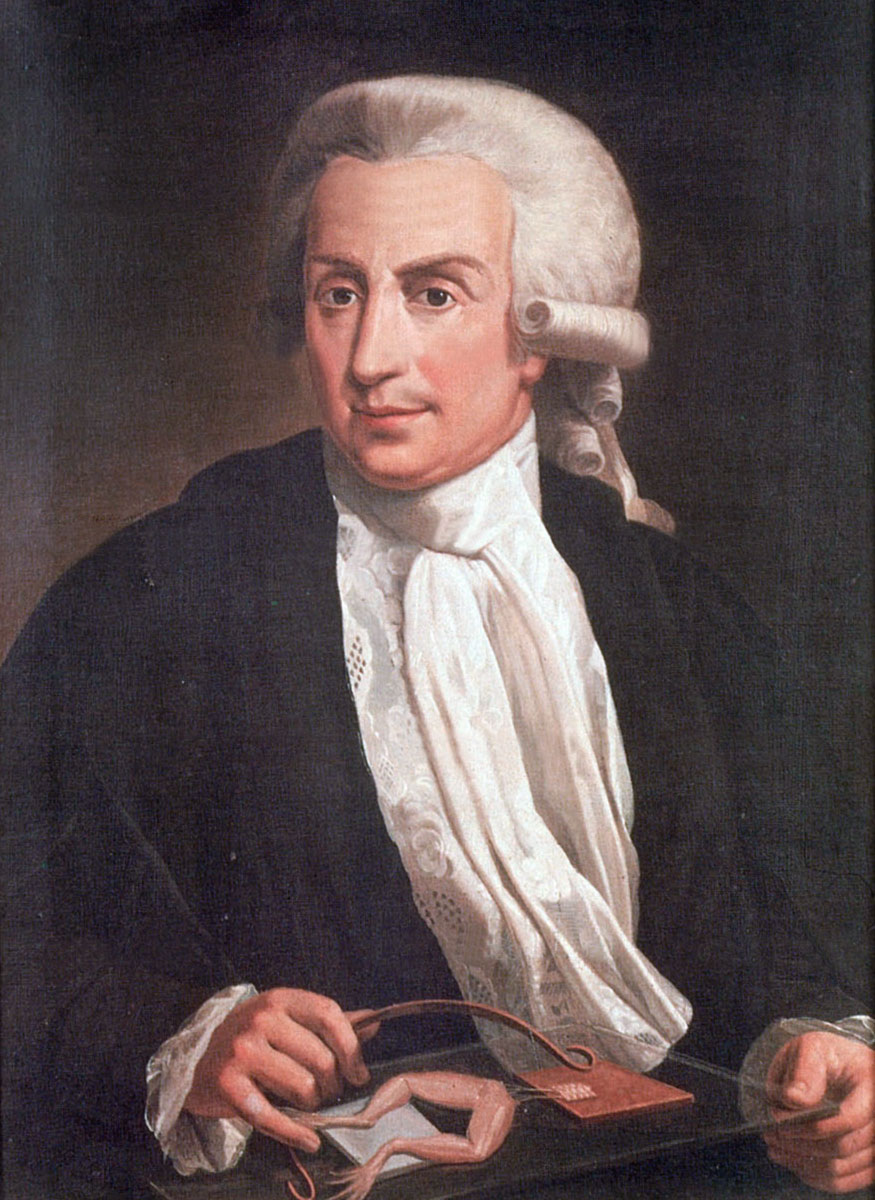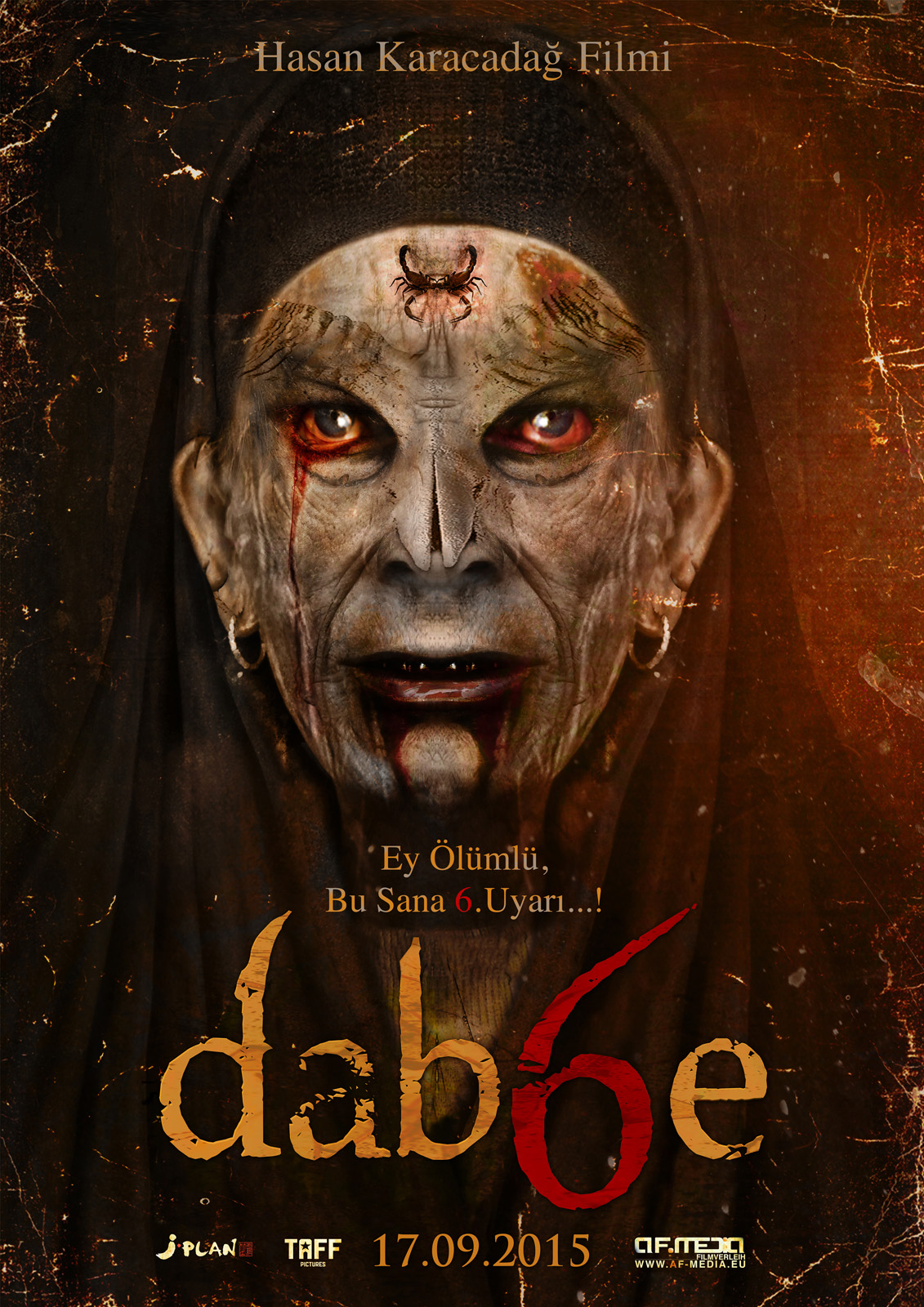- Affärsnyheter
- Alternativ hälsa
- Amerikansk fotboll
- Andlighet
- Animering och manga
- Astronomi
- Barn och familj
- Baseball
- Basket
- Berättelser för barn
- Böcker
- Brottning
- Buddhism
- Dagliga nyheter
- Dans och teater
- Design
- Djur
- Dokumentär
- Drama
- Efterprogram
- Entreprenörskap
- Fantasysporter
- Filmhistoria
- Filmintervjuer
- Filmrecensioner
- Filosofi
- Flyg
- Föräldraskap
- Fordon
- Fotboll
- Fritid
- Fysik
- Geovetenskap
- Golf
- Hälsa och motion
- Hantverk
- Hinduism
- Historia
- Hobbies
- Hockey
- Hus och trädgård
- Ideell
- Improvisering
- Investering
- Islam
- Judendom
- Karriär
- Kemi
- Komedi
- Komedifiktion
- Komediintervjuer
- Konst
- Kristendom
- Kurser
- Ledarskap
- Life Science
- Löpning
- Marknadsföring
- Mat
- Matematik
- Medicin
- Mental hälsa
- Mode och skönhet
- Motion
- Musik
- Musikhistoria
- Musikintervjuer
- Musikkommentarer
- Näringslära
- Näringsliv
- Natur
- Naturvetenskap
- Nyheter
- Nyhetskommentarer
- Personliga dagböcker
- Platser och resor
- Poddar
- Politik
- Relationer
- Religion
- Religion och spiritualitet
- Rugby
- Så gör man
- Sällskapsspel
- Samhälle och kultur
- Samhällsvetenskap
- Science fiction
- Sexualitet
- Simning
- Självhjälp
- Skönlitteratur
- Spel
- Sport
- Sportnyheter
- Språkkurs
- Stat och kommun
- Ståupp
- Tekniknyheter
- Teknologi
- Tennis
- TV och film
- TV-recensioner
- Underhållningsnyheter
- Utbildning
- Utbildning för barn
- Verkliga brott
- Vetenskap
- Vildmarken
- Visuell konst
Om podden
BONE AND SICKLE explores historical topics related to folklore and horror. With acerbic wit and a scholarly penchant for the grotesque, rogue folklorist Al Ridenour delves into a wide but carefully curated range of topics illustrated by stories from historical texts. Narratives are given dramatic readings by “Mrs. Karswell” (Sarah Chavez) backed by richly produced soundscapes blending original music, sound design and effects. The source books, though real enough, are said to be pulled from an imaginary library on Ridenour’s imaginary estate situated somewhere in the neighborhood of Charles Addams and Edward Gorey. Each episode begins with our hosts briefly discussing goings-on in this world before diving into the topic to be explored. Occasional alternate-format episodes are devoted to readings of classic horror stories or curious texts of antiquarian interest. Ridenour is the author of “The Krampus and the Old, Dark Christmas” (2016) and “A Season of Madness: Fools, Monsters, and Marvels of the Old-World Carnival” (Jan. 2025). Sarah Chavez produced the podcast “The Cabinet of Curiosities” (2011-2012) and contributed to “Death in the Afternoon” (2018-2023).
The podcast Bone and Sickle is created by Al Ridenour. The podcast and the artwork on this page are embedded on this page using the public podcast feed (RSS).
Avsnitt
The Sin-Eater
The Sin-Eater was a figure associated with funerals of the 17th – 19th century, mostly in Wales, and the English counties along the Welsh border. According to tradition, he was invited by grieving families to transfer the burden of sins from the deceased to himself by consuming bread and beer in the vicinity of the corpse, after which he might receive some financial compensation. He typically came from the fringes of society and was said to be motivated by a combination of poverty, greed, and irreligious indifference to matters of eternal judgement.
After a quick montage of clips from the generally terrible films made on the theme —Sin Eater (2022), Curse of the Sin Eater (2024), The Last Sin Eater (2007) — we review the historical references to the tradition, which are surprisingly few in number.
The first comes from a particularly early 1686 collection of British folklore written by John Aubrey, The Remaines of Gentilisme and Judaisme. His characterization of the custom is essentially that described above and despite the early date of the text, he describes the practice using the past tense, though qualifies this somewhat later mentioning that it is “rarely used in our days.” Mrs. Karswell, of course, reads Aubrey’s original text along with our subsequent examples.
Our next account from 1715 comes from antiquarian John Bagford (published later, in 1776) in John Lelan’s, compendium, Collectanea. It does not mention Wales but locates the custom in Shropshire, an English county bordering Wales. It also has the Sin-Eater remaining outside the house where the body lies as he consumes his bread and ale. Bagford also adds a verbal formula, which the Sin-Eater is supposed to pronounce, mentioning the deceased’s soul attaning “ease and rest,” for which the Sin-Eater’s soul has been “pawned.” These phrases are recycled in later literature on the topic.
The next text comes from 1838, appearing in the travelogue Hill And Valley: Or Hours In England And Wales by the Scottish novelist, Catherine Sinclair. It’s particularly brief, adding little detail other than specifying the tradition as one (formerly) belonging to Monmouthshire, in eastern Wales. She also characterizes the custom derisively as “popish,” or belonging to the Catholic past.
The next and final account (not counting clearly recycled retellings of those above) was contributed by Matthew Moggridge in an 1838 journal of the Cambrian Archaeological Association. It also relegates the tradition to the past, placing it specifically in the Welsh town of f Llandybie. Moggridge removes the ale, keeps the bread, and
adds salt (used symbolically rather eaten). He also makes explicit the Sin-Eater’s pariah status.
Aubrey’s, Bagford’s, an Moggridge’s accounts received greater attention when collected in an 1892 article by E. Sidney Hartland in the journal Folk-Lore, the publication of the British Folk-Lore Society. Hartland’s “rediscovery” of these texts fueled the interest of the British public and corresponded with a rising fascination in such things as represented in the arts by the Celtic Revival instigated by William Butler Yeats’ 1893 work, The Celtic Twilight and the ongoing publication between 1890 and 1915 of James Frazer’s evolving work on folklore, The Golden Bough.
As there are no firsthand accounts describing sin-eating as a custom still in existence a misinterpretation or garbled accounting of another tradition may lie behind the concept of the Sin-Eater. The second half of our show examines the extent to which creative myth-making formed the concept along with the role older Catholic practices may have contributed to the tales.
The earliest literary Sin-Eater we encounter appears in a chapter of Joseph Downes’ 1836 novel, The Mountain Decameron. Mrs. Karswell reads an evocative passage or two describing a traveler stumbling into a scene of sin-eating while traveling through a haunted bog. Along with several other quick summaries of post-Hartland novels treating the topic, we hear a sin-eater clip from a BBC adaptation of Mary Webb’s 1924 novel, Precious Bane and learn how Christanna Brand’s 1939 short story “The Sins of the Fathers,” ended up in an episode of Rod Serling’s 1970s TV series, Night Gallery.
We then survey a number of transactional funeral customs possibly reinterpreted as Sin-Eater lore, among these: “funeral doles” and “avral feasts” at which property of the deceased was disbursed, unsavory pallbearers paid off in food and drink, and the distribution of “soul-cakes “and the custom of “souling” to assure the deceased’s heavenward ascent. Best of all, we learn about that cousin to the soul-cake — the funeral cookie.

Mélusine, the Serpent Fairy
Mélusine is a female fairy of medieval legend. who suffers under a curse transforming her once weekly into a monstrous form. In various tales she becomes either a serpent or fish from the waist down, or fully transforms into a dragon. Mélusine can only break this curse via marriage to a mortal who is obliged to allow her certain secret freedoms. In return, her husband enjoys magical assistance and sees his fortunes flourish, at least until that day pact is broken.
The most famous version of this story, and the one to which we devote the bulk of the show is a French tale set down in 1387 by Jean d’Arras, Mélusine or the Noble Story of the Lusignans. The patron for whom he wrote, Duke Jean de Berry, belonged to the House of Lusignan, whose ancestral claims to the lands around Poitiers were portrayed by Arras as a matter of supernatural destiny involving the fairy.
We learn how Jean de Berry’s ancestor, Raymondin (Raymond) became engaged to Mélusine after a meeting at an enchanted fountain. Raymond is unaware that this encounter, and all that follows, is the subject of a prophecy set in motion by his accidental killing of his uncle. We hear the curious way in which this transpires, of Raymond and Mélusine’s wedding attended by a multitude of fairy folk, and of the building of Château de Lusignan through a sly collaboration of fairy magic, ingenuity, and human agency.
We then learn of Mélusine’s and Raymond’s offspring, all of whom are handsome and strong yet also betray their supernatural parentage via certain disfigurements — strange birthmarks, enormous stature, huge jutting teeth, or additional eyes. Much of Arras’ narrative is devoted to the sons’ heroic exploits, particularly as Crusaders in the Middle East, where the historical Lusignans gained lands and reputations, but our episode, focuses only only two sons, “Geoffroy Big-Tooth” and Fromont, whose stories are more intertwined with that of Mélusine herself.
Next comes the central drama, the breaking of the secret pact between Raymond and his fairy wife, which I’ll leave for you to enjoy without spoilers. Mrs. Karswell delivers a fine dramatic reading of this lengthier passage.
While that situation simmers, we hear how Geoffroy has returned from a giant-slaying adventure to discover that his brother, Fromont, is about to enter a monastery rather than devote himself to expanding the Lusignan empire. This doesn’t sit well with Geoffroy, whose disproportionately wrathful response is at once horrible and comic.
Reacting to the tragic fall-out of Geoffroy’s rampage, Raymond himself flies into a rage, accusing Mélusine of producing offspring supernaturally inclined toward evil. Cruel as his words may be, Mélusine seems to validate them, assuming a diabolical presence as she abandons their marriage, flying away from Castle Lusignan in the form of a dragon.
Finally, we examine the origins of the curse upon Mélusine, a strange backstory revealed through the discovery of a tablet in fantastic subterranean tomb, one which relates how she imprisoned her human father inside a mountain and installed there a giant as jailer.
Our episode then considers some folkloric parallels to the figure of Mélusine, a possible kinship with the Irish Banshee, the Scottish Bean-nighe or the Lavandières (“midnight washer women) of Brittany as well as earlier 13th-century literary sources for Arras’s tale including works by Gervase of Tilbury, Marie de France, Walter Map, and others.
By the late 15th century, the story by Arras had been retold by the French author Coudrette in a version that became broadsheet fodder for German publishers. We also hear how the tale was embraced in Luxembourg, where it attached to Siegfried, Count of the Ardennes, and the magical construction of Luxembourg Castle.
Finally, we look at some 19th-century retellings of the legend as German folktales, some of which made their way into Czech lands, where Meluzina’s doleful howling at her fate is heard in the moaning of winter winds. The show closes with a snippet of a modern Czech children’s song mentioning Meluzina, as an embodiment of the wind –“Vitr fouka do komina” (The wind blows in the chimney).
Announcement: Show Delay
Unfortunately, release of the episode scheduled for this month has been delayed thanks to the Eaton Wildfire in California.
Your hosts are safe and sound, but complications from the fire temporarily halted production.
The episode in question should be available in February.
Thank you for your patience!
A Christmas Ghost Story VII
The Victorian tradition of telling ghost stories at Christmas has been celebrated by Bone and Sickle since 2018. This year is no exception as we share two stories in this episode, one comic, and one frightening. We begin with the Introduction to the 1891 anthology, Told After Supper, by the British writer, Jerome K. Jerome, following this with “The Old Portrait” from Scottish writer Hume Nisbet’s 1900 collection Stories Weird and Wonderful. Pour a brandy, douse the lights, and enjoy!
La Befana, the Witch of Twelfth Night
A short extra episode on Befana, the gift-bringing Italian witch associated with Twelfth Night, the end of the Christmas season. Included in the show is material from the book, “The Krampus and the Old, Dark Christmas,” traditional music of the season, audio from actual celebrations, and a few pop songs associated with la Befana.

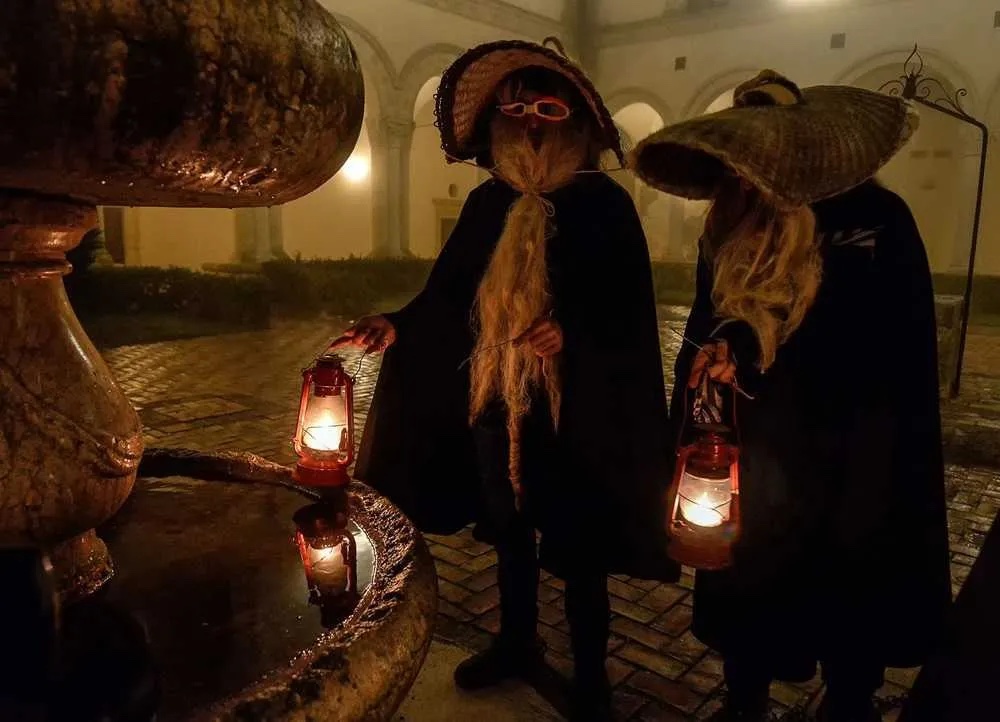
Vlad the Impaler
A figure of mythic proportions during his lifetime, Vlad the Impaler’s notoriety receded over the centuries only to be resurrected in the 1970s, when a pair of Boston University scholars went public with theories connecting him to Bram Stoker’s Count Dracula.
We begin with snippet of Francis Ford Coppola’s 1992 film, Bram Stoker’s Dracula, the first film to connect the literary vampire with the Eastern European prince — a rather ironic departure from Stoker’s novel, which references the historic figure only in passing.
Vlad’s 15th-century notoriety was sparked by two German texts both published around 1463, or shortly thereafter. Probably the earliest of these,written anonymously and published in Vienna, was titled, The History of Voivode Dracula, is sometimes called “the St. Gallen manuscript” named for the Swiss city where it is preserved. (“Voivode,” is a Slavic term, used in this context to mean, essentially, “Prince.”) The second is a rhymed narrative written by Michel Beheim, a poet associated with the Meistersinger tradition and a performer at the court of the King Friedrich III. About three decades later, in 1490, Vlad’s story appeared in northwestern Russia. We don’t know its author but the monk who copied it from a lost original, mentions that his source was written in 1486.
All three of these narratives provide plenty of gruesome anecdotes detailing the voivode’s cruelties. Before going further into Vlad’s history, and as a quick appetizer, Mrs. Karswell reads a description by Beheim of a ghastly picnic said to have been enjoyed by the voivode.
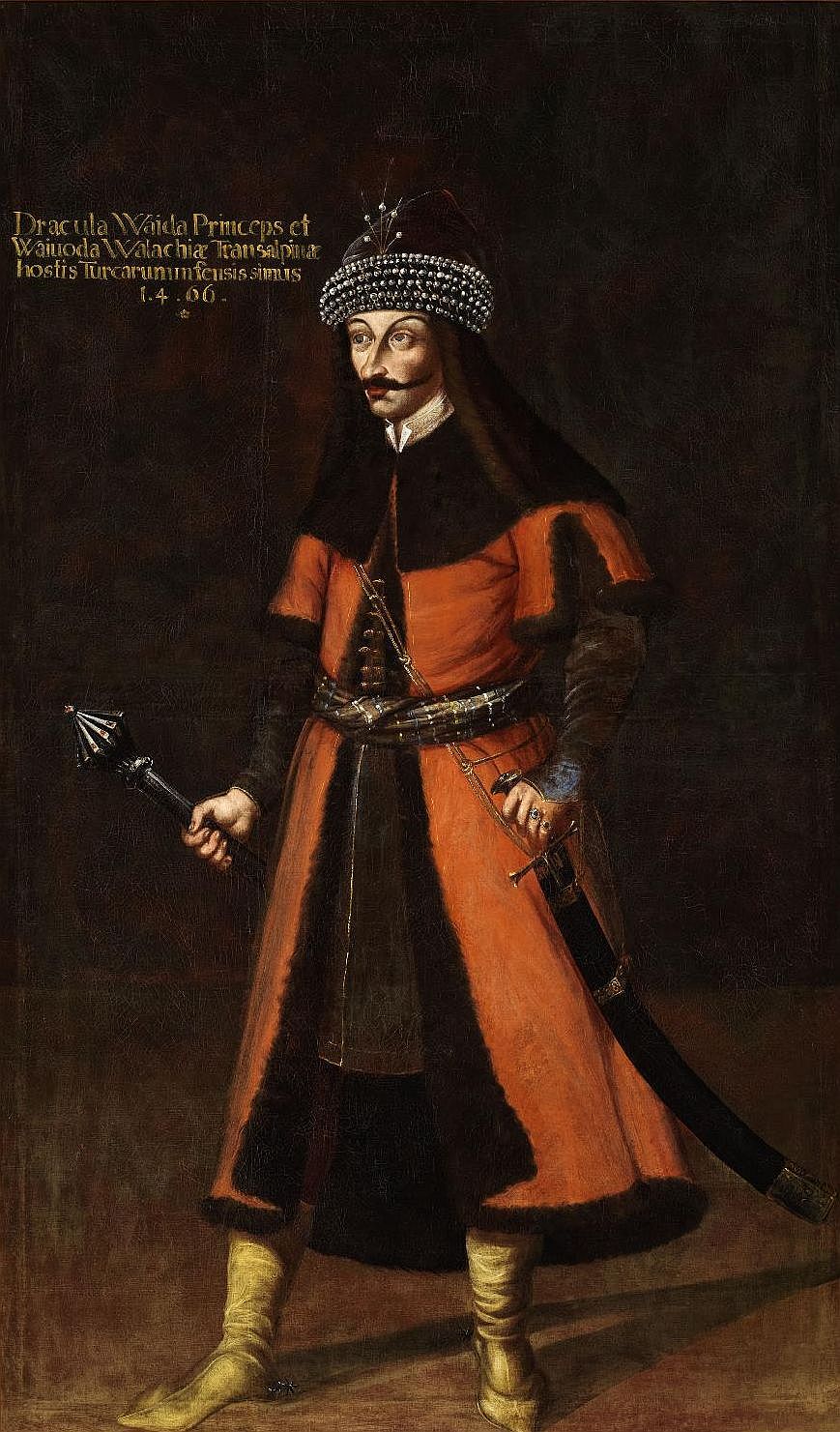
Next, we clear away some misconceptions regarding Vlad the Impaler, the first having to do with his name. Called “Vlad Țepeș” (Vlad the Impaler) in Romanian, he is less dramatically referred to as Vlad III. His father, Vlad II, was also known as “Vlad Dracul.” His son, using the Slavonic possessive form of that was referred to as Vlad Drăculea (that is, “of – the son of – Vlad Dracul). The father’s epitaph means “Vlad the Dragon,” referencing Vlad II’s (and later Vlad III’s) membership in The Order of the Dragon, a society of Christian knights dedicated to staving off incursions of the Muslim Turks into Christendom.
We then have a look at Vlad III’s over-emphasized association with Transylvania, one of the three historical regions (along with Moldavia and Wallachia) that would later become Romania. In fact, it was not Transylvania but Wallachia over which both Vlad II and Vlad III served as voivodes. While Transylvania was his birthplace, at the age of 4, he and his family departed for Wallachia, and Vlad’s historical relationship with Transylvania was later anything but friendly.
We then look at Wallachia’s role as a buffer between Ottoman regions to the south and Hungarian/German controlled regions to the north, as well as the regrettable deal Vlad II made with the Turks to keep the peace.
The last involved the “child levy,” or “blood tax” demanded by Sultan Murad II. Known in Turkish as “devshirme,” this was a sort of ransom imposed on Vlad II, requiring that he leave his sons Vlad and Radu with the Turkish court to ensure the ruler’s compliance with the sultan’s demands. We hear some interesting details on this four-year exile, some of which likely shaped Vlad III’s actions later in life.
Before Vlad III is released, his father and eldst brother Mirea are murdered by Hungarian forces, who install their desired ruler on the Wallachian throne. While Vlad III manages to briefly seize his father’s throne while the Hungarians are distracted in conflicts with the Turks, he’s again forced into exile after only serving one month.
After several year in exile among the Ottomans and Moldavians, Dracula takes advantage of the death of the Hungarian ruler, János Hunyadi, to again sieze the Wallachian throne, and it’s during this second reign that he gains his notoriety. The first order of importance is to punish Transylvanians who aided the Hungarians responsible for his father and brother’s deaths. Beheim provides some gratuitously gruesome descriptions of exotic acts of revenge.
We then hear of Vlad III’s murder of Turkish emissaries, and of the campaign Sultan Mehmet II mounts to punish the Wallachians. Vasly outnumbered by the Turkish forces, Vlad and his men resort to guerrilla warfare to slow down the Ottoman army advancing on his capital city of Târgovişte.
On the night of June 17, 1462, Wallachian troops under Vlad conduct an attack on the sleeping Ottoman camp, in an assult known by Romanians as the “The Night Battle” or “Battle with Torches.” The actual tactical gains made during this foray are debated, but the following day, the Ottomans are subjected to a powerful psychological assault as they encounter a forest of their comrades collected from the battlefield and impaled on stakes. According to the Greek historian Laonikos Chalkokondyles, roughly 20,000 corpses were seen spitted in a field measuring two miles long and three-quarters of a mile wide.
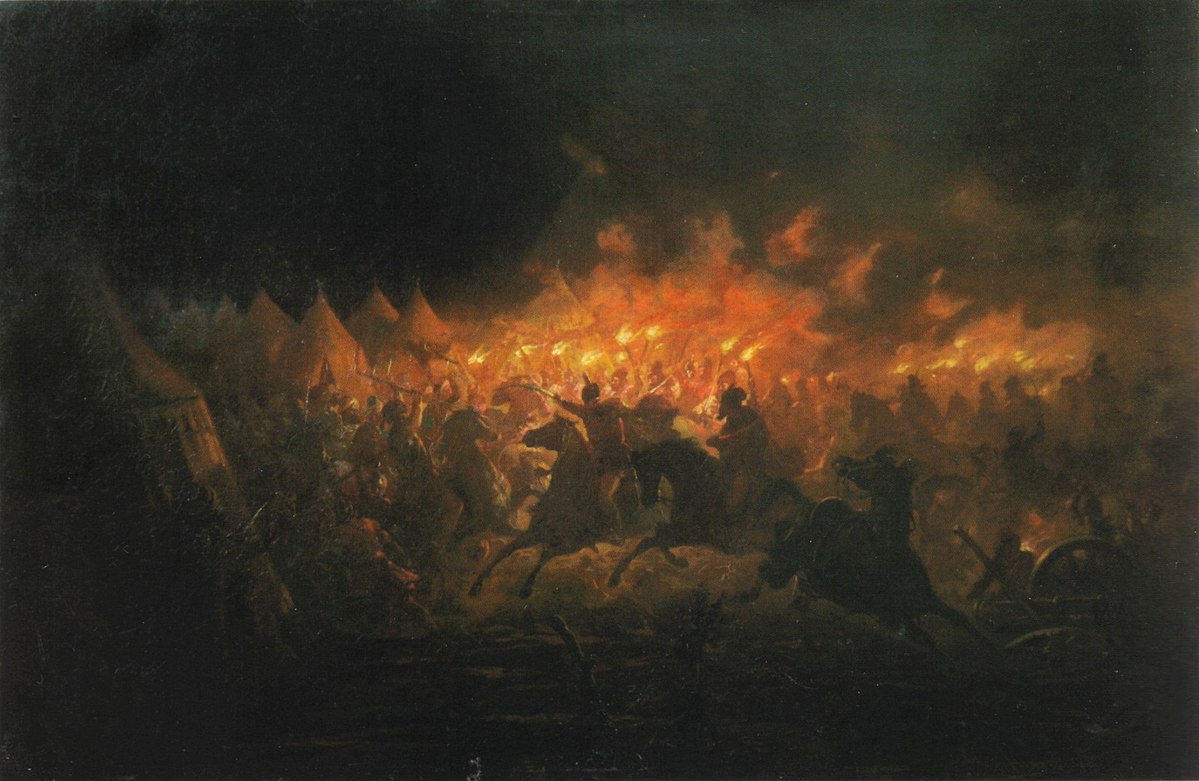
After this, we hear of Dracula’s 14-year imprisonment by the Hungarians, during which he supposedly amused himself by impaling rats in his cell. We then hear of the voivode’s death at the hands of his own men in 1476, and decapitation by the Turks.
The literary embellishments of some of our German texts, and the rationale for such, are next discussed and these are contrasted with stories from the Russian collection that offer a slightly more balanced picture of the ruler, portraying him through several anecdotes as one who maintains social order through highly effective (if brutally excessive) means.
We then take up the question of whether, or to what extent, Bram Stoker based his vampire on Vlad III, finding but a few points of agreement as well as details (largely geographic) arguing against the idea.
Last, we have a look at Vlad the Impaler’s rediscovery via the 1972 book, In Search of Dracula, by Romanian émigré Radu Florescu and Raymond T. McNally, a scholar of Russian and Eastern European history. Mr. Ridenour offers some sour grapes on the success of this bestseller and ends the show with a clip featuring Christopher Lee from a 1975 same-name documentary inspired by the Florescu-McNally book
Devil Boards
The devilish reputation Ouija boards enjoy in horror films is a relatively new phenomenon. In the Victorian era, they were regarded by “psychical researchers” as something to be embraced in a spirit of calm scientific inquiry, while Spiritualists saw in them a means of reaching out to those who’d passed into the “Summerland,” an anodyne realm of sweetness and light.
While these were the dominant attitudes of the day, the idea of spirit communications has always been fraught with a sense of the uncanny, tainted even by an association with witchcraft and the Devil. We’ll see this element already present in those first communications of the Spiritualist movement, the dialogues the Fox sisters with an unseen presence at first presumed to be a sort of devil.
As we saw in our previous episode, spirit-boards represent a particular danger to those with psychologically fragile constitutions. Beyond the instances of obsessive madness detailed previously, this episode examines a handful of cases from the 1920s and ’30s involving actual bloodshed — murder, suicide, and explicit invocations of the Devil.

Of course these remained isolated incidents, and historical distrust of the Ouija was generally low, and all but non-existent during the spiritual and occult explorations of the 1960s. But all of this would soon change with William Peter Blatty’s 1971 novel, The Exorcist, and its 1973 cinematic adaptation, both of which famously depict the Ouija board as a channel through which the Devil enters.
Some listeners may know that Blatty’s novel was inspired by actual reports of an exorcism that took place in America of the late 1940s, one involving a teenage boy rather than girl, a change Blatty said he’d made to help preserve the privacy of the boy.
Within the last decade, as individuals involved in these incidents have passed on, more information on this case has made its way to public scrutiny. In the last half of our show, we examine the role spirit-boards and Spiritualist practices played in these events as revealed by a day-to-day log kept by the lead exorcist during the rites . Mrs. Karswell reads for us the passages from the journal.
An element Blatty wove in with this source material was a specific identity of the demon possessing his fictional victim — Pazuzu, an ancient Mesopotamian wind spirit bringing dro ught, famine, storms, and all manner of ill fortune. As this figure was digested into pop culture over the next decades, a version of its name, “Zozo,” would eventually appear in the early 2000s as a destructive entity often channeled by unwary Ouija user. We take a look at this bit of evolving web-lore, showcased in paranormal shows, like Ghost Adventures and at the heart of the 2012 indie horror film I am Zozo.
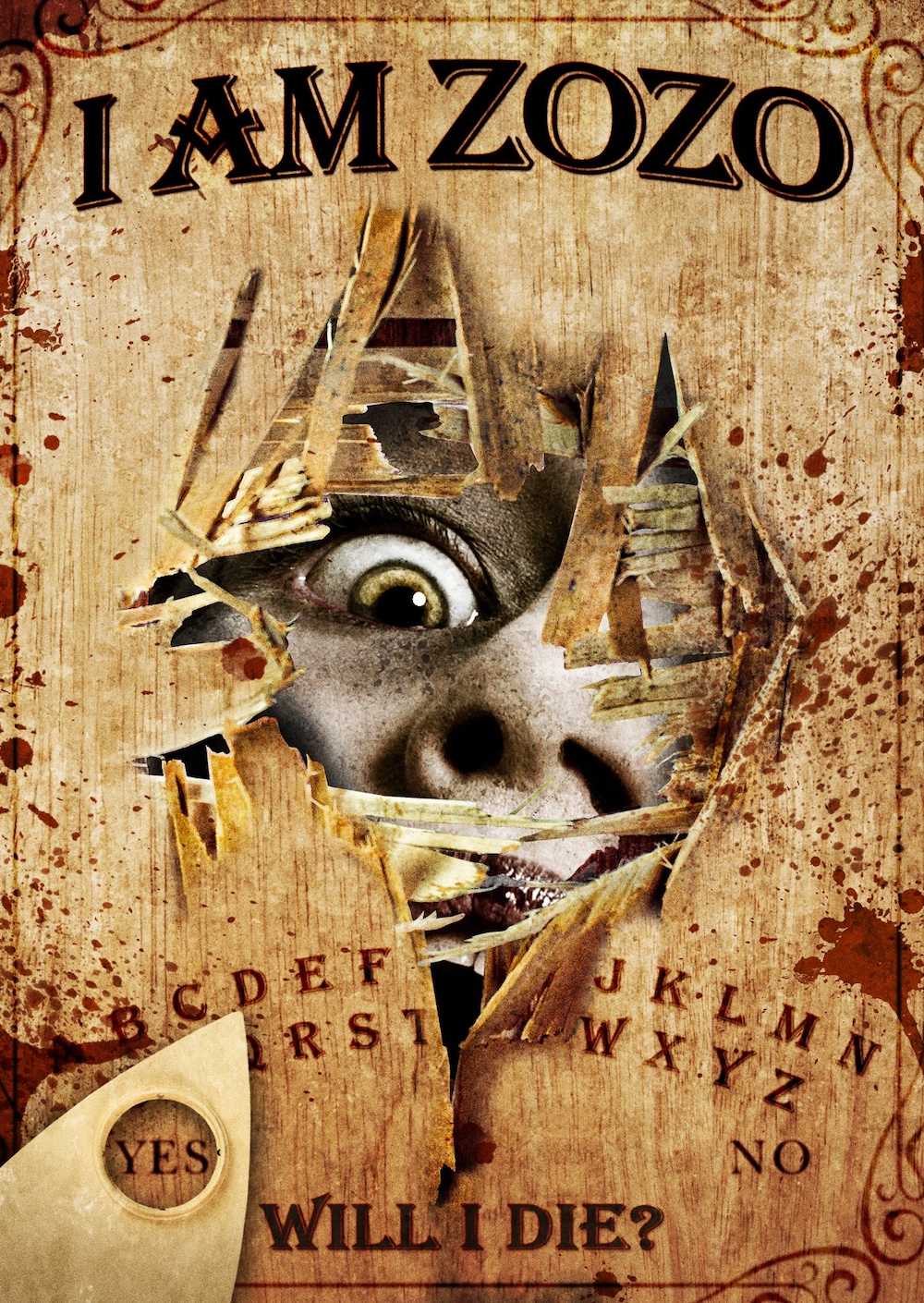
Missing Intro for Episode 133
Apparently, I clipped off the beginning of the show during the initial upload. It’s been fixed, so this would only effect those downloading yesterday, but for those who missed it, here it is..
Spirit Boards
Ouija boards, or more generally, “spirit boards” have antecedents going back to the very first days of the Spiritualist movement. We begin our show with a seasonally spooky visit to the cottage of the Fox sisters in Hydesville, New York, where the ghost of a murdered pedlar supposedly began communicating with the family through a series of mysterious knocking sounds. While the method used by the Fox sisters to translate these knocks into messages anticipates the process of pointing out letters on a Ouija board, the evolution of spirit boards was not so straightforward.
We learn how the planchette, used on board as a pointer, appeared long before any boards were printed and was initially used as a writing device. It was equipped with a pencil inserted through it like a third leg. As the planchette was guided by the user (supernaturally and/or unconsciously), “spirit writing” was produced.
We next hear from a number of contemporaneous accounts describing the pencil planchette as if it were inhabited by a ghostly presence and how these devices first appeared in Paris and London. Once imported to America, the homeland of the Spiritualist movement, merchants in Boston and New York did brisk business in producing versions of their own.
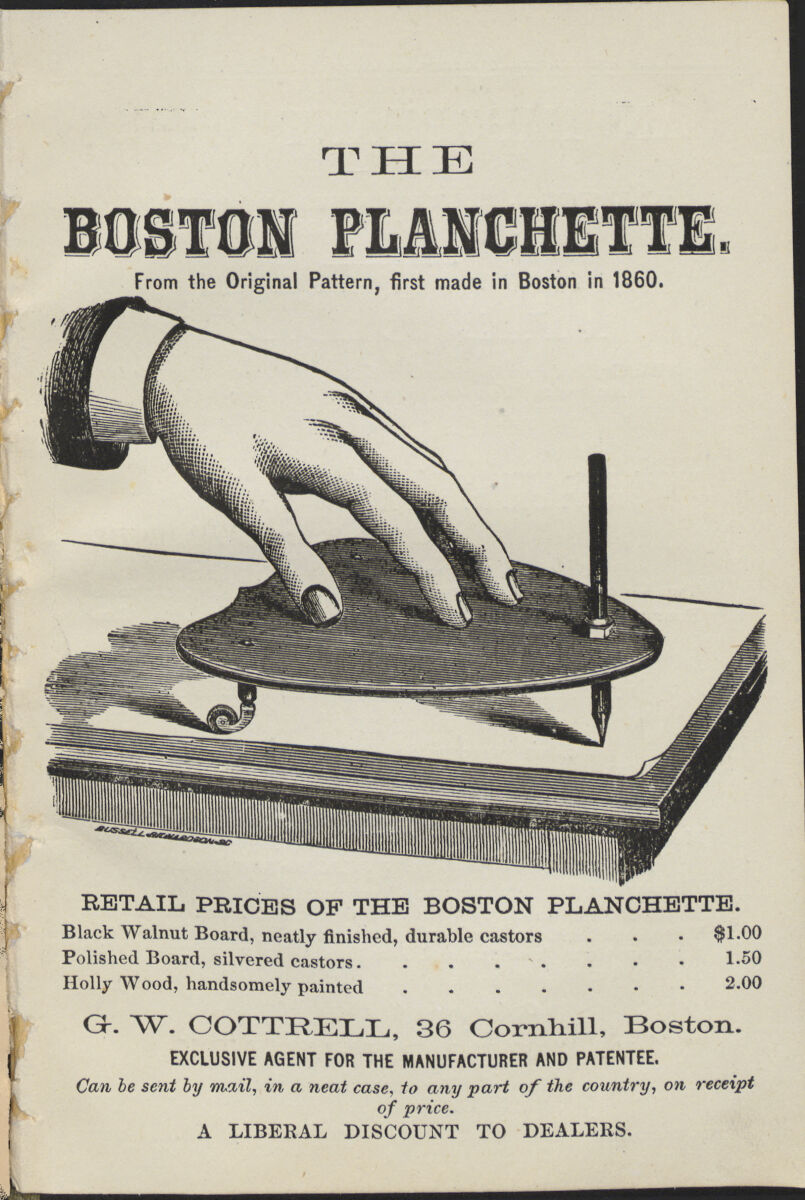
By the 1880s, the planchette was finally beginning to be used as a pointer, and W. S. Reed Toy Company of Massachusetts became one of the first merchants to produce boards printed with letters. Reed’s model was known as the “Witch-board.” Along the way, we hear of an unexpected connection between President Grover Cleveland and Witch-boards.
We then go to Baltimore, where former fertilizer salesman Charles W. Kenner partners with attorney Elijah to create their own version of the ghostly spelling board, one they name Ouija. Lore around the naming of the board (through a seance) and peculiar happenings at the US Patent office in Washington DC are discussed along with the passing of rights to manufacture the novelty to William Fuld, who manufactured the Ouija board from 1897 to his untimely death in 1927.
We discuss the phenomenon of “Ouija-mania,” which generated a number of songs and (questionable) literary works. Ouija-mania also generated a certain degree of misery among unstable users. Several absurd and tragic stories from newspapers of the day are read by Mrs. Karswell, and we close with a particularly dramatic story told in a letter preserved in the William Fuld archives. It conceives of the Ouija as a tool of the Devil, something we will explore more in our next episode.
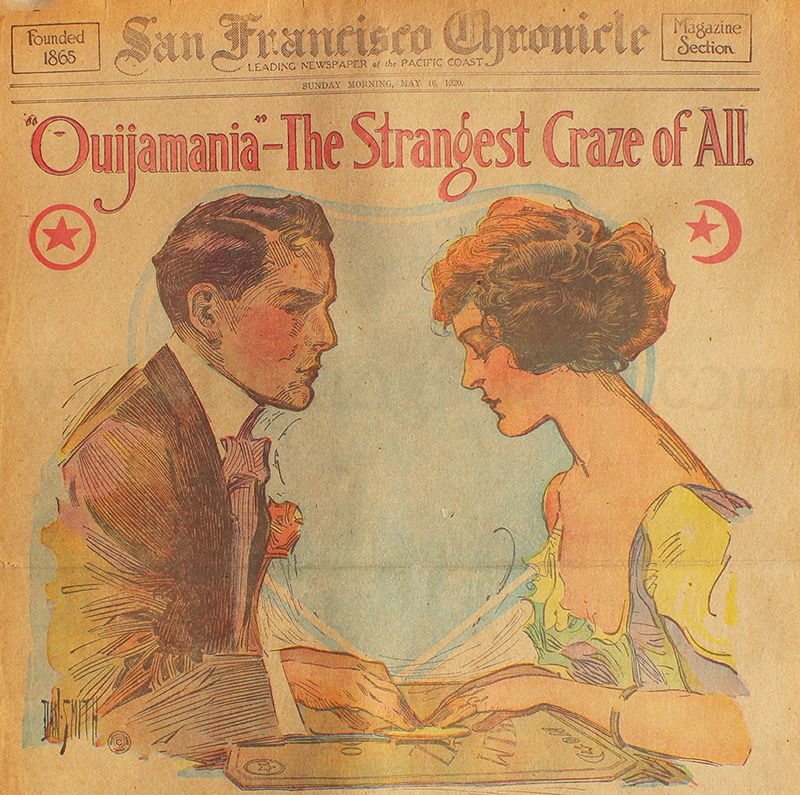
Announcement Trick-or-Treat By Mail
A special short announcement regarding the October 20 deadline for Trick-or-Treat-by-Mail for listeners joining our Patreon. Find out how you can receive a hand-packed candy bag from the home of Bone and Sickle Podcast. Each bag this year contains a special MYSTERY ITEM from Egypt!
Visit: https://www.patreon.com/boneandsickle
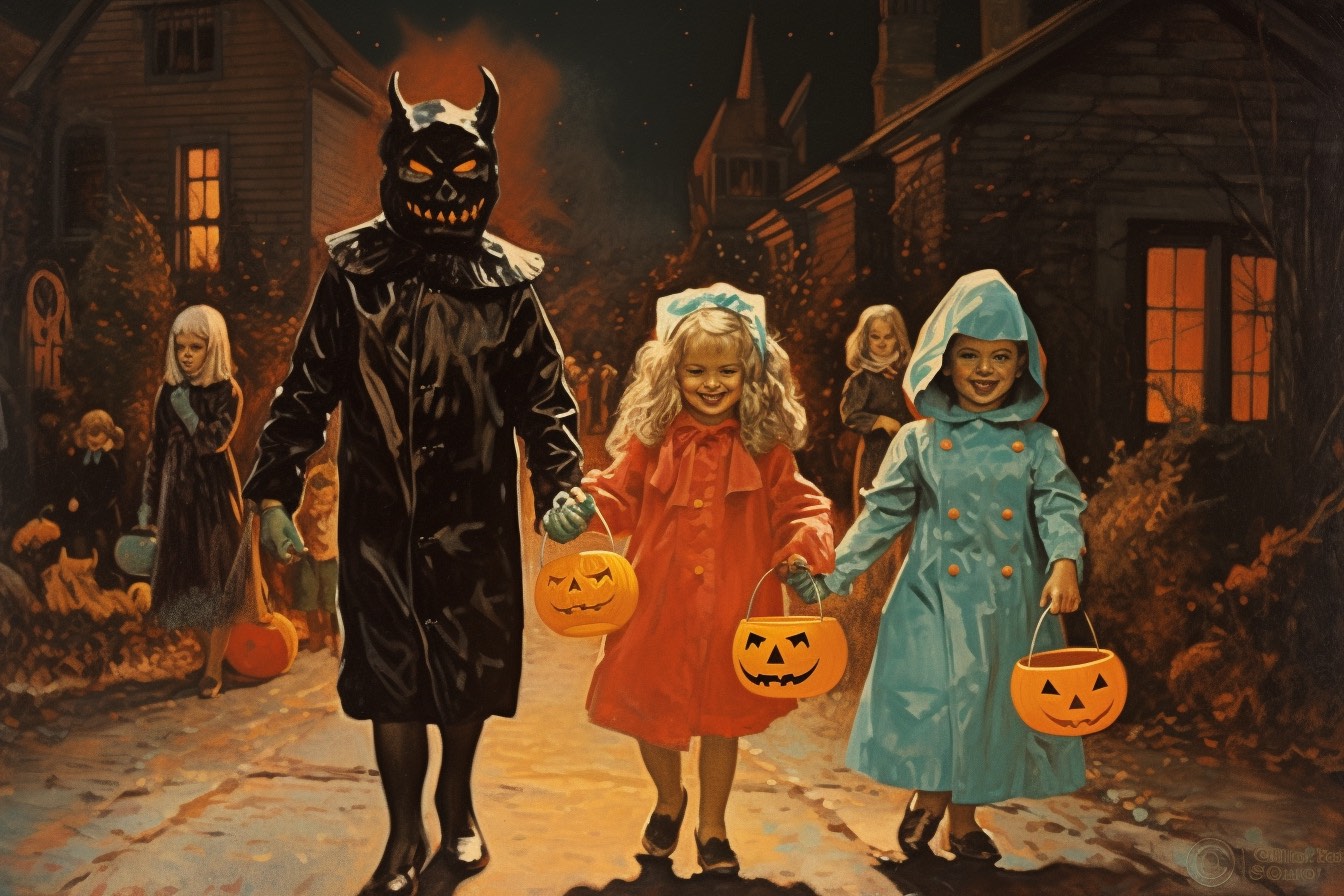
“Young Goodman Brown”
We’re getting into the spirit of the season with a classic tale of witchcraft set in 17th-century Salem Village, Nathaniel Hawthorne’s short story, “Young Goodman Brown.” Written in 1835 for New England Magazine, it later appeared in the 1846 collection, Mosses from an Old Manse, which also includes the excellent supernatural story, “Rappaccini’s Daughter.” Hawthorne regarded “Young Goodman Brown” as his most impactful short story, and it received high praise from his contemporary, Edgar Allan Poe.
Two more Halloween-themed episodes (historical explorations) await you next month.

Subterranean Sages and Russian Mystics
Agartha, Shambhala, and Hyperborea are all names for a a mythic spiritually and scientifically advanced kingdom, always in some hidden location, sometimes within the earth, a legend which became an obsession of early Soviet spies, a mad soldier of fortune, and a mystical Russian artist during the 1920s.
We begin with a clip from the 1939 German documentary, Secret Tibet, which records the activities of visiting Nazi researchers in that country. While we can’t establish to what extent the expedition focused on Third Reich mythology connecting their Nordic Aryan with South and East Asia cultures, we examine other efforts by the Reich’s department of Ahnenerbe (ancestral heritage) to make such connections. Alongside this, we look at some 19th-century precedents associating an ancient, primal race with both the far north and Vedic culture of the subcontinent. We also examine the classical concept of Thule (a far-north Neverland) appropriated by the pre-Reich Thule Society.
We next look have a brief look at 1871 book by French writer Louis Jacolliot, The Son of God, which introduces the name “Agartha,” (and its many forms) to designate an underground city or land serving as a repository of ancient wisdom. Jacolliot places this land in the East and associates it with a sort of universalized Vedic culture.
It’s Alexandre Saint-Yves’ 1886 book The Mission of India in Europe, that really defines Agartha as its come to be understood, placing it underground, in the East, and probably within the Himalayas. His fascination with the topic probably was inspired by his Sanskrit tutor, a mysterious Afghan, who called himself Hardjji Scharipf, and claimed to be “of the Great Agartthian School.” Scharipf, however, had little to do with the specific content of Saint-Yves’s book, which in part reads like Hollow Earth fiction of our previous episode. Mrs. Karswell reads for us some fantastical passages from his text.
The majority of Saint-Yves’s work, however, is devoted to the ruling principle of this hidden kingdom, something he calls “Synarchy,” (from Greek words for “together” and “rule.” Fearing the West’s descent into anarchy (Synarchy’s opposite) and its inability to receive the “Synarchic radiations” of Agartha, he calls upon the East to unify with Europe and guide the world toward a Synarchic utopia (the titular “Mission of India to Europe”). Saint-Yves is particularly concerned with Britain and Russia’s competition for the lands of Central Asia, an area poised to become the hypothetical capital of a united East and West.
This brings us Russia or the competing Red and White armies of the Russian Civil war fighting in this region.The Polish writer, Ferdynand Ossendowski, who served with the White Guard in this setting documents these conflicts in his 1922 best-seller, Beasts, Men, and Gods. Ossendowski not only mentions encountering the local myth of Shambhala (Tibetan Buddhism’s equivalent of Agartha). but also relates tales of Baron Roman Ungern von Sternberg, a German cavalry officer loosely allied with the Whites, but fighting not so much for the Tsars as for Mongolia’s Bogd Khan, third highest lama of Tibetan Buddhist, whom Ungern imagines rebuilding the empire of Genghis Khan. Ossendowski describes the Baron’s use of Tibetan legends, including that of the King of Shambhala, to promote this cause. He also describes some of the German’s more perversely brutal ways, which earned him the moniker, “the Bloody Baron” which we naturally share.
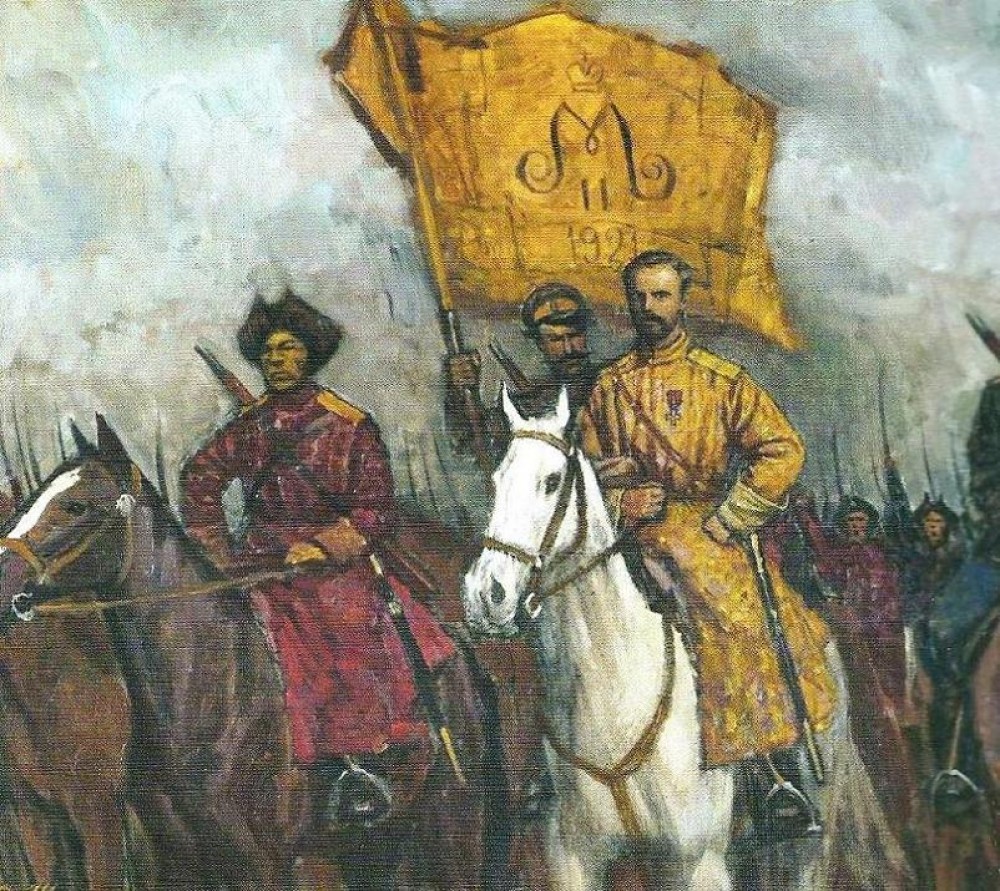
Next we come to a figure who represents a sort of nexus of all we’ve discussed — a Russian occultist and mythographer, Aleksandr Barchenko. We hear a bit about his early life, involving extracurricular ESP experiments, lecturing sailors of the St. Petersburg fleet on Shambhala, and his meeting with the occult-minded chief of the Secret Police, Gleb Bokii, who is attracted by Barchenko’s talk of an ancient body of knowledge that might be mined for new techniques of psychic control, surveillance, or manipulation.
While Barchenko was denied funding he sought for an expedition to locate Shambhala, Bokii sent him to investigate a phenomenon with of possible supernatural import on the far northern Kola Peninsula. There he was study a collective outbreak among the Sámi people of a trance-like state peculiar to Artic regions, known locally as “menerik” and elsewhere as, “the Call of the as North Star.” We hear some details of this bizarre condition and of Barchenko’s alleged discovery of vestiges of ancient Hyperborean culture on the Peninsula. We also hear of his search among the people of the Altai Mountains for legends related to Shambhala.
The last Russian Shambhala-enthusiast discussed is Nicholas Roerich, an artist and writer best known for his paintings of glowing Himalayan landscapes and spiritually charged scenes from Asian and Russian mythology. Along with his wife, Helena, a psychic in communication with Theosophy’s “Hidden Masters,” Roerich hatched a scheme he promoted (unsuccessfully) to Soviet officials, a “Great Plan” for uniting East and West, in which the mythical King of Shambhala (or the Last Buddha, the Maitreya) were to play a key roles. We hear tales of Shambhala collected during Roerich’s travels through the Himalayas and of a physical token allegedly from that kingdom, the Chintamani stone. Details are provided of stone’s mysterious delivery to a Paris hotel where the couple was staying in 1923, its role in developing Roerich’s status among his following, and the not entirely convincing evidence presented in support of the tale.
We end with some audio from the Hollow Earth itself, from a Tibetan cave — so says the Russian YouTube account, along with a collage of sonic anomalies collected under the the title, “The Earth Groans,” and (strangest of all) sounds that seemed to issue from within a Chinese mountain in Guizhou Province in July of 2020.
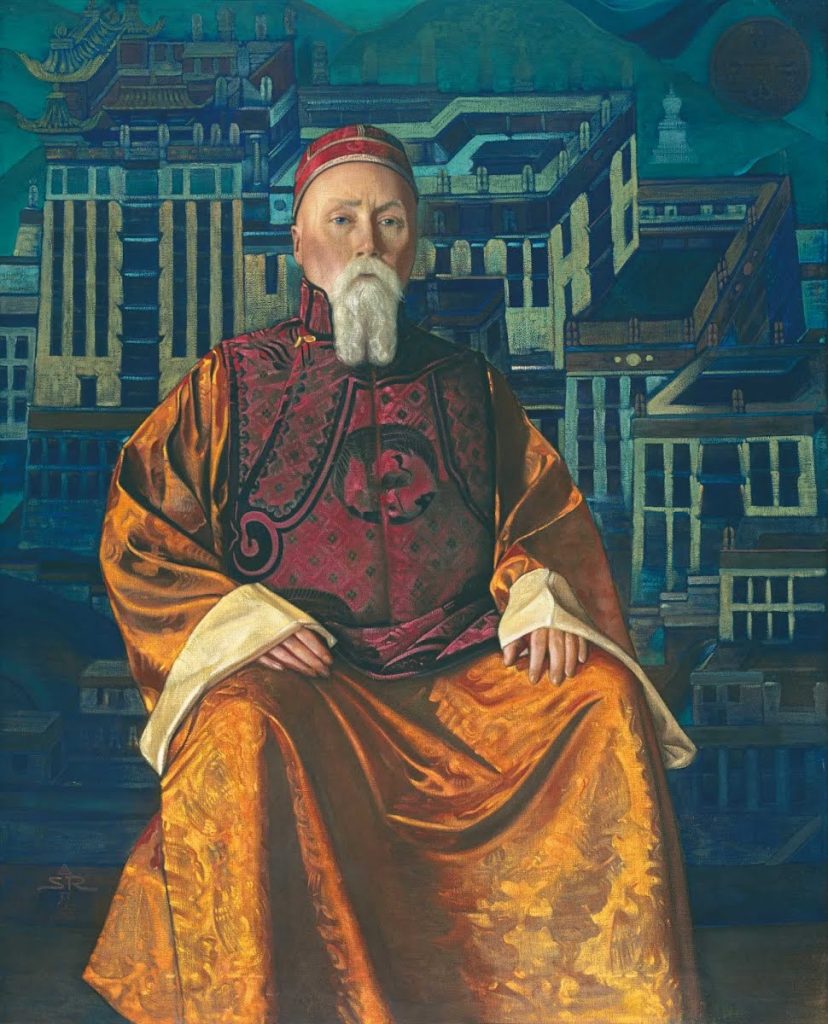
Inside the Hollow Earth
Borrowed from fairy lore, the notion of a hollow earth peopled by superior beings became a theme of literary fantasies as early as the 17th century and went on to influence fringe theories of the earth’s structure into the 19th century.
We begin with a snippet of the medieval Norwegian ballad “Liti Kjersti,” telling the fairy story of a young woman abducted into the earth by the Mountain King, and follow this an anecdote from Gerald of Wales’ 12th-century Itinerarium Cambriae (Journey through Wales) describing a kidnapping of a young boy by “two tiny men,” and the interior world he visits.
We then hear from Margaret Cavendish, a 17th-century poet, playwright, and writer on a variety of philosophical, political, and scientific topics. Her poem “The Fairy Queen’s Kingdom”(1653) and prose fantasy The Blazing World (1666) introduce the idea of interior kingdoms accessible only through entrances at the polar ends of the earth.
Over the next couple centuries, at least a half dozen novels describing travels into an interior world appeared. We briefly touch on Danish-Norwegian writer Ludvig Holberg’s Niels Klim’s Underground Travels (1741), Giacomo Casanova’s Icosaméron (1788), American writer Mary Bradley Lane’s Mizora: A Prophecy (1880), and Irish-American writer William R. Bradshaw’s The Goddess of Atvatabar (1892), the last coming closer to what we would think of today as science fiction. Universal to these hollow earth tales is portrayal of the interior civilization as a utopia, highlighting the failings of our own.
We then spend some time examining the particularly weird hollow 1895 earth novel by John Uri Lloyd, Etidorhpa, or, the end of the earth: the strange history of a mysterious being and the account of a remarkable journey, an underground adventure tale larded with odd religious, philosophical and pseudoscientific theories. It describes the education of a character identified only as “I—Am—The—Man—Who—Did—It,” guided by an eyeless amphibious humanoid along a subterranean route, with stops for various knowledge-imbuing experiences, i.e., “How to See Your Own Brain,” as one chapter is titled.
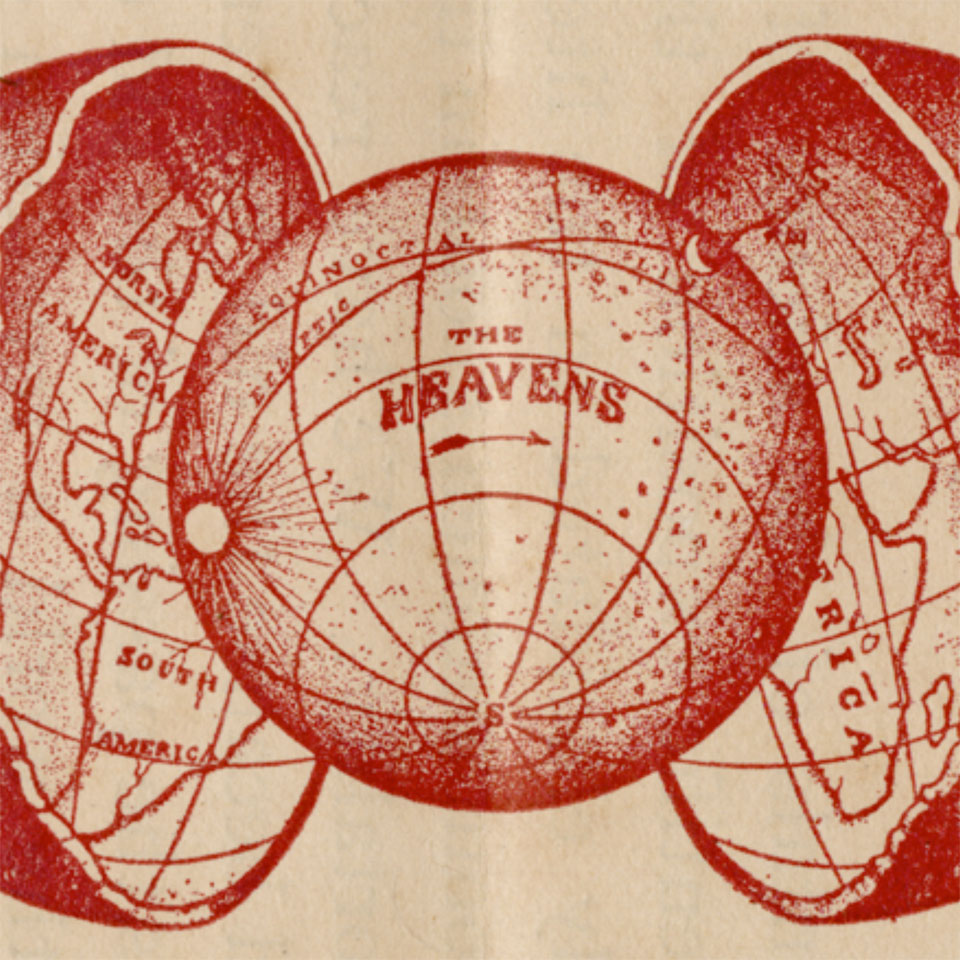
Next we explore a late 19th-century cult founded in upstate New York by Cyrus Tweed, who went by the name “Koresh.” Koreshanity, as it was called, regarded Tweed as a second coming of Christ and taught that earth’s inhabitants actually live on the inside of our hollow planet. His teachings began with an 1869 vision experienced during his laboratory pursuit of what he called “electro-alchemy.” Mrs. Karswell reads for us his account in which he encounters God in his female aspect. We hear of the cult’s heyday in the first years of the 20th century on Estero Island, of the coast of Fort Myers, Florida, and of the uncomfortable situation that attended Tweed’s death in 1908.
We then hear a bit about the man most widely associated with hollow earth pseudoscience, the American John Cleves Symmes, Jr., who in 1812 declared these beliefs in published his “Circular No. 1,” and later lobbied Congress to mount an expedition that would verify his theory. Symmes’ bold proposition was so widely known at the times as to be spun into a novel, our next topic, the anonymously penned Symzonia: Voyage of Discovery (1819), a work of utopian fiction with steampunk-style details.
Edgar Allan Poe’s only novel, written in 1838, The Narrative of Arthur Gordon Pym of Nantucket, describes a voyage into the South Polar seas. Passages from the novel’s startling ending, which appears to describe entrance into the hollow earth, are read by Mrs. Karswell. Poe is believed to have been introduced to this concept by writer, and explorer J.N. Reynolds, who figures into the mystery of the writer’s mysterious death, as we hear.
A bizarre culinary experience is next described in passages from William F. Lyon’s 1821 book, The Hollow Globe. We hear how meat from the frozen remains of mammoths, is taken as evidence for their survival in the earth’s interior.
Finally, we discuss Journey to the Center of the Earth, not just the 1864 novel by Jules Verne but a same-name French novel written earlier in 1821 by Jacques Collin de Plancy. Mr. Ridenour offers some final thoughts on the dinosaurs from Verne’s novel as well as its 1959 film adaptation.

The Dark Art of Ventriloquism
While the dummies may be inherently creepy, they were not the source of ventriloquism’s dark reputation in earlier times. This originates with the understanding that the voice heard, when no mouth seems to speak, belongs to a demon.
We begin with a bit of audio mixing bits from various frightful ventriloquist films, including Devil Doll (1964), Magic (1978), and the earliest example of the sub-genre The Great Gabbo (1929). Also adding to the mix, is a scene from the 1945 British anthology, Dead of Night, the head-and-shoulders stand-out among these, offering a truly satisfying wraparound story and use of ventriloquist and wooden colleague.
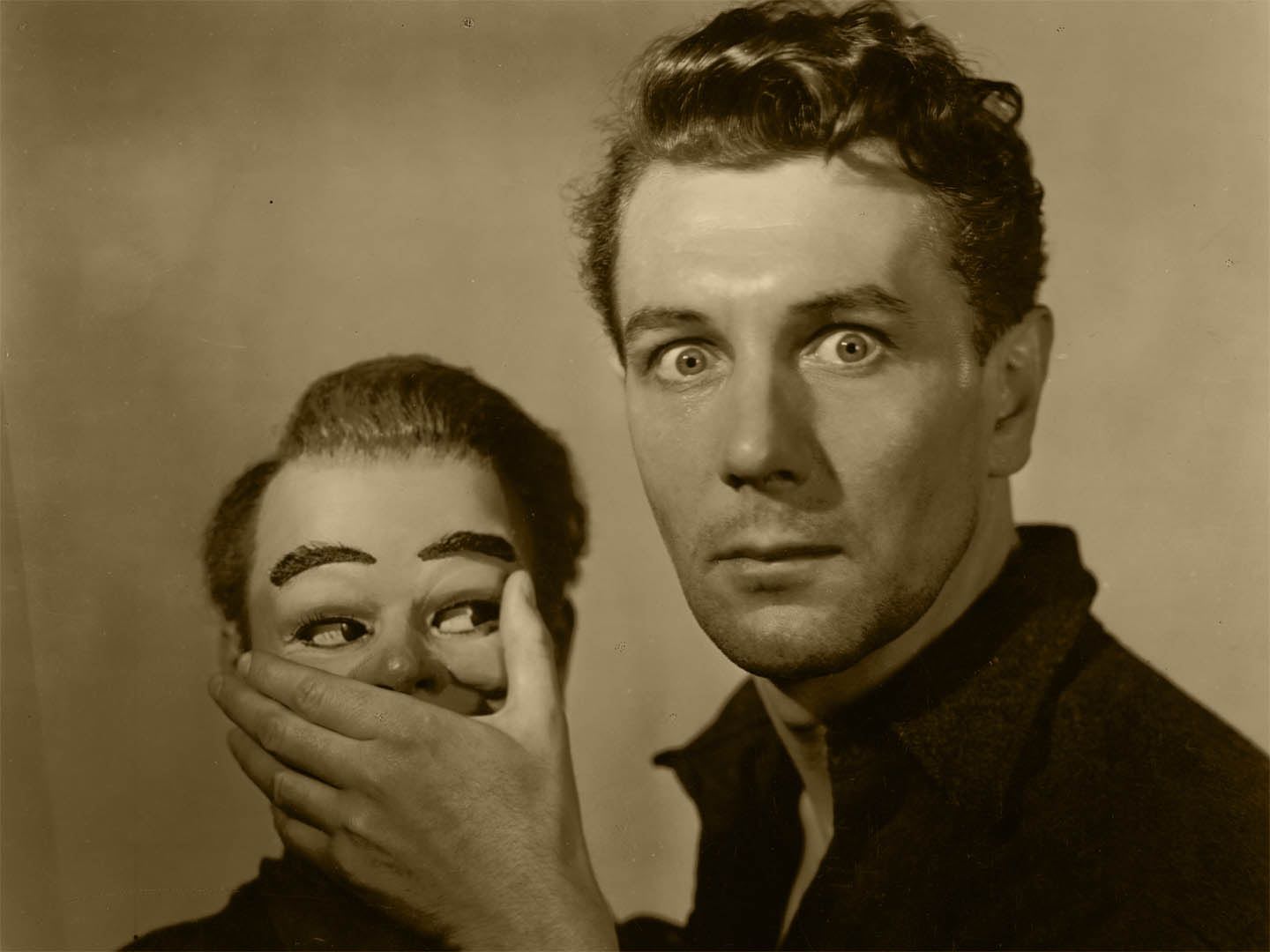

A vapor said to rise from a cleft within the rocks at Delphi was often said to be the source of her inspiration and was personified as the spirit of Apollo rising within her or even uniting with her sexually. Much was made of this by medieval Christian writers in efforts to demonize the Oracle. In this way, the voice that spoke from within her, while sometimes said to issue from her belly, was also described by these writers as having its source within her “filthy parts,” (bowels or genitals). We hear some particularly lurid passages along these lines, which bring us to some commentary on the spirit of Python” by the 17th- century German polymath, Athanasius Kircher, who weaves together noises from the belly, ancient Egyptian religion, and flatulence. From there, it gets really out of hand with a discussion of the supposed Roman or Greek “god of farts,” Crepitus Ventris.
We end with brief discussion and audio sampling from the 1970’s Christian ventriloquist, Marcy Tigner, better known under her puppets’ name, “Little Marcy.”
The Mesmerist
Our understanding of hypnotism, once known as “mesmerism,” has radically evolved over the centuries. This episode looks at where it all began, examining the fascinating (and rather weird) story of the 18th-century German doctor, Franz Anton Mesmer, after whom “mesmerism” is named.
We begin, with a look at the mesmerist’s sinister reputation in the 19th century, as reflected in the British writer George du Maurier’s 1894 novel, Trilby. While the book’s named for its protagonist, Trilby O’Ferrall, an Irish girl working as a model in a British artist’s colony in Paris, her nemesis is better known, namely, her vocal instructor, Svengali, an Eastern European musician whose hypnotic powers not only propel the aspiring singer to stardom but also come to dominate and ruin her life. We look at the novel’s forgotten popularity in its day, the phenomenon of “Trilbyana,” and the book’s cinematic adaptations, including the 1931 film, Svengali, with John Barrymore in the title role. Along the way, we note some surprising parallels with more prominently gothic novels and films.
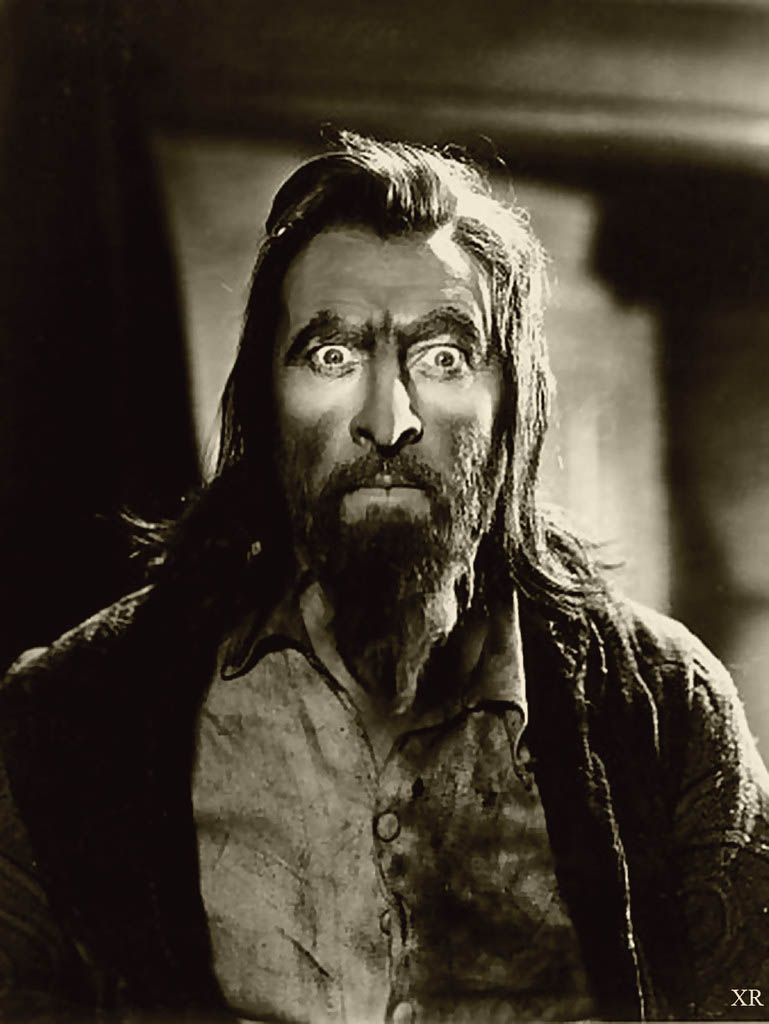
Beginning with Mesmer’s dubious scholarship at the University of Vienna, we make an attempt to untangle his concept of “animal magnetism,” describing an invisible, dynamic fluid, comparable to the “cosmic magnetism” that guides the planets, but particular to “animals” (i.e., creatures sharing an “animus” (L) or animating spirit.
We particularly focus on Mesmer’s experiences while in Hungary, where in 1775 he was summoned by a Baron Horeczky de Horka, who hoped the German doctor’s new form of therapy might succeeds where treatments of his condition by others had failed. We hear of several curious incidents occurring in the castle, which were documented in detail the family tutor and interpreter Herr Seifert, who had observed Mesmer with a skeptical fascination, expecting the man to be a charlatan.

We next look at Mesmer’s return to Vienna where he attempted the cure of Marie Paradies, a talented musician blind since the age of three who mingled with the musical elites of her city and was regarded with favor by the Imperial court.
As the results here were dubious at best, we then follow Mesmer on his escape to Paris, where he becomes a faddish celebrity. Mrs. Karswell reads for us a lengthy descriptions of his “magnetic salons,” as observed by a Scottish physician, John Grieve, during a visit to Paris in 1784. During that same year, however, Mesmer’s increasing fame drew the attention of the state, and his techniques were the subject of two Commissions called by Louis XVI. The results were unfortunate for Mesmer but provide listeners with some tasty descriptions of the collective madness involved in those salons.
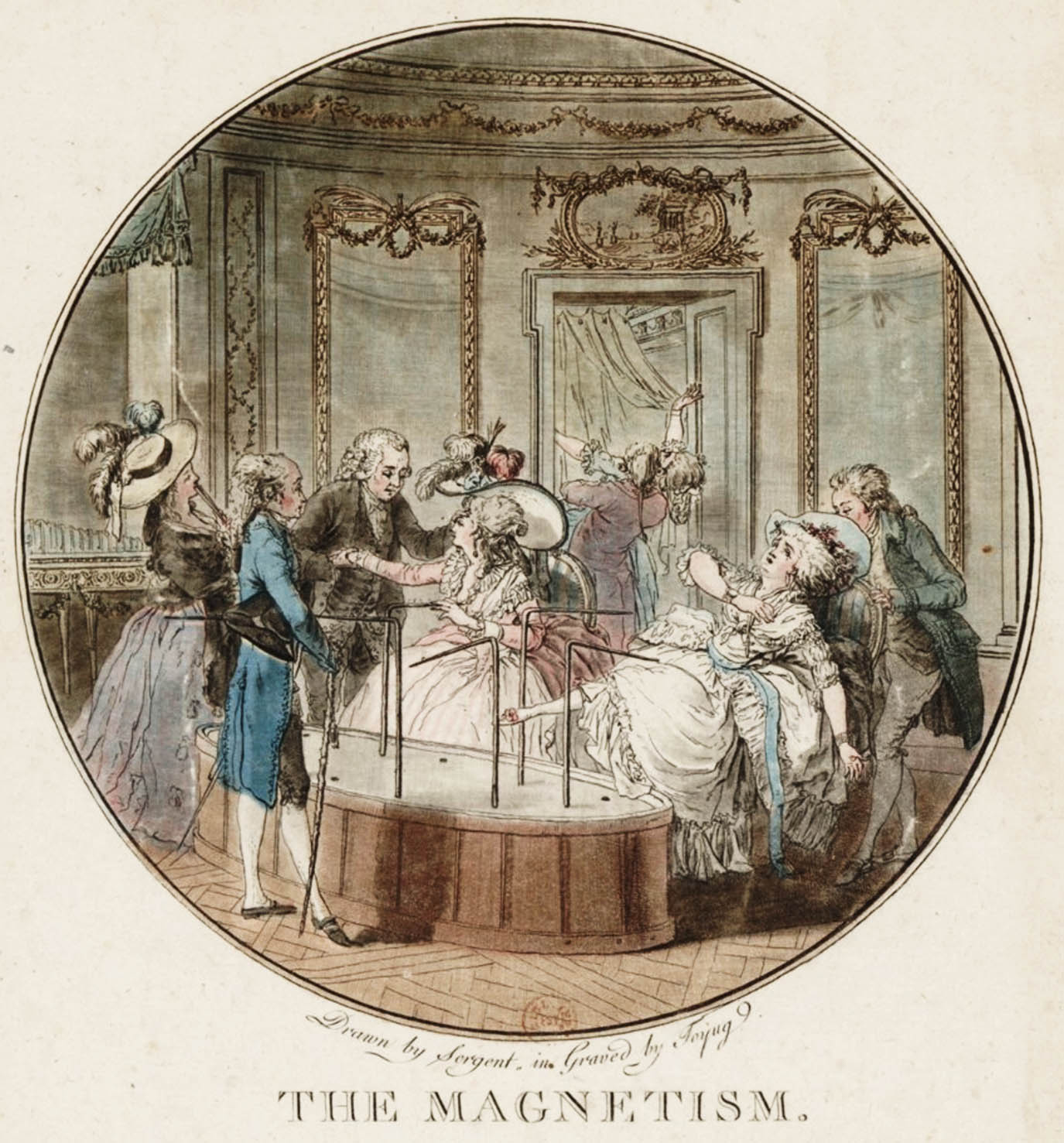
We then have a look at the connection between Mesmer and the Mozarts (primarily father Leopold but to some extent also his musical Wunderkind, Wolfgang,) and here we note Mozart and Mesmer’s mutual fondness for the glass harmonica — Ben Franklin’s invention consisting of a series of glass bowls of descending size mounted on a horizontal spindle, rotated by a foot treadle and played with a wetted finger. While Mesmer considered its sound to have healing “magnetic” properties, others regarded the unearthly sounds with suspicion, and so we hear a bit of lore about the glass harmonica’s “cursed” (and even lethal) reputation during the 18th century.
The show closes with a charming story about a canary kept by the great mesmerist until the day of his death, which is also described.
NOTE: This episode also references the new publication, We Need to Talk About Death, a book by our very own Sarah Chavez, which is now available from Amazon and through stores near you.
Banshees (Rebroadcast)
Banshees are spirits of Irish folklore, who warn of impending deaths. Originally considered fairies, their Irish name, bean sídhe, means “woman of the mounds,” those mounds (sídhe) being the ancient burial mounds believed in Ireland to be the home of fairies.
The banshee’s wailing, which betokens imminent death of a blood relative, is probably based upon the wailing of Irish mourners called “keeners,” from the Irish word caoineadh, or “lament.” You can hear some snippets of traditional keeners in this segment, incliuding a 1957 field recording released by Smithsonian Folkways.
Next we look at how the banshee’s appearance and behavior derives in part from that of Irish keeners, including some odd details having to do with petticoats. Her origins in the fairy world also has often suggested that she may be small of stature. We also examine some folktales involving combs lost by or stolen from banshees, and what you should or should not do should you find one.
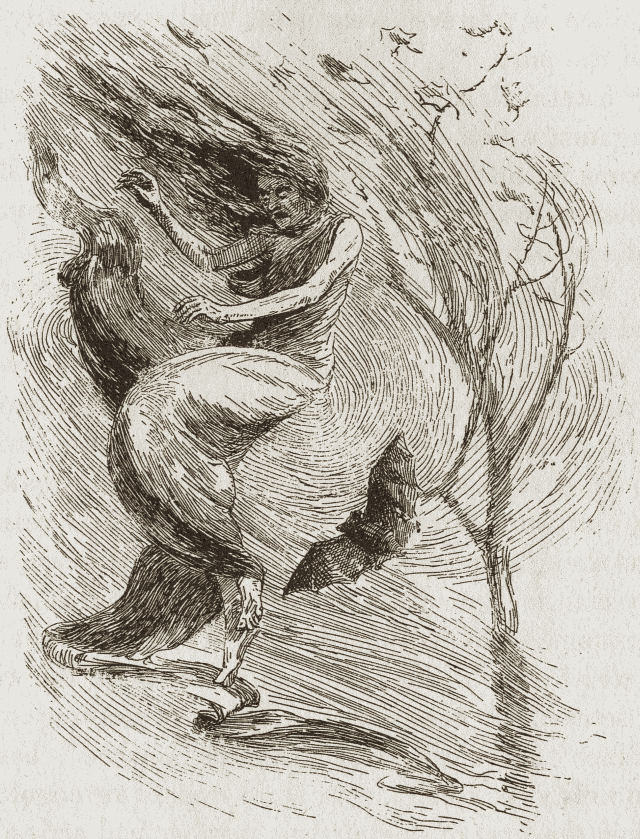
While the banshee is attached strictly to particular families, she is not bound to the Emerald Isle. We hear some accounts of her following travelers to other countries, including a surprising tale involving a party aboard an Italian yacht.
The figure, as she’s known today, receives no mention in print until the 17th century. Mrs. Karswell reads for us what is probably the earliest account, retelling an incident experienced by Lady and Sir Richard Fanshawe, an English ambassador and his wife visiting Ireland.
This account also introduces the notion that a banshee may not originate in the fairy world, but may also be a vengeful ghost. We hear another tale in this mode associated with Dunluce Castle in County Antrim, a location known for its “banshee room,” a feature duplicated in Shane’s Castle, about an hour to the south. Both of these castle banshees are sometimes called “the red sisters,” so named for the color of their hair.
After a brief side trip to make note of figures similar to the banshee in Scotland (the caoineag) and Wales, the cyhyraeth and gwrach y rhibyn, we turn to older figures of the fairy realm regarded as banshees, but rather different from the figure born in the Early Modern Period.
The first of these is Clíodna, who was known as the queen of the banshees of southern Ireland, particularly the province of Munster. Unlike the modern banshee, a solitary figure who does little more than wail and make those well-timed appearances, Clíodna engages in romantic affairs, including a romantic rivalry with her banshee sister Aoibhell, a matter culminating in a magical battle with both transformed into cats.
Aoibhell also appears in an important story about Brian Boru, founder of the O’Brian Dynasty, whose army defeats an alliance of Vikings and Irish lords fought at the Battle of Clontarf, near Dublin in 1014. While Boru’s forces are victorious, he and his son are visited by Aoibhell, who heralds their deaths not with a wail, but music played on her harp from the fairy world. We hear a similar story about the Irish hero and demi-god Cúchulainn encoutering Aoibhell as a death omen.
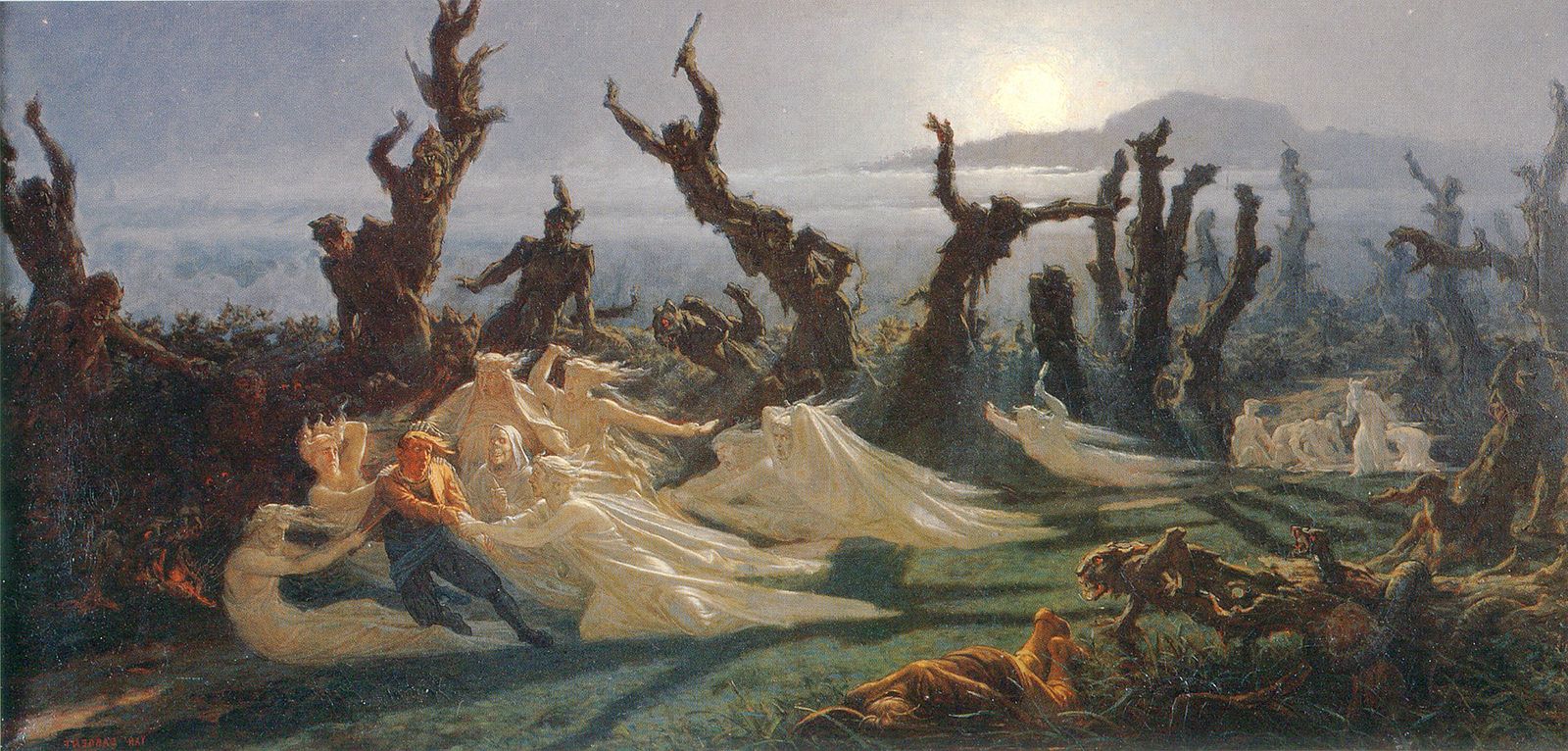
Cúchulainn also encounters a banshee-like figure of the type folklorists call, “the Washer at the Ford,” or in Celtic regions elsewhere, like Celtic Britanny, “the Midnight Washer.” The figures appear at lonely bodies of water washing bloody shrouds, or often armor, as they are particularly inclined to predict the deaths of soldiers and armies. We hear a particularly splendid account of one such figure from the 12th-century Triumphs of Torlough — one, which in its generous use of horrific adjectives sounds as if it were written by H.P. Lovecraft.
The episode ends with a quick look at a couple cinematic bamshees, including one which has earned a place in the nightmares of children encountering it in the 1950s-70s. The two movies we hear bits of are Damned by Dawn and Darby O’Gill and the Little People.
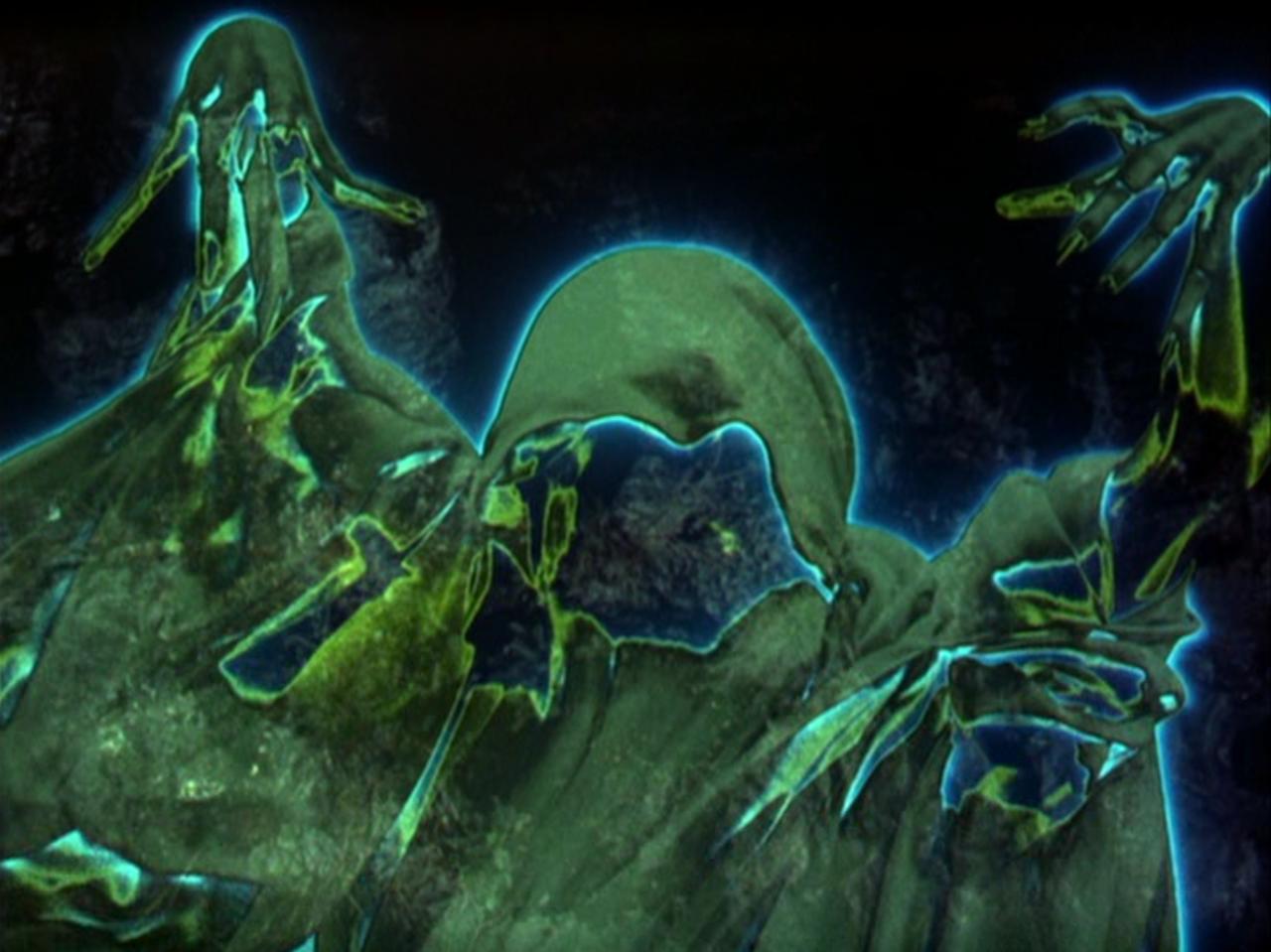
Glass-Coffin Girls
The story of Snow White, as told by the Brothers Grimm, is only one of many narratives involving girls who have fallen into a deathlike state and are displayed in a glass coffins. In this episode, we examine the sordid details of the Grimm’s original 1812 version of the tale and compare it with analogous stories dating back to the 12th century.
We begin with a review of the Grimms’ original story, many aspects of which have been subsequently muddled and obscured not only by Disney but by later alterations made by the Grimms. These include the identify of the Evil Queen, the malevolence of her intent, the purported benevolence of the Huntsman, and particularly, the nature of Snow White’s resurrection.
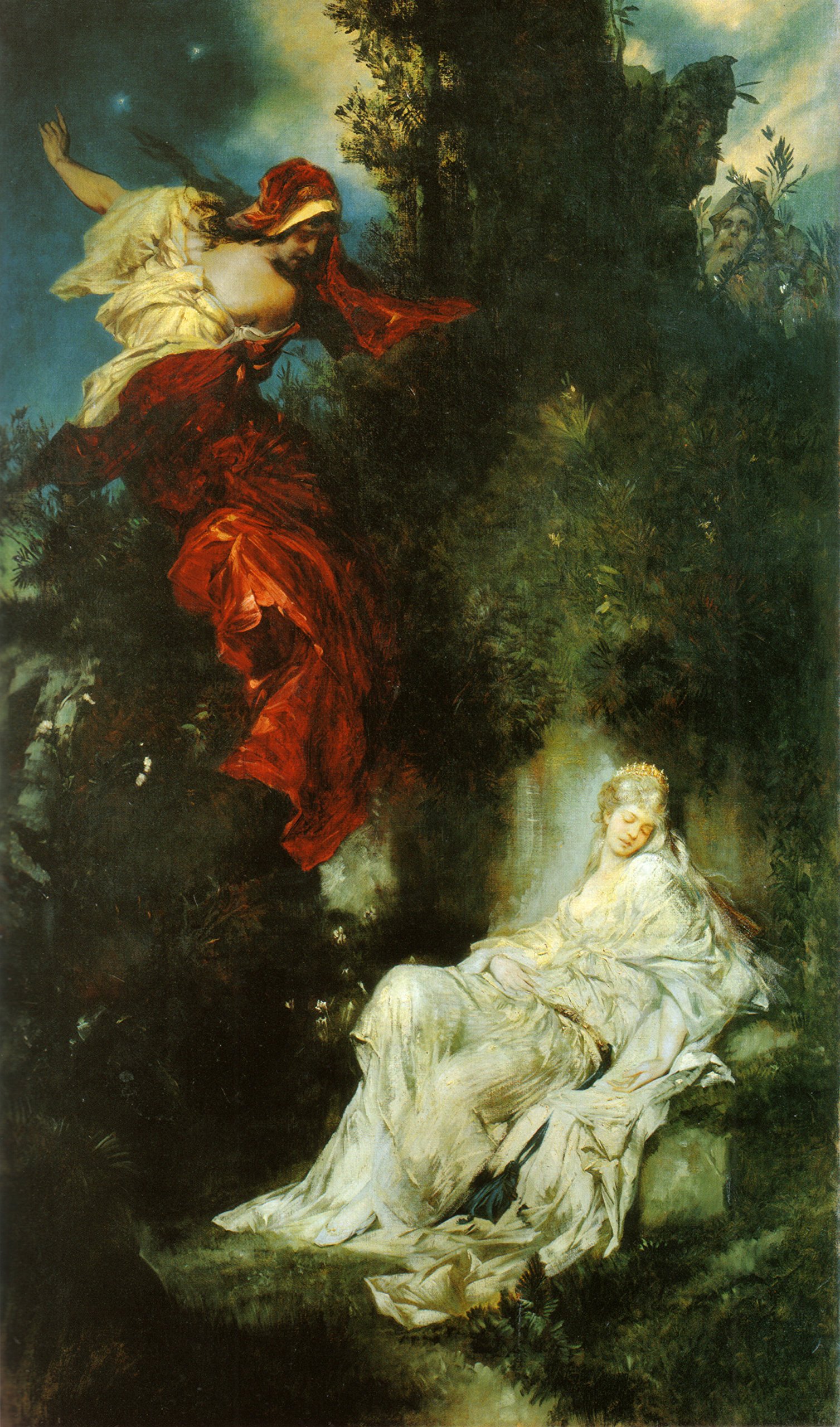
After this, we have a look at the immediate predecessor to the 1812 story, a children’s play of the same name by the (unrelated) German author Albert Ludwig Grimm. Though it features dwarves who aid Snow White, a magic mirror addressed in rhyme, poisoned fruit, deception involving the heroine’s purported death, and glass coffin, it proves to be a very different story.
The next tale explored is the 1782 novella Richilde, by the German writer Johann Karl August Musäus. Surprisingly, the title character here, Richilde, is the wicked stepmother rather than her step-daughter Bianca, whose name in Italian (i.e., “white”) might be compared to “Snow White.” Set in medieval Brabant (Belgium), this one has Bianca courted by a prince whom the jealous stepmother hopes to see married to her own daughter. A further complication is presented by the fact that the prince here is already married.
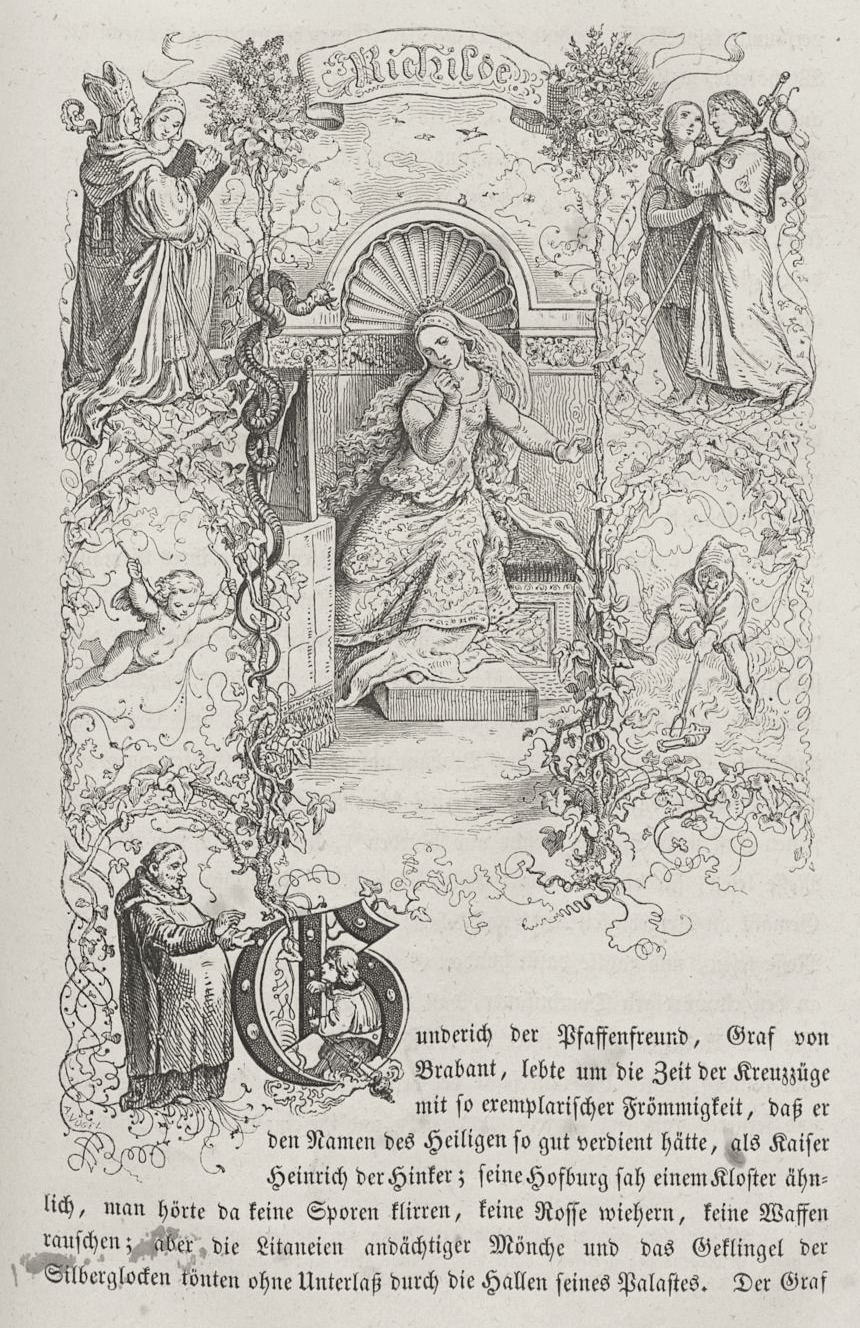
We then take a look at the rarely mentioned Russian story, “The Tale of the Old Mendicants,” (my translation) published in the 1794 collection, An Old Song in a New Setting, or a Complete Collection of Ancient Folk Tales, Published for a lover of them, at the expense of the Moscow merchant Ivan Ivanov (my translation). In this one, the role of the Evil Queen is played by an innkeeper jealous that her guests have complimented the beauty of her daughter rather than her own. The alms-collecting monks of the title are used by the mother to deliver a poisoned shirt to the Snow White character, Olga the Beautiful.
Our next offering comes from the 1634 volume by Neapolitan writer Giambattista Basile, Il Pentamerone, or The Tale of Tales, the very first collection of fairy tales, with which the Brother Grimm were definitely familiar (and one featured in our earlier “Dark Fairy Tales” episodes, both One and Two ). The story in question is “The Little Slave,” which combines elements of Snow White, Sleeping Beauty, and Cinderella. Here, the Snow White character, Lisa, again falls into a death-like swoon and is kept within not one but seven glass coffins in a locked room. The story resolves itself with the aid of a doll, a whetstone, and a knife.
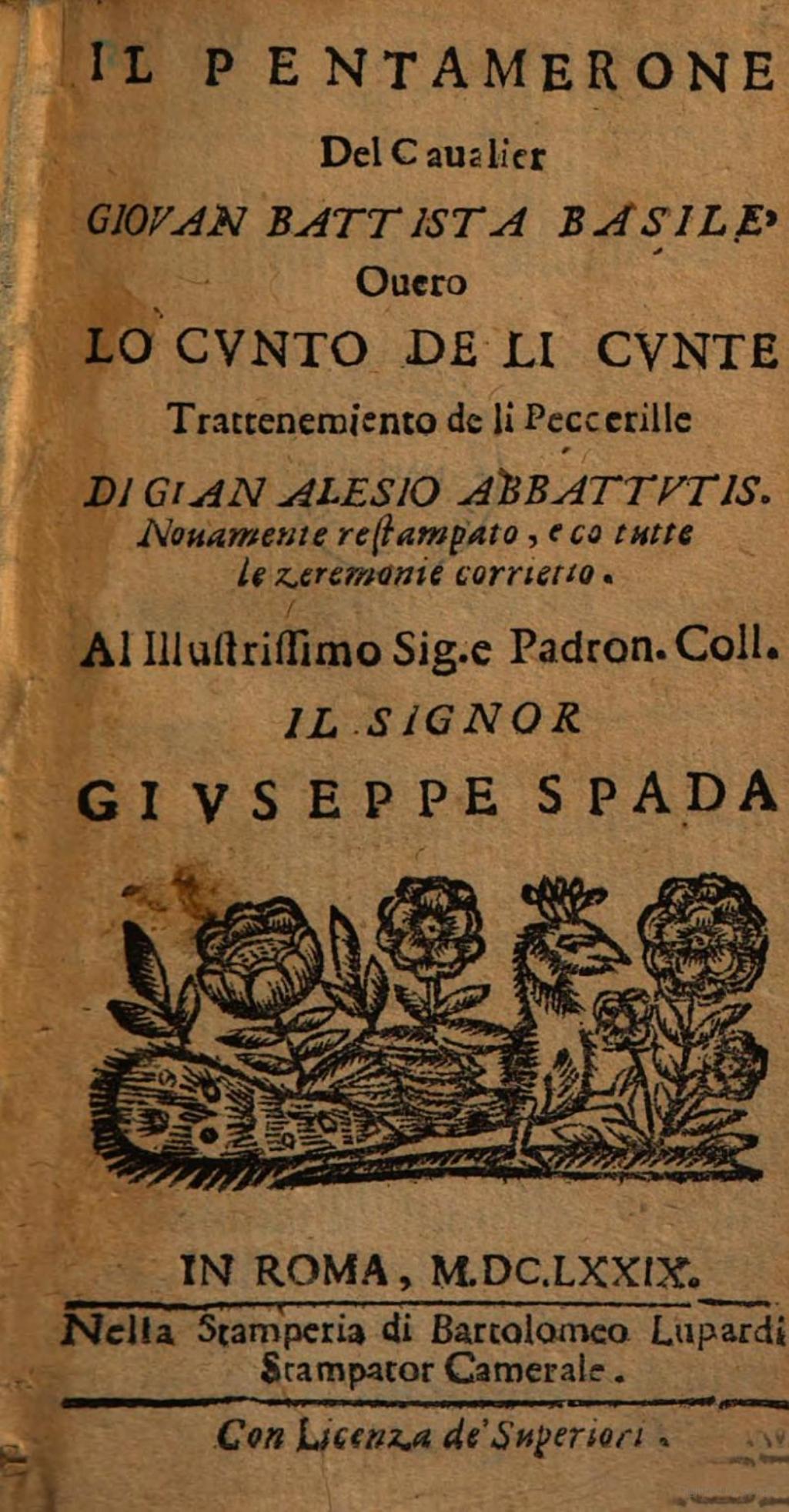
Our earliest story paralleling Snow White, is quite a bit older — from the 12th-century, the Lai of Eliduc by Breton writer Marie de France. While serving a king in England, the Breton knight Eliduc falls in love with his lord’s daughter, Guillardun, who falls into a swoon during an ocean voyage. Eliduc (who is not exactly innocent when it comes to Guillardun’s condition) transports the body of his love back to France and keeps it on the altar of a deserted woodland chapel. In this case, the story resolves itself thanks to a very clever weasel.
After our more detailed examination of these strangely paralleled stories, we take a quick look at the wide range of more recent variants that were committed to print after the Grimms published their work and at a rather ugly controversy that engulfed German town, Lohr am Main, after it claimed to be the birthplace of the Snow White Legend.
Our episode ends with Mrs. Karswell’s reading a particularly dark and brutal tale about seven dwarves collected by Swiss historian and folklorist Ernst Ludwig Rochholz in his 1856 volume, Swiss Legends of the Aargau.

Audio Fix on Episode 125
A few listeners commented that Mrs. Karswell’s dialogue was muffled at points in “Sorcery Schools of Spain.” That episode is now updated with a corrected version. Thanks for letting us know.
Sorcery Schools of Spain
For centuries, Spain was said to be the home of secret, underground sorcery schools, Toledo being the first city with this reputation and later Salamanca. The notoriety of the latter was more enduring, and when the legend passed to Spanish colonies of the New World, the word, “Salamanca” was embraced as a generic term for any subterranean location said to be the meeting place of witches. We begin the show with a clip from the 1975 Argentine film Nazareno Cruz and the Wolf, which depicts just such a place.
A particularly early reference to this concept can be found in a romanticized 12th-century biography of a particularly interesting character, a French pirate and mercenary Eustace the Monk. Mrs. Karswell reads for us a passage written by an anonymous poet of Picardy, who describes Eustace’s occult schooling in the city of Toledo. Along with this we hear as a passage from a 1335 Tales of Count Lucanor by Juan Manuel, Prince of Villena, which adds another element to the legend, that of its underground location.
Curiously, a number of Spanish cities claim as their founder the Greek demigod Hercules, but in Toledo, he’s also credited with founding this school of magic, excavating a subterranean space in which he imparts his supernatural knowledge, at first in person, and later in the form of a magically animated sculpted likeness. Another Toledan legend, was later blended into this mythology. It’s the story in the Visigoth King Roderick, Spain’s last Christian ruler makes a discovery prophesying his defeat by the Moors in 711 CE. Along with a parchment foretelling this, Roderick exploration of this enchanted palace or tower results in the discovery of the Table of Solomon, a construction of gold, silver, and jewels also attributed with occult powers. Legends detailing this are believed to be of Arabic origin, first recorded in the 9th century and later appearing in One Thousand and One Nights. In later Spanish retellings, the treasure house is conflated with the Cave of Hercules, and the fall of Spain to the Moors is attributed to Roderick breaking of a spell woven by Hercules, to keep North African invaders at bay.

By the 16th century, this site (now identified as an ancient Roman structure underlying Toledo’s church of San Ginés) had inspired such wild tales that Cardinal Juan Martinez Siliceo organizes a 1547 expedition into a subterranean space in hopes of putting the rumors to rest, but it hardly succeeded at that. Mrs. Karswell reads a dramatic 1625 account of that misadventure.

While talking bronze heads and magic mirrors were being added to descriptions of the Toledo site, in the late medieval period, similar legends began to be told in Salamanca. Being the site of one of Europe’s most ancient universities in a time when scholars were not infrequently misunderstood as magicians, legends of this sort would naturally be associated with Salamanca. But unlike the universities of Paris, Padua, and Bologna, Salamanca’s location in Spain made it a center of Moorish learning and the study of Arabic texts filled with strange calligraphy, figures and charts readily passing for books of magic.
As Salamanca’s reputation emerged later, in an era after the witch trials had begun, instruction no longer was provided by a figure from classical mythology but from the Devil, one of his demons, or a professor or student in league with the Dark One. A favorite character filling this role was the Marqués de Villena, a scholar who’d written books on alchemy and the evil eye. Villena appears in a number of literary works of the era, both in Europe and the New World. In the 1625 play, The Cave of Salamanca, by Mexican dramatist Juan Ruiz de Alarcón, Villena figures into a scenario that became fairly standard in Salamanca stories, one involving the Devil’s payment for the lessons provided. This would be demanded in the form of a human soul, the victim chosen by lot among the seven students instructed at the end of a seven-years period.
In Salamanca, the underground location of this magic school is strangely associated with a Christian site, the Church of San Cyprian, a significant choice, as St. Cyprian of Antioch has strong occult associations throughout the Catholic world but especially in Spanish and Portuguese-speaking regions. Before Cyprian came to Christianity, this 3rd-century saint is supposed to have been a sorcerer and is sometimes referred to as “Cyprian the Magician”. His story is mirrored in Portugal by that of Giles of Santarém, and both figures appear in Spanish and Portuguese literary works in which the saints play roles parallel to that of the Marqués de Villena, and the magic school becomes “The Cave of Cyprian.”
There are also legends that the magical secrets of the pre-conversion Cyprian were preserved, and on the Iberian Peninsula particularly (but also prominently in Scandinavia) grimoires and spell books attributed to Cyprian began circulating as early as the 16th century. After a brief look at the history of these magic books, we turn our attention to the New World and their legacy there. In particular, the use of such books in Portuguese folk magic brought Cyprian the Magician to Brazil where, where he was absorbed into the syncretic religions of that country. The practice of Macumba, one of these religions synthesizing West and Central African beliefs with those of Catholicism, and 19th-century Spiritism, Cyprian the Magician is transmogrified into São Cipriano dos Pretos Velhos, or Saint Cyprian of the “Old Blacks” an embodiment of the departed African Ancestors. Our show ends with a Macumba chant dedicated to this figure and a Spanish prayer to St. Cyprian for protection against witches, curses, and the evil eye.
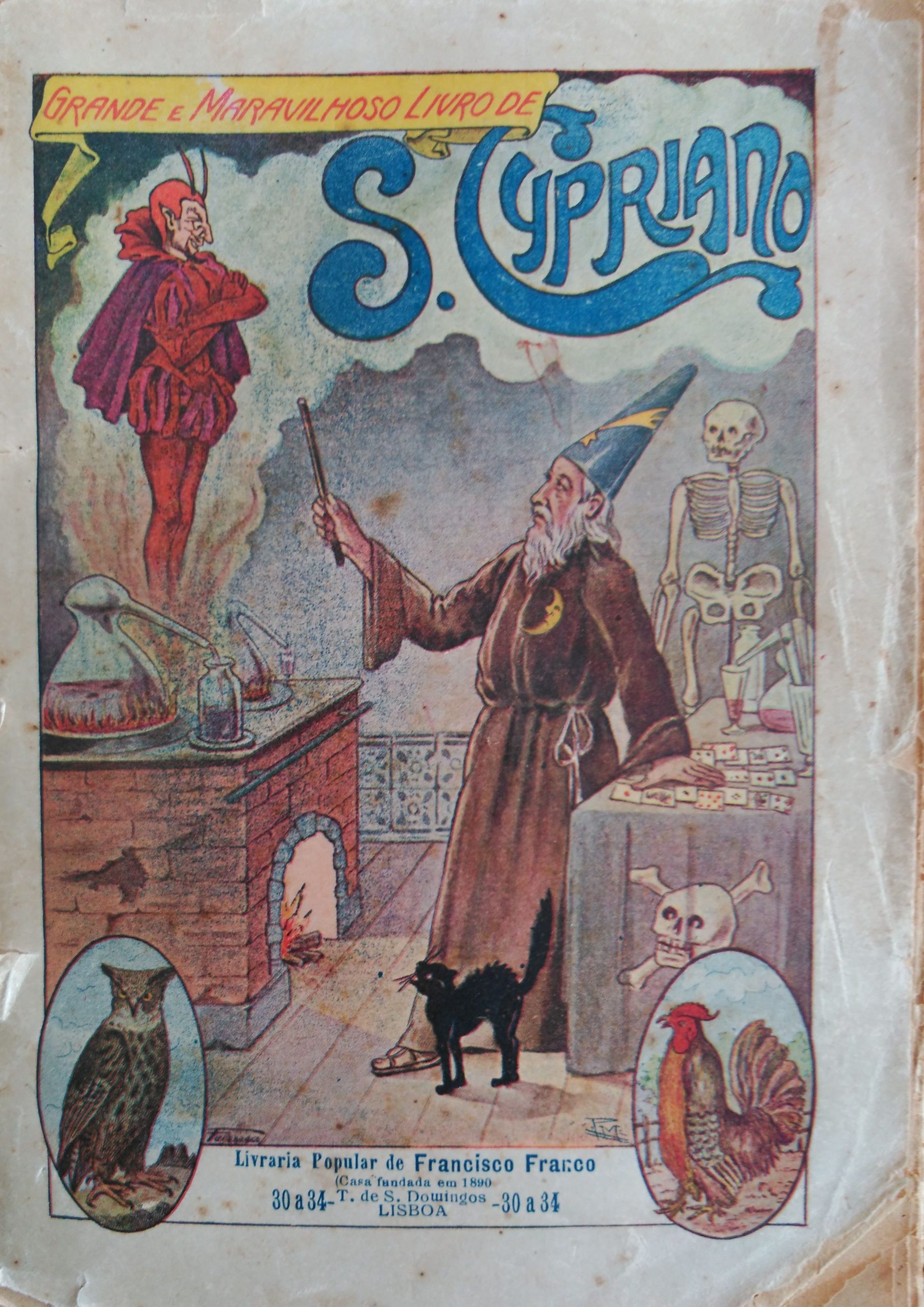
A Christmas Ghost Story VI
Tonight we bring you our sixth annual Christmas ghost story, a tradition particularly beloved in Victorian and Edwardian Britain. First published in 1908, and set in the days before Christmas, the tale is by British writer Algernon Blackwood (from whom we earlier heard “Ancient Lights“) and whom many listeners will know through his other works, particularly, The Wendigo or The Willows. Throw a log on the fire, refill the brandy, and settle back for Mrs. Karswell’s reading of “The Kit Bag.”
Christmas Superstitions
The Christmas season is rich in superstitions. The whole period from the beginning of Advent, through the day itself, and especially throughout the twelve days (and nights!) between Christmas and January 6 or Epiphany are, in a sense haunted, a time when spirits are afoot and behavior is hemmed in by restrictions upon normal activities. Recently I stumbled upon a good collection of these folk beliefs in a volume from 1903 entitled Encyclopaedia of Superstitions, Folklore, and the Occult Sciences of the World: (And subtitled, A Comprehensive Library of Human Belief and Practice in the Mysteries of Life). The book’s contents are indeed as comprehensive as that title, and from their section on Christmas, I’ll be sharing some of the more interesting examples.
The show closes with a recording of a song sung by costumed Swiss holiday figures known as Silvesterchläuse. In the hinterlands of the Canton of Appenzell-Ausserrhoden, the se Silvesterchläus, groups of men and male youths wearing huge bells and ornate costumes, go door to door to offer seasonal blessings and sing songs like the one you will hear.
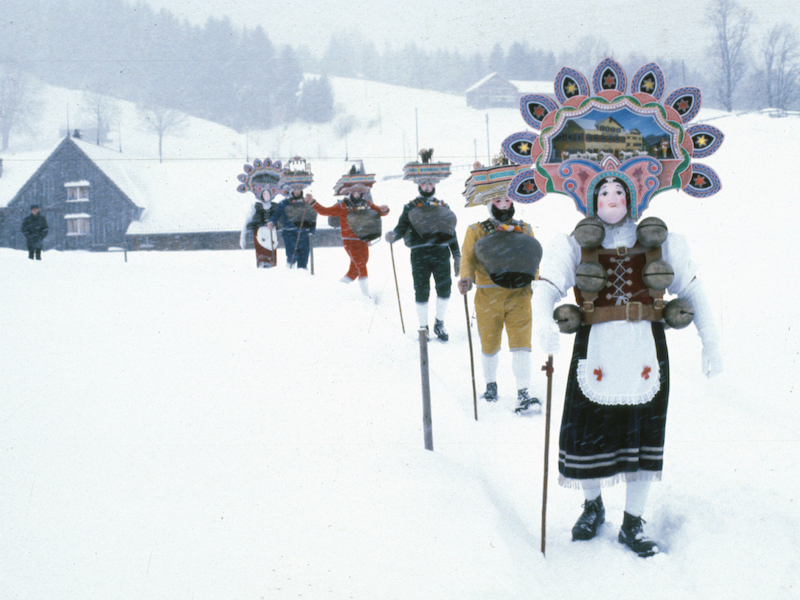
The Monster of Glamis
The Monster of Glamis was a Victorian legend involving a Scottish castle, a secret chamber, and a monstrous aristocrat hidden from the world–a perfect story for Bone and Sickle’s return to its old format, a 45-minute deep-dive into the castle’s lore, including its association with Macbeth, a legend of a cursed Earl’s card game with the Devil, as well as theories regarding the extravagant measures employed to keep the castle’s terrible secret. Along the way, we learn a bit about other secret chambers in castles and estates of Britain, a scandal involving the Royal Family, and a connection between the Glamis legend and a popular literary trope of the day, one embraced in Gothic fiction and later in the pulps and horror films. We even hear Lon Chaney, Jr. sing!

An Old-Fashioned Halloween Party
Tonight we recreate for you elements of an old-fashioned Halloween party as experienced in the 1920s or ’30s. Foods, games, spooky stories and poems in an extra-long Halloween episode.
For more retro delights of the era, listen to Episode 35 “Vintage Halloween.”

The Spook House
“The Spook House,” an 1899 short story by Ambrose Bierce is suitably spooky for the season, but not in the way you expect.It was a favorite of H. P. Lovecraft, who praised its “terrible hints of a shocking mystery.” Also, a macabre bit of poetic whimsy from A.E. Houseman, and an intruder is welcomed in Mr. Ridenour’s library.
Ghouls
The lore of graveyard-haunting ghouls is unexpectedly best explained in a seminal work on the subject of werewolves. We hear in this episode from the 1865 volume, The Book of Were-Wolves, by Sabine Baring-Gould, an Anglican priest known for his voluminous writings on folklore, local curiosities, and church history. While our episode is called “Ghouls,” and ghouls are indeed what the author had in mind, Baring-Gould named this chapter “The Human Hyæna.” probably to better harmonize with the book’s theme of human-animal transformations.
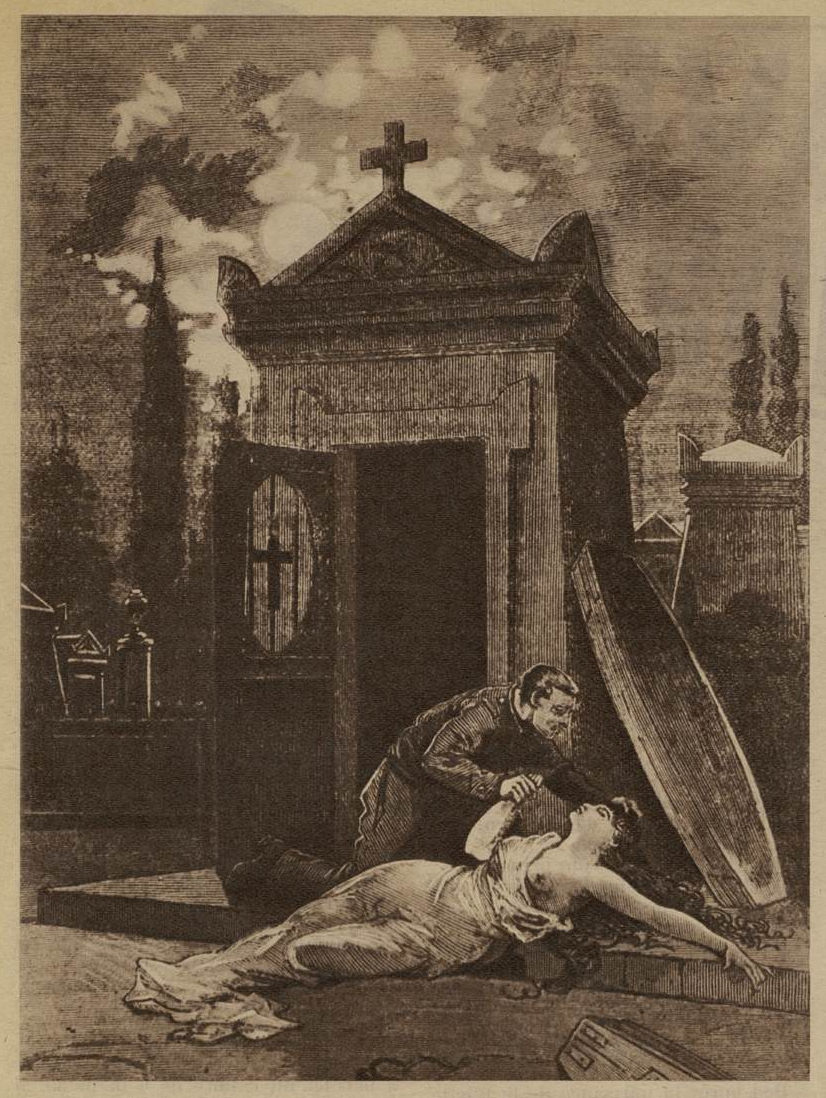
Announcement: Listener Trick-or-Treat
A special short announcement regarding Trick-or-treat by mail option for listeners joining Patreon. Find out how you can receive a hand-packed candy bag from the home of Bone and Sickle Podcast. Each goody bag is guaranteed to include sinister extra as described in Halloween urban legends.
Visit: https://www.patreon.com/boneandsickle
Only while supplies last!
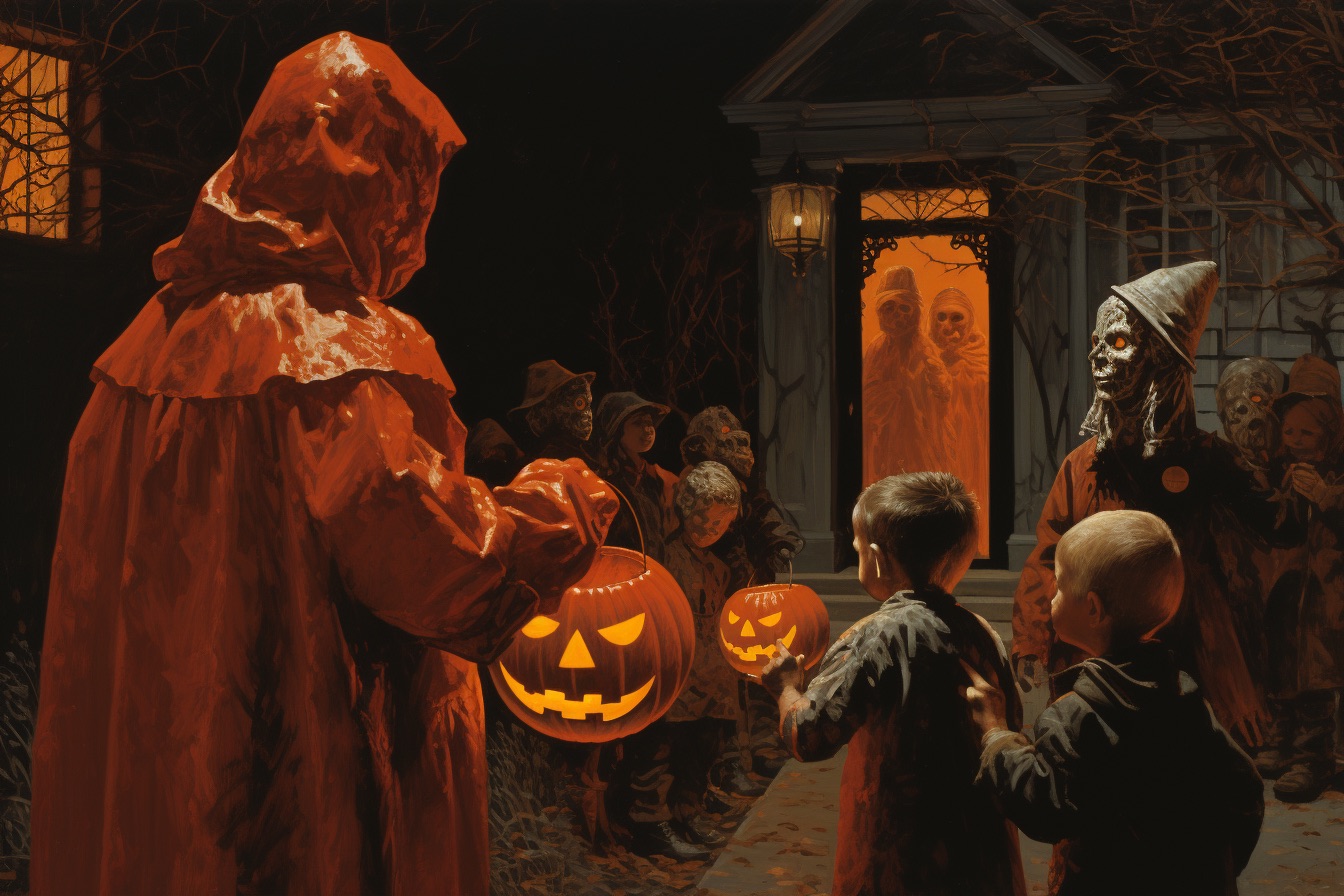

Six Witches
Six historical witchcraft cases as related in the 1880 volume by James Grant, The Mysteries of All Nations, Rise and Progress of Superstition, Laws Against and Trials of Witches, Ancient and Modern Delusions Together with Strange Customs, Fables, and Tales.
Mr. Ridenour and Mrs. Karswell also share listener comments on the Halloween season as well as a remix of a seasonal viral video.
A House Struck by Lightning and Other Curiosities
Marvel and cringe at this collection of curious cases presented from a favorite Victorian volume. Tonight’s episode includes a bit of proto-Forteana, namely the anomolies left in the wake of a particular lightning strike that fell on a small town in Hertfordshire in 1777. We also have brief look at the wicked deeds of those popes the Catholic Church would rather forget about, and we close with two gruesome gustatory cases, one macabre and the other simply bizarre.
A Viking Funeral
Scenes of fiery Viking funerals have been woven into any number of literary and cinematic tales, but sources on the topic are limited. In this episode, we hear from what’s probably the definitive source, a firsthand account written in the 10th-century by an Arab traveler and diplomat, Ahmad ibn Fadlan, who was visiting what would be modern Ukraine, an area then populated by Germanic tribes originating in Sweden. Fadlan’s unflinching description of the bloody and brutal rites, it should be noted, may not be an easy listen for younger or more sensitive members of our audience.
“Ancient Lights” by Algernon Blackwood
Why not enjoy a reading of Algernon Blackwood’s “Ancient Lights” before wandering off into those summery woods — a classic work of Weird Fiction read and dramatized with sound and music from your imaginary friends at Bone and Sickle.
Russian Vampire Tales
The folklore of Russian vampires describes a creature slightly different than what we’re accustomed. In tonight’s show we share a number of traditional tales from the 1873 volume Russian Folk-Tales by W. R. S. Ralston, a leading light of the Imperial Geographical Society of Russia and author of The Songs of the Russian People.
Swan-Upping and Other Curious British Customs
Explore some curious British Customs with us, including those of Midsummer, swan-upping, egg-hopping, St. Bartholomew’s knives, and the violent tradition of St. Michaelmas “ganging.” Our source for this episode is the 1911 volume by T. F. Thistelton Dyer, British Popular Customs Present and Past. Illustrating the Social and Domestic Manners of the People. Arranged according to the Calendar
of the Year.
Malignant Vapor
A malignant vapor, weird plagues and punishments, a Polish dwarf, and a perilous journey into the lightless depths of a pyramid — all included in this pleasantly macabre collection of short tales from a favorite Victorian compendium of curiosities: The Terrific Register, or, Record of Crimes, Judgments, Providences, and Calamities (London, 1825)
Animal Ghosts
Tales of animal ghosts are usually relegated to the periphery of ghost story collections, but in this episode, we showcase this class of apparition. Our stories were collected in a volume from 1915 called Human Animals by Frank Hamel. It covers werewolves, animal transformations through witchcraft, possession by totemic animal spirits, and the phantom animals that haunt lonely roads, ancestral homes, and the storytellers’ imaginations.
The Colony of Cats
Fairy tales featuring cats are generally pleasant. After our last show about malformed births, we thought, Andrew Lang’s story, “The Colony of Cats” might be a pleasant tonic, albeit one with a bizarre punishment sequence included. Published in 1909 in Lang’s Crimson Fairy Book, this story (read by Mrs. Karswell) seems to be a version of the tales discussed in our July 2022 show, “Heads in a Fountain, Bones in a Bag.” Lang provides no background on his sources, but it’s presented as an Italian tale.
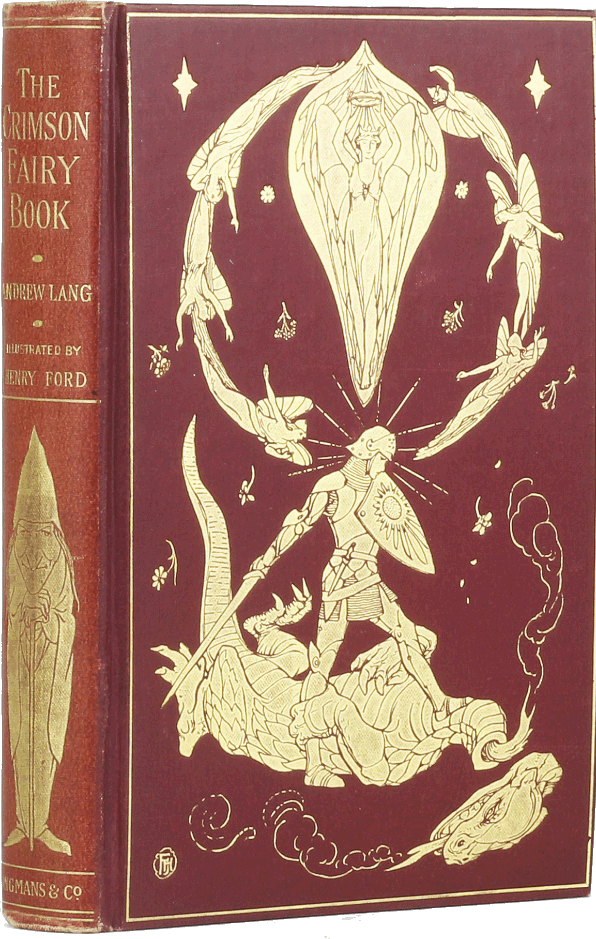
Strange Births and Monsters
For centuries, strange births, often sounding like mythological monsters, were regarded as portents of ill omen. We hear a number of these fantastical accounts, including a description of the birth of the”Monster of Ravenna” believed to foreshadow not only the defeat of Louis XII’s forces during the 1512 Battle of Ravenna but also taken later as a sign of God’s wrath and religious turmoil roiling up in the Reformation.
The accounts related are compiled in the 1820 volume, edited by R.S. Kirby, and entitled Kirby’s wonderful and eccentric museum; or, Magazine of remarkable characters. Including all the curiosities of nature and art, from the remotest period to the present time, drawn from every authentic source.
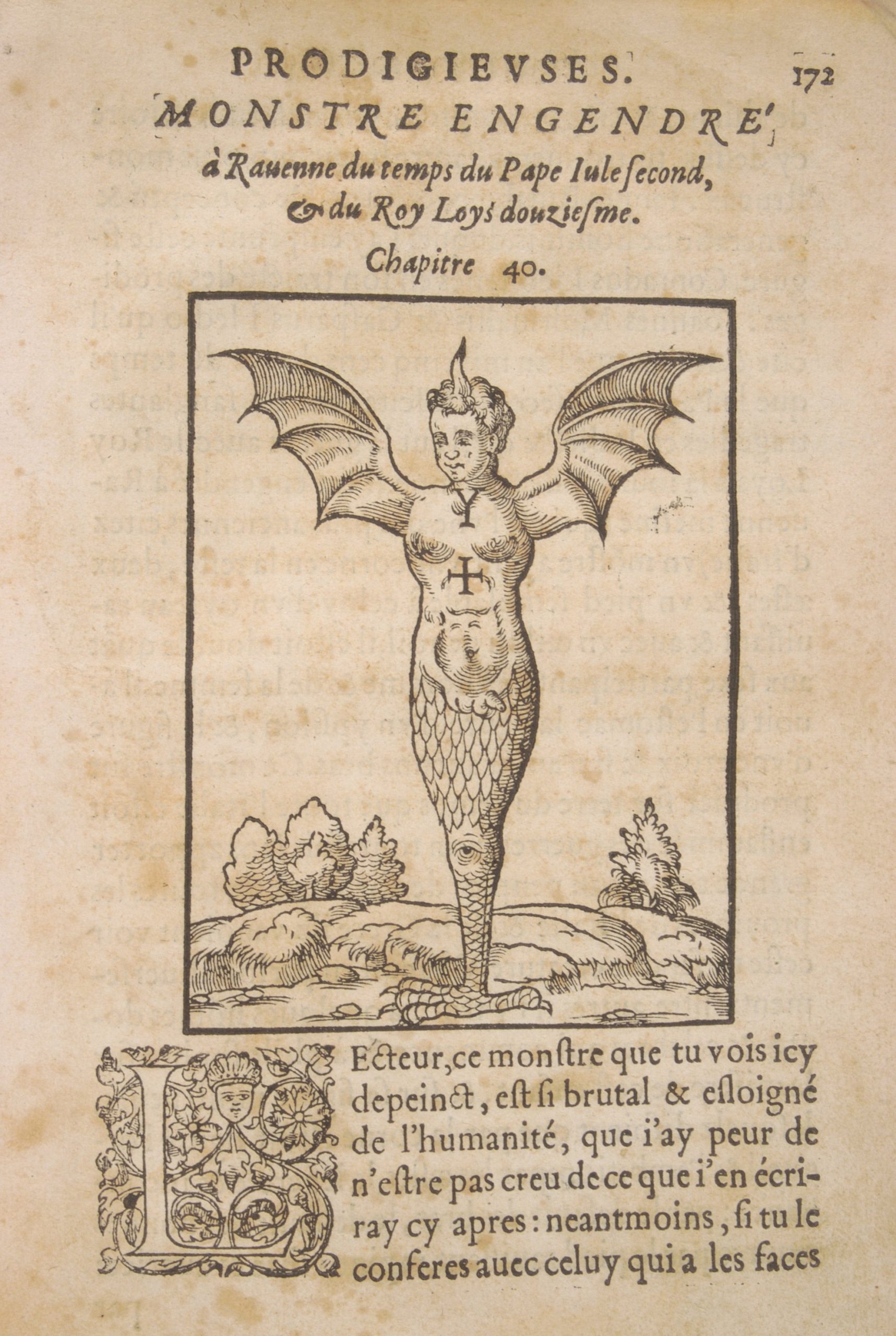
The Man Who Crucified himself
A self-crucifixion that occurred in 1806 on the island of San Servolo in the Venetian lagoon is the topic of our story this time around. The perpetrator and object of this crucifixion was Mattio Lovat, anglicized in our text as “Matthew Lovat.” The selected narrative comes from an 1826 collection edited by Henry Wilson called Wonderful Characters: Comprising Memoirs and Anecdotes of the Most Remarkable Persons of Every Age and Nation: Collected from the Most Authentic Sources.
An illustration of the event from Wonderful Characters…
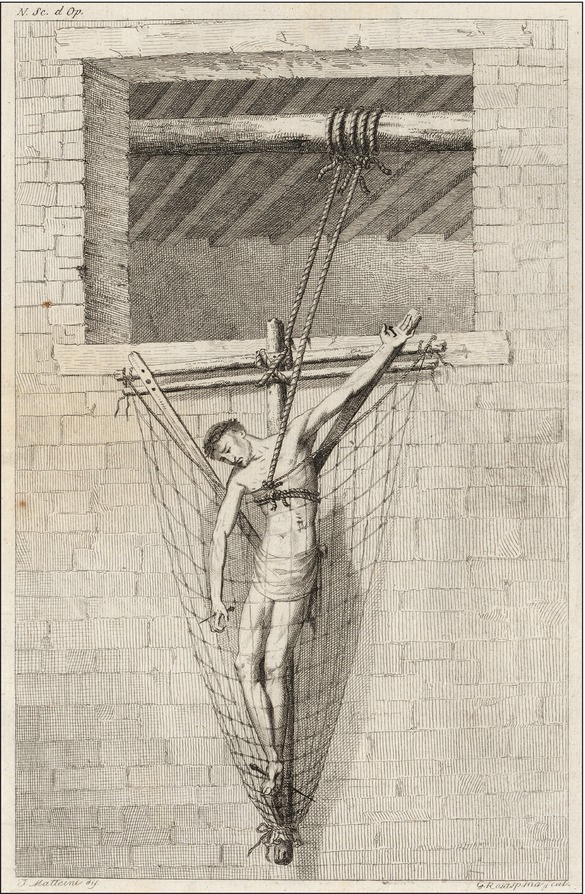
An Irish Ghost Story
An Irish ghost story seems a good way to add a bit of Halloween spice to your St. Patrick’s Day. Our selection, which will be read by Mrs. Karswell, comes from the 1825 publication Fairy Legends and Traditions of the South of Ireland. It’s the first of three volumes of stories told by the Irish antiquarian Thomas Crofton Croker, one of the earliest collector of the island’s folk tales.
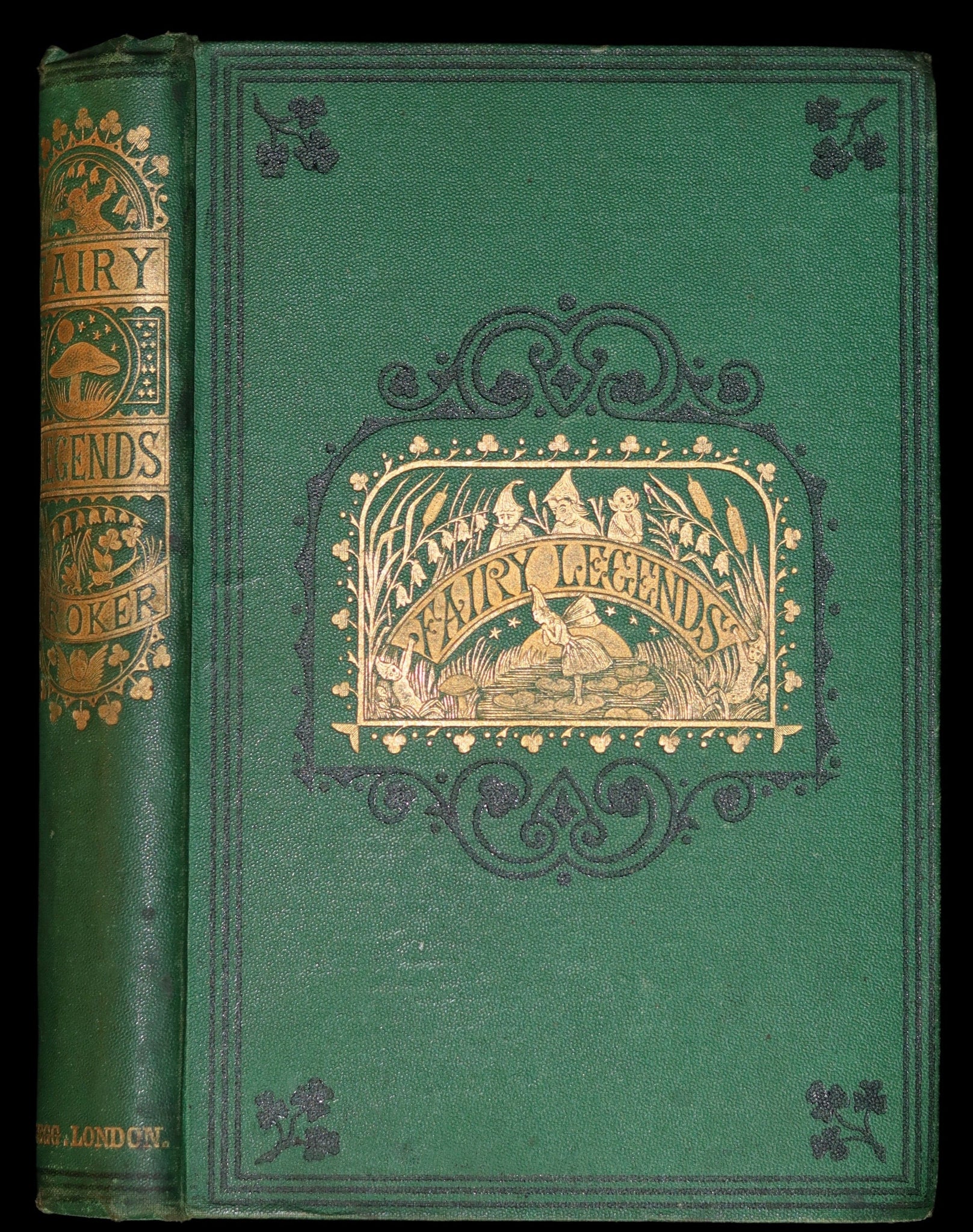
Epitaphs
Epitaphs can sum up the life of the individual buried beneath or can comment on the human condition generally. From the melancholy to the absurd to the catastrophically caustic, we survey in this episode a spectrum of final thoughts and grim punchlines culled from a favorite 19th-century volume.
A Remarkable Circumstance
A potpourri of peculiar tales culled from a favorite 19th-century volume. This episode features some outstanding British eccentrics, an extraordinary case of delusional morbidity, lethal religious fanaticism, graveyard shenanigans, and more. Plus, more black-humored poetry from Harry Graham in “Karswell’s Corner”
The Stone Eater and other Curious Cases
Enjoy with us a collection of short curious tales culled from a favorite Victorian volume — the Stone Eater of London, a mariner’s report of fire from the sky, the rise and fall of a French giant, 18th century blasphemies involving a donkey, and more. Plus, more sardonic verse from Harry Graham in “Karswell’s Corner”
P.T. Barnum’s Magnificent Museum Fire
The fire that destroyed P.T. Barnum’s American Museum on July 13, 1865 was a luxuriantly surreal and tragic event, one described beautifully in a contemporary New York Times piece, which we share in this episode verbatim. Doomed whales in enormous tanks, fleeing snakes, sideshow celebrities, and melting wax mannequins are all part of this fantastic tale.
The episode also includes details on Bone and Sickle’s new format for 2023 (more and shorter shows) a morbid bit of poetry from Mrs. Karswell as well as a snippet of a 1920s recording of German soprano Frieda Hempel recreating a performance by Jenny Lind, “The Swedish Nightingale,” promoted by Barnum on immensely successful international tours.

A Christmas Ghost Story
The Christmas Eve ghost story is a fine old tradition associated with Victorian and Edwardian England, one now making a comeback on both sides of the Atlantic. Since 2018, Bone and Sickle has enthusiastically embraced the custom.
Our offering for 2022, is “Smee” written by A.M. Burrage in 1931 and read for us by Mrs. Karswell.
Previous Christmas ghost stories are linked here in our website show notes (2018, 2019, 2020, and 2021).
Christmas Devils and the Feast of Fools
From St. Nicholas Day through Christmas, the Devil figured prominently in medieval plays, embodying a subversive seasonal element also celebrated in the Feast of Fools.
We enter the topic of medieval Christmas plays sideways through German composer Carl Orff’s 1935 composition “O Fortuna,” a piece much beloved in Hollywood soundtracks. The lyric Orff set to music happens to belongs to one of 24 11th-century poems preserved in a Benedictine monastery in the Bavarian town of Beuren, providing the collection with its name, Carmina Burana, a Latinized version of “Songs from Beuren.”
After a brief look at some of the rude and blasphemous poems, for which the collection is notorious, we switch to its poem on the Nativity, a much less scandalous composition which formed the basis of one of Europe’s first Christmas plays. We focus on the prominent role given Satan and his demons in that text as well as the comic portrayal of the Antichrist in Ludus de Antichrist, “Play of Antichrist,” preserved in a collection from a nearby monastery in Tegnersee.
From there we switch over to medieval portrayals of another sort of Antichrist, namely King Herod, whose role in the Christmas story is to order the execution of all infant males in his kingdom, hoping thereby to exterminate a potential rival, the “King of the Jews,” rumored to have been born in his kingdom. We discuss some fantastically grisly portrayals of this event from the medieval stage.
We next have a look at some of the stagecraft employed in portraying the Devil and his minions, discussing the fabrication of “Hellmouths,” a set element, which swallowed sinners and vomited up devils on the medieval stage. Alongside this, we examine costumes and pyrotechnics used to enhance the theatricality of demons and their realm.
From there, we turn to another subversive, sometimes violent, undercurrent in holiday celebrations, namely that of the Boy Bishop. Beginning around the 10th century, the title was given to a youth elected to lead mass either on the Feast Day of St. Nicholas or on December 28, the Feast of the Holy Innocents. On the surface, the tradition may sound innocently charming enough, but as we learn from quite a few contemporaneous accounts of mayhem and violence involved in the festivities, this inversion of the hierarchies could quickly lead into Lord of the Flies territory.
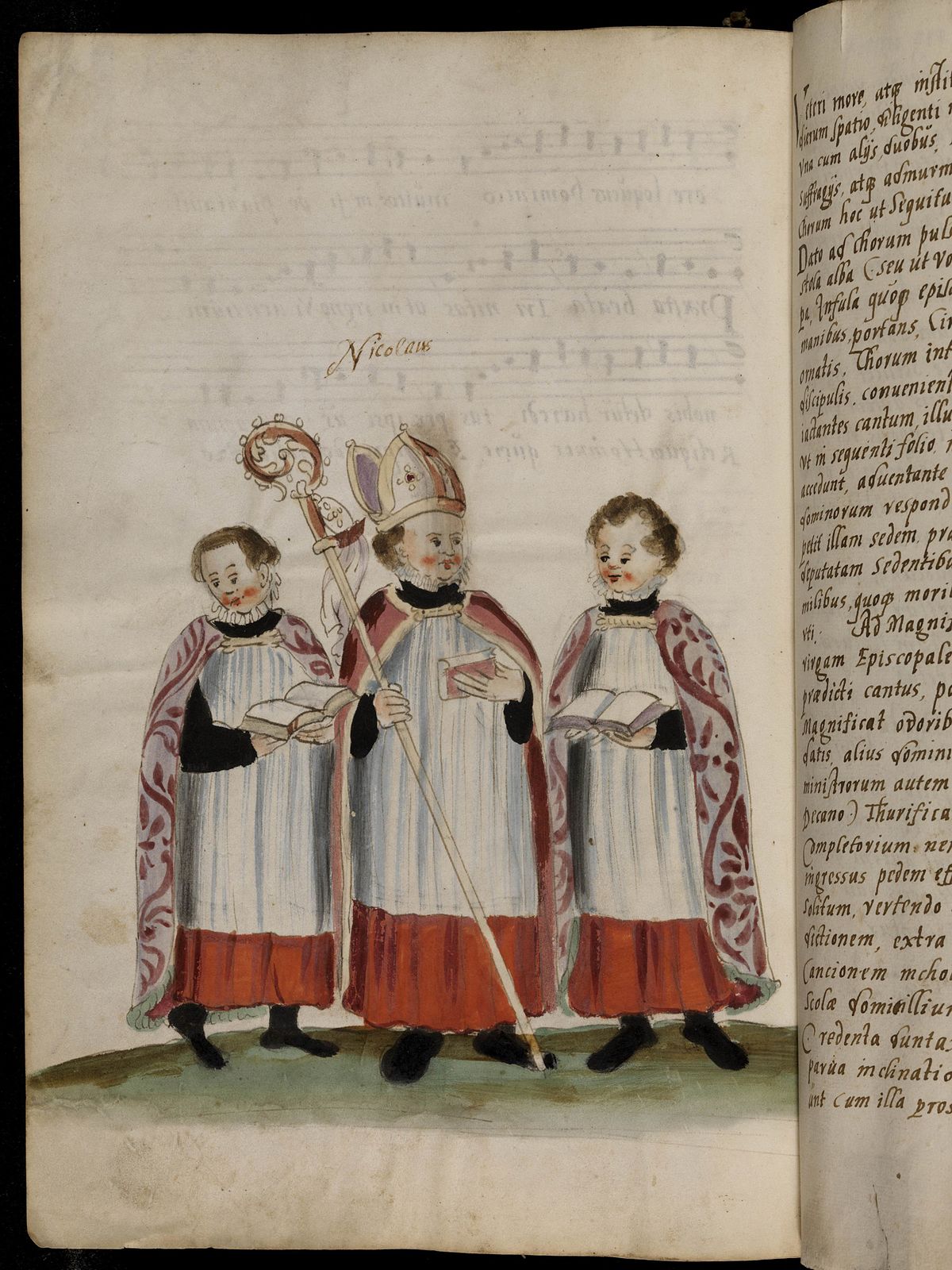
Related to the Boy Bishop tradition, is our next topic, the Feast of Fools. While many listeners will be familiar will be with the carnivalesque street parades, and election of a mock King, Bishop, or Pope of Fools, these chaotic elements were not limited to the secular world. Indeed, the festum fatuorum began within the church itself, consisting of a number of days in which lower clergy assumed roles usually belonging to those above them in the hiearchy (priests for bishops, etc.).
The “Feast” actually constituted of a number of different days during the Christmas season during which such inversions took place, a period sometimes extending all the way to January 14, on which the “Feast of the Ass” took place, a celebration honoring the animal which bore the Blessed Virgin to Bethlehem, and one involving the congregation in a litany of “hee-hawing.” Mrs. Karswell reads for us a number of historical accounts detailing the mayhem involved in these celebrations.
We close with a nod to the most the most famous literary reference to the Feast of Fools, one which novelist Victor Hugo imagined in his 1831 novel The Hunchback of Notre Dame, and in which the titular character is crowned “King of Fools,” (or “pope” in the original French.)
NOTE: This episode is adapted from the chapter “The Church Breeds a Monster” from Mr. Ridenour’s book, The Krampus and the Old, Dark Christmas.
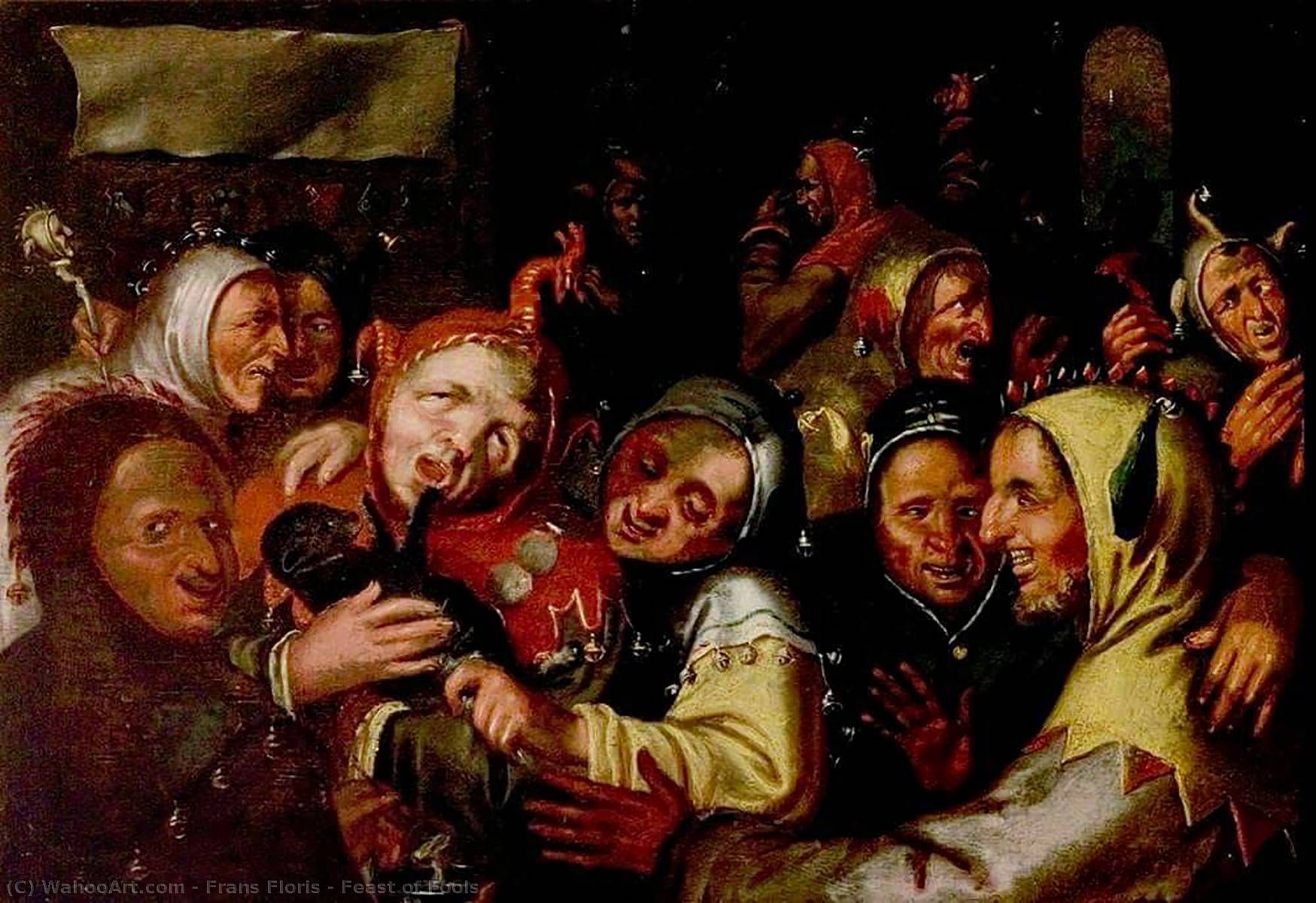
An After-Dinner Reading: Decadent Dining in the Satyricon
This short off-format episode is intended as a sort of fireside reading to be enjoyed by our overfull American listeners as they struggle to digest their Thanksgiving dinners. It’s from the late 1st-century novel, Satyricon by Petronius and describes what is quite likely Western literature’s most decadent description of a feast.
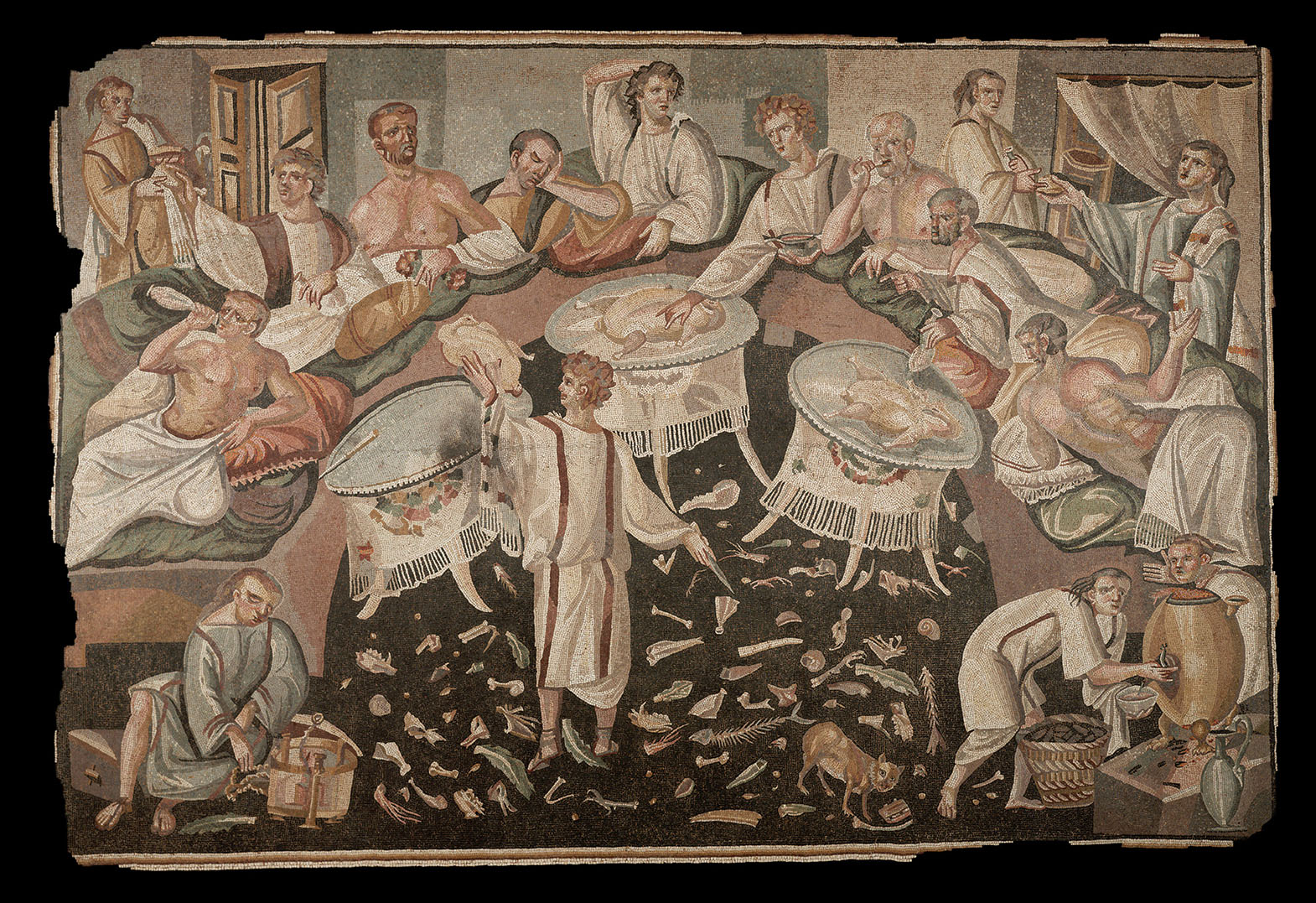
Villainous Victorian Women
Our survey of villainous Victorian women examines six individuals associated with some of the most ghastly crimes of the era, many directed against children (and for this reason possibly a bit of a rough listen for some.)
Five of these criminals inspired murder ballads, or more specifically “execution ballads,” single-sheet broadsheets sold at the time of the trials or executions.
The sixth woman, Mary Ann Cotton, a poisoner from the north of England, also inspired verses, in this case, however, a schoolyard rope-skipping chant of the type memorializing Lizzie Borden. (We begin the show with a version the Borden rhyme from 1956 episode of Alfred Hitchcock Presents remixed by Bob’s Vids.)
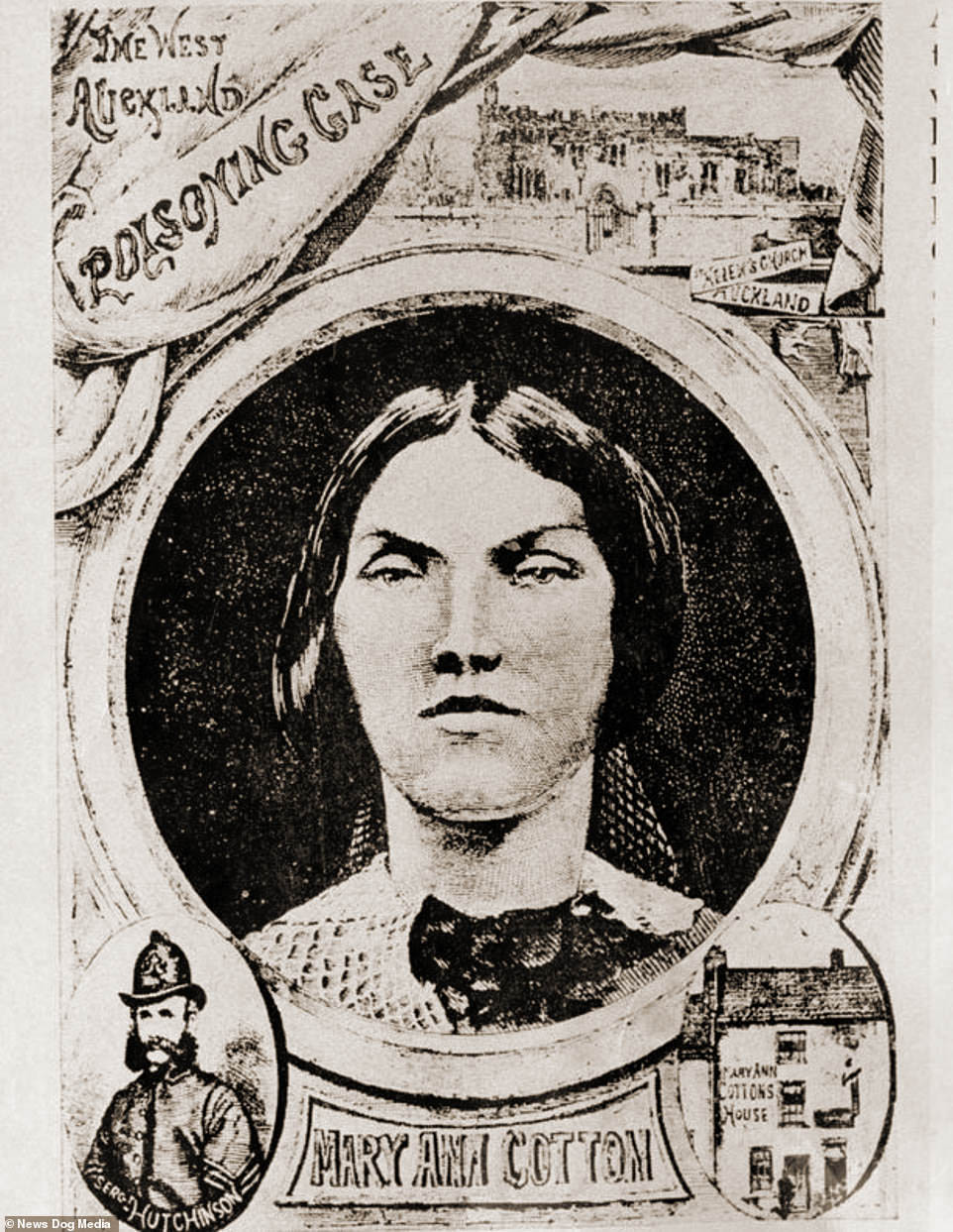
Cotton, Britain’s first female serial killer, was executed in 1873 for the murder of her stepson, the last of 13 offspring whose lives she’d taken, that along with three of her four husbands, who were generously insured to ensure the poisoner would profit from her evil.
Like Cotton, our next murderer also preferred arsenic as her lethal weapon. The American, Lydia Sherman, throughout the 1860s and early ’70s poisoned eight children as well as three husbands in New York and Connecticut. Dubbed “the modern Lucretia Borgia” by the press, Sherman was also the subject of an 1873 book, The Poison Fiend: The Most Startling and Sensational Series of Crimes Ever Committed in this Country. Unlike Cotton, however, Sherman escaped the gallows, sentenced instead to end her life in prison. We begin her segment with a snippet of the broadside “Ballad of Lydia Sherman” by the Mockingbirds.
We next look at Emma Pitt, a schoolteacher in the British village of Hampreston in Dorset, who murdered a child in 1869. While only taking the life of a single victim, her crime was regarded as particularly heinous as that victim was her own newborn baby, not only killed but mutilated by its mother.
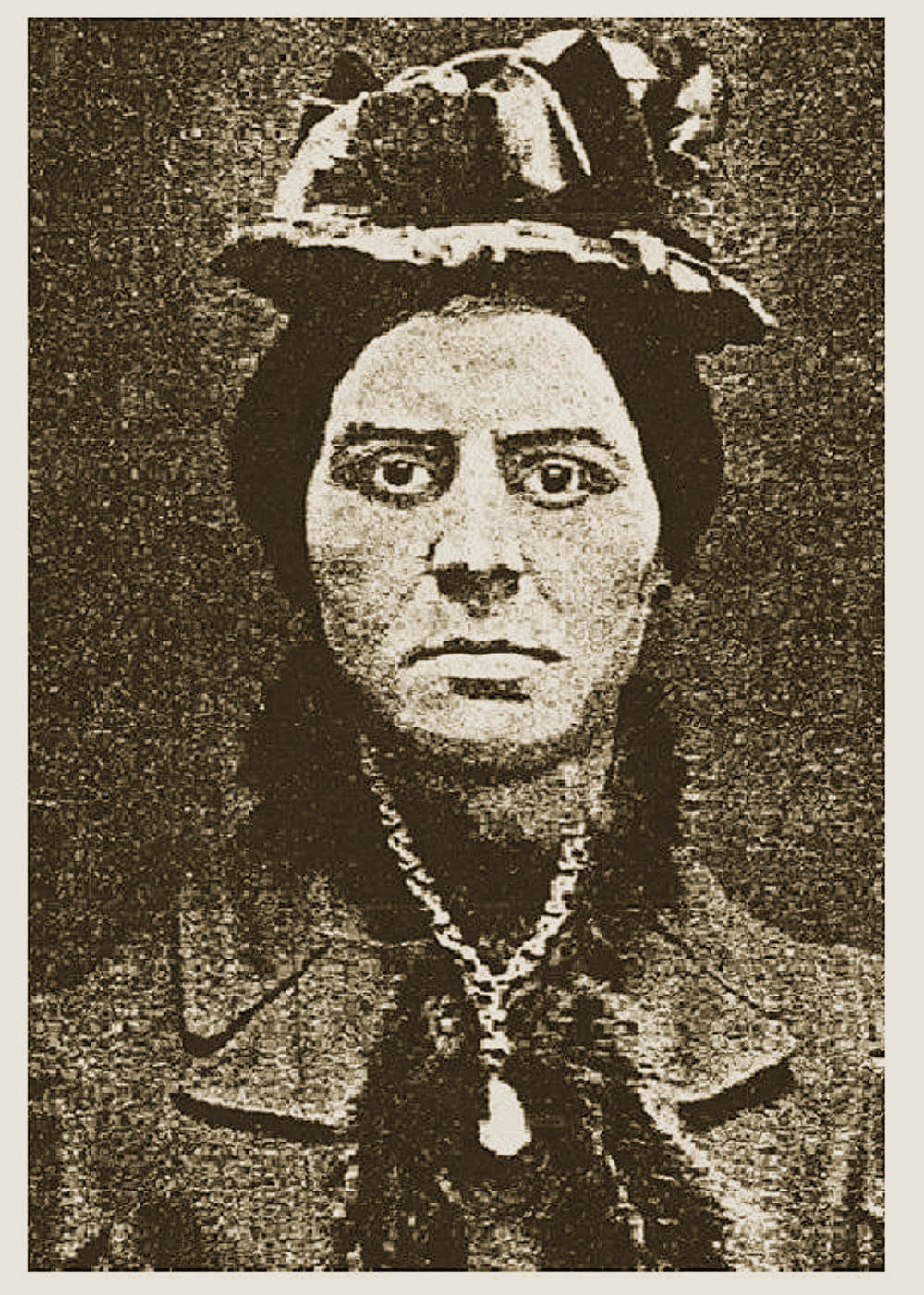
Our next murderess, the Irish servant Kate Webster was found guilty of killing her mistress Julia Thomas in 1879. While she also committed but a single homicide, she’s remembered for the particularly grisly details shared in her trial regarding her disposition of Thomas’ body. Webster’s trial was such a sensation that Gustav, Crown Prince of Sweden, traveled to Britain for the trial, and Madame Tussaud displayed her figure in the Chamber of Horrors for nearly six decades.
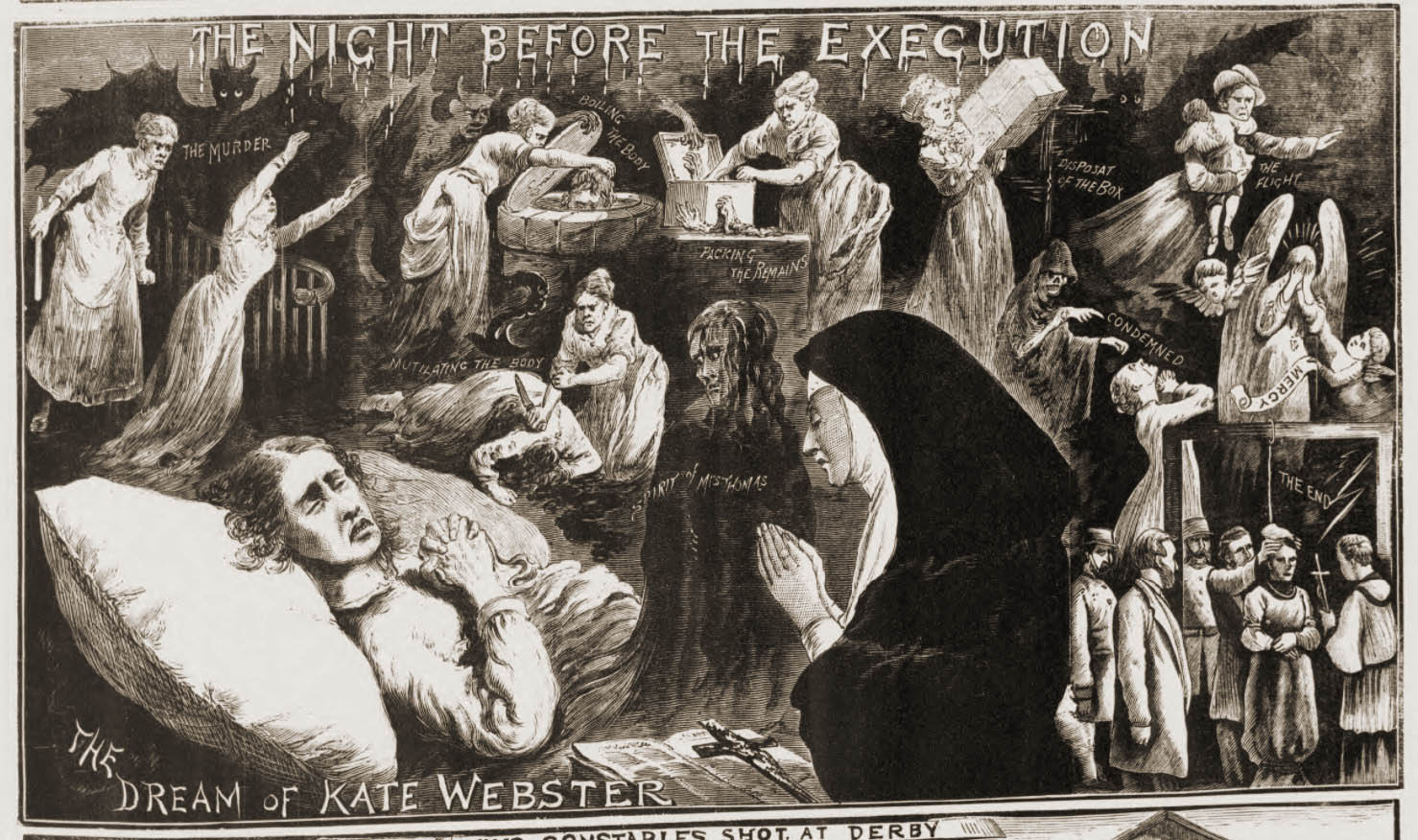
The unspeakable deeds of our next criminal are recorded in the 1843 ballad, “Mary Arnold, the Female Monster.” The less said here about this abomination the better as it may be the most horrific account related in the history of our show.
Our final segment opens with a snippet from another ballad, “Mrs. Dyer the Baby Farmer,” as sung by Eliza Carthy. In 1896 Amelia Dyer was executed in London for the murder of a single child, though many more deaths were suspected during her 17 years working as a “baby farmer.”
Dyer is the most notorious example of this shady practice by which mothers arranged adoption of illegitimate or unwanted children with mercenary caregivers. The sum paid, being was a relatively low fee affordable to lower class women, was therefore not realistically expected to sustain the child for long. For this reason, infants thus abandoned, tended to be poorly fed, or outright starved, quieted with gin, or even killed, the last being the case made against Amelia Dyer.
We close with a snippet of the ballad heard earlier, in this case sung by Derek Lamb.
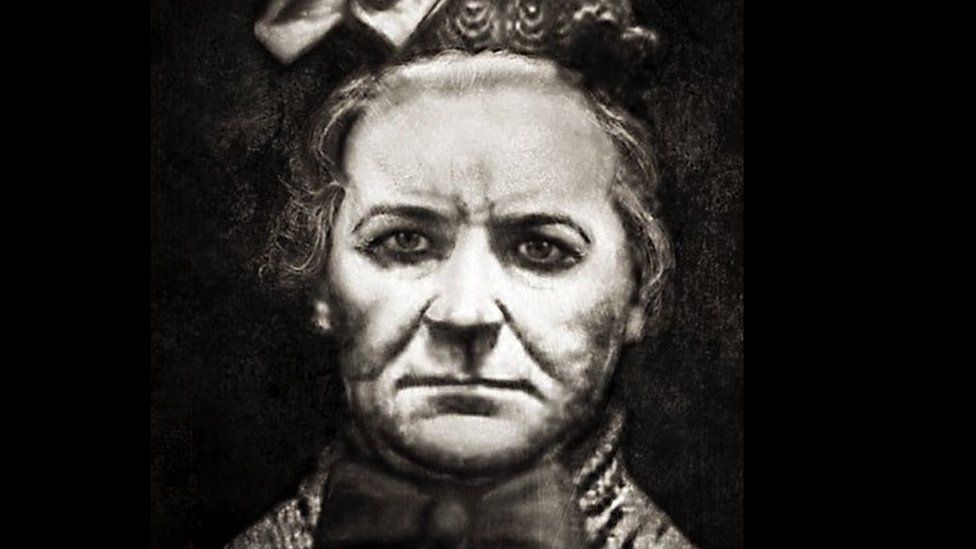
Who Put the Hell in Helloween?
During the Satanic Panic, the notion of Halloween as a Satanic High Holy Day came to prominence, but the elements necessary to this mythology were set in place much earlier.
This episode focuses particularly on the early years of Wicca, some missteps in disassociating the movement from Satanism, and early evangelical personalities spinning “ex-Satanist” yarns from this material, which is to say, we focus particularly on the 1960s Occult Revival up to and including 1973. To set the mood for the era’s pop occultism, we hear some audio snippets by records released by witches, Louise Huebner, Gundella the Green Witch, Barbara the Gray Witch, and Babetta, the Sexy Witch.
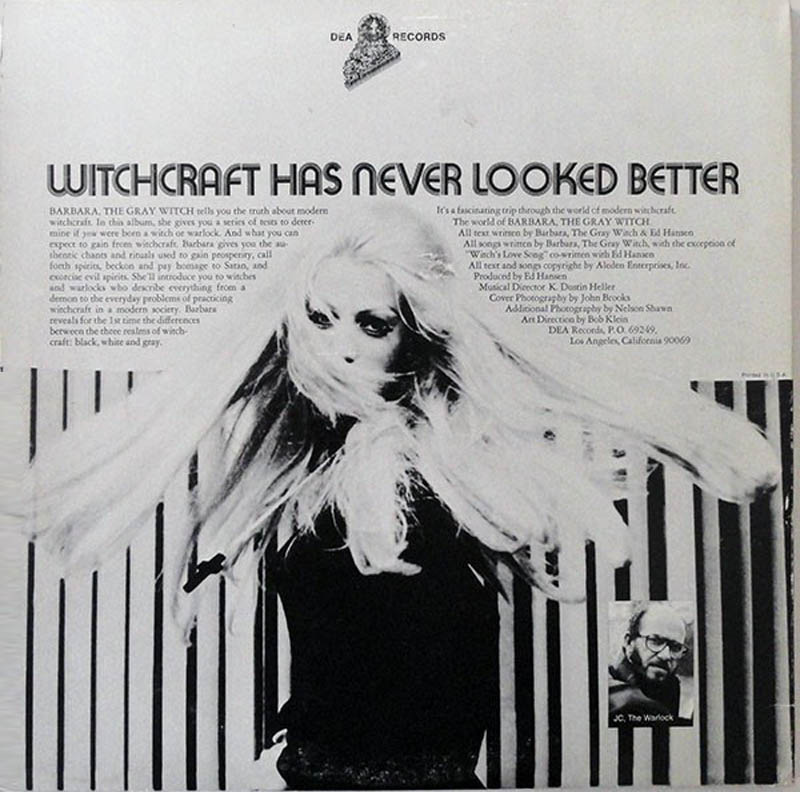
We first have a quick look at Anton Lavey’s creation of The Church of Satan in 1966. While this sketched out cartoonish tropes of the Panic narrative, Lavey’s carnival-barker style and insistence that there was no actual Satan in his school of Satanism, undermined the influence he might have among all but the most credulous and paranoid.
The real roots of the Panic lay not in Lavey’s publicity stunt, which in the wider historical context was a mere flash in the pan, but in a much older idea conceiving witchcraft and Devil worship or traffic with demons, a notion that held sway for more than seven centuries and therefore not to be quickly rooted out by modern Wiccans.
Some of the sticking points here are rooted in 19th and early 20th century writings on witchcraft by the American folklorist Charles Leland and British Egyptologist Margaret Murray, and their “witch-cult” concept regarding witchcraft as an underground survival of ancient pagan religion. Problematic here too were their identification of the deities of this religion as “Lucifer” (Leland) and “The Horned God” (Murray).
We then turn to Gerald Gardner, the British civil servant, who in his retirement got the whole Wiccan ball rolling, declaring in the early 1950s, that he had been initiated into the ancient mysteries of this witch-cult by members of a surviving Coven in the New Forest region. In particular, we examine the way in which Gardner’s emphasis on UK traditions within Wicca, strengthened an association between Halloween and witches (despite virtually no mention of witch gatherings actually occurring on Halloween in earlier historical writings).
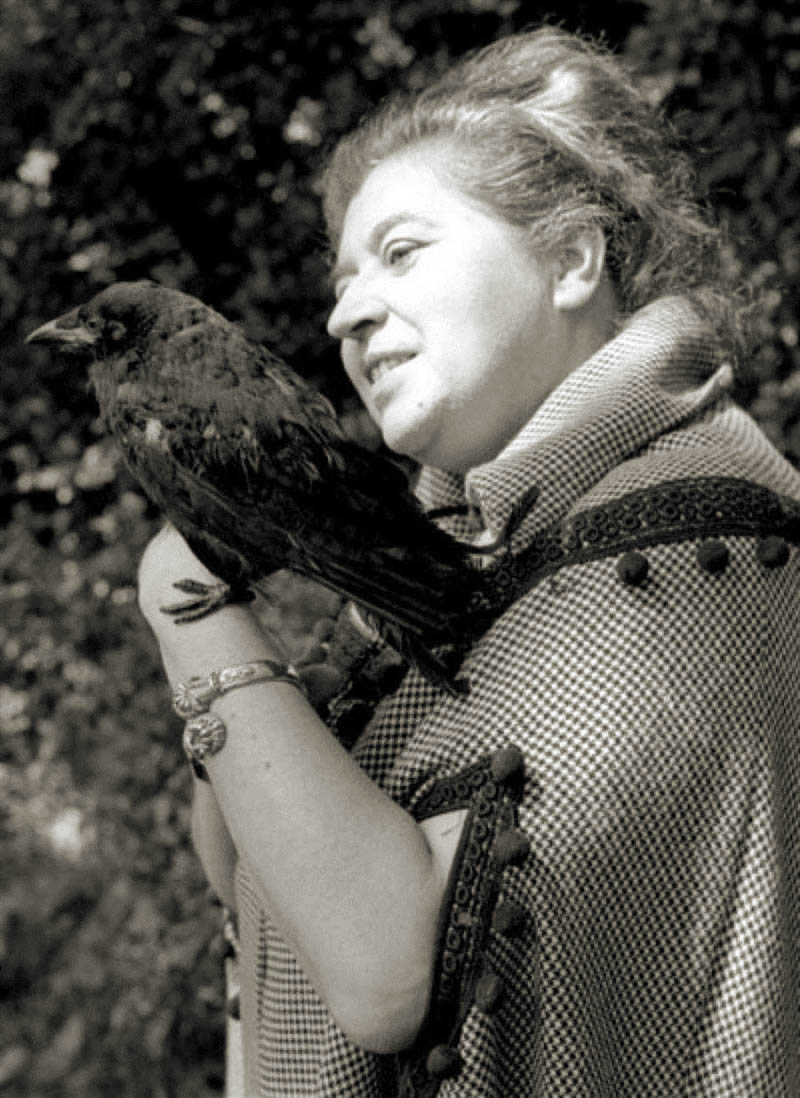
We then have a brief look at Sybil Leek, first acolyte of Gardnerian Wicca in the US, and darling of 1960s journalists. (Leek was profiled in our 2019 Halloween episode, “All of Them Witches.”) As the United States was the birthplace of the modern Halloween, Leek’s insatiable engagement with the press around that time, did much to strengthen the idea of Halloween as a singularly important time for witch gatherings and ritual. She also provides Halloween recipes!
By the 1960s, Wicca had branched into two paths, Gardnerian and Alexandrian, the latter named for the British witch Alex Sanders, who with his wife Maxine, headed a coven in London. Sanders has much to do with continued confusion between Wicca and Devil-worship thanks to his indiscriminate pursuit of media interest inclined to titillate audiences with the old diabolic model. We discuss his involvement with the British band Black Widow and their Satanic sacrifice stage-show, publicity involvement in the film Eye of the Devil (1966) , and his feature role in the documentary Legend of the Witches (1970) and mondo “documentary” Secret Rites (1971).
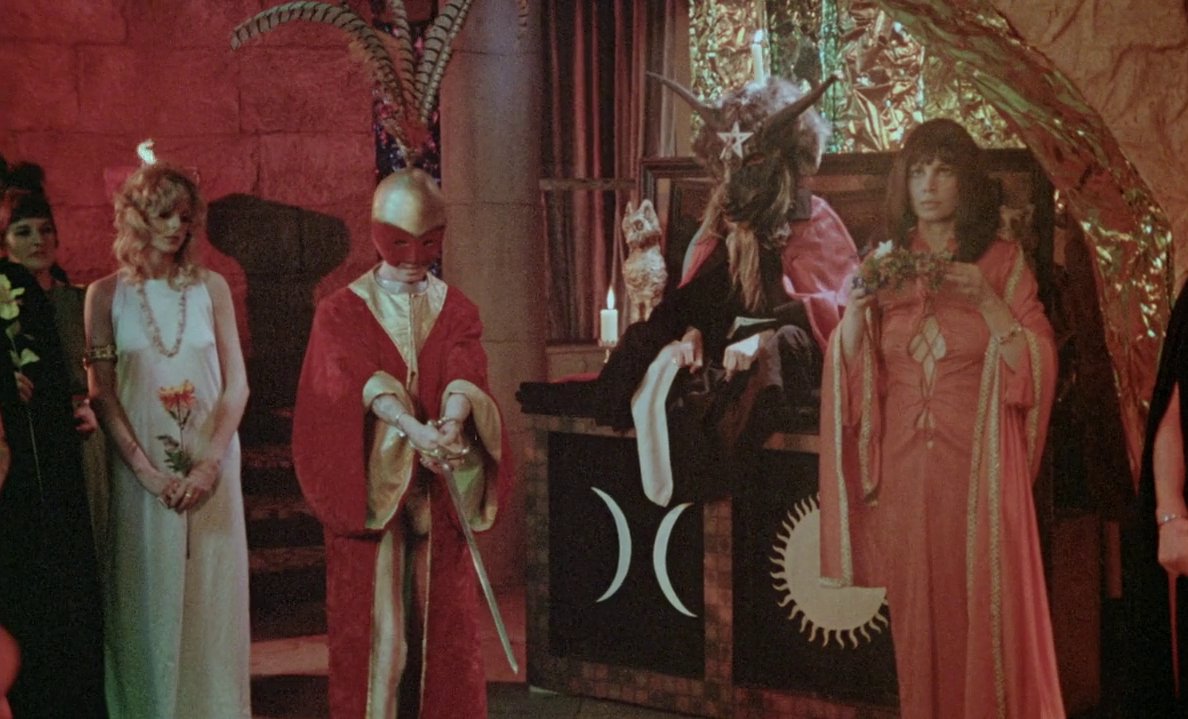
Just as Wicca originated in the UK, only later to be embraced in the US. fraudulent ex-Satanist testimonies were first told in Britain. In 1970 Bristol-born Doreen Irvine began relating stories of her involvement in the occult, tales that took their final form in her 1973 publication From Witchcraft to Christ. We hear a bit of her tale of teenage street-life, drugs, and prostitution leading to Satanism, her claims to curious supernatural abilities, and her crowning as the “Queen of the Black Witches” on the Dartmoor moor. As well as her warnings about celebrating Halloween.
While the ex-Satanist narrative, never really caught on in the UK, it hit the big time with American Mike Warnke’s 1972 book purporting to document his experiences in Satanism, The Satan Seller.

While Warnke’s fraudulent stories garnered him celebrity in the early days of the modern evangelical movement, by the late 1970s, he had reinvented himself as a popular Christian comedian. He did, however, revisit the theme once the Satanic Panic got rolling, with the 1979 release of the album “A Christian Perspective on Halloween.”
We hear his Satan Seller narrative of a good Midwestern boy corrupted by drugs in a California college, eventual elevation to High Priest within global Satanic underworld, eventual self-destruction through drugs leading to a stint with the Navy, during which he’s saved. Along the way, are some bizarre details about his fingernails, strange ordinations in real-world sects, and eventual exposure and fall within the evangelical community.
Another evangelical making the rounds with ex-Satanist stories in in Warnke’s day was John Todd, who began spinning his yars tales around 1968 in Phoenix. We only briefly discuss Todd as he really hits his stride outside our timeframe, namely, in the late ‘70s when his story of involvement in a Satanic underworld reached its greatest audience via Jack Chick comics.
We wrap up the show with a look at some early collaborators with Warnke in the the occult fear-mongering business — David Balsiger, Morris Cerrullo, and Hershel Smith (AKA “the Skin Eater) as well as their collaboration on the legendary “Witchmobile,” an “anti-occult mobile unit” that roamed the US and Canada from 1972 to 1974.
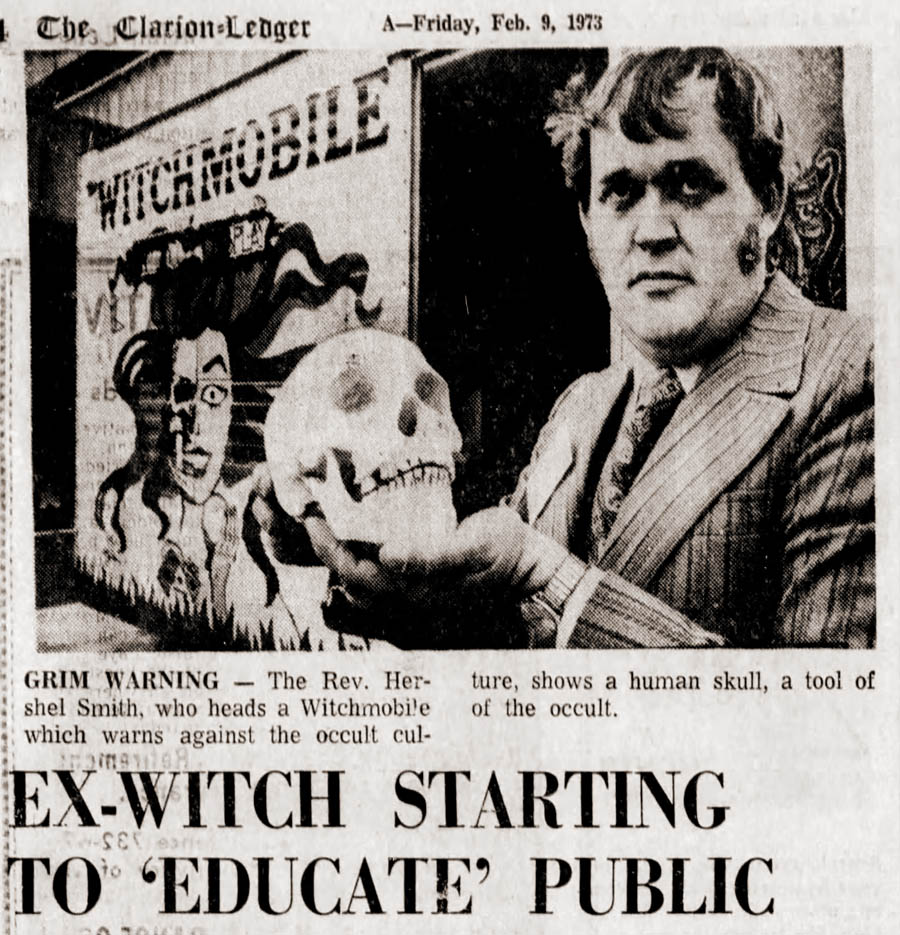
A Vine on a House
A short and somewhat extra episode for the Halloween season, a presentation of the 1910 horror story by Ambrose Bierce, “A Vine on a House.” Also, some show updates.
We’ll have a full episode, “Who Put the Hell in Helloween?” closer to the end of the month.
Spirits of the Corn
Spirits of the corn (grain) fields from the United Kingdom to Russia have been imagined as embodiments of the harvest and guardians of the fields, sometimes evolving into fantastically cruel fear-figures in the process.
We begin with a look at the Scottish and English ballad “John Barleycorn,” first appearing as a broadside in 1568. The suffering hero of the song, “Sir John,” allegorically endures the brutal process of being buried, harvested, threshed, and eventually turned into beer. We hear some snippets of the song from The Watersons and Fred Jordan.
Some, like the turn-of-the-century mythologist James Frazer, imagined the ballad as an allegorical representation of ancient human sacrifice ensuring good harvest, and while that’s not generally believed now, by way of evidence, Frazer assembled an invaluable and encyclopedic catalog of now extinct agricultural folk customs in his 1890 magnum opus, The Golden Bough.
We examine a number of rituals, documented by Frazer, in which the spirit of the fields is said to take up residence in last grain to be harvested, often as an animal. One such creature, around which a substantial mythology has been spun, is a goat-like being called the Habergeiss. I’ve mentioned this bit of Alpine folklore previously in the context of Krampus and Perchten traditions, but here provide a more in-depth look at the many ways in which it’s been imagined.
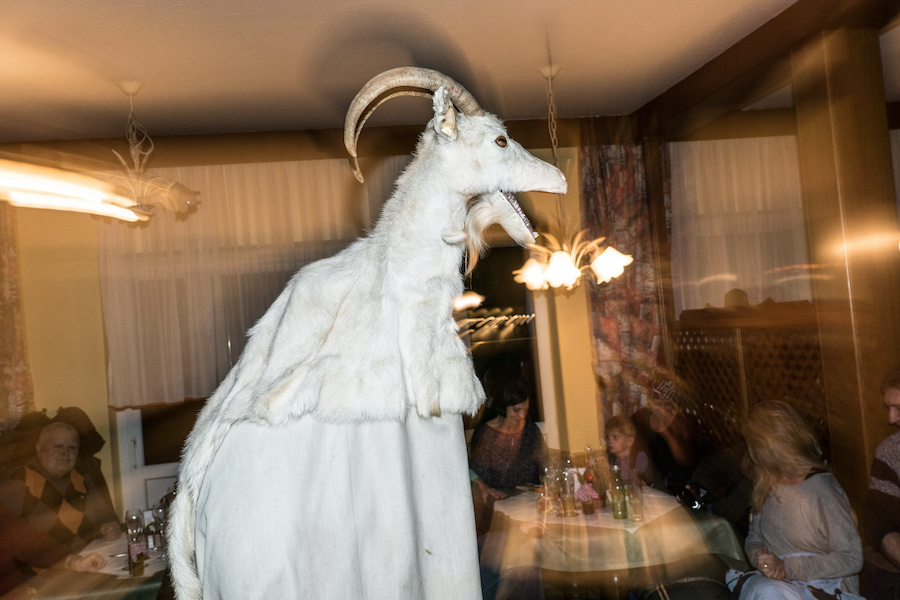
Also from German-speaking lands, the Bilwis, a sort of goblin or witch said to protect fields but more often described as a nocturnal thief of grain, employs small sickles attached at its feet. We also hear some methods of defeating this sort of mischief as described by Jacob Grimm.
Another German bit of folklore discussed is the Rye Wolf, often closely associated with a female embodiment of the grain. While more broadly referred to as the “Corn Mother,” she assumes her most fearful aspect in German rye fields, where she becomes the Rye Aunt (Roggenmuhme).
An extremely comprehensive and grisly catalog of her terrifying traits was compiled in Richard Beitl’s 1933 study, Investigations into the Mythology of the Child. We take a loving and lingering look at some of these horrific aspects and hear the Rye Aunt described in a tale from the Grimms as well as a story from 1926, told as true (even then) by the grandmother of Otto Busch, author of Thuringian Legends.
We also examine a lighter side of this figure, literally lighter, as she only appears at the hour of noon. Particularly common more in northeastern Germany and Slavic lands (Polednice in Czech, Poludnitsa in Russian) in English literature, she is usually called “Lady Midday,” or “The Noonday Witch.” Not only does she function as a fear-figure preventing kids from running into the fields but also serves to warn workers to cease their labors at the hour the sun is hottest lest she strike them down with exhaustion, pains, or madness.

A couple Czech films featuring this character are discussed — 2016’s The Noonday Witch/ Polednice and 2000’2 Wild Flowers/Kytice. The latter is based on an 1853 anthology of folkloric tales (Kytice) folkloric by Czech poet Karel Erben. Mrs. Karswell reads for us a recent translation of “The Noonday Witch.”
The show closes with some cinematic scarecrows, primarily a smuggler disguised as a scarecrow created by Russell Thorndike for his 1915 novel, Doctor Syn: A Tale of the Romney Marsh. We hear some clips from adaptations of Thorndike’s work, the 1962 Hammer film (with Peter Cushing) The Night Creatures, and Disney’s 1964 production The Scarecrow of Romney Marsh starring Patrick McGoohan.
,
Master of the Wolves: Transylvanian and Balkan Wolf Lore
The Master of the Wolves is a supernatural figure central to Transylvania’s (modern Romania’s) voluminous body of wolf lore, a mythology that extends more broadly into Balkan regions once occupied, like Romania, by the ancient Dacians.
We begin with a snippet from a contemporary recording of the 1857 poem “St. Andrew’s Night,” by the Romanian poet and statesman Vasile Alecsandri. The poem’s association between the undead strigoi and moroi and the Romanian St. Andrew’s Night (November 30) was explored in our Transylvanian Vampires episode last year, but there is perhaps an even deeper connection between the St. Andrew, Romania, and the wolf.
Naturally, this brings us to the topic of werewolves. There are two wolflike monsters in Romanian folklore, the vârcolac and the pricolici, the latter being a closer match to our idea of the werewolf.
We discuss pricolici superstitions, which overlap largely with beliefs about the undead, of which the pricolici is often said to be a member.
The vârcolac, as we see, is rather different. Originally, it seems to have occupied a very limited and specific mythological niche as a creature that rises into the heavens at night to eat the moon, thereby causing an eclipse, or sometimes, the lunar phases. Over time, the vârcolac seems to have merged with more widespread werewolf beliefs.
The animal form associated with both pricolici and the vârcolac, however, is not always strictly defined as wolf-like. While the pricolici is sometimes said to assume the form of any number of “unholy” (but real-world) animals, the vârcolac has sometimes been compared to a dragon.
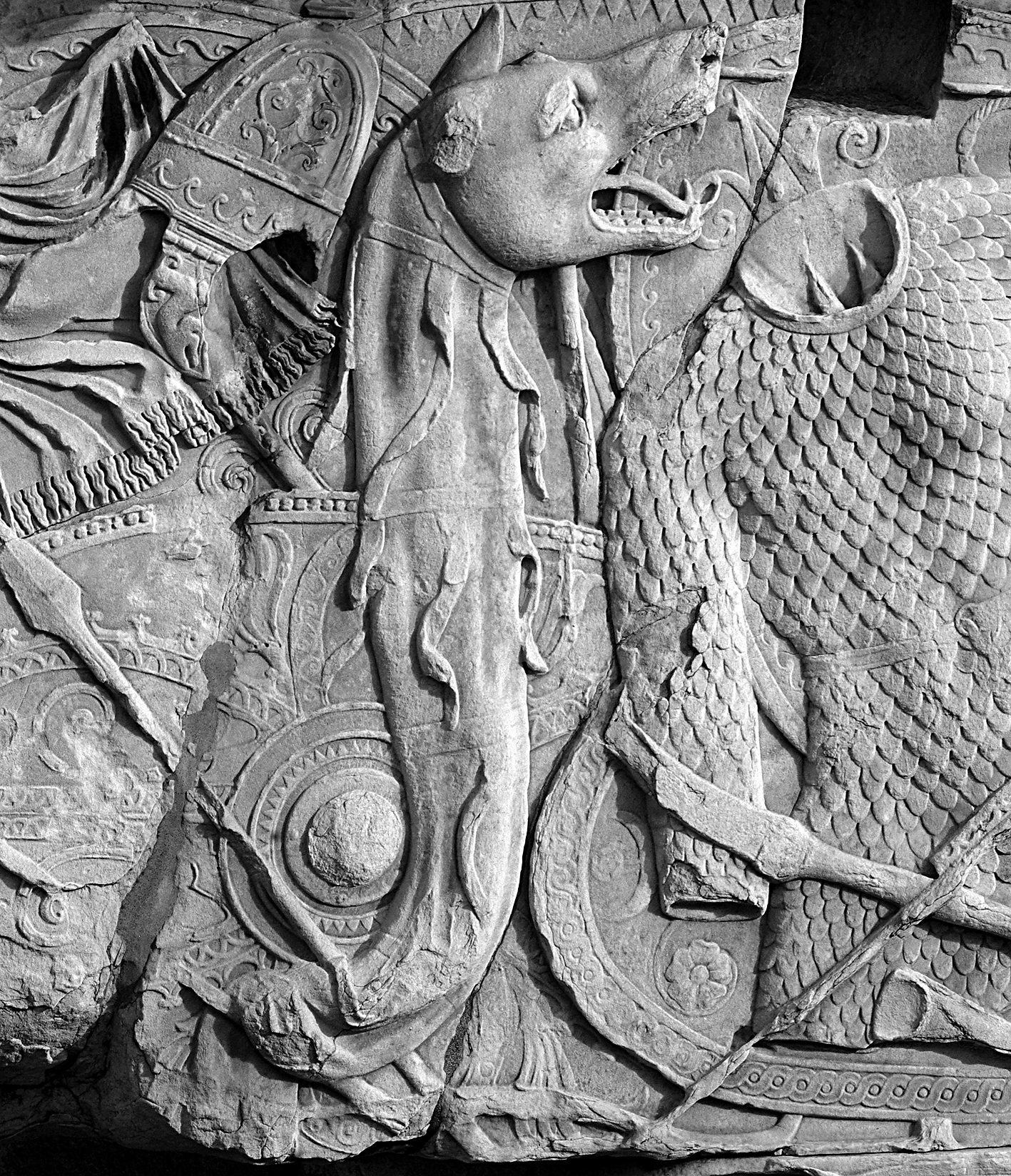
This wolf-dragon hybridization can also be found in the draco battle standard carried into by the Romanian Dacians in their wars against Rome. In its original form, the draco, consisted of a wolf head crafted of light metal, trailing a dragon-like windsock body. When in motion, a sort of whistle within the head emitted a shrieking sound that contributed to the Dacian’s fearsome reputation as warriors.
The historian Herodotus commenting on this reputation, also offered some observations on a particularly brutal Dacian rite, that of sending a “messenger” to their god Zamoxis. Mrs. Karswell provides the gory details in her reading of this account.
More modern Romanian myth-making brings together the man-god Zamolxis and the Dacian wolf, in the legend of The Great White Wolf, also read by Mrs. Karswell. This tale of a wolf leader seems to borrow from genuinely old legends describing St. Andrew as the “Master of the Wolves.”
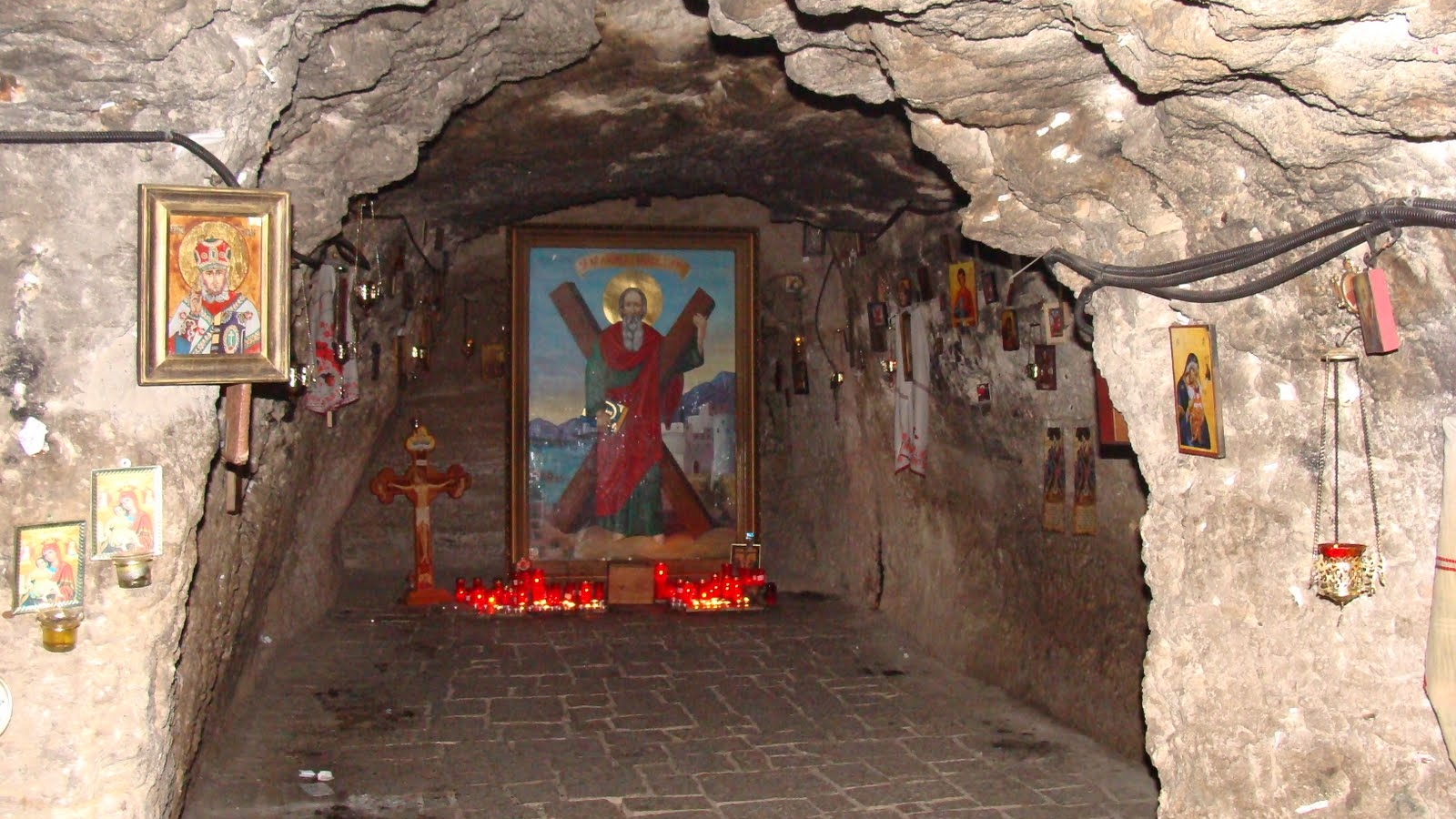
In this role, Andrew is said to return to earth on his night to share with the wolves what prey they are to be allotted in the coming year. The gathering of wolves from all quarters and apparition of the saint on the occasion is a sight mortals witness only with dire consequences, as we hear in another legend related by Mrs. Karswell. Nor is it a good time to be abroad with wolves racing off after their pray, especially so as they’re sometimes said to be supernaturally enabled on this night.
The Master of the Wolves myth did not exclusively attach St. Andrew and his day (or night). St. Martin’s on November 11, can be the setting as in Greece and Germany. (Germany is is also home to a folk tradition discussed, Wolfauslassen (“Letting out the Wolves” or “Ringing in the Wolves” in which shepherds returning from the fields for the year parade through towns ringing bells to let the wolves know they are free to roam the pastures.
As well as on St. Martin’s day, the Wolf Master can also appear a bit later, on December 6 when St. Nicholas serves as the Master of the Wolves in Russia and Poland.
While generally associated with the late fall and winter when dwindling food sources makes wolves more aggressive, the Master of the Wolves could also appear in the spring, when the herds would return to pasture, and predators might require a different sort of magical wrangling. The saint controlling wolves in these cases is almost always St. George.
While versions of this figure are found throughout eastern Europe and Russia (and certain parts of western Europe), it is in Romania where the wolf is most prominent — celebrated with no less than 35 designated “wolf holidays,”of which St. Andrew’s is only the most well-known. This season runs from October into January and its observance is marked by an arcane body of superstitious practices designed to keep the animals at bay. These include reciting prayers, locking corrals with charmed locks, and binding scissors to keep shut the predator’s jaws, and the like. A folk figure called “St. Peter of Winter” appears at the end of his season with dire consequences for those who have neglected the requirements of the season.
Strangely, the most dreaded wolf of all during this season, is a lame wolf, who not only attacks livestock but man. Several of Romania’s wolf holidays pay homage to this figure in their name, such as “Lame Philip,” ostensibly named for the apostle Philip, but undoubtedly rooted in older pagan tradition. In Serbia, which shares Romania’s Dacian heritage, a similar figure appears during this season as Lame Daba, a demon portrayed in the company of wolves.
A possible clue to this association between lameness and a dreadful power over human life may lie in Romania’s version of the Three Fates, the ursitoare. The third member of this trinity, the one given the ultimate power to cut the thread of human life, is traditionally portrayed as lame.
We end the show with a look at a wonderfully bizarre 1976 Romanian-French-Russian co-production, Rock and Roll Wolf AKA Mama, a retelling of a Romanian tale also collected in Germany by the Grimms as “The Wolf and the Seven Young Goats.” Here’s a short preview clip of the film, which you can find in its entirety with English dubbing here on YouTube.
Episode 93: Marvelous and Rare
As a “summer intermezzo” Bone and Sickle is offering three episodes this August in our “Marvelous and Rare: Antiquarian Circle” format. These are shorter episodes normally enjoyed once a month by our $4+ supporters on Patreon (www.patreon.com/boneandsickle).
There’s a reference in this particular episode to “world events” and the contemplation of heavenly phenomena as a balm to the current uncertainties. It was originally broadcast immediately after the outbreak of the Russian-Ukraine war.
We look forward to returning in September with our regular shows.
Episode 92: Marvelous and Rare
As a “summer intermezzo” Bone and Sickle is offering three episodes this August in our “Marvelous and Rare: Antiquarian Circle” format. These are shorter episodes normally enjoyed once a month by our $4+ supporters on Patreon (www.patreon.com/boneandsickle). We look forward to returning in September with our regular shows.
Episode 91: Marvelous and Rare
As a “summer intermezzo” Bone and Sickle is offering three episodes this August in our “Marvelous and Rare: Antiquarian Circle” format. These are shorter episodes normally enjoyed once a month by our $4+ supporters on Patreon (www.patreon.com/boneandsickle). We look forward to returning in September with our regular shows.
Dark Fairy Tales II: Heads in a Fountain, Bones in a Bag
Dark fairy tale elements including floating heads and bags of bones are featured in a family of tales classified under the Aarne-Thompson system as Type 480, “Kind and Unkind Girls.” Imaginative punishments and rewards for the kind and unkind characters in question are a further interesting element. The girls in these tales are always sisters or stepsisters, and a wicked stepmother (sometimes mother) is part of the formula.
Our first example is the English tale, “The Three Heads of the Well.” The fairy tale bears a strange connection to an earlier 11th-century British legend featuring as its heroine the Byzantine Empress Helena, here portrayed as the daughter of the mythical “Old King Cole” of nursery rhyme fame. Both legend and fairy tale are set to the town of Colchester in Essex, understood to be named for King Cole.
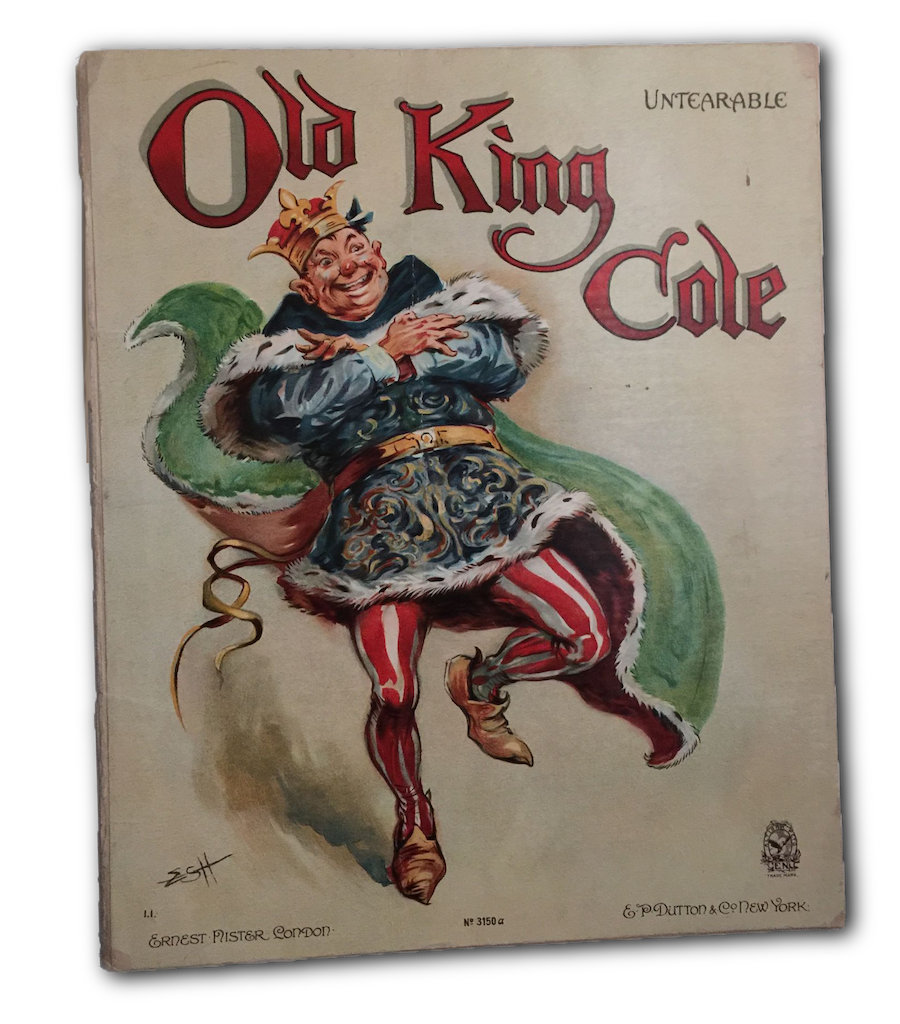
From “The Three Heads of the Well,” we learn that being polite to heads floating out of magic wells serves one well, while rude behavior is strictly punished. A curious element of the narrative is the request made by the floating heads that their hair be combed.
Our next tale, “Three Fairies,” comes from Giambattista Basile’s Il Pentamerone, or Lo cunto de li cunti (“The Tale of Tales), a source used in our previous episode for the story “Penta the Handless.” The tale involves an encounter with fairies living in a fantastic palace hidden deep within a chasm.
Basile’s tales are particularly noteworthy for their extravagant and playful verbiage, illustrated in several lengthy passages read for us by Mrs. Karswell.
In this tale, we learn the value of diplomacy in discussing the hair and scalp conditions of fairies. A second lesson: one must be particularly wary when allowing oneself to be sealed in a barrel.
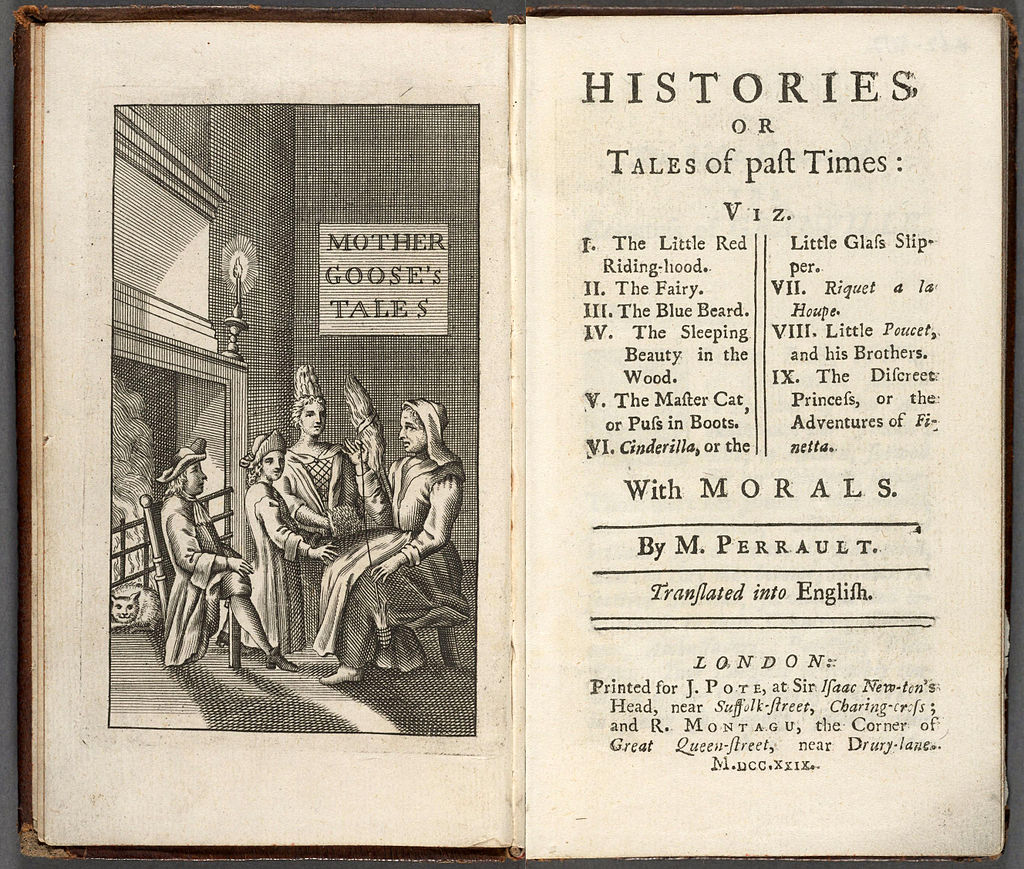
Our next story, “The Fairies,” comes from perhaps the most famous collection of fairy tales pre-Grimm, Charles Perrault’s 1697 volume Tales of Passed Times, sometimes subtitled Tales of Mother Goose. This French story can be found in certain English-language collections under the title “Diamonds and Toads,” referring to what falls from the mouths of its kind and unkind girls respectively — a blessing or curse depending on the girls’ charity toward fairies disguised as mortals.
The Grimms’ story, “Frau Holle” is introduced with a snippet of the “Frau Holle Lied,” a children’s song describing the grandmotherly (and witch-like) Frau Holle shaking feathers from her featherbed to make the snow in winter, an element from the Grimm story.
As in the Perrault’s “The Fairies” the Kind Sister in “Frau Holle” is sent to fetch water, and ends up not in an enchanted chasm, but falling into an enchanted well, passage to a sort of parallel dimension in which ovens demand their bread be baked, apple trees their fruit be picked, and Frau Holle has all sorts of housework for the heroine to perform. The girl’s unkind sister, however fails miserably when confronted with identical tasks, and we see both the rewarding and punishing side of Holle, an aspect of the story that relates it loosely to the winter mythology of the Frau Holle/Frau Perchta figure I discuss in other shows and my book as inspiration for the Krampus.
The rewards and punishments doled out in “Frau Holle” are likely borrowed from Basile’s “The Three Fairies,” as you might be able to guess from these depictions:
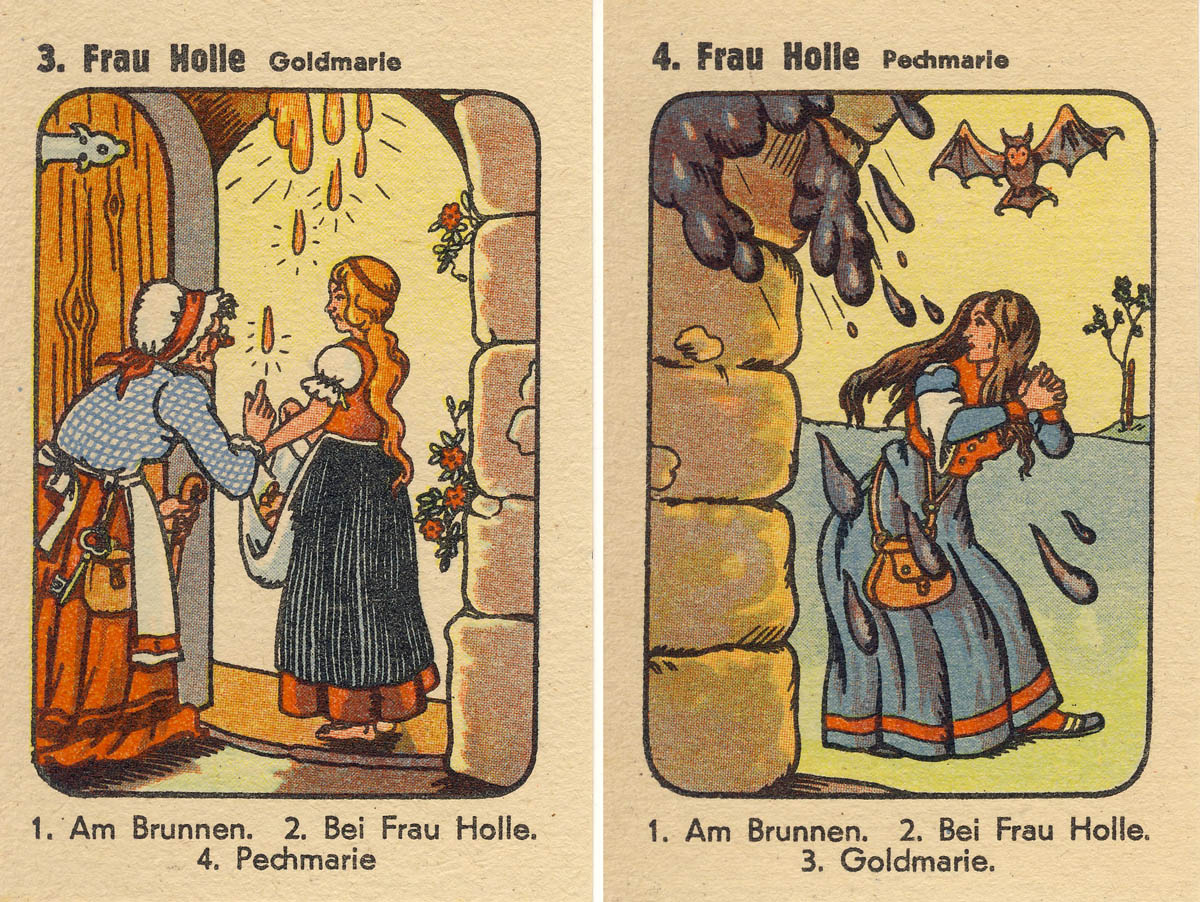
We introduce our next iteration of this tale with a clip is from an English-dubbed version of the 1964 Soviet folklore film Morozko (or Father Frost) by pre-eminent Russian fairy-tale director Alexander Rou. The film weaves its own elaborate story around the bare bones of the classic tale “Father Frost” collected by Alexander Afanasyev in the 1850s. Here, goodness is demonstrated by the Kind Girl’s willingness to endure cold, a particularly Russian virtue.
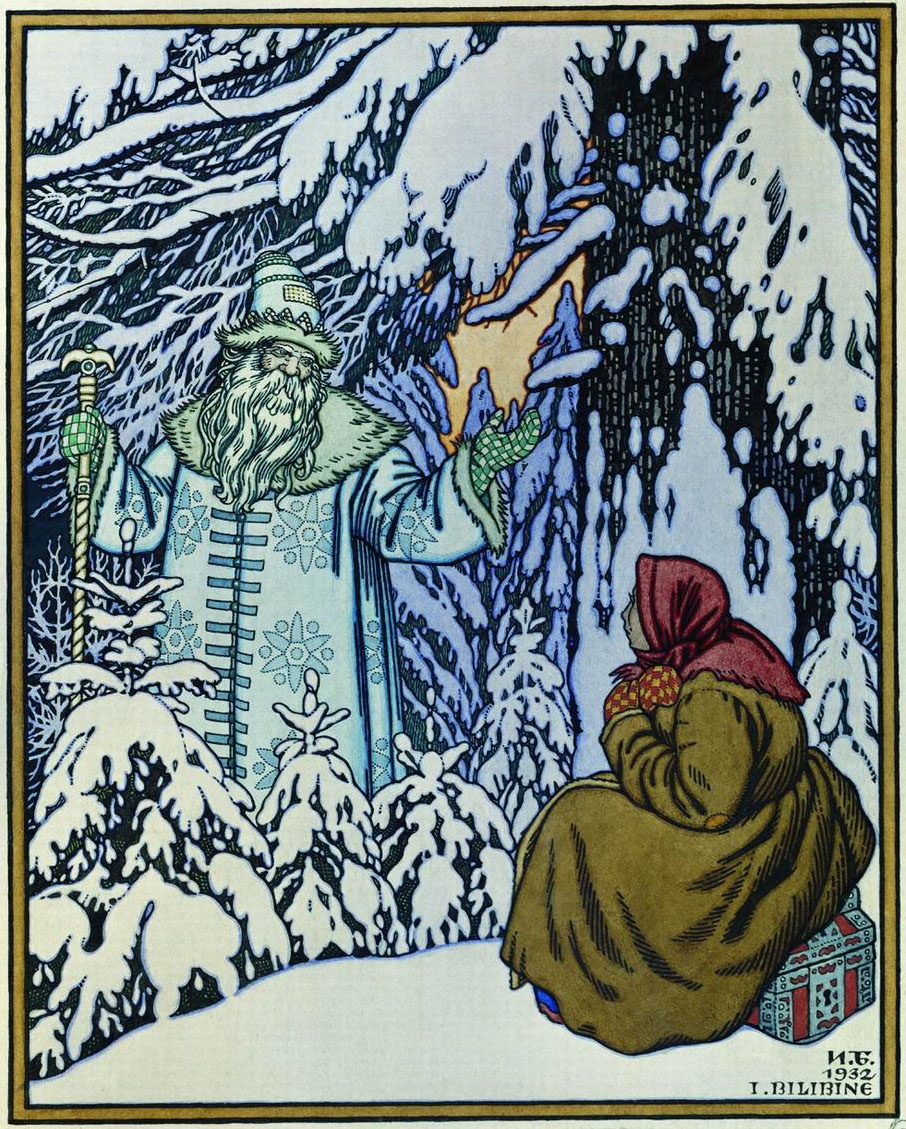
Our last story is the most obscure (and gruesome): “Rattle-Rattle-Rattle and Chink-Chink-Chink” from a 1919 collection by Parker Fillmore called Czechoslovak Fairy Tales. As with several of our stories, a key role is played by an all-knowing housepet who can speak.
We wrap up with a footnote to our first story, “The Three Heads of the Well” and its connection via an Elizabethan play, George Peele’s “The Old Wives’ Tale” to “Willow’s Song” from The Wicker Man (1973), all of which leads us into the bizarre folklore of an aphrodisiac charm known as “cockle bread.”
(NOTE: For details on the 2022 Bone and Sickle shirts and merch mentioned in the show, please visit boneandsickle.com, or go directly to our Etsy shop.)
Dark Fairy Tales I: The Girl with No Hands
“The Girl with No Hands” is the name of a a folk-tale motif shared by a number of gruesome fairy stories in which the the amputation of the heroine’s hands allows her to escape death, the Devil, or a repugnant suitor.
(NOTE: For details on the 2022 Bone and Sickle shirts mentioned in the show, please visit boneandsickle.com, or go directly to our Etsy shop.)
We begin our show with a religious legend differing in narrative details but sharing the amputation theme. It’s a medieval story told in Eastern Orthodox lands of the terrible cost of bad manners at a funeral, specifically that of the Virgin Mary. As a further preliminary to our stories, we also offer a quick rundown on the Aarne–Thompson–Uther system of folk-tale classification, in which “The Girl with No Hands” is identified as ATU 706.
The oldest written example of this motif is the Italian story “Biancabella,” from Le piacevoli notti (“The Pleasant Nights”), a book published in two volumes between 1550 and 1553. The author, Giovanni Francesco Straparola, appears to have modeled his collection on Boccaccio’s Decameron as it uses a similar frame-story, Straparola’s involving characters pleasantly passing their nights (hence the title) in the telling of tales. Among the stories Straparola included, is the first version of “Puss in Boots.”
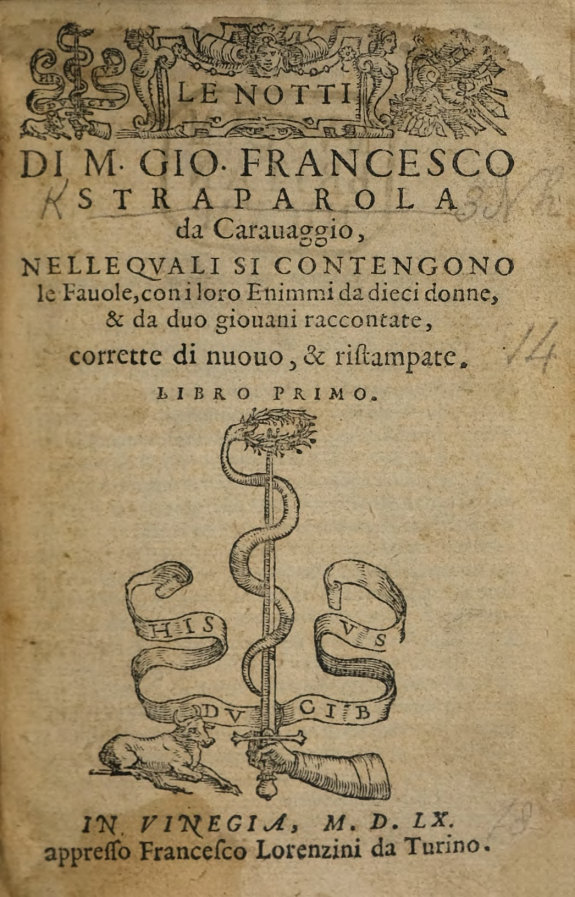
I won’t spoil listeners’ pleasure in hearing Mrs. Karswell read for you the original text but will divulge that its hand-losing heroine Biancabella shares a birth kinship with a serpentine fairy; also, that her hands are sacrificed in an effort to convince her wicked stepmother that her orders to execute her step-daughter have been carried out, and that guilty parties endure in the end a fiery foretaste of hell.
Our second story is “Penta the Handless” from Il Pentamerone (or “The Tale of Tales”) was written about a century later, in 1634, by the Italian poet Giambattista Basile. This collection of stories also makes use of the framing device, having the stories told by a group of courtiers attempting to cheer a melancholy princess. Among the 50 stories included are the first written versions of Cinderella, Rapunzel, Sleeping Beauty, and Hansel and Gretel.
In this story, Penta’s mutilation is self-inflicted as a means of repelling the incestuous advances of her brother. Her royal sibling has an exotic means of expelling her from the kingdom, namely, sealing her in a tarred chest and casting her into the sea (a motif that dates back to the plays of Euripides or even the story of the infant Moses).

Jacob and Wilhelm Grimm provide a relatively late example of this narrative, one however that has provided the ATU #706 with a name:,”The Girl with No Hands.” The story is ncluded in the Grimm’s first 1812 edition of Kinder- und Hausmärchen, i.e., “Grimm’s Fairy Tales.” Our Grimm segment, by the way, begins with a clip from the trailer for the 1962 film The Wonderful World of the Brothers Grimm.
As an oral folk-tale, this German version dispenses with some of the detailed intrigues that mark its two Italian antecedents. Rather than a wicked in-law or brother, it’s the Devil, who tricks a down-on-his-luck miller into doing the gruesome deed. As is frequent in German stories collected by the Grimms, a magical forest-dwelling man also plays a role.
We also briefly discuss a few versions of the story published after Jacob & Wilhelm’s version — other German, Italian, and Hungarian tales which place blame for the amputation not on the Devil but on wicked family members. A gruesome detail included in a few of these mirrors a similarly faux-cannibalistic scene from the Grimms’ original “Snow White.”
We return to Russian for our final story, “The Armless Maiden,” one of the nearly 600 folk tales or skazki contained in the multi-volume Russian Fairy Tales collection compiled by state ethnographer Alexander Afanasyev between 1855 and 1863.
The heroine here is an orphan happily living with her brother until the day her brother takes a bride, as she turns out to be a witch, who is less than happy sharing the household with another female — and has a particularly brutal way of showing it. A strange example of sort Lamarckian evolutionary magic marks this one, with the armless maiden giving birth to a child with silver arms. A particularly gruesome manner of dispatching the sorceress is also a highlight.
We end the show with a Russian musical snippet from an electronic band from Moscow, a duo making music since 2013, under the name IC3PEAK. The song in question rather appropriately begins with the line “I come from a Russian Horror Fairy Tale” and further endears itself with the delightful Baba-Yaga-esque animation of its music video.

Electric Fairy Rings and the Slime from Space
The folklore of fairy rings and “star jelly” is strangely connected to celestial phenomena, including lightning and shooting stars.
We begin with a description of a folkloric fairy ring and its dancing population from John Aubrey’s 1690 book Natural History of Wiltshire, following this with a few other folkloric takes on the topic.
The botanical phenomena of fairy rings is then described that is, circular configurations of mushrooms sprouting overnight or ringlike markings of grass in fields.

The pseudo-scientific 19th-century notion that these rings were caused by lightning strikes as espoused by Sir Walter Scott and Erasmus Darwin is then discussed with a modern parallel connecting this with flying saucer lore provided by Jacques Vallée’s 1969 book Passport to Magonia.
A more ancient connection between lightning and the fruition of mushrooms is then discussed with examples of this belief provided by the Roman naturalist Pliny the Elder and poet Juvenal.
A connection between lightning and the production of a strange slime occurs in a contemporary pamphlet recounting the terrors of 1638’s Great Thunderstorm of Dartmoor England. Mrs. Karswell reads for us this lurid account believed to be the first description of ball lightning.
Rather than ball lightning, however, most accounts of heaven-sent “fireballs” from the early modern and modern era are believed to describe meteors, understood at the time as “falling” or “shooting stars.”
Folklore connects falling stars with the deposit upon the earth of a sort of slime or gelatinous substance known most commonly as “star jelly,” but a dozen or so other names from European folklore are also provided, with the sinister-sounding Welsh term “pwdre ser,” meaning, “rot from the stars” also being fairly common in more modern literature.
Some literary references to this belief are also provided, most of which contrast the beauty or hopeful wishes associated with a falling star and the loathsome heap of jelly it becomes on landing.
A few more modern theories attempting to provide a more scientific account are then provided. Most commonly these include star jelly as frogspawn, jelly fungi, or nostoc, a a single-celled organism that forms into filaments and these into colonies that look like gelatinous piles of dark green (and putrefying) grapes.
The traditional application of nostoc as a food source and medicine are also discussed, as the source of its name in the writings of the 16th-century Swiss natural philosopher and physician Paracelscus who regarded it as something blown “blown from the nostrils of some rheumatick planet.”
Thanks to its seemingly supernatural appearance with the nocturnal dew, the alchemists assigned an elevated role to nostoc, calling it “the water of the equinoxes.” Some illustrations of alchemists attempting to collect nostoc and touting its qualities are provided from the enigmatic Mutus Liber or “Mute Book” of 17th century France, as well as in the work of the modern alchemist Fulcanelli from his 1926 book The Mystery of the Cathedrals. The mystery of the identity of this writer calling himself “Fulcanelli” as well as the claims of his student Eugène Canseliet, who supposedly transmuted lead into gold in 1922 are touched upon.
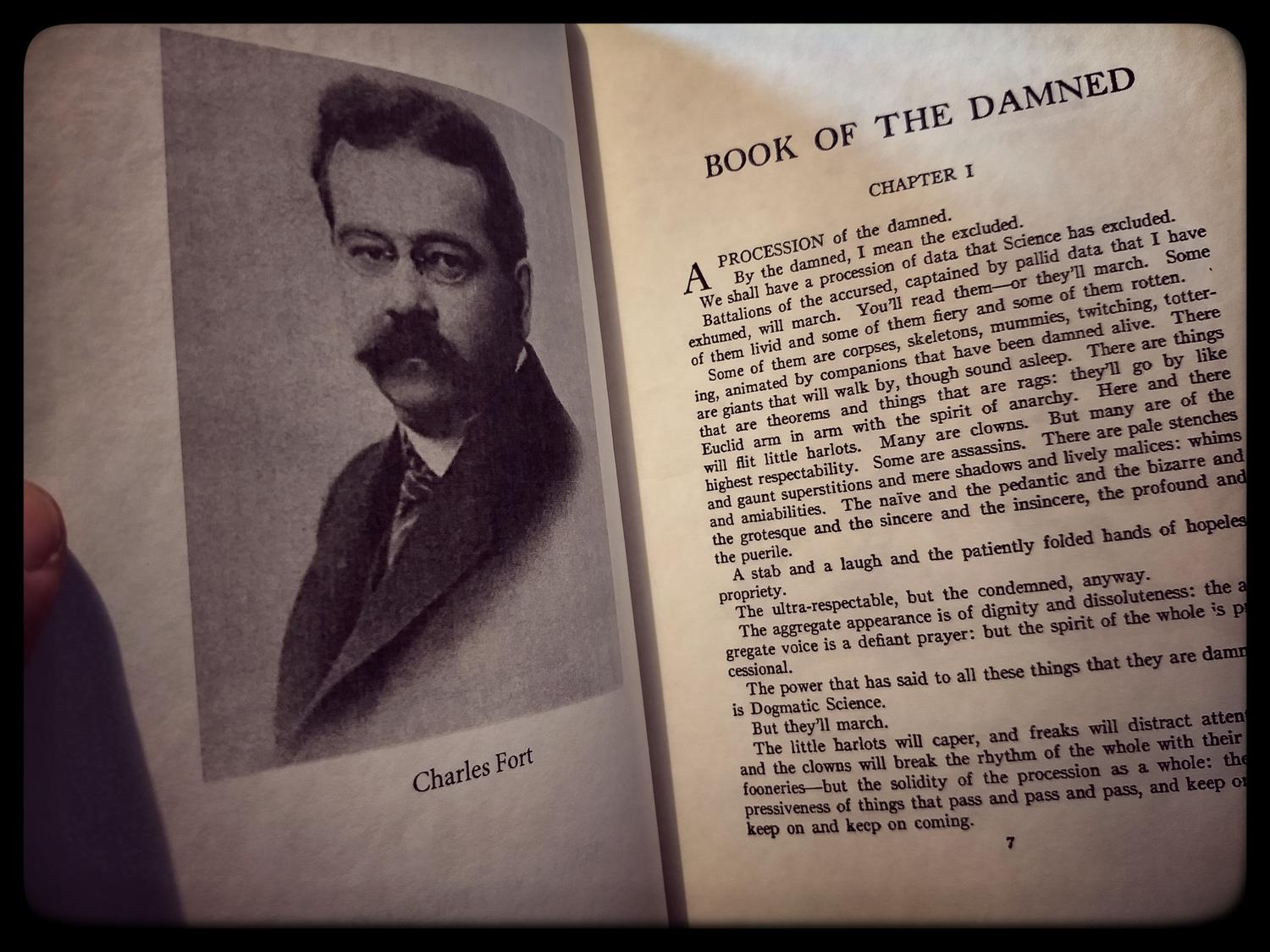
We then have a look at nostoc through the writings of Charles Fort, whose 1919 volume, The Book of the Damned, provided inspiration for all future writings on scientific anomalies, the paranormal, and (to some extent science fiction.) Fort’s arguments about the identification of nostoc with star jelly are illustrated in his discussion of “the Amherst object,” a particularly weird lump of something-or-other said to have fallen in a field near Amherst, Massachusetts in 1819. We also hear a sampling of his eccentric prose echoing his facetiously posited theory of the “Super Sargasso Sea,” an inter-dimensional repository responsible for occasionally teleporting things (or people) in and out of our world.
A few more choice cases of meteors associated with mysterious gelatinous substances are discussed.
We conclude with a look at the inspiration for the 1958 film The Blob, in which a meteor crashes to earth releasing the titular menace upon a small Pennsylvania town. One possible inspiration is Joseph Payne Brennan’s novella, “Slime” published in Weird Tales in 1953, five years before the film’s release. However there are substantial differences between the storylines, which are discussed.
More interesting (in light of our topic) is the notion that the film was inspired by true events, namely an incident documented in newspaper reports of September 26, 1950, describing something bizarre encountered by Philadelphia police during their patrol. It doesn’t seem likely this story played a big role in inspiring the film, and while the newspaper account attempts to categorize the phenomenon as a particularly weird sort of “flying saucer” (saucers being particularly trendy at the time), eyewitnesses describe the object as something more akin to the fairy world. Mrs. Karswell reads the entire newspaper account.
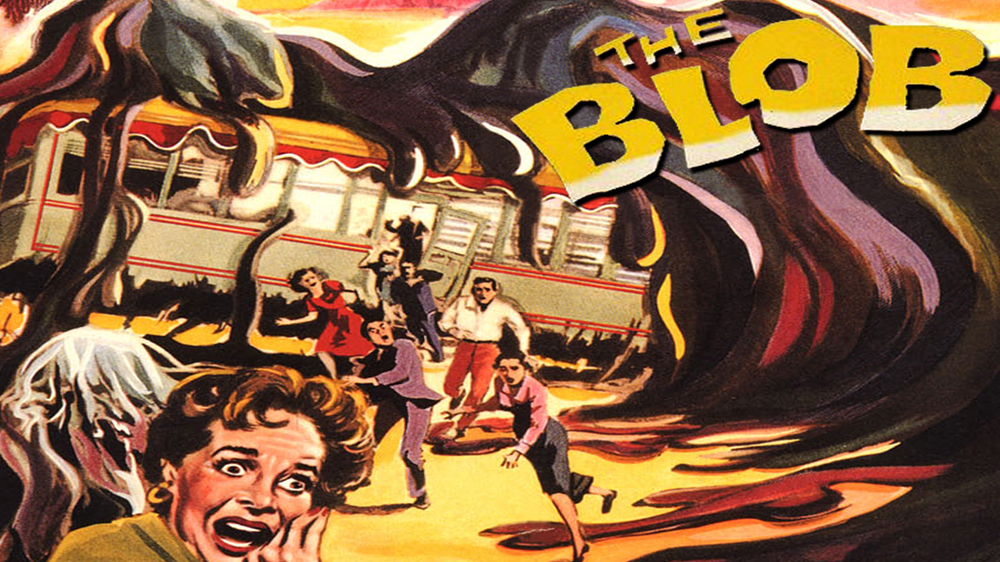
The Seeress: Germanic Tribes, Vikings, and Witches
In pagan Germanic cultures, the seeress played an extremely important role, not only as a clairvoyant, but also often fulfilling the role of a priestess, wisewoman or witch.
We begin with a short clip from Robert Eggers’ The Northman, in which Björk plays a seeress. Old Norse words used to describe this role include spákona, or völva (pl. völvur, völur) — the last meaning “staff bearer,” as a staff was a signifying attribute of the völva, one possibly also used as a magic wand. Staffs discovered in graves of certain high-status women, as suggested by luxurious grave goods, suggest these individuals may have been völvur. We hear some details regarding such discoveries in Denmark and Sweden.
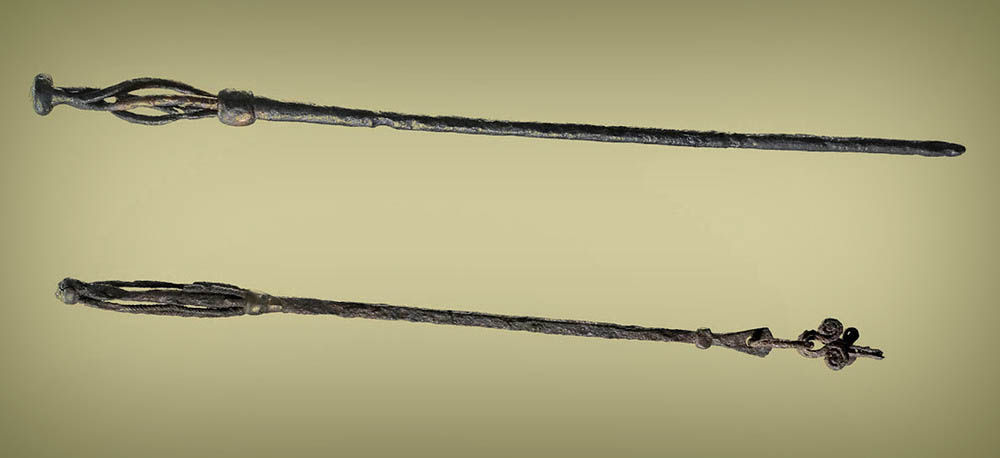
Next we provide a quick overview of the Nordic magic that may have been part of the völva‘s repertoire. Two Old Norse designations for witchcraft are galdr and seiðr (Anglicized as seidr). The latter has more to do with spoken or sung charms, and the latter most prominently with control of mental states but can also involve manipulation of physical realities.
We also address briefly the notion that, like the sibyls of the Classical world, the völva likely entered a trance in order to produce her utterances. Drumming is popularly associated with this, as it is central to the shamanic practice of the Sammi people on the northern and eastern fringes of Scandinavia and Lapland.
The first accounts we have of völvur come from Roman encounters with Germanic peoples on Europe’s mainland. A particularly important account we hear comes from Tacitus’ Histories, in which he describes a seeress by the name of Veleda, who guided the Bructeri tribe through their conflicts with the Romans. We also hear about a sacred grove of the Germans, one likely described to Tacitus by a Germanic priestess by the name of Ganna during her visit to Rome.
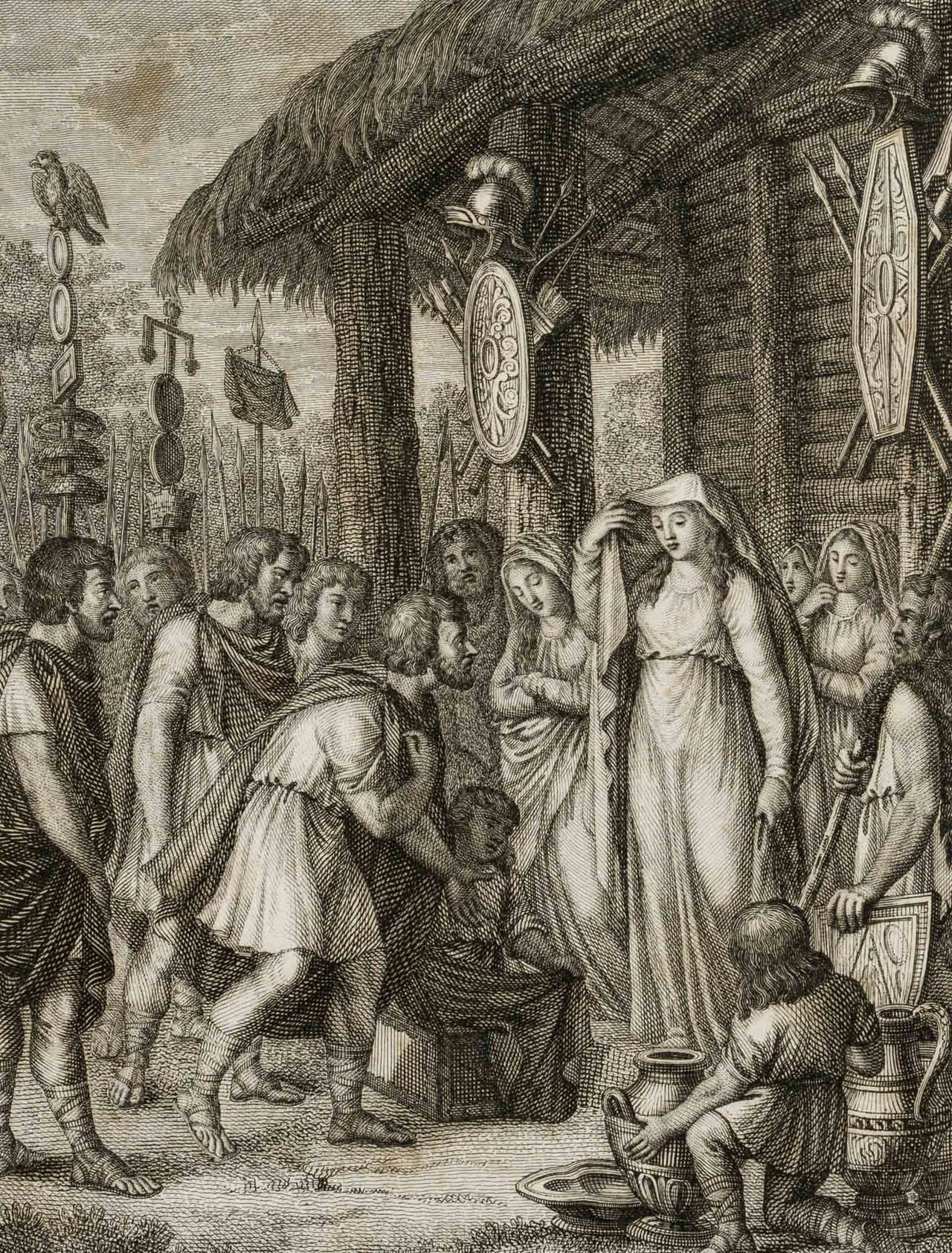
We also hear from the Greek historian Strabo, who in his Geographic portrays female seers of the Cimbri people, sacrificing prisoners of war, bleeding them, and telling fortunes from their entrails. Mrs. Karswell provides a lovely reading of this passage.
The earliest of our Scandinavian texts. one written anonymously probably around 960, is the Völuspá, (literally: “the prophecy of the völva). In the narrative the seeress in question is sought out by Odin himself, a dynamic testifying to the importance of the völva in Germanic culture.
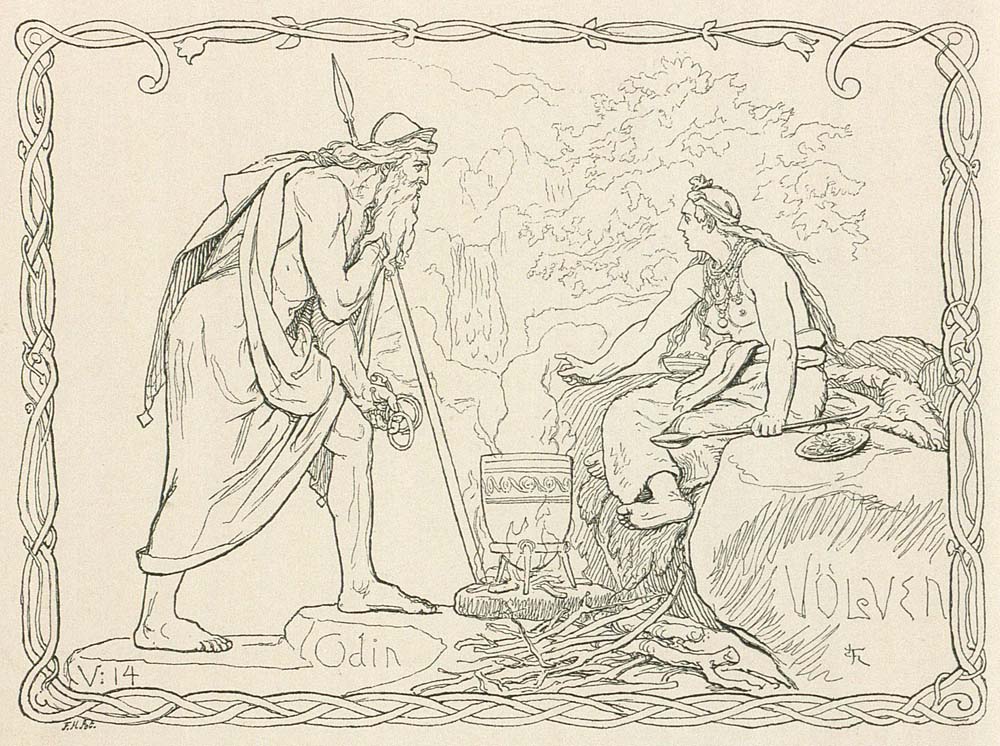
A particular episode in this epic poem features a seeress by the name of Gullveig (later changed to Heidr) who is attacked by the gods in Odin’s hall, an event leading to the war between the two divine races, the Aesir and Vanir. It’s speculated that this seeress may be the narrator of the prophecies recounted in the poem.
Probably the most finely detailed account of the völva’s activities in the real comes from the 13th-century Saga of Erik the Red. Its description emphasizes the honor with which the seeress was treated while visiting farmsteads to relate her prophecies. It also notes the use of galdr (singing magic) and lavishly details the special attire worn by a seeress.
Our next selected episode featuring a völva comes from the 13th-century Icelandic saga, the Saga of Örvar-Odd, a name translated usually as “Arrow-Odd”. This one involves the seer’s prophecy of an inescapable fate involving a horse.
Our final story of a Nordic witch is from Gesta Danorum or”Deeds of the Danes,” a 12th-century chronicle of the country by Saxo Grammaticus. It features a witch who transforms herself into a walrus at a critical moment and a body that really needs to be buried.
We close with some audio snippets from Freyia Norling, a modern practitioner of seidr, who from her home in the Arctic Circle, hosts the intriguing YouTube Channel “A Discovery of Nordic Witches.”
The Hellfire Clubs, Part Two
The best known of the 18th-century Hellfire Clubs, one founded by Francis Dashwood, is largely remembered today because of the theatrical settings in which they were said to gather, namely a ruined abbey and a network of caves. The latter is represented in the 1961 period drama, The Hellfire Club, from which we hear a brief snippet (although other details and characters of the film are strictly products of the screenwriter’s imagination.)
Francis Dashwood was born into privilege, son of a Baronet, whose title and estate in Wycombe (in Buckinghamshire county, about an hour northeast of London) he inherited at the age of 15. His various social connections saw him appointed to various positions, including Chancellor of the Exchequer and Postmaster General, but his reputation in such roles was generally one of incompetence. This, however, was balanced by his peculiar genius for organizing social clubs.
We discuss two groups he founded before his “Hellfire” days, The Society of Dilettanti, and The Divan Club, both groups dedicated to exploring the culture of lands far from England: the first dedicated to the exploration of the classical heritage of Greece and Rome, and the latter devoted to the lands of the Ottoman Turks.
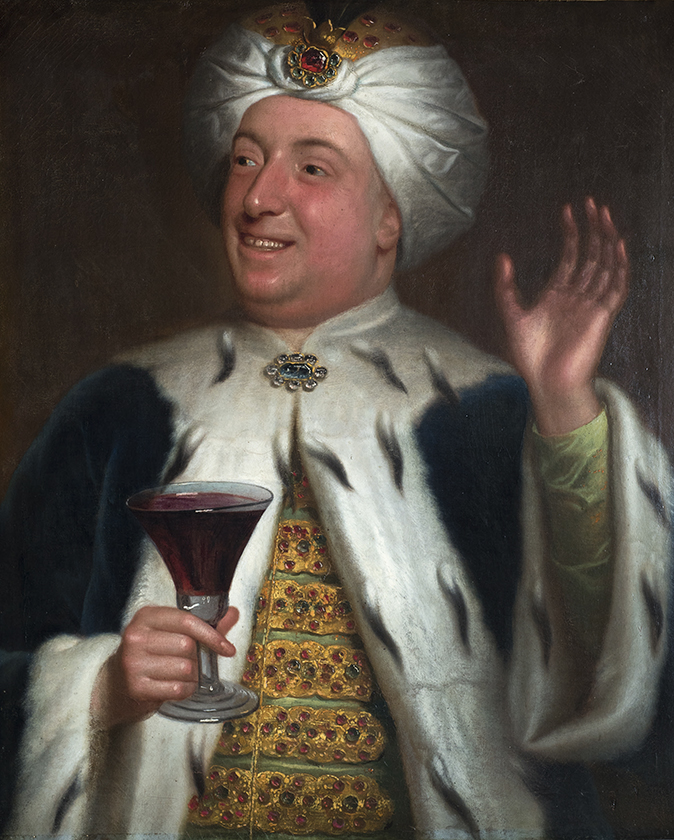
Social groups such as these were referred to as “dining clubs,” though “drinking clubs” would likely be more accurate. The Society of Dilettanti seems to have exhibited a particular devotion to “Venus” and “Bacchus” (polite jargon of the era for erotica and more drinking.) The Dilettanti’s delight in forbidden themes expressed itself in certain “devilish” elements of club ritual prefiguring Dashwood’s “Hellfire” years. In some anecdotes about Dashwood’s travels abroad, told by Horace Walpole, we hear of some likewise impish and irreligious behavior.
In 1752, Dashwood turned his attention to his most famous creation. Actually, he never called it “The Hellfire Club”; instead it was referred to (among other names) as The Brotherhood of St. Francis of Wycombe — a mocking reference to the Catholic saint of Assisi. Dashwood had several portraits painted portraying him as a questionable monk, including this one by William Hogarth:
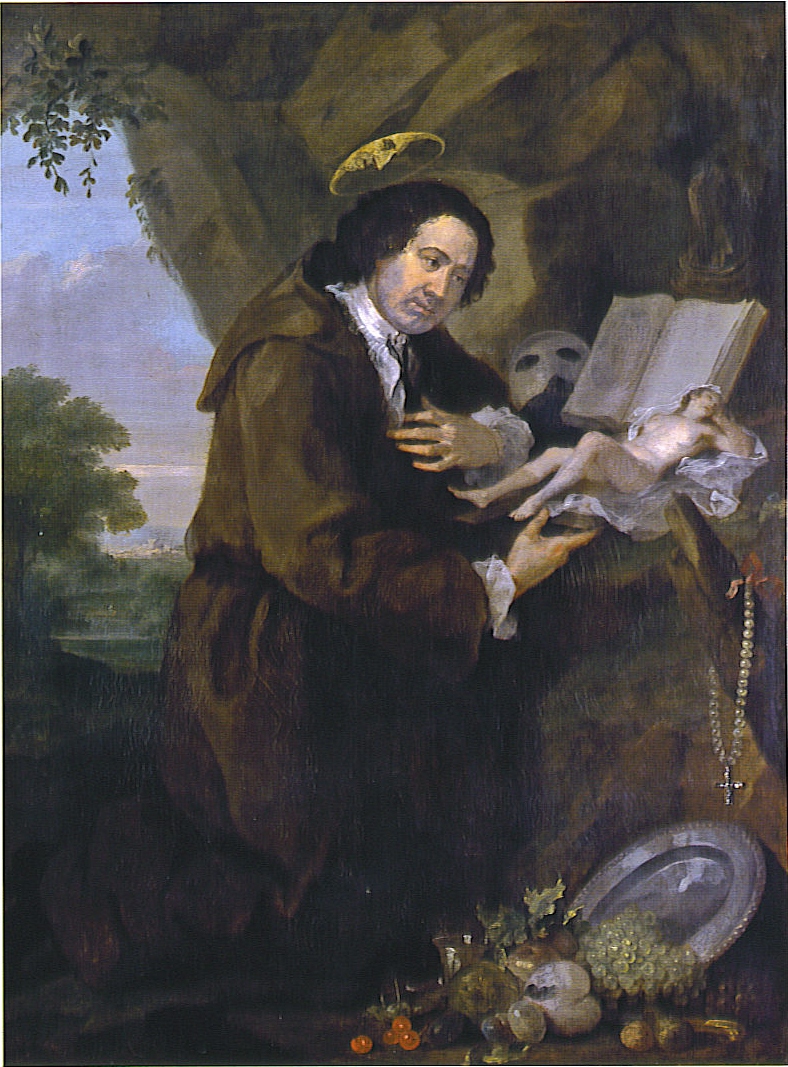
(The image in the episode collage likewise represents Dashwood as St. Francis, this one from his Dilettanti years.)
After an abortive start holding meetings on his estate, Dashwood moved the group to the George and Vulture Inn in London, then in 1751, after leasing an old abbey 10 miles south of his estate in Medmenham, he relocated gatherings there, at which point, the group became known as the Monks of Medmenham.
To supervise restoration of the abbey, Dashwood hired Nicholas Revett, a pivotal figure in the revival of classical Greek architecture in England, a movement, Dashwood embraced with uniquely idiosyncratic abandon.
We hear of a number of eccentrically pagan additions Revett added to Dashwood’s estate, and Mrs. Karswell reads a contemporary report on the dedication of a Temple of Bacchus on the grounds, complete with costumed fawns and satyrs. We also hear about the curious interest he took in Wycombe’s Church of St. Lawrence, hiring Revett to complete a restoration modeled on a pagan temple in Syria. He also had an enormous golden ball added to the church steeple, one reputedly large enough to accommodate Dashwood and several Hellfire cronies, who would gather there to drink.

As for rumors of sexual escapades attached to the club, we explore some clues provided a 1779 volume surveying London’s brothels entitled Nocturnal Revels. While some of this may just be salacious rumor, the libertine law of Dashwood’s “order” was literally set in stone, carved over the entrance: Fais ce que tu voudras, (“Do what you will”.)
The phrase is borrowed from 16th century French satirist François Rabelais, himself a former monk who satirized the Church and society at large, in his series of connected novels Gargantua and Pantagruel. In the former, Rabelais imagined a libertine monastery with the phrase inscribed over its entrance, an idea borrowed by Aleister Crowley in his imagining of an Abbey of Thelema (his religious system built around the concept of the will or thelema in Greek.)
While Dashwood’s primarily playful attitude clearly distinguished him from Crowley and other serious occultists, there were rumors of secret rituals practiced by an inner circle of the monks, as we hear in another description provided by Horace Walpole.
The inner circle of Dashwood’s group, known as “the Superiors,” was restricted to 12 members plus Dashwood, the number being either an irreverent reference to Jesus and his twelve disciples or the number in a witches’ coven. The general membership included a alarming number of elite figures, a half dozen or so Members of Parliament, prominent writers, poets, the son of the Archbishop of Canterbury, and Frederick Prince of Wales, the eldest (estranged) son of George II. We also hear of Benjamin Franklin’s involvement with Dashwood.
Two particular members are discussed in a bit more detail: John Wilkes and John Montagu, whose personal feud spelled the end of the club and involved a particularly outrageous stunt said to have been perpetrated by Wilkes.
Wilkes was a radical politician whose published remarks on a speech by George III resulted in charges of libel and him briefly fleeing the country as an outlaw — an incident which endangered the Monks by his association. His nemesis was John Montagu, better known as the Earl of Sandwich (and here we provide the origin story of that particular culinary innovation.)
At some point around 1750, Wilkes published obscene parody of Alexander Pope’s poem, “An Essay on Man,” called “An Essay on Woman,” one which targeted Montagu’s well known mistress Fanny Murray as its subject. In revenge, Sandwich chose to read before Parliament particularly obscene passages from Wilkes’ satire, resulting in further charges against his rival. Wilkes reciprocated by publishing further exposes of the group, generating further controversy ultimately leading Dashwood to close the abbey headquarters in March of 1776.
While there were serious political differences between Sandwich and Wilkes, the real cause of their hostility, so goes the story, lies in an absurd stunt referred to as “The Affair of the Baboon,” a detailed account of which Mrs. Karswell provides from an 18th century source.
Though there are no historical records documenting this, a strong tradition holds that after ending meetings at the abbey, Dashwood moved gatherings into a network of manmade caves on his estate (tunnels excavated for chalk).
This tradition is documented as early as 1796, when a diarist (Mrs. Philip Powys) describes a visit to the caves, noting a hook for a chandelier, likely to have been the “Rosicrucian” chandelier, Dashwood elsewhere described. She also mentions an underground pool supposedly known by the Medmenham monks, as “The River Styx,” a large central chamber that became “The Banqueting Hall” and other small rooms nicknamed “Monks’ Cells.” A gothic facade fronts the caves.
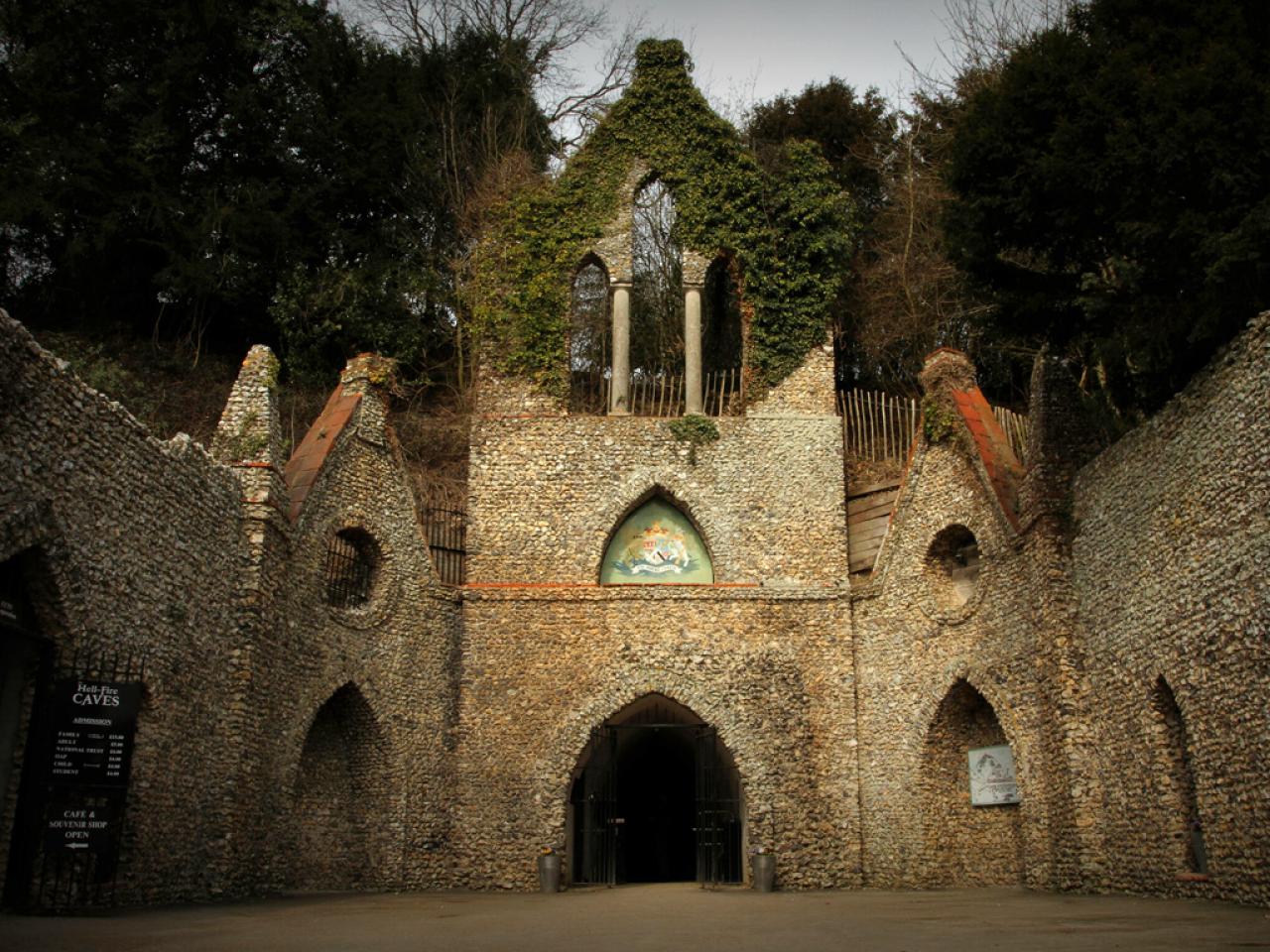
Throughout the 19th century, local legends of occult doings in the caves grew evermore fantastic, as we hear in a few quotes read by Mrs. Karswell. By 1951, a descendent of Francis Dashwood, Sir Francis John Vernon Hereward Dashwood, who had inherited the family’s West Wycombe properties, struck upon the idea of transforming the caves into a tourist attraction, advertising the tunnels as “The Hellfire Caves.” Though ultimately successful, we hear some contemporary newspaper accounts voicing concerns by local residents and clerics about evil forces awakened from within the caves through these activities.
Our episode ends with a ghost story told of Francis Dashwood’s best friend and fellow Monk, Paul Whitehead, something involving removing Whitehead’s heart.
CONTEST INFO:
For information on the Patreon giveaway please visit: https://www.boneandsickle.com/2022/03/30/patreon-raffle/
Hellfire Clubs, Part One
The Hellfire Clubs of 18th-century Great Britain were gatherings of upper-class libertines dedicated to hedonism, blasphemous jests and taboo activities expressing a cultural and political opposition to the Church. They were also the subject of lurid rumor and legend. In this episode and the next we attempt to tease out Hellfire Club fact from folklore.
We begin with a nod to the Hellfire Club of pop culture: a clip or two from a 1966 episode of the British espionage show, The Avengers, which imagines a Hellfire Club recreated in swinging London.
As a bit of context to the discussion, we then consider 18th-century Britain’s mania for forming clubs and fraternal orders, including London’s Kit-Cat Club, Beefsteak Clubs, and the Calf’s Head Club, the last celebrating the execution of Charles I with stunts and feasts organized around a calf head representing that of beheaded monarch. We also take a moment to consider the “rake,” (from the word “rakehell”) a distinctively 18th-century breed of aristocratic hell-raiser dedicating himself to womanizing, drinking, and gambling. Hellfire Club members were drawn almost exclusively from this class.
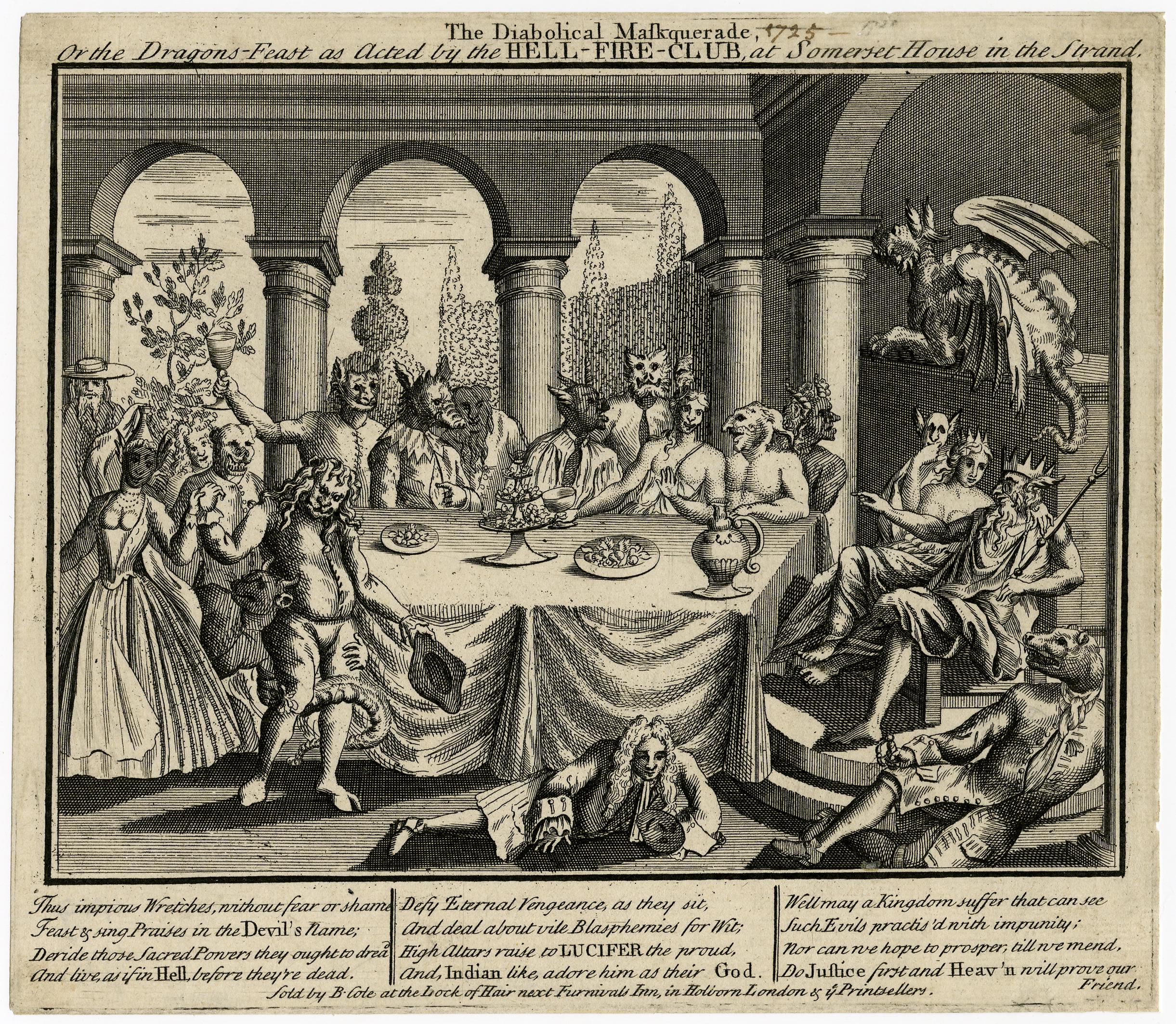
History’s first Hellfire Club was founded sometime around 1720 by Philip Wharton, 1st Duke of Wharton. His case seems to be one of the apple not falling far from the tree, as we hear of some outrageous incidents of church vandalism in which is father, Tom Wharton, engaged.
While father and son shared anticlerical sentiments, young Philip’s rebellion against parental expectations allied him with the very Jacobites battled by his father, and resulted in a secret engagement to young girl beneath his class, as well as a stunt involving a bear cub.
Wharton’s connection to the Hellfire Club, (like what we know of the club itself) is extrapolated from rumors circulating in the popular press of the day. We hear some examples of this, claims about “Holy Ghost Pie” blasphemy at taverns, members serving diplomatic functions in hell, and the like.
However much the press tended to fictionalized the group, it was real enough to have drawn the ire of George I, who issued an edict in 1721 against the formation and meeting of clubs dedicated to blasphemy. Public opinion so strongly associated Wharton with such groups, that when the edict cae before the House of Lords (where he also served), he found it necessary to address the rumors, denying that they could apply to him, but at the same time voting against the measure.
Little mention was made of the Hellfire Club after this, and it seems Wharton redirected his interest to Freemasonry going on to become to Grand Master of the Premier Grand Lodge of England. However, his obstreperous nature soon saw him booted from this organization. Thus inspired, he went on to found another order, the Gorgomons, one which instead of mocking the Church, ridiculed Freemasonry. We hear a bit about that group from the text of organization a comical pamphlet illustrated by William Hogarth.
Dublin also was home to a Hellfire Club, founded in 1735 by Richard Parsons, 1st Earl of Rosse, an English-born member of the gentry of Ireland. More specifics are known in the case of this club, including core members (rakes all!) who are represented in a 1735 painting of the group meeting around a punch bowl. The presumptive location of this scene would be The Eagle Tavern on Dublin’s Cork Hill, and the drink likely scaltheen, a milk-punch strongly associated with the club.

Because Parsons owned an old hunting lodge on Montpelier, a mountain on the outskirts of the city, it’s also commonly presumed the group gathered there. While there’s no contemporary documentation confirming this, the romantic nature of the site all but demanded it be incorporated into the folklore. The building was in a state of partial ruin even in Parson’s day, and was constructed from stone quarried from an ancient pagan burial cairn on the hill.
We hear a few of the legends associated with Hellfire gatherings of Montpelier, including a longer tale of a devilish black cat related by Mrs. Karswell from the 1907 book, Sketches of Old Dublin.
The end of this Irish Hellfire Club seems to have had much to do with the vile reputation of a particular member, Henry Barry, 4th Baron of Santry. We hear of the homicide charges leveled against him as well as of another murderous incident, which may be the stuff of legend.
We also hear of a sort of spiritual resurrection of Dublin’s club in 1771 under the ironic name, “The Holy Fathers.” Despite the dark rumors swirling around this group, its founder, Buck Whaley was a popular character thanks to his larger-than-life adventures. We hear some tales of his extraordinary wagers and of the foolhardy journey that earned him the nickname, “Jerusalem Whaley.”
Though it’s not another Hellfire Club, we make a brief side trip to discuss, The Beggar’s Benison, an equally scandalous club — and not just by 18th century standards.
Founded in 1732 in the Scottish town of Anstruther on the Firth of Forth, the Beggar’s Benison was a men’s fraternity obsessively devoted to sex, the sharing of erotic art and literature, dirty songs and toasts, and the presentation of frank lectures on sexual topics. We hear the tale told of is legendary founding by a particularly rakish version of James V, of the club’s rather shocking initiation rites, and of of the membership’s peculiar obsession with pubic hair.
We close with two tales detailing the ends of Philip Wharton of London’s Hellfire Club and Richard Parsons of Dublin — one tragic and the other comic.
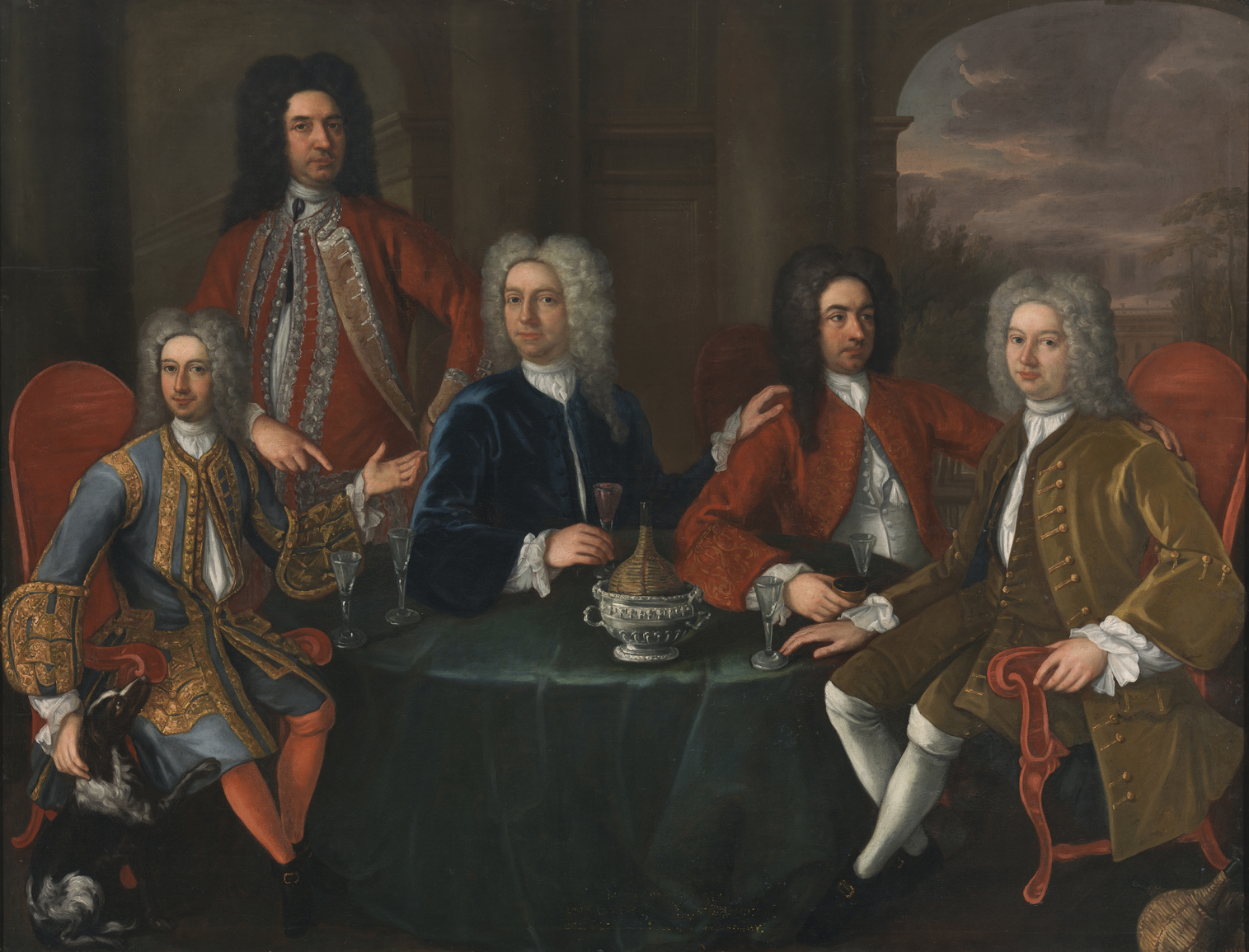
NOTE: Details on our Patreon raffle for the 15-disc set, All The Haunts Be Ours: A Compendium Of Folk Horror, are available at this link: https://www.boneandsickle.com/2022/03/30/patreon-raffle/
Grottos, Caves of Wonder
Grottos are a peculiar subset of caves, usually small and picturesque, and often associated with wonders both otherworldly and manmade.
NOTE: Details on our Patreon raffle for the 15-disc set, All The Haunts Be Ours: A Compendium Of Folk Horror, are at the bottom of this post.
We begin with what is likely the best known example of the sacred grotto, the Catholic shrine at Lourdes, France, where in 1858, the Virgin Mary was said to have appeared to a 14-year old Basque girl by the name of Bernadette Soubirous. Particularly of interest to our show is the regional folklore that provided a background for these apparitions, especially the association between a variety of supernatural beings and caves.
While the grotto at Lourdes is a natural structure, the grottos we examine through the rest of the show are artistic constructions, the first of these being the “grottos”formerly created by British children on Grotto Day. The choice of material for constructing these is oyster shells, as the day coincides with the Feast of St. James, patron of oyster harvesters. The connection between St. James and shells is explored via the pilgrimage route leading to his tomb, the Camino de Santiago de Compostela, one for which the symbol of the “pilgrim’s scallop” serve as prominent way-markers.
We then move into the classical world to examine the nymphaeum, a grotto dedicated to the nymphs, specifically the Naiads or water nymphs, a combination of cave and spring as was the case with Lourdes. From this Greek concept grew the Roman notion of the purely secular “pleasure grotto,” such as the famous (and ill-fated) example created by Emperor Tiberius for his villa on the Italian coast at Sperlonga. Mrs. Karswell reads some remarks by the historian Suetonius on this.
After hearing a bit from the 15th-century architect Leon Battista Alberti on a revived interest in artificial grottos during the Renaissance, we look at the grotto’s evolution into the “water theaters” of the 16th and 17th century, their “trick fountains” and water-driven automata. Here we citing two Italian examples (Villa Aldobrandini in Frascati and Tivoli Gardens in Florence) and one from Austria, Saltzburg’s Hellbrunn Palace.
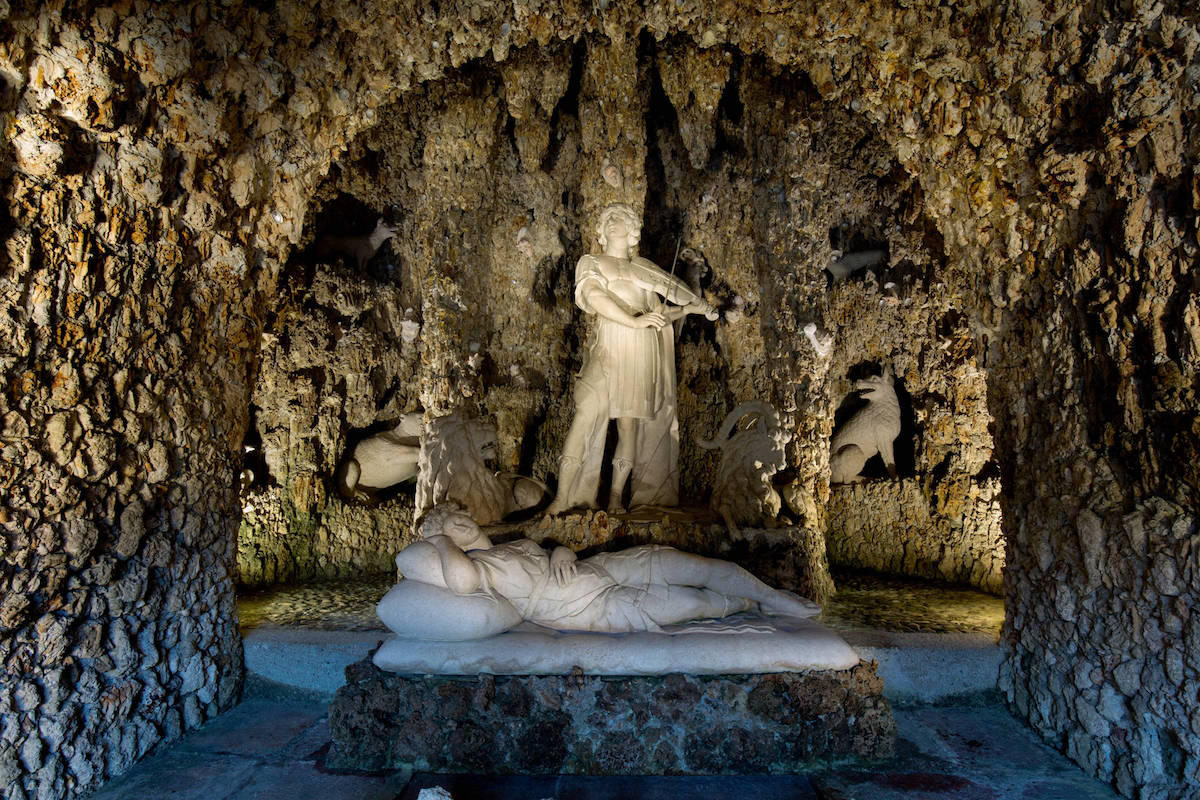
We then hear a bit about the return during the Romantic era to the earlier classical preference for constructing grottos that simulated natural caves, hearing in this case a quote from the British poet and satirist Alexander Pope enthusing over his grotto completed in 1725. We also hear about England’s most famous grotto in Margate on the southeast coast and the mystery associated with it and about a grotto. Also mentioned is the grotto created fort the gardens of Hawkstone Hall in Shropshire (where other “follies” include a romantic “hermitage” that once employed an actor portraying a bearded hermit).
Our final example, comes from Germany, the “Venus Grotto” constructed for King Ludwig II of Bavaria, the so called “Mad King” responsible for building the palace of Neuschwanstein, Germany’s famous “fairy tale caste. The details of the Venus Grotto should help you better understand Ludwig’s particular strain of “madness.”
We end our episode returning to the story of St. Bernadette and some of the grim details involved in her canonization, namely the exhumation of her body to determine if it might be physically “incorrupt.”
(The song you hear in a couple snippets during the show is, btw, is 1959 single “The Village Of St Bernadette” by Anne Shelton.)
PATREON RAFFLE
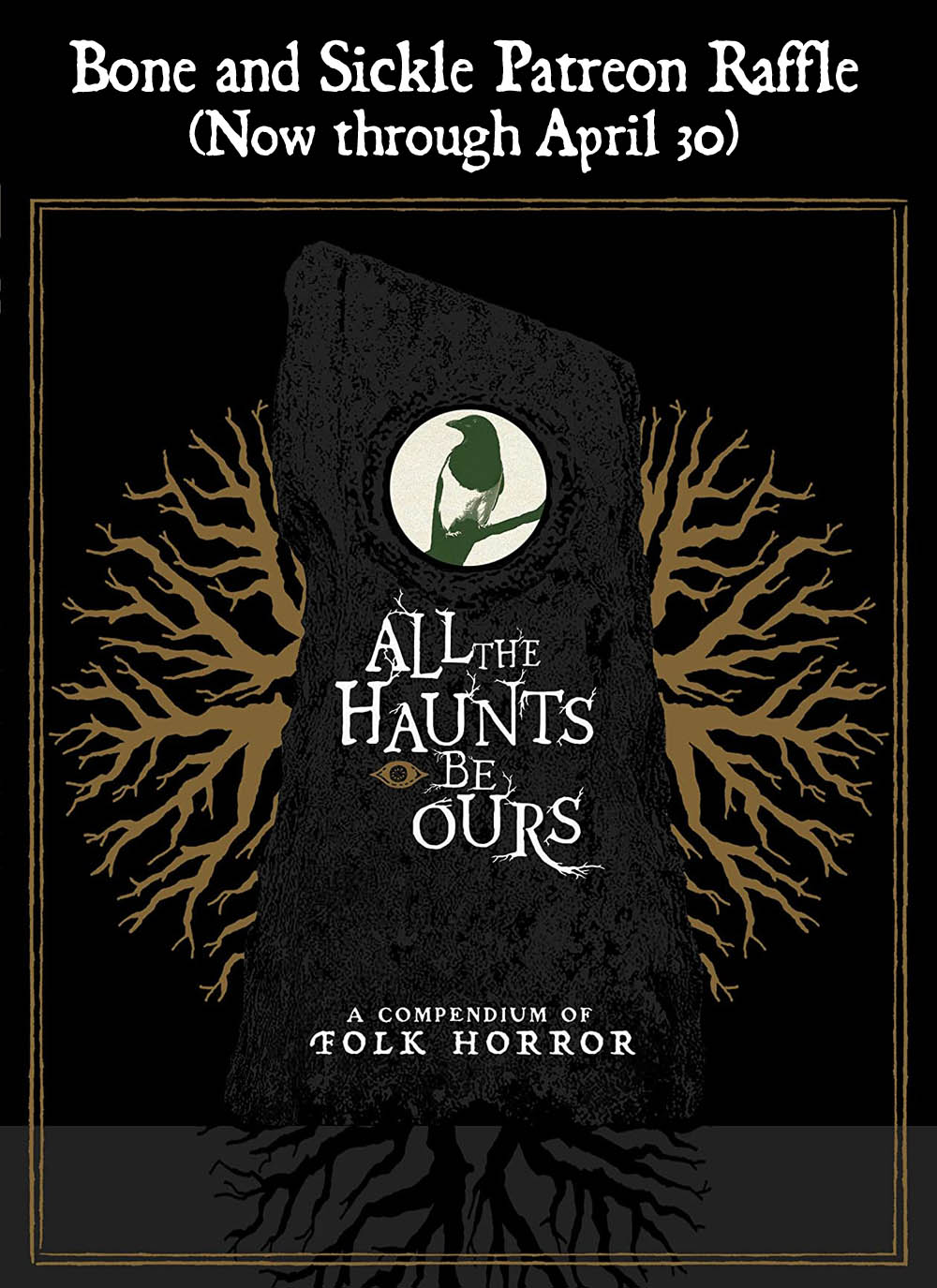
We have a special offer running from now until April 30, a chance to win the 15-disc set, All The Haunts Be Ours: A Compendium Of Folk Horror. It’s a splendid collection released in conjunction with the Folk Horror documentary Woodland Dark and Days Bewitched, which is one of the included discs. Not only does it include over 31 hours of folk-horror films on BlueRay, but also 3 CDs including a reading of a classic Arthur Machen story and a 156-page book on the folk-horror genre.
BONE AND SICKLE PATREON LINK:
https://www.patreon.com/boneandsickle
ELGIBILITY:
The value of the collection is $279 and a randomly chosen subscriber at the $4 monthly level or above will be announced on May 1.
To enter, you must subscribe on the once-yearly plan, which actually saves 15% on what you would otherwise pay monthly.
You will be automatically entered upon signing up as stipulated.
FEATURE FILMS INCLUDED IN THIS SET:
WOODLANDS DARK AND DAYS BEWITCHED (192 mins/1.85:1/English 2.0/CC)
EYES OF FIRE (86 mins/1.85:1/English 1.0/CC)
LEPTIRICA (65 mins/1.33:1/Serbian 1.0/English Subtitles)
WITCHHAMMER (107 mins/2.35:1/Czech 1.0/English Subtitles)
VIY (76 mins/1.33:1/Russian 1.0/English 1.0/English Subtitles)
LAKE OF THE DEAD (77 mins/2.40:1/Norwegian 1.0/English Subtitles)
TILBURY (57 mins/1.33:1/Icelandic 1.0/English Subtitles)
THE DREAMING (90 mins/1.85:1/English 1.0/CC)
KADAICHA (88 mins/1.33:1/English 1.0/CC)
CELIA (103 mins/1.85:1/ English 1.0/CC)
ALISON’S BIRTHDAY (99 mins/1.85:1/ English 1.0/CC)
WILCZYCA (103 mins/1.33:1/Polish 1.0/English Subtitles)
LOKIS: A MANUSCRIPT OF PROFESSOR WITTEMBACH (100 mins/1.66:1/Polish 1.0/English Subtitles)
CLEARCUT (98 mins/2.35:1/English 5.1/English 2.0/CC)
IL DEMONIO (100 mins/1.85:1/Italian 1.0/English Subtitles)
DARK WATERS (89 mins/1.85:1/Italian 2.0/English Subtitles)
A FIELD IN ENGLAND (90 mins/2.35:1/English 5.1/English 2.0/CC)
ANCHORESS (108 mins/1.66:1/English 1.0/CC)
PENDA’S FEN (90 mins/1.33:1/English 1.0/CC)
ROBIN REDBREAST (76 mins/1.33:1/English 1.0/CC)
The Dead Lover’s Heart
Whether freshly removed or strangely preserved after death, the dead lover’s heart occasionally has continued to be embraced as a repository of intensely shared romantic experience. This Valentine’s Day episode explores two different narratives touching on that theme: a historical tale from the 19th-century literary culture of England and a collection of related medieval legends, literature, and song.
The first half of our episode looks at the strange circumstance surrounding the death, in 1822, of Romantic poet Percy Bysshe Shelley, and the postmortem keepsake inherited by his wife Mary Shelley.
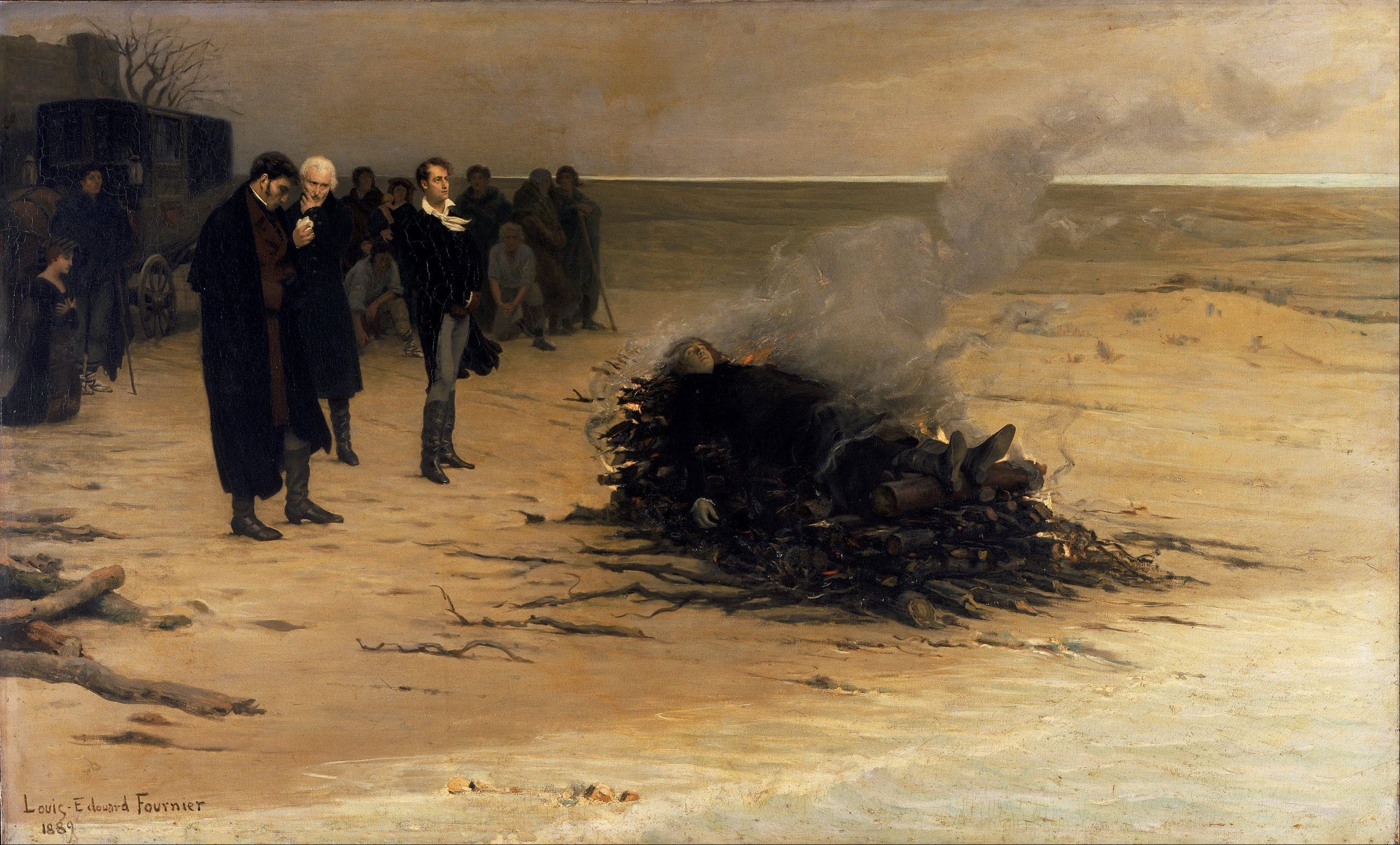
The second half examines two gruesome narratives taken from the 14th century, both from Giovanni Boccaccio’s The Decameron, namely that of the ill-fated lovers Ghismonda & Guiscardo (First Story, Day Four) and of the tragic romantic exploits of Guilhem de Cabestaing (Ninth story, Day Four). Incidentally, our Valentine’s Day show from last year also explores another gruesome tale from The Decameron.
De Cabestaing was an actual historical figure, a Catalan ministrel, whose fictional vida (biography) was often attached to collections of his ballads and served as Boccaccio’s inspiration.
We also look at the Ley of ’Ignaure, a chivalric romance written by the Burgundian French author, Renaud de Beaujeu, probably around the year 1200. This was likely the source of Cabestaing’s vida, Boccaccio’s stories, and the English-Scottish ballad, “Lady Diamond,” from which we also hear a snippet.
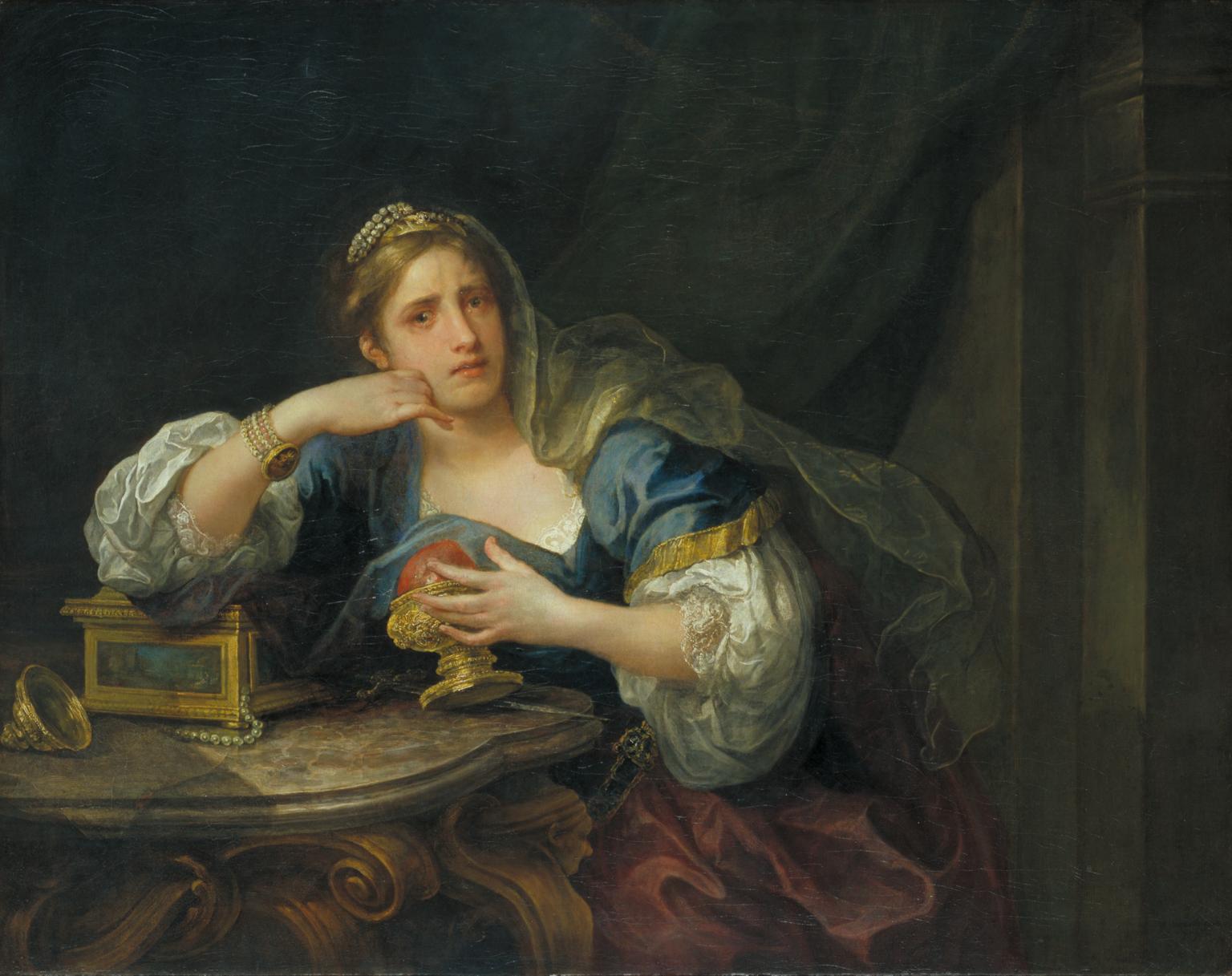
Myth and Magic of the Smith
Folklore of the blacksmith portrays him as a semi-magical figure, a wily opponent of the Devil, a mythic creator in classical and biblical narratives, and an embodiment of occult wisdom within certain secret societies and neopagan groups.
We begin with an audio snippet from the excellent 2017 horror-fantasy Errementari: The Blacksmith and the Devil, a cinematic elaboration of the Basque folktale, “Patxi the Blacksmith” collected back in the 1960s by the Spanish priest and Basque ethnographer Jose Miguel Barandiaran.
This is one of dozens (perhaps hundreds) of variants of “Blacksmith and Devil” tales found from Russia to Appalachia, all of which involve a smith selling his soul to the Devil in exchange for some reward, then somehow tricking the Devil out of his due. Some variations of the story collected by Jacob and Wilhelm Grimm are outlined, and Mrs. Karswell reads passages of an Irish variant from the 1896 volume, The Humor of Ireland, one which also serves as a sort of origin story for a popular seasonal custom.
While most of the blacksmiths in these tales tend to be roguish, England offers a devil-combating smith who is actually quite saintly, namely St. Dunstan, the 10-century Abbot of Glastonbury, who also found time to master the harp and the art of blacksmithing. We hear several variations of his encounter with the Devil.
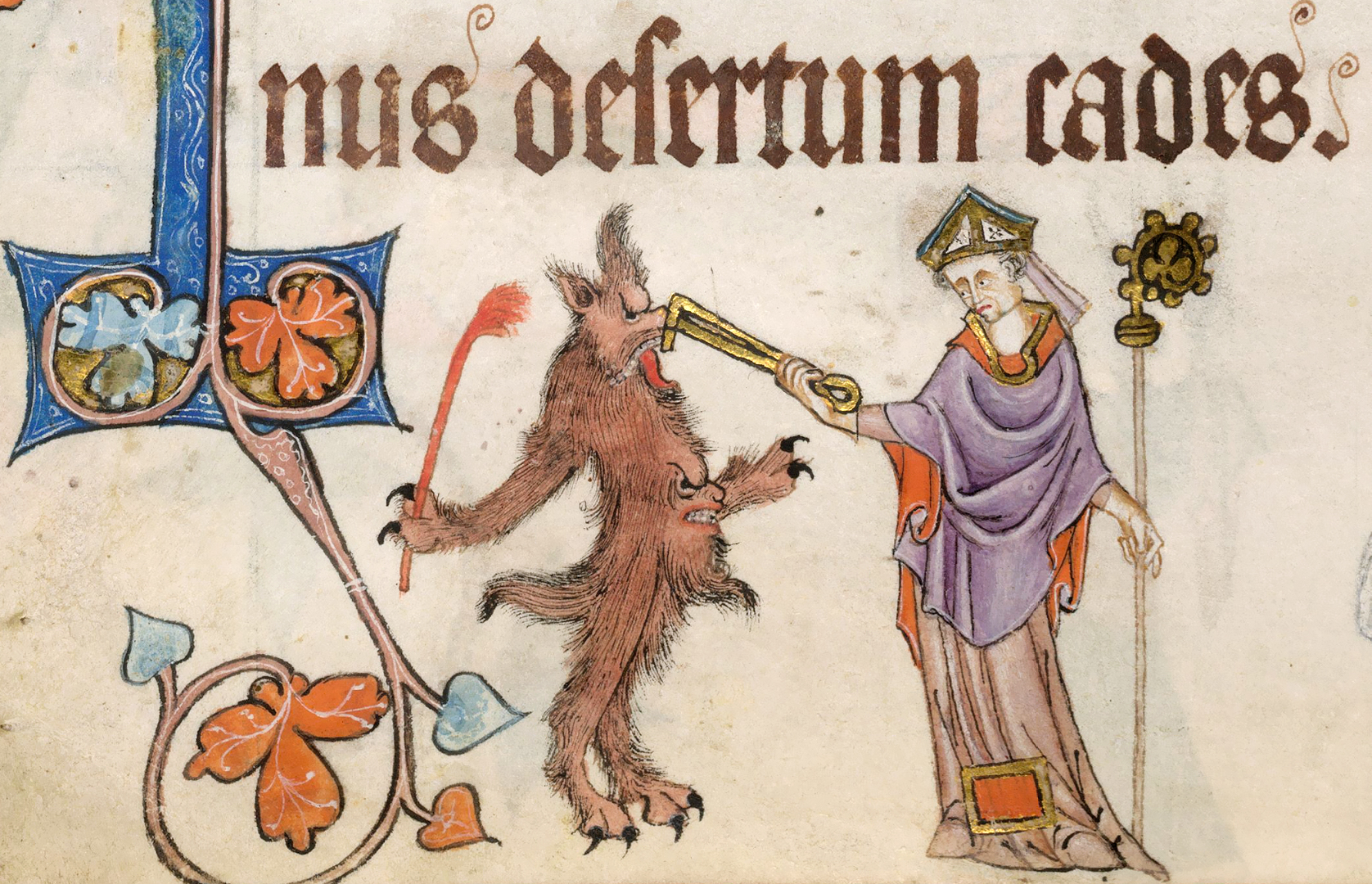
We then explore folk customs associated with St. Clement, the first-century bishop of Rome whose particular style of martyrdom led to his being embraced as patron of blacksmiths. A variety of celebrations by ironworkers on St. Clement’s Day (November 23) are discussed; we hear a snippet of a song associated with “clementing” (going door to door to collect donations for the “Old Clem Feast,”) and hear a tale told at these feasts explaining how the blacksmith was declared “King of All Trades” by King Alfred. There’s also a bit about a pyrotechnic festivity known as “anvil firing” associated with these celebrations and a snippet of the traditional blacksmith-toasting song, “Twanky Dillo,” sung by the Wild Colonial Boys.
Moving further back into Anglo-Saxon history, we encounter the figure of Wayland the Smith, one who appears briefly as a swordsmith and armorer in Beowulf and other English narratives but whose story is most thoroughly presented in the Lay of Völund part of the Poetic Edda (“Wayland” being an adaptation of the Old Norse name “Völund.”) We hear a brief summary of this tale, including the particularly gruesome revenge taken by the smith upon the king who takes him captive.
We also hear a bit about Wayland’s Smithy in Oxfordshire, a Neolithic long barrow or stone-chamber tomb supposedly occupied by a ghostly blacksmith.
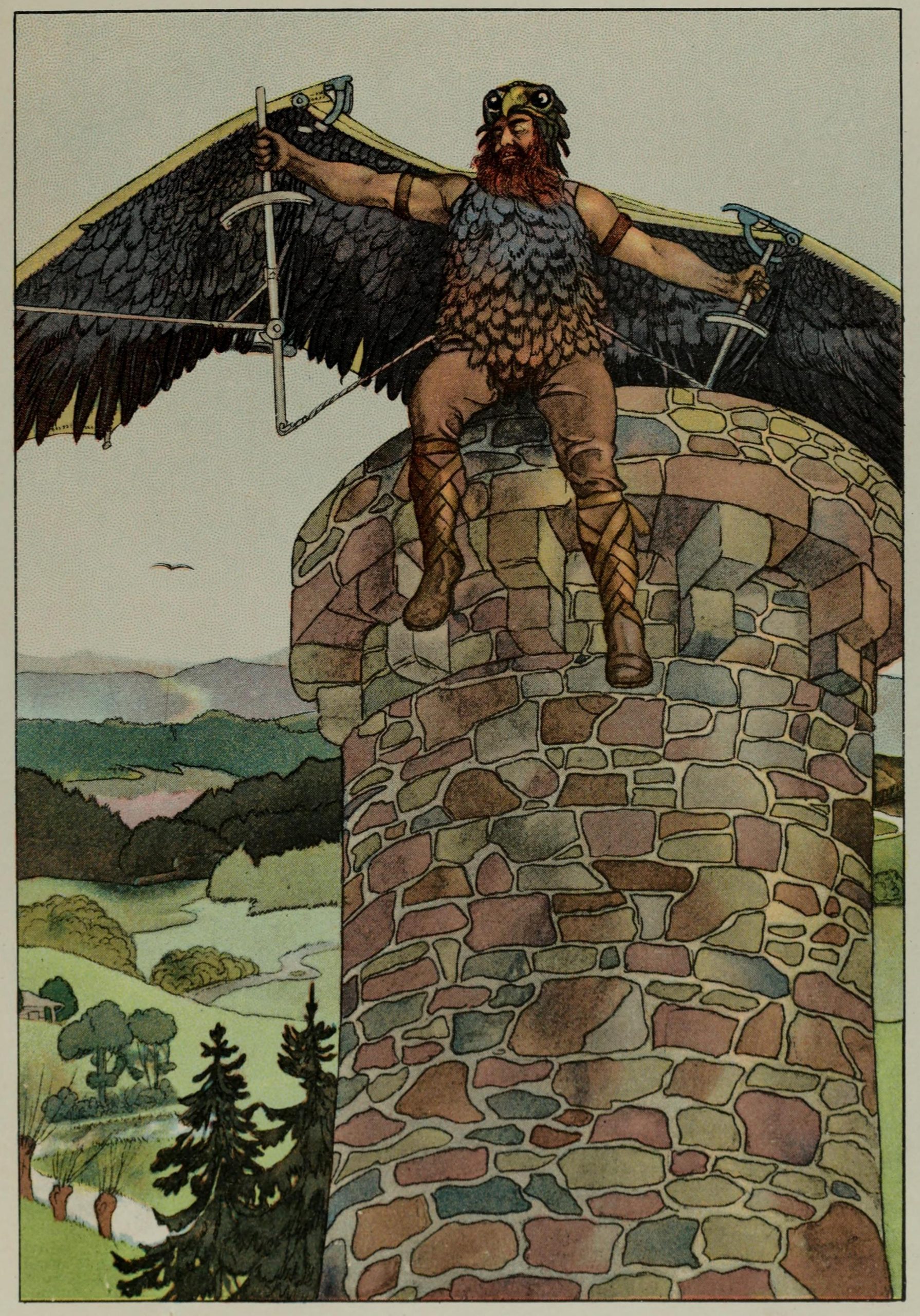
We then have a look at the smith god of classical mythology, Vulcan (Roman) or Hephaestus (Greek), his physical traits and fantastic creations, which extend beyond simple smithing into the realm of magic and even the creation of the first human female, Pandora.
Another metalworker associated with mankind’s origins is Tubal-Cain, described in the book of Genesis as the first “forger of all instruments of bronze and iron.”
As a descendent of Cain (who commits mankind’s first murder) and a creator of weapons enabling more deaths, Tubal-Cain’s folkloric reputation tends to be rather black. The apocryphal book of Enoch, presents a truly Luciferian blacksmith seemingly based on Tubal-Cain, the fallen angel Azazel, who utterly corrupts mankind before the flood of Noah.
This flood narrative also figures into the mythology of Freemasonry and the role assigned the figure of Tubal-Cain in its rituals. (I give away a few masonic secrets in this segment and can only hope I will not pay for this with my life.)
Also discussed is the Masonic-inspired Society of the Horseman’s Word whose members were said to exercise supernatural control over horses in rural areas of Scotland and England in the 19th century. The order’s mythological founder was understood to be either Cain or Tubal-Cain, depending on the region.
A blacksmith and son of one of these Horsemen was Robert Cochrane, who in 1966, founded The Clan of Tubal Cain, a coven and spiritual path intended to rival the Gardnerian witchcraft largely defining the neopagan world of the 1960s. We end the show with a particularly strange and tragic tale associated with this group.
A Christmas Ghost Story IV
In keeping with the old tradition of whiling away the nights of Christmas telling ghost stories, we bring you a tale published in 1912 by E.F. Benson. Read by Mrs. Karswell, complete with sound FX and music as always.
If you’d like some additional listening of this type, we have three more recorded in previous years going back to 2018: Christmas Ghost Story III, Christmas Ghost Story II, and Christmas Ghost Story I.
America and the Old, Dark Christmas
In earlier centuries, Americans partook in many of the same dark Christmas traditions that gave birth to Europe’s Krampus. This episode examines our untamed holiday history.
The most obvious example of this is the character of Belsnickel, (sometimes: Pelznickel, Belschnickle, Bells Nickel, etc.), who, like the Krampus, usually appeared on St. Nicholas Day, carrying a whip with which to threaten or strike naughty children. He was found particularly in German-settled areas of eastern Pennsylvania, but also in Appalachian West Virginia, Maryland, North Carolina, and Southern Indiana.
Belsnickel’s costume could vary widely depending upon what was available to the performer, but usually involved a long coat, hat, and almost always false whiskers — all chosen primarily to cover the actor and make him difficult to recognize. For that same reason, his face would also often blackened with soot or covered by any sort of mask available.
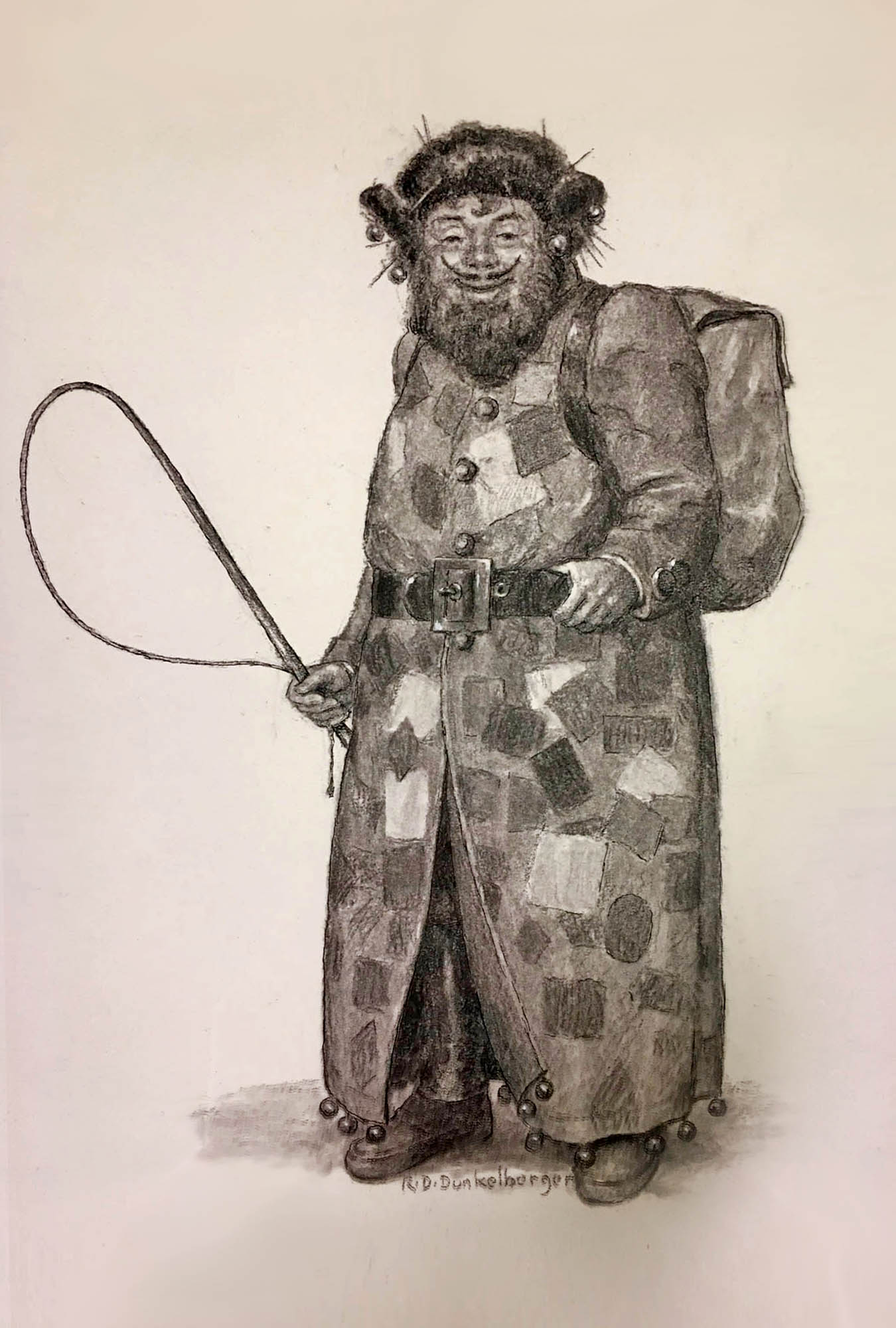
Belsnickel often wore a fur coat or hat, a coat trimmed with fur, or a fur-lined coat turned inside out (to create a weird effect and make the garment less recognizable). The choice of fur probably had less to do with some essential attribute of the character and more to do with the season itself. Nonetheless, the name “Belsnickel,” which is a derivation of the German “Pelznickel,” has often been incorrectly interpreted as “Fur Nicholas.” In fact, the “Pelz” here derives from pelzen, meaning, “to beat.” Pelznickel (and Belsnickel) carried in his pocket or bag, small treats, which he would scatter over the ground. Naughty children trying to grab these would feel his whip.
Like Germany’s Knecht Ruprecht or the Krampus of Alpine Austria and Bavaria, the whip was the Belsnickel’s essential attribute. In fact, in the 1800s, Pelznickel/Belsnickel would probably not have been that different in appearance from the Krampus as the modern image we have of that creature was only standardized as such with advent of Krampus postcards and their imagery dreamed up by city-dwelling artists, along with growth of a competitive community of mask-carvers in the early 20th century.
The popularity of the Belsnickel tradition soon saw it spill over from its original December 5-6 celebration to all the days leading up to Christmas and later New Year. As the tradition grew in popularity, Belsnickel was no longer represented as a solitary character but by groups of Belsnickels, whose behavior became increasingly rowdy and unwelcome. Rather than giving gifts or treats, these groups tended to ask for handouts from homes and businesses visited. Mrs. Karswell reads for us a number of American newspaper accounts documenting this trend.
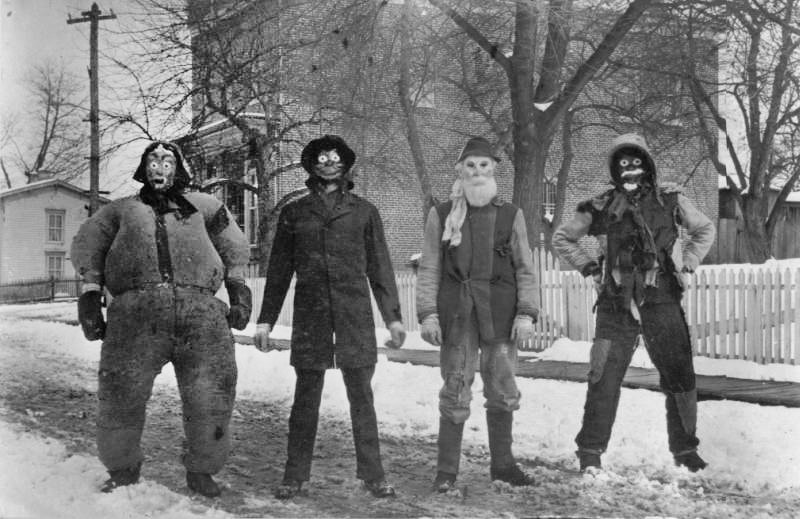
We also take a side-trip to South America, where the figure of Pelznickel arrived with German immigrants in the town of Guabiruba. Brazil. Unlike North America, where the Belsnickel had largely died out by the 1940s, Pelznickel events sponsored by the Sociedade dos Pelznickel continue to thrive – but with an interesting twist. There, the Pelznickel wanders about outfitted in moss and other tropical vegetation, accessorized with Krampus-like mask and horns.

The Belsnickel gangs were not the only groups of costumed youth carousing or begging on American streets during the holiday. Some of the earliest reports of this sort of thing come from Boston, where they were known as “Anticks” or “Fantasticals,” a name also used elsewhere. In Philadelphia, they might be called”Belsnickels” or simply “clowns” or “shooters” (thanks to the fact that these groups tended to carry noisemakers, including guns). In New York, these bands of noisemakers, often equipped with actual musical instruments played discordantly, were known as Callithumpians, or Callithumpian bands.
In Philadelphia, the rowdy costumed traditions of immigrants from Great Britain and Scandinavian melded with those of the Germans and were eventually domesticated by civil authorities into a more manageable form, the annual Mummers’ Parade.
In New York, no such solution was found, and Mrs. Karswell reads for us dramatic newspaper account from 1828 describing holiday chaos in that city.
Eventually a remedy to New York’s seasonal turmoil was suggested by John Pintard, founder of the New York Historical Society, whose love for the traditions of “Old Amsterdam” suggested Holland’s patron Saint Nicholas as a distraction from the street carousing. His re-creation of pious domestic rituals involving the saint would eventually displace holiday activity from the street to the home, and refocus festivities from rowdy unmarried men to children rewarded for good behavior. Some peculiar twists and turns along the way are described.
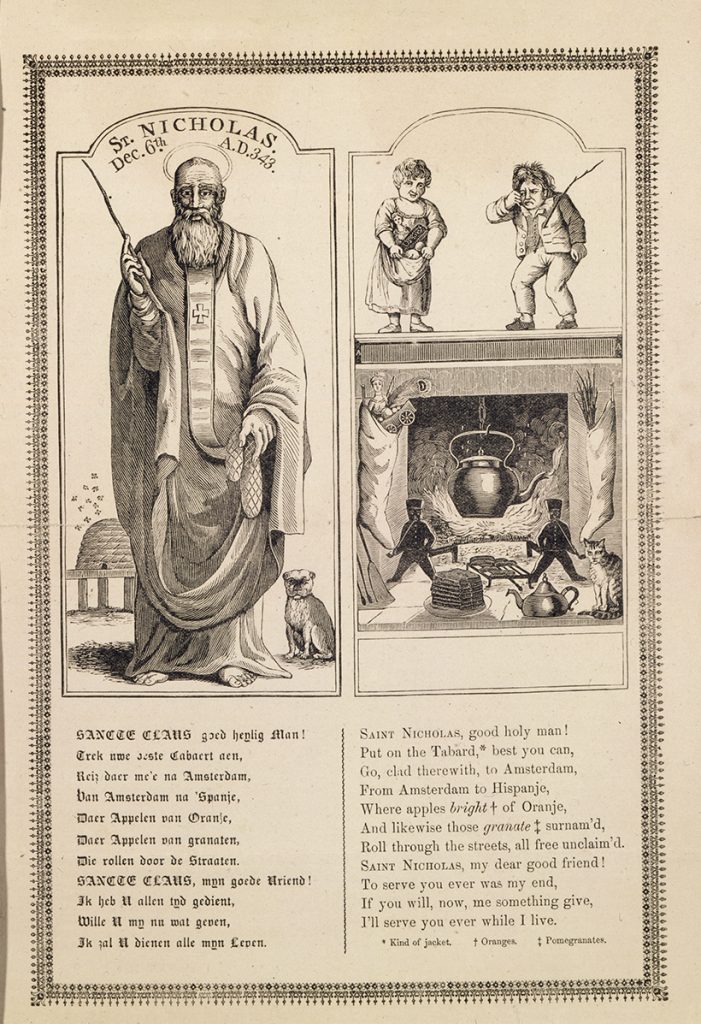
NOTE: This episode consists of material originally written for the book The Krampus and the Old, Dark Christmas, but excised due to page-count. Mr. Ridenour’s book, it should be noted, happens to make an outstanding gift for the holidays.

Transylvanian Vampires
Transylvania’s vampire lore inspired the setting of Bram Stoker’s Dracula, if not the character of the Count, and encompasses not only undead monsters, but living beings akin to witches. (The show is introduced with an audio snippet from Maria Tănase, premiere interpreter of Romanian folk song.)
Mrs. Karswell begins the show, reading a passage Stoker wrote for Jonathan’s Harker’s Transylvania travel journal kand its source in an 1855 essay by Emily Gerard, “Transylvania Superstitions.” Originally from Scotland, Gerard developing an interest in the local folklore while living abroad and expand her essay in the 1888 book, The Land Beyond the Forest. She seems to have derived a fair amount of her vampire lore from a German scholar, Wilhelm von Schmidt, who in 1865 article contributed an article on the subject to the Austrian Review.
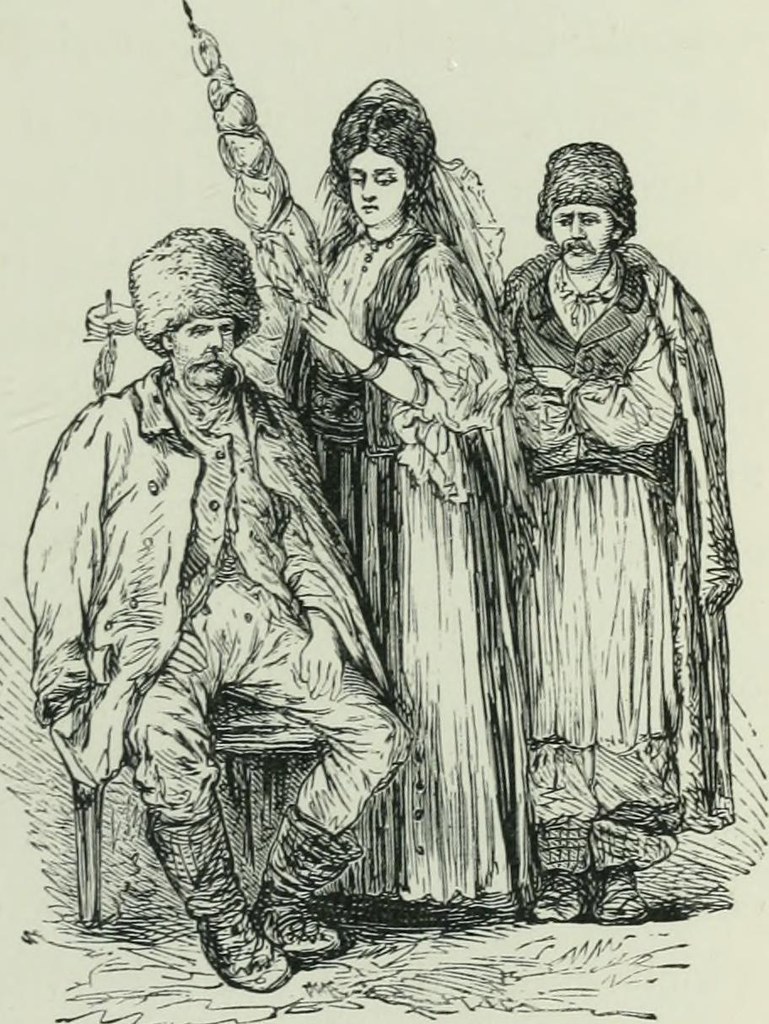
While much of Gerard and von Schmidt’s information seems well sourced, the nomenclature used for vampires is incorrect. The word “nosferatu” put forward by the two folklorists and repeated by Stoker in his novel as the common Transylvanian word for “vampire” is not actually a Romanian word — but we sort out the confusion.
In Romanian, there are two words for vampiric beings, which Gerard subsumed under “nosferatu.” They are moroi and strigoi (male forms, plural moroii, strigoii). Strigoi seems to be a more expansive category and is discussed more in the folklore, but both share many traits including behaviors, preventatives, and modes of destruction. Moroii and strigoii tend to blur together along with two other entities, vârcolaci, and pricolici, which might be closer to our concept of the werewolf (something for a later show).
Before diving into the details on these creatures, I provide a note on two sources used for the episode, chose as they seem better grounded than Gerard’s in Romanian language and culture. The first is by Agnes Murgoci, a British zoologist, whose marriage brought her to Romania and into contact with Tudor Pamfile, a well known native-born folklorist, whose tales of vampires Murgoci translates in the source article: “The Vampire in Roumania,” published in the journal Folklore in 1926. The other source is a Romanian language book from 1907: Folk Medicine, by Gr. Grigoriu-Rigo, in which I found a large and unexpected trove of regional vampire lore.
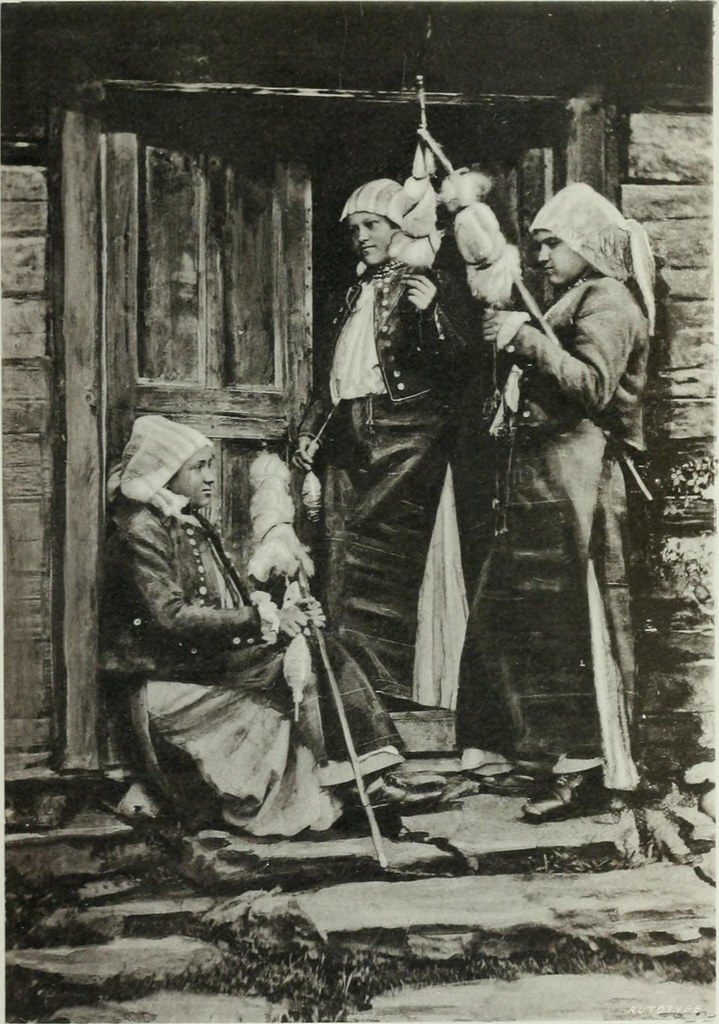
While living an evil life makes one more likely to become a strigoi or moroi, through no fault of their own, an individual who does not receive proper burial rites, will live on to destroy those who failed to fulfill their funereal duties — namely, his family and relations. We have a look at some of the old burial custom, which includes and audio snippet of bocet, a form of traditional lamentation offered at funerals.
We then dig into the moroi and traits its shares with the strigoi: the tendency to attack family members, similar preventatives and modes of destruction as well as shared methods detection of thevampire in its grave.
The strigoi in some ways is closer to the pop-culture vampire — unlike the moroi, it’s sometime explicitly said to drink blood, and garlic is a primary prophylactic. Alongside its practice of destroying loved ones, we hear of some peculiar incidents in which the strigoi also engages with its family in more neutral or even helpful (if unwanted) ways.
We then have a look at living strigoii, that is, strigoii fated to become undead after burial but in life exhibiting supernatural abilities and evil inclinations. In many cases, these beings bear comparisons to witches. Possessing the evil eye and the ability to leave the sleeping body in another form (usually a small animal) are examples of this.
Some methods of preventing a living strigoi from rising from its grave are discussed as well as means of destroying these creatures. Techniques employed against the moroi, while simlar occasionally include additional techniques, such as application of tar or quicklime to the body. Priests’ blessings and spells by benevolent wise women can also be employed (and we hear an audio example of the latter).
The remainder of our show consists of vampire folk tales collected by Tudor Pamfile as provided via Murgoci’s translations. The first pair of stories illustrate the resemblance between living strigoii and witches. These are followed by tales of male strigoii pursuing women vaguely prefiguring the pop-culture vampire Stoker birthed.
Customs of November 29, the “Night of the Strigoi” in Romania, are then described along with its folkloric significance and relationship to St. Andrew, followed by a clip from the 2009 British comedy, Strigoi.
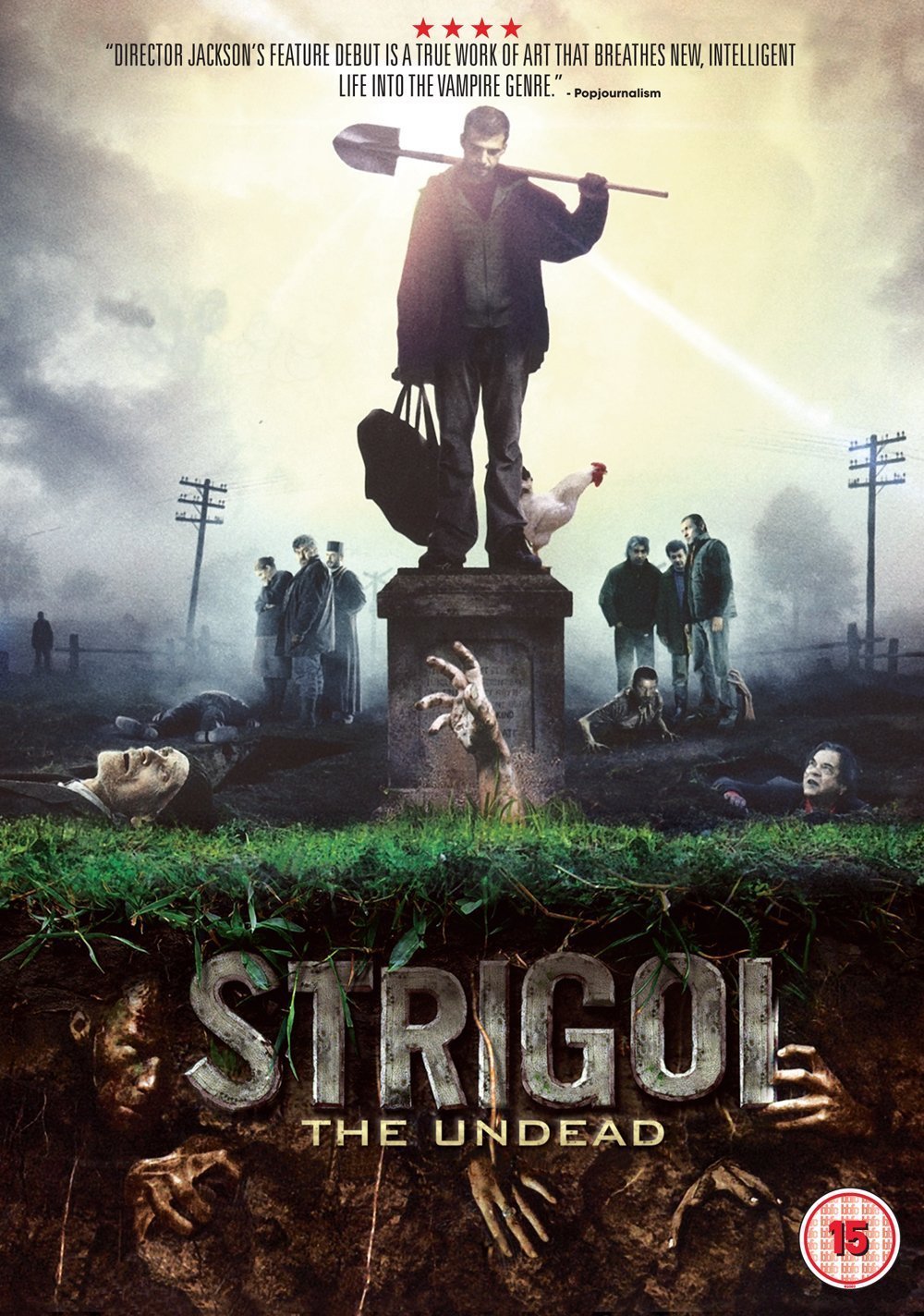
,
Horror Hosts, Part Two
A break from the usual themes for the Halloween season: the second part of our survey of 40 years of Horror hosts, this time the hosts of the 1960s and a couple years of the ’70s.
Included in this installment: Morgus the Magnificent, Sammy Terry, Chilly Billy Cardille, Ghoulardi, The Vegas Vampire, The Cool Ghoul, Svengoolie, and Sir Cecil Creape.
Also: Psychic Bee fortune-telling with Mrs. Karswell
Horror Hosts, Part One
Something a little different for the Halloween season: horror hosts and their evolution in the early years. We’ll be doing a second episode (out before Halloween) rounding out our survey to include the horror hosts of the 1960s.
Included in this installment: Vampira, John Zacherle, Gorgon, Marvin the Nearsighted Madman, Tarantula Ghoul, The Old Witch, Raymond, The Mysterious Traveler, The Strange Dr. Weird, and more.
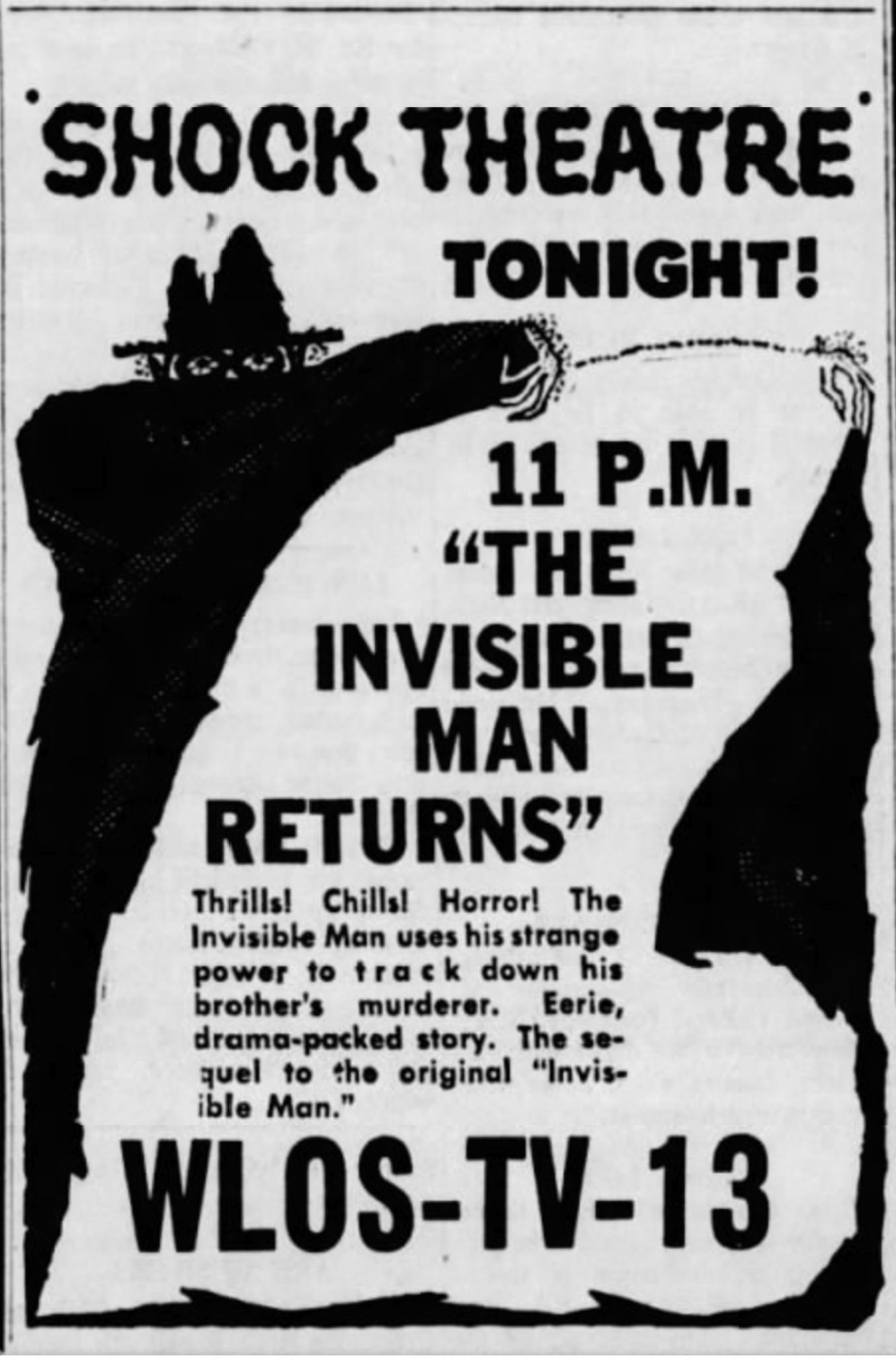
Ghost Trains & Railway Terrors
Ghost trains and real-life railway terrors intermingle in this episode’s exploration of old train-wreck ballads, nervous and funereally obsessed Victorians, urban legends involving train deaths, and more.
Mrs. Karswell begins our show reading an imaginitive description of a phantom train written by George A. Sala for an 1855 edition of the magazine, Household Words, published by Charles Dickens (whose railroad connections we’ll be discussing).
Next we hear a bit of Vernon Dahhart’s 1927 ballad, “The Wreck of the Royal Palm,” describing an accident that had happened near Rockmart, Georgia the previous year. Other folk songs including gruesome railroad deaths are then explored. These include “In the Pines,” “The Wreck of the Old ‘97,” and “Wreck on the C&O,” including snippets from versions recorded by Lead Belly, Vernon Dalhart, and Ernest Stoneman respectively (with a reiteration of a line from “C&O,” by The Kossoy Sisters.) ** FOR MUSIC DETAILS SEE BELOW.
We next hear a bit about an obsession with dangerous trains expressing itself on London’s stages in theater productions of the mid-to-late 1800s. One manifestation was the “sensation dramas” of the day, which presented trains and train wrecks on stage via highly developed stagecraft. Another trend involving characters imperiled on railroad tracks was launched by the 1867 play, Under the Gaslight. The 1923 play Ghost Train is also discussed.
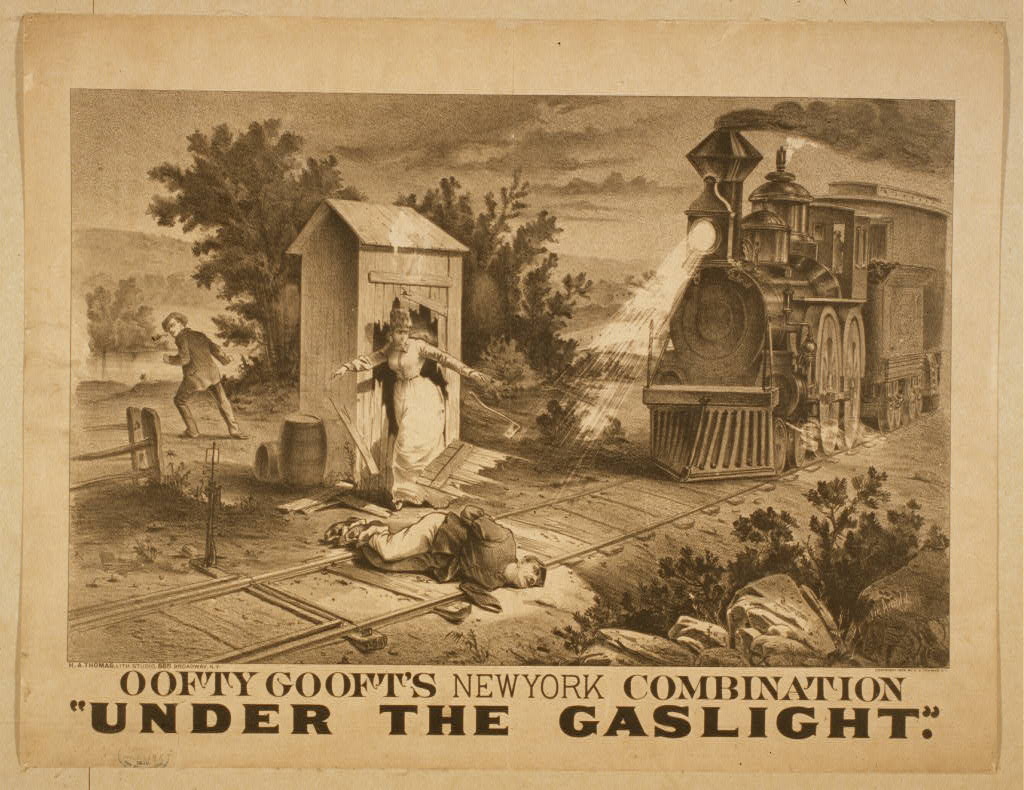 Our attention turns back to Charles Dickens as we hear a vivid passage describing the death of the nemesis of his novel Dombey and Son, published as a serial between 1846 and 1848; it is literature’s first death by train. Mention is also made of his classic ghost story, “The Signalman” from 1865.
Our attention turns back to Charles Dickens as we hear a vivid passage describing the death of the nemesis of his novel Dombey and Son, published as a serial between 1846 and 1848; it is literature’s first death by train. Mention is also made of his classic ghost story, “The Signalman” from 1865.
Dickens’ ambivalent, and somewhat fearful, attitude toward the railroads seems to be rooted in the railways’ effect on the traditional patterns of life in Britain’s towns and villages, but also has roots in personal experience, namely as a passenger in the 1865 Staplehurst Disaster. A train wreck that not only affected his literary themes, but his personal wellbeing for years to come.
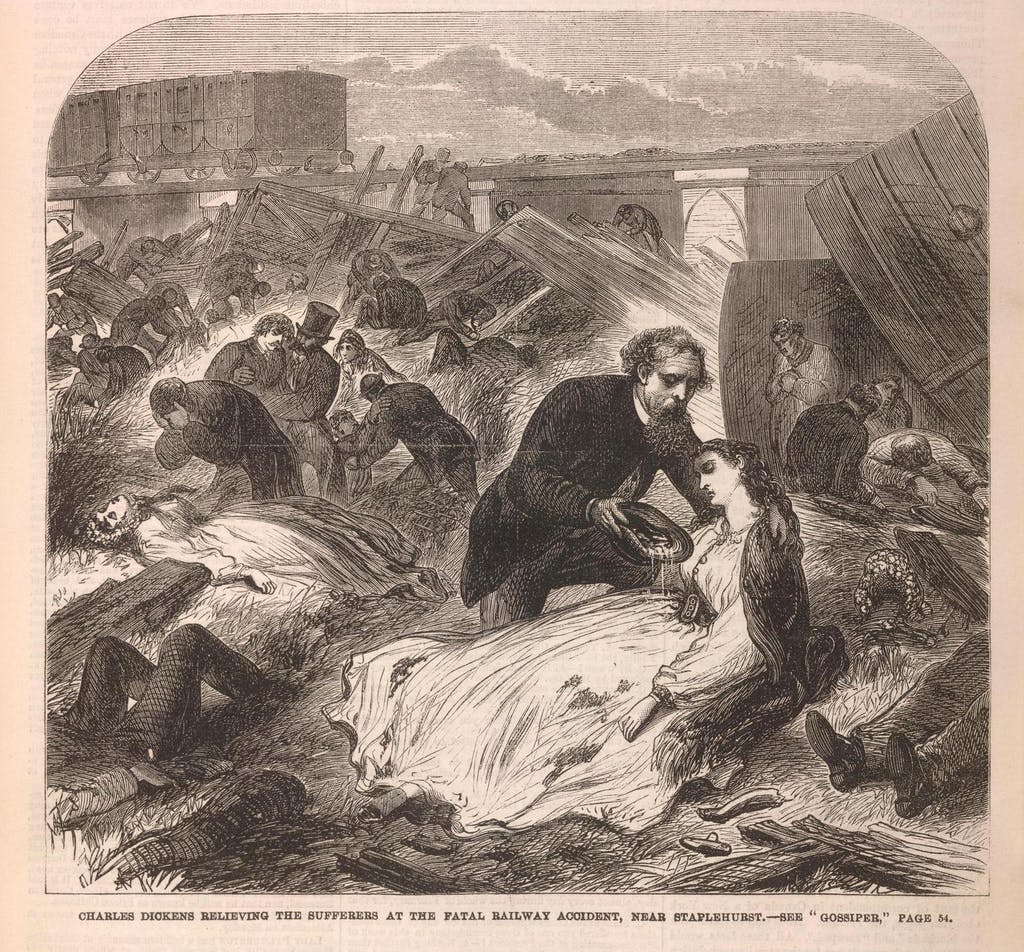
We then switch gears to examine a few localized legends from American involving trains. The first is the Maco Ghost Light encountered near the tiny North Carolina town of Maco Station and said to represent the lantern of an undead (and decapitated) railway worker. We also look at a legend from Texas, that of the San Antonia Ghost Tracks, in which aa alleged accident involving a school bus and train spawned reports of supernatural occurrences.
Another North Carolina legend examined involves an 1891 train accident on Bostian Bridge near the town of Statesville. The ghost stories associated with the site recount appearances of the the doomed train on the anniversary of its accident. The first of these is said to have happened on the 50th anniversary in 1941, but an even more terrifying encounter from 2010, on the 119th anniversary, is also discussed.
Beginning in 1872, seven years after Abraham Lincoln’s death in 1865, supernatural tales stories began to be told of the train that carried the dead president’s body through 12 cities in which he lay in state. We hear just one of the stories published in The Albany Evening Times.
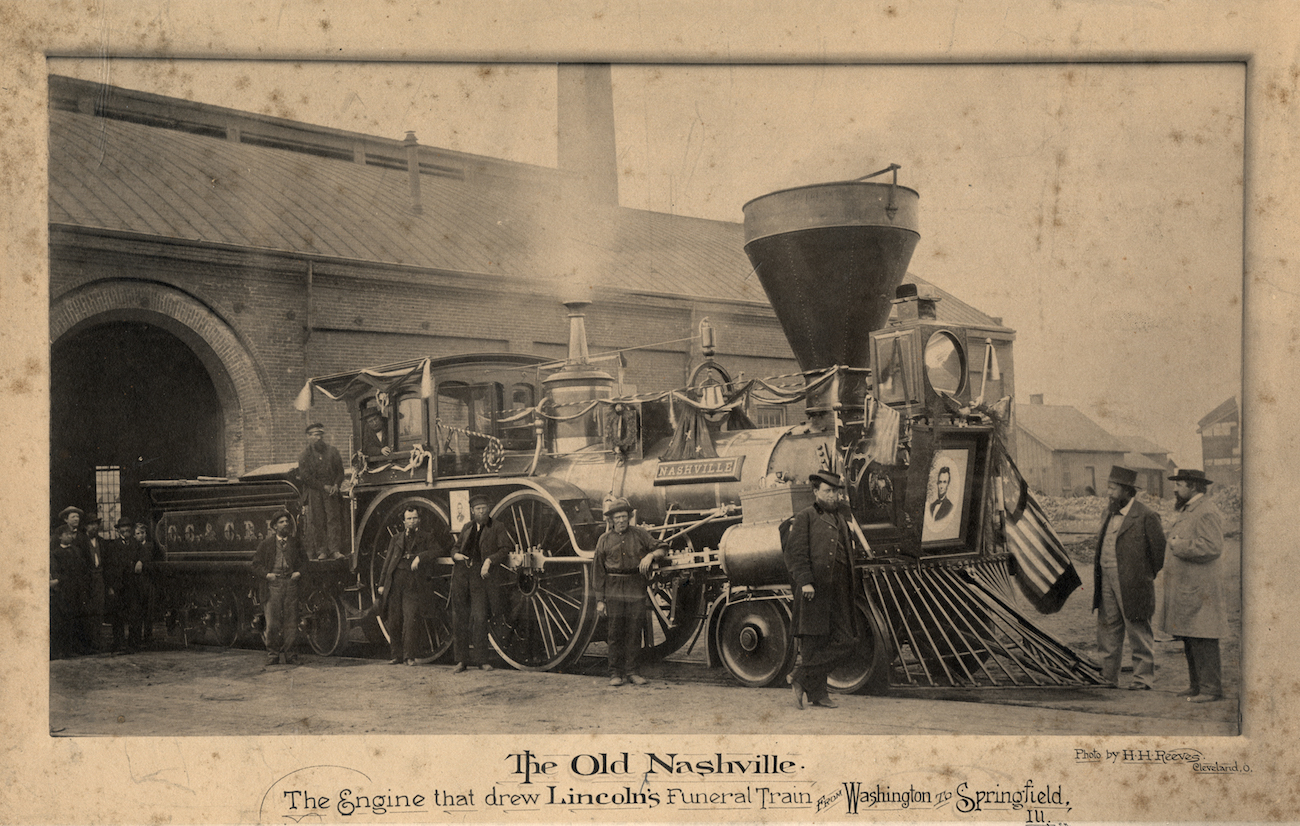 We then examine the musical phenomenon of songs that portray phantom trains as conveyances to the afterlife, in particular the gospel trope of Death as a Train that may arrive to unexpectedly whisk you off to the Great Beyond, thereby reminding listeners of the need to get right with God. An elaboration of this theme involves the Hell Train, driven by the Devil himself, one which takes those who refuse to make the afore-mentioned spiritual preparations. Included here are songs or song-sermons recorded by The Clinch Mountain Clan, The Carter Family, Rev. J. M. Gates, Rev. H.R. Tomlin, Rev. A.W. Nix, Chuck Berry, and Gin Gillette.
We then examine the musical phenomenon of songs that portray phantom trains as conveyances to the afterlife, in particular the gospel trope of Death as a Train that may arrive to unexpectedly whisk you off to the Great Beyond, thereby reminding listeners of the need to get right with God. An elaboration of this theme involves the Hell Train, driven by the Devil himself, one which takes those who refuse to make the afore-mentioned spiritual preparations. Included here are songs or song-sermons recorded by The Clinch Mountain Clan, The Carter Family, Rev. J. M. Gates, Rev. H.R. Tomlin, Rev. A.W. Nix, Chuck Berry, and Gin Gillette.
The episode ends with a look at the not terribly successful embalming of Abraham Lincoln prior to his his funeral tour, punctuated by a snippet from “In the Pines” AKA “The Longest Train” by Dead Men’s Hollow.
** NOTE: a streaming library of the numerous songs featured in this episode, along with some additional songs of similar themes, is available to those who join our Patreon as supporters before December 1.
Marvelous and Rare III
Duties in the library unfortunately prevent us from presenting a regular episode at this time, but to fill the gap, we’re offering listeners a taste of the short bonus “Marvelous & Rare” episodes all our $4-and-up Patreon subscribers hear every month (sort of antiquarian version of Ripley’s Believe It Or Not).
If you’d like to hear more in this format, another sample was released to regular listeners in September 2020 and there are around a dozen more available to those who join us on Patreon.
We’ll be back in October with a longer, traditional Bone and Sickle Episode (as well as a Halloween show).
Bird-Women of Greece and Russia
Bird-women hybrids of Greek legend and Russian folklore are uniquely ambivalent, sometimes bringing death and destruction and at others, prophetic wisdom and the joy of Paradise.
The two Greek species we treat are sirens and harpies, both at times described as having the bodies of birds and faces or upper bodies of human females.
Beginning with harpies — we hear a bit of audio from the 1963 film Jason and the Argonauts, which features a pair of stop-motion harpies created by Ray Harryhausen. While these are more batlike than birdlike, the animator’s tendency to conflate features is actually in line with various classical tales, which tend to disagree sometimes offering winged harpies, others not, and if birdlike, not necessarily featuring the heads of women. We hear some of these descriptions read by Mrs. Karswell.
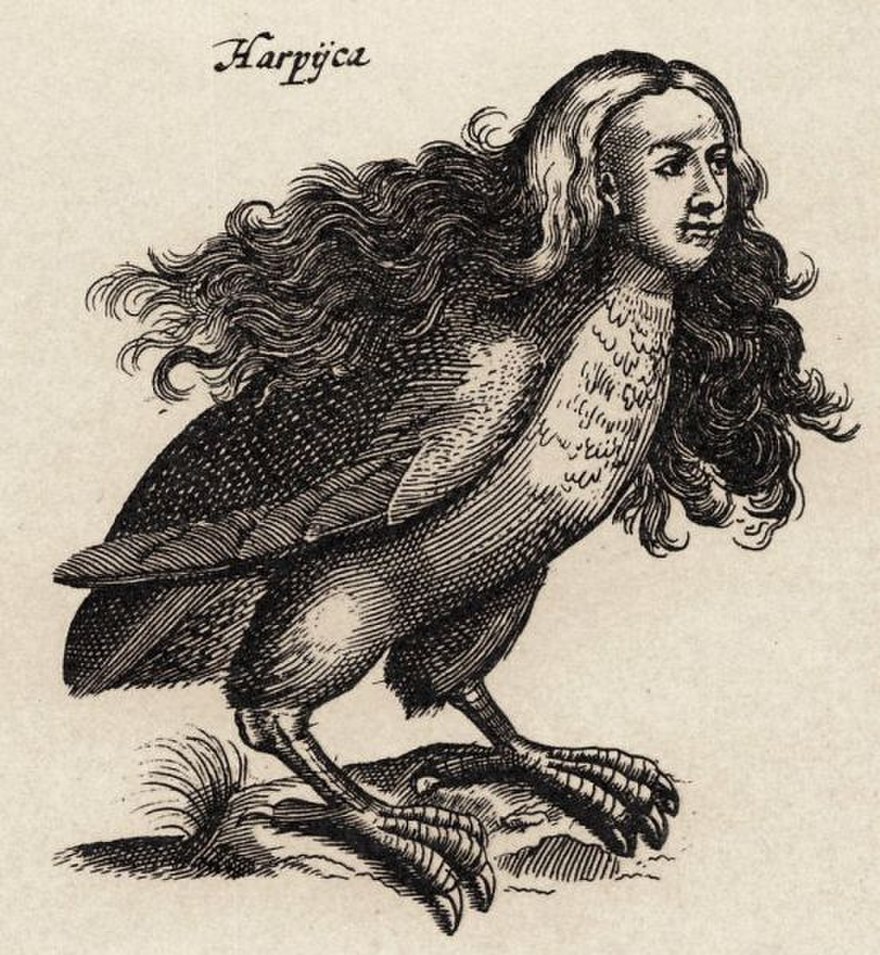
As for sirens, while today they are regarded as equivalent to mermaids, originally they were bird-human hybrids. Thanks to the siren’s connection to the sailors they would seduce, an intuitive shift from bird to fishlike portrayals seems natural, but did not occur until late antiquity or the early medieval period. It seems likely that once this transition occurred the harpy’s image consolidated around the birdlike form no longer associated with the siren. Unlike the creature’s form, the siren’s song, which drew sailors to wreck their ships upon the rocks, has always been a defining attribute of the creature.
There’s something of a disconnect between ancient siren and harpy narratives and the creatures’ representation in visual art, with some of their traits more fixed in the latter than the former. In particular, sirens and harpies, along with other hybrids such as the griffin and sphinx, first appear in Greek culture as decorative embellishments on household items. These monsters, as discussed, were borrowings from cultures of the East, with the human-headed Egyptian ba bird being a likely origin for our avian figures.
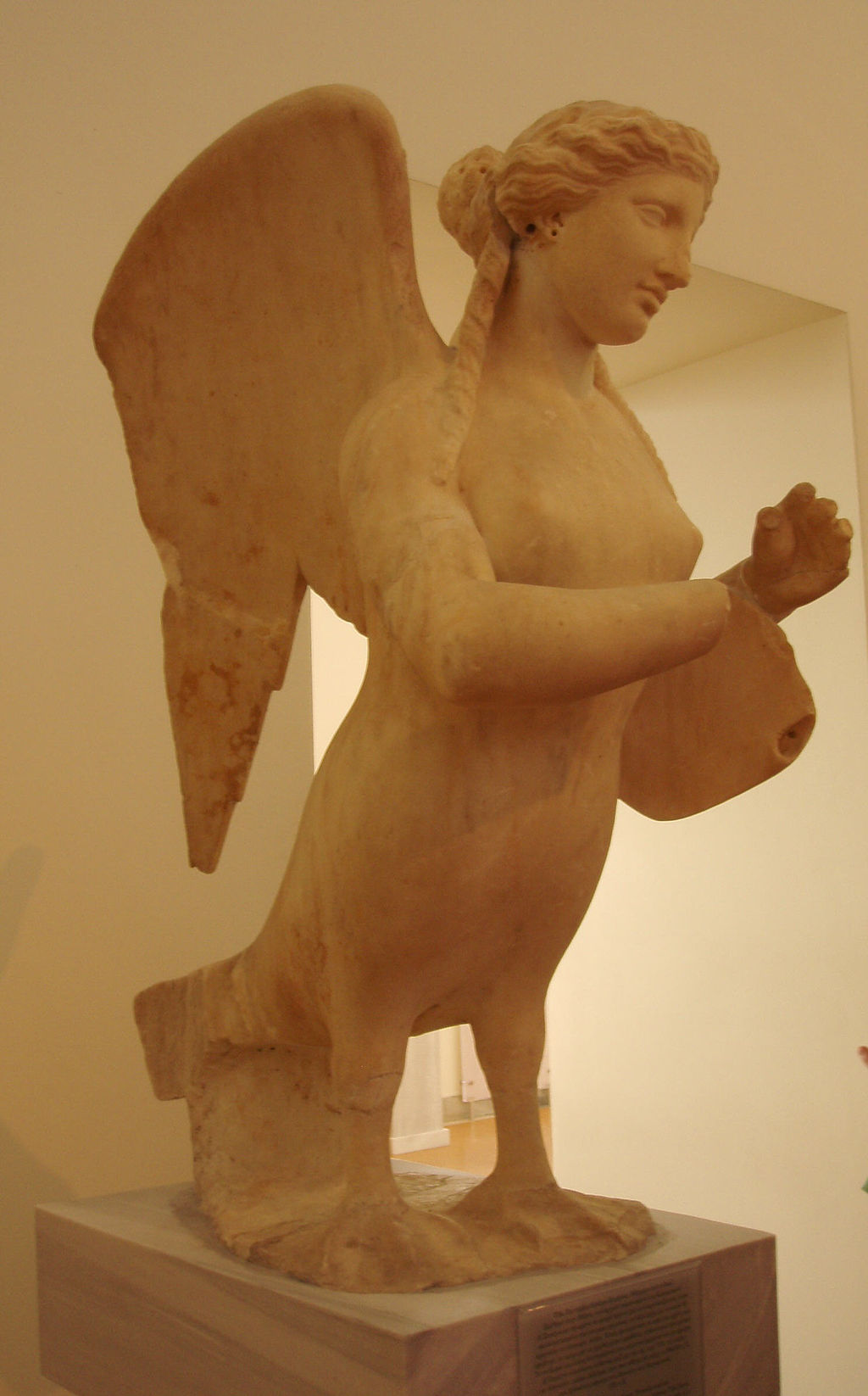
The behavior of these creatures is primarily known from two ancient texts. In the third century BC, the behavior of harpies was defined by Apollonius Rhodius’s in his epic The Argonautica, while the actions of sirens were codified in Homer’s Odyssey from the 8th century BC.
The episode from the Argonautica involves the harpies suddenly descending from the sky to torment a the prophet Phineus, repeatedly sent by Zeus to snatch away his food.
Better known is Homer’s episode describing Odysseus tied to the mast listening to the siren song as his crew sails near, their ears providently plugged with wax. What’s not as often remembered, however, is the nature of the siren’s song, which promises not sexual reward, but omniscience.
The sirens’ offer to share the knowledge of the gods, and the danger inherent in hearing their song finds a precise parallel in narratives about the Russian bird-women we discuss, namely the Alkonost, Sirin, and Gamayun, all of which are said to reside in Paradise, or the realm of the dead. They are portrayed like the harpies and sirens as having the bodies of birds and human heads or heads and breasts but with the addition of crowns or halos.
The Alkonost and Sirin are said to be sisters, inevitably appearing as a complimentary pair in art and folk-tales, with the Alkonost presiding over the daylight hours, and the Sirin the night, the Alkonost bringing joy, the Sirin sorrow, etc. While the Alkonost is generally made the more positive symbol, both birds, through their song, can produce dangerous results. The song of the Alkonost shares a knowledge or experience of the divine that can induce ecstatic madness or a deathlike trance state. The same could be said for the Sirin, though in some instances it’s said to more literally said to abduct mortals into the afterlife.
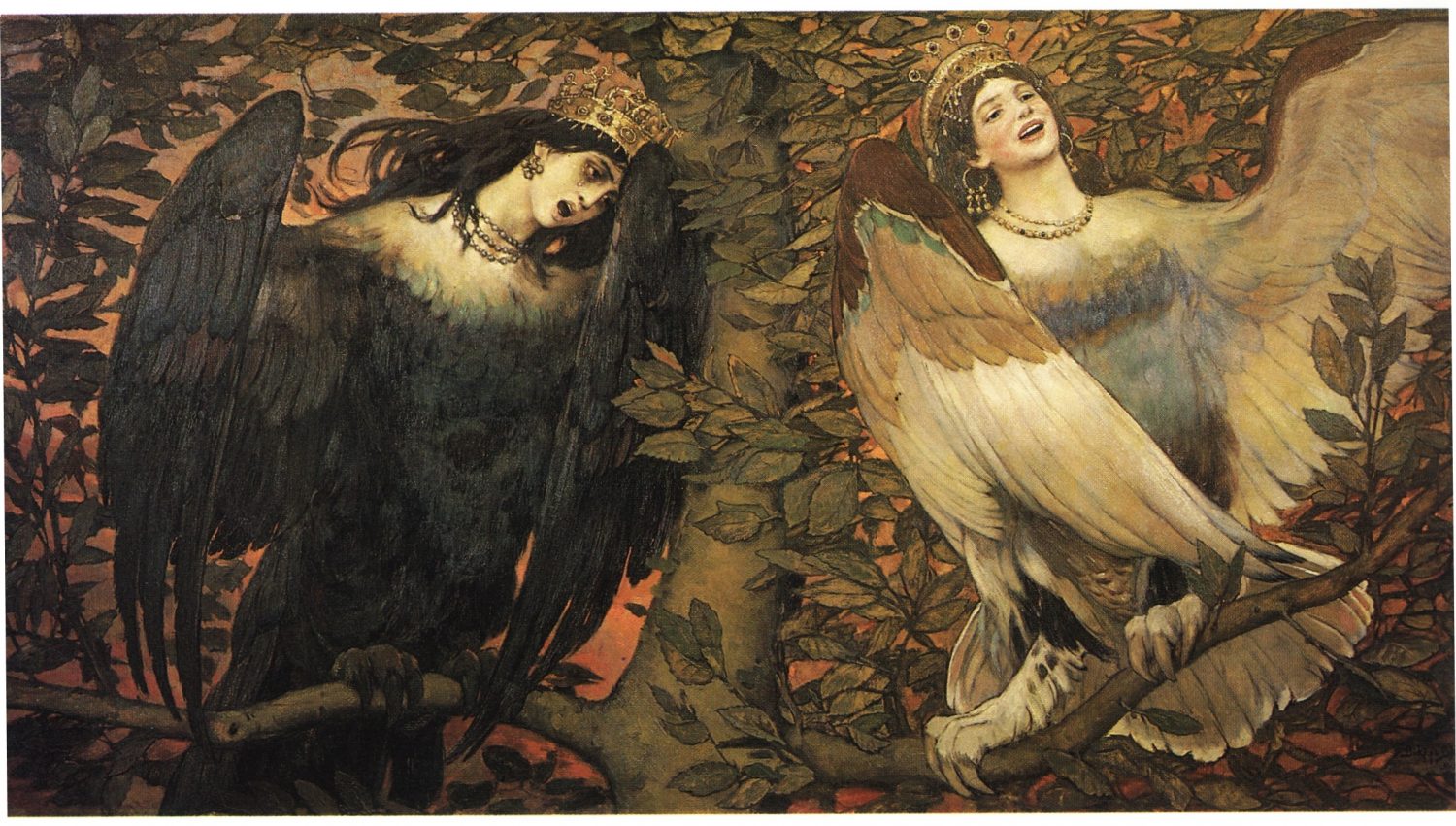
While the Sirin obviously derives its name from the Greek sirens, the Alkonost too has its origins in Greek mythology, specifically in the myth of the lovers Alcyone and Ceyx, the former lending her name (in Russian derivation) to the Alkonost.
For her effrontery of comparing their love to that of the gods, Alcyone (or sometimes both Alcyone and Ceyx) are transformed into birds, specifically kingfishers. As a bird, Alcyone was said by Roman writers to lay her eggs during a five-day period in the winter during which the winds are calmed — a source of our word, “halycon,” meaning a calm or happy interlude.
The Alkonost likewise is said to lay its eggs in the ocean during an interval during which the seas are calm, and is therefore associated with control over the weather. Superstitions found not only in Russia but further afield in Europe associate the kingfisher and dried kingfisher bodies used as charms to predict the weather.
The Sirin and Alkonost were also assimilated into Russia’s Christian culture, sometimes shown perched upon trees in Eden or as representations of the Holy Spirit. We hear of a particularly strange Russian tradition involving the bird-women called “Apple Savior,” involving the blessing of apples, Christ’s transfiguration in the Bible, and the singing of the Sirin and Alkonost, as well as a folktale involving the lovers Kostroma and Kupelo associated with the summer solstice and St. John’s Night.
The song of the Gamayun, like that of the Alkonost and Sirin, is a form of divine language though is less likely to be destructively overpowering and more associated with prophecy and happiness. For this reason, the creature, is also referred to as “The Bird of Happiness” or “The Bird of Prophecy.”
The Gamayun is also often said to have no legs as it is strictly a creature of the air or heavens and never lands. The source of this belief is actually related to a peculiar trade in preserved bird charms, as explained in detail.
The show winds down with some appearances of the Russian bird-women in 19th and 20th-century art, music, and film, including the 1897 opera Sadko by Rimsky-Korsakov, a musical treatment of a folkloric adventurer, merchant, and gusli-player from Novgorod. We hear a bit of the opera’s most famous aria often called “The Song of India” describing the exotic land where the Bird of Happiness may be found.
Our final segment is about Sadko, a 1952 cinematic adaptation of the opera by “the Soviet Walt Disney,” Aleksandr Ptushko, a film repackaged by Roger Corman in 1963 for American screenings as The Magic Voyage of Sinbad.
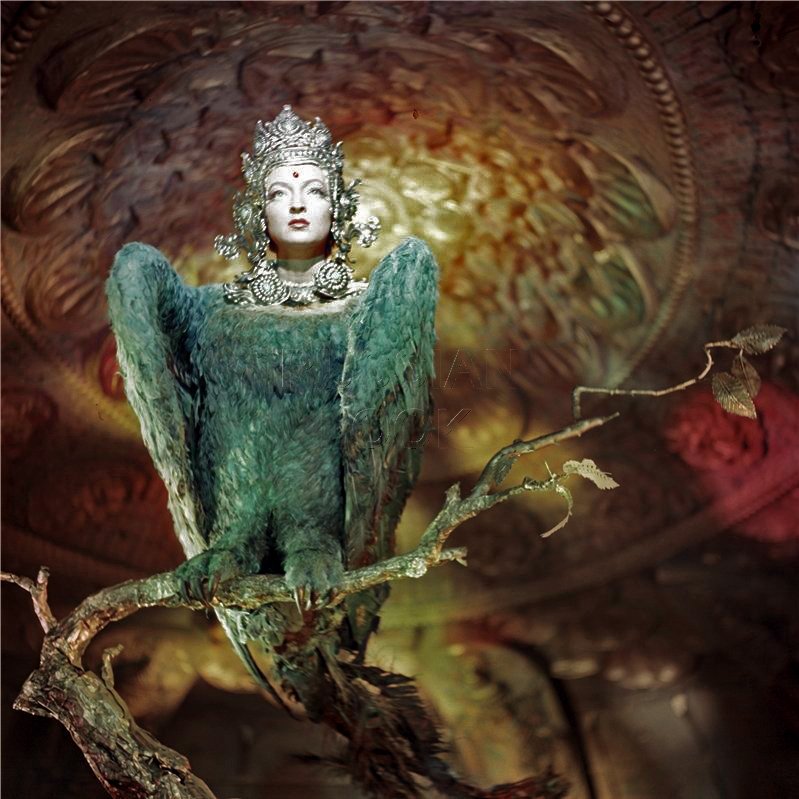
The Dybbuk
A dybbuk is a “clinging spirit” of Jewish folklore, a ghost that can possess a human host.
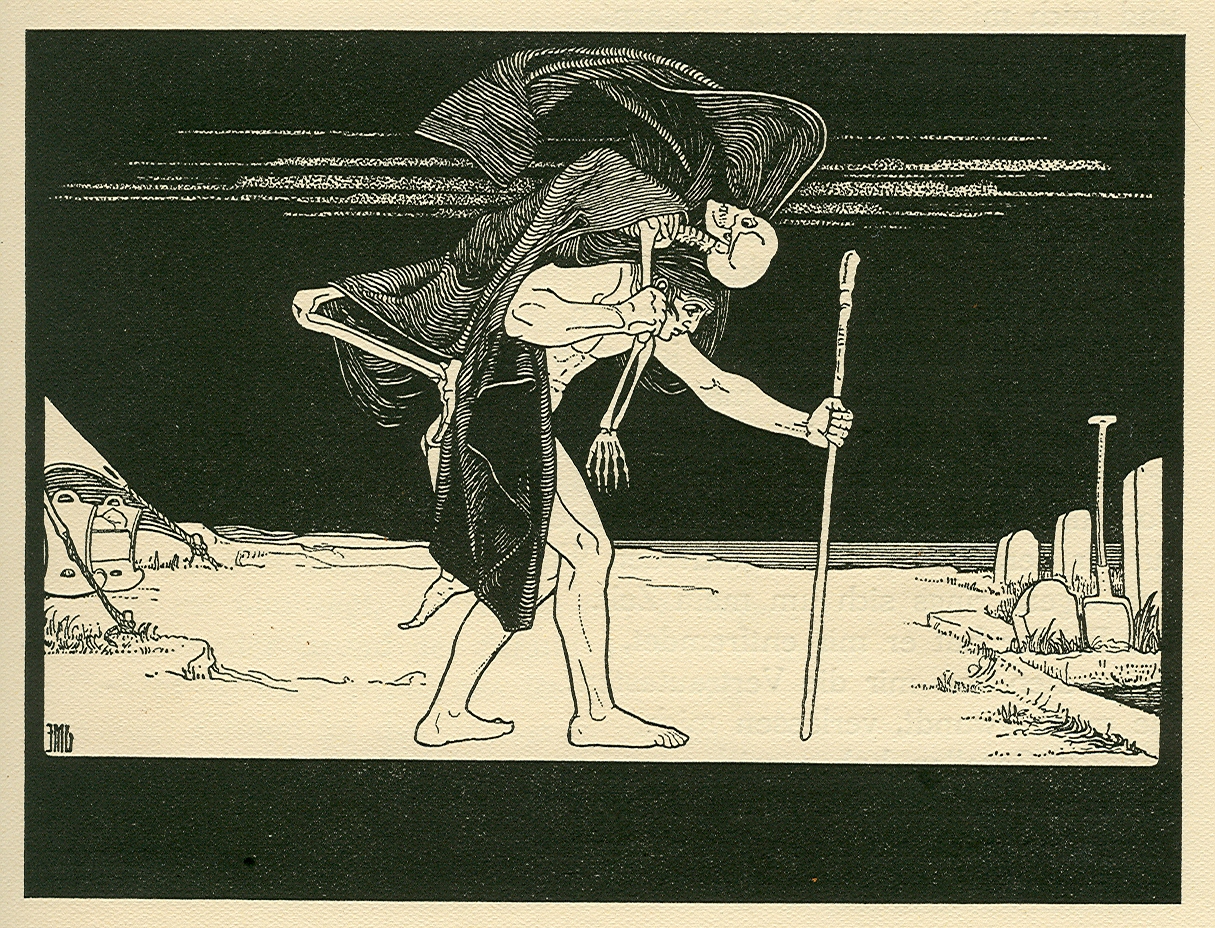
Stories of dybbuks (pl. dibbukim in Hebrew for sticklers) date to the 16th century but have never traditionally included the idea of trapping a dybbuk in a box, a trope that only dates to a 20o3 eBay ad placed by a Portland antique refinisher Kevin Mannis. Although Mannis would later confess to having made up his listing’s backstory as a sort of creative experiment, the box has continued to be the center of an evolving mythology advanced first by its 2003 buyer, Jason Haxton. In 2016, the box was purchased by Ghost Adventure‘s TV personality Zak Bagans, for display in his Haunted Museum in Las Vegas. We open the show with some clips from a July 2020 episode in which Bagans opens the box.
The dybbuk-in-a-box trope was also furthered by the “based on a true story” 2012 horror film, The Possession, for which Mannis and Haxton served as consultants. We hear a clip from that film as well as a clip from the ridiculous 2009 dybbuk-without-a-box film The Unborn. The 2015 Polish film (in English and Polish) Demon is also recommended as a more traditionally European take on the dybbuk folklore, thanks in part to its incorporation of a wedding motif.
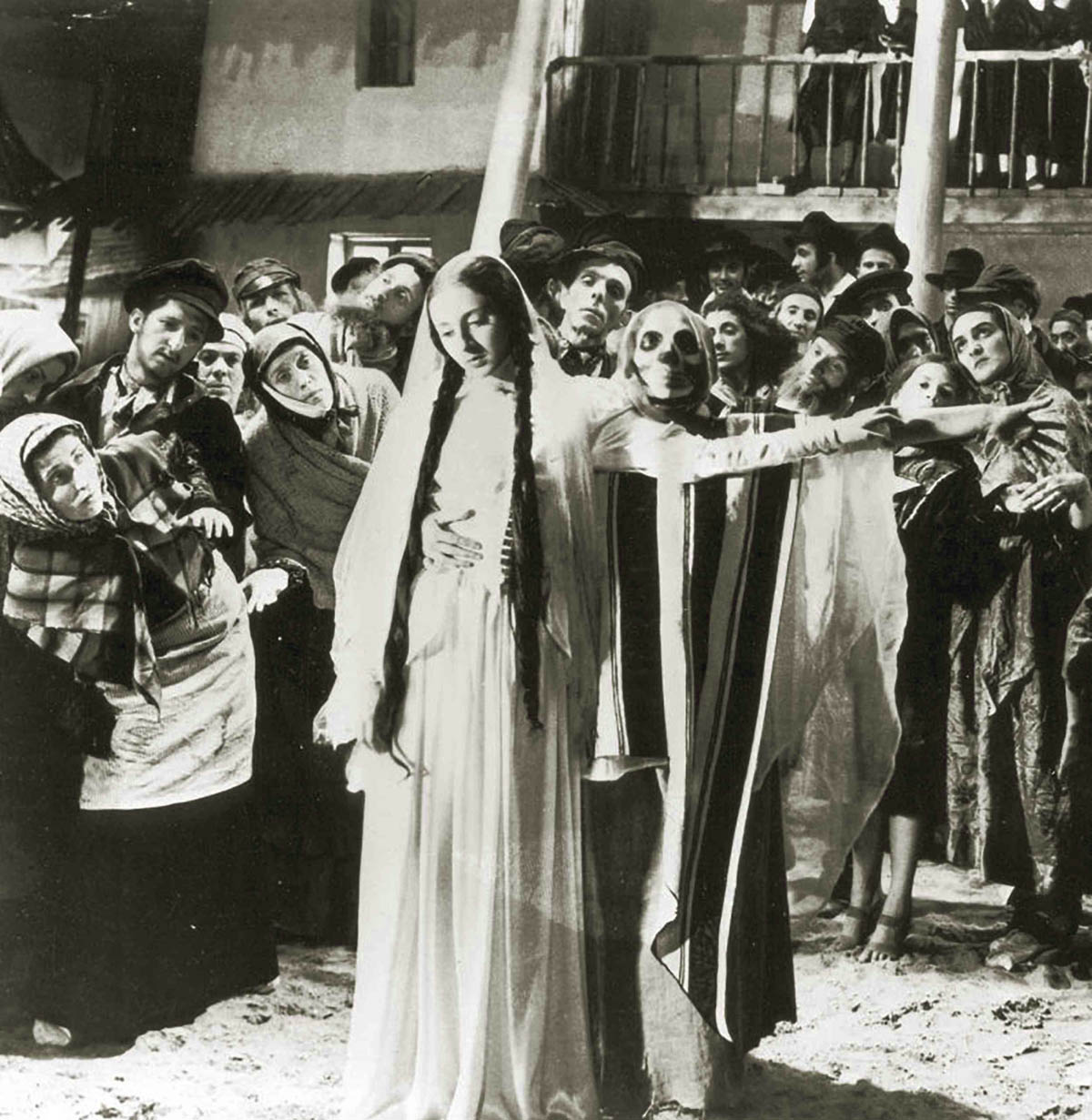
The idea of a dybbuk appearing at a wedding is borrowed from a classic 1937 film from Poland, The Dybbuk, a cinematic adaptation of Russian ethnographer S. Ansky’s highly successful 1914 play by the same name. Described as a sort of Romeo and Juliet meets The Exorcist, this classic of Yiddish theater was first performed in Warsaw in 1920, but was quickly was translated into dozens of languages and performed throughout Russia, Europe and the United States, popularizing this previously obscure figure of Yiddish or Ashkenazi folklore.
The story of the dybbuk begins with a 16th-century explosion of incidents in Safed (Tsfat) a mountain city in Northern Israel considered one of Judaism’s four holiest cities thanks to its role in the development of the Kabbalah and the particularly saintly occupants of its hillside cemetery.
The first and foremost figure in Safed’s association with Kabbalah is Isaac Luria, whose teachings are recorded by his student Chaim Vital in The Tree of Life, foundational text of Lurianic Kabbalism, the dominant school of Kabbalistic thought since the 16th century. Luria’s school converted Safed into a sort of spiritual hothouse, characterized by extremes of devotion, asceticism, and visionary experience — an environment that has been tied to the proliferation of dybbuk encounters recorded in 16th-century Safed.
Of these Safed accounts, we hear two lengthier narratives said to have transpired in 1571 and 1572 read by Mrs. Karswell, Without revealing too much that could spoil the stories, there are a few commonalities worth noting — the fact that dybbuks have a strange method of leaving their human host and that their hosts needn’t always be human.
We also learn the Kabbalistic explanation for the dybbuks compulsion to take a human host. It’s related to the notion of gilgul, or transmigration of souls, a process which ideally moves from lower forms to higher as ordered by the principle of tikkun olam, the “repair of the world,” or rectification.
A brief story from Chaim Vital’s spiritual autobiography, Book of Visions, illustrates a phenomenon paralelling that of the dybbuk, namely, the ibbur, the spirit of a good but still to be perfected individual, who may return to earth and possess a human host to accomplish required mitzvahs. We also hear of a strange grave rjte said to provoke encounters with these heavenly beings.
Our show wraps up with audio clips from modern instances of dybbuk possessions and banishings performed by Jerusalem Rabbis David Batzri and Menashe Amon between 1999 and 2019.
Ashtar, Orthon, and the Rosicrucians
Messages delivered by the extraterrestrials Ashtar and Orthon to Contactees of the 1950s represented a sort of repackaging of 19th-century Theosophy, a philosophical descendent of the Rosicrucianism of the 1700s.
After our previous epiosde examining George King of the Aetherius Society, this episode looks at two other Georges of the Contactee movement, George van Tassel (channeler of Ashtar) and George Adamski (allegedly visited by Orthon).
We begin with a look at George van Tassel’s pre-Contactee life in Southern California during which he worked in aviation, a path that led to him taking ownership of a tiny airstrip in the nearby desert, Giant Rock Airport, named for the landmark boulder beside it.
We hear about van Tassel’s early involvement in a metaphysical group, The Brotherhood of the Cosmic Christ, and his progression into channeling messages from Space People. By 1953, he claimed to have encountered a Venusian by the name of Solganda, who welcomed him into his space craft. We hear some amusing details revealed in interviews with the Contactee-friendly radio host Long John Nebel. (Nebel’s late-night show, Partyline, out of New York anticipated paranormal shows like Art Bell’s Coast to Coast and are well worth checking out.)
Chief among the Space People van Tassel claimed to contact was Ashtar, whose messages were largely devoted to warnings about humanity’s ill-fated dabbling with nuclear weapons. Strangely, messages from Ashtar began to be received by other channelers even in van Tassel’s day, and he continues to be channeled in New Age circles to this day.

We also hear about the Giant Rock Spacecraft conventions van Tassel hosted from 1953 to 1977, and about the Integratron, a domed construction van Tassel claimed would function as a sort of time machine or rejuvenator of the human body. Unsurprisingly, the plans for the latter were provided by the Space People.
We next look at the first Contactee to supposedly meet a being from space, George Adamski. His connection to Theosophy is particularly obvious and is illustrated through newspaper excerpts read by Mrs. Karswell, in which Adamski represents himself as an esoteric teacher from Tibet or Egypt (take your pick).
While continuing to publish metaphysical pamphlets in the late ’40s, Adamski was becoming more obsessed with space, including both astronomy and astral experiences of a more cosmic nature. He relocated to a camp owned by one of his students at the base of Mount Palomar, where he set up a telescope and was sometimes mistaken by visitors to the famous observatory on Palomar’s peak as a professional associate of the astronomers (something he actively encouraged).
After producing, the first of his UFO photos in 1947, and 1950, Adamski arranged a saucer scouting expedition with friends and students, during which he claimed to have met Orthon. We hear Adamski himself describe this meeting to Long John Nebel and about some curious clues and photographs left in Orthon’s wake — including the much debated bell-shaped flying saucer photos published in his 1953 book, The Flying Saucers Have Landed.
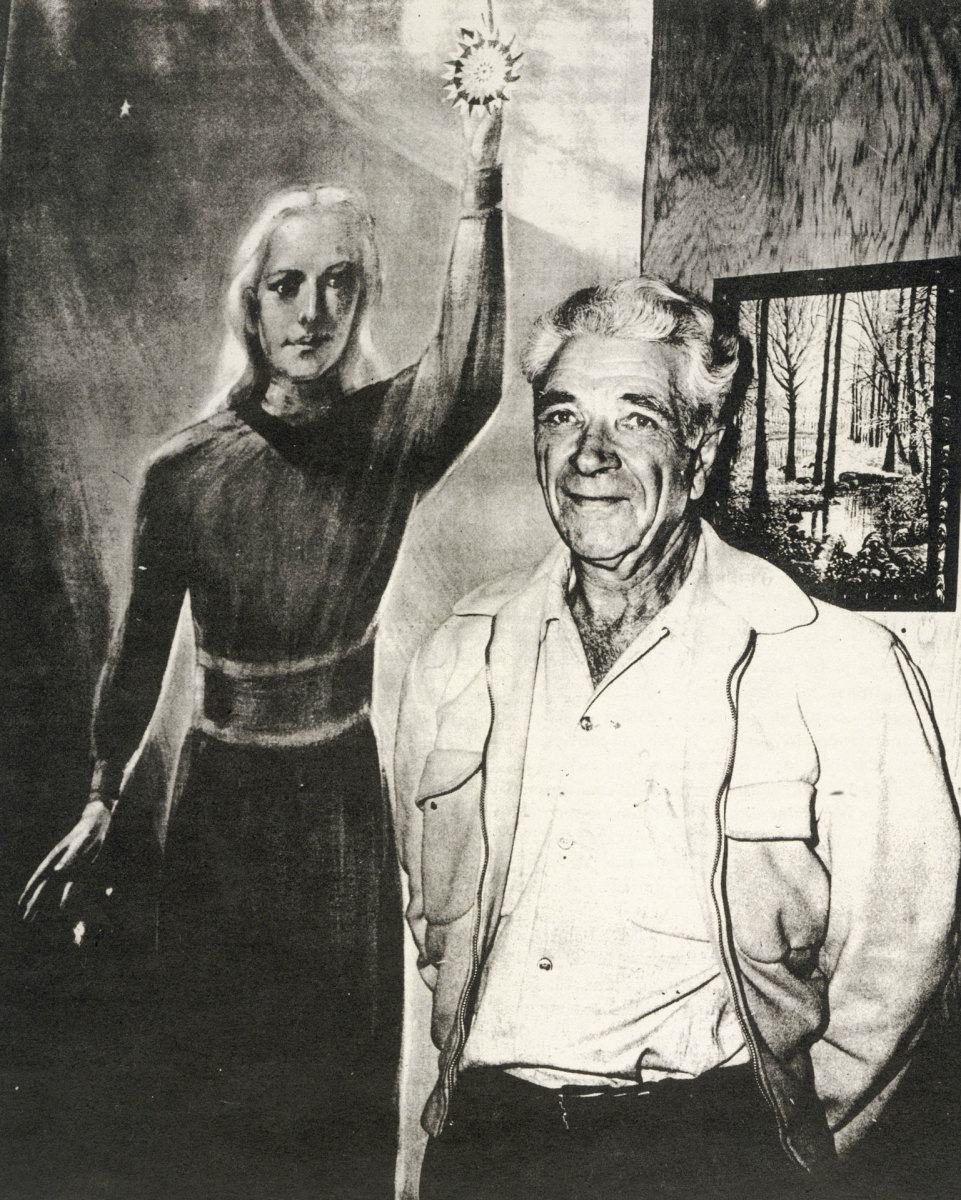
Even at the height of his fame, rumors swirled within the flying saucer community that Adamski was a fraud, but alongside this are slightly mitigating reports by acquaintances that he occasionally confessed as much, while pleading that it was all in support of redemptive spiritual truths.
Oddly, perhaps — this brings us to the Rosicrucians, a movement influential upon Theosophy, and one founded upon a sort of hoax, more or less confessed to by its founder, the German Lutheran theologian Johann Valentin Andreae.
It’s believed that Andreae was behind at least the first publications mentioning Rosicrucianism, a series of anonymous pamphlets that appeared in Germany between 1614 and 1617. In these, it was implied that a hitherto unknown body of knowledge, an amalgam of alchemy, hermeticism, Christian mysticism and Kabbalah had been gathered by the brothers of the Rosy Cross, themselves followers of a 14th century seeker named Christian Rosenkreuz, (German for “Rose Cross”). Many Enlightenment-era scholars inspired by Rosicrucian ideals and not privy to the hoax went on to dedicate well intentioned projects dedicated to Rosicrucian ideals — all similar to Adamski’s notion of good teachings brought by imposters.
The similarity between the notion of hidden Rosicrucian adapts and the Masters of Theosophy did not go unnoticed by the movement’s leading light, Helena Blavatsky. In writing about the 1842 novel Zanoni by Edward Bulwer-Lytton, she described the characterization of the Rosicrucian hero Zanoni as a perfect description of Theosophy’s hidden Masters of her.
Stranger still, it’s believed that Blavatsky’s notions of a sort of “higher science,” a technology that manipulates subtle spiritual energies, seems to have been directly influenced by Bulwer-Lytton’s 1871 novel, The Coming Race and its concept of the “vril,” used by hidden survivors of a an advanced civilization comparable to Blavatsky’s Atlanteans. A comparison to the mysterious powers channeled by van Tassel’s Integratron is naturally mentioned here.
We wrap up with a look at A.M.O.R.C. (The Ancient Mystical Order Rosae Crucis) a uniquely American Rosicrucian organization known for its flamboyant advertisements for cosmic know-how published in the backs of magazines of the 1940s and 50s. Founded in 1915, this group of media-savvy adepts also went on to produce some particularly peculiar records in the 1960s, which we hear sampled at the closing of the show.
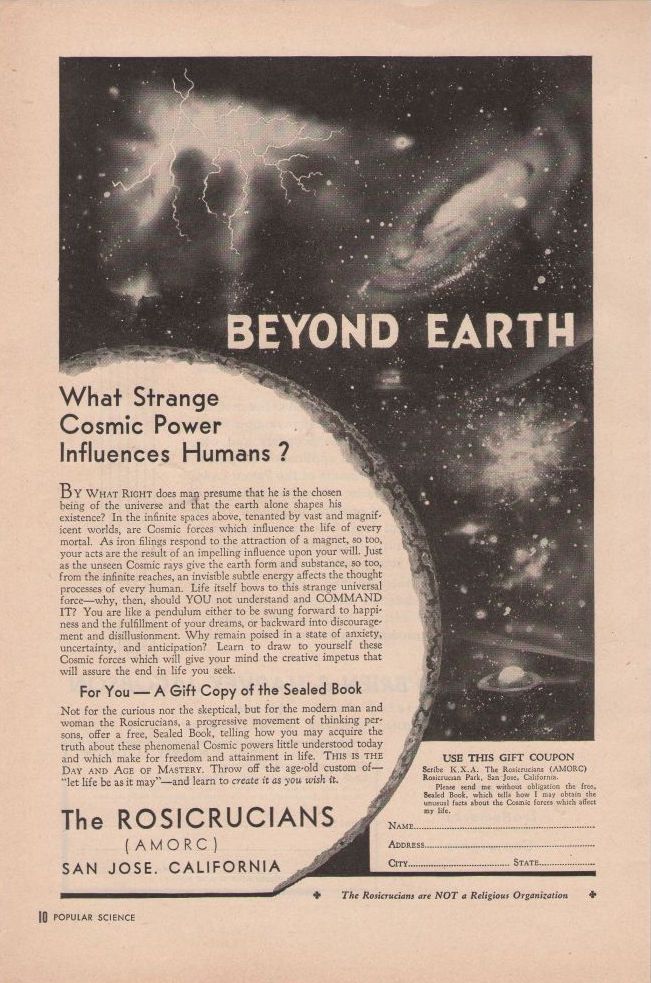
Friends from Venus, Theosophists in Space
The esoteric teachings of Theosophy, particularly those regarding Venus, were surprisingly influential on the tales told by flying saucer Contactees of the 1950s and ’60s.
We begin with a quick review of Theosophy and its principles as defined by the Russian international adventurer Helena Blavatsky in the later decades of the 19th century. Blavatsky had worked as a spirit medium and transformed Spiritualism’s spirit guides, into what Theosophy calls its Masters of Ancient Wisdom, advanced adepts from the East secreting themselves primarily in the mountains of Tibet — beings after which the spiritually evolved “Space People” of the Contactees were patterned. Theosophy’s myths of previous technologically advanced but morally or spiritually flawed civilizations like those of Atlantis or Lemuria also also offered a framework for Contactees who believed mankind faced a similar dilemma under the Cold War threat of annihilation.
Venus was regarded as the most significant and spiritually advanced of the planets by the Theosophists. In its guise as the “morning star,” it became a symbol of esoteric illumination and the dawning of a new illuminated era. It also played a significant role in Theosophy’s spiritual hierarchy as a home to advanced beings including the figure of Sanat Kumara, a Master advanced to the level of deity. Unsurprisingly, Venus was also the home-planet to the majority of Space People encountered by the Contactees.
Key players in the Contactee movement coincidentally all shared a first name: George Adamski, George van Tassel, George Hunt Williamson, and George King, the only Brit among the Americans, and the primary subject of this episode.
Before discussing King and his experiences, we take a brief side-trip to discuss another, slightly later Contactee, who provided a bit of audio used in our opening montage, a clip from a 1957 record he sold at his saucer talks called Authentic Music from Another Planet. Along with his bizarre recording of musical scores he claims to have received telepathically on Saturn, Menger is of interest for his marriage to a woman from Venus, or at least the alleged reincarnation of a past-life lover from Venus.

George King, a taxi driver from London, arrived upon the scene a few years later than our other Georges, but his teachings hew closest to Theosophical doctrines. Some of this, no doubt, is due to the influence of his mother, who was known locally as a healer and clairvoyant. We hear some clips from a May 21, 1959 episode of the BBC show “Lifeline,” in which he demonstrates his technique of channeling extraterrestrial intelligences, including that of a Master from Venus named Aetherius, whose name is represented in the organization King founded in 1959, The Aetherius Society.
In the interview King also discusses another extraterrestrial who came to him in the early days of his career as a Contactee for the purposes of teaching him the channeling techniques he would need. In keeping with Theosophical bias, the earth body this teacher had taken is that of sage from India.
King also discusses his relationship with the “Master Jesus” (another resident of Venus) and a meeting between his mother and Jesus on a spacecraft, during which Jesus blessed King’s book, The Twelve Blessings, a foundational text of the Aetherius Society.


Another Theosophical principle King seems to have embraced is Blavatsky’s notion of a “higher science” using technology to manipulate subtle, spiritual energies (something present in her descriptions of Atlantis and Lemuria). In King’s case, this concept lies behind his invention of “prayer batteries” used to capture and then deploy where needed the spiritual energies emitted during group prayers conducted by the Society.
King also takes the Theosophical myth of Atlantis and goes it one better. Rather than a continent being destroyed through human evil, a whole planet by the name of Maldek, he says, was destroyed in a similar manner eons before man was present on earth. The actual asteroid belt between Mars and Jupiter he regards as Maldek’s ruined remains.
We close with some considerations regarding the Pentagon’s release of reports of “unexplained aerial phenomena” this spring. Included is a clip from the 1960 song “When You See Those Flying Saucers” by The Buchanan Brothers.
Hex Murders and Madness in Old Pennsylvania
Cases of madness and even murder were associated with Hexerei, a form of witchcraft brought to Pennsylvania by German immigrants. Following up on our previous examination of the tradition of Braucherei or Pow-Wow as practiced in 18th and 19th century Pennsylvania, our current episode eplores some more disturbing cases of witchcraft beliefs surviving into the 1920s and ’30s.
Our show begins with a montage of voices extracted from the documentary Signs, Cures, and Witchery: German Appalachian Folklore. It was produced as a companion to an excellent book of the same name by Gerald Milnes.
By the 1890s, any public notice taken of Braucherei tended to be negative. Journalists were quick with comparisons to the Salem witchcraft mania and tended to focus on cases in which witchcraft belief led to madness. We hear an example of this from an 1891 Pittsburgh Dispatch article describing two women driven to paranoia in the hills of Earl and Douglass townships. From the Public Weekly Opinion of Chambersburg, PA, we hear bits of an 1894 story describing the extreme (and destructive) measures taken by a George Kellar to rid his property of witches.
The first of the witchcraft-related homicides we examine comes from a March 1922 edition of the York Daily Record. It’s the case Sallie Heagy, whose belief in witchcraft and a night-hag like entity known in Pennsylvania as “Trotterhead,” led to her shooting her husband while he slept.
We then move on to the most famous witchcraft murder in Pennsylvania, namely that of a part-time Braucher and potato farmer, Nelson Rehmeyer, who met his end in York County in 1928. Mrs. Karswell opens this segment reading a description of the discovery of the decedent’s body taken from a Nov. 30 edition of the Hanover Evening Sun.
The murder was committed by a group of men organized by John Blymire, a third generation Braucher or Powwower, who believed himself to have been cursed by Rehmeyer. We hear a bit of his troubled history (which included being committed to a psychiatric hospital from which he escaped) and of his accomplices, including John Curry, a younger man whom Blymire took on as a sort of magical apprentice and Wilbert Hess, whose troubles with his wife and farm, according to Blymire’s increasingly paranoic beliefs, were also tied to a curse by Rehmeyer. We also hear of the involvement of the Braucherin Nellie Noll, sometimes called the “River Witch of Marietta,” from whom Blymire sought help in identifying Rehmeyer as the one responsible for the curse laid upon him. The commission of the crime itself is described in our show via the court testimony given by Wilbert Hess.
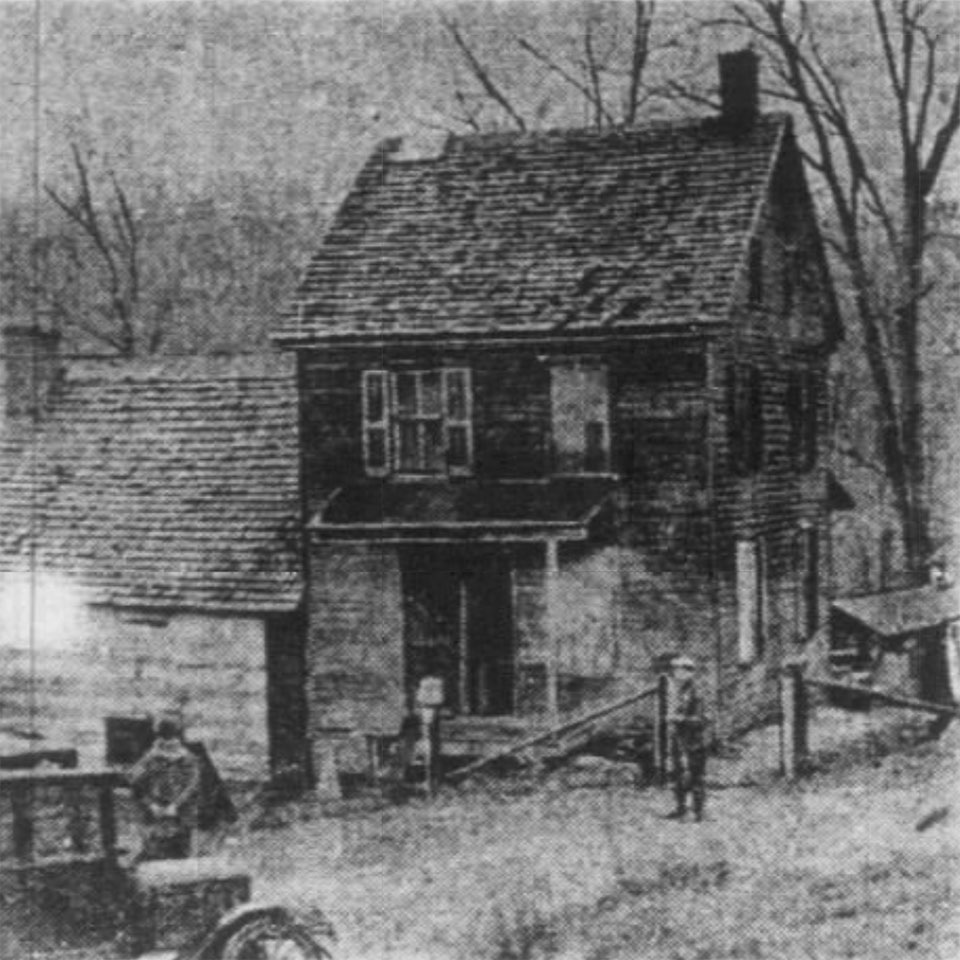
The media circus generated by a witchcraft-related murder in 20th-century Pennsylvania resulted in the press becoming obsessed with investigating any possible links to Braucherei in any Pennsylvania crime they reported on. We hear several examples of highly speculative connections made including that of the twenty-one-year-old woman Verna Delp, whose death by poison was erroneously connected to concoctions given her by a Braucher in 1928. A similar connection is examined in the 1930 case of Mrs. Harry McDonald, who was found burned to death in her home, as well as the case of Norman Bechtel, whose body was discovered in 1932 in a mutilated state, bearing injuries, the press presumptively identified as “hex marks.”
Only 6 years after the Rehmeyer case, however, another murder with an undeniable connection to withcraft belief occurred in the vicinity of Pottsville (the same region as that of our Hex Cat case in Episode 69). This was the murder on March 17, 1934 of Susan Mummey by Albert Shinsky. Mummey was a local Braucherin, known by locals as “Old Susie,” or sometimes “The Witch of Ringtown Valley,” who had a cantankerous reputation with her neighbors. At the age of 17, Shinksy experienced one such unpleasant encounter, which he came to regard as the origin of a seven-year curse placed upon him by Mummey — one that could only be resolved ultimately by slaying the witch with a magic bullet. We’ll leave the lurid details of this case for you to experience as you listen, but suffice it to say, the region still seems to have had problems with Hex Cats in 1934.
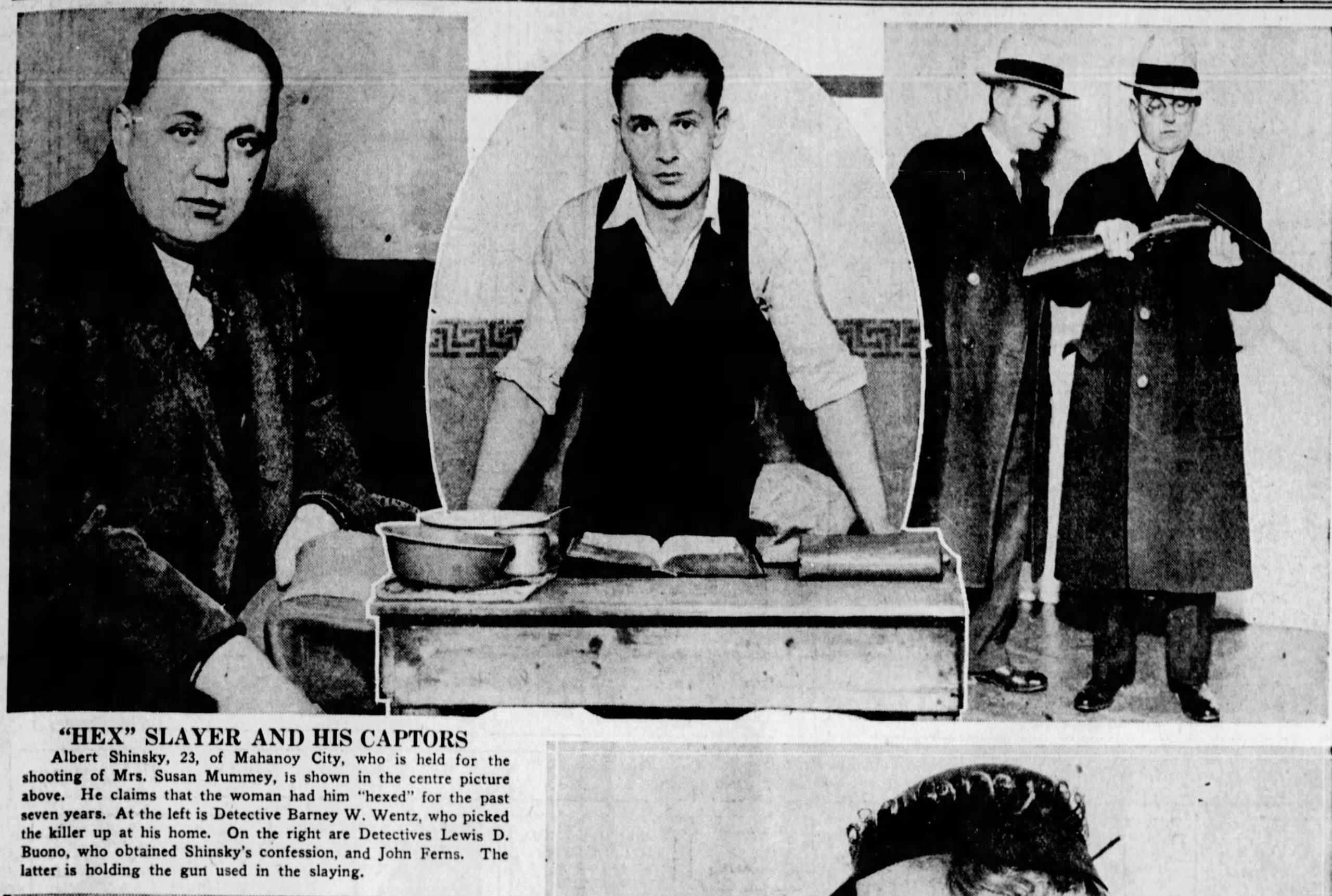
Our show closes with a look at the Rehmeyer case explored in different media. A highly fictionalized version of the story was produced in 1987 under the name Apprentice to Murder, this one featuring Donald Sutherland as a notably more bookish John Blymire type. There’s also a good 2015 documentary, Hex Hollow, which features interviews with Blymire and Rehmeyer’s descendants. Strangest of all is the manner in which this story seems to have influenced the musical psychedelia of the York County band Lenny Lionstar and The Hillbillies of The Universe. We close with a snippet of their work.
Witches, Healers, and Hex Cats in Old Pennsylvania
Stories of witchcraft and folk-healers in early Pennsylvania are surprisingly plentiful. In this episode, we examine the state’s German-American tradition of Braucherei that spawned these tales. The practice came over with immigrants from Germany’s southwestern Rhineland beginning in the late 1700s and established itself among the Pennsylvania “Dutch” (a misunderstanding of “Deutsch”) in the state’s southern “Dutch Country” region, eventually moving westward through Appalachia and all the way to Indiana and south into the Ozarks.
We begin with a chant supposedly chanted in the 1800s by witches gathered at Hexenkopf Rock (“witch’s head” rock), an actual site about 15-minutes outside the old steel town of Bethlehem. The locale is central to early Braucherei and to the other name by which it goes, namely “Pow-Wow.”
It was on land adjacent to the Hexenkopf that Johann Peter Seiler, who immigrated from Germany in 1738, eventually settled and set up shop as a folk-healer, or “Braucher” (one who practices Braucherei). As he also offered treatment to the native Algonquin, his work was equated by them to that of their medicine man or his rituals, and he was supposedly dubbed “The Great Pow-Wow.” This is one origin story for the odd nomenclature, though others believe the term “pow-wow” was applied by English settlers as a disparaging comparison to native rituals. The term is still used and carries no such disparaging connotation today. Nor does it imply a borrowing of Native American traditions into Braucherei, which is firmly rooted in Old World traditions.
While the Braucher has frequently been described by outsiders a “witch” or “witch doctor,” it’s certainly not a label accepted within the tradition, as there are no “good witches,” only bad witches, (Hexes) who practice Hexerei. Brauchers are often sought to remove curses placed by Hexes, though occasionally practitioners have been known to slip from one side to the other.
We next look at a sampling of the magical tools and techniques employed in Braucherei, the prominence of the color red, preponderance of written charms carried by clients, and the spoken charm, the famous “Blood Verse” used to stop bleeding.
A Braucher would always consider himself to be Christian, and much use is made of religious images and verbiage, especially from Catholic traditions. Though the Pennsylvania Dutch immigrated from Germany’s Protestant regions, Braucherei has served as a sort of underground continuation of medieval Catholic practice in a Post-Reformation world.
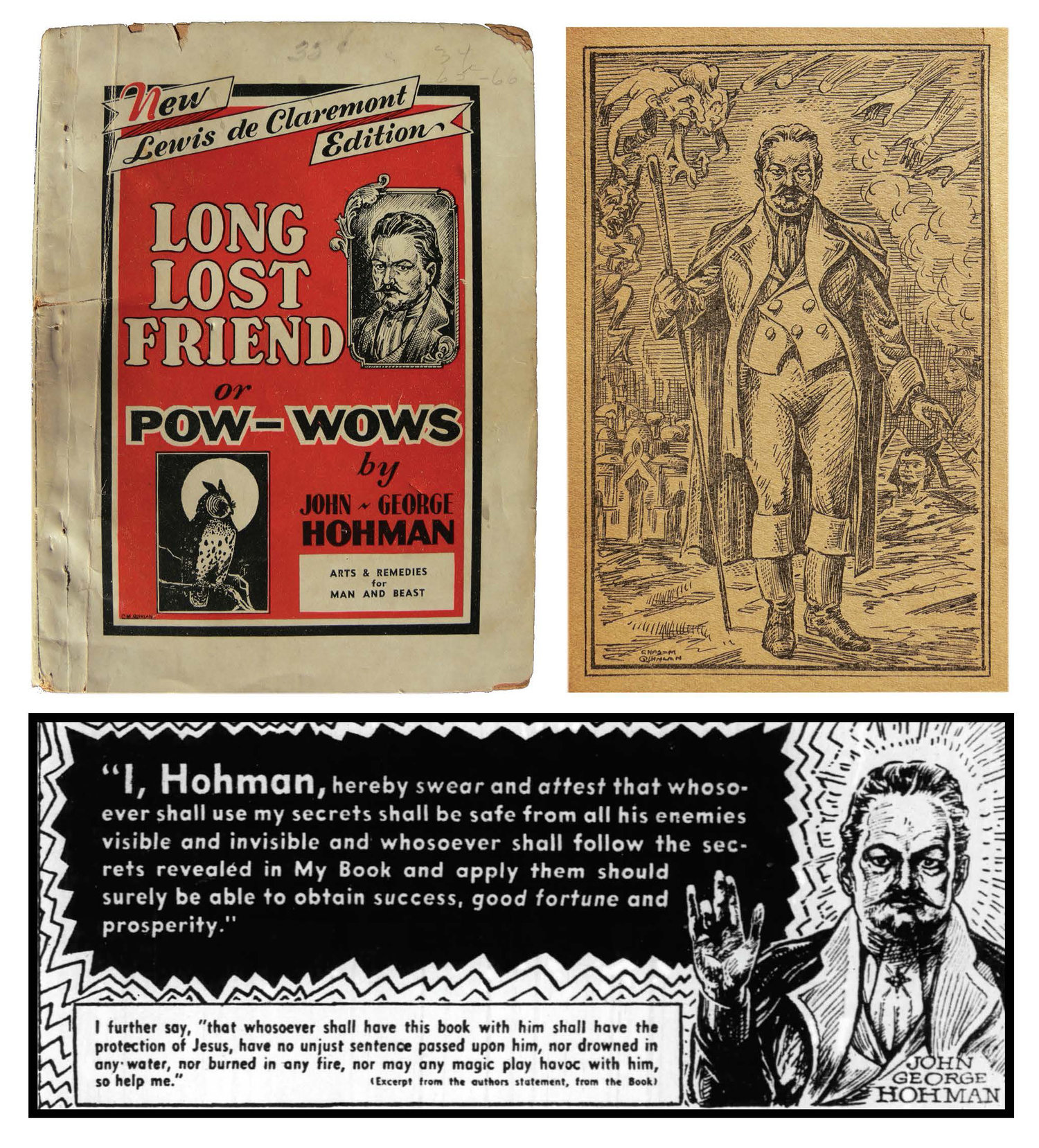
We then discuss the curiously titled volume The Long Lost Friend, a classic sourcebook for Braucherei, published by German immigrant, printer, and Braucher John George Hohman in Reading, Pennsylvania in 1820. Much of it, we learn, was borrowed (sometimes verbatim) from earlier European books of magic, though applications described therein are very specific to 19th century agricultural life. We also hear a bit about another magical sourcebook used (more in Hexerei thanks to its inclusion of destructive magic), the Sixth and Seventh Book of Moses (published as a single volume). We hear a bit about its notorious reputation, both in Braucherei and American Hooodoo.
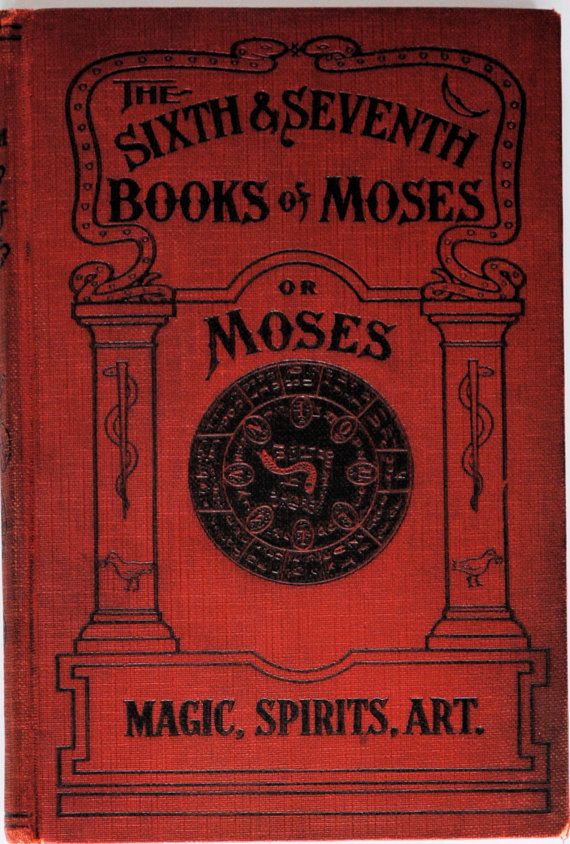
The balance of our show is devoted to tales of witches and healers, gleaned mainly from newspaper archives and read by the inimitable Mrs. Karswell.
We hear of “Old Moll” of Fayette County, her fortune-telling with coffee grounds, of a legendary prophecy (curse?) laid upon some miscreants passing through town, and her appearance in connection with other local legends, as in the 1865 book,The White Rocks by A.F. Hill, a romanticized retelling of the murder of Polly Williams.
A hotbed of Braucherei, Berks County provides our remaining stories — an 1889 story in which a witch torments her victim in the form of a night hag, and the way in which a Braucher defeats her, and an 1892 story involving a baby covered in spots thanks to a visiting witch, who was eventually defeated while in the form of a cat.
Another witch in the form of a cat was the famous “Hex Cat” that haunted the farm of the Thomas family in Tumbling Run Valley in 1911. This one made national news, with reportage appearing as far away as Hawaii. It also generated a moderate frenzy of commercial exploitation. I’ll leave the details of the case for you to enjoy as you listen.
Stay tuned for our next episode further exploring Braucherei, including some shocking criminal cases in which the tradition played a role.
I should also mention that we had some audio cameos in this show. A number of our subscribers on Patreon joined in as witches in the chant at the Hexenkopf. Thank you to: Allison Lovecraft, Victoria Howard, Angelica, Bridget Case, Jenny Matisiak, Molly Van Overhill, Alice Price, and Anne Luben!
(Long Lost Friend images courtesy the Glencairn Museum’s excellent 2017 exhibition on Braucherei)
Nero: Myth and Monster
Emperor Nero’s reputation for wickedness and depravity had already attained mythic status within a century of his death, making him a prototype for early Christian beliefs regarding the Antichrist.
We begin the show with a look at the role poison played in Nero’s ascent, putting him on the throne at the age of 17 in 54AD. After her marriage to Emperor Claudius, Nero’s Mother, Agrippina the Younger, appears to have recruited the notorious poisoner Locusta, to do away with the Emperor when he began to show preference for his other son Britannicus over Nero. And it was Nero himself who later recruited Locusta to do away with the troubling Britannicus.
Agrippina’s role in Nero’s life constituted another kind of poison. If we are to believe what the historian Tacitus describes as “rumors” (rumors affirmed as true by the historian Suetonius), Agrippina seems to have shared her brother Caligula’s inclination toward sexual depravity. Shocking details regarding her relationship with her son are naturally provided.
However, Agrippina seems to have been more driven by lust for power (via her son) than sexual desire. Part of her scheme to set him on the throne had been his marriage to Claudius’ daughter Octavia, who suffered greatly as a result. We hear a bit about her shoddy treatment and arranged “suicide” as well as the rise of Nero’s second wife and former mistress Poppaea Sabina, who is (according to Suetonius) later kicked to death by the emperor. More deaths of potential familial rivals are detailed.
Nero’s overweening Mother likewise falls afoul of her son, and we hear of some particularly bizarre and cartoonish attempts he makes on her life eventually ending with another “suicide” five years after Nero has taken the throne.
Agrippina’s alleged final words to her assassin — “Smite my womb” — expressing her regret over birthing her monstrous son, were woven into other legends amplified in the Middle Ages into a particularly strange narrative involving dissected bodies and frogs. Mrs. Karswell reads for us the relevant passage from Jacobus de Varagine’s 1275 compilation of hagiographies and related stories, The Golden Legend.
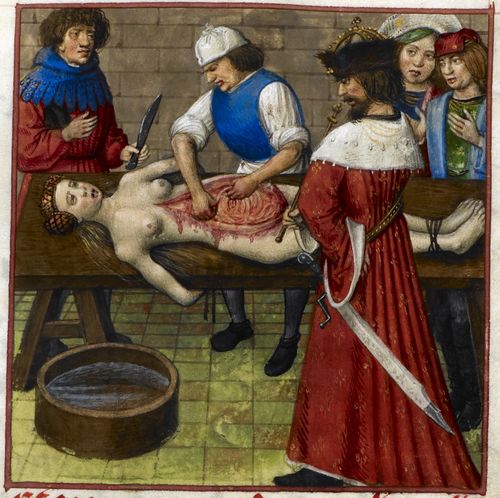
Along the way, we also hear some tales of Nero’s vanity (his endless mandatory-attendance lyre concerts), excesses (pet tigers and Felliniesque parties) and further sexual aberrations (castration and marriage to his male “wife” Sporus in 67AD.)
As for the Great Fire of Rome in 64AD, his musical performance celebrating the event is treated as historical fact by the majority of ancient chroniclers, but it involves neither lyre nor fiddle. The association with the fiddle is explained along the way, and we also hear a snippet of Jimmy Collie 1956 country-western song, “Nero Played His Fiddle (While Rome Burned)” At least two sources (Suetonius and Cassius Dio) agree that during the conflagration, Nero presented a song about the Sack of Troy, comparing that ancient city’s fate with Rome’s current plight.
While Suetonius asserts that the fire was instigated by Nero in order to clear land he desired for his pleasure palace, the Domus Aurea (Golden House), Tacitus records Nero blaming Rome’s Christians for the conflagration.
This particular nexus of Roman and Church history is largely responsible for the Nero’s enduring reputation in Western culture, one strengthened in modern times by the 1951 film, Quo Vadis, itself based on an 1896 Polish novel of the same name by Nobel-Prize-winning author Henryk Sienkiewicz. We hear some snippets from the film that saved MGM studios and initiated a rash of sword-and-sandal epics of the ’50s and ’60s.
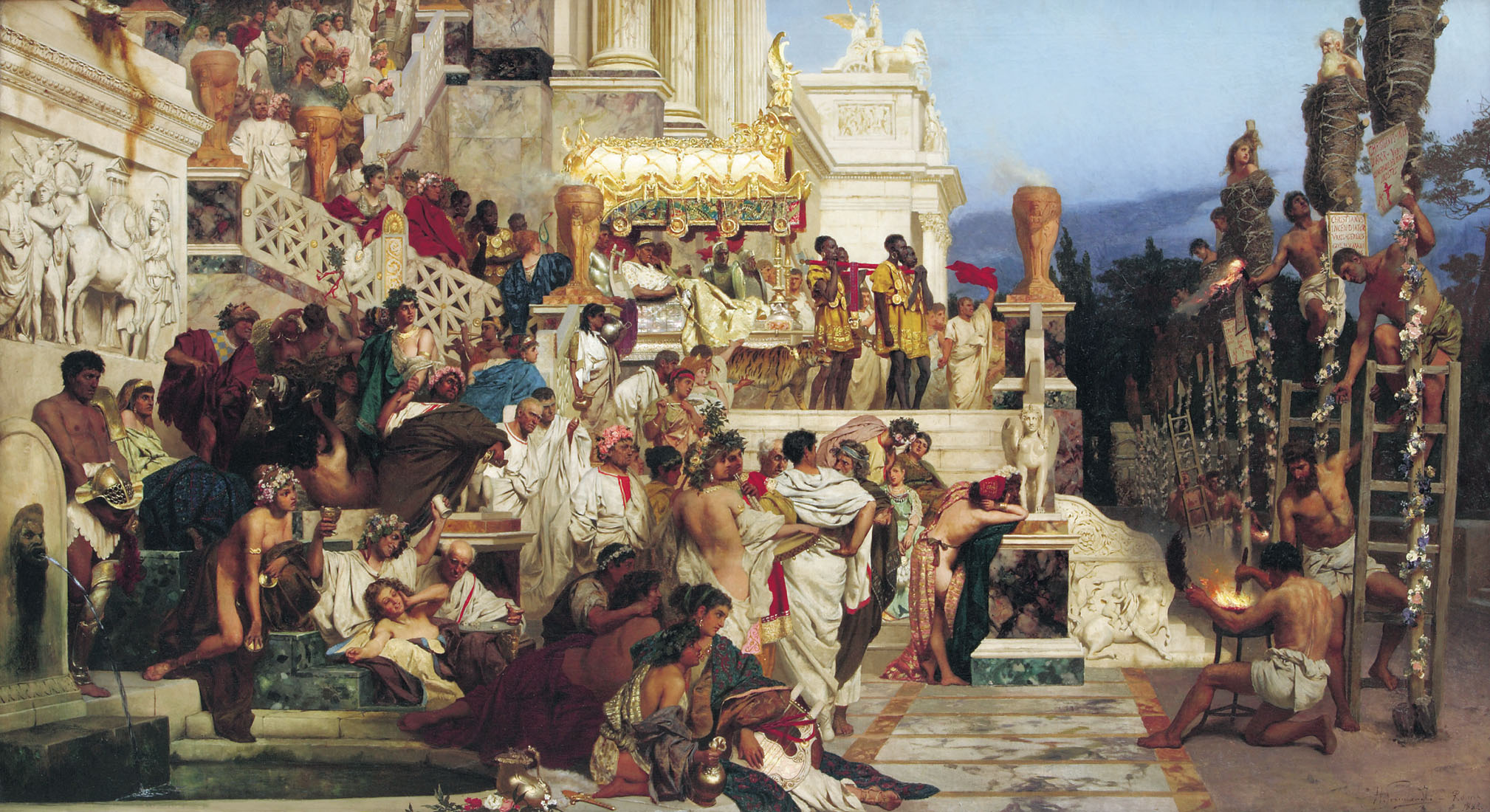
Some particularly cruelly conceived deaths endured by Christians (and others) under Nero are discussed along with the executions of the apostles Peter and Paul and a peculiar connection between Nero and the Vatican.
Also associated with Nero is the magician Simon Magus, whose brief appearance in the biblical book of “Acts” is not particularly interesting, but whose career in apocryphal literature and medieval tradition is quite rich. We hear another interesting account from The Golden Legend describing the magician’s wonderworking feats and a sort of wizard battle between Simon Magus and St. Peter. Also heard is a snippet the 1954 film The Silver Chalice featuring Jack Palance as the sorcerer.
After Nero’s death, the myth-making really began. Because of the obscure circumstances of this death and burial, which we discuss, a belief circulated that he had either not died or would be resurrected (the Nero Redivivus legend). Several imposters using his name took advantage of this, specifically three “Pseudo-Neros” gaining followers in distant lands between 4 and 20 years after his death.
Two of the Pseudo-Neros gained followers in Parthia (modern Iran), a detail found also in a the prophecies of the Sibylline Oracles regarding a terrible End Times conqueror or Antichrist (though the latter word is never used) — and thus one positioning Nero as the fulfillment of that prophecy.
Purporting to be a record of the sayings of the Sibyl of classical antiquity, the Oracles were actually written somewhere between the 4th-6th centuries. Books 5 and 8 are full of apocolyptic imagery laced with a few details seeming to match up with bits of Nero’s biography. Interpreters of the biblical book of Revelation have also provided clues connecting Nero with the Antichrist.
We close our show with a look at the haunted history of Nero’s grave in Rome as well as a more recent myth that’s evolved around the supremely exotic execution and torture of the poisoner Locusta.
Marvelous and Rare II
We’re doing something different this time out.
As we are celebrating Bone and Sickle’s third anniversary on April 30, we’re taking a week or two off to rejuvenate and prepare new material for year four.
To fill the gap, we’re offering listeners a sample of the short bonus episodes all our $4-and-up Patreon subscribers hear every month. If you’d like to hear more in this format, another sample episode was released to our wider audience in September 2020.
We hope you enjoy this substitution, and if you do, might consider joining us on Patreon to hear more of the same.
We’ll be back later in May with a traditional Bone and Sickle Episode. Until then, happy May Day (and Walpurgisnacht) to you all!
Mermen and more Marvels of the Northern Seas
In this episode, we continue our survey of supernatural sailors’ lore of the North with a look at mermen, Iceland’s “evil whales,” and sea-draugs.
After a brief audio tidbit recalling our previous discussion of the Norse World Serpent, Jörmungandr (courtesy of the TV show Vikings), we briefly reconsider the Kraken in the context of the 13th-century Norwegian text Kongsspegelen/Speculum Regale (“King’s Mirror”). In what is likely the earliest reference to the Kraken, the attributes described and context of the discussion suggest that at this early stage of the creature’s mythology, it may have been imagined not as a cephalopod but as a particularly large and monstrous whale.
This brings us to the topic of the “evil whales” or Illhveli of Icelandic lore, much of which is taken from Olaf Davidson’s article of 1900, “The Folk-Lore Of Icelandic Fishes.” Particularly dangerous and even malevolent toward seamen, these beasts are also enemies of benevolent species of whale that protect man. Their flesh is considered poisonous, and utterance of their name, we learn, can summon them and great misfortune.
The largest of these creatures (if we disregard the Kraken, which seems more to occupy a class unto itself) is the Lyngbakr or “heather-back,” often mistaken for a land-mass covered with heather or grass. The same motif occurs in tales of the Kraken or Hafgufa (not discussed in the show thanks to the thematic redundancy), but tales of the Lyngbakr characteristically describe sailors actually landing on the heather-covered mass, mistaking it for an island, and perhaps dwelling there for days on end — until the fish takes a dip.
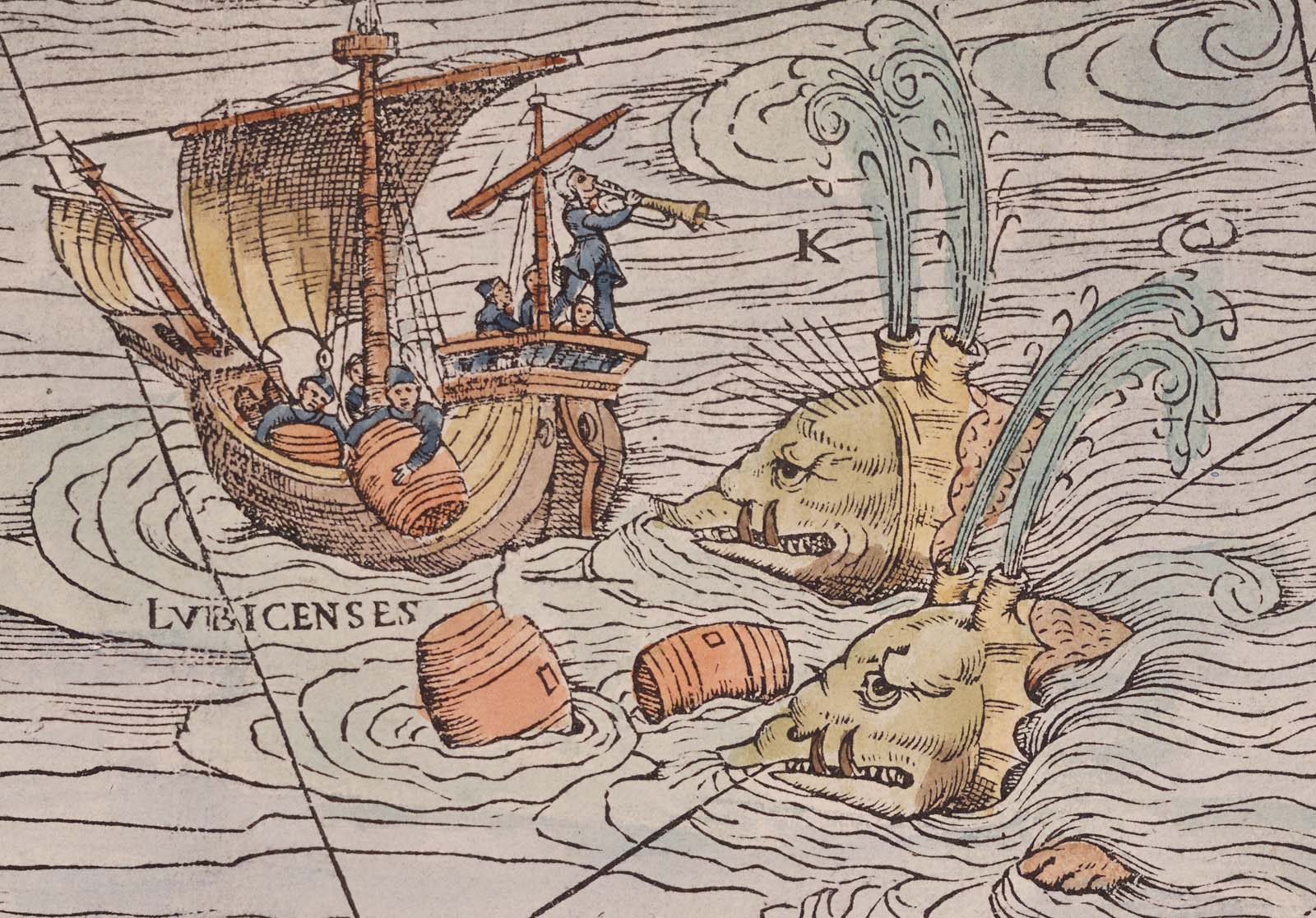
The most vicious member of the Illhveli, seems to be the Raudkembingur, or “red-crest,” named for its red color and/or the rooster-like comb it sports. Mrs. Karswell reads for us a selection of Davidson’s stories of the Raudkembingur’s attacks upon ships and rather emotional disposition.
We then hear about the Hrosshvalur or “horse-whale,” named for the neighing sound it produces. It was also sometimes called the blödku hval or “flap-whale” thanks to long eyelids or flaps that hung over its eyes. As these tended to obscure the beast’s vision, it was given to wild leaps from the sea, during which the flaps would bounce from the eyes, providing the creature a brief respite from near-blindness.
We then hear a bit more about other other Illhveli, less frequently mentioned, learn why the Narwhal was regarded as the “corpse-whale,” how the Ox-Whale proved a nuisance to herdsmen, and of a particularly strange eccentricity of the Shell-Whale.
Our discussion of mermen focuses primarily on accounts provided in Danish-Norwegian author Erik Pontoppidan’s 18th-century text The Natural History of Norway (cited frequently in our previous episode). While a mermaid or two is also mentioned, Pontoppidan treats the mermen less as a sort of fairy being inclined to abduct men to an undersea realm (as is typical further south in Europe and in Britain) and more as a sort of cryptid or naturalistic phenomenon. We hear some descriptions of mermen allegedly caught in the Northern seas (quite different from what is typically imagined), tales of enormously oversized mermen, and of the odd uses of the fatty flesh of mermen.
The merman of the north also is uniquely gifted with the ability to tell the future, a trait referenced early on in the 14th-century Hálfssaga and preserved in the Icelandic folk-tale “Then Laughed the Merman” told by Mrs. Karswell and myself.
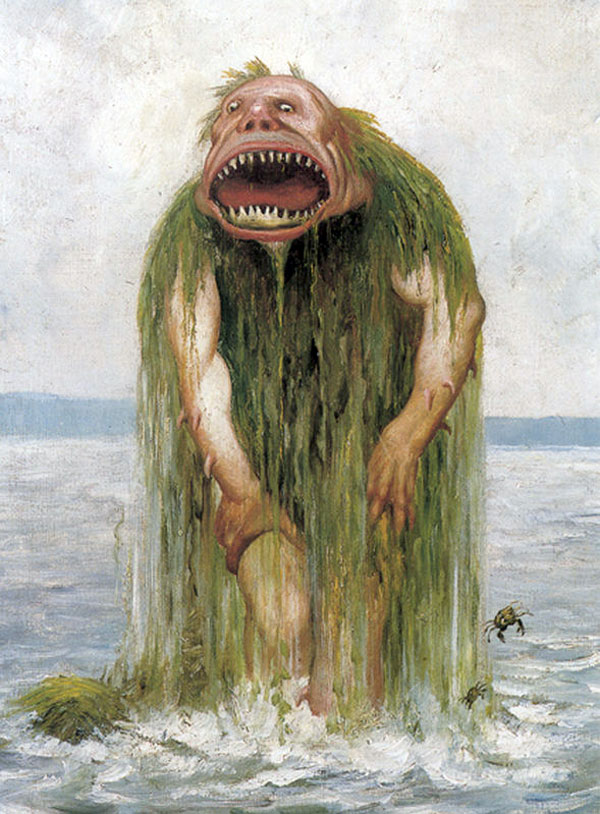
Our discussion of the sea-draug begins with a clip from the 2018 Swedish film, Draug, a horror story set in the 11th century. Draug is a word from Old Norse used throughout Scandinavia to describe a walking corpse, usually guarding its grave or an underground treasure. Its folkloric attributes have been somewhat changeable and led to the evolution (specifically in the North of Norway) of a figure known as a Havdraug or (Sea-Draug).
These are the ghosts of sailors lost at sea, who return as physical creatures horribly transformed. While usually dressed in the typical oilskins and gloves of sailors of the North, their heads are often said to be missing, and they are known to sail about in broken boats missing their stern or to haunt the boathouses of the region. Their presence is an evil omen, and their notorious shrieks can either foretell or indirectly cause death.
We first hear mention of sea-draugs in the 13th-century Saga of the People of Eyri in which the crew of a sunken sip show up at a Yule feast, illustrating a predilection of the sea-draug to appear around Christmas, a motif maintained in tales of sea-draugs that became popular in the 19th century. We hear some descriptions from these and the folk-tale “The Land Draugs and the Sea Draugs”.
Our episode closes with a strange tale of another Norwegian whale of the modern era, one killed near the island of Harøya in 1951 — at which point it’s weird saga actually begins. The story rather unexpectedly involves a brief appearance by Louis Armstrong, and we hear some bits from his 1938 hit “Jonah and the Whale.”
The Kraken and Other Marvels of the Northern Seas
The Kraken is only one of the monsters said to inhabit the storied northern seas of Scandinavia. This episode is the first of two that will examine fantastical nautical tales of these regions.
We begin with a bit of dialogue about the Kraken uttered by Davy Jones in Disney’s 2006 Pirates of the Caribbean film Dead Man’s Chest. It’s particularly appropriate to our first theme: the Kraken (and a couple Kraken-adjacent creatures) as embodiments of the apocalypse. The first of these is probably never far from some listeners’ thoughts — Cthulhu. The second is the Norse World Serpent (a Sea Serpent), Jörmungandr.
Lovecraft’s creation, some scholars believe, may have been inspired by an 1830 poem “The Kraken” by Alfred Lord Tennyson, which we hear read by Mrs. Karswell. Of particular interest here is the way in which Tennyson associates the creature with the sort of epochal shift Lovecraft later represented in the rising of the Old Ones to claim the Earth for themselves.
Jörmungandr is a primary participant in the Norse End of the World or Ragnarök. We hear this described in a passage from the 13th-century Prose Edda. We also hear a more “light-hearted” tale in which Thor goes fishing for the World Serpent – hilarity ensues!
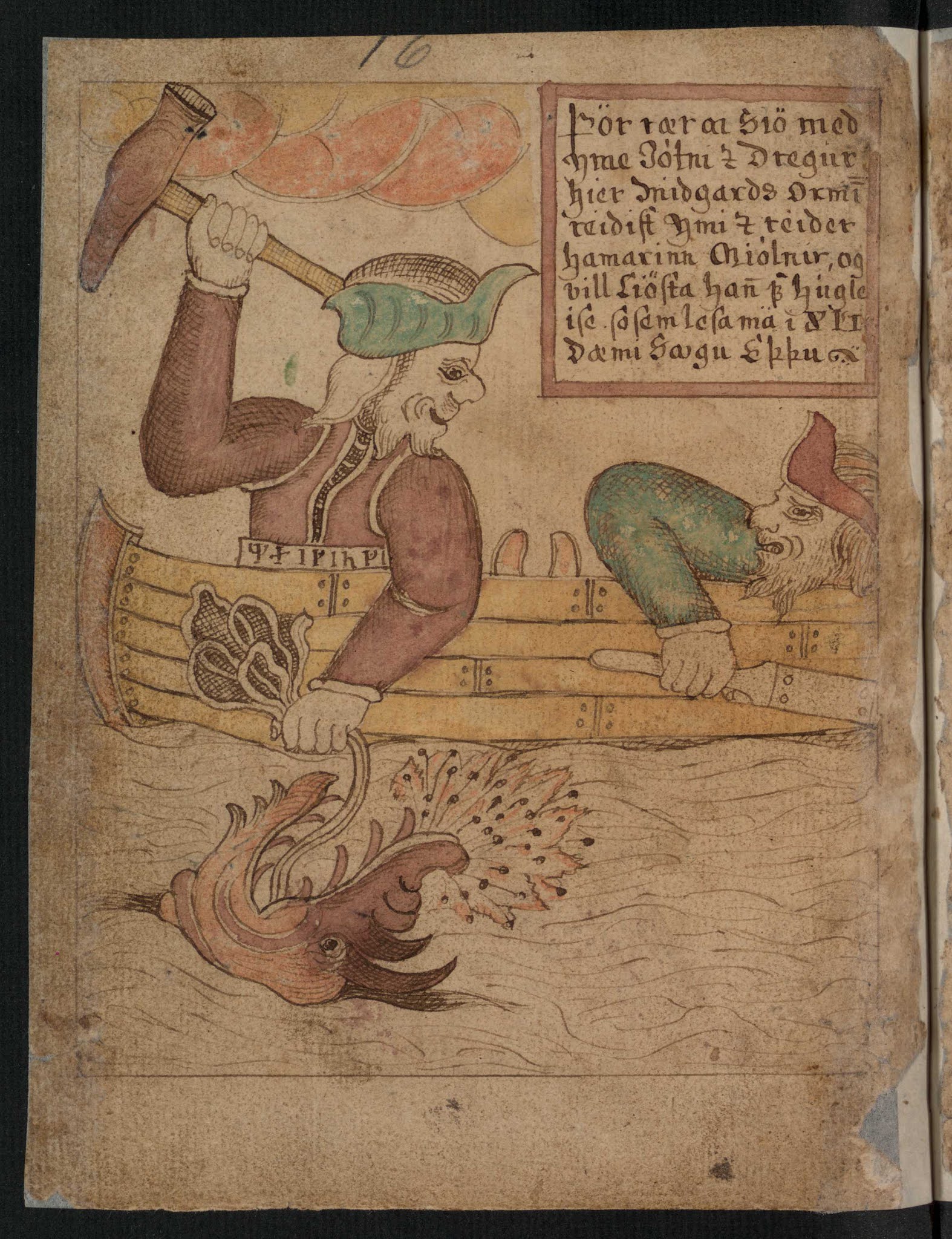
The earliest accounts of sea serpents (though not necessarily the Kraken) come from the Swedish writer Olaus Magnus, a 16th-century Archbishop of Uppsala. He not only populated his map of the northern seas, the Carta Marina (the first to represent the region) with illustrations of monsters, but described some common beliefs about the creatures in his 1555 book, History of the Northern People, from which he hear some passages focusing on sea serpents.
Hans Egede, Lutheran missionary to Greenland of Danish and Norwegian descent, provides our next account of a sighting, not secondhand lore as with Magnus, but a description of a creature he alleges to have seen himself on July 6, 1734. The passage we hear is from his 1745 publication, A Description of Greenland.

Then we come to the definitive source for our show’s topic, the Danish-Norwegian author and Lutheran bishop, Erik Pontoppidan. His work The Natural History of Norway, published in two volumes in 1752 and ’53 describes both serpentine monsters and the Kraken.
Regarding the former, he provides a wealth of information, from which we have extracted the more intriguing bits — sailors firing on sea serpents and serpents sinking ships, the creature’s disgusting method of attracting a meal of fish, the differences between sea serpents of the Norwegian and Greenland Seas, preventative measures taken against these monsters, and an interesting use for sea serpent hide.
Where Pontoppidan turns his attention to the Kraken, the waters get murkier. It soon become clear that our current way of imagining the Kraken (formed largely by 19th-century illustrations and later media) may not apply. In an effort to “rationalize” this monster by comparison to natural creatures, Pontoppidan calls in a number of candidates: “polypi” (squid or other cephalopods) as well as starfish, a type of sea anemone, and even crabs. “Krabben” (a form of crab) even turns out to be a name equivalent to “Kraken” according to Pontoppidan. We also hear what we think of as tentacles referred to as “horns” or “antennae.”
One thing that remains clear in Pontoppidan’s descriptions (and perhaps more so in earlier accounts to be explored next time) is that the monster is very large, the largest animal of land or sea. We hear an account from The Natural History of Norway emphasizing this as well as some others highlighting the creature’s more off-putting habits.
One reason, we learn, that Pontoppidan won’t just lock in the giant squid comparison, is that the existence of such creatures was not confirmed by those who study such things until the 1870s, roughly a century after Pontoppidan’s career. Even in Jules Verne’s 1870 novel 20,000 Leagues Under the Sea, the tentacled creature visualized so memorably in Disney’s 1954 film (from which we hear a clip) was not identified as a squid, but as an octopus (or octopi, as it’s an entire school of these that menace the Nautilus.)
After a quick look at how the giant squid worked its way into Kraken lore and public consciousness, we sirvey a few more modern accounts mirroring the legendary attacks these beasts would make on ships, the latest from 1978, and a substantially more dramatic one from World War II. Features are some clips from a 1980 episode, “Monsters of the Deep,” from the television show Arthur C. Clarke’s Mysterious World.
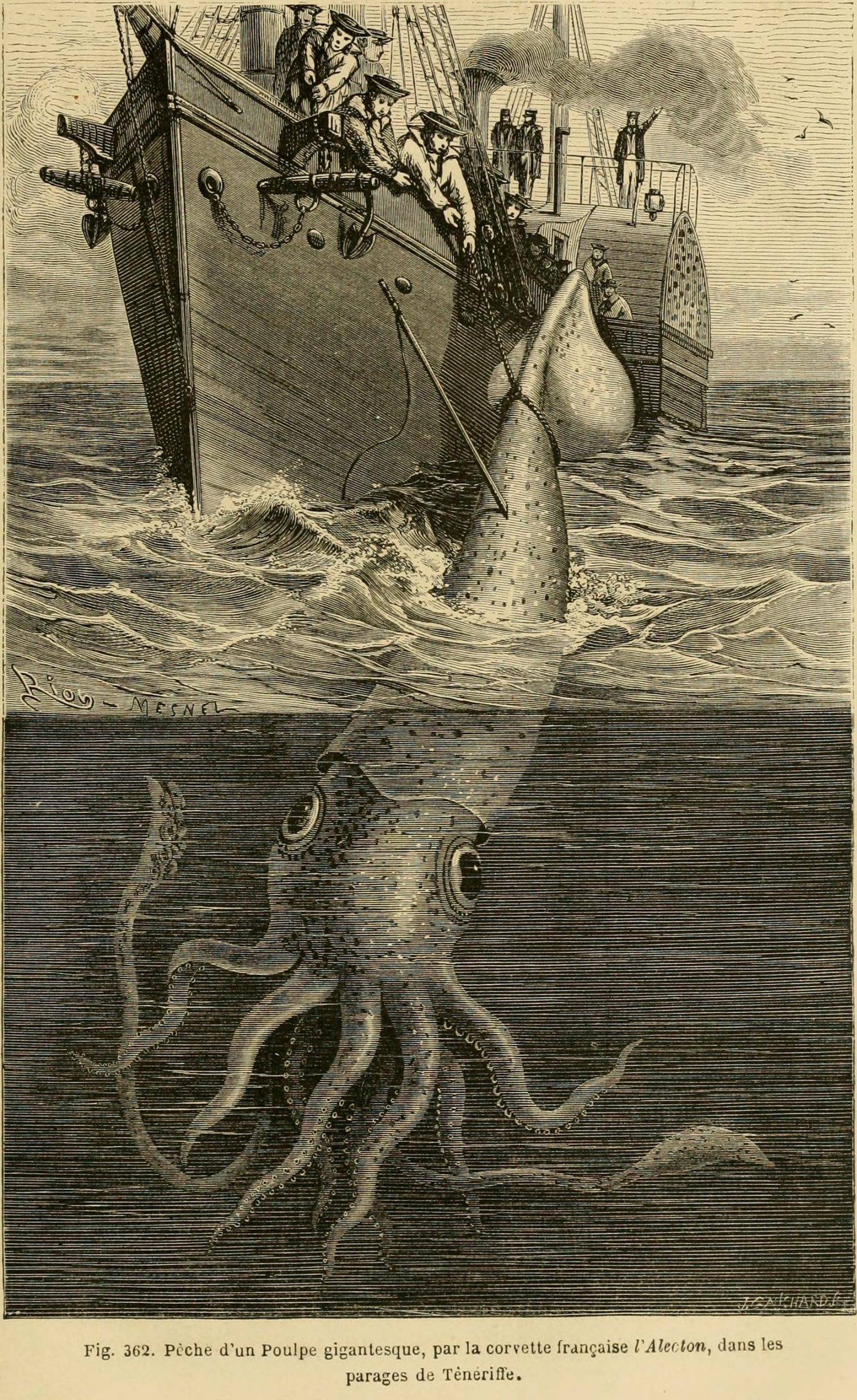
Bees: Gods, Death, and Honey
The mythology of bees has been tied for centuries to notions of the otherworld and death. In this episode we trace some of that folklore along with examining some highly peculiar uses of honey.
Horror or sci-fi films referencing bees exploit the more mundane fears bee holds for mankind. Our survey of these includes clips from the dreadful 2006 The Wicker Man remake, Candyman (1992), The Deadly Bees (1967), The Swarm (1978), and Invasion of the Bee Girls (1973). Also included are some snippets of “Not the Bees” remixes by Koolfox, CyberPunkStefan, and KCACopyright.

Continuing on (in a sense) from our Medusa episode, there follows a good deal of Greek mythology, thanks to the significant role these creatures played in that culture’s imagination, beginning with the bee-nymphs or honey-nymphs who served as nurses to the infant Zeus. There are a number of triads of female bee creatures in ancient Greek literature, which may or may not be the same. Along with Zeus’ nurses, these include the Thriae, who serve as oracles, and creatures simply dubbed “The Bee Maidens” described in a Homeric “Hymn to Hermes” (who also serve as seers.) Priestesses of Artemis and Demeter were also dubbed”bee,” and some have proposed a connection between the Delphic oracle and bees or honey, as is discussed.
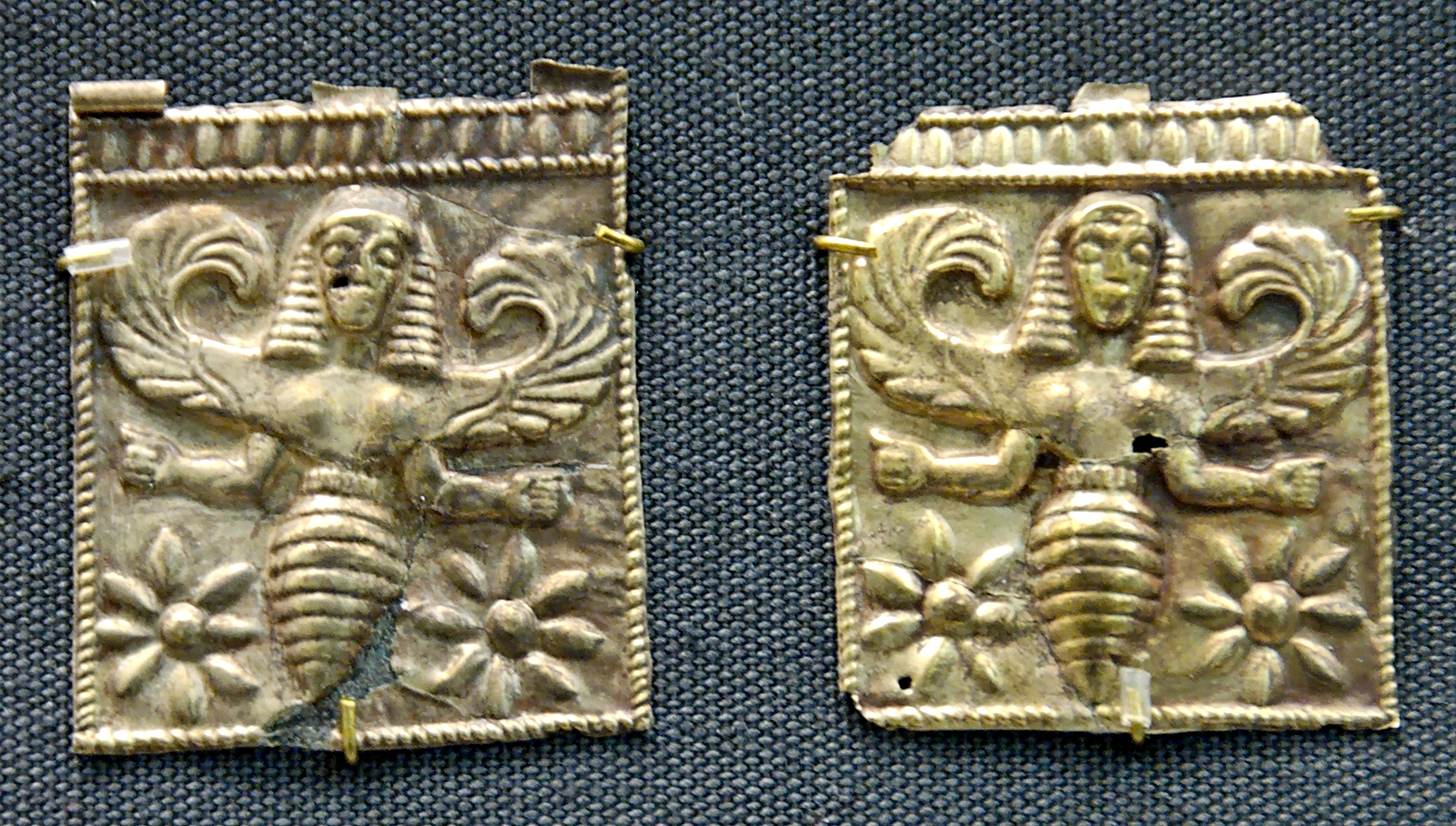
A brief musical interlude follows this: “The Bee Song” by British comedian Arthur Askey.
Our next topic seems to be most prominent in ancient Greek thought but was found elsewhere and persisted into the Middle Ages, namely, the belief that bees were spontaneously generated from the carcasses of oxen. This superstition, known as “bugonia” (from the Greek words for “ox” and “spawn”) is discussed in passages we hear from Virgil’s volume on agricultural lore, Georgica, and from a similar 10th century book of Byzantine creation, Geoponika. We also hear an example from the Old Testament and learn a a related and unseemly lesson about a honey-like product found in many British households. And there’s a poem by Kipling, “The Flies and the Bees” from which Mrs. Karswell reads a relevant excerpt.
Human corpses (if they happen to be a priestess of Demeter) can also generate bees, according to a passage from Virgil’s Aeneid, which we hear. And there is a story of a skull filled with honeycomb from Herodotus’ Persian Wars, one somehow similar to a report from an 1832 edition of the Belfast News Letter, which is gratuitously included merely for the grotesque image it presents.
Next we look at the ancient practice of preserving human bodies in honey. The case of Alexander the Great is described along with a number of examples from Sparta (including a honey-preserved head, which advised King Cleomenes I. And there’s a particularly repulsive story of Mariamne, the wife of King Herod, who was thus preserved.
We then examine more wholesome stories of bees — their exemplary reputation for cooperation and industry, which served many writers as a model for human society. Also wholesome are a few inlcuded Christian legends involving bees. We hear of 5th century French prelate St. Medard, whose bees punished the thief attempting to steal a hive from the saint’s apiary, and of the 6th-century Irish saint St. Gobnait, who commanded an army of bees against hostile forces threatening her community. Also included are some pious legends of architecturally ingenious bees related in Charles Butler’s The Feminine Monarchie from 1632.
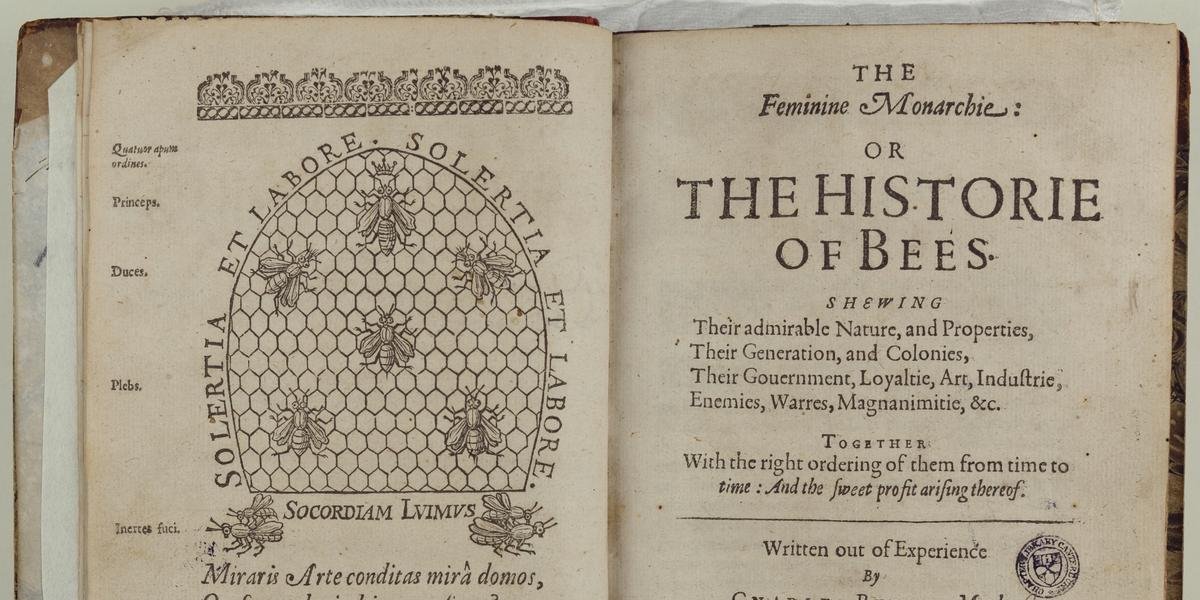
Next, the “telling of the bees” is discussed, that is, a custom whereby those who kept hives would announce the death of a family members to their bees so they might participate symbolically in the mourning process. Also included are a number of newspaper stories of bees that seemed more than eager to participate in funerals.
We wrap up with a look at “mad honey,” a psychoactive type of honey, the effects of which are produced by a compounds called grayanotoxin found in certain plants (the rhododendron, azalea and oleander) from which bees have gathered nectar. Caveat emptor!
Medusa and the Gorgons
Medusa was one of the Gorgons, creatures originally considered quite monstrous, who over the centuries came to be humanized and even regarded as beauties transformed into snake-haired villains. In this episode, we’ll dig back to the most ancient sources to examine the bare bones of the myth.
We begin with a nod or two to the pop-culture Medusa. Oddly, one of the first big-screen appearances of a Gorgon did not represent Medusa herself but a sister, whose spirit takes bodily form to terrorize a 19th-century German town. It’s a 1964 Hammer Film featuring both Christopher Lee and Peter Cushing called, The Gorgon, a rare deviation from the studio’s habit of remaking Universal horror films. We hear a bit from the film’s trailer.
However, the film that did the most to fix the character of Medusa in the minds of audiences seems to be 1981’s The Clash of the Titans. It follows (quite loosely) the adventures of Perseus as he battles, among other things, Medusa, and a sea monster, Kitos in the Greek stories, but oddly given the Scandinavian name “Kraken” for the film.
Clash of the Titans is best remembered as the swan song of stop-motion wizard Ray Harryhausen, a nostalgic advantage that was hard to compete with when its ill-fated 2010 sequel was produced. We discuss some variances with the classical mythology and between adaptations and hear bits from the 1981 and 2010 trailers as well as a snippet of Percy Jackson & the Olympians (2010),which offered a modern incarnation of the figure of Medusa for kids.
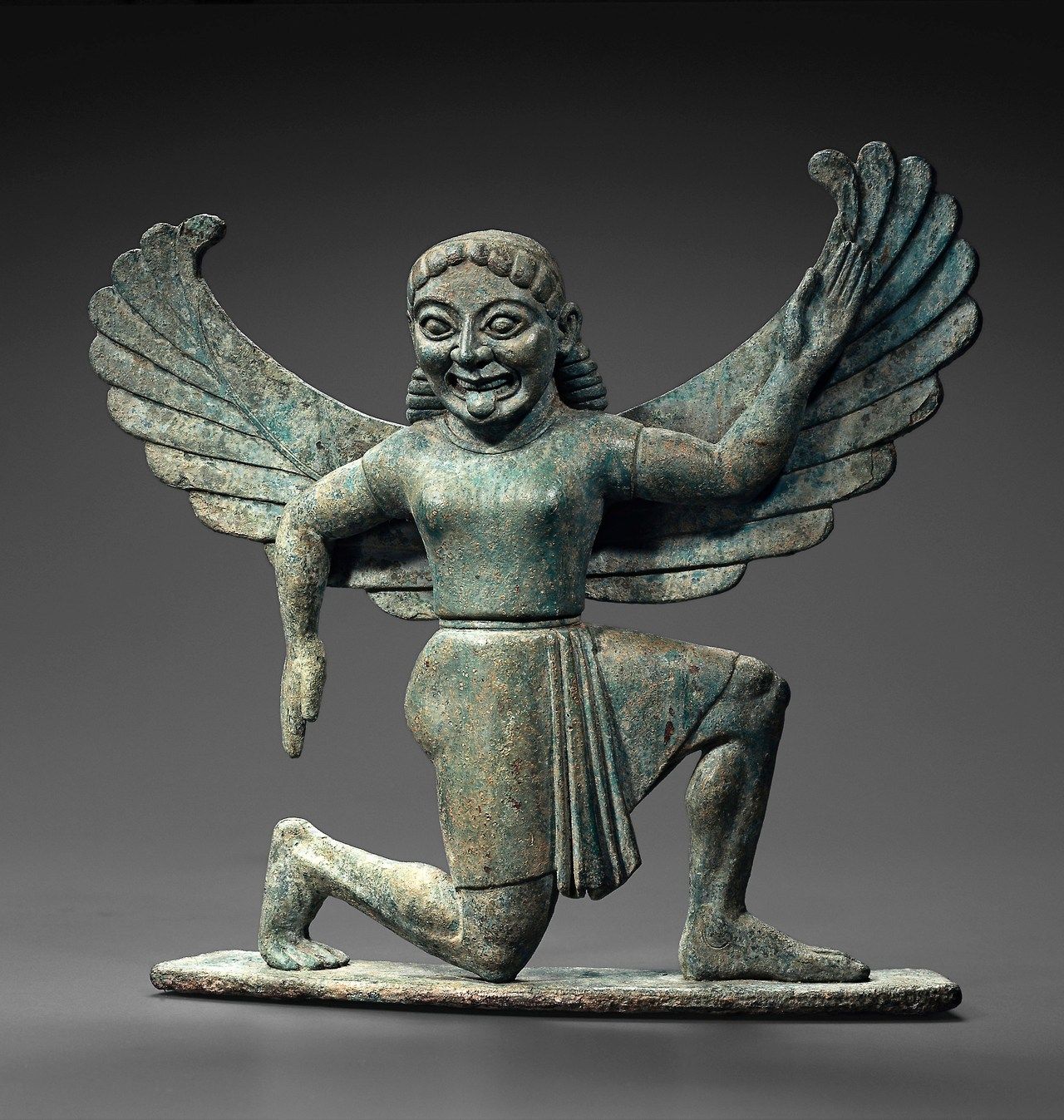
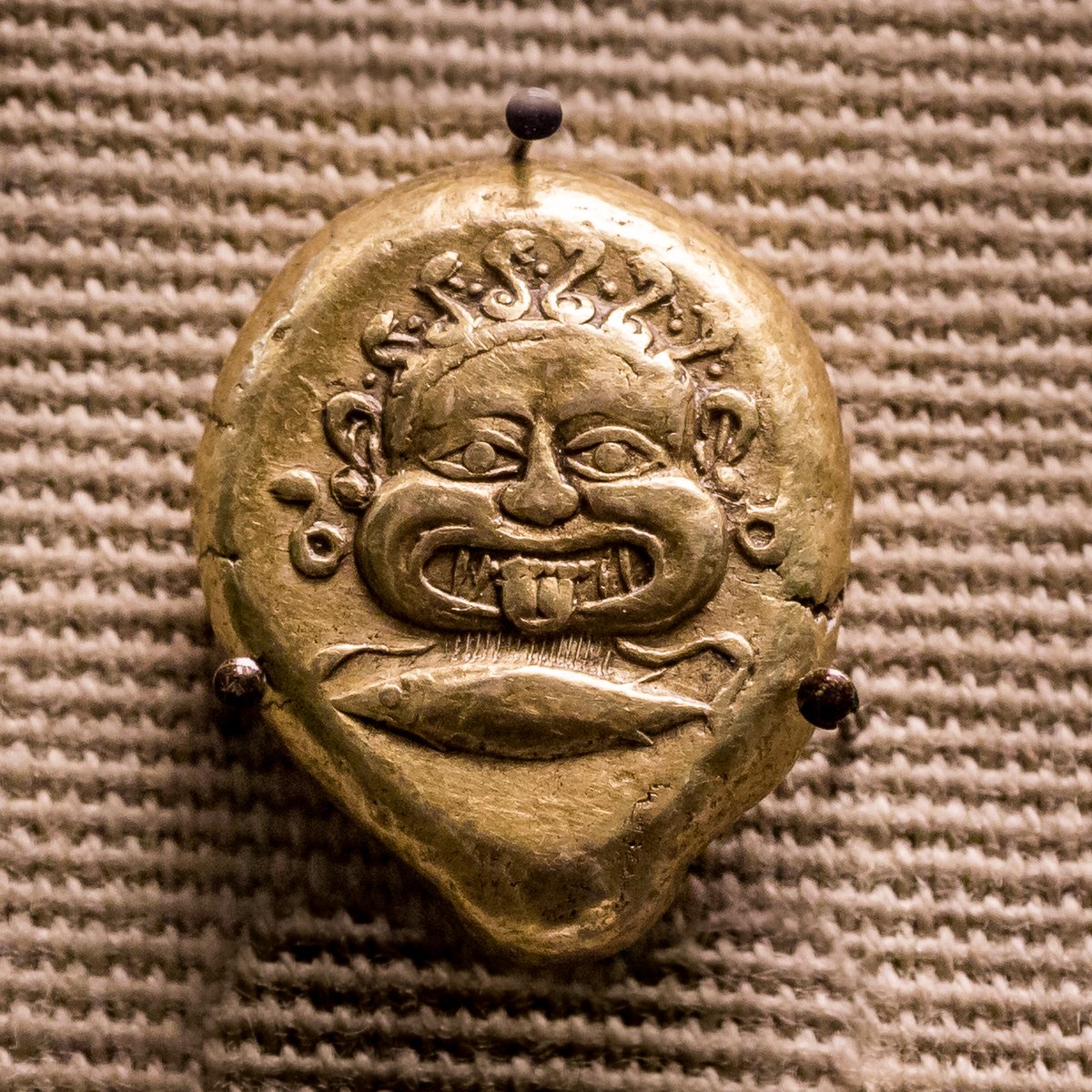
Next we have a look at the classical mythology of the Gorgons, creatures most famous for their hair of snakes and ability to turn men to stone with their gaze. Their appearance, we learn, was generally described in earliest texts as quite grotesque, characterized by fearsome mouths, tusks, and wings. In art, they were typically represented by disembodied heads, explicitly heads recently severed by the hero Perseus.
Medusa, as many listeners will already know, belongs to the group of creatures called Gorgons, denoting a very very limited set of beings, only three, all sisters. We hear a bit about their individual traits, parentage, and home in some far-off (variously defined) land, where their habitat is usually a cave.
Before examining the story of Perseus vs. Medusa, we look at an aspect to the Gorgon’s story that wasn’t part of the original narrative, but appeared toward the 1st century, an element which became particularly important in how Medusa is embraced in more recent culture, namely an explanation for her snakey hair involving a curse laid upon her by Athena.
Next we get some background on Perseus, the strange way in which he was fathered by Zeus and a mortal woman, and the circumstances that brought him to an island where King Polydektes sends him on his quest to obtain the Gorgon’s head (note to self: avoid boastful talk).
To prepare himself for this encounter, Perseus must seek out the Graeae, or “grey ones,” a triad of crone-like sisters who know the ways of the Gorgons as they share the same parents. Their distinguishing feature is the communal possession of only one eye which each uses in turn, something Perseus is able to turn to his advantage.
In most or many versions of the myth, Perseus is then directed onward to obtain magical tools needed against the Gorgon from the Hesperides, nymphs of the sunset. He receives a special curved sword or sickle, a bag in which the head is to be carried, winged sandals from Hermes, and a helmet of invisibility from Hades. Sometimes he also receives a polished shield allowing him to view the Gorgon indirectly as a reflection and thereby avoid her deadly gaze.
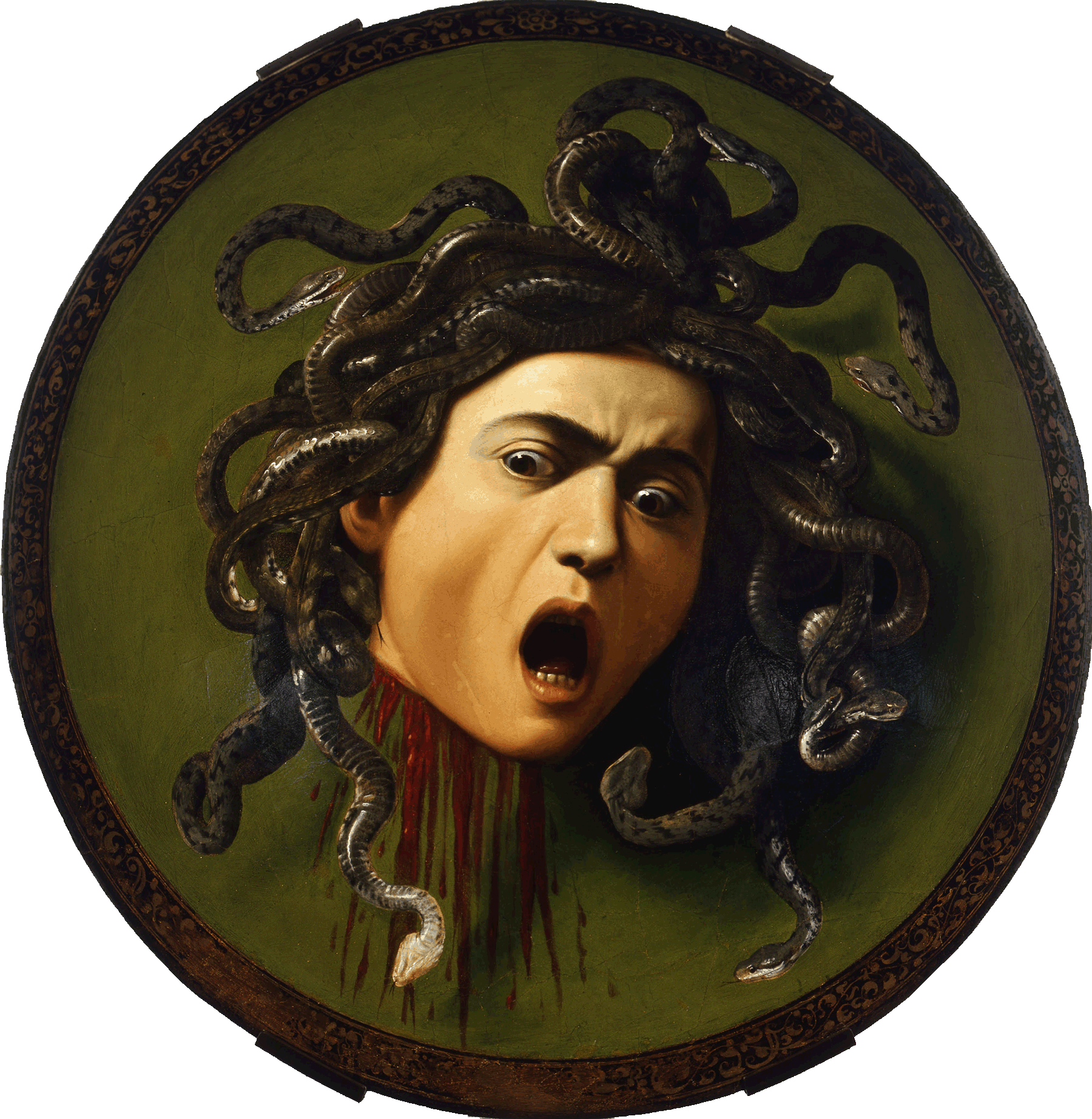
The decapitation of Medusa in the classical story is a bit uneventful as Perseus finds the Gorgon asleep and easy prey when he arrives at their cave, but on the way back to present the head to King Polydektes, he does make time to battle a sea monster, Kitos (the cinematic “Kraken”) Mrs. Karswell reads for us a dramatic telling of this tale by Ovid.
After decapitating Medusa, Perseus makes good use of the head, which handily retains its petrifying powers. A few accounts of encounters involving this weapon are also shared with listeners.
Stepping back from the myth itself, we have a look at the use of the Gorgon’s head as a symbol of power and intimidation in ancient Greek culture, something called the aegis when worn by mythological beings (Athena and Zeus primarily) and called a gorgoneion when employed by mortals as an apotropaic charm against evil.
We wrap up the show with a look at two completely bizarre Filipino films from the ’70s featuring, if not Medusa herself, an actress outfitted much like her (dangerously so, it seems, as live snakes were used.) The first goes by a number of names, but most often, Devil Woman (1970), and the even stranger sequel is Bruka Queen of Evil (1973). As they are Filipino-Hong-Kong co-productions, they feature lots of martial arts scenes, as well as a witch with human head and snake body, an army of midgets, and battles with basement-budget walking trees and bat people.
.
The Lover’s Head
The motif of lovers retaining the head of a decapitated partner is surprisingly widespread. In this — our romantic Valentine’s Day episode — we have a look at old ballads, literature, fairy tales, legends, and even a few historical anecdotes in which such things occur.
We begin with the English murder ballad, “In Bruton Town,” also known as “The Bramble Briar,” “The Jealous Brothers,” or “The Constant Farmer’s Son.” It might seem a strange inclusion at first as there is actually no decapitated lover in the song, but it’s widely recognized by scholars as having derived from a 14th-century story identical in all other elements of the narrative. Though no heads are removed, there is a murder, namely that of a suitor courting the sister of two brothers who find his social status unacceptable (as well as the fact that he is slipping into their sister’s bedroom along the way). There is also a visitation by the ghost of the dead lover, in which he reveals the location of his corpse, with whom the woman lives for three days in the woods before being forced home by hunger — all of which may remind some listeners to the lover’s ghost in “Fair Margaret and Sweet William” discussed in our Undead Lovers episode. The segment begins with a snippet from a version of the song given a enthusiastically gothic treatment by The Transmutations. The a cappella version is by A.L. Lloyd.
The probable source story for the ballad is from Giovanni Boccaccio’s Decameron, a tale told to entertain her fellow travelers by Filomena, one of the refugees fleeing plague-stricken Florence in the novel’s frame story. She describes the tragic romance of Lisabetta and Lorenzo. As in our ballad, Lorenzo is an unworthy suitor engaging in secret rendezvous with Lisabetta, whose brothers are similarly protective of her and their sister and family status. Lorenzo meets his end when invited by the brothers to join them on an excursion out beyond the city. He later appears in a dream to reveal the location of his corpse.
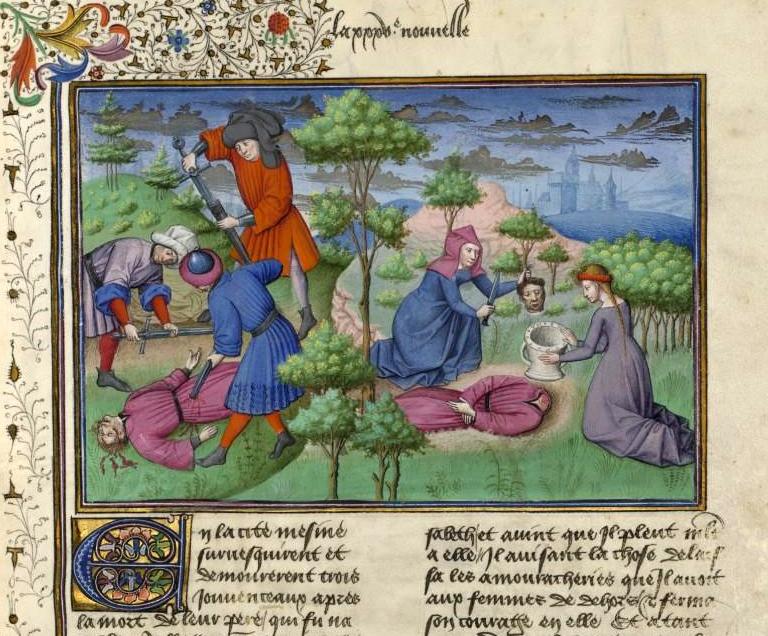
As she grieves over her lover’s body, Lisabetta recognizes that she is physically unable to transport it back for burial, and so does the next best thing, removing the head with a handy razor. The rest of the story relates how the head is hidden in pot planted with basil, the discovery of which causes the brothers to flee from justice. Mrs. Karswell reads for us all the grisly details Boccaccio provides.
Roughly three centuries later, we find a lover’s remains planted in a pot in Italian poet Giambattista Basile’s Pentamerone or “The Tale of Tales,” perhaps the earliest compilation of European fairy tales. The story, “The Myrtle,” presents a fairy who lives in a sprig of mirtle kept by a prince who nightly makes love to her as when she assumes a human form. When she is murdered by jealous rivals, the prince’s servant mops up her bloody remains and dumps them in the pot where they regenerate through the mirtle. The understandably annoyed fairy sees to it that her would-be assassins meet a fitting fate.
We then take a quick look at other writers who picked up Boccaccio’s tale, including the 16th-century German playwright Hans Sachs and 19th-century English poet John Keats (“Isabella, or the Pot of Basil”). The derivation of the folk ballad may have come through an English version of Sach’s play, but there’s no documentation to prove this.
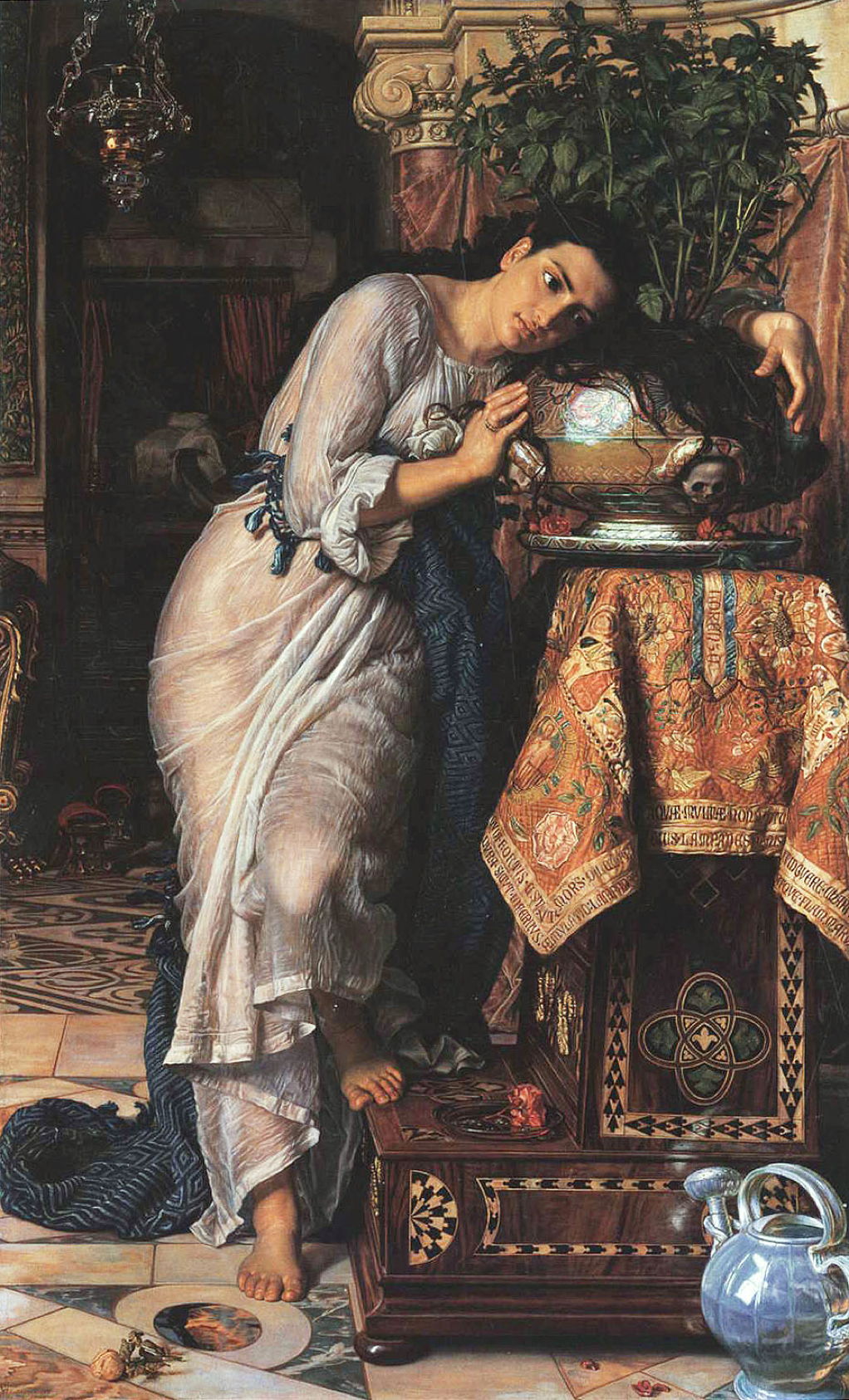
Another interesting iteration of the story comes from Denmark, from the pen of Hans Christian Andersen — from his 1872 story “The Rose-Elf,” or “The Elf of the Rose.” This one tells much the same tale, but presents it through the eyes of an invisibly small elf who occupies a rose, and later a leaf in the tree under which the murderer buries the lover’s body. While the elf may have been inserted in an effort to position the tale as one for children, the story is grim even by Andersen standards.
We then examine a couple historical cases of loved one’s heads kept as postmortem mementos, among these, the head of Sir Walter Raleigh kept after his beheading by his wife Elizabeth Throckmorton and that of Thomas More kept not by his wife but his daughter, Margaret Roper.
Next up, a few tales of the preserved heads of lovers serving as objects of terror and disgust rather than romantic attachment. The first is that of Arthur and Gorlagon, one probably composed in 14th-century Wales. It’s a truly weird narrative, so much so that some scholars have suggested it was composed as a joke or parody.
Without giving too much away, the story (which we hear at length) is perhaps best described an Arthurian Shaggy Dog story, a werewolf story actually, one that meanders in the classic shaggy-dog mode and likewise can’t be expected to deliver the anticipated payoff, though it does provide us the preserved head of a deceased lover.
A similar tale with an embalmed head employed as an ever-present, shaming reminder of a wife’s infidelity is found in The Palace of Pleasure a collection of stories by John Painter published in several volumes first appearing in 1566. This one features a pleasingly gothic scene of a black-clad woman with shaven head employing some rather gruesome tableware.
We wrap up with the tale of Willem Mons, an unfortunate lover of Catherine the Great who lost his head (though Catherine hung on to it) and the 2016 story of Davie Dauzat of Bellmont, Texas, who decided the family freezer would be a good place to retain the head of the wife he decapitated. The closing song snippet is by Arrogant Worms.
Waxworks
The macabre feelings stirred by waxwork figures go far beyond their use in horror films, back to the Terror of the French Revolution, and beyond to their use as funeral effigies and in magic rites of popular Italian Catholicism and Roman-Etruscan witchcraft.
We begin with a brief look at wax museums in horror cinema (going back to 1907). The most famous example, 1953’s House of Wax, not only created Vincent Price as a horror actor, but pioneered the use of 3D. It happened to be a remake of 1933’s Mystery of the Wax Museum, coincidentally another technological pioneer thanks to the film’s use of Technicolor’s early 2-color process. Offering a few more comments on horror films in this genre, we note some common themes: wax figures created over human remains, waxworks as uncanny, liminal presences, neither living nor dead (though being alive enough to kill you), and madness or death awaiting one who accepts the challenge to overnight in a wax museum. All of these have historic roots reaching far beyond their cinematic iterations.
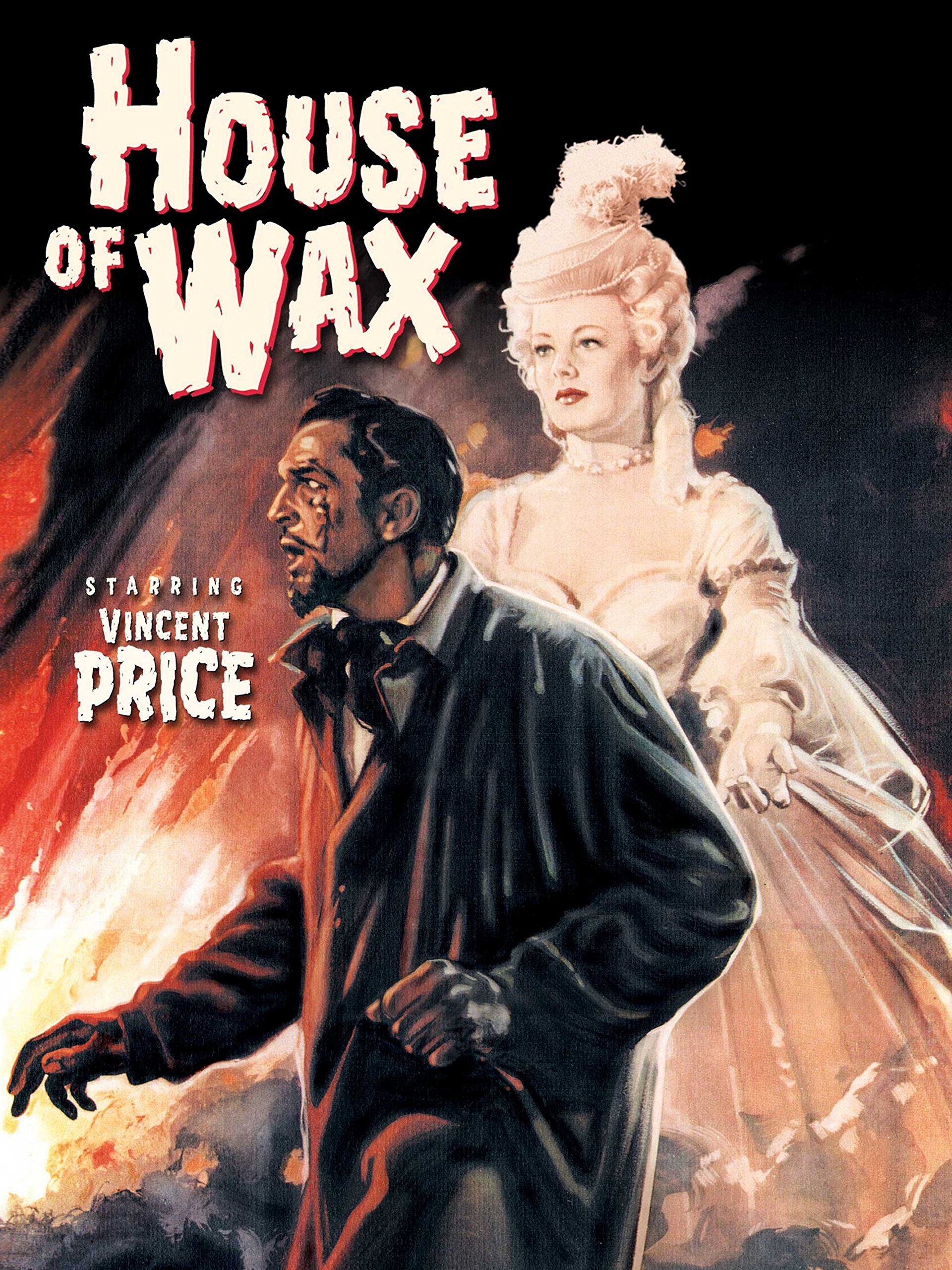
A final commonality is the presence of waxworks murderers and representations of historic villains and villainy, with a particular emphasis on the French Revolution. Naturally, this brings us to a central figure in our story, Madame (Marie) Tussaud, whose name has become synonymous with waxworks.
Her story begins, however, not in France, but in Switzerland, where as a child she began assisting the wax modeler Philippe Curtius, whom her mother served as housekeeper. Her move to France came when the Prince of Conti invited Curtius, his assistant and domestic to join an artistic circle he sponsored in Paris.
Through the Prince’s connections, Curtius and Tussaud entered elite circles, including the court at Versailles, this thanks to Louis XVI’s sister, Madame Elizabeth, who sought out Tussaud as a mentor to help her create religious figurines in wax. When the Revolution broke out, Tussaud and Curtius were called upon to demonstrate anti-royalist sympathies by documenting the Revolution’s victories. This meant crafting likenesses of heads that tumbled from the guillotine, to be carried on pikes or displayed on trophies. This could be particularly gruesome work given the empathy Tussaud had developed with contacts at the court, as we hear in a grim passage from Tussaud’s Memoirs, read by Mrs. Karswell.

In 1804, when Tussaud accepted an invitation to display waxworks in London (and was later prevented from returning to France by the Napoleonic Wars), she brought with her Curtius’ concept of a discrete room dedicated to the infamous. His “Den of Thieves” became the “Chamber of Horrors” central to Tussaud’s fame in London and later the world. The Victorian’s fascination with murder and executions discussed in our “Gallows” and “Gibbet” episodes was enthusiastically exploited by Tussaud, and we hear some amusing details and contemporary criticism of all this from the magazine Punch.
Tussaud was by no means to the first to display waxworks or even waxwork horrors in England. We have a look at some earlier innovators, including a “Mrs. Salmon” whose work illustrating some rather bizarre legends was shown on Fleet Street, a popular 18th/19th-century location for waxworks exhibitors once they had graduated from installing traveling displays at Fairs.
Charles Dickens gives us a taste of the life of traveling waxworks exhibitors in his 1840 novel The Old Curiosity Shop, which features and impresario named Mrs. Jarel clearly inspired by Tussaud. We hear a passage from that and several more from an obscure 1896 non-fiction work containing a trove of information on the waxwork business in 19th-century England: Joe Smith and his Waxworks. In particular, we hear more about the public’s hunger for murderers and how that is best accommodated.

Our association of waxworks with the macabre also would seem to have to do with their historical use as funeral effigies. We have a look at the practice (dating to 1377) of crafting wax and wood stand-ins for England’s royal funerals and how their post-funeral display in the crypts of Westminster Cathedral by the 1800s had evolved into what might be considered England’s oldest wax museum. Along the way, we hear a strange anecdote of these wax monarchs showing up in the Piccadilly tube station and of similar effigies in France being treated like living humans in quite surprising ways.
Another forerunner of the wax museum can be found in Italian Catholicism, in particular, with the creation of votive offerings left at shrines to represent prayers that have been answered. A common form of these, representing relief from medical afflictions, are small wax models of the afflicted body part miraculously healed. But wax arms, hearts, feet, and hands are only the beginning. Full figures — wood and paper mâché bodies with wax heads and hands, and dressed in the wardrobe of the person commissioning the figure — once populated certain churches.
We discuss a few examples of this including the Basilica of the Most Holy Annunciation (the Annunziata) in Florence and The Shrine of Our Lady of Grace (Le Grazie) near the town of Mantua in Lombardy. The first no longer exhibits these figures but was described by a 16th century Dutch visitor as resembling “a field of cadavers.” The second also features the taxidermied remains of a crocodile suspended over the sanctuary.
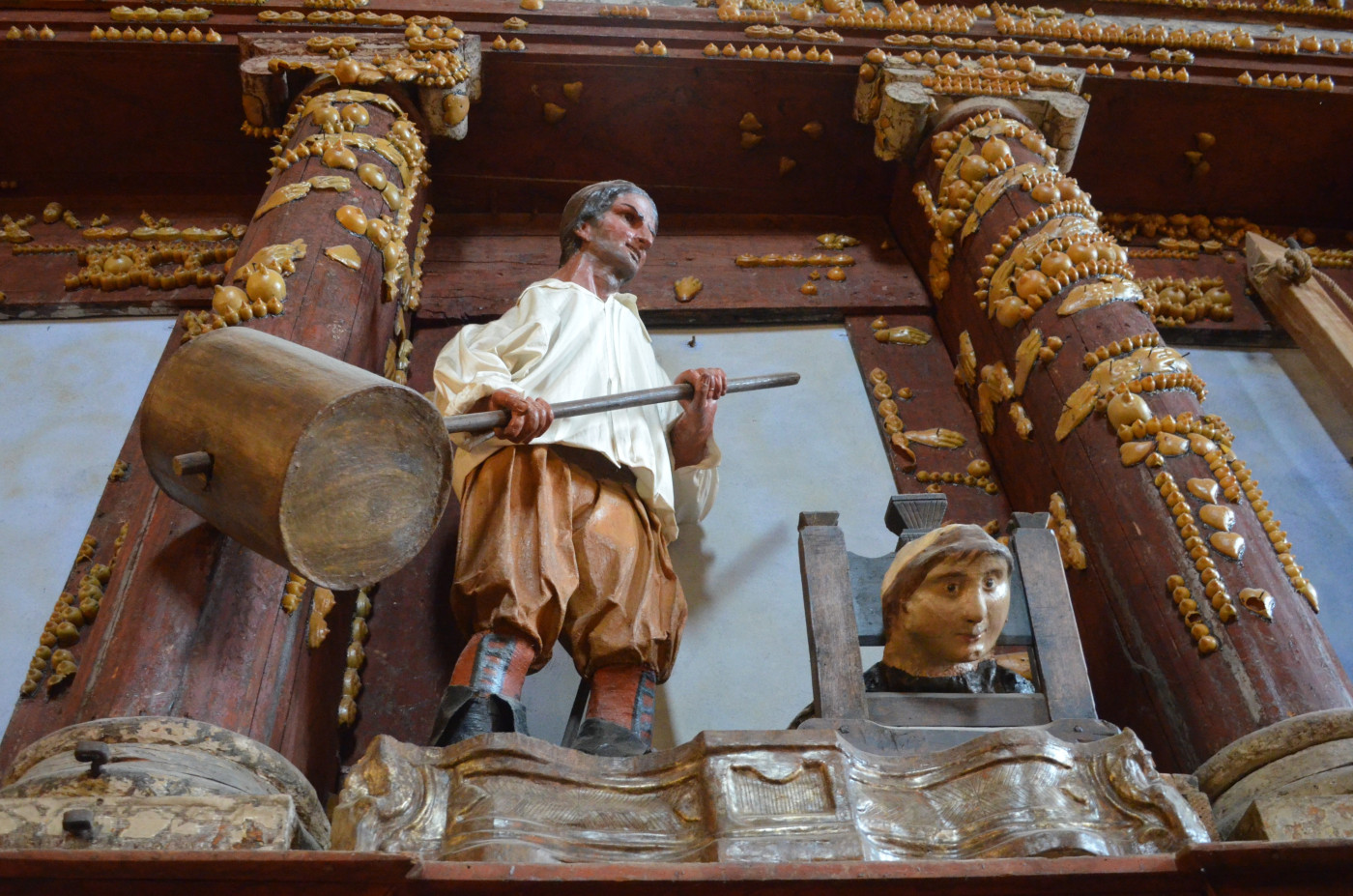
Scholars, including the art historian Aby Warburg, have commented on the similarity between these votive wax figures an figurines used in sympathetic magic. Illustrative of this: in Florence, when political tides changed, the removal of a disfavored person from the Annunziata would be referred to as a “killing.”
Connections with Etruscan magic, the source of magical practice and witchcraft belief in ancient Rome is also discussed in this context. As are the Romans’ use of wax funeral masks representing the ancestors and a wax effigy created for the funeral for Julius Caesar, one which was partially mechanized and sported realistic wounds from his assassination. Perfect for a Chamber of Horrors!
We wrap up the show with a bit of later history on Madame Tussauds, a talking parrot, and a strange birthday party celebrated in 1969 by Vincent Price and Christopher Lee.
A Christmas Ghost Story
Four our third year, we embrace the old tradition of seasonal ghost-storytelling. This year Mrs. Karswell reads for us a tale written by Edmund Gill Swain, from his 1912 collection Stoneground Ghost Tales (“Stoneground” here being the name of a particularly haunted but fictional English village.)
Swain was a Cambridge colleague of M.R. James, the master of the modern ghost story and proponent of Christmas as a time for telling ghostly tales. We heard a story of his in our 2018 Christmas episode, and a supernatural story written by Dickens’ (not the one you’re thinking) in our 2019 show, should you want to check those out too.
Terrible Tales for Terrible Tots
Books of cautionary stories for children were a popular Christmas gift in Victorian times. These tales of misbehaving children and the tragic consequences of their deeds, like the Krampus myth, served as not-so subtle reminders of parental expectations.
This episode consists mainly of readings by your host and Mrs. Karswell of these grim (and amusing) stories intended to be enjoyed along with a hot cup of cocoa, eggnog or the more dangerous adult concoctions of the season.
We begin with an example from Jane & Ann Taylor’s 1800 publication Original Poems for Infant Minds. The Taylor sisters’ 1806 sequel to the book, Rhymes for the Nursery, happened to include a poem called “The Star,” providing the lyric to the “Twinkle, Twinkle Little Star,” which we hear interpreted from a 2019 album called, naturally, Possessed Children: Creepy Nursery Rhymes.
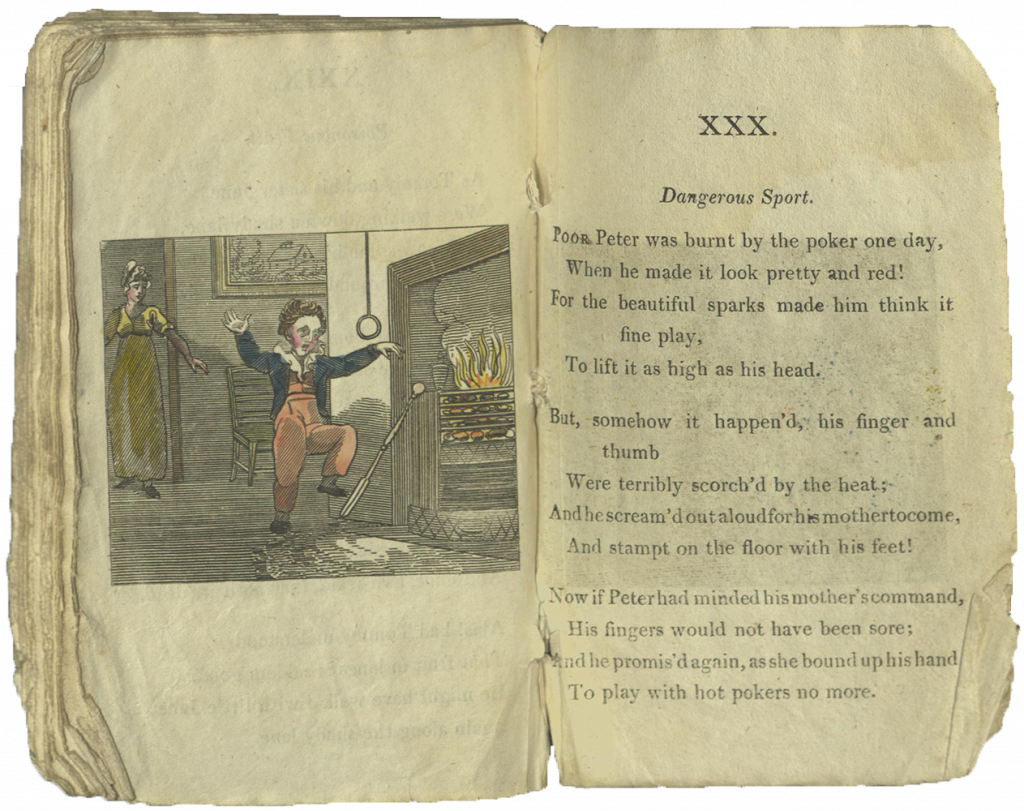
We also hear a poem about a lad who embraces a hot poker as a toy, one from Elizabeth Turner’s 1807 collection The Daisy or, Cautionary Stories in Verse, adapted to Ideas of Children from Four to Eight Years Old.
Then we turn to the mother of all cautionary tales for children, known to many simply as “that scary German children’s book,” but actually titled Der Struwwelpeter, Merry Tales and Funny Pictures for Good Little Folks. Written in 1854 by Heinrich Hoffmann, Der Struwwelpeter (“un-groomed Peter”) pairs charmingly awkward drawings executed by the writer himself with tales of children who play with matches, refuse to eat, suck their thumbs, torment animals, or commit other childish misdemeanors meet ghastly fates.
Created for Hoffmann’s three-year old son as a Christmas gift, Der Struwwelpeter’s opening page identifies the book as one specifically to be given at Christmas, to well-behaved children exclusively.
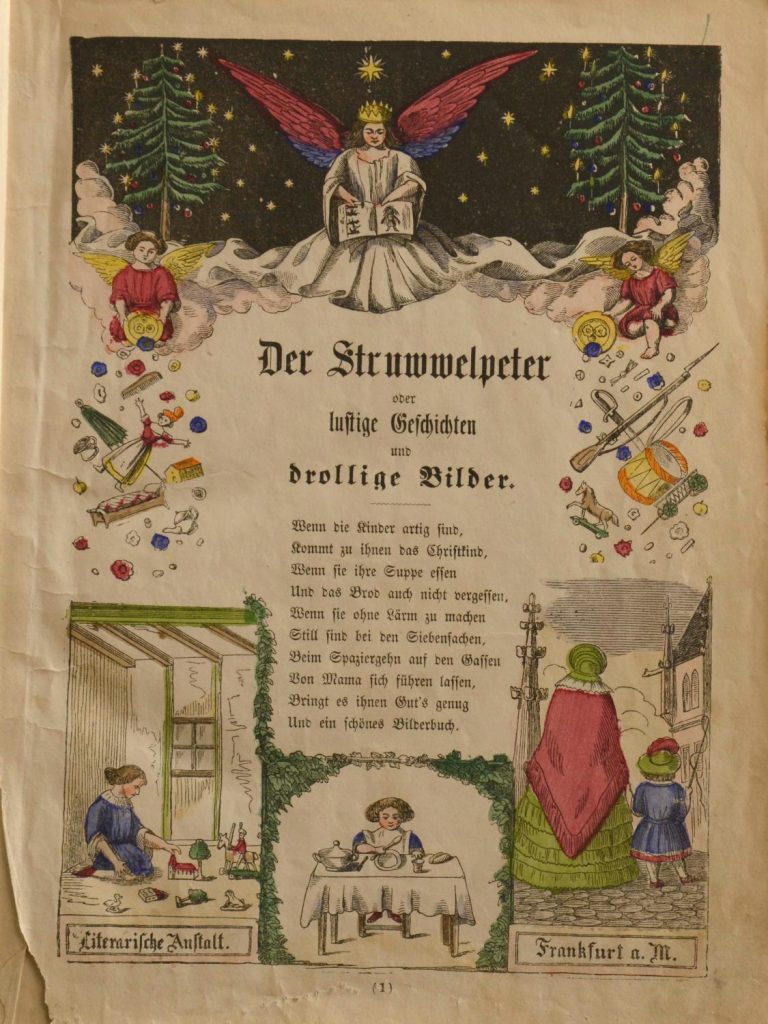
We hear a clip of this introductory poem set to music by the British punk-cabaret artists The Tiger Lillies, as part of their 1998 opera Shockheaded Peter.
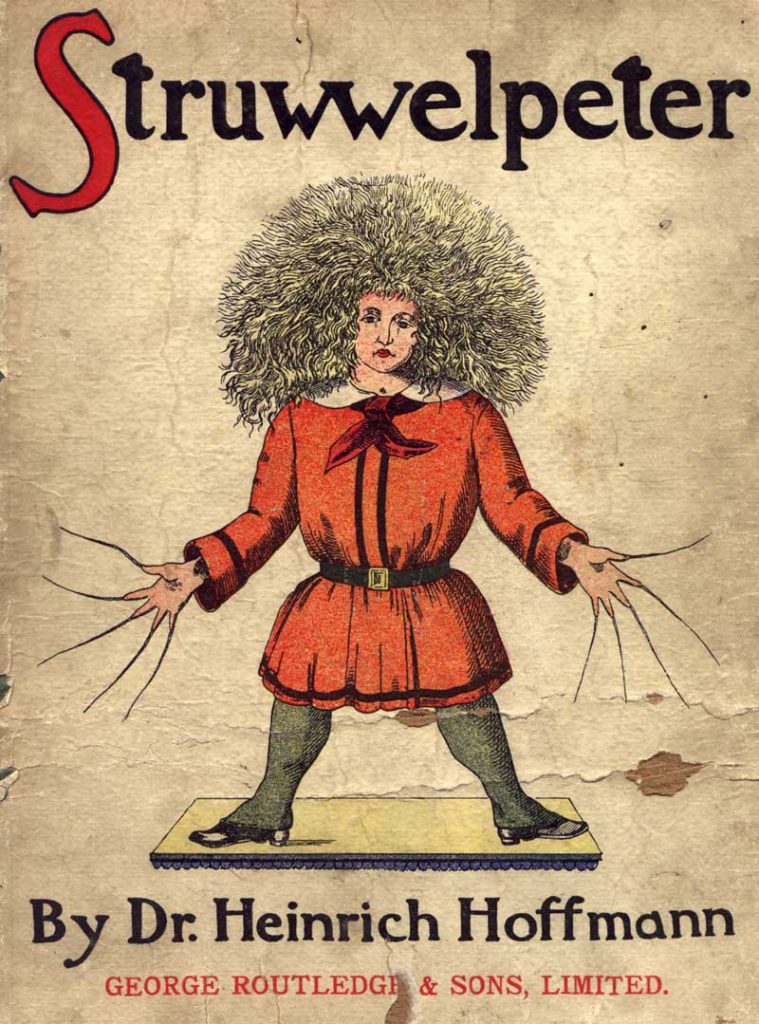
Der Struwwelpeter went on to inspire all manner of imitations in Germany, England, and particularly in America. We hear a few examples of these including one from the most famous volume inspired by this book, Max and Moritz, A Tale of Seven Boyish Pranks, written and illustrated in 1865 by Wilhelm Busch.
Our last author in this genre, one whose intent was actually to exaggerate and parody the pedantic tone of the Victorians was Hilaire Belloc, a friend of H.G. Wells and George Bernard Shaw. His first book of this type, whimsically illustrated by his friend Basil T. Blackwood, was The Bad Child’s Book of Beasts (1896), followed a year later by More Beasts (for Worse Children). Longer, more dreadful stories appear in the verses of his 1907 book, Cautionary Tales for Children, Designed for the Admonition of Children between the ages of eight and fourteen years, from which we hear a number of fine examples. Edward Gorey recognized a kindred spirit in the collection illustrating a version published posthumously in 2002.

The Hellish Harlequin: Phantom Hordes to Father Christmas
Harlequin is an enigmatic figure with roots in dark folklore of France, specifically that of the Wild Hunt (Chasse Sauvage) a nocturnal procession of ghosts or devils, particularly associated with the time around Christmas and New Year. The myth is also common to England and examined more closely in its Germanic manifestation in Episode 16, “The Haunted Season.” We open with a snippet from an album dedicated to Hellequin’s folkore by a Belgian band called Maisnée d’Hellequin.
In the show, we trace a thread leading from medieval stories of Hellequin (Harleqin’s ancestor in France) and King Herla (the English equivalent) to the more recent theatrical figure of Harlequin, along the way examining a link with the traditional English Christmas play (mummers’ play) and its role in the evolution of the figure of Father Christmas.
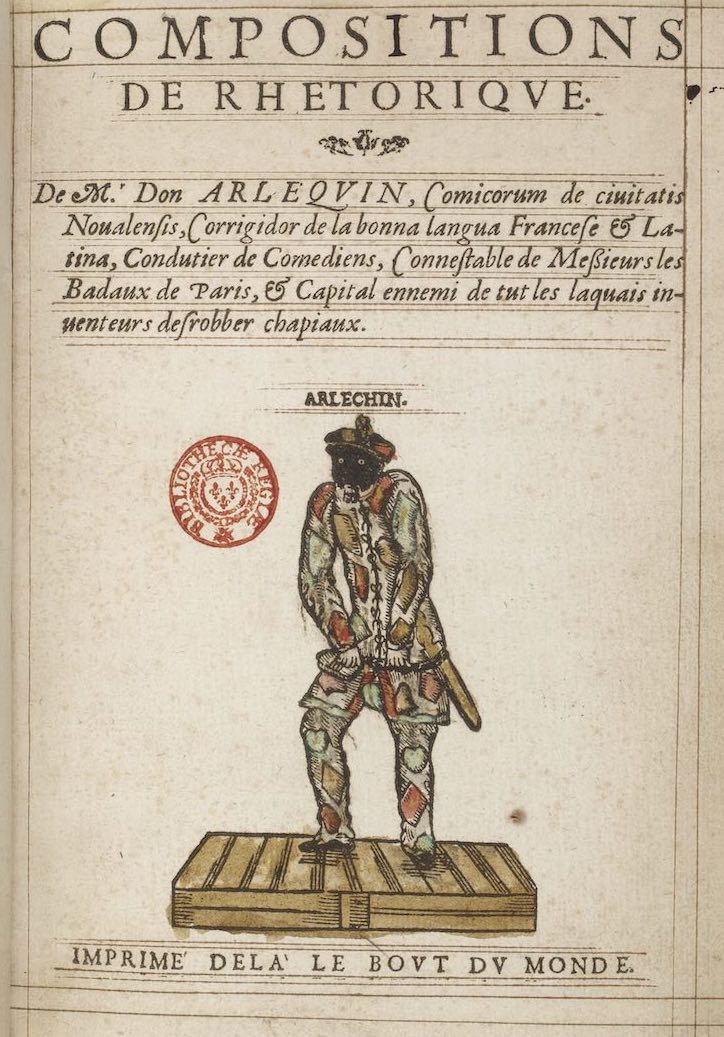
Our first story comes from the French-Norman monk Oderic Vitalis, from volume two of his Ecclesiastical History. It was written in about 1140, making it not only the first account mentioning Hellequin (“Herlequin” in his text) but also the first European ghost story, one Vitalis relates as a true event transpiring on New Year’s Eve 1091, and told to him by an eyewitness, a priest, by the name of Vauquilin (Walkelin).
While returning from a visit to an ailing member of his parish, Vauquilin, hears the thunder of what sounds like an approaching army and is met by a giant with a club, whom he recognizes as Hellequin and who in this case serves as a sort of herald of the ghostly crew that follows. It’s a richly detailed and extravagantly ghoulish tale, splendidly read by our own Mrs. Karswell.
Without giving away too much, suffice it to say, that the spirits Vauquilin sees passing are enduring a sort of purgatorial torment for past sins, an apparently temporary but unenviable state of earthbound damnation. (For more on medival tales of ghosts visiting mortals from purgatory, see our “Ghosts from Purgatory” episode.) In the procession, these sinners are accompanied by devils who torture them, chief among these, apparently Hellequin.
Our next story, from around 1190 paints a more detailed picture of the English version of Hellequin, King Herla. It was written in Wales by the courtier Walter Map and contained in his eccentric collection of myths and pseudo-historical anecdotes called De Nugis Curialium, or “trifles for the court.” This one’s more of an origin story explaining King Herla’s transition from mortal king to ghostly rider. I won’t give away the details on this one either, but it involves a dwarf king’s wedding party inside a mountain, parting gifts, and bad gift etiquette.
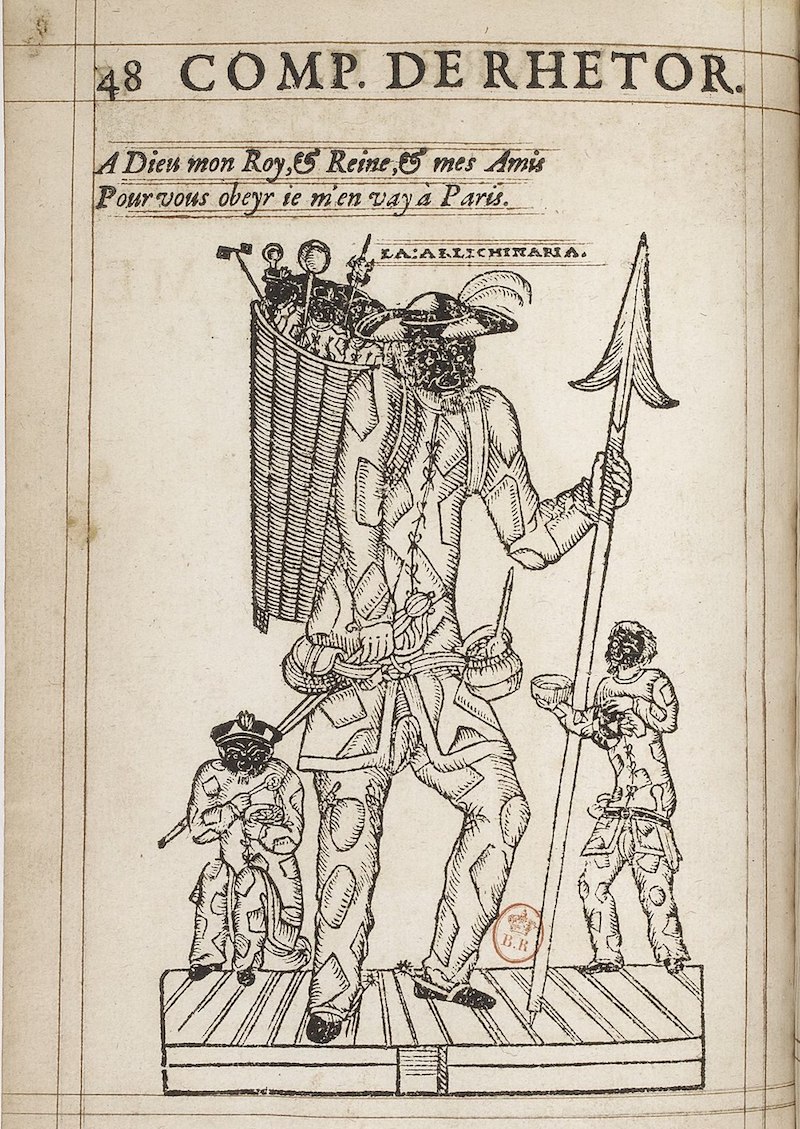
Our third story comes from 14th-century France and is a bit different as it doesn’t describe what are supposed to be supernatural events but a representation of this, a fictional procession imitating Hellequin’s ride.
The procession in this text takes the form of a charivari, a sort of parade with participants noisily banging pots and pans or playing discordant music on various instruments. Charivaris were most commonly occasioned by weddings, in particular those which defied some social convention, such as the rushed wedding of a widow or widower who not honoring a suitable period of mourning.
In our story, the wedding is that of a figure named Fauvel, who is marrying the allegorical figure of Vainglory. Fauvel, by the way, is a horse representing all the worst traits of social climbers of the day.
The satiric Romance of Fauvel (“Romance” = “novel”) was written in 1316 by a Gervais du Bus, then much enlarged in 1316 with additions, including our charivari scene, by another writer by the name of de Pesstain. The text describes a particularly carnivalesque scene including a bizarre, wheeled noise-making machine, and all sorts of taboo-breaking behavior by the participants. The connection between the Wild Hunt and carnival is also noted in an 18th-century German carnival procession we hear described, one mimicking in this case Frau Holde and her retinue. The Fauvel passage ends with the narrator encountering a giant recognized as Hellequin, who is bringing up the rear — leading from behind in this case.
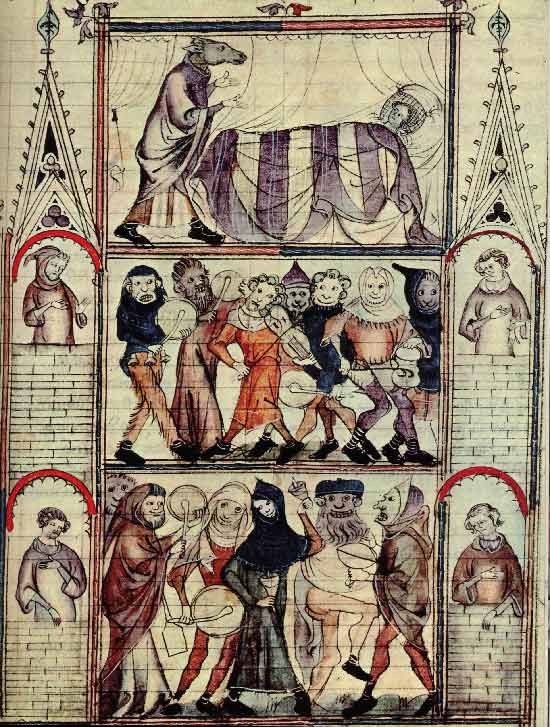
We then have a look at the theatrical, Harlequin who originated in the 16th century as a stock figure from the Italian commedia della’arte, where he’s known as Arlecchino. He wears a black half-mask along with a suit sewn with multicolored diamonds. And he always carries a sort of short club, an element that seems to be borrowed from the diabolical Hellequin. Though he’s most well known as an Italian figure, Arlecchino seems to have his source, as a theatrical entity, in a devil of this name from medieval French mystery plays. We also look at some supernatural Hellquins in secular plays including a 13th-century work by the Norman poet Bourdet and the satiric work, Le Jeu de la feuillée by Adam de la Halle.
We then follow the theatrical Harlequin to England where in the 18th century, the commedia plays morphed into were called “harliquinades,” frothy comedies, which eventually evolved into the British tradition of Christmas pantos/pantomimes.
We also examine a little remarked upon influence of the commedia and harliquinades on England’s seasonal mummer’s plays, particularly the traditional Christmas Play. An echo of Arlecchino’s trademark slapstick, or club, along with a mumming character called “Father Beelzebub” helps us connect the character of Father Christmas found in these plays with the devilish old Hellequin/Herla of French and Anglo-Norman folklore.
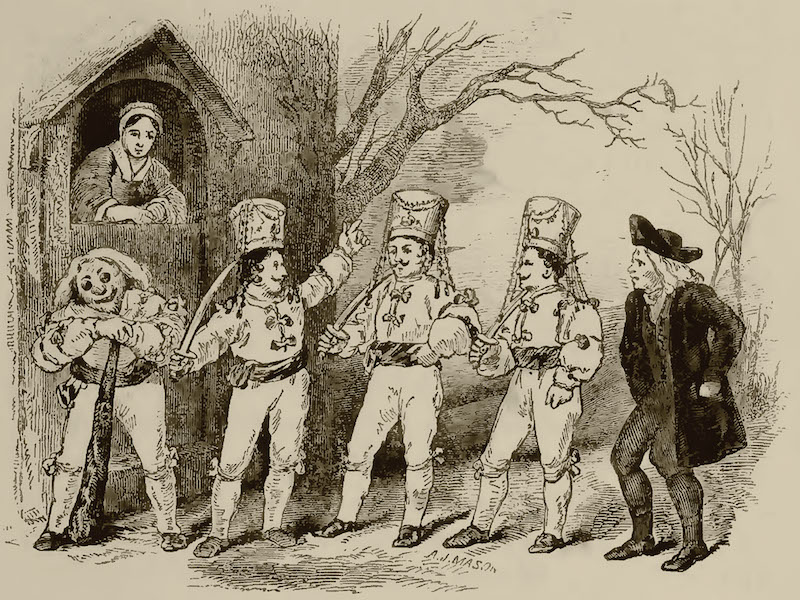
Witchcraft in Southern Italy
In southern Italy, belief in witchcraft has a long history, much of it centering on the town of Benevento, about 30 miles east of Naples.
From a 1428 testimony by accused witch Matteuccia da Todi, we have the first mention (anywhere in Europe) of witches flying to their sabbats — their gathering spot, in this case, being Benevento. Matteuccia was also the first to speak of flying ointment as a means to achieve this. We include a musical setting by the southern Italian band Janara of the incantation that was spoken while applying the ointment.
Sermons of the Franciscan monk Bernardino of Siena seems to have introduced the idea of Benevento as a mecca for witches, mentioning a certain tree as the center of these gatherings, one later identified as a walnut.
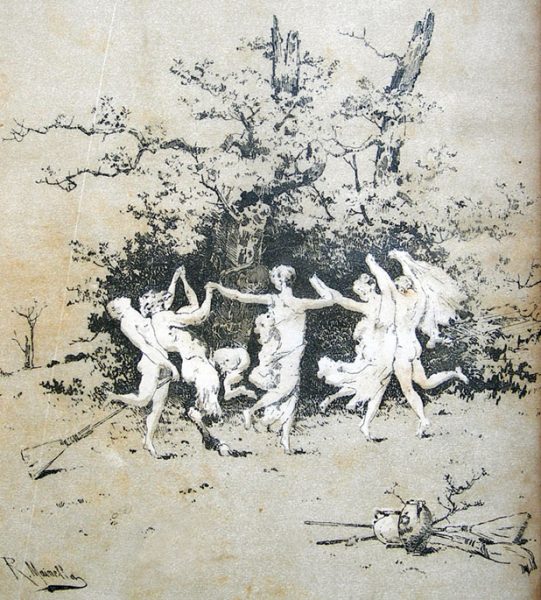
Though no tradition around a specific location for this tree has survived in Benevento, the legend has been wholeheartedly embraced by the local distillers of Strega (witch) liqueur, created in 1833 and now distributed worldwide. This seems to have been part of a 19th-century revival of interest in the legend, which saw the composition of a popular poem, “The Walnut Tree of Benevento,” which added a serpent living in the tree’s branches, and probably inspired Niccolo Paganini to compose his signature piece, Le Streghe, (The Witches) from which we hear a snippet. (Yes, that’s a real clip about Strege liqueur and elections from the film Kitty Foyle).
What really locked down the local mythology was an essay written in 1634 by Benevento’s chielf physician, Pietro Piperno, one titled “On the Magical Walnut Tree of Benevento.” This is the first mention of the species of tree in question. Piperno also places the walnut at the center of a curious rite conducted by the Lombards occupying the region in the 10th century, a rite he sees as a model for the Benevento witch tales of his own day. Mrs. Karswell also reads for us a retelling from Piperno’s text of a hunchback who stumbles upon a sabbat, only to have the hump on his back magically removed.
The discovery of a the ruins of a temple to Isis in Benevento in 1903 led to further speculation as to possible origins of the region’s witchcraft myths, but it was the Roman goddess Diana most strongly associated with southern Italy’s witches, in part because the name used there for a type of witch is janara, believed to come from the Latin dianara, a servant of Diana.
We hear snippet form a 2015 Italian horror film called Janara (retitled in English “The Witch Behind the Door”), a bit about folk practices taken against these night-hag-esque beings, and of their activities at sabbats, which apparently includes dancing La Volta.
Then we hear a tale of “the fishwife of Palermo,” as she’s identified in 1588 trial records of the Sicilian Inquisition. It illustrates an aspect of Italian witch mythology that seems to have absorbed elements of fairy lore, including details such as a beautiful king and queen presiding over nocturnal gatherings.
From Naples we hear the sad tale of the “Witch of Port’Alba,” who was sentenced to a peculiar fate for casting spells on her wedding day, a story involving leaping, bell-wearing witches on the slopes of Mr. Faito on Naple’s southern outskirts, and a story of a witch calming lost souls said to be screaming from the depths of Vesuvius.

We then move beyond the witch of folklore and Inquisitions to the notion of the witch as folk-healer, something very much alive and well, as represented in the short documentaries on Souther Italian magic made in the 1950s-70s by Luigi Di Gianni in conjunction with anthropologist Ernesto de Martino, who was mentioned in our discussion of tarantella possession in our Pied Piper episode. An example of these films would be L’Attaccatura (dialect for fattucchiera, the standard Italian for folk-healer, or literally “fixer.” A whole playlist of the films can be found here, though unless you speak Italian (and local dialects), you’ll have to settle for YouTube’s auto-translate function.
Of great interest to those consulting folk-healers is protection from the evil eye or malocchio. The concept of fascinatura or “binding” is central to the evil eye’s workings, one which happens to be the English title of a 2020 Italian folk-horror film sampled in the discussion.
The driving force of envy said to be behind the evil eye is well illustrated in the spurned lover a the center of the 1963 film Il Demonio, from which we hear excerpts. (In the show, I mistakenly called the film “Demonia” (feminine form), missing the point somewhat as the actual “demonic” forces portrayed might not be those belonging to the rejected female lover and town outcast/witch, but those of the male villagers around her.)
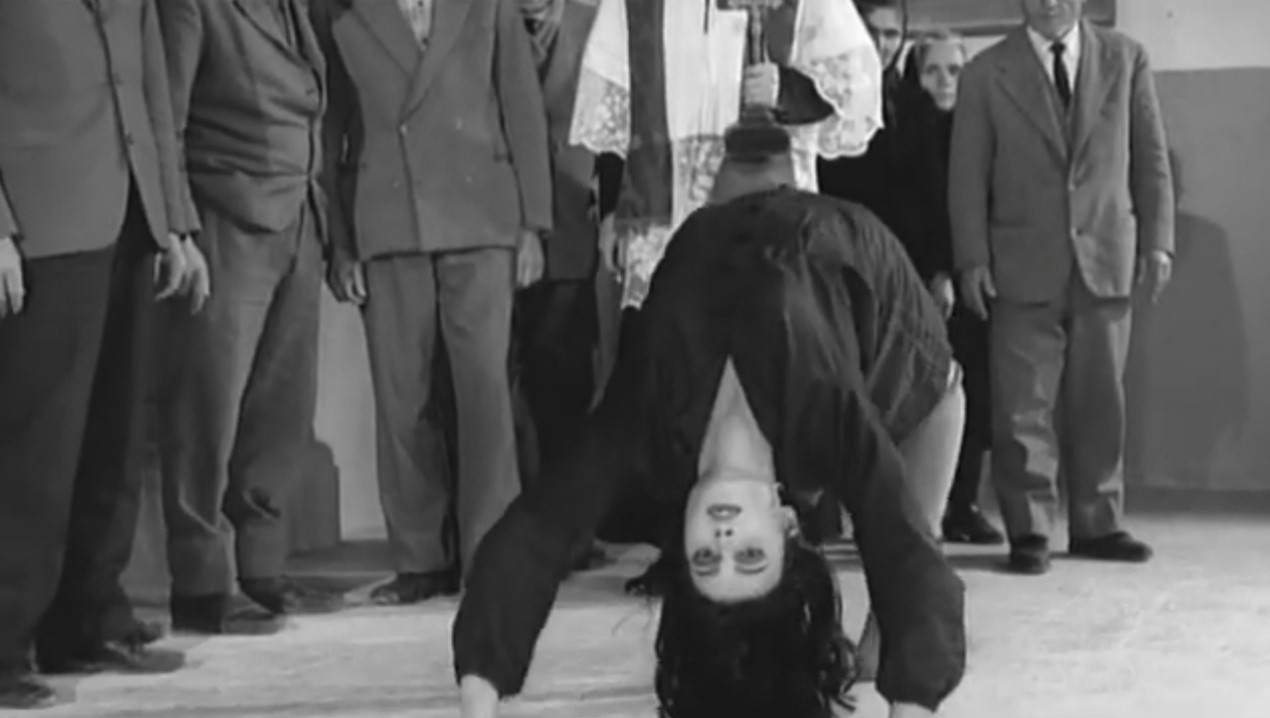
A number of magical charms and gestures prescribed against the evil eye are examined, as are the pazzarielli of Naples, flamboyantly costumed characters who deliver street blessings against the malocchio. Their characteristic cry, “Sciò sciò ciucciuè” (sort of “shoo, bad luck”) is take up as a 1953 song by Nino Taranto, which we hear (along with a Calabrian song about the possessor of the evil eye, the jetattore)

Halloween Bonus Episode
As a short holiday bonus, we’re offering this special episode examining some obscure aspects of Halloween as manifested in our lives today. Forgotten traditions associated with the holiday arise in surprising forms many of us may not initially recognize. Simple occurrences perceived as nothing more than an everyday nuisance come into focus during our holidays – if we are attentive – as something making sense only in the light of old folkways, superstitions, and beliefs. Many of us have had these experiences without considering such context and associated old calendrical celebrations. Halloween, in particular, has drifted far from its original cultural significance, but in recognizing patterns of repetition within history, we may recognize a surprising confluence with the old holidays known to our ancestors and thereby allow ourselves to experience the same, albeit in a modern idiom. Extreme care, however, must be exercised, in such pursuits, which can bring with them bitter lessons in the fragility of our existence.
Spook Shows
Midnight Spook Shows featured stage illusions borrowing from techniques used in fraudulent seances alongside vaudeville-style comedy and burlesque. Performances were staged in movie theaters, paired with a film screening, usually but not exclusively from the horror genre. The tradition began in the mid to late 1930s and ran into the early ’70s, reaching its heyday in the ’50s. After World War II, shows began catering to younger audiences and emphasizing movie monsters, horror and gore.
In this episode we examine the history of the genre and a few of its colorful artists, sometimes called “ghostmasters.” Two leading lights in the field were (Dr.) Bill Neff, and Dr. Silkini (actually a pair of brothers Jack and Wyman Baker). Other practitioners we look at include Raymond Corbin (Ray-Mond), George Marquis, Phillip Morris (Dr. Evil), Kara-Kum, and the various shows presented by Joe Karston. Bela Lugosi dabbled in the field and is discussed.
This episode picks up the thread from last October’s show about unruly American Halloween celebrations, those of the teens and twenties. While the 1930s offered relatively sedate Spook Shows, by their 1950s heyday, as box-office lines wrapped the block and theater balconies sagged under the weight of screaming teenagers, the Spook Shows shared something of that unruly, possibly even dangerous, spirit of old Halloween.
The Gibbet, Hanged in Chains
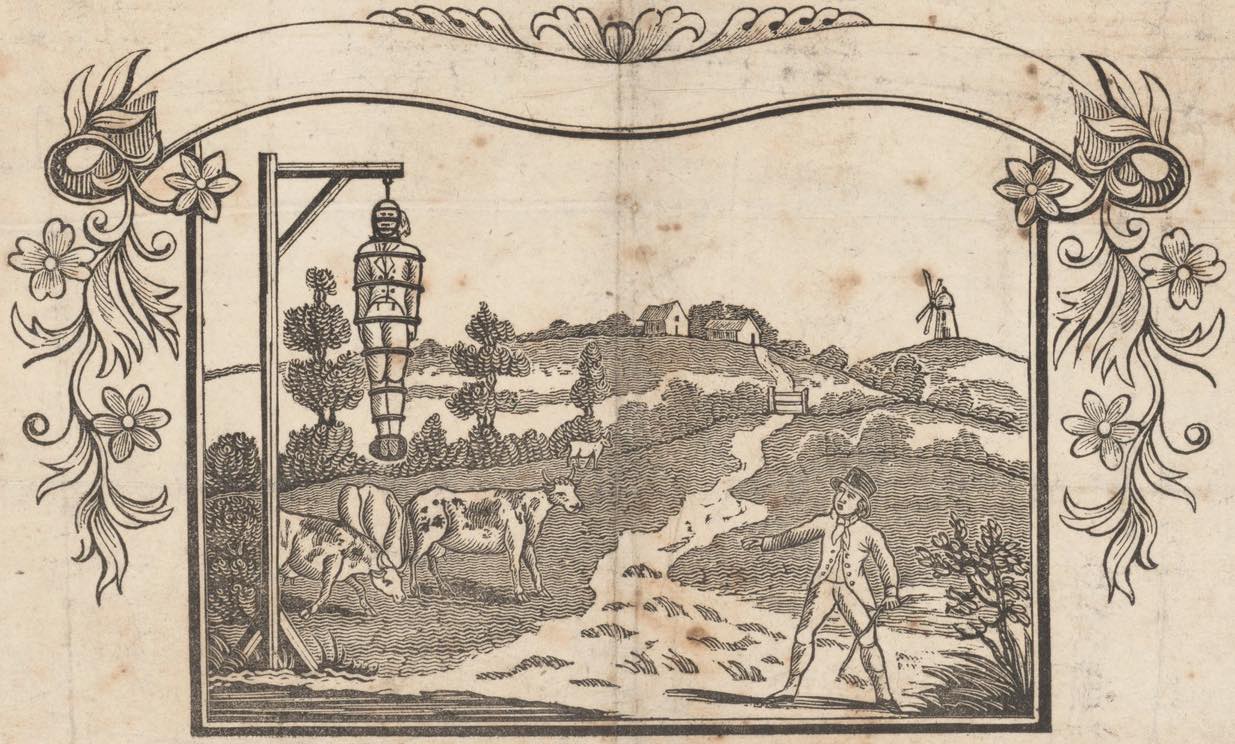
The gibbet was a hanging iron cage used to display the corpses of criminals in 18th and early 19th-century England. To be thus “hanged in chains,” in the judicial jargon and thinking of the day, subjected the criminal to an extra measure of postmortem shaming and offered the general public a rather extravagant cautionary example. Naturally, this frightful spectacle also generated a fair measure of folklore, which we explore in this episode as a follow-up to our “Gallows Lore” show.
The gibbet was a relatively rare punishment reserved for the crime of murder, and only then used in particularly heinous or high-profile cases. Though it was sometimes employed before 1751, its use was more widespread thanks to The Murder Act instituted that year. This bit of legislation offered this extra punitive measure in response to a sort of inflation of the penal code attaching the death penalty to increasingly minor crimes, such as acts of theft.
The Murder Act also designated anatomical dissection of the criminal body as an additional option for postmortem punishment, a fate actually much more common than the gibbet. Dissection may have been intended primarily to enhance physicians’ medical knowledge, but it also provided the surgeons with body parts and substances that could be sold off for other purposes. We make a grisly digression from gibbets to explore some of the ways the human byproducts of executions were made use of in folk-medicine, magic, and certain professions.
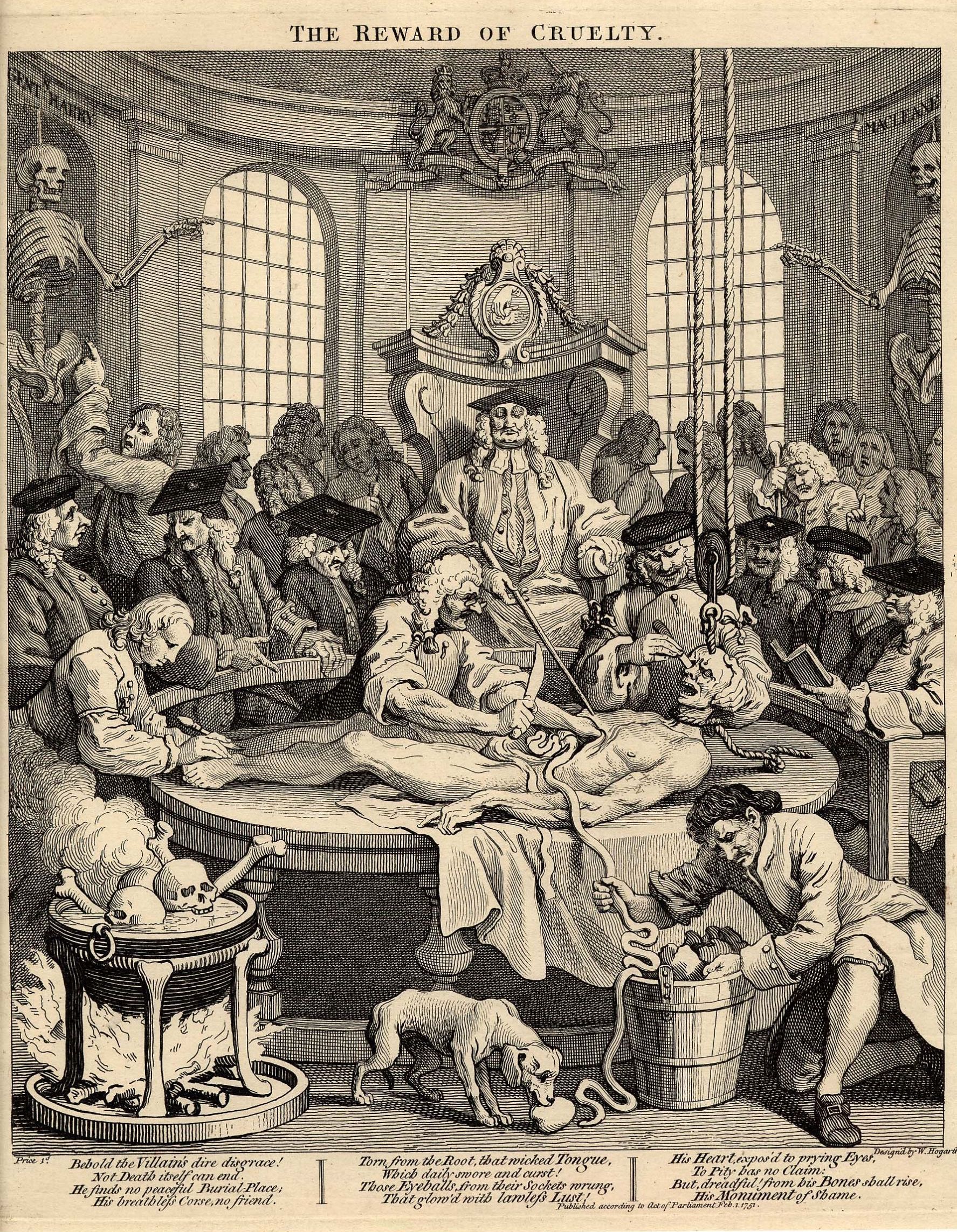
Next, we get into the details of the gibbetting process. Contrary to common understanding, the gibbet was not simply designed as a sort of narrowed human-sized birdcage. It was an arrangement of customized form-fitting iron bands wrapping the limbs, trunk, and body, and connected with vertical cross-pieces. The cage was suspended in a way that allowed it to rock freely in the wind, lending a sort of eerie animation to the corpse and thereby increasing the terrifying impact of these displays.
The horrific impression made by the gibbeted corpse is detailed in Victor Hugo’s 1869 novel The Man Who Laughs, in a scene describing an encounter with a gibbet by the story’s protagonist as a child. Mrs. Karswell reads for us a few lavishly macabre paragraphs from the novel.
We follow this with another literary gibbet, one surprisingly found in a now-forgotten series of children’s books by Mary Martha Sherwood, The History of the Fairchild Family, published in three volumes between 1818 and 1847.
Then we hear a typical ghost story told of the gibbet, a tale set down in ballad form as “Old Grindrod’s Ghost,” which first appears in the 1872 collection Ballads, Romantic, Fantastical, and Humorous by the historical novelist William Ainsworth. The excerpt of the song heard is from the North-English band Pendlecheek.
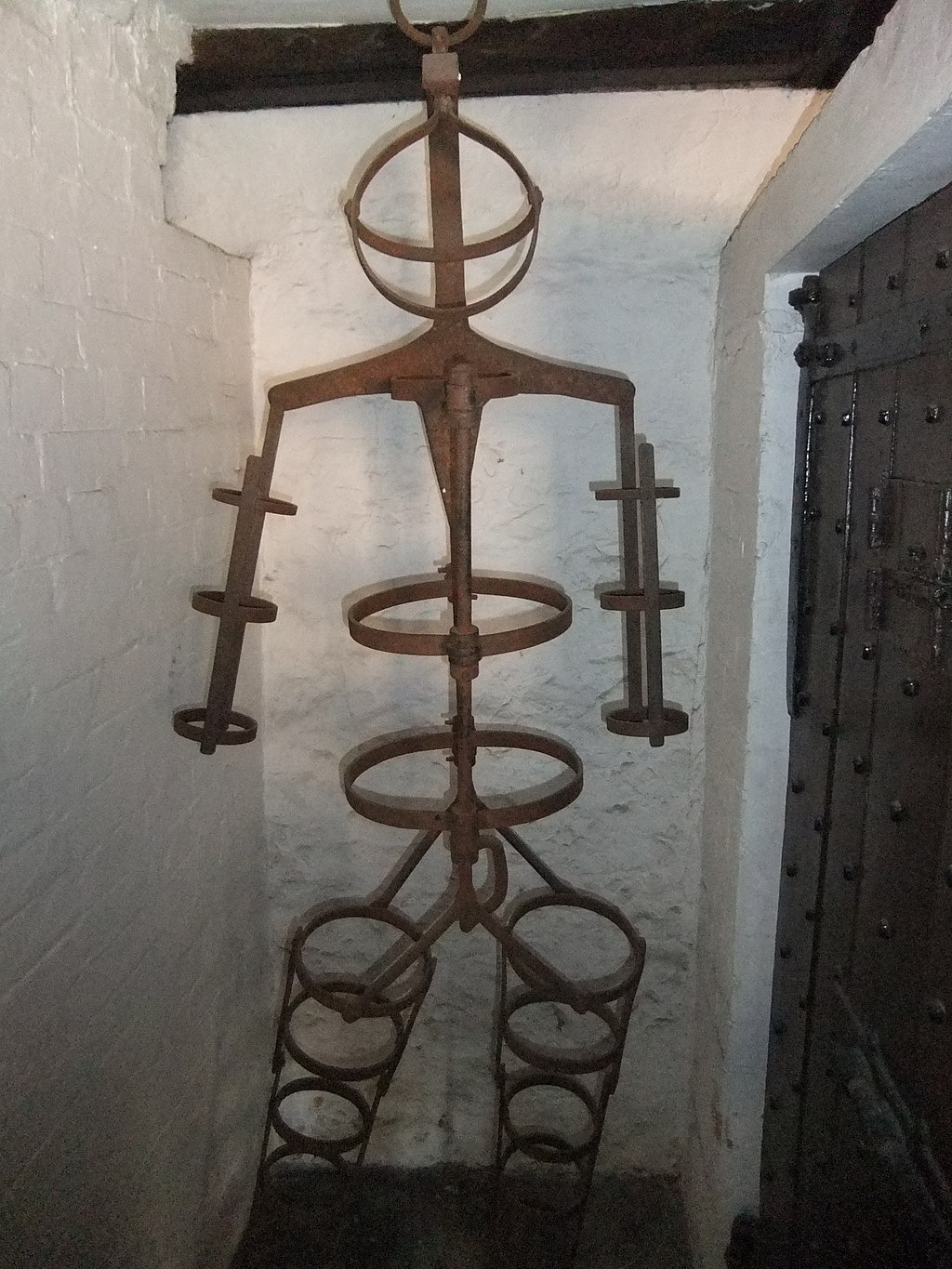
While gibbettings drew huge crowd, the morbid fascination they popularly exerted lingered on in relics obtained from the gibbets as they fell to pieces over the years — in bits of bone, fragments of iron and wood that were carried off as mementoes. We examine cases of gibbet iron and wood recycled as novelty products, or even as structural elements in buildings, such as an old gibbet post serving as a ceiling beam in The Hare and Hound on the Isle of Wight. There are a few ghost stories, and gibbet rhymes and riddles along the way.
Though the gibbet was relatively exclusive to England, the practice was inherited by its colonial states. From America, we hear of a very demanding pirate gibbetted on a small island in Boston Harbor, and from Canada, a unique case of a gibbetted woman, Marie-Josephte Corriveau, hanged in chains in Québec City for murdering her husband in 1733. Though her case was sensational enough for its time, her fame was greatly increased in 1851, when her gibbet was accidentally dug up and then acquired by P.T. Barnum for exhibition. In the wake of this, a body of folk tales sprung up, in which “La Corriveau” became a sort of witch or spirit — or beautiful femme fatal.
We close with a nod to the predatory birds that famously tear at the bodies hanged in chains. From Germany, we offer a bit of folklore on magic eggs produced by ravens who have thus dined, and from Scotland we hear a bit of the ballad, “Twa Corbies,” (two ravens or crows), which tells of the birds feeding not on a convicted criminal, but a slain knight. Included is a snippet of an excellent rendition of the song by The Cories.
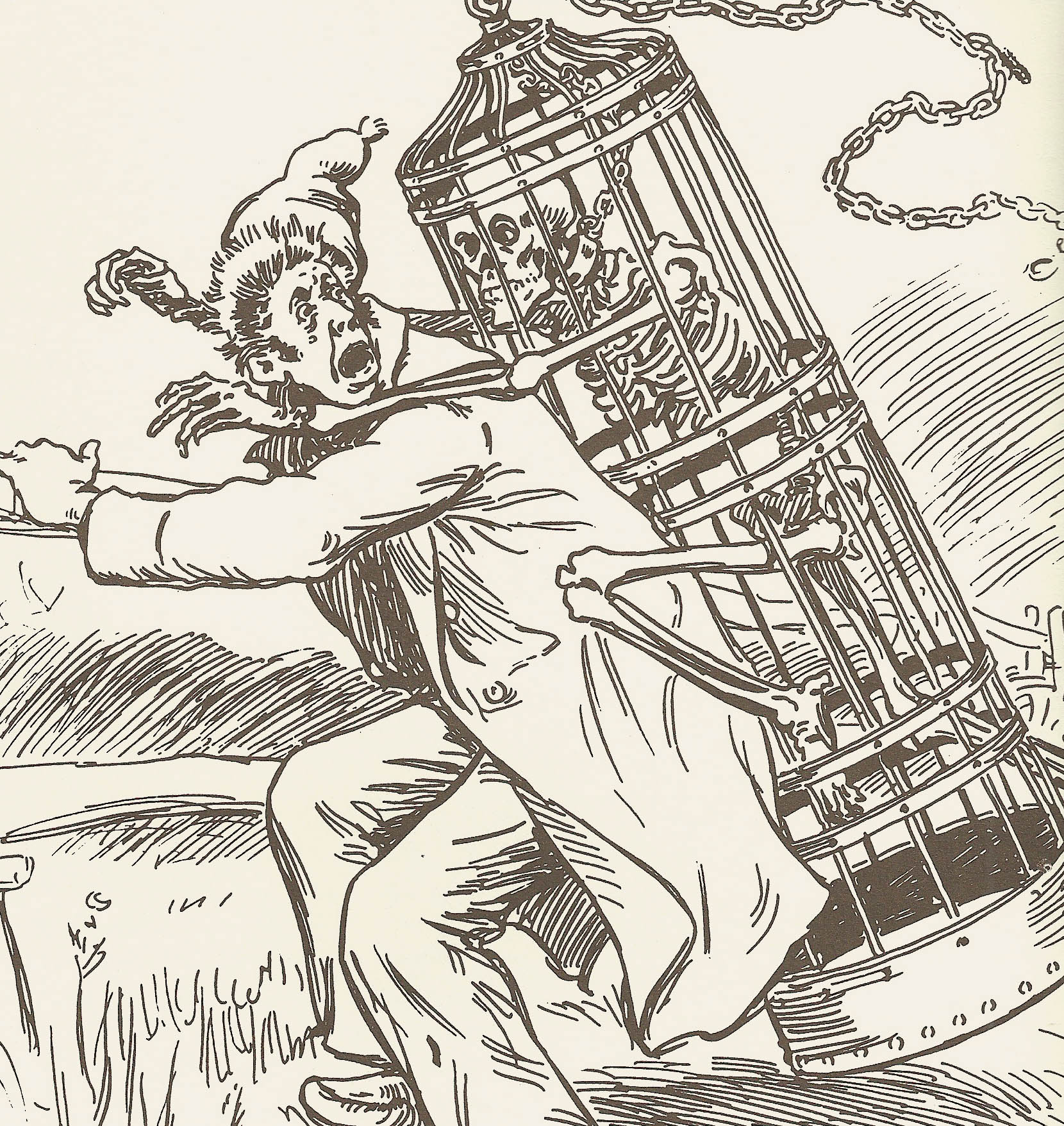
Marvelous and Rare
We’re doing something different this time out.
Bone and Sickle is taking off the rest of September to allow time for Mr. Ridenour’s research and Mrs. Karswell apiary maintenance.
To fill the gap, we’re offering listeners a sample of the short bonus episodes all our $4-and-up Patreon subscribers hear every month.
We hope you enjoy this substitution, and if you do, might even consider joining us on Patreon to hear more of the same.
We’ll be back in October with a regular episode following upon on our “Gallows Lore” show, as well as a special Halloween offering. Till then…
Gallows Lore
We examine the lore of the gallows, focusing on the British Isles, encountering hangmen as figures straddling history and myth, strange histories and folk-tales, as well as superstitions and magical practice associated with the hanged man’s rope and body.
We begin, of course, with a bit of gallows humor, provided in the sea shantey, “Hanging Johnny,” from a 2004 Smithsonian Folkways recording.
Then it’s on to meet Jack Ketch, the 17th-century hangman who so fascinated the British public that he was memorialized in various turns of phrase, i.e, “to dance Jack Ketch’s jig” (the death spasms at the end of the rope). Emblematic of all who follow his trade, he was even adopted into the traditional Punch and Judy show.

Much of his reputation is based on grim incidents reflecting poorly on his skill — not with the noose but with the sword with which he was less practiced. We hear of two particularly grisly incidents in this arena: the executions of William, Lord Russell, and the Duke of Monmouth.
The Irish song “The Night Before Larry Was Stretched” opens a further discussion of the language of execution by hanging. “Stretched,” here is borrowed from the underworld dialect known as “criminal cant,” and of course means “hanged.” “Stretched at Tyburn” is another usage referring to the gallows of Tyburn, where the London’s hangings took place from the 12th century up to 1782. We hear a bit more about Tyburn’s strange configuration of scaffolding, (“The Tyburn Tree”) and of the “Execution Dock” on the Thames, reserved exclusively for pirates and smugglers.
Taking a quick side-trip to the technological side of things, we learn that throughout the Tyburn era, death by hanging occurred not through the long drop and broken neck, but a short drop and a dreadfully slow process of strangulation. This less decisive process occasionally resulsted in certain convicts being revived, such as the case of “Half Hanged Smith” in 1705. Mrs. Karswell reads for us Smith’s unhappy remarks on being thus revived.
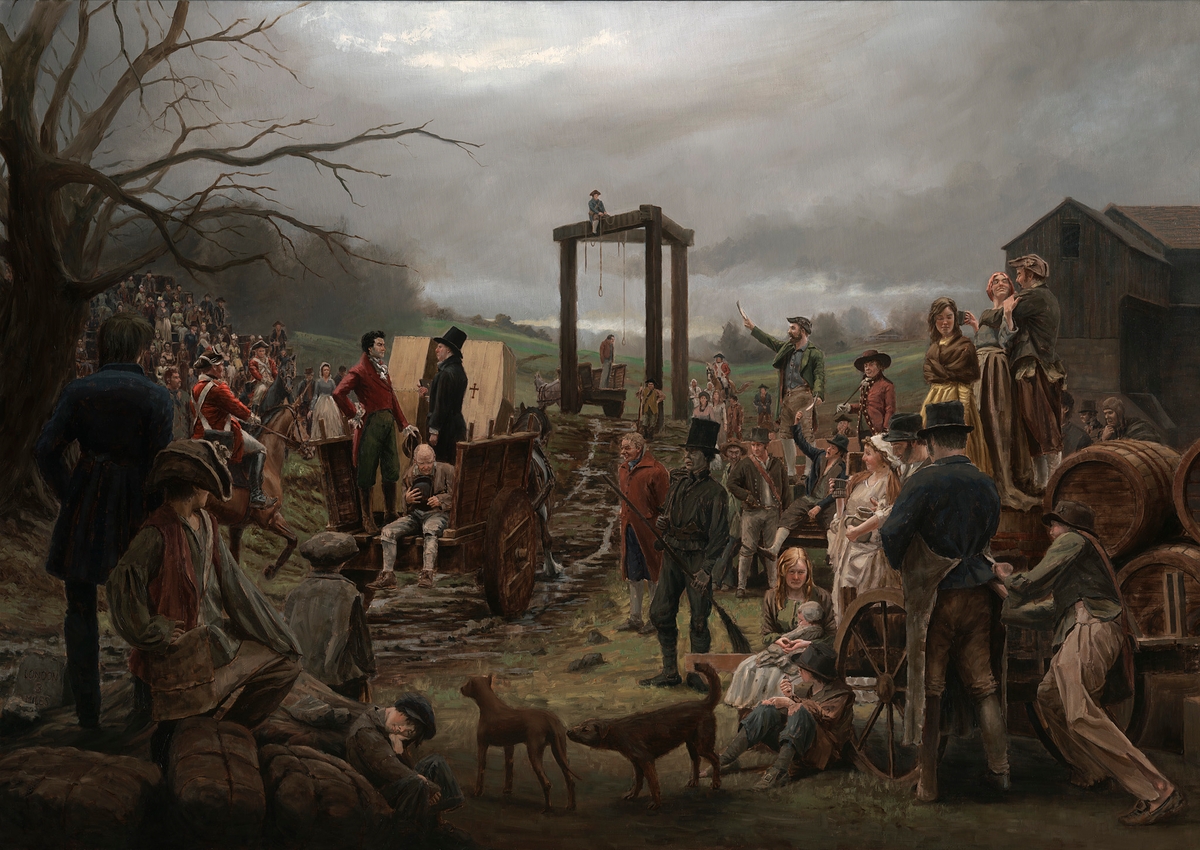
Prisoners to be executed at Tyburn were housed in Newgate Prison on conveyed by cart to the gallows in riotous public processions. Carnivalesque details of these proceedings and the reason for moving executions to Newgate in 1782 are explored. (And we stop at some pubs en route!)
One last topic before we move from history to folklore — the career of William Calcraft, another notorious London hangman serving from 1829 to 1874. We hear some unkind words on his professional conduct from Charles Dickens and about Calcraft’s relationship with Madame Tussaud’s.
Our look at the folklore of the gallows begins with the magical properties assigned to segments of the hangman’s rope, something sought out for everything from luck at gambling to the cure of various physical afflictions.
The touch of the hanged man’s hand (dead but still warm) was an even more widely sought cure for warts, cysts, and occasionally other ailments like epilepsy or paralyzed limbs or digits.
In 1888, the English writer Thomas Hardy placed this superstition, or a version of it, at the center of one of his most popular short stories, “The Withered Arm,” from which we hear some passages. A good BBC adaptation can be found here, btw.
The hand of a hanged convict needn’t be still warm and still attached to the wrist to offer magical protection. It can be severed and dried as is the case with the infamous hand of glory. This preserved hand of a hanged convict was widely used by thieves in Britain and Ireland as a charm that would incapacitate the occupants of a home they would burglarize — usually by a deep sleep, but some other mechanisms are also discussed. We hear some directions for creating and using the hand of glory from the 1706 French grimoire known as the Petit Albert.
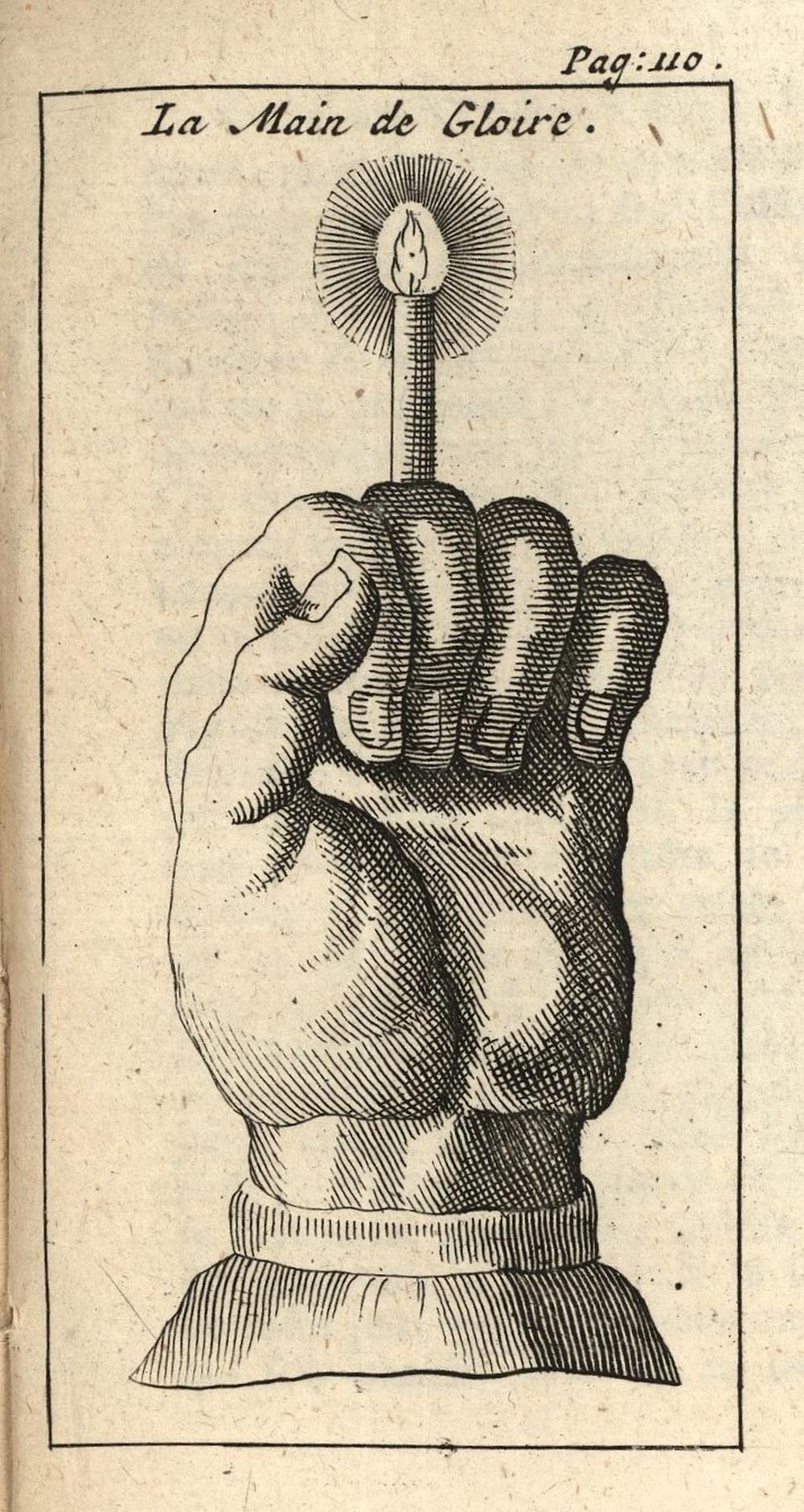
Belief in the power of such charms seems to have arrived in the British Isles from the continent. Particularly in German-speaking regions, there are a number of variations on the theme featuring the hands of unborn children, and other iterations discussed.
Two further hand of glory stories are recounted: one telling of a very strangely dressed visitor who might not be trusted from the 1883 volume About Yorkshire, and another from the delightfully comic 1837 collection of folk tales and ghost stories, The Ingolsby Legends by Richard Harris.
As for the actual use of this charm in a non-literary context, we hear a newspaper account from 1831 involving some Irish burglars unsuccessfully employing the talisman, and of an actual specimen recovered from inside a wall in 1935 and now preserved in the museum of the north English town of Whitby.
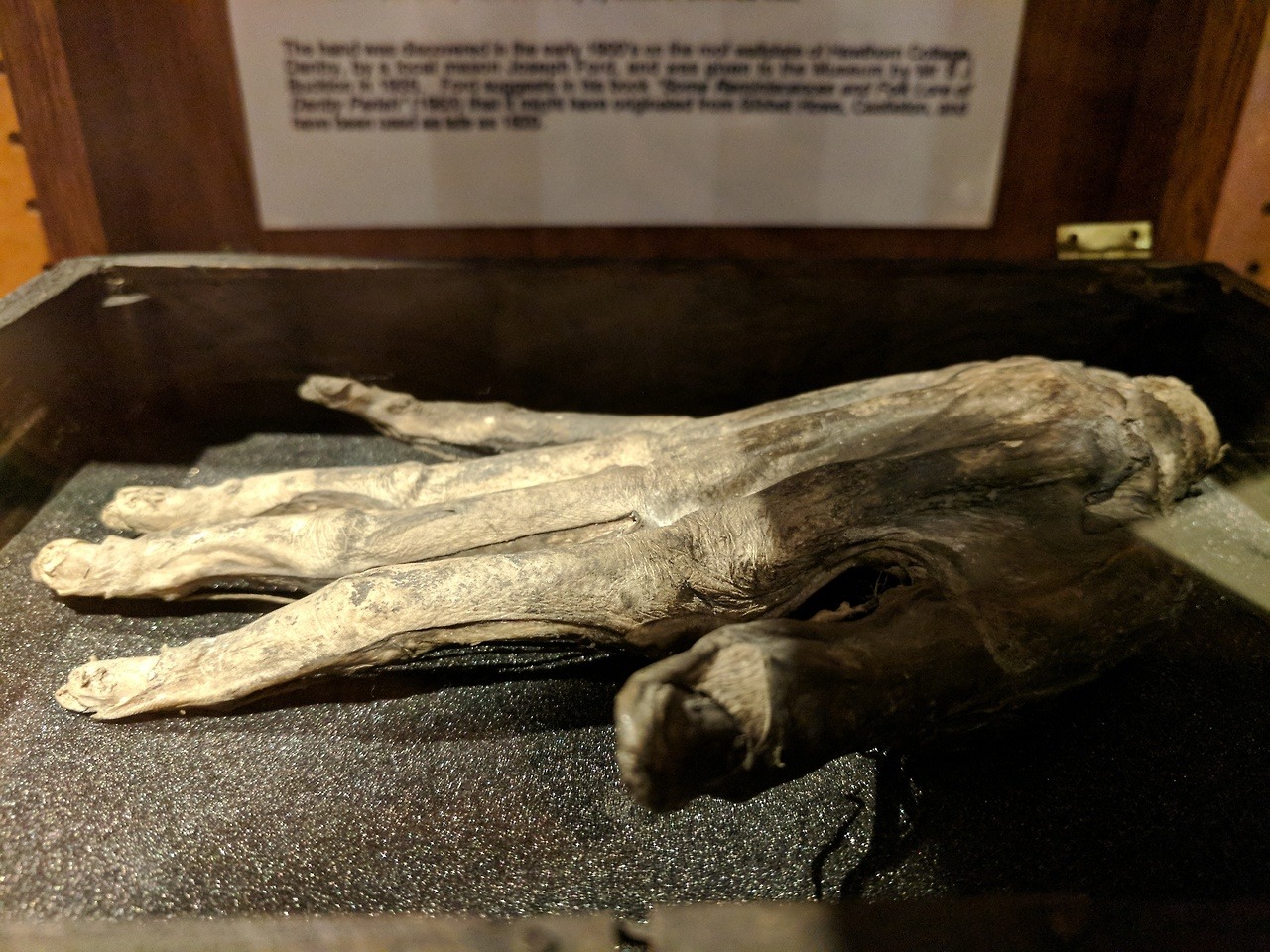
The strange name for this talisman, btw, comes from the French word for mandrake “mandragora,” which was heard by Brits as “main de gloire” (“hand of glory”).
But there are other parallels contributing to this confusion. As we noted in our “Bottled Spirits” episode in our discussion of Friedrich de la Motte Fouqué’s novel Galgenmännlein, or “little Gallows man,” the mandrake plant was believe to be seeded by bodily emissions (almost always semen) ejected from the hanged man at death.
We hear a bit more of the strange folklore of the mandrake, and then have a look at how this theme was explored in the 1911 novel Alraune (another German word for “mandrake”), a sort of early science-fiction story by Hanns Heinz Ewers describing the results of an experiment in which a prostitute is impregnated with the semen of a hanged man. The novel has been adopted several times in German cinema, including a 1952 version featuring Erich von Stroheim, which we hear in the background.
We close with a cheery hanging ballad: “MacPherson’s Lament,” supposedly composed by Scottish outlaw Jamie MacPherson on the eve of his execution in 1700.
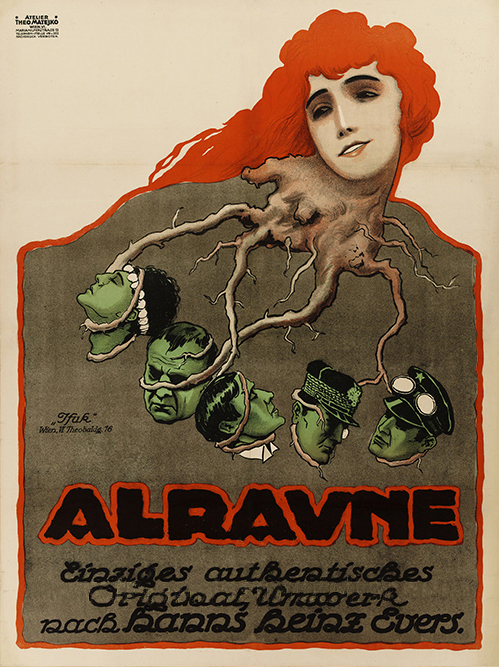
The Frankenstein Method
The method Frankenstein employed to create life is left mostly a mystery in Mary Shelley’s 1818 book. How then did the notion of stolen body parts stitched together and animated by lightning become so firmly entrenched in popular imagination?
Our episode begins with a clip from Universal’s pattern-setting 1931 production, Frankenstein, in which Henry Frankenstein rhapsodizes about building the creature’s body from the dead. While the idea’s suggested in Shelley’s novel, the process doesn’t quite seem to match the cinematic treatment in which the creature’s fabricated from whole human body parts stitched together. We’ll hear some passages read by Mrs. Karswell, that seem to suggest Shelley’s Frankenstein fabricates his creature instead from component materials — tissues and whole systems built up slowly over bones obtained from the charnel house. The creature’s large stature in films, however, matches the literary prototype — for very practical reasons, as is explained.
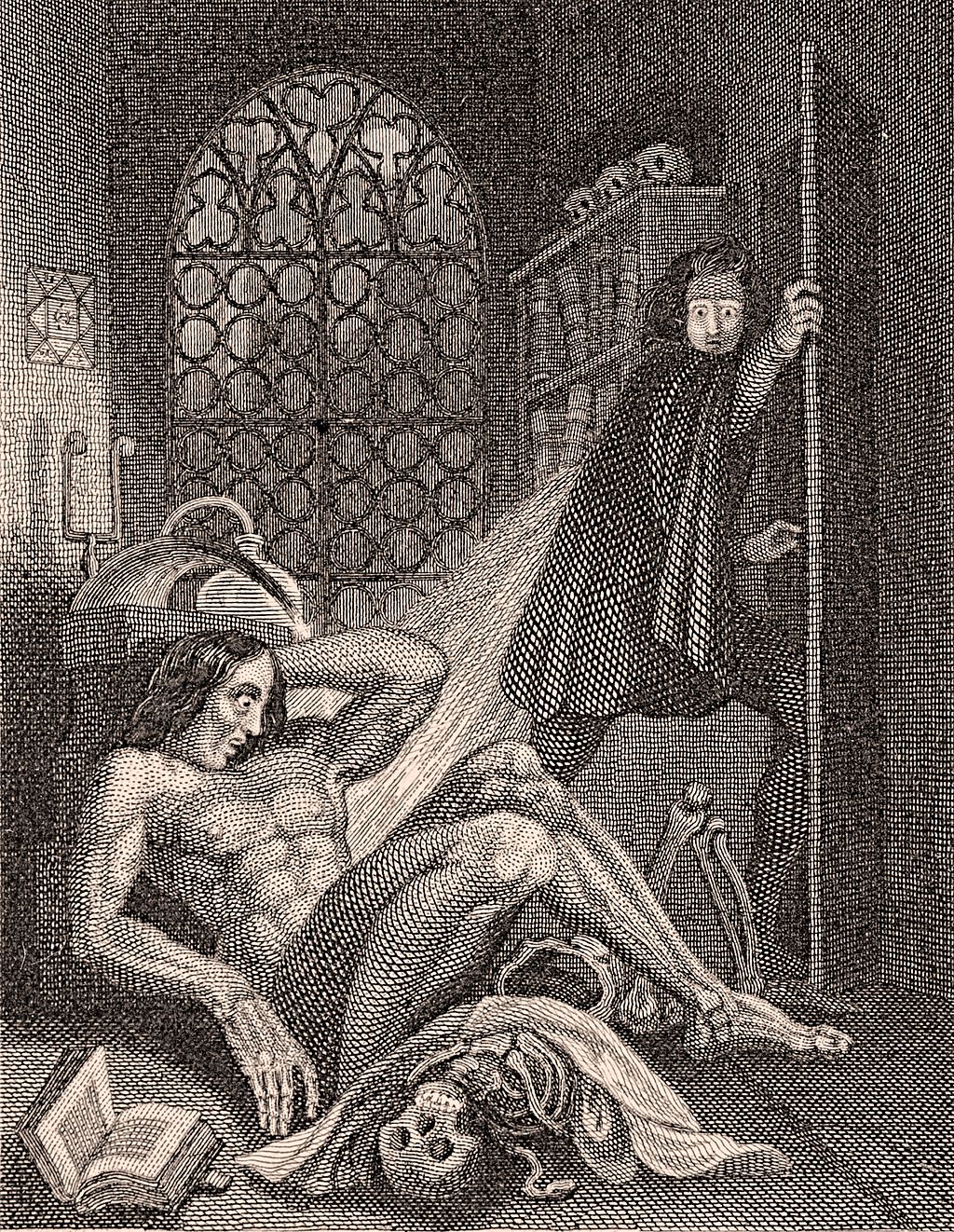
Next we have a look at how Shelley portrays Victor Frankenstein’s desire to create life as influenced by his study of alchemical texts (by Cornelius Agrippa, Albertus Magnus, and Paracelsus,) Of particular interest here is the work of his Swiss countryman, Paracelsus, who in the 16th century set down directions for the creation of a homunculus, a tiny human-like being grown in a glass bottle.
These comments, in a general way, seem to have influenced an odd inclusion in the script for 1935’s The Bride of Frankenstein, in which Frankenstein’s partner in monster-making, Dr. Pretorius, presents his own experiments in creating homunculi (as in the clip played).
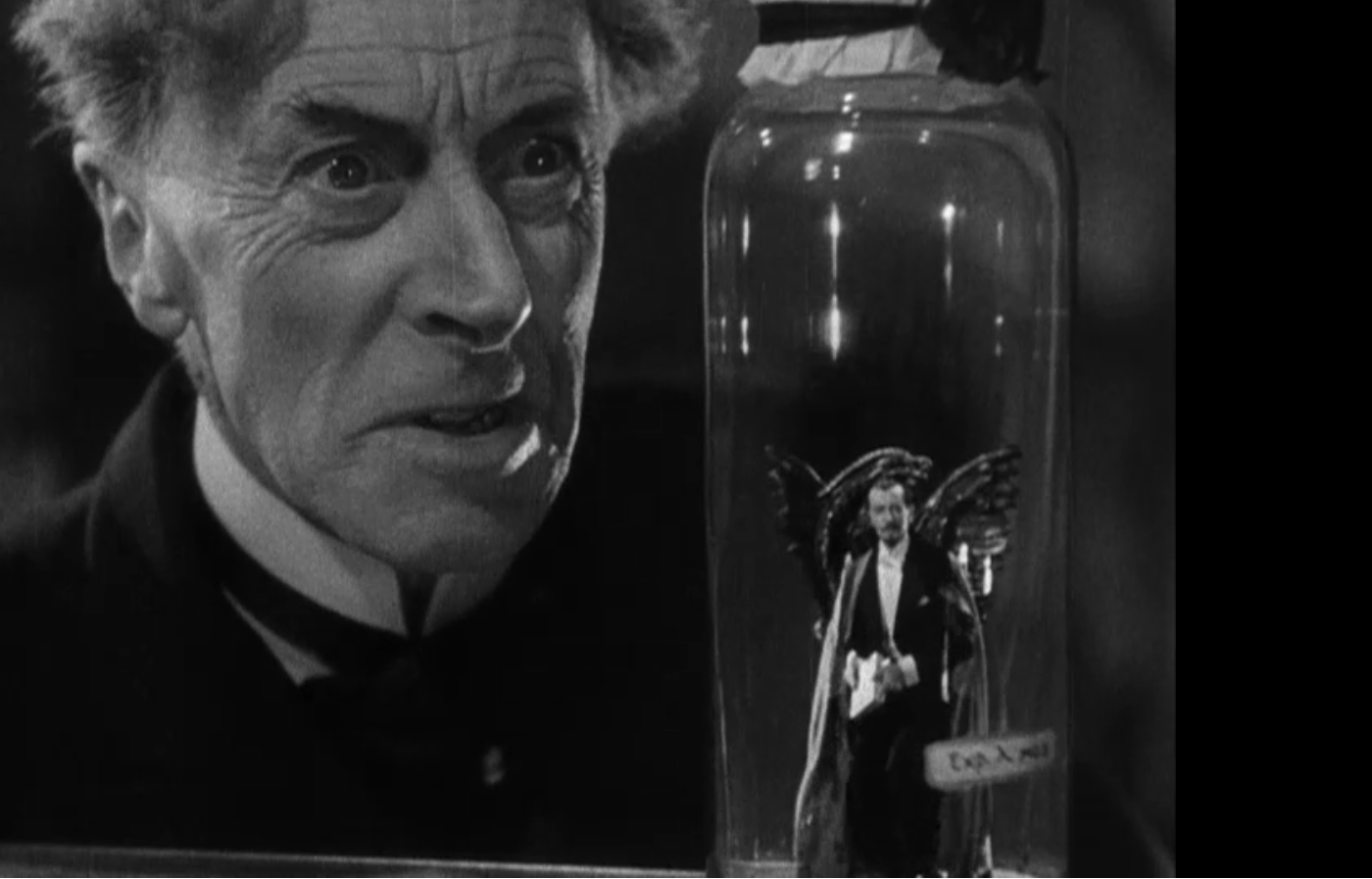
As further evidence that Bride’s screenwriters went digging in some rather obscure texts, the film’s portrayal of the miniature king escaping his bottle to pursue a homunculus-queen in an adjacent bottle appears to be directly lifted from a legend of an Austrian freemason Count Johann Ferdinand von Kufstein, creating homunculi in 1755 — a legend appearing only as a footnote in an 1896 biography of Paracelsus by the Theosophist Franz Hartmann.
While none of this appears in Shelley’s novel, some scholars have attempted to locate the inspiration for her novel in the work of another alchemist: Johann Conrad Dippel, in particular because the location of his birth in 1673 is listed as Burg Frankenstein, Castle Frankenstein on a hill near the city of Darmstadt Germany. We look at evidence for parallels in Shelley’s story and von Dippel’s career, and though the linkage appears to be fairly speculative, we end up with some good stories involving the misuse of bone oil, and a corpse dyed blue.
We next examine references to Victor Frankenstein’s interest in lightning and galvinism (early notions of electricity), and how this supplants his earlier interest in alchemy. The connection between galvinism, 18th-century researcher Luigi Galvani, and frog legs is explained, as is Mary’s husband Percy Shelley’s hands-on dabbling in this field.
While both Percy and Mary had an interest in this evolving field, their understanding of these matters could often be of a more poetic than scientific. In Mary’s introduction to the 1831 reissue of her novel, she references galvinism as a possible source of the creature’s animation, though the idea here is inspired by her highly idiosyncratic understanding of an experiment conducted by Erasmus Darwin (grandfather of Charles). A reference to what seems to be living pasta is also muddled into all this.
Next we hear a a bit about Luigi Galvini’s nephew Giovanni Aldini, and his use of electricity to produce convulsions in the carcasses of oxen as well as a notorious 1803 experiment with the body of a recently executed convict from London’s Newgate Prison. We don’t know if Shelley was aware of these experiments, but it’s certainly possble.
Even more ambitious than Aldini’s experiment was one conducted by the Scottish physician Andrew Ure in Glasgow in 1818. Ure also worked with the body of an executed convict but with stated intention of actually reviving the deceased using electricity. The date on this one (the same year as Shelley’s composition of the novel) makes it highly unlikely to have influenced her composition, but the grisly details seem nonetheless worth relating.
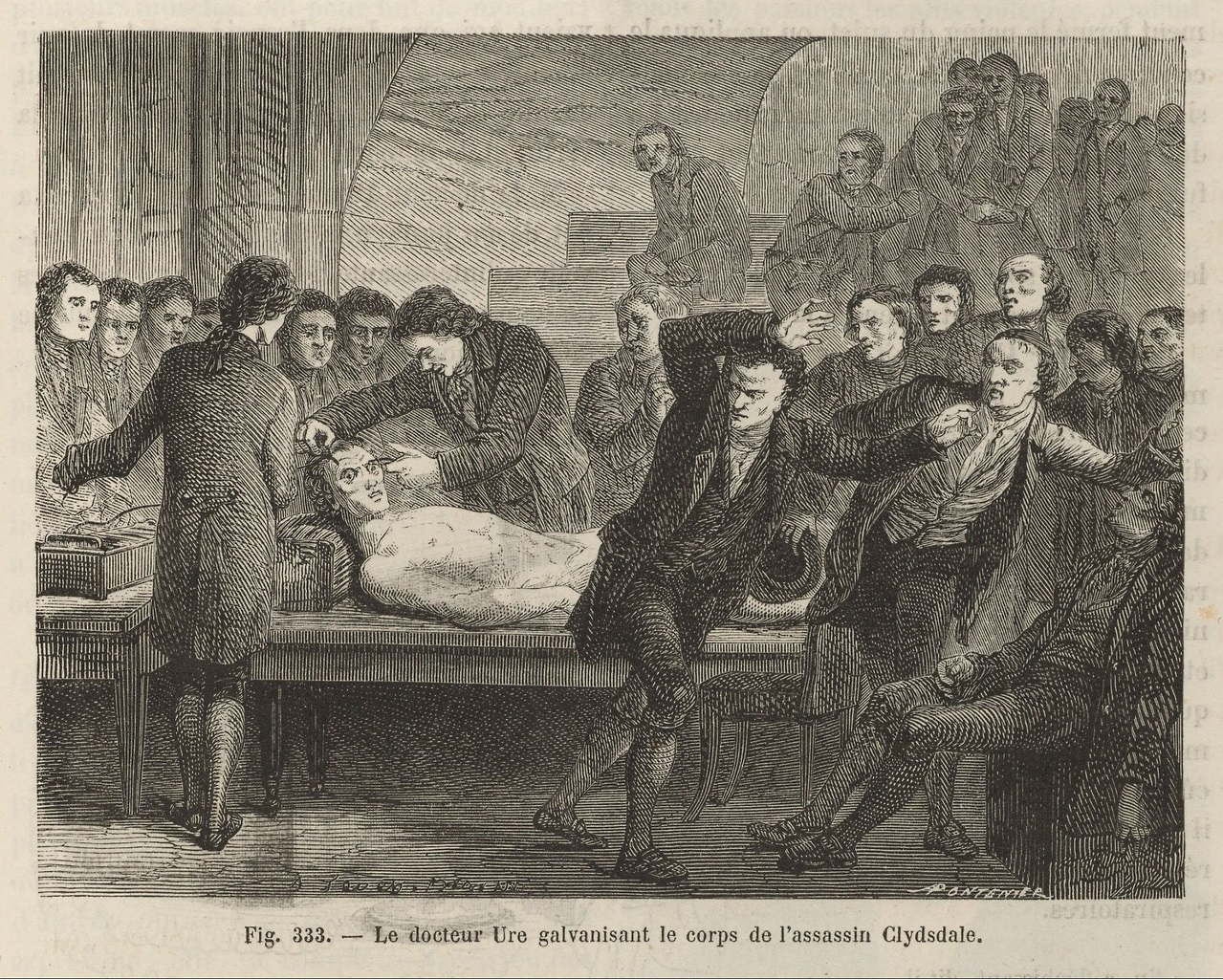
Another suggested source of inspiration for Frankenstein is the researcher Andrew Crosse, known to locals living near his isolated mansion in Somerset’s Quantock Hills as “The Thunder and Lightning Man.” Crosse converted his home into a lab for the study of electrostatic energy produced in the atmosphere, channeling this into an immense array of homemade batteries, and releasing thunderous charges mistaken by neighbors for lightning of his own creation.
While the case for any of these serving as direct inspiration to Shelley is rather tentative, it’s actually the more familiar figure of Benjamin Franklin whom the author mentions in her novel. In a passage removed from the 1831 publication, Franklin’s kite experiment is referenced, making him the only contemporary electrical researcher mentioned in the text. An article about Franklin is also a likely source for the reference to Prometheus in the novel’s subtitle, The Modern Prometheus.
The Frankenstein of Universal films and beyond has its roots in theater. For many years Shelley’s novel was actually better known from theatrical adaptations, which began appearing not long after the book’s publication. The first was 1823’s, Presumption; or, the Fate of Frankenstein, which Shelley herself attended with a mix of irritation and delight. It’s in this play that the character of the laboratory assistant first appears, here as “Fritz” (as in the 1931 film) and later acquiring the name “Igor.” Only three years later, The Man and the Monster; or, the Fate of Frankenstein appeared giving audiences the first direct representation of the monster’s animation.
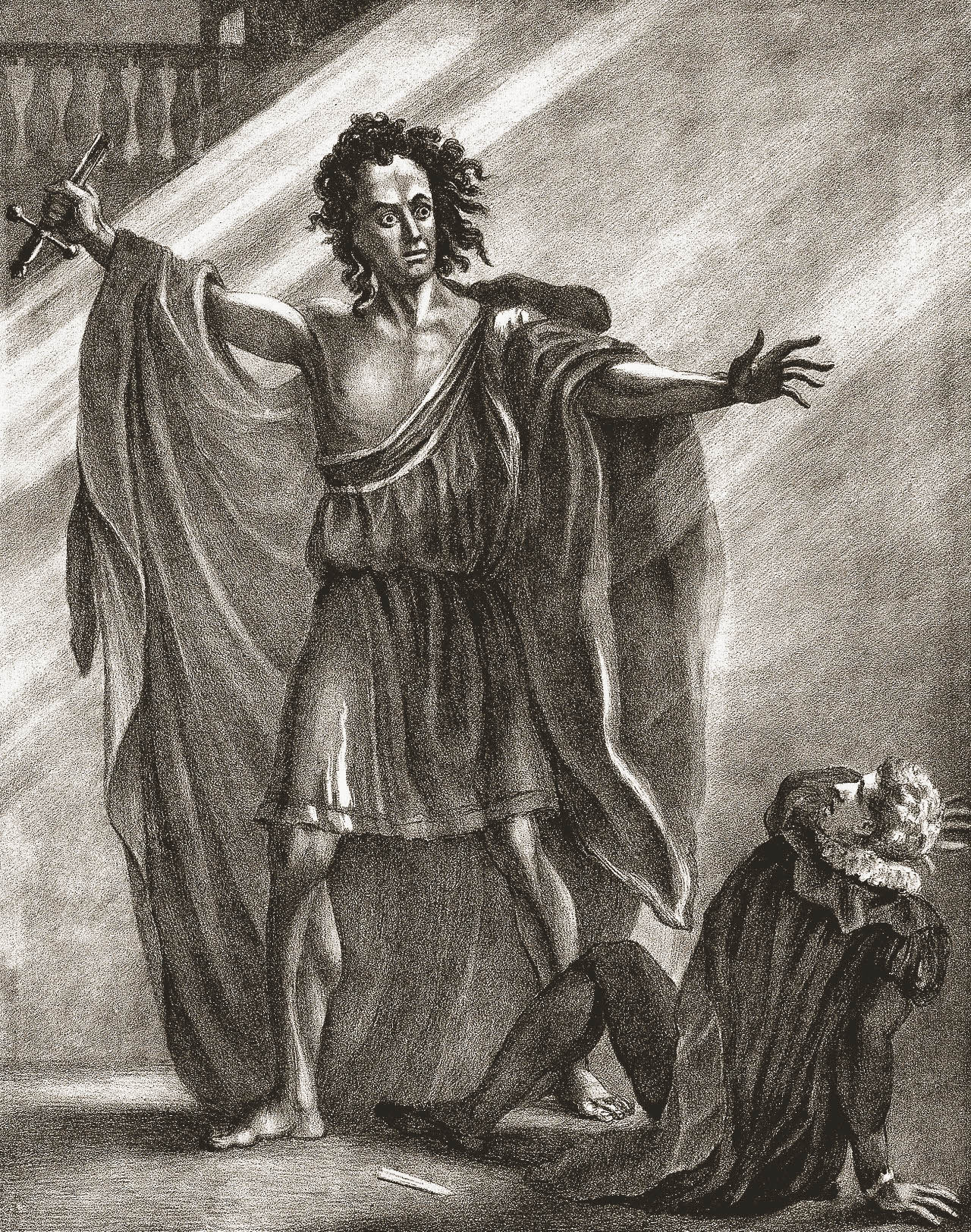
There is still no electricity involved in all of this by the time the first cinematic adaptation appears in 1910 — Edison Studio’s 13-minute production called simply Frankenstein. Here we see Victor Frankenstein brewing up his creation in a vat, pouring in flashing chemicals.
The 1927 play Frankenstein: An Adventure in the Macabre by Peggy Webling, served as the basis for Universal’s 1931 film, but even here, there is no electricity animating the creature, a feat accomplished instead by Frankenstein administering the alchemist’s “Elixir of Life.” In 1931, this play was itself reworked into another theatrical adaptation by writers of the studio’s Dracula, John Balderston and Garrett Fort. It’s only here that electrical apparatus is employed, an aspect director James Whale whole-heartedly embraced based on his fondness for the mad scientist’s lab in the 1927 film Metropolis.
We finish this novel-to-film progression with a quick look at elements of Shelley’s novel brought to the fore in 1935’s The Bride of Frankenstein and the creator of the props that populated the film’s laboratory, Kenneth Strickfaden.
Then there’s a few bizarre footnotes on Ben Franklin from recent history. Very strange indeed!
Bottled Spirits: Imps, Devils, Ghosts
Western tales of bottled spirits, imps, devils, and even ghosts are largely borrowed from the Islamic and Jewish legends of jinn captured by King Solomon. In this episode, we explore how this is expressed in folk tales, demonological treatises, and literary borrowings.
We begin with a nod to the Assyrian god Pazuzu (and a clip from Exorcist II, The Heretic.) Here, aconnection between feared Assyrian spirits such as the jinn is mentioned. Pazuzu’s identity as a spirit of ill winds, brings us to a wind-related track from the original Exorcist soundtrack (from 1972’s oddball album Songs from a Hill.) It’s a recording of a wind harp, or Aeolian harp. And this brings us to the Greek god of winds, Aeolus.
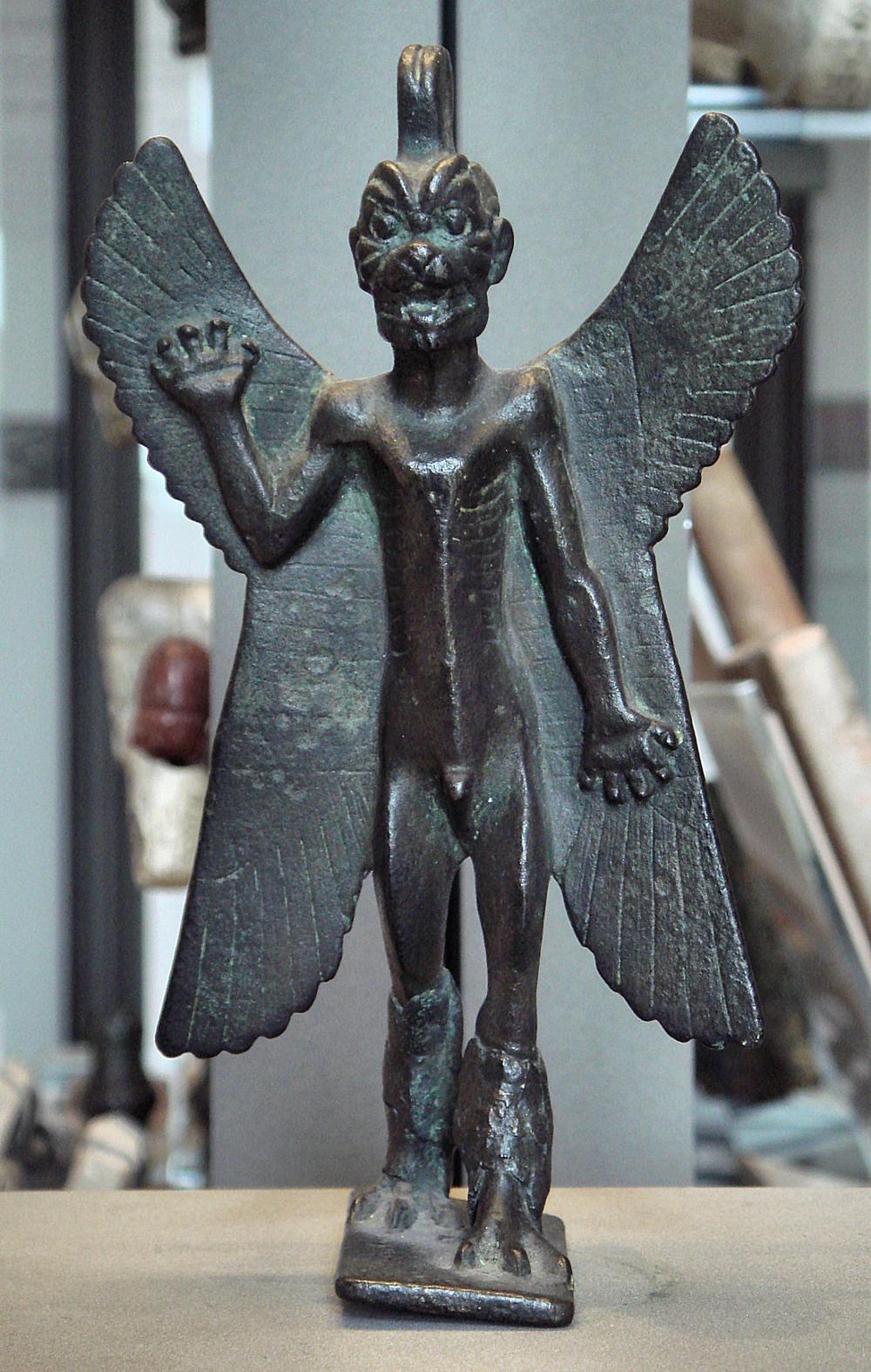
Aeolus features in the Odyssey in an episode that anticipates our bottled spirit motif. He presents Odysseus a bag of wind to speed him on his journey. The wind spirits contained in this bag then brings us to a story about King Solomon trapping a wind demon in Arabia to aid him his construction of the Jerusalem Temple. We hear this particulsar tale from the medieval text, The Testament of Solomon read by Mrs. Karswell.
We then look a bi from further medieval texts commenting on Solomon’s capture of demons in various vessels, and how thesee are later broken open by heedless conquerors of Jerusalem, releasing a Pandora-style plague of demons upon the world.
Our motif entered the literary world via 17th-century Spain, in Luis Velez de Guevara’s satirical novel El Diable Cojuelo, “the lame devil.” We also hear a bit about a French adaptation, Alain-René Lesage’s 1707 novel, Le Diable Boiteux. Both of these feature the demon Asmodeus, and referenced Asmodeus’s identity as demon of lust, a notion taken up in various demonological treatises.
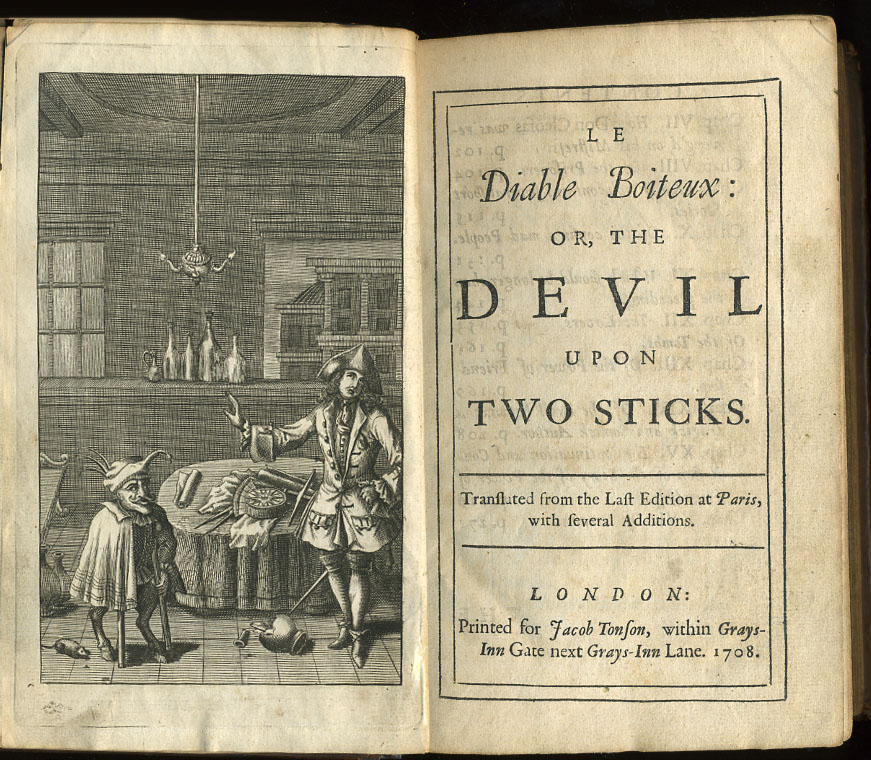
Next we look at folk tales, beginning in County Cork, Ireland, with the “Legend of Bottle Hill,” which takes its name from a curious (and curiously inhabited) bottle obtained by one Mick Purcell on this particular Irish hill. Both good and rather surprising bad luck follow.
From Scotland, we hear the legend of the Wizard of Reay and of his efforts to evade Satan’s over-eager efforts to claim his soul, as well as his bottle-imp story, involving a cask in the Cave of Smoo, a reputedly haunted sea cave in Sutherland.
The Wizard of Rea’s tactic for controlling the demon he finds in the cask is the same as we find in the folk tale, “The Wizards of Westman Islands,” from Iceland (in which we learn what role the sinister “Sending” plays in Icelandic folklore.)
From The Brothers Grimm, we hear “The Spirit in the Glass Bottle,” involving another bottled imp discovered in the gnarled roots of an ancient tree, and of a similar tactic used to subdue his volatile nature.
Jumping ahead a bit, we look at Robert Louis Stevenson’s 1891 short story, “The Bottle Imp,” which likewise adapts themes from the previous folk tales, while adding further complications and convolutions. The story has served as basis for several films, an opera, a standard magician’s trick, and more than one radio adaptation. (We hear a bit of one from a 1974 production by CBS Radio Mystery Theater.)
Stevenson makes use of some elaborate caveats attached to his bottled spirit, conditions that will produce either good or very bad luck, involving among other things, the need to rid oneself of the infernal talisman before one’s death by selling it for less than one payed for it. This motif is also found in German Romantic writer Friedrich de la Motte Fouqué’s novel Galgenmännlein (“little gallows man”), a name taken from the German word for the mandrake plant, and here we dig a bit into the grim folklore of that plant. Fouqué’s story makes use of some nice, gothic elements in its resolution, a “Black Fountain,” ravening beast, and sinister black rider, among others.
Switching gears a bit, we have a look at the topic of witch bottles. It’s a perhaps questionable how well these fit our theme, but we dig up some interesting source texts describing their original use, unseemly as it is. And we hear of some startling, tragic accidents involved in their historical use.
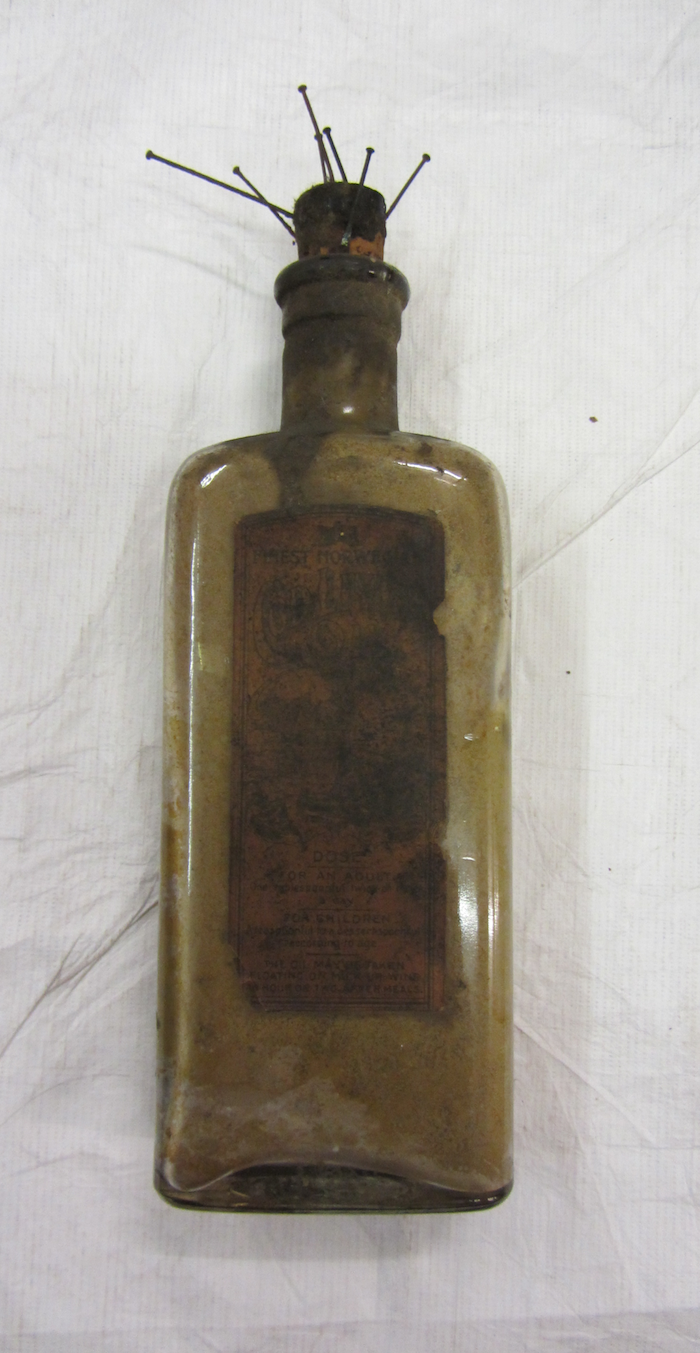
We close our show with a look at near contemporary instances of those who claim to capture demons and ghosts in bottles. Apparently, bottled ghosts can be a big money maker. At least in New Zealand.
The Jinn
They Arabic mythology of the jinn is, not surprisingly, quite different than what you might glean from Western pop culture. Films such as 1940’s The Thief of Baghdad and 1958 Ray Harryhausen classic, The Seventh Voyage of Sinbad, which we hear sampled in our opening might have you believe these creatures function as nothing more than wish-granting slaves, but their existence needn’t be entangled with human wants and needs.
One Thousand and One Nights, or the collection sometimes titled Arabian Nights, is the original Western source when it comes to our topic of the genies or the jinn. This begins with the word “genie,” an English rendering of the original French translation of the Arabic word, “jinn” (which can be used as both plural and singular, btw.) These tales are told within a frame story related by Scheherazade, a woman providing a cliff-hanger night-by-night narrative intended to delay the plans of her newly wed husband, who intends to execute her after the wedding night. (We hear a bit of Rimsky-Korsakov’s 1888 symphonic suite Scheherazade along the way).
After reviewing the evolution of these Arabian Nights stories from original oral forms (which were more often Persian, Indian, and Greek than Arab, actually), we have a look at some surprising misunderstandings about the story of Aladdin, which, like the stories of Sinbad, and Ali Baba, were not even part of the first collection of these tales assembled.
Jinn are a separate race, created between men and the angels. They are not immortal, and live in an invisible society organized like our own with similar social orders, marriages, and offspring (though sometimes humans are taken as marriage partners also). They are not necessarily good or evil, choosing their own path, which may include following the Muslim faith, as the Qur’an speaks of the Prophet preaching to this race of being. They may also follow other faiths as Christian, Jewish, and Zoroastrian jinn are also sometimes mentioned.
We spend some time looking at how their appearance has been described in literature, though no particularly definitive description emerges, as they are constant shapeshifters. They may appear simply as shadows or whirlwinds, but more often seem to take human form, albeit, often that of a human hybridized with various animals features (horns are common). Frequently, they may also simply take the form of animals, particularly dogs, and snakes. We hear some interesting anecdotes in this regard, illustrating the reverential treatment animals sometimes receive lest they reveal themselves to be dangerous jinn in disguise.
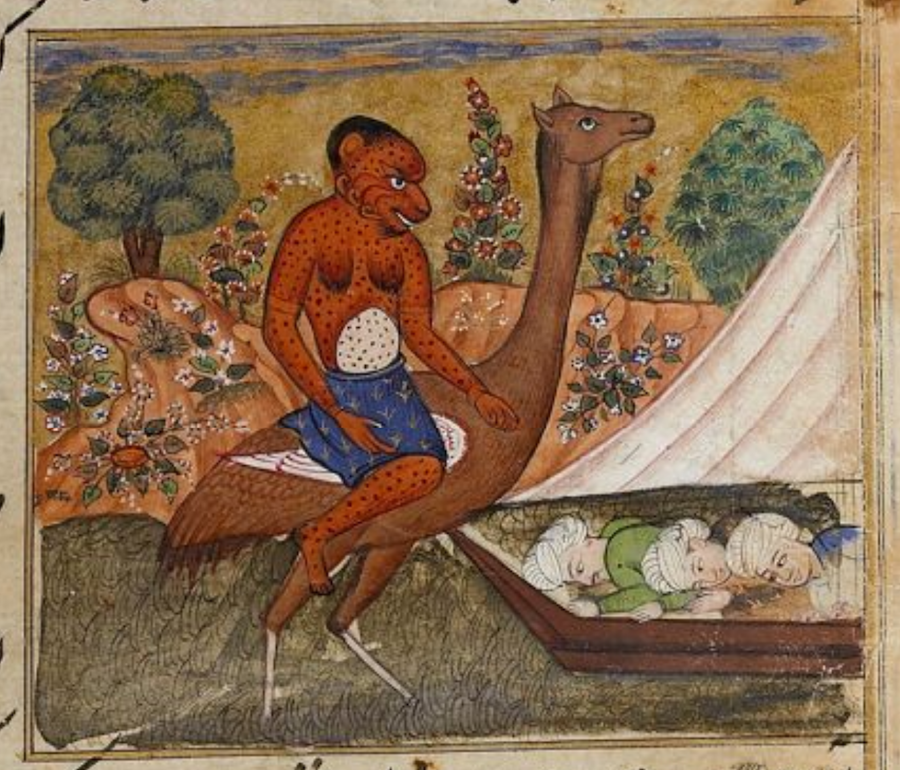
While their theoretical home is Mount Qaf-Kuh, the sort of Mt. Olympus of Islamic mythology, jinn obviously do not confine themselves to this location and can be found nearly anywhere man ventures. Some locations, such as abandoned homes, cemeteries, and ruins are obvious, but others such as certain mosques and marketplaces also are mentioned.
More obvious than where you might encounter a jinn is when you might do so. Their nocturnal nature is widely agreed upon, and just as certain treatments of animals is ill-advised for risk of offending the jinn, we hear of a number of actions that should not be performed by night for similar reasons.
Along the way, we learn how iron and salt may be used to repel the jinn, favorite foods of the jinn, how shooting stars relate to the jinn’s propensity to eavesdrop, and hear an interesting tale of a jinn-human marriage from Edvard Westermarck, a Finnish scholar who spent a great deal of time in Morocco.
The jinn, we learn, may be sought out for their advice, thanks to their supernatural knowledge of things seen and unseen, and can be summoned for this purpose (or to achieve other ends) by skilled magicians. We even hear in the Qur’an of Mohammed invoking the jinn to perform a miracle on the modern site of the Mosque of the Jinn in Mecca.
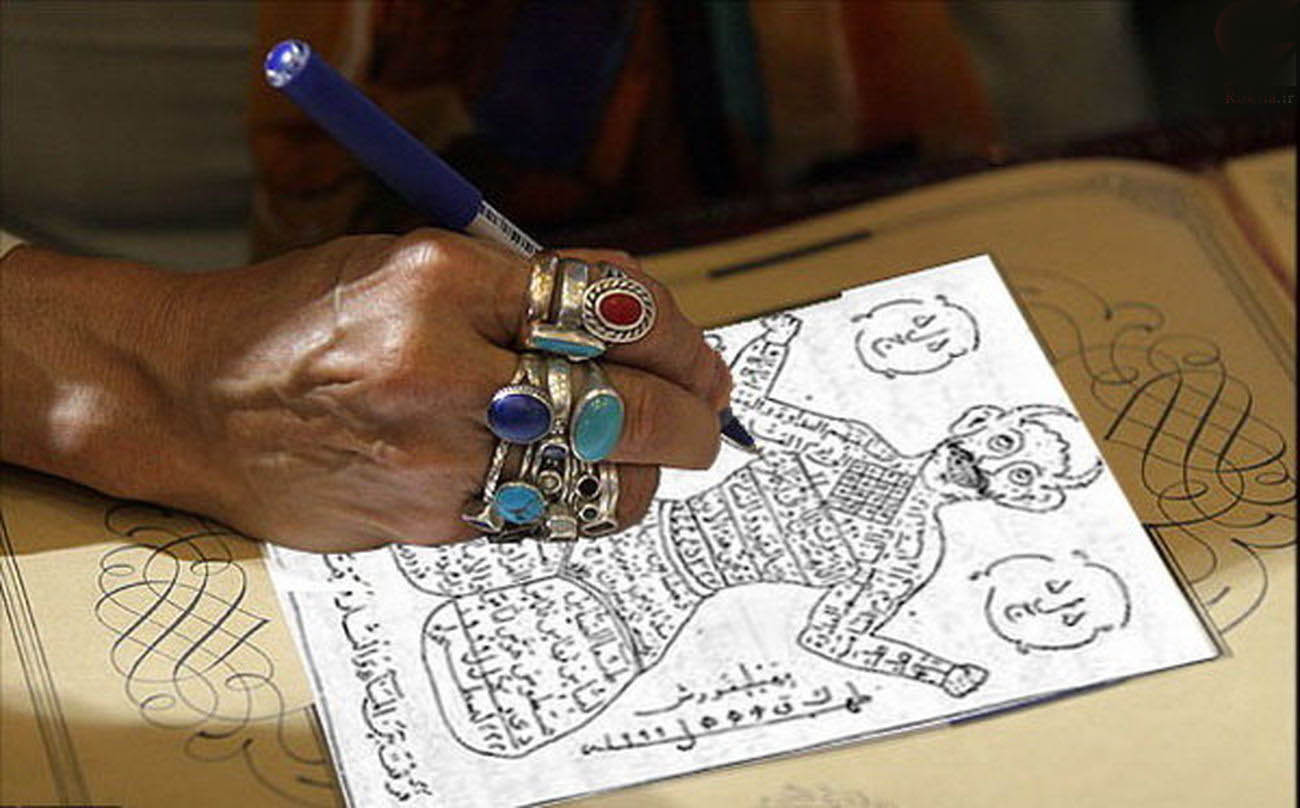
The different types of jinn are briefly discussed, though clear taxonomies for these (or other purely folkloric beings) is always hard to pin down. A commonly mentioned type is the ifrit, a particularly strong and cunning, and the marid, who is particularly immense. Other creatures — which may or may not be jinn — are the fiery samum, seductive female si’lat, and the notorious graveyard ghoul.
Decidedly evil beings like these would belong to a subclass of jinn called the shayatin (singular shaitan) related to the West’s “Satan.” While Shaitan may be used to designate the Devil or the chief embodiment of evil in Islam, a closer match to Lucifer would be Iblis.
According to most accounts Iblis is a jinn embraced by the angels as one of their own, but then cast from heaven to become the tempter of mankind and father of seven jinn kingdoms. In hearing a bit more about Iblis, we also have a look at how jinn fit into the Islamic creation myths: how they were created of fire, how they rebelled against God, were defeated and scattered to earth’s hidden corners. We also hear an amusing legend explaining why Iblis has one eye, and where one might go about finding a jinn egg for sale.
Our next topic is King Solomon — more the King Solomon of Talmudic and Islamic legend, than the more traditional Old Testament figure. In a number of tales from the early Middle Ages, shared by both Jewish and Muslim cultures, Solomon’s legendary wisdom comes, in part, from his magical mastery over the jinn or demons. This power is provided him by a ring known as The Seal of Solomon. Using this ring, he also compels them to construct the First Temple in Jerusalem.
A side story within this Temple legend regards a magic tool that is employed in this cutting of stones for the temple, the shamir, which oddly may either be a stone that can cut jewels and other stones, or… a fantastic stone-cutting worm. We also hear a couple legends of how one of the chief jinn obtained this ring from the king after the Temple was constructed, and the mischief and just rewards following.
Jinn possession and exorcism (“eviction”) is also discussed, as are the activities of certain Sufi brotherhoods in Morocco. Through ecstatic dance and music, members of the Hamadsha and the Aisawa brotherhoods are said to manipulate the powers of the jinn for good, but are perhaps more notorious for their demonstrations of supernatural empowerment that once featured rites of self-mutilation and other shocking acts.
Possession by the jinn is also subject a few noteworthy horror films that may interest listeners. A critics’ favorite is 2016’s Under the Shadow from Persian director Babak Anvari, a story examining supernatural encounters with the jinn within the historical setting of the Iranian revolution. Horror fans, however, may be more dazzled by the visual gymnastics of Turkish director Hasan Karacadag work. His horror films have been huge box office successes in Turkey and are marketed using the title of his breakout film, Dabbe, a reference to a figure wandering the earth in the Last Days — sometimes stylized as “D@bbe”.
Dabbe 3, 5, and Dabbe 6 have recently been made available online with English subtitles and well worth checking out if you’re interested in Eastern Folk Horror.
Toad Magic
Toads have long been associated with magic, as witches’ familiars and as a source both of poison as folk healing.
We begin with a poison allegedly brewed from a toad by the “wise wife of Keith,” Agnes Sampson, one of the accused in Scotland’s North Berwick witch trials in 1591-2. The poison was to have been used against Scotland’s James VI before he ascended England’s throne as James I. At the center of the trial was the accusation that Sampson and others had raised a storm to sink the ship bearing James home from Oslo with his new wife Anne of Denmark.
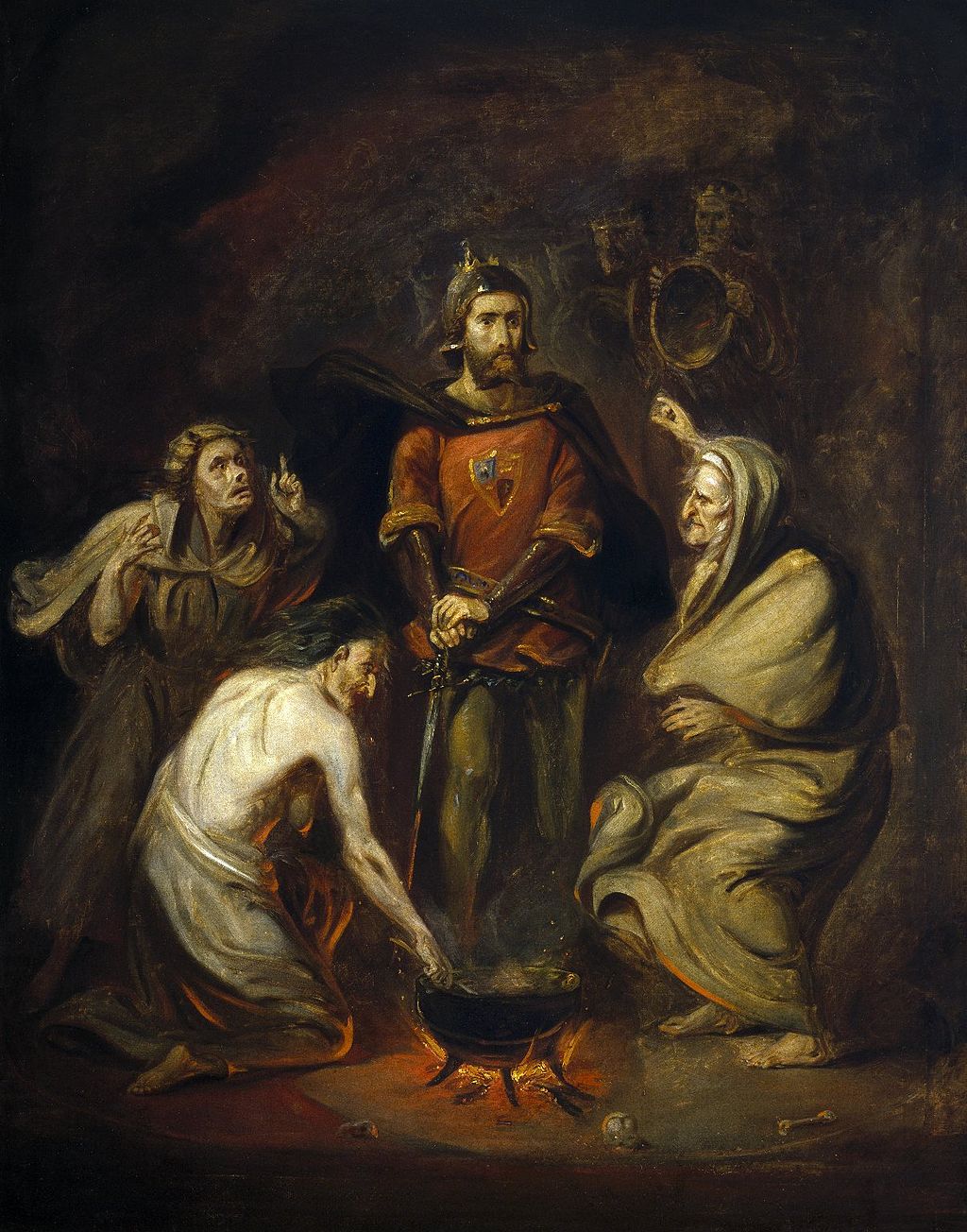
Shakespeare seems to allude to elements from this trial in his play Macbeth, mentioning toads and frogs as elements of the concoctions brewed by his witches in Act IV and seemingly referencing the events in an aside uttered by a witch regarding sending a storm against an enemy’s ship. The Bard’s inclusion of “real” witchcraft in his play has long been said to be the reason for a “curse” upon productions of Macbeth. Included in our discussion is a particularly ugly (and lethal) 1848 incident in New York City attributed to this bit of lore.
A witch’s servant, or familiar, in the form of a toad is also alluded to as an offstage character in Macbeth. Mrs. Karswell reads for us a number of accounts from 16th and early 17th century England presenting toad familiars sent to torment the enemies of witches. We also hear of a toad exploding in a fire, and toads sustained on the blood of their witch mistresses, as well as a sad story from Newmarket, England, involving William Harvey, physician to Charles I, and an bruitish attempt to subject an alleged toad familiar to scientific scrutiny.
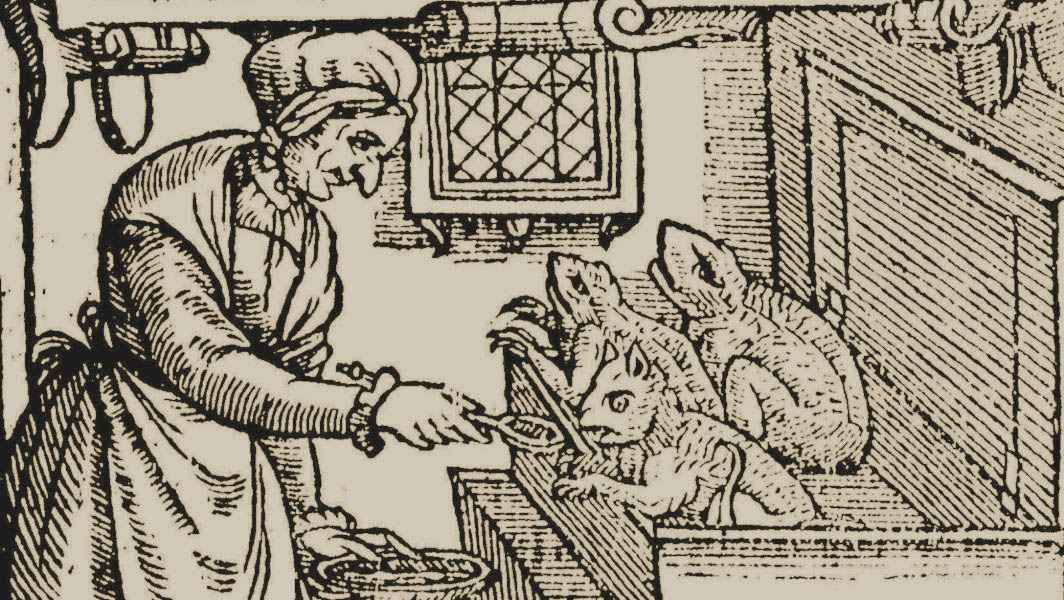
Next we discuss the fear of toad’s venom in the Middle Ages, hearing some comments on the subject from 12th-century German mystic and theologian Hildegard von Bingen and a tale associated with the English boy-saint William of Norwich involving some prisoners and an unfortunate attempt at the use of toad poison.
Toad’s venom, according to medieval folklore, could be neutralized by the toadstone, a particular mineral also assigned powers against stomach and kidney ailments. We hear of a peculiar method of obtaining this prized artifact and an obscure reference to the toadstone in the 1973 folk-horror classic The Wicker Man.
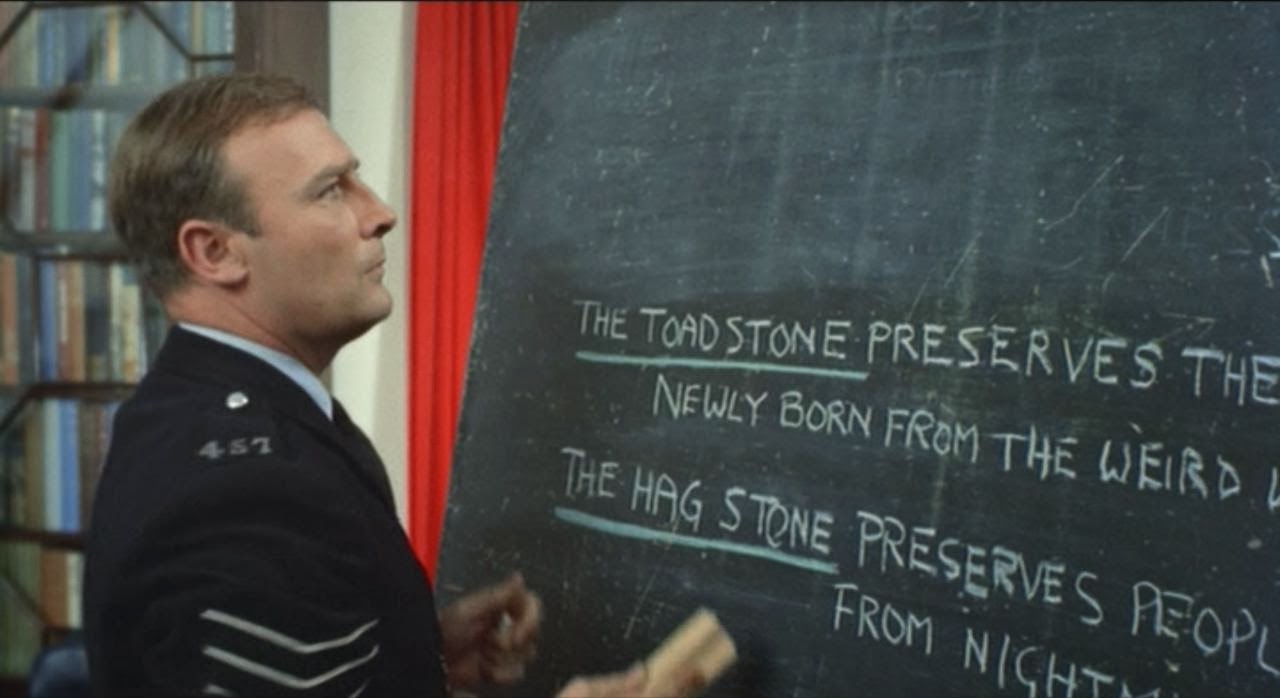
We also hear a clip from The Wicker Man in which a toad or frog is used in folk medicine to cure a sore throat. Superstitions about toads and their magical efficacy against various ailments continued into the 19th century, resulting in the phenomena of traveling “toad doctors” and “toad fairs.” The use of toad bones in a midnight ritual performed by English “Toadmen” in order to gain mastery of horses to be trained is also discussed as is the discovery of miniature frog coffins, stashed in Finish churches, in a folk-magic practice similar to the British and American use of “witch bottles.”
We return to the continent and the discussion of toads’ association with witches (and heretics) as conceived by the Church in terms of service to Satan. This topic brings us a letter written by Pope Gregory IX to bishops of the German Rhineland involving Satan as a french-kissing toad, as well as a ritual attributed to French and Italian members of the Waldesenian sect allegedly consuming a ritual beverage brewed from toad excrement.
In Spain’s Basque province of Navarre, home to the “Cave of Witches” at Zugarramurdi, witchcraft trial testimonies demonstrate a particular emphasis on toads. We hear of them raised by novice witches in the fields, used to poison the land, and dancing at the witches’ sabbath.
Toads are sometimes mentioned as an ingredient of the “flying ointment” believed to have induced a visionary experience transporting witches to hilltop revels. However, this effect is more likely attributed to other ingredients in historical recipes (particularly plants of the nightshade family.)
While the venom produced by toads of the Old World doesn’t seem to contain the quality and quantity of bufotoxin necessary to produce such visions, this can’t be said for certain New World species.
One of these is the Cane toad (bufo rhinella) that invasive species best known for infesting Australia, Florida and other southern states and native to South and Central America. In the Caribbean, it’s been identified by Harvard ethnobotanist Wade Davis as a possible ingredient in a drug administered in Haiti to transform an enemy into a zombie, (i.e., to drug the individual into a deathlike state from which he is later “resurrected.”). Research into this subject was documented in Davis’ 1985 book The Serpent and the Rainbow, later serving loosely as inspiration for Wes Craven’s 1988 film of the same name (from which we hear a clip).
The show ends with a quick look at the role of the Colorado River toad or Sonoran Desert toad, (bufo alvarius) as a source of psychedelic experience, particularly as its been reinvented with the last years as part of a life-changing “shamanic experience” for drug consumers already bored with ayahuasca.
Slavic Mermaids: Water Ghosts and Goblins
Quite distinct from their Western equivalent, Slavic mermaids might better be described as water ghosts, as they are almost always the spirits of departed females, while their male equivalent takes the form of a water goblin or water sprite. The Russian word for mermaid is rusalka (rusalki pl.) and male creature is a vodyanoy. Similar words are used in other slavic languages, though the Czech water goblin is known as a vodnik.
The rusalki are found not only found in Russia, Ukraine, and Belarus, but also Poland, the Czech Republic, Slovakia, Serbia, Slovenia, and Bulgaria. And they’re honored with their own holiday, Rusalka Week, just now coming up in early June.
While they are usually active only at night, during Rusalka Week, they emerge in the daylight when they may be seen dancing, singing, or playing usually in groups. As they lack the fish tail of Western mermaids, they may also venture into forests and fields for such activities, but while in the water, they may also pull swimmers, fishermen or others near the water to watery deaths. We open the show with a clip from Mermaid: Lake of the Dead, a 2018 Russian horror film about a rusalka, which depicts the creature in this malevolent aspect.
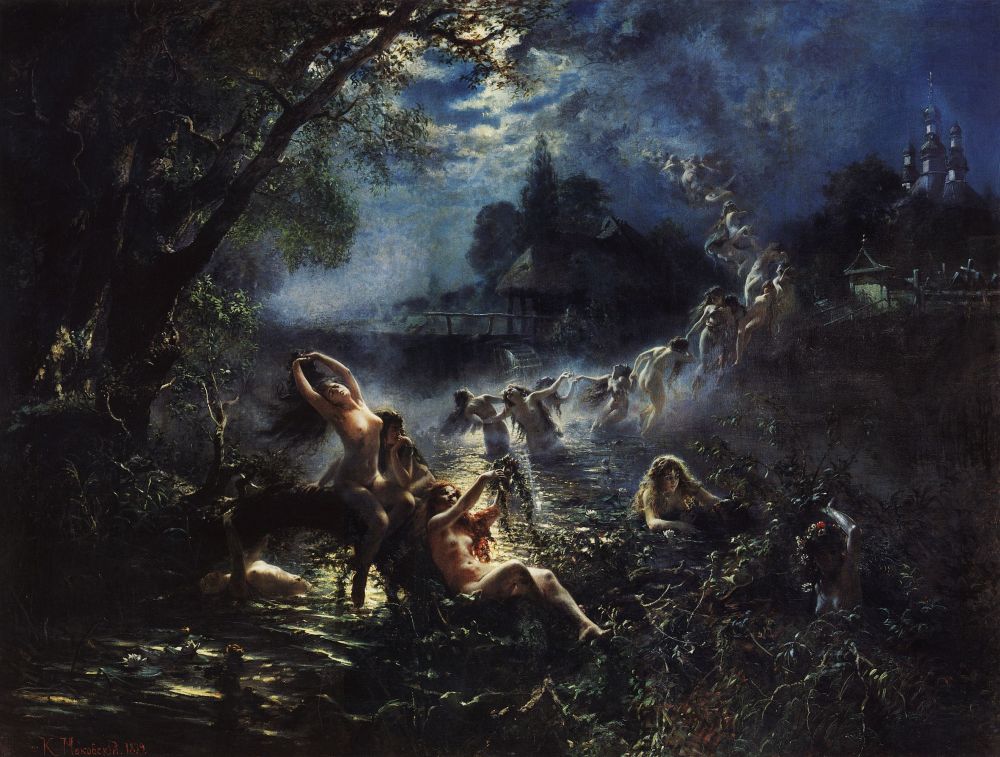
Not just any woman who dies will become a rusalka. Typically, she would have died by violence, suicide, or sudden accident, particularly drowning. Often these deaths are related to misfortunes in love, rejection by lovers, or suicides due to unwanted pregnancies. Because of this, the rusalka is particularly focused on capturing men with no interest in attacking adult females. Men who fall prey to them are either believed drowned or may live with them in a sort of underwater spirit limbo in their richly appointed palaces of crystal, gold, and silver. Occasionally, their would-be victims may overcome them by the power of the cross, or in rare cases, they may even be domesticated into mortal life (with varying success). Mrs. Karswell reads several typical and atypical tales describing the interactions of rusalki and men, ones collected from informants in turn-of-the-century studies by Russian ethnographers
While rusalki are most interested in men, they may sometimes capture girls and boys to be kept as the children they failed to have in life. Infants may also become rusalki if they die unbaptized, and will wander the earth in that form for seven years seeking someone who might free them by performing a christening. After that, like other rusalki, they remain in that undying form until the end of the world.
Prior to the 19th century, it’s not clear the rusalki were always regarded as the ghosts of unfortunate females. Instead, they seemed to play some role in connection to fertility. This is particularly clear in Ukraine, where the rusalki (or creatures nearly the same) are called mavka and a figure called Kostromo is both the center of early spring fertility rites and known the first female to become a mavka. “Mavka” is also the name of under which a contemporary Ukranian musiican performs songs composed, in what she calls “the language of mermaids.” We hear a clip from one of her performances.
Rusalia Week, or Rusalia, is tied to the date of Pentecost or Whitsunday. It’s also known as “Green Christmas” or “Green Holiday” as homes and churches are decorated in greenery, and celebrations take place in birch forests where young women and girls wear crowns woven from flowers and plants. It takes place either 40 or 50 days after Easter, and the biggest celebrations take place on Semik (from the Russian word for “seven,”) the seventh Thursday after Easter, which is June 4 this year. We describe some rather curious rituals around birch trees involving symbolic dolls used to represent the rusalka, and how these are understood to symbolically free the restive spirits from their existence as rusalki.
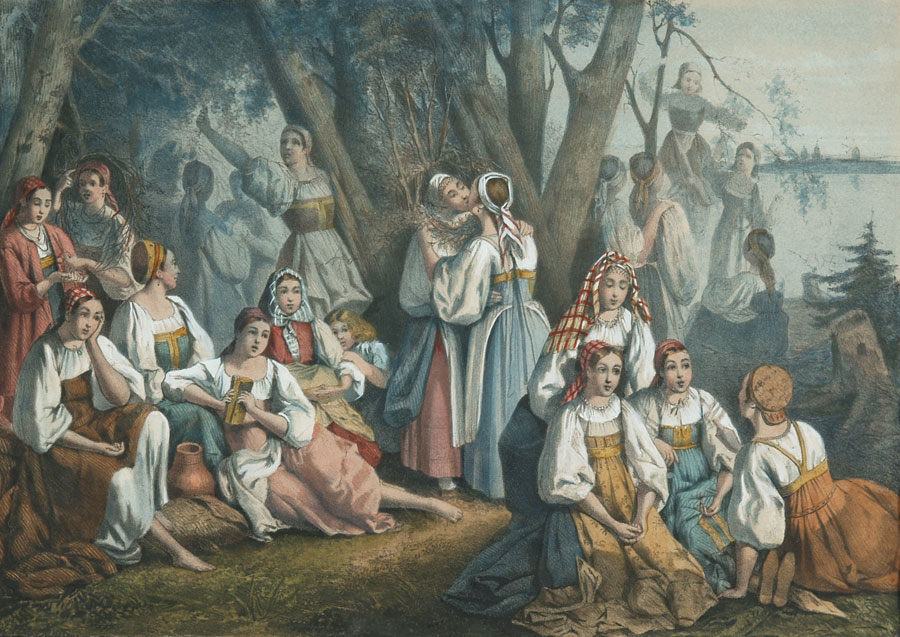
Rusalia celebrations embrace both aspects of the rusalki — their post 19th-century incarnation as dangerous ghosts, and an older pagan understanding of these beings as bringers of regenerative moisture and fertility of crops. We also hear a few accounts describing tried and true methods for evading rusalki attacks particularly common during this period.
The rusalka folklore has been adapted into a number of Slavic productions over the years. We hear of a rusalka in Russian novelist, poet, and dramatist Nikolai Gogol’s 1831 collection of stories Evenings on a Farm Near Dikanka, which served as the basis of a loopy but fun Russian TV series, Gogol, from which we hear a clip. ( A rusalka briefly appears also in Gogol’s Viy, adapted into a cult classic film of 1967, Viy Spirit of Evil, from which we hear a clip.
Rusalka folklore has been a popular subject for opera. Alexander Dargomyzhsky’s Rusalka, which premiered in 1856 was based on a nearly finished verse drama by Alexander Pushkin. Its tragic tale involves not only a a vengeful adult rusalka, but also a dangerous child rusalka, and a madman who believes he is a raven.
The better known Rusalka opera, which premiered in 1900, is by Czech composer Antonín Dvořák. Best known for its lovesick aria “Song to the Moon” in the first act, its story draws partly on Slavic folklore and partly on Hans Christian Andersen’s “The Little Mermaid” to tell its equally tragic tale. A vodnik or “water goblin” is cast as the father of the character given the name Rusalka, and the opera also features the witch Jezibaba, the Czech equivalent to Baba Yaga.
Dvořák liked to say the opera was inspired by fairy tales of popular 19th-century poet Karel Erben, namely his 1853 collection Kytice, which means “bouquet”. (The book was given a particularly sumptuous treatment int the 2000 adaptation known in English as Wild Flowers.) While in fact the opera borrows nothing directly from Erben’s stories, Dvořák did more explicitly embrace one of Erben’s pieces in his symphonic poem known in English as “The Water Goblin.” Mrs. Karswell reads for us the climactic scenes of this tale, which is gruesome even by Bone and Sickle standards.
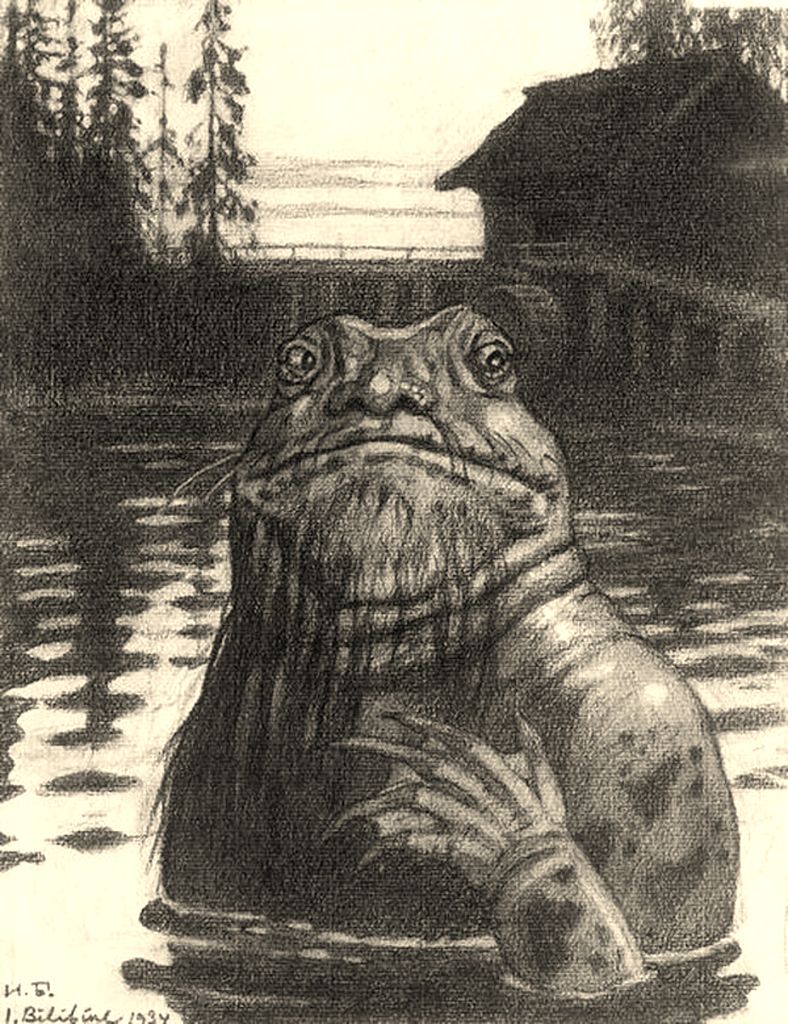
After a bit of further discussion of the vodnik and its Russian near-equivalent, the vodyanoy, we address the elephant in the room — the fact that the rusalki are said to tickle men to death. I share a few comments on reference to historic tickle torture, as well as some anecdotes from the much more amusing history of death by laughter.
Holy Puppets, Medieval Robots, and More
This episode looks at puppets given life through magical or mechanical means, holy puppets of the Catholic Church, medieval robots, an early automata of gothic literature, some related films, and an Alpine sex puppet that only puts up with so much.
We begin at the end of Carolo Collodi’s original Pinocchio story, or at least the end of the story’s first draft as serialized by the Italian children’s magazine, Giornale per i bambini in 1881. As is our way, we examine some of the darker elements of the tale that never made it into the 1940 Disney film, (though we do hear a snippet of one particularly dark scene from that film.)
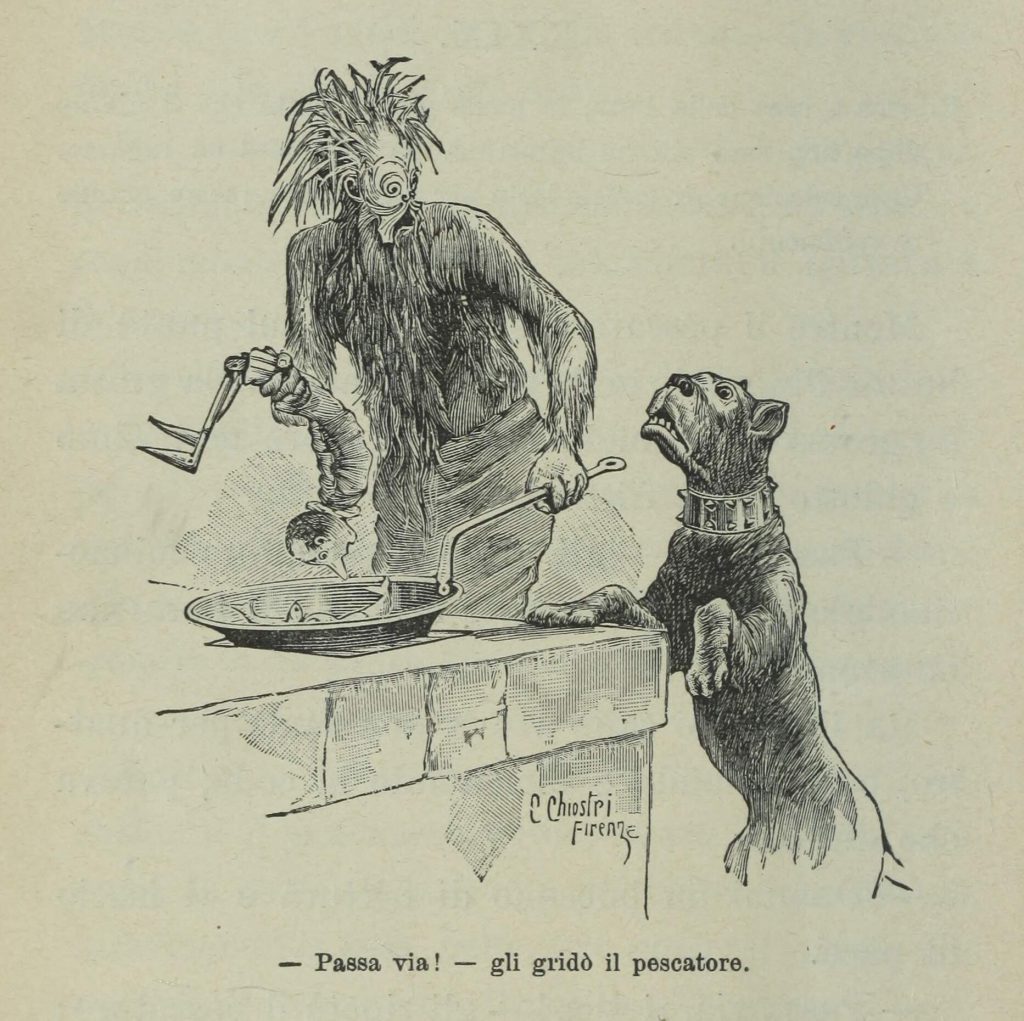
Long before Collodi imagined his marionette, the medieval Church made use of puppets, or jointed figures, that could be manipulated to enact Christ’s Passion during Easter week. Along with jointed shoulders allowing a figure of the Savior to be naturalistically unpinned from the cross, many of these puppets featured joints at the knees, elbows, and hips; some had rotating heads, and some fingers jointed to match each skeletal bone. Others were rigged to bleed, roll their eyes, or even appear to speak. We hear a report of a particularly bizarre method used to simulate tears in one figure from Germany as well as some interesting trickery resorted to by Bernese monks in the 1600s.
One of the most famous of these figures, especially because of its strangely lifelike skin, is the Christ of Burgos, Spain. Mrs. Karswell reads for us a passage mentioning a particularly gruesome legend associated with the figure from French poet and writer Théophile Gautier’s 1843 book, Wanderings in Spain.
Another famed Christ puppet was the 15th-century Rood of Grace once housed at a now ruined abbey in the town of Boxley in Kent. A number of miraculous abilities were attributed to this figure, which was attacked (literally) by Protestant Reformers as an example of Catholic chicanery. We hear of its unseemly end and an equally unseemly ballad by which Cromwell’s men mocked the figure in bawdy verse.
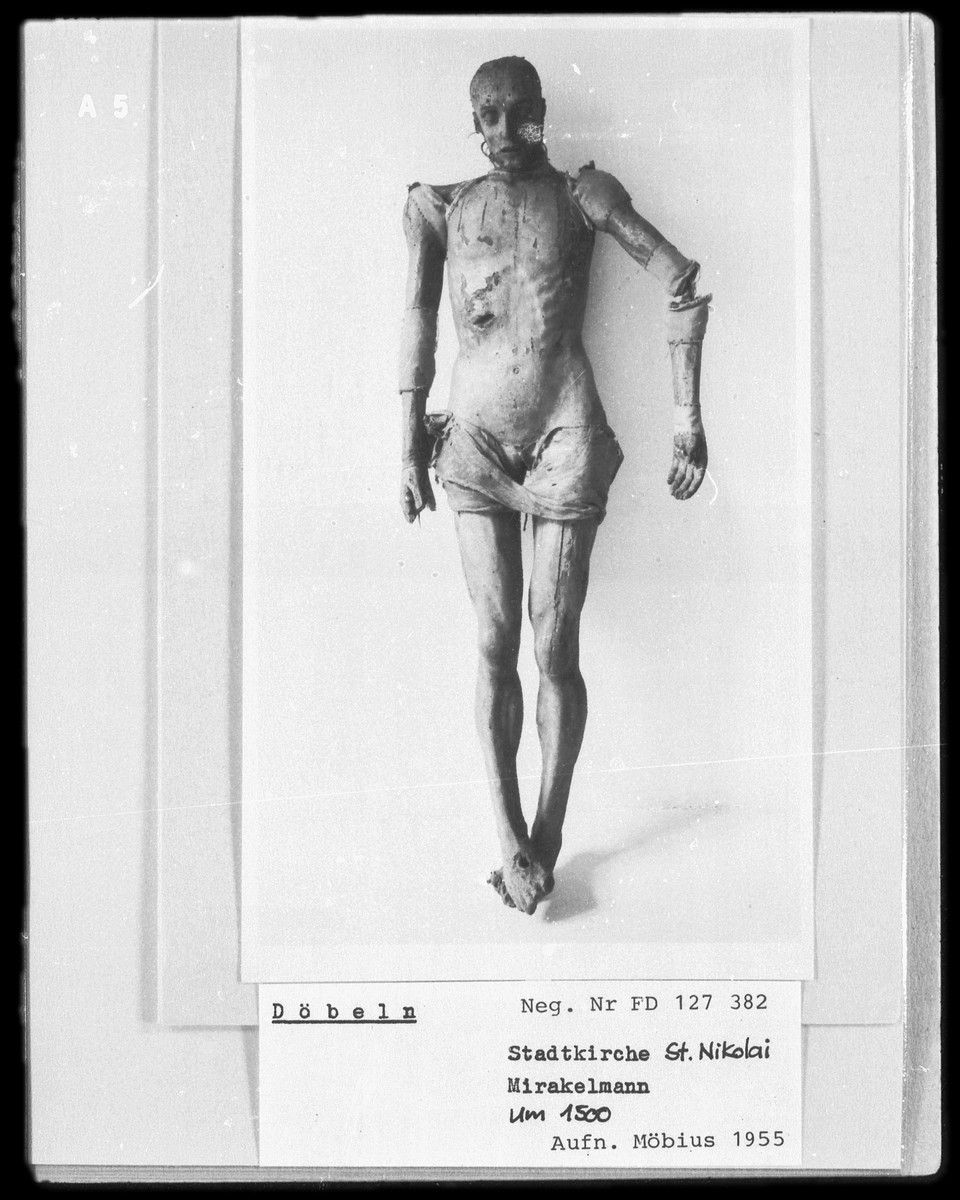
Spain’s particularly rich heritage of mechanically animated holy figures owes much to Muslim innovations there. It was from here that geared devices such as astrolabes entered the West, and here that that weight-driven clocks were employed almost two centuries before their use elsewhere in Europe. We hear a few examples of Eastern travelers tails of automated wonders (and automata) from the first century, including one describing the remarkable Palace of the Tree in Baghdad.
Such real-world (if a bit mythologized) accounts were an inspiration in the medieval West, particularly in the Anglo-Norman epic poems or Romances of the 13th century. We hear some passages describing the mechanical marvel’s of the fairy Esclarmonde’s bedhcamber from the Romance of Escanor by d’Amiens and of a confronation between the knight Huon de Bordeaux and a pair of giant men of copper armed with flails.
Esclamonde is an interesting figure as she is sometimes said to have been tutored by Virgil, the ancient Roman poet, who in medieval legends had become something of a wizard. There are dozens of tales of Virgil crafting of metal assorted mechanical or magical wonders: flies, horses, human figures, and a serpent (or lion) which predates the legends associated with the Bocca della Verità (mouth of truth) adored by tourists in Rome (and described by Cary Grant in the clip we hear from the 1953 film Roman Holiday). Virgil’s enchanted castle in Naples was also said to be guarded by men of copper, armed with flails — as in the Norman poem. And we hear of a strange ritual whereby the wizard was said to have attempted to cheat death, one involving a bit of butchery and grievous mistakes.
We also look at the 13th century tale known as the “Prose Lancelot” as well as Chrétien de Troyes’ telling of the Perceval legend, both from the same era and both featuring animated men or beasts of metal with which the knights must grapple. In these cases, however, the figures are animated by demons who must also be defeated.
Often these medieval robots would be presented in scenes depicting underground treasure-houses or tombs. We hear one such story told in a William of Malmesbury’s chronicle Deeds of the Kings of the English, and another from the French Romance of Eneas.
The legends of Tristan and Isolde also furnishes us a similar example in a 12th-century version by Thomas of Britain. It features Tristan romancing a mechanical replica of his beloved Isolde, who resides in his secret “Hall of Images” along with a mechanical maidservant and mechanical dog.
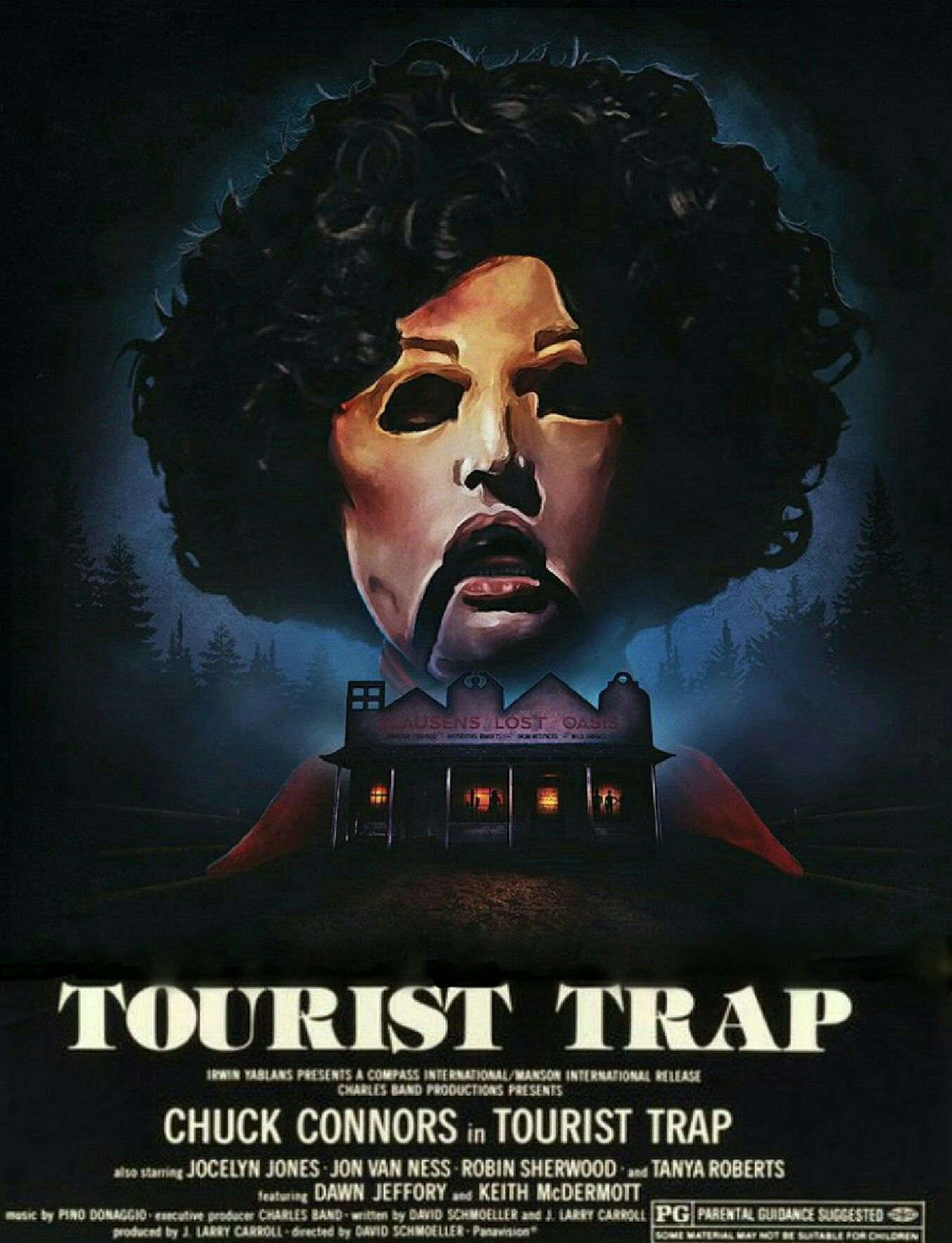
The psychological morbidity of Tristan making out with a lost lover is reflected in a few bizarre horror films from the 1970s. We discuss 1979’s Tourist Trap and 1971’s Vincent Price vehicle, The Abominable Dr. Phibes, both of which feature automata. We also hear a bit about the 19th-century German writer E.T.A. Hoffman’s short story “The Sandman,” which features a mechanical woman who becomes the object of the narrator’s crazed obsession. You can read this delightfully dark and invenntive story in English here.
Our final lifelike puppet comes from the Alpine legend of the Sennentunschi or doll used (erotically) by the lonely herdsmen (or “Sennen”) during their long seasonal isolation on remote mountain pastures. Created out of rags, straw, and other odds and ends — initially out of boredom and mischief — the doll is brought to life by an irreverent “baptism,” and after serving the herdsmen enacts a gruesome revenge for the indignities it suffers at their hands. We hear a clip from the entertaining Swiss film of 2010, Sennentunschi, and hear of an actual specimen of a Sennentunschi doll (or one assumed to serve this function, sans supernatural animation) discovered in 1978.
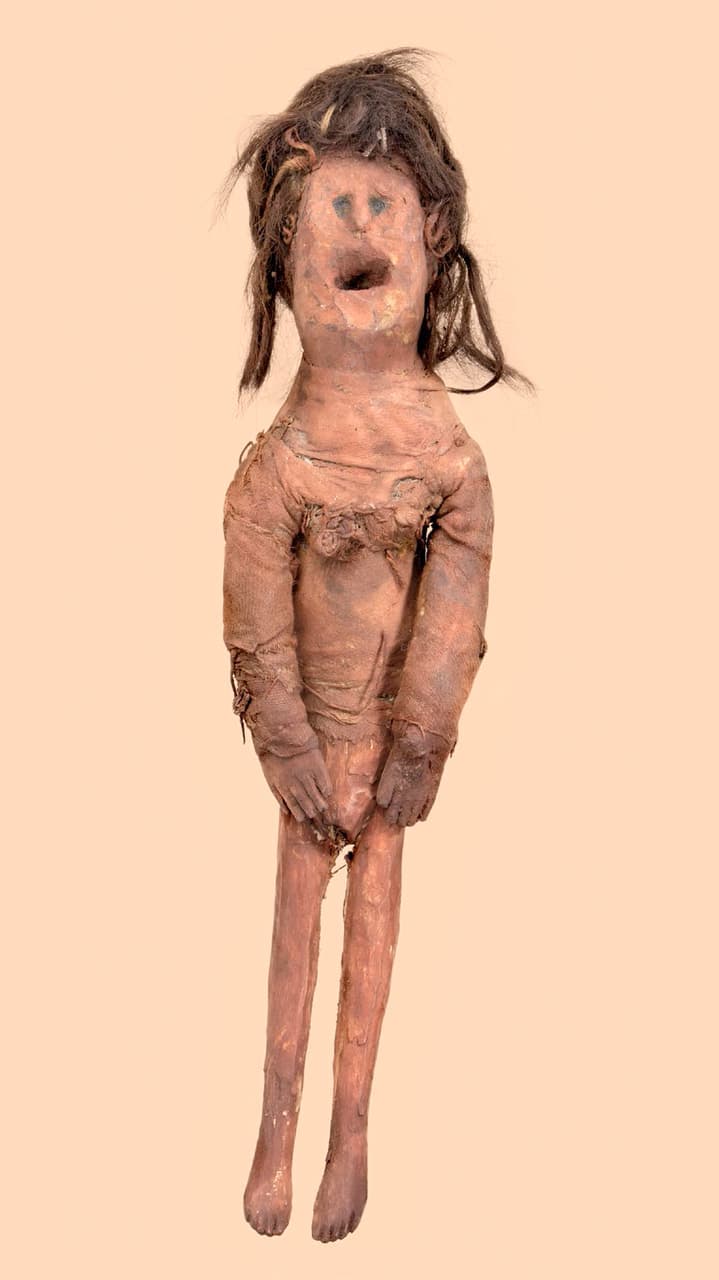
There’s a parallel in the Sennentunschi story to the Czech legend of a childless couple adopting a log, which comes to life, which served as the basis for the 2000 film, Little Otik, by stop-motion master director Jan Švankmajer (We hear a clip from this too).
The show closes with a look at an unlikely connection between our topic and Alvin Schwartz’s juvenile folklore classic Scary Stories to Tell in the Dark and a tragic tail connected to the 1940 production of Pinocchio featuring the artist formerly known as Ukulele Ike,
A Journal of the Plague Year
The Great Plague of London of 1665 to 1666 is vividly portrayed in Daniel Defoe’s A Journal of the Plague Year, which we’ll be examining closely in this episode. As the text is quite entertaining (much more so than his better known Robison Crusoe) we’ll be hearing more extensive quotes from the material than usual, delivered as usual by our diligent reader Mrs. Karswell.
We begin with a look at the presumed connection between the nursery rhyme, “Ring Around the Rosie” and the Black Death. Though the facts here may not satisfy our desire for macabre secrets hidden in plain sight, we will find evidence for something similar in a children’s song we review at the show’s conclusion. We hear a snippet of the song as rendered in the game Dead Space.
Defoe’s book occupies a strange place between history and historical fiction. As Defoe was 5 years old in 1655 and the book was published in 1722, the story is technically a work of fiction. However, the narrative is an excellent window into contemporary perceptions of the tragedy as well as treasure house of factual information. Characters within the story are nearly all actual individuals. Particular events described have widely been corroborated in contemporaneous accounts. Particular dates and locations are also meticulously anchored in reality – so much so, that scholars have frequently treated it as a contemporaneous source. Hints given in the text suggest that Defoe was in fact telling the story of his uncle, Henry Foe, who lived through the Great Plague in London and shared a profession (saddler) with the story’s narrator.
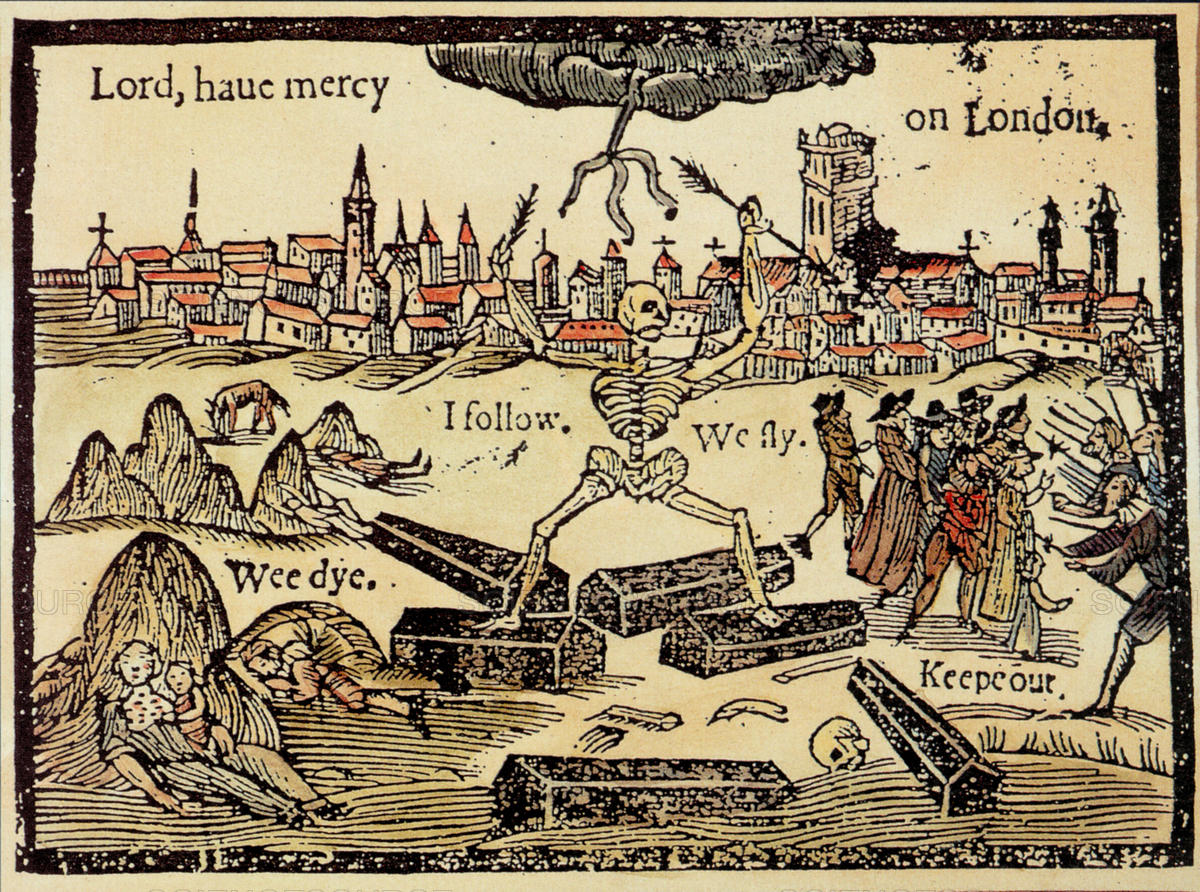
Part of what makes the book so fascinating is Defoe’s meticulous cataloging of the way in which Londoners reacted to (and anticipated) the plague in terms of omens and astrological predictions and biblical prophecies articulated in pamphlets, broadsheets, and almanacs of the day. Here, the sighting of two comets over England as well as the biblical and numeric significance of the approaching year 1666 play a large role. He also describes predictions of doom were also shared by visionaries and eccentric personalities on the city’s streets, such as those shared by the Quaker Solomon Eccles, known to Londoners as “Solomon Eagle,” a self-styled prophet who roamed the city with a pot of burning coals atop his head.

Defoe’s narrative also relishes some detail on the symptoms of the disease, the madness it brought upon those suffering from these symptoms, and the dreadful treatments offered by contemporary doctors. We hear a number of passages describing these aspects, including horrific accounts of patient suicides and a lethal kiss offered by an insane victim of the sickness.
Also included in A Journal are extensive quotes from municipal edicts stipulating how the emergency was to be addressed. From these descriptions we learn of the “Searchers of the Dead,” old women who roamed the city with red wands, prodding at corpses to determine which had succumbed to the disease, and of the watchmen posted at the doors of quarantined homes to ensure that those within (sick and healthy residents alike) remained incarcerated until the afflicted either recovered or was carted to the plague pits. We also hear how these measures were defeated by more devious citizens.
Corpses, which were placed outside homes (or later those that simply fell dead in the streets), were picked up by “dead carts” preceded by a bell ringer. Pickups and burial in the plague pits were only performed at night to avoid further distressing the citizenry. He hear a particularly dramatic description of the narrator’s visit to one of these pits and an encounter with a grieving loved one there and his rough treatment by cynical drunkards in a tavern to which he retreats.
Unfortunately for Londoner’s the Great Plague was followed by the Great Fire of London in 1666. While the death count from the plague had already begun to drop sometime before the fire, it was nonetheless commonly believed that this disaster somehow put an end to the epidemic or even, in some way, purified the city of its sickness. We hear a clip of the song “London’s Burning,” commonly associated with the 1666 fire despite its mentioning anachronistic “engines” sent to extinguish the flames.
Defoe’s Journal also includes another story related to a song. It’s his retelling of a legend circulating in London at the time inspired by a story from Vienna. It relates how a piper, a tavern entertainer, becomes grievously intoxicated and while passed out, is picked up by one of the dead carts and is deposited, while still unconscious, in a plague pit — thankfully awakening before earth is shoveled in. The story was eventually turned into the Viennese song “Oh du lieber Augustin,” (Oh, my dear Augustine) in the 1800s, and attributed to Markus Augustin, a minstrel and piper, who lived through the Great Plague of Vienna in 1679. While it’s set to the innocent-sounding melody of “Have You Ever Seen a Lassie,” the grim lyric tells how the piper has lost everything to the plague, like the city of Vienna itself. But its cheery tune and the fact that the singer has lived to tell his story has made it an anthem of survival for the city — and popular song throughout German-speaking lands. We hear a snippet of the song rendered in period-appropriate style by Ensemble Unisonos.
We end the show with a custom mashup of “Oh du lieber Augustin” and the curiously similar dead-cart scene from Monty Python and the Holy Grail.
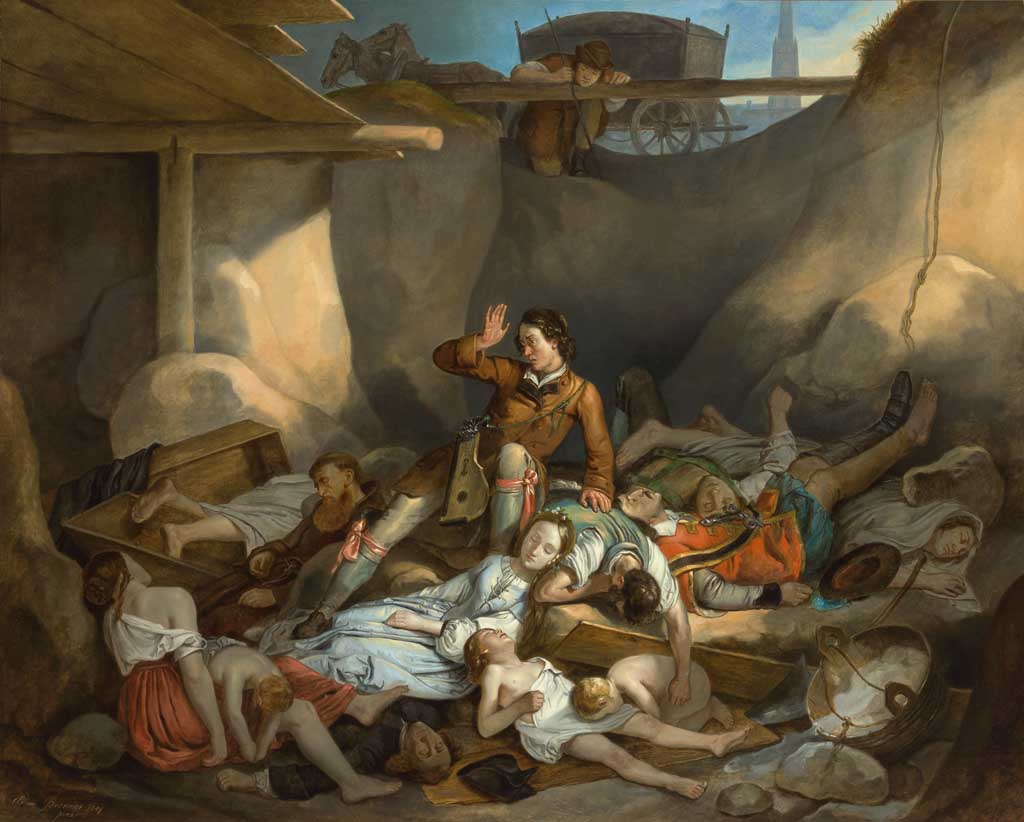
The Plague Doctor Unmasked
The figure of the masked plague doctor is an object of intense fascination but also the subject of much misinformation. This episode sorts things out while seeking particular evidence for such handsomely dressed character in the historical record.
We begin with a few clips from horror films in which plague doctors figure, including the 2008 film The Sick House in which the spirit of a plague doctor menaces an archeologist, and the 2019 film The Cleansing in which a malevolent bird-masked “Cleanser” stalks through 14th-century Wales.
As most listeners are somewhat familiar with the plague mask and its presumed function, we get that out of the way first, noting the mask’s connection to the antique belief in miasma, or disease-carrying air as the cause of the plague and other ailments. We also clear up the misunderstanding that the plague doctor is a medieval character (since he only appears in the 17th century).
His first appearance is in a German broadsheet from 1655, in which the crow-like character identified as “Dr. Beak” and lampooned (along with doctors in general) for being greedy as carrion crows. As this image was copied and recopied for centuries, it raises the question as to whether the birdlike mask was in fact drawn from life or created strictly in the service of this original broadsheet’s metaphor.
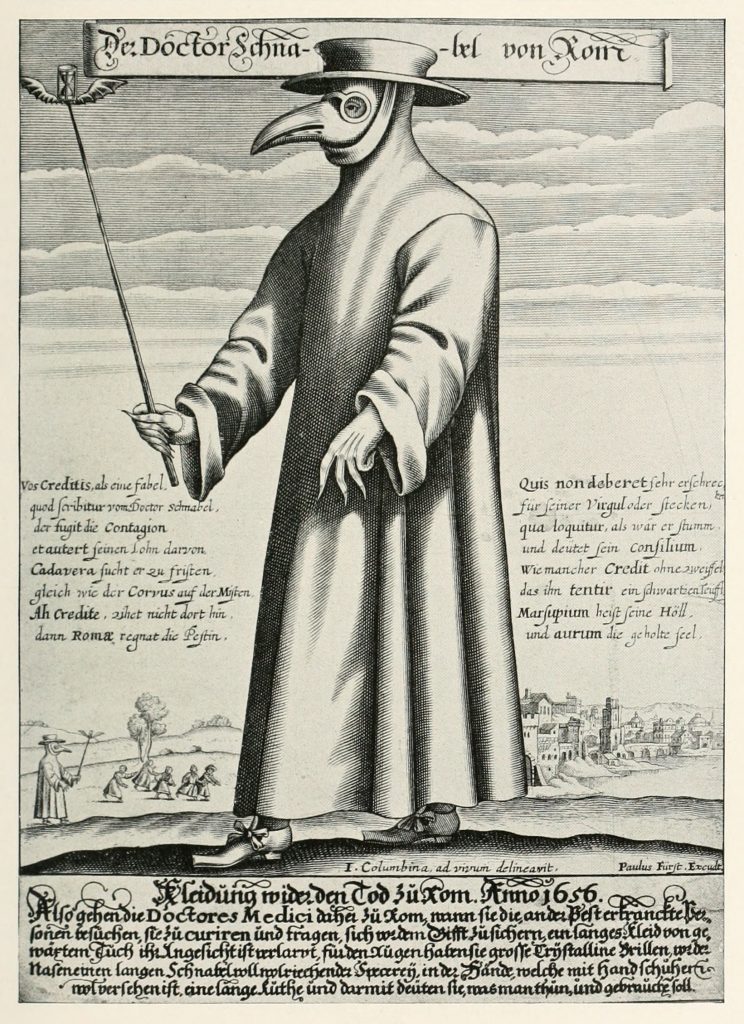
Next we look at other evidence for the character in the form of actual artifacts, including two masks exhibited in museums in Berlin and Ingolstadt, Germany.

As there are reasons to doubt the authenticity of these, we next look at evidence of plague masks associated with the island of Poveglia in the Venice Lagoon. Along the way, we learn a bit more about early measures the city took against the plague (including the invention of the concept of shipping quarantines along with coinage of the word).
We also review a bit of general information about the islands in the Venetian lagoon (including others besides Poveglia) used for the clinical isolation of victims of plague, leprosy, and the mental illness. A photo taken on Poveglia in 1899 is discussed as it may show an actual plague mask in use in the late 19th century. We also hear some snippets from the TV Show Ghost Adventures, which popularized a number of legends associated with Poveglia, including tales of asylum torture and suicide.
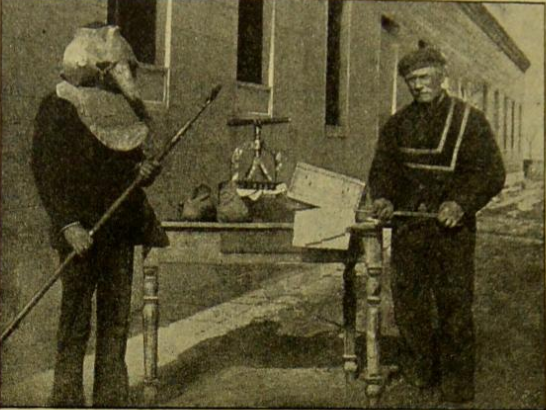
Next, we look at the first textual evidence for this plague mask and suit, in a 1682 volume attributing its invention to Charles de Lorme, royal physician to Louis XIV and the Medici Family, among others.
While the design of the mask seems to be a first with de Lorme, we also hear of some other uses of protective plague garments are documented in France and Italy around this time.
A surprising example from Basel, Switzerland provides rare evidence of particular doctor known to have worn a plague suit and mask. It’s 17th century painting of the family arms of the Zwinger family of Basel, painted for the doctor and theologian Theodor Zwinger the Younger, and depicting him in a plague mask and suit.
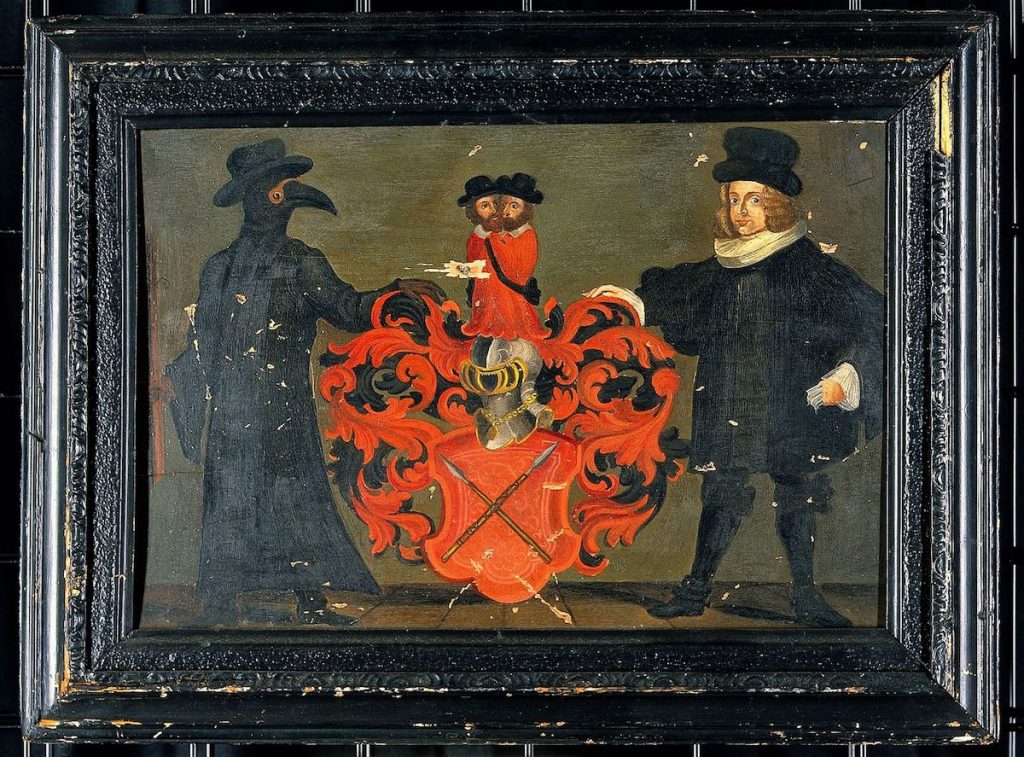
We also have a look at the symbolic use of special historic plague garments, special colors worn in France and Italy for medics working with plague victims, and the symbolic and practical function of the stick or baton held by the the plague doctor in most every historical illustration.
The Great Plague of Marseille (1721 to 1722) provides us one more name of a doctor known to have worn a plague suit and mask. His name was François Chicoyneau, and his efforts were not well received by the citizens he was assigned to serve in Marseille, as we hear.
Along the way, Mrs. Karswell provides us some contemporary accounts documenting other aspects of the Marseilles plague, the last bubonic pandemic of Europe, including novel means of disposing of plague corpses considered by the town council, a curiously relevant form of social distancing, and the basis of the legend of “Four Thieves Vinegar.”
Finally, we discuss those plague doctor masks worn in the Venetian Carnival, learning that they are a strictly modern creation not associated with the 16th-18th century commedia della’arte tradition that gives us the other masks.
We end with a strange parallel between an opera about performers in the commedia della’arte and a 1928 film starring silent horror great Lon Chaney, Sr. Included is a bit of music used to promote the film in question, Laugh Clown, Laugh.”
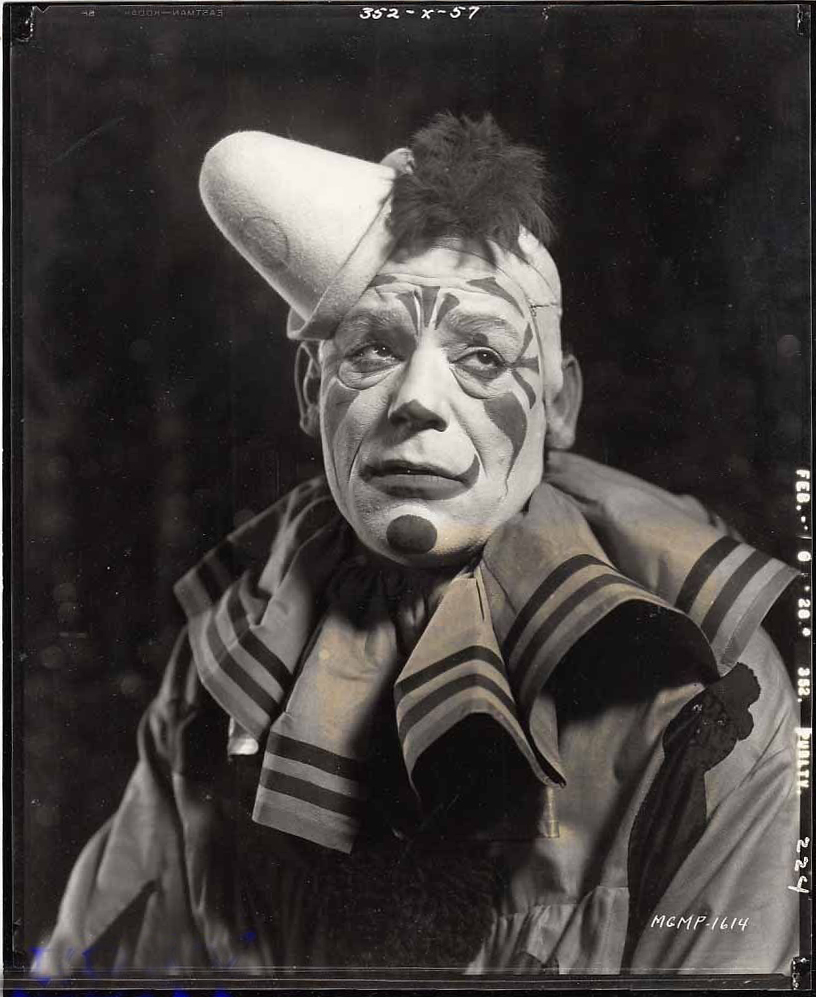
Banshees
Banshees are spirits of Irish folklore, who warn of impending deaths. Originally considered fairies, their Irish name, bean sídhe, means “woman of the mounds,” those mounds (sídhe) being the ancient burial mounds believed in Ireland to be the home of fairies.
The banshee’s wailing, which betokens imminent death of a blood relative, is probably based upon the wailing of Irish mourners called “keeners,” from the Irish word caoineadh, or “lament.” You can hear some snippets of traditional keeners in this segment, incliuding a 1957 field recording released by Smithsonian Folkways.
Next we look at how the banshee’s appearance and behavior derives in part from that of Irish keeners, including some odd details having to do with petticoats. Her origins in the fairy world also has often suggested that she may be small of stature. We also examine some folktales involving combs lost by or stolen from banshees, and what you should or should not do should you find one.

While the banshee is attached strictly to particular families, she is not bound to the Emerald Isle. We hear some accounts of her following travelers to other countries, including a surprising tale involving a party aboard an Italian yacht.
The figure, as she’s known today, receives no mention in print until the 17th century. Mrs. Karswell reads for us what is probably the earliest account, retelling an incident experienced by Lady and Sir Richard Fanshawe, an English ambassador and his wife visiting Ireland.
This account also introduces the notion that a banshee may not originate in the fairy world, but may also be a vengeful ghost. We hear another tale in this mode associated with Dunluce Castle in County Antrim, a location known for its “banshee room,” a feature duplicated in Shane’s Castle, about an hour to the south. Both of these castle banshees are sometimes called “the red sisters,” so named for the color of their hair.
After a brief side trip to make note of figures similar to the banshee in Scotland (the caoineag) and Wales, the cyhyraeth and gwrach y rhibyn, we turn to older figures of the fairy realm regarded as banshees, but rather different from the figure born in the Early Modern Period.
The first of these is Clíodna, who was known as the queen of the banshees of southern Ireland, particularly the province of Munster. Unlike the modern banshee, a solitary figure who does little more than wail and make those well-timed appearances, Clíodna engages in romantic affairs, including a romantic rivalry with her banshee sister Aoibhell, a matter culminating in a magical battle with both transformed into cats.
Aoibhell also appears in an important story about Brian Boru, founder of the O’Brian Dynasty, whose army defeats an alliance of Vikings and Irish lords fought at the Battle of Clontarf, near Dublin in 1014. While Boru’s forces are victorious, he and his son are visited by Aoibhell, who heralds their deaths not with a wail, but music played on her harp from the fairy world. We hear a similar story about the Irish hero and demi-god Cúchulainn encoutering Aoibhell as a death omen.

Cúchulainn also encounters a banshee-like figure of the type folklorists call, “the Washer at the Ford,” or in Celtic regions elsewhere, like Celtic Britanny, “the Midnight Washer.” The figures appear at lonely bodies of water washing bloody shrouds, or often armor, as they are particularly inclined to predict the deaths of soldiers and armies. We hear a particularly splendid account of one such figure from the 12th-century Triumphs of Torlough — one, which in its generous use of horrific adjectives sounds as if it were written by H.P. Lovecraft.
The episode ends with a quick look at a couple cinematic bamshees, including one which has earned a place in the nightmares of children encountering it in the 1950s-70s. The two movies we hear bits of are Damned by Dawn and Darby O’Gill and the Little People.

Dead Teeth: Fairies, Rats, and Worms
Explore the folklore of the Tooth Fairy and teeth, particularly dead teeth — those lost by children or adults, and those removed from skulls.
We open with a brief look at the Tooth Fairy as inspiration for horror films, hearing a bit about (and a montage of clips from) Darkness Falls (2003), The Tooth Fairy (2006), The Haunting of Helena (2013), and Tooth Fairy (2019). Though none of these films were particularly successful with critics or audiences, there would seem to be some worthwhile horror inherent in the childhood ritual — psychological vulnerabilities related to the child’s trust of parents, nighttime intruders, and the death of a body part. We also hear a bit about the SyFy Channel’s 2016 show Candle Cove (Season 1 of Channel Zero), which also featured a Tooth- Fairy-inspired monster. We hear a creepy snippet of a secret 1970s kid show featured in Candle Cove as a tool of and deadly mind manipulation.

Surprisingly perhaps, the Tooth Fairy known by Americans has little in way of direct historical connection to older, European customs. It first appears in print no earlier than 1908. We have a look at some of these earliest references, including an article with an unusual connection to a sensational murder case as well as some references to curious also-ran fairy characters that were once used in American parenting. (At the top of this section we hear a clip from Tom Glazer’s 1953 song, “Willie Had a Little Tooth.”)
Often suggested as an ancient precedent for Tooth-Fairy customs is the Norse and Icelandic concept of the tannfé (“tooth gift” or “tooth-fee”) mentioned all the way back in the medieval Eddas. A quick look into the matter, however, reveals some major differences: there is no magical fairy or transformation of the lost tooth into money, nor was the gift given on the occasion of losing a tooth, but when the child cuts his first tooth.
A more direct precedent can be found in widespread customs that have a rat or mouse taking away the child’s lost tooth or that tooth being ritualistically offered to a mouse. The most prominent representation of this is probably in Spanish-speaking countries, where El Ratón Perez, Perez the Mouse, plays the role, but there are also rats and mice exchanging teeth in Italy, Germany, Scotland, Slovenia, Lithuania and France, and Hungary. In many 0f these countries, it’s not money provided in exchange for the child’s tooth but the blessing of stronger adult tooth.
We then switch gears to look at some alternative customs for the disposition of the shed milk tooth (also those lost by adults). One particularly popular in Britain is to cast the tooth into a fire. One reason for doing this is to prevent the tooth from being used in witchcraft spells against the person whose it. Mrs. Karswell reads us some passages on this along with a couple on the teeth from graveyard skulls used by the merely superstitious who are not practitioners of the craft.
Not so dissimilar to witchcraft was medieval dentistry. We hear several horrifying treatments from historic texts along with a bit on the presumptive source of dental problems in this period: the dreaded tooth worm.
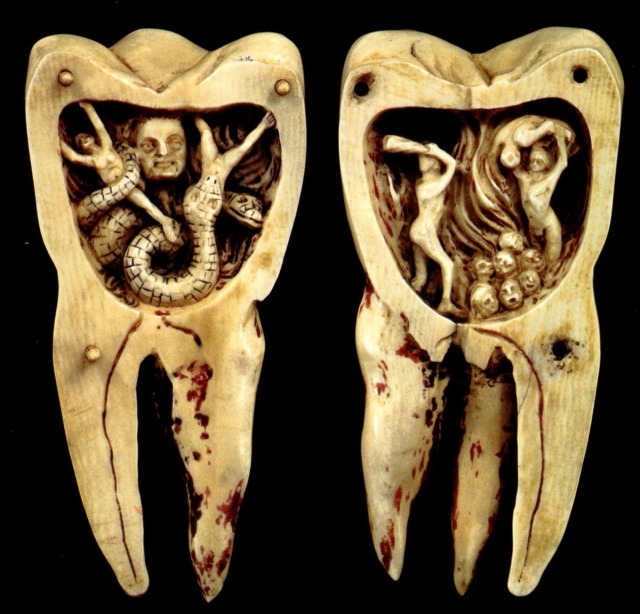
If neither dentistry or witchcraft proved helpful there was always religion. The saint to whom prayers would be directed here would be St. Apollonia, one of group of virgins put to death during an anti-Christian uprising in 2nd-century Alexandria. Her connection to this concern arises from her teeth being knocked out during her martyrdom. We also hear a passage describing the mania for carrying alleged teeth of the saint in Britain during the time of Henry VI.
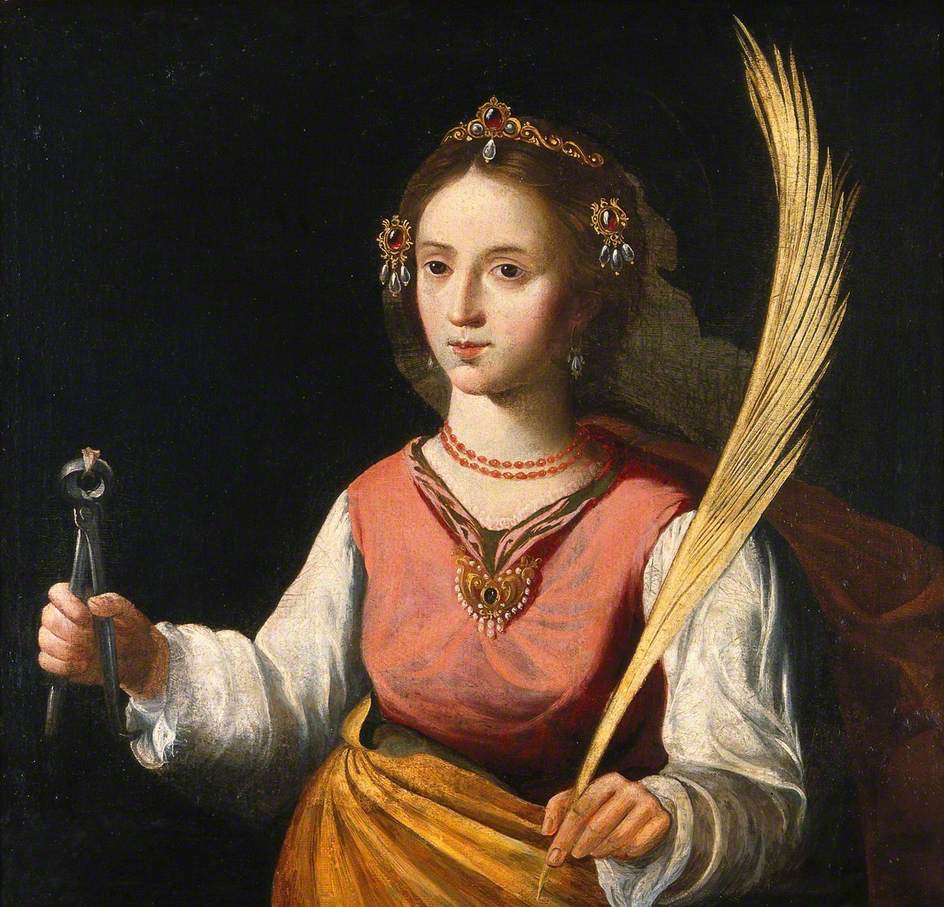
Rounding out our exploration religion and human teeth is brief look at the discovery in Mexico City of human teeth discovered in an 18th-century life-size wooden sculpture dubbed “The Lord of Patience.”
We follow this with a look a more pragmatic use of human teeeth, namely “Waterloo Teeth,” or the teeth of fallen soldiers and others (including those obtained by grave-robbers) once used to make dentures.
Our episode closes with topic of teeth and the Final Judgement, namely, the pre-Reformation Christian teaching that held that lost teeth must be saved in order to accompany the body to its destiny after death. A bizarre news story from 2014 considers the horrifying consequences in which this superstition is mocked.
Murdered Sweetheart Songs
As a special Valentine’s episode, we present collection of folk songs known as “sweetheart murder ballads.” We begin with two newer songs dating to the 19th century, “On the Banks of the Ohio” and “Down in the Willow Garden.” While considered American songs and first documented in Appalachia, these ballads appear to borrow elements from older European songs.
One of the most widely known murder ballads, “On the Banks of the Ohio,” like most of songs in this program, was first recorded in America in the 1920s. We hear a snippet of that early (1927) recording by Red Patterson’s Piedmont Log Rollers and a longer cut narrating the murder itself from a 1969 recording by Porter Waggoner.
While “Banks of the Ohio” has the murderer stabbing his love and disposing of her body in the river, “Down in the Willow Garden,” throws in some poisoning to boot. One of the versions of this song we hear excerpted is from an excellent 1956 album by the Kossoy Sisters, Bowling Green, one we’ve previously sampled in our Butcher Lore episode for which the Kossoys sang about the butchering of a giant ram (“The Darby Ram”). We hear a snippet of the first recording of this song (also from 1927) by G. B. Grayson and Henry Whitter. This early version takes as its title, the victim’s name “Rose Conley,” an Irish family name, suggesting that the song has obscure roots in that country.
The Scottish song “The Banks of Red Roses” shares a similarity with “Willow Garden” in its garden setting. Both highlighting the role a beautiful but remote environment can play in a deadly seduction. We hear a 1962 version by the Scottish singer Jean Redpath, along with snippets by other artists.
Our next song, “The Lone Green Valley” or “The Jealous Lover” takes us back to America with an early recording from 1926 by Vernon Dalhart. Following a similar narrative to our other songs, this song was the subject of a painting by American muralist Thomas Hart Benton. We also hear a strange bit of gossip related to Benton’s interest in folk music involving Jackson Pollack, of all people.
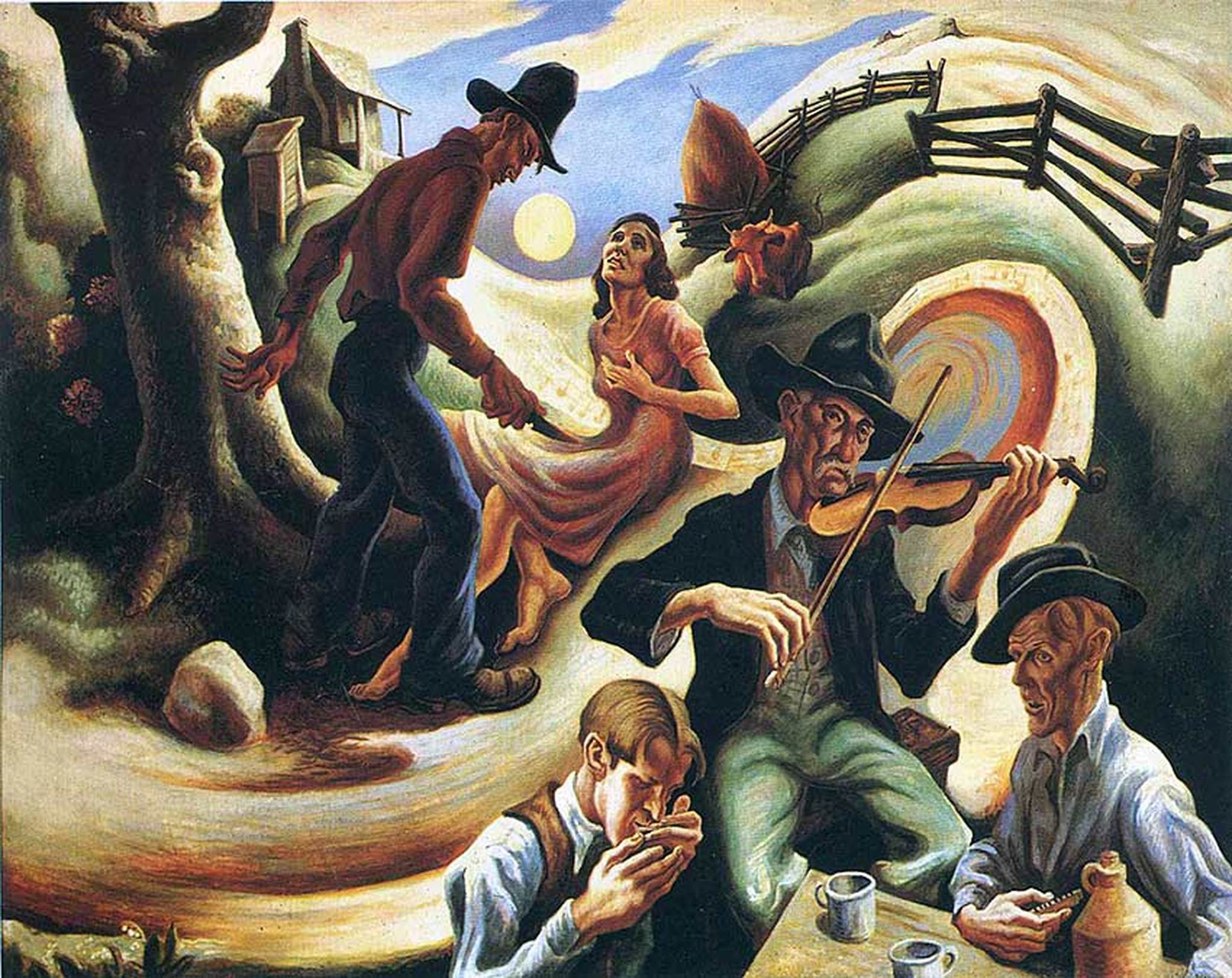
Our next song, “Knoxville Girl,” is an American update of a British and Irish song with roots going back to around 1700. We begin with a version by The Louvin Brothers from 1956 and work our way to earlier songs from Great Britain where the song goes by “The Oxford Girl,” or in Ireland, “The Wexford Girl,” along with other names and localities, including “Ickfield Town,” the title of a 2005 version we hear from John Kirkpatrick. The story in these is similar to “Banks of the Ohio” and “Willow Garden,” but with a bludgeoning substituting for a stabbing. The song also adds a scene depicting the murderer returning home after his crime to night of guilt-ridden tossing in bed surrounded by imaginary hellfire. The killer is also confronted upon his return by his mother, who notices blood on his clothing, which the killer excuses as the result of a nosebleed.
This odd details of the nosebleed can be traced, along with other elements of the song, to a 1685 broadsheet entitled “The Bloody Miller,” which makes the killer a miller’s apprentice (while other songs employ him as a butcher’s apprentice.) In the broadsheet, the nosebleed does not occur upon the killer’s return home, but in court as his guilty verdict is handed down, and is presented as a supernatural omen confirming his guilt.
This notion of a supernatural disclosure of the guilty killer brings us to another group of lesser known murder songs, including the 19th-century Irish ballad “The Old Oak Tree,” a particularly gory tale, which includes not only a murder but the graphically described disinterment of a corpse and a suicide.
Our next song, a 19th-century Scottish ballad “Young Benjie,” gives us a different kind of murder (being thrown into a waterfall) and has the ghost of the murdered lover appearing at her own wake to demand a very particular and gruesome form of punishment for her killer. We hear a bit of 2012 version of the song by Rosaleen Gregory.
Our last song was popularized by a 1996 version by Nick Cave with P.J. Harvery: “Henry Lee.” Older versions of the song go by other names including “Love Henry,” “Earl Richard,” “Young Hunting,” and “The False Lady.” This one is also from Scotland of the early 19th century. The Appalachian adaptation (the version sung by Nick Cave) omits a more detailed opening describing Henry Lee (or Richard) as an early come in from hunting as well as a more elaborate role played by the bird witness — one which involves the recovery of the victim’s body and identification of the killer by supernatural means. There is also a final verse about the cruel justice served upon the killer. Along the way we learn of a quite peculiar superstition related to the bodies of the drowned and hear a snippet of an unusual 2008 cover of the song by Jodie Holland.
Beasts of the Bestiaries
The bestiaries of the Middle Ages and Renaissance were books describing animals (some recognizable and others fantastic) in terms borrowed from classical texts and framed by Christian teachings. In this episode, we examine a few of the stranger beasts and strange customs and beliefs associated with them.
Here’s a brief look at the animals we’ll be examing (“brief” because I’m rushing to get this episode out on the last day of the month).
Our first is the bonocan, a bull-like creature either from Macedonia or somewhere in Asia, depending on your source. Its memorable trait is the very peculiar means of self-defense it employs.
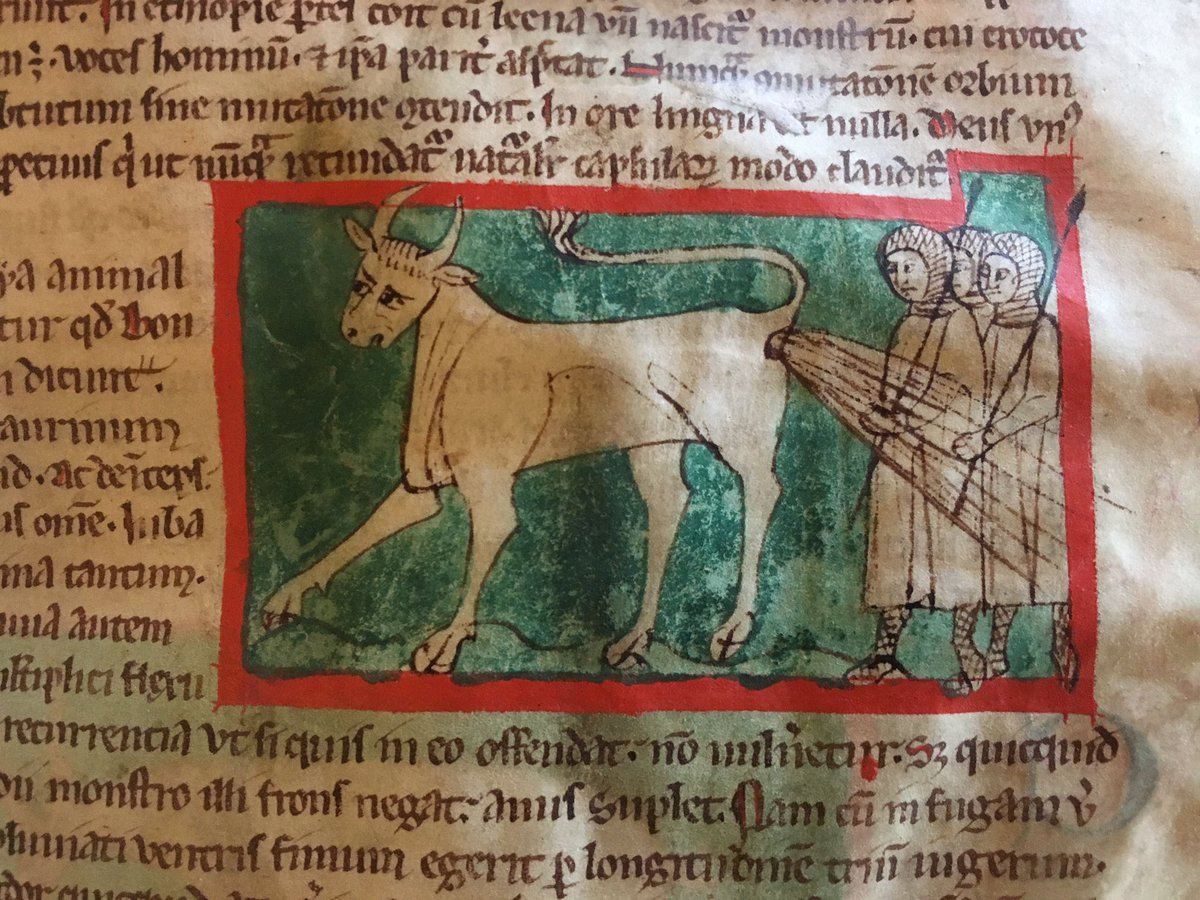
Next, the manticore, a tiger-like beast from India that comes with a few extra bells and whistles like a tail that shoots quills. In the later Middle Ages it became muddled with the mantyger, a creature with a tiger’s body and man’s head.
The leucrota and the crocota were similar or identical creatures with terrifying ear-to-ear mouths equipped with a bony ridge in place of teeth. Their tendency to dig up corpses and vocalize like humans suggests they were inspired by the hyena.
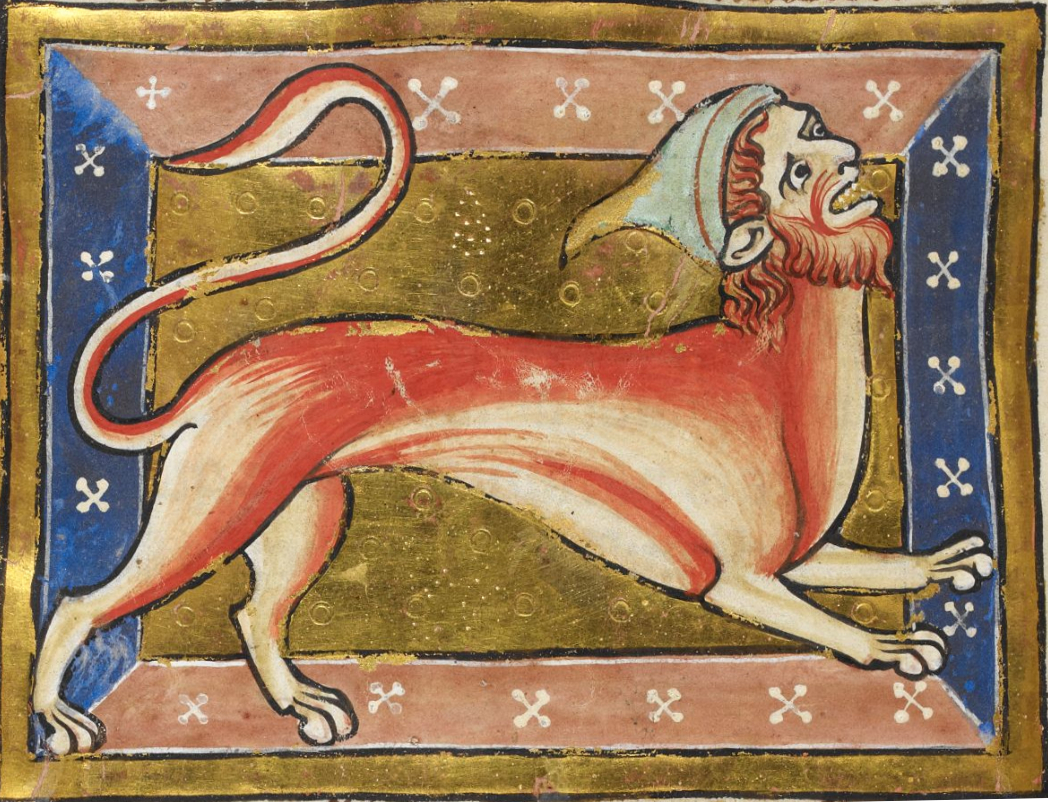
The basilisk is a sort of serpent, whose name comes from the Greek for “little king.” It was small (originally) but deadly. Not only was it venomous, but its breath, and even its glance could kill. Mrs. Karswell relates three legends of basilisks as threats to medieval towns.
Vienna’s basilisk tale involves an baker’s apprentice who must defeat the monster residing in the depths of a well in order to win the hand of his beloved.
The legendary basilisk of Warsaw was discovered haunting the cellar of a ruined building and was so fearsome only a convict facing death dared face it. We also look at the basilisk as the heraldic symbol of Basel, a city which destroyed the basilisk that menaced it while still in the egg (in one of the strangest incidents in the history of man’s relationship with poultry).
We also look at a tale from Cumbria, England, in which a cockatrice — a creature similar to the basilisk but with the head of a rooster — menaces a church.
Our episode closes with a look at the salamander of the bestiaries, a creature produces a deadly poison that vies with that of the basilisk, and one believed to withstand fire. While the latter is purely fictitous (though believed in some places up into the 19th century), the former is based on an actual poison (salamandrine) exuded through the skin of certain species. We’ll examine how this poison relates to a peculiar urban legend originating in Slovenia and hear some accounts of Victorian “human salamanders,” that is, sideshow performers said to be impervious to fire.
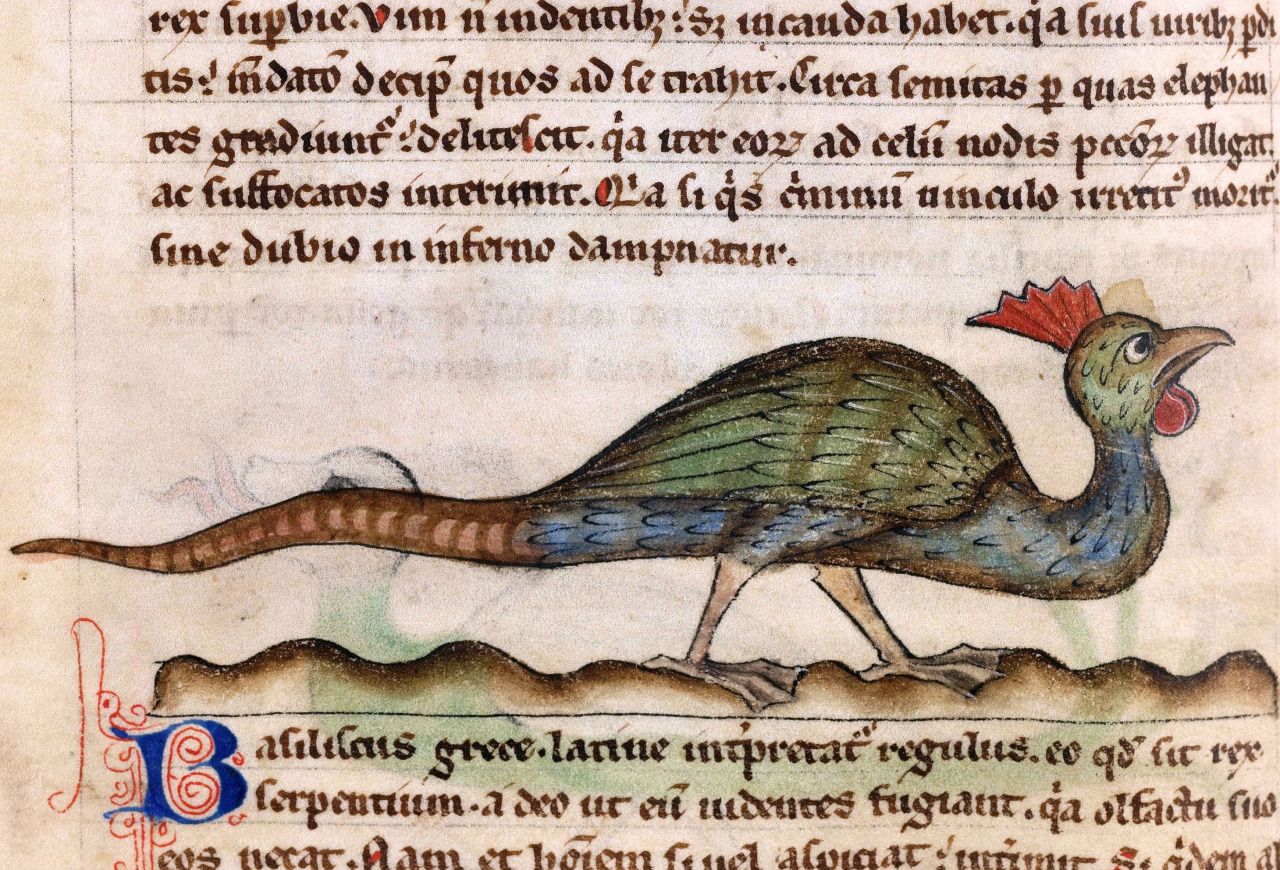
Walled Up Alive
Walling up a living victim, or immurement, has been used both as a punishment and for darker, magical purposes. In this episode, we detangle the history from the folklore of this grisly act.
We begin with an instance of immurement from Edgar Allan Poe’s 1846 story “The Cask of Amontillado” (including a clip from a dramatization in 1954 radio show, Hall of Fantasy) and also get a glimpse of director Roger Corman’s freewheeling use of this element from Poe his 1962 anthology film, Tales of Terror, as well as 1961’s The Pit and the Pendulum.
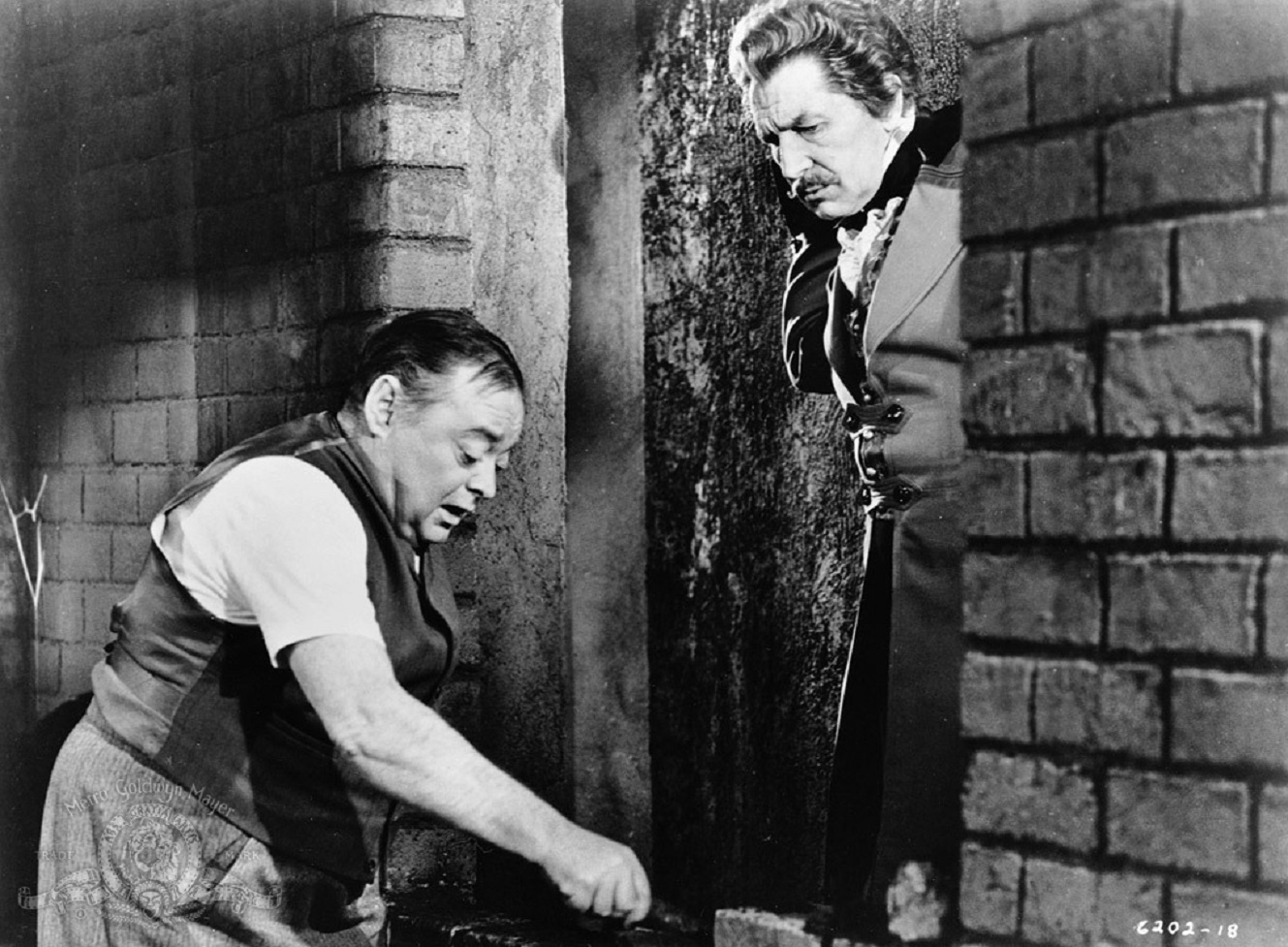
Poe’s interest in immurement is typical of Gothic writers and their fascination with crypt-like spaces, often including the cells and catacombs within Catholic churches and monastic communities. Tales of immured nuns, abbots, and abbesses are particularly common, with the deed understood most typically as a punishment for unchastity but also occasionally for other outrageous deeds or teachings (including a case of dabbling in the black arts). We have a look at some cases in which actual immured skeletons were said to have been discovered in religious communities and then consider the lore explaining their presence. We also look at ways in which writers like Sir Walter Scott and H. Rider Haggard blurred the line between historical and literary stories.

It’s likely that tales of nuns immured for unchastity were particularly prevalent as they echo the fate of Rome’s Vestal Virgins who failed to protect their virginity. We hear some details of immurements, not only from ancient Rome, but also Greece as well as a particularly gruesome account read by Mrs. Karswell describing an ancient Assyrian revenge spree featuring immurement.
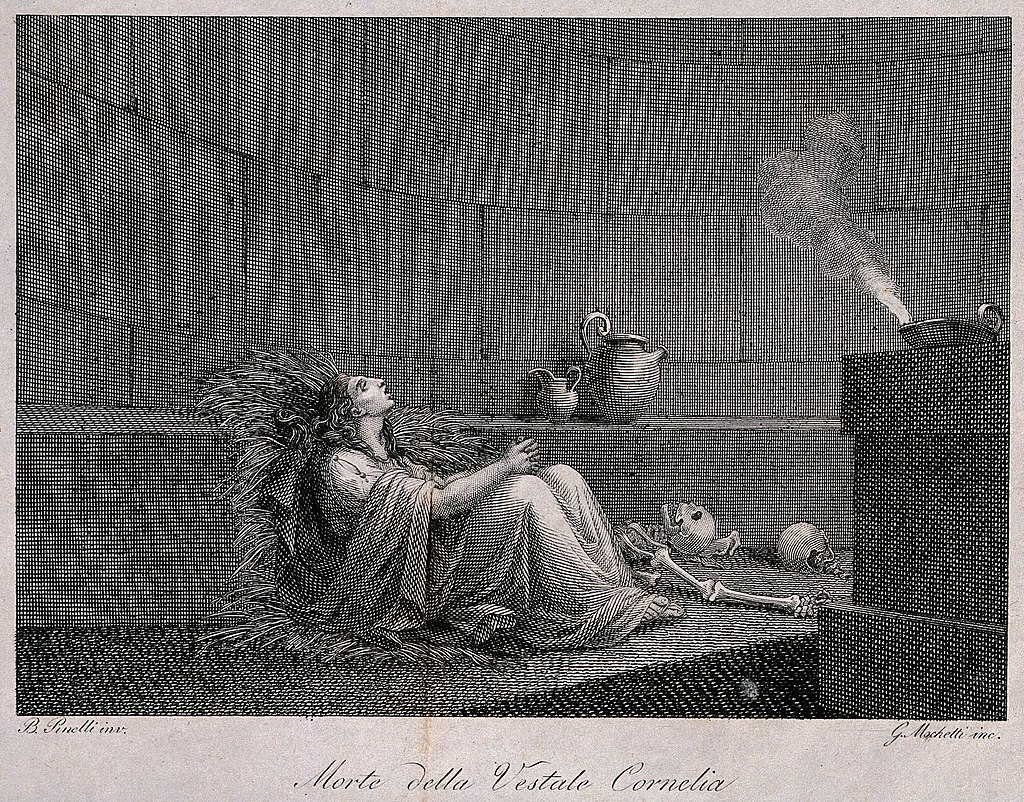
Medieval accounts of immurement we look at include the Christian legend of The Seven Sleepers of Ephesus and one recounted in Dante’s Divine Comedy, that of Count Ugolino della Gherardesca of Pisa (and his children/grandchildren, who are involved in a particularly grisly way).
Our next segment looks at punitive immurement from a cluster of legends in Scandinavia and the Baltic states. We begin with a story from the Swedish island of Gotland, that of the Jungfrutornet (“maiden’s tower”) in the town of Visby. The tower’s name is taken from the story of a maiden, who falls in love with a spy from Denmark, who uses her to obtain keys to the city gate in preparation for a devastating invasion. The maiden’s punishment for betraying her town is, as you would have guessed, immurement.
We hear a similar story from Finland, which serves as the basis of the song (from which we hear a clip) Balladi Olavinlinnasta or the ballad of Olaf’s Castle, and also a tale from a castle in Haapsalu, Estonia, said to be haunted by the maiden immured there. Then we look at a church in the Estonian town of Põlva, where a particularly devout maiden was said to have allowed herself to be interred in a position of kneeling devotion as a sort of religious talisman forever protecting the church.
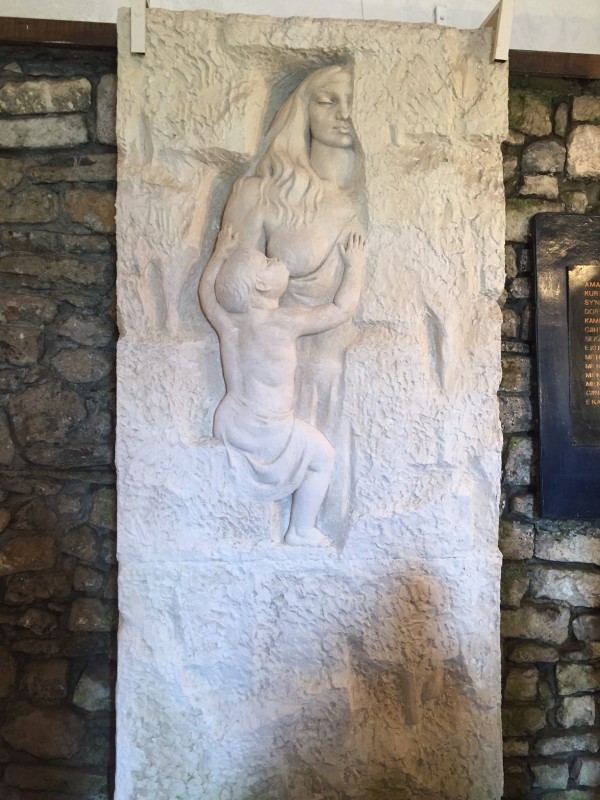
This notion of self-sacrificing immurement in a Christian context figures into the bizarre legend recounted of the 6th-century Irish saint Columba and his companion Odran, who allowed himself to be entombed in the foundation of a church on the Scottish island of Iona.
Our last segment looks at further stories of living humans entombed in buildings and other structures in what’s called a “foundation sacrifice.” A cluster of tragic legends and ballads from southeastern Europe tell similar stories of women immured in structures by their husbands who work as stonemasons. We hear these tales illustrated by a clip from the Hungarian ballad Kőműves Kelemen (“Kelemen the Stonemason”) as well as a bit of the soundtrack from the 1985 film The Legend of Suram Fortress by Sergei Parajanov — it’s based on a Georgian folk tale, so geographically close, though not quite one of the stonemasons-who-wall-up-their-wives genre. But it’s a lovely film I just wanted to include.
We then move west in Europe to hear some stories of foundation sacrifices collected largely in Germany. These include ancient sacrifices of children to the security of city walls, castles, and bridges, including a panic around a child sacrifice presumed necessary to a railroad bridge constructed near the town of Halle as late as the 1840s.
We end with a look at “church grims,” protective spirits of animals buried in church foundations (or churchyards) in Scandinavia and England, with lambs being preferred in the former and dogs in the latter — providing a connection to England’s black dog mythology.
And there’s one last story, much more modern, a 2018 news story from Houston Texas.
The Goblins and the Gravedigger
Bone and Sickle continues its holiday tradition of Christmas ghost stories, or a goblin story, in this case. Our tale about an encounter between a gravedigger, or sexton, and a host of goblins is extracted from Charles Dickens’ 1843 novella, The Pickwick Papers. Strangely, it is not Dickens’ only Christmas goblin story.
As a special holiday treat, our reader for the story beloved personality well known to all Bone and Sickle listeners.

Frau Perchta, the Belly-Slitter
Frau Perchta, sometimes known as “the Belly-Slitter” for the trademark punishment she’s said to inflict on disobedient or lazy children, is figure of Alpine folklore of Austria and Germany in many ways similar to the Krampus.
“Perchta” is only one spelling or name for this figure, who may also go by Pehrta, Berchte, Berta, and a myriad of other names. A particularly good representation of the figure, a woodcut from 1750, identifies her as the “Butzen-Bercht,” with the word “Butzen” coming from a word for “bogeyman.” This word also appears in a classic 19th-century German children’s song and game “Es Tanzt Ein Bi-Ba Butzemann,” or “A Bogeyman is Dancing,” from which we hear a clip at the show’s start.
The woodcut in question depicts a crone-like character with dripping, warty nose, who is carrying on her back a basket filled with screaming children, all girls. She stands before the open door of a house where more girls are screaming, and is holding a dangerous looking pronged staff as well as a distaff, the stick used to hold fibers that will be spun into wool or flax on a spinning wheel. The importance of the illustration is the way it emphasizes Perchta’s connection to spinning and to the females of the household responsible for this task. The woodcut also features some text delightfully detailing a series of horrid threats delivered by Perchta, dramatically read by Mrs. Karswell.
Perchta’s name it comes from her association with Epiphany or Twelfth Night, January 6, the last of the “Twelve Days” or nights of Christmas, the “Haunted Season,” we discussed last year in our episode of that name. “Perchta” is a corruption of the word giberahta in the Old High German term for Epiphany, “giberahta naht,” meaning, the “night of shining forth or manifestation.
Now there’s another name many of you will have encountered if you’re read up on Perchta: Perchten, figures very similar to the Krampus. (Perchten is plural. The singular is Percht.)
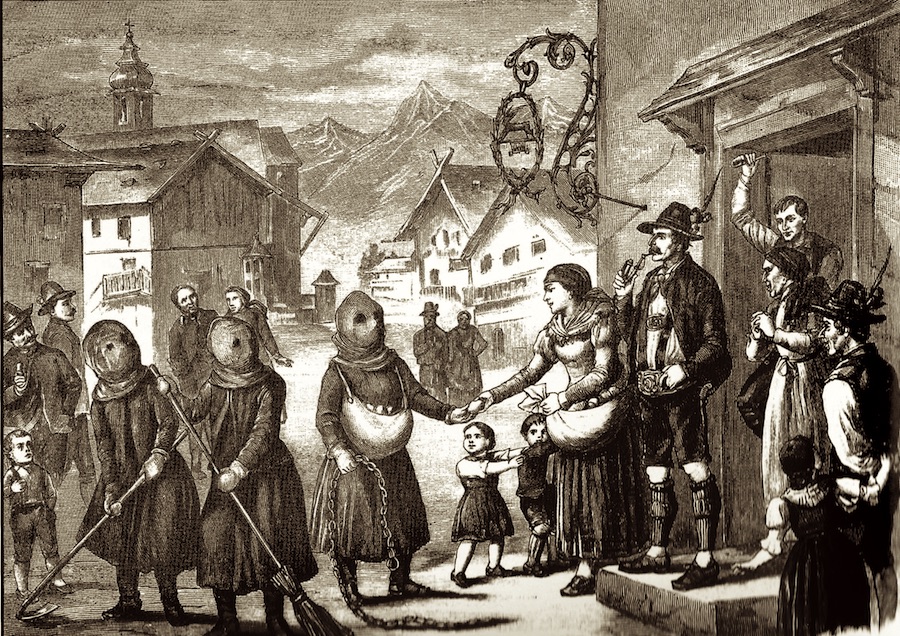
While the first mention of Perchta appears around 1200, the word “Perchten” is not employed until centuries later. In 1468, there appears a reference to her retinue, but its members are not called Perchten, nor do they explicitly resemble Perchten as we think of them today. At this stage in Perchta’s mythology, the company she leads is most often understood as spirits of the departed. With time, and frequent attacks from the pulpit, Perchta’s pagan company came to be commonly feared not as ghosts but as demons, something presumably closer to the horned figures we now know. By the 15th century, a tradition involving costumed processions or appearances of these figures had evolved. The very first illustration we have of Perchta seems to show not the figure herself, but in fact a masker impersonating “Percht with the iron nose.” It appears in South Tyrolean poet Hans Vintler’s 1411 Die Pluemen der Tugent (“The Flowers of Virtue”).
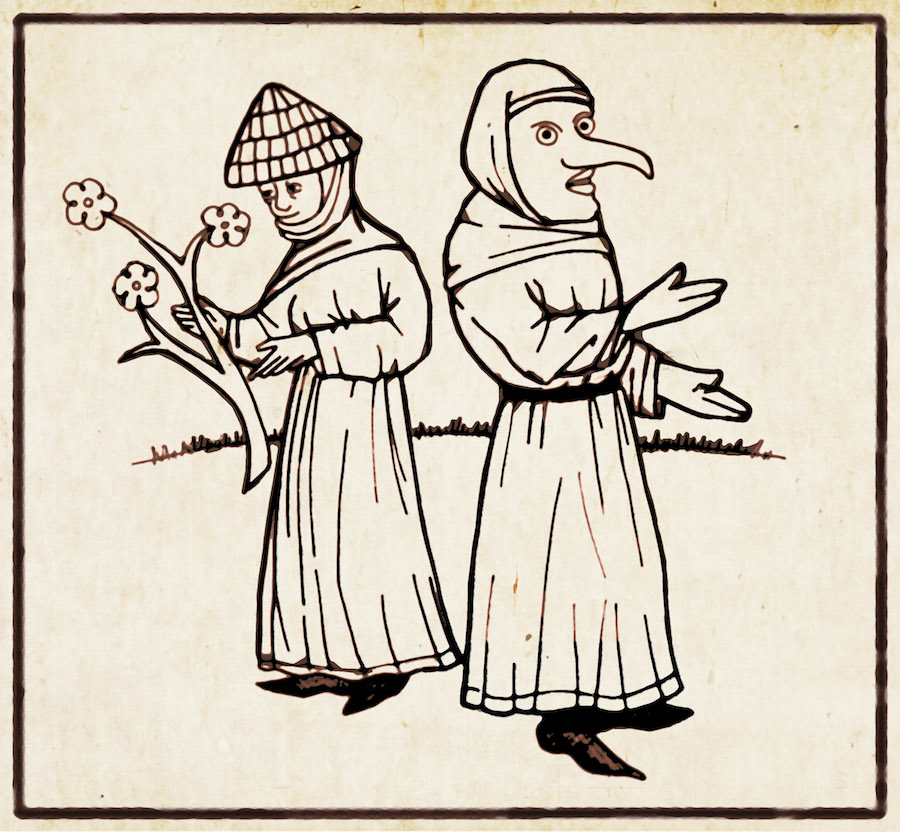
This beaklike nose of Perchta may be related the figure’s ancient connection to the classical strix (plural striges) which appears in both Greek and Latin texts. The strix is bird of ill omen, often thought of as an owl, one that visited at humans at night to feed on blood and flesh. Bird-like representations of Perchta or the Perchten appear in the Schnabelperchten (“beaked Perchten“) figures that appear in the town of Rauris, Austria.
In addtion to Perchta threatening to cut open the bellies of the disobedient, she’s sometimes said to stamp on those who offend her. In certain regions, it is the Stempe, or the Trempe (from the German words for “stamp” or “trample”) who appears to frighten the disobedient on Twelfth Night. A medieval poem, alluding to the terrible Stempe, one quoted in Grimm’s Deutsche Mythologie, is read by Mrs. Karswell.
One way to avoid Perctha’s wrath was to prepare certain foods, particularly a porridge called Perchtenmilch, which would be partially consumed by the family on Twelfth Night with a portion set aside as an offering to the Perchten. Certain signs, that the porridge had been enjoyed by the night-traveling spirits could provide omens for the coming year. Mrs. Karswell reads an Austrian account from 1900 detailing these.
This custom of leaving out offerings on this night was frequently condemned by the clergy in Austria and Germany, and we hear similar practice involving the Swiss “Blessed Ones” (sälïgen Lütt) derided in an 17th-century account by Renward Cysat, a city clerk of Lucerne.
The dead who accompany Perchta and consume these offerings are in many tales called the Heimchen, the spirits of children who have not received baptism. Several tales of Perchta and her Heimchen from Jacob Grimm’s Deutsche Mythologie are recounted.
Our episode concludes examining a peculiar connection between Perchta and the beloved English and American figure of Mother Goose.
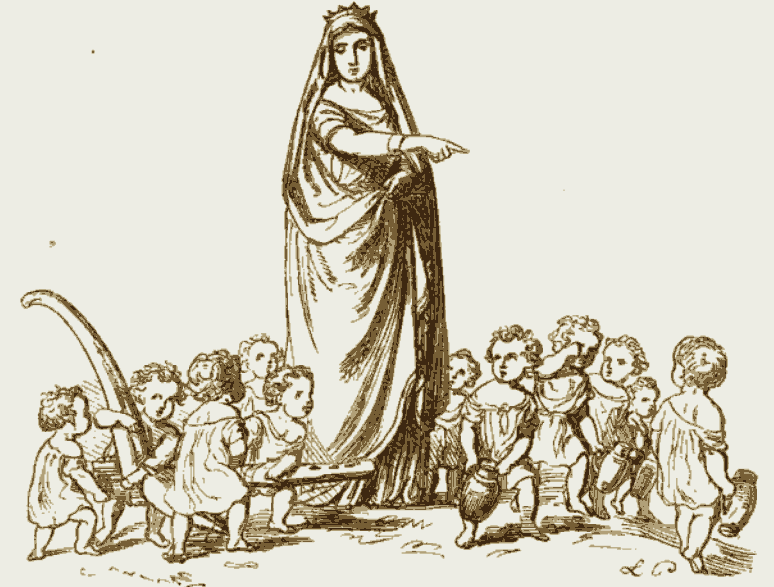
(Material in this episode taken from my book, The Krampus and the Old, Dark Christmas.)
Drowned in Blood: Butcher Lore
Our seasonal look at butcher lore begins with the slaughter of an immense ram as related in the centuries-old English song, “The Derby Ram” (AKA “The Darby Ram”). In the lyric, a butcher and his boy assistant are “washed away in the blood,” giving us our episode’s title. The song is roughly enacted in an old Christmas folk play from Derbyshire, “Old Tup” (an old local word for “ram.”) We hear a montage of snippets of the song from The Kossoy Sisters, John Kirkpatrick, John Roberts, and Matt Williams.
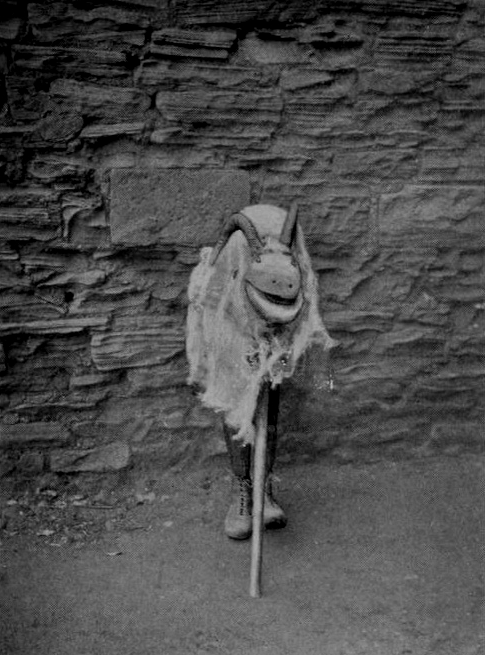
While the 19th-century trend among folklorist to view mummer’s plays like this as vestiges of ancient pagan rites is no longer accepted, the notion does suggest our next topic: a Germanic emphasis on sacrifice during the month of November, which the Anglo-Saxons called Blod-monath (“month of sacrifice.”) We look at the Scandinavian yuleblót marking the beginning of Winter and its connection to Freyr and his sister Freyja, both symbolized by boars or swine sacrificed in this rite. Along the way, we hear Mrs. Karswell read a famous 11th-century account by the chronicler Adam of Bremen describing particularly spectacular sacrifices said to be offered in the ancient temple that once stood outside Uppsala, Sweden. We also touch upon the Anglo Saxon Modranicht or “Night of the Mothers,” which was celebrated on Christmas Eve.
Next we discuss the slaughter of swine, November’s traditional “Labor of the Month”among medieval peasantry. Its aristocratic equivalent is the boar hunt carried out in November and December. We have a look at the serving of boar’s head at Christmas among the nobility and hear a snippet of the medieval Boar’s Head Carol as well as a whimsical tale told at Oxford supposedly explaining how the boar’s head custom arrived at Queen’s College.
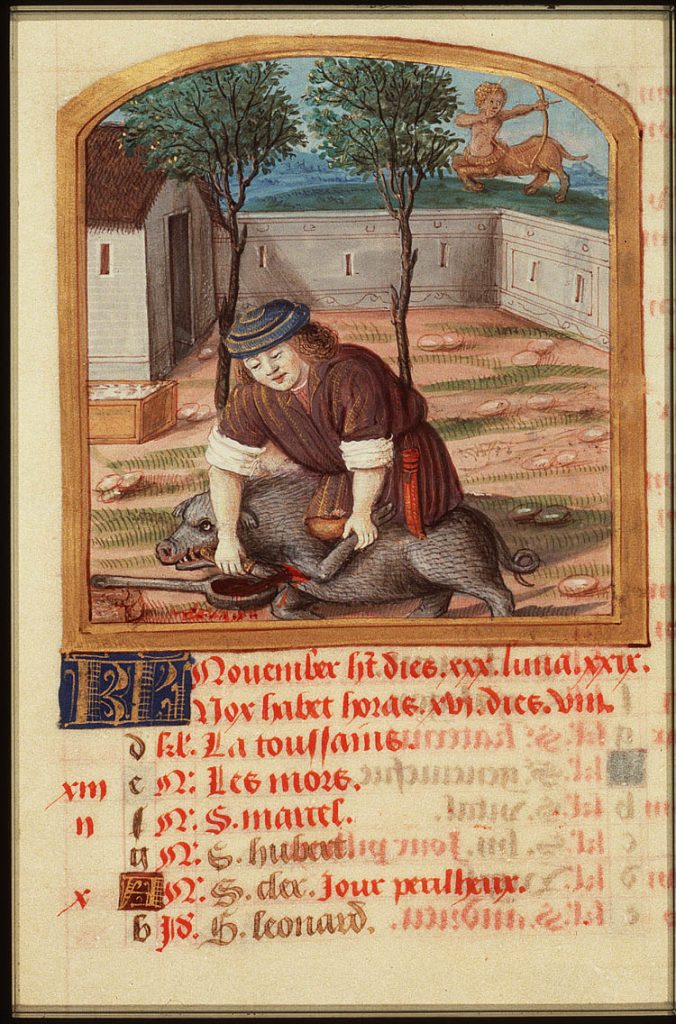
The particular day most traditionally associated with the slaughtering of animals for the Winter (and the old day regarded as the beginning of winter) is November 11, St. Martin’s Day. We hear of a strange St Martin’s custom associated with the slaughter of beef in Stamford, Lincolnshire in the 17th-century and of the magical use of blood from fowl slaughtered on this day in Sweden and Ireland. Our “meaty” segment ends with a bit of the comic song “A Nice Piece of Irish Pig’s Head.”
A tradition in Lower Bavaria fixes December 21, St. Thomas Day, as the date for dispatching swine and is associated with the appearance a demon or ogre by the name of “Bloody Thomas.” We hear a description of a cruel and/or amusing 19th-century prank played on children on this day.
Next we look at the legend of “St. Nicholas and the Three Schoolboys,” which has an unsettling connection to our gory theme. A clip from a French song from the 16th century ‘”La légende de Saint Nicolas“” is included as is a story of the Alsatian bogeyman, Père Fouettard, an equivalent of the Krampus or Knecht Ruprecht said to be related to this particular Nicholas legend.
From 14th century Scotland, comes the story of butcher from the town of Perth who famously turned to cannibalism. Born Andrew Christie, he is better known as “Christie Cleek,” from an old Scottish word for “hook,” an implement important in his grisly deeds.
We close the show with a look at Sawney Bean, Scottish leader of a incestuous cannibal clan believed to be a legendary reworking of the more historically based tale of Christie Cleek.
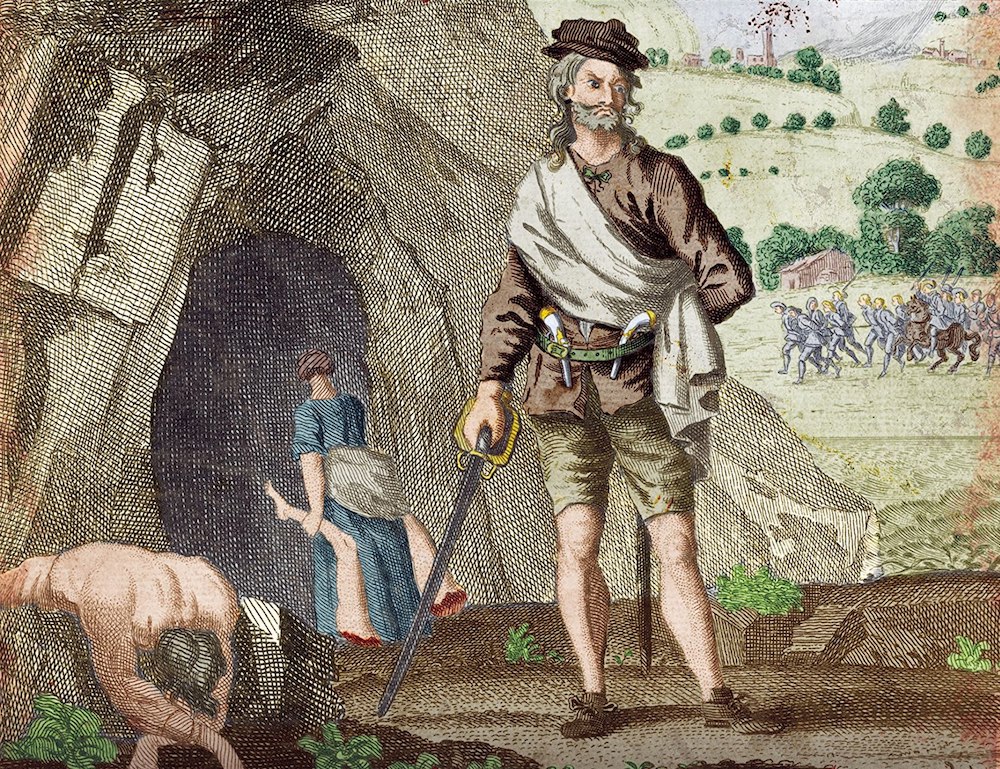
All of Them Witches
This Halloween we have five stories of witches from all the way back to around 1125AD to the 1960s. Some of them are actual historic personage, some seem more purely folkloric.
It’s a somewhat longer episode for which I”ll provide somewhat shorter show notes here. So, I won’t going into the details of each story, but just give a sketch of who we’ll be talking about. Aside from all being witches, you’ll see another common thread; four of the five kept avian familiars: roosters, blackbirds, and jackdaws.
The first a 19th-century witch who’s become a part of Connecticut folklore — Hannah Cranna. Though there are stories of her cursing neighbors from her life, the most interesting part of her tale begins with the details of her burial details, with which she was particularly obsessed. The segment begins with a snippet of Mark Fry’s bit of folk-psychedelia “The Witch” — only because it happens to dovetail nicely with a story of Hannah told on an urban legends web page.
Our second witch was also very particular about her burial, but with a more clear-cut rationale: she wanted to prevent the Devil from claiming her soul (and body, it seems) upon her death. This is the so-called “Witch of Berkeley,” who story was first told by English chronicler William of Malmesbury all the way back in 1125. It’s in his Chronicle of the Kings of England (as a sort of digression).
Our third witch, Molly Leigh, is also from England — North Staffordshire, where she died in 1746. Though she fit the witchy archetype of having both a quarrelsome personality and undesirable physiognomy, she was never tried or executed for witchcraft, despite some rumors of minor mischief, such as bewitching beers down at the pub. Her story, like Hannah Cranna’s, focuses more on her afterlife exploits. We play a snippet of a recent horror movie Molly Crows, which uses Leigh’s story as a springboard.
The fourth witch is our most modern: Sibyl Leek, who appeared on the scene in the 1960s during a wave of pop-culture. While she claimed to be a descendant of Molly Leigh, her life seems to have been much more pleasant, centering primarily upon how to best position herself in the media spotlight.
Our final story is is quite an oddity. The story of the self-confessed 17th-century witch, Major Thomas Weir, who became a fixture in legends of old Edinburgh. This is our longest segment, and I’ll leave the rest for you to enjoy as Mrs. Karswell’s reads from our sources, ad the details as are suitably shocking.
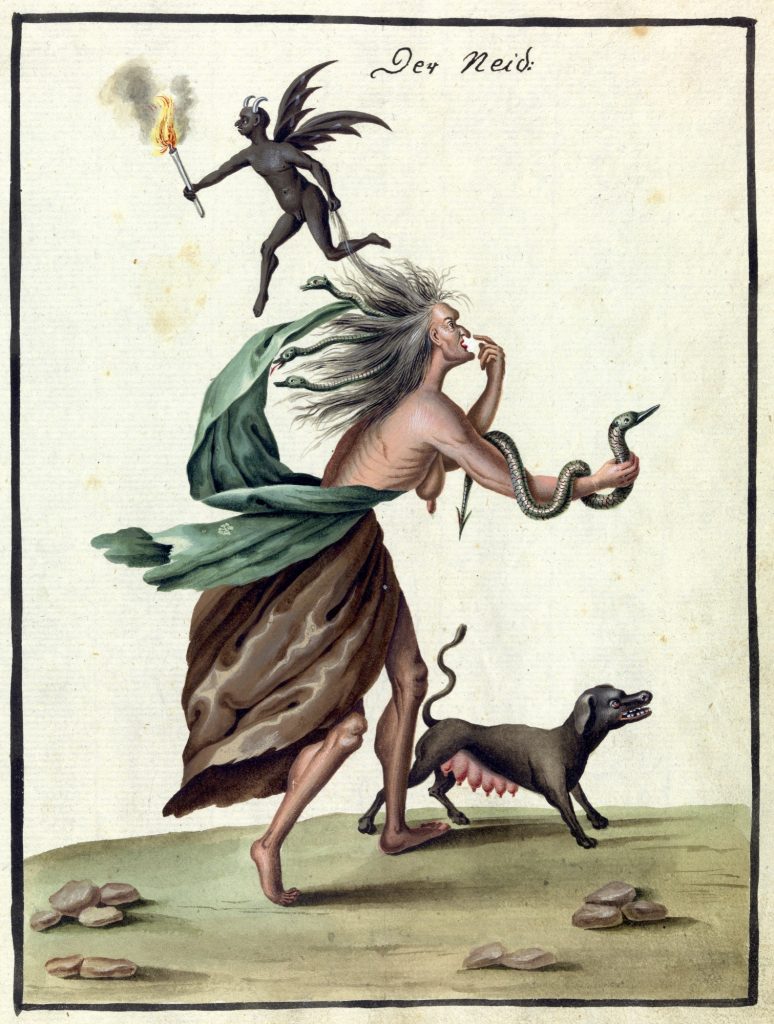
#35 Vintage Halloween
Here’s a short bonus show celebrating Halloween. It’s a bit different format. Whereas most of our shows look at folklore and incidents happening centuries ago in Europe or further afield, in this one we’re staying in the United States looking at how Halloween was celebrated, for better or worse, from the turn of the last century up into the early 1930s. We’ll do so by reading excerpts from various stories from newspaper archives of the period.
Hope you enjoy!
#34 The Goblins Will Get You!
Goblin lore from old folk tales, literature, ancient and modern legends is our topic this time around.
We begin with the poem from which we take our episode title, James Whitcomb Riley’s “Little Orphant Annie” in which the poet remembers his childhood nanny and her “witch tales” and threats about goblins coming.
Next, we take a quick look at the word “goblin” itself, and how it relates via the goblin-like “boggart” or “boggle” of the Northern England and Scotland to our word, “bogeyman” (hearing a snippet along the way of Henry Hall’s 1932 rendering of the song, “Hush, Hush, Hush, Here Comes The Bogeyman.”)
The word “goblin” seems to have made its way into English from Normandy. A 12th-century tale that from that region employs a latinzed version of the word, “Gobelinus,” to name a creature that menaces the 6th-century saint Taurinus in Orderic Vitalis’s Historia Ecclesiastica. The creature’s hapeshifting between a bear, a lion, and a buffalo is a trait we’ll see later with other goblins. We also hear of the first English usage of the word — one which appears in a translation of the Bible, of all places.
The root of the word, “goblin,” and German and Old French cognates, points to a connection with caves, or hollows in rocks, which takes us to the a certain species of goblin in Cornwall particularly, which is said to reside underground, specifically in mines. In England, these are known as “knockers” for the sounds they’re said to make with the tiny miners’ hammers, a words that evolved into “tommyknocker” for the spirits haunting American mines in the 19th century. We hear some examples of its playful and sometimes malicious interactions with miners, and of a particularly gruesome death attributed to these beings in Colorado.
Our next section looks at several legendary goblins that made their way into the poems and folklore studies of Sir Walter Scott. The first example, appearing in the poem “Marmion,” involves “Goblin Hall,” a name given to Yester Castle in East Lothian, which was said to have been built by a sorcerer assisted by goblins. We also hear an additional tale associated with the magician featuring a magic fruit he’s said to have given his daughter. Taking a bite of the “Coulston pear” proves very, very unlucky.
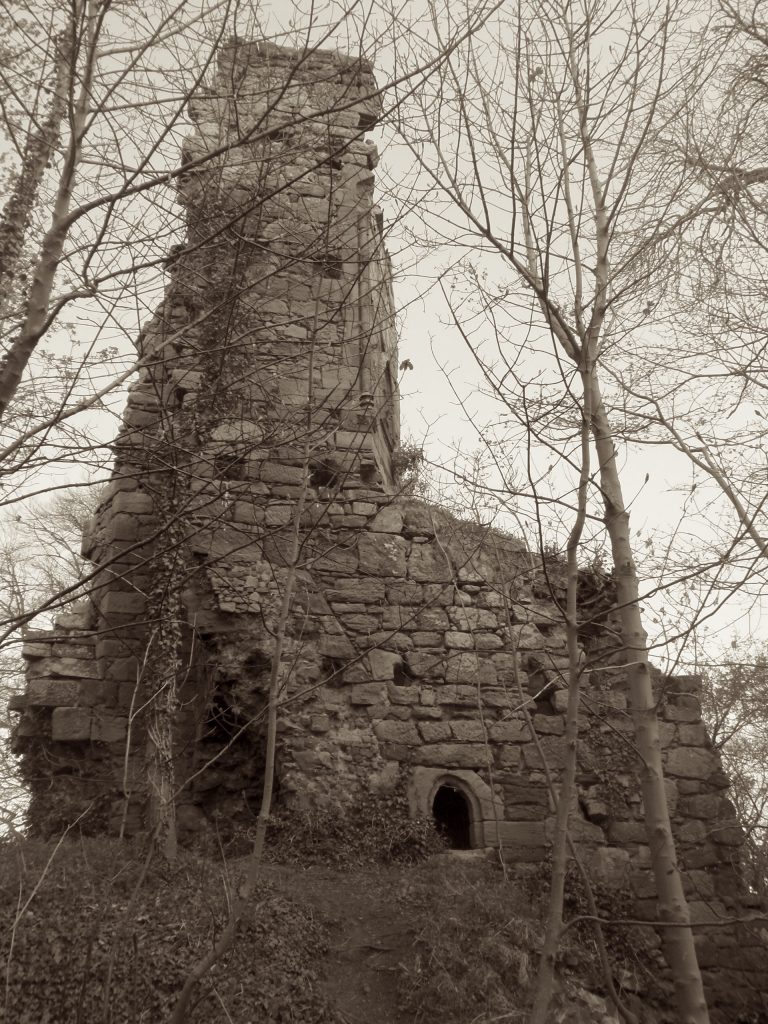
Scott also mentions a “Goblin Cave,” in his 1810 poem, “The Lady of the Lake.” Near Loch Lomond, it was not only the legendary home of goblis but also served as a location for a scene in Scott’s poem and as unlikely inspiration for a well known Catholic hymn composed by Schubert.
Scott’s 1805 poem “The Lay of the Last Minstrel” adapts a local legend of a goblin named Gilpin Horner. It also features an undead warlock based on the historic scholar Michael Scott, who came to be regarded in the popular imagination as a sort of Dr. Faustus charcter. Mrs. Karswell reads a bit of the poem, in which the goblin meets a spectacularly melodramatic end.
Our last stop in Scotland is the imposing Hermitage Castle near the English border, which like the “Goblin Hall,” was said to have built by goblins under the direction of the magician “Bad Lord Soulis” (as he’s known in legend). In the legend and ballad Scott collected, Soulis is supposed to have carried out bloody occult rites in Hermitage Castle with the assistance of his goblin familiar Robin Redcap. Redcaps are a particularly malevolent form of goblin known in Scotland for dipping their caps in human blood, which serves as dye. We hear of Soulis’ particularly grisly mode of death and learn of another interesting Scottish figure, the prophet Thomas the Rhymer, along the way.

We then hear some similar tales from Germany involving goblins serving people of power. The ruined Castle Hardenstein in North Rhine-Westphalia, was where King Neveling kept court and the home of the goblin Goldemar, whose tale features a grotesque act of revenge. Similarly, we hear of the goblin Hödekin, servant of the Bishop of Hildesheim, who exacts a similarly grotesque revenge on an individual a bit too eager to lift the goblin’s cloak of invisibility.
Hobgoblins, we learn, are a species of goblin attached to a particular home or farm. They are generally helpful but can be mischievous or even cruel. A surefire way of getting rid of a troublesome hobgoblin is explained.
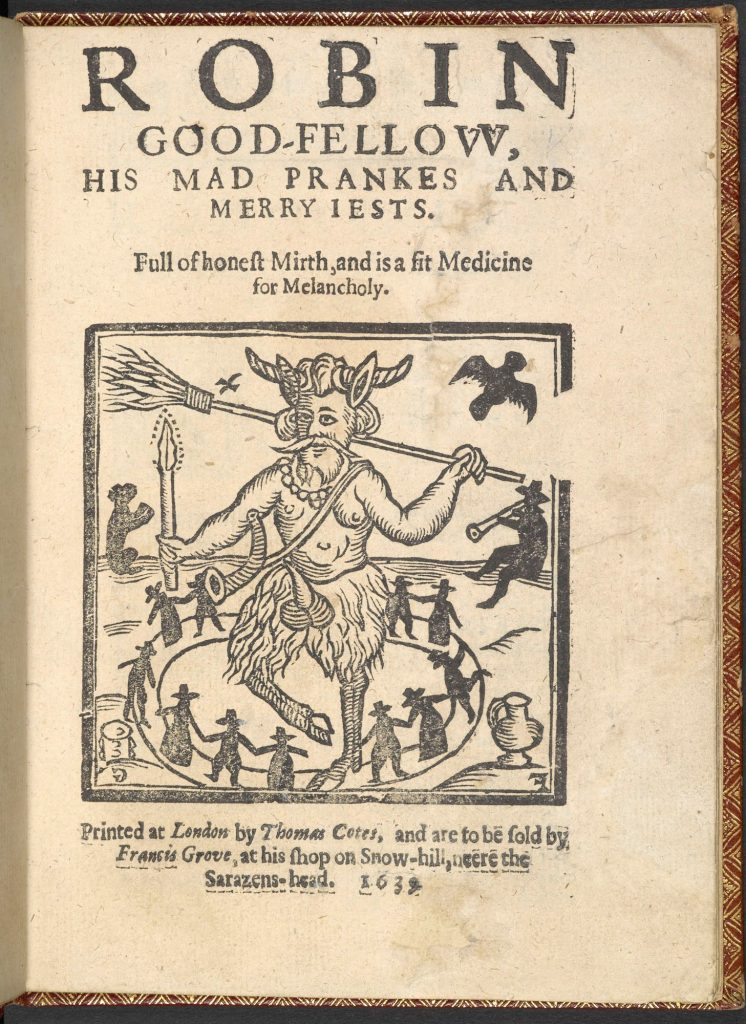 Next is a look at the 17th-century pamphlet representing a famous hobgoblin, namely Robin Good-Fellow, his Mad Prankes and Merry Jests. The book seems to have been inspired by the even more famous hobgoblin, Puck, in Shakespeare’s A Midsummer Night’s Dream. We hear a passage from the Bard which seems to reach back to that 12th-century goblin, Gobelinus, and his shapeshifting ways.
Next is a look at the 17th-century pamphlet representing a famous hobgoblin, namely Robin Good-Fellow, his Mad Prankes and Merry Jests. The book seems to have been inspired by the even more famous hobgoblin, Puck, in Shakespeare’s A Midsummer Night’s Dream. We hear a passage from the Bard which seems to reach back to that 12th-century goblin, Gobelinus, and his shapeshifting ways.
We end the show with a nod to modern “goblins,” the first being the “Kentucky Goblins,” the name given to some alleged extraterrestrial visitors said to have lain siege in 1955 to the Sutton family farmhouse near Kelly Kentucky. This was a landmark event in UFO mythology, giving birth to the phrase “little green men,” a phrase featured in countless jokes and songs, like George Morgan’s 1961 “Little Green Men,” which we hear a bit of. The event is commemorated annually in Kelly, Kentucky with The Kelly Little Green Men Days. We hear some clips from a promo for that. Introducing our “modern” segment was also a clip from Rosemary Clooney’s 1951 song,”The Wobblin’ Goblin.”
The show ends with a clip of a 2019 “goblin” sighting ludicrously analyzed by the journalists of Inside Edition.
#33 Ghosts from Purgatory
Hear how notions of Purgatory influenced medieval ghost stories, the tradition of All Souls’ Day, and a Neapolitan “cult of skulls.”
We set the scene with a clip from “The Lyke Wake Dirge,” a 14th–century British song sung or chanted as a sort of charm over the body of the deceased in the night before burial. It describes the perils confronted by the soul during its journey into the afterlife, describing a “thorny moor,” and “Bridge of Doom,” which must be traversed to arrive in a none-too-friendly Purgatory.
We take a moment to review the historical Catholic concept of Purgatory, one usually associated with fire and torment, albeit of a temporary rather than everlasting nature and geared toward the further purification of the soul bound for Heaven.
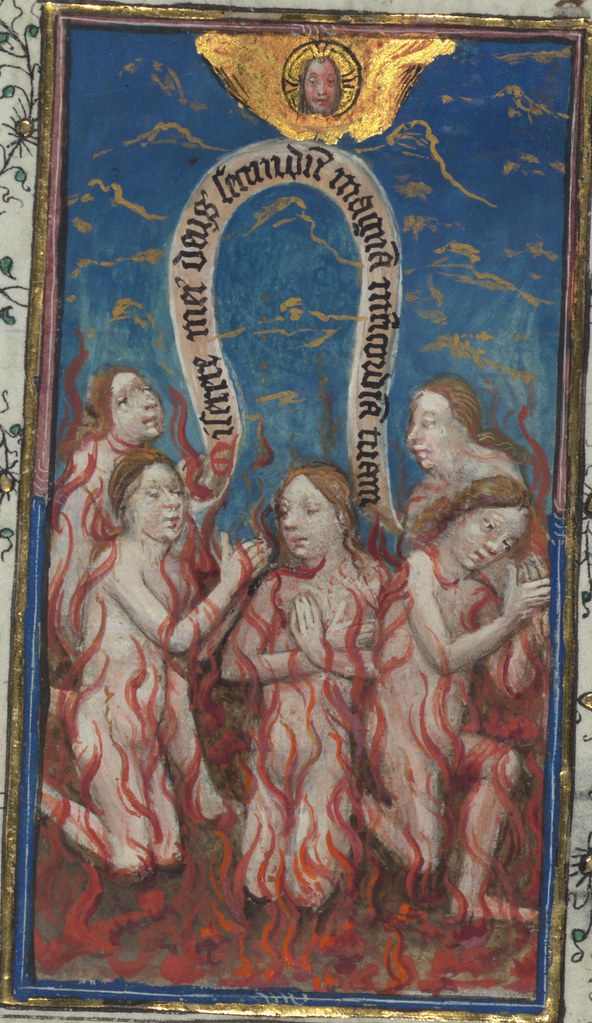
Gregory the Great, the 6th-century pope, is one of the earliest influences on the notion of Purgatory offering as evidence a ghost story of a wicked bishop condemmed to haunt the baths. We also hear of a grisly apparition of Gregory’s dead mother that supposedly appeared in a church where, legend has it, Gregory was saying mass.
From the 8th-century English chronicler Bede, we hear of a man named Drythelm who is granted a vision of Hell, that is “not the Hell you imagine,” (i.e., Purgatory instead) and of the Irish saint. Fursey, who was flown by an angel over purgatorial fires, where a surprising encounter with a demon provides him a curious souvenir.
St. Patrick went one better than ghost stories, at least according to legend. With a tap of his bishop’s crook, he’s said to have cracked open the earth to reveal a gateway to Purgatory itself, all in an effort to convert those stubborn pagans who wanted something a bit more concrete to validate the gospel. A variety of medieval legends chronicle adventures through this underworld, and the site (though not the cave itself) is still open to visitors to a tiny Irish island in Loch Dergh (“the lake of the cave.”)
Though it’s not specifically Purgatory, descriptions of hellish torments identical to those that might be experienced there are particularly plentiful in the 12th-century Irish text The Vision of Tondal. Mrs. Karswell reads for us all the best passages.
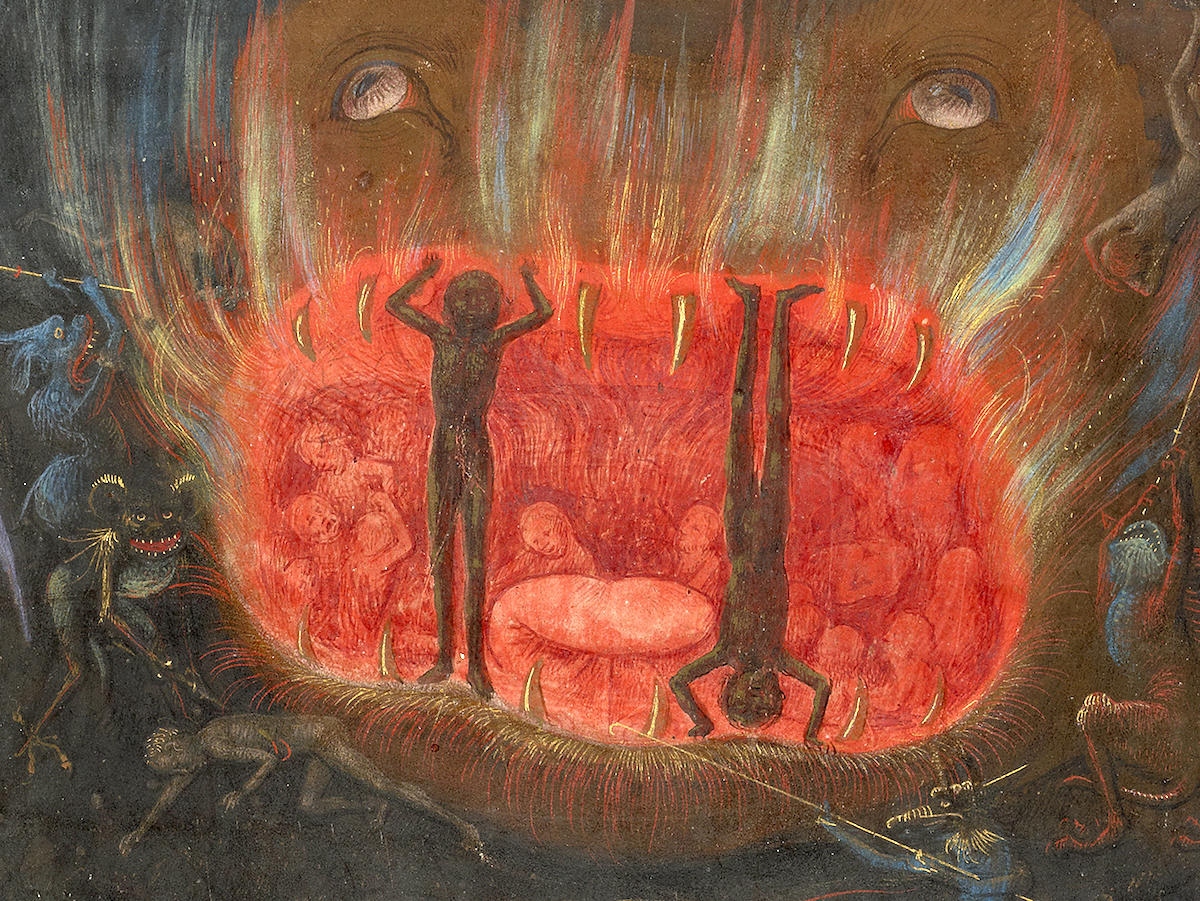
Following a snippet of a late medieval ballad from Norway, Draumkvedet* or “The Dream Poem,” which relates its own story of a visionary journey into the afterlife, we discuss the relationship between All Souls’ Day, prayers for the dead, the cult of the Anima Sola (“lonely soul” suffering in purgatory), and the strange Neapolitans “cult of skulls,” including that of “Princess Lucia,” a legendary lovesick suicide.
Next we hear some stories of frustrated demons and a graveyard full of grumbling corpses from Jacobus da Varagine,1260 compilation of saint stories, Legende Aurea, or The Golden Legend, followed by the utterly bizarre ghost stories written on some spare pages of a manuscript collection by a 13th-century Cisterian monk from the abbey of Byland in Yorkshire, or “The Byland Ghost Stories.”
From 14th-century France, we hear a story known in modern English as The Ghost of Guy, describing a series of ghostly visitations by a soul condemned to Purgatory — and the surprisingly colorful reason they were necessary!
Our last ghost story comes from The Adventures of Arthur, a story from northern England, probably set down in the late 14thcentury. It tells of a particularly loathsome manifestation of Queen Guinevere’s mother that rises from within a lake with some pious advice for her daughter.
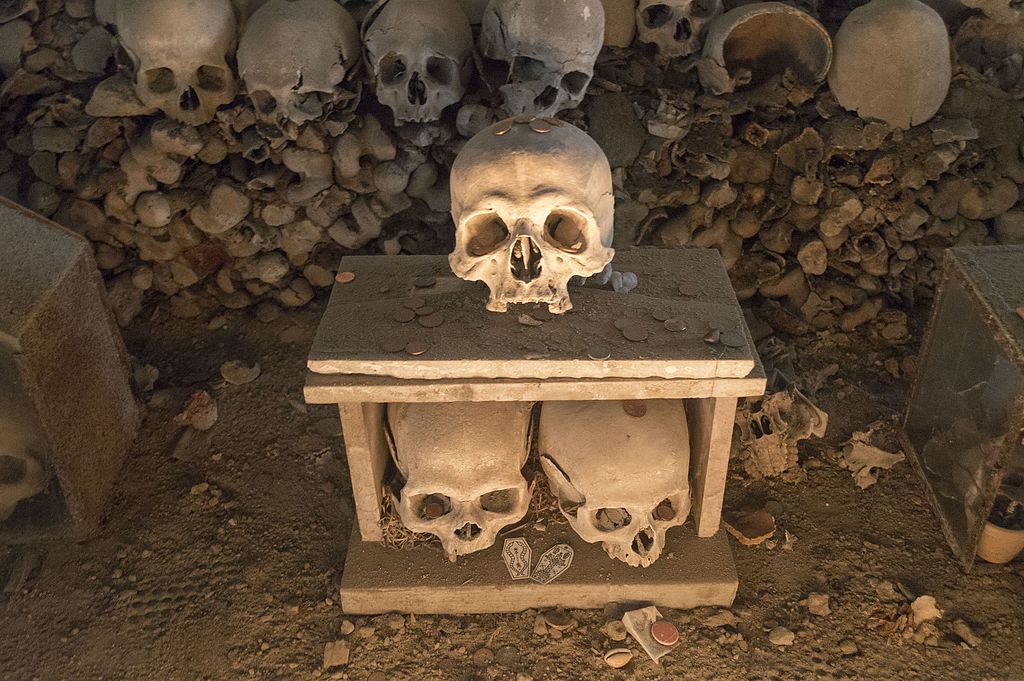
We end with two more modern efforts to provide evidence of souls suffering in the afterlife: Rome’s very small, and very odd Museum of the Souls in Purgatory created by a particularly obsessive 19th-century priest and a classic urban legend in audio form captured from late-night airwaves of a few decades ago.
* Norwegian listeners: my apologies for any errors in pronunciation of “Draumkvedet.”
#32 Vampires, Shroud-Eaters, and the White Plague
This episode explores the connection between vampires and disease, beginning in 19th-century New England with a strange graveyard ritual involving the exhumation of the bodies of Mercy Brown and family members in 1892. The gruesomely ritualistic destruction of Mercy’s body parts was spurred by a belief that those who succumbed to tuberculosis might live on in the grave and infest loved ones with the disease.

Mercy’s case is the last and best known of cases like this beginning in the late 1700s and occurring throughout the area, particularly in Rhode Island, Connecticut, and Vermont. Accounts of several more cases involving cursed vines growing from corpses and a shockingly macabre and bloody ritual occurring on an idyllic village green in the town of Woodstock, Vermont, are read by Mrs. Karswell. (We even hear a clip of a little tourism spot for Woodstock, though surely not in the context it was imagined when produced.)
The association of vampiric entities with times of plagues and epidemics came to New England from Europe, and might be compared to the German belief in the Nachzehrer, an undead creature known to appear in times of pestilence to spread disease. A defining attribute of the Nachzehrer is its tendency to feed upon its shroud and even its own body, a repast providing the creature the nourishment necessary to then rise and continue feasting on the living. Another interesting term for the Nachzehrer deriving from the noises that it produced in its grave would be schmatzende Toten or “smacking dead.” We hear a number of accounts of such creatures from German/Latin texts dating to the 1400s, including the definitive work on the topic, the 1679 volume by theologian Philippus Rohr, called in Latin, “The Masticating Dead.”
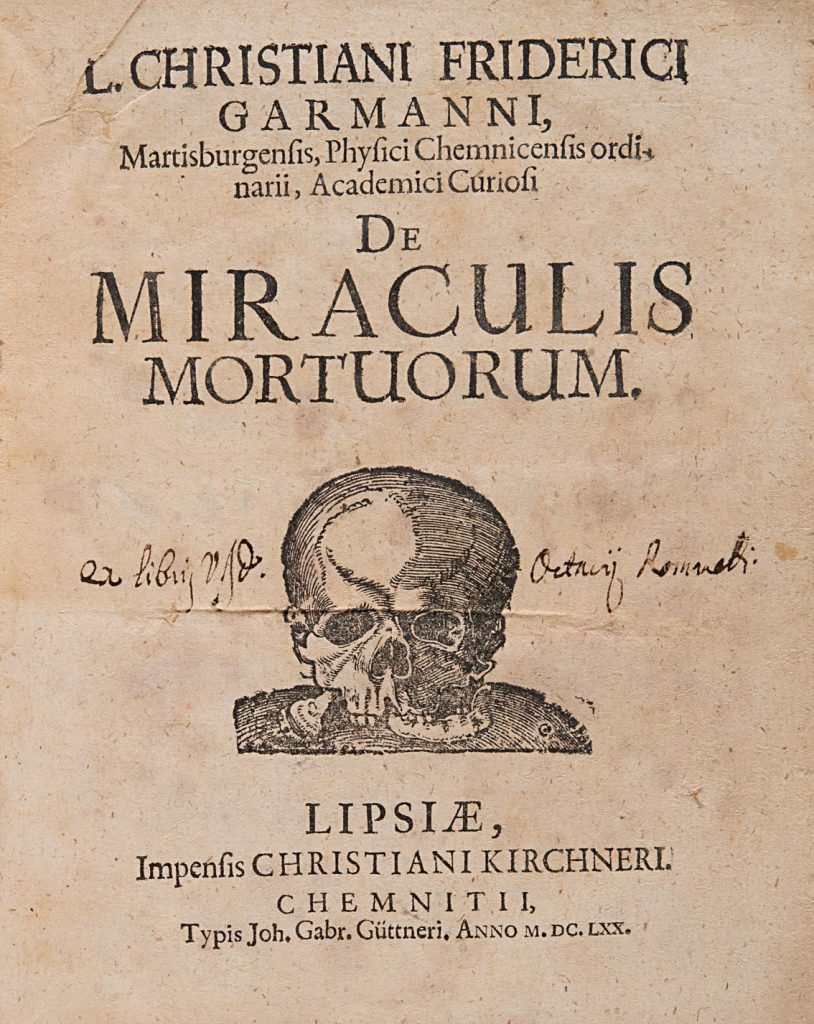
Moving even further back to the Middle Ages, we examine some stories of plague-spreading vampires from England, including a 12th-century account from William of Newburgh, which includes the grisly destruction of a corpse swollen with blood, and an account from 1135 by Geoffrey of Burton, featuring an evil spirit in the form of a crow arising from the monster’s burning heart. Both stories associate the vampire particularly with the spread of disease.
We also have a quick look at archeological evidence for the type of vampire rituals discussed — disordered graves identified as “deviant burials,” or “therapeutic burials” in which bodies believed to be undead may be mutilated, staked into the grave, or — in cases like those we are focusing on — have rocks or other objects stuffed into their mouths to stop the creature from feeding on its shroud, or worse, the blood or vitality of those above the earth.
Also discussed is the use of plague imagery in German versions of Bram Stoker’s Dracula, Nosferatu, both Director F.W. Murnau 1922 version and Werner Herzog’s 1979 remake.
Whether Bram Stoker may have been influenced by reports of the New England tuberculosis vampires of the 1800s is addressed, and we have a deeper look at how romantic 19th-century ideas about tuberculosis influenced not only his portrayal of vampirism, but the work of other literary artists, painters, and composers. Among the artists mentioned are Lord Byron, Alexander Dumas, Claude Monet, John Keats, and Edgar Allan Poe. We also hear some clips of musical deaths by tuberculosis from the operas La Traviata and La Boheme.
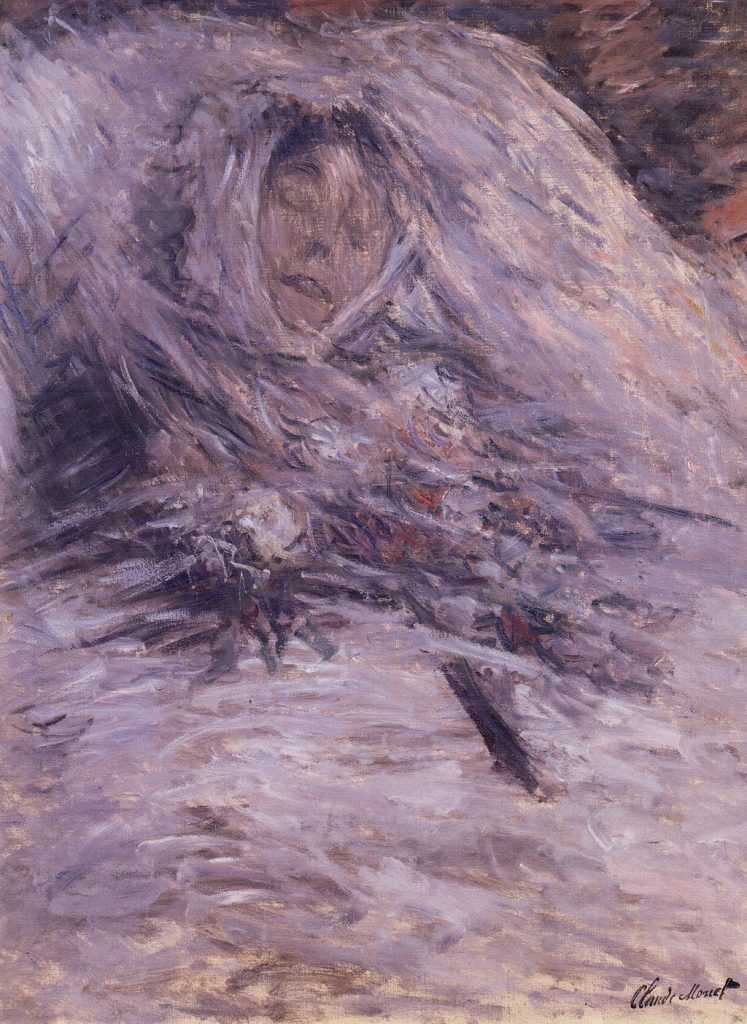
We conclude the show, as we began, with another musical composition played at graveside, and a story of heart removed and preserved in cognac, that of Frédéric Chopin, another victim of “the white plague.”
#31 Baba Yaga
This episode explores the Russian witch, the Baba Yaga, tales in which she appears, possible origins, and regional variations on the character.
We begin by retelling one of the skazi (folk tales) in which she’s particularly well-definined, “Vasilisa the Beautiful,” a version recorded in the mid-1800s by the folklorist Alexander Afanasyev, Russia’s answer to the Brothers Grimm, .
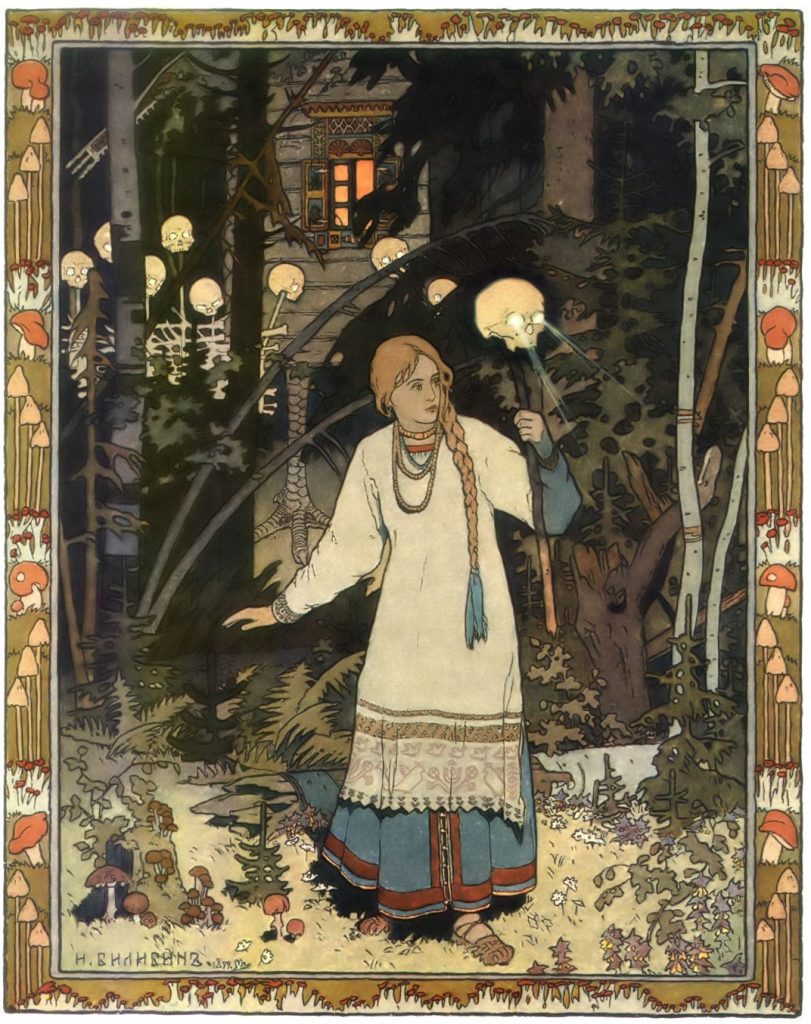
Without spoiling the story, I can say that it bears some parallels to “Cinderella,” with a wicked stepmother and step-sisters grievously imposing on the young Vasilisa and sending her into an encounter with the Baba Yaga. She is aided in the tale by a magic doll bequeathed her by her dying mother.
Like nearly all Baba Yaga stories, this tale features the witch’s famous house perched atop two immense chicken legs on which it turns to reveal it’s entrance if the proper spell is spoken. Around the house, in this story as in most others, is a fence made of human bones and topped by skulls.
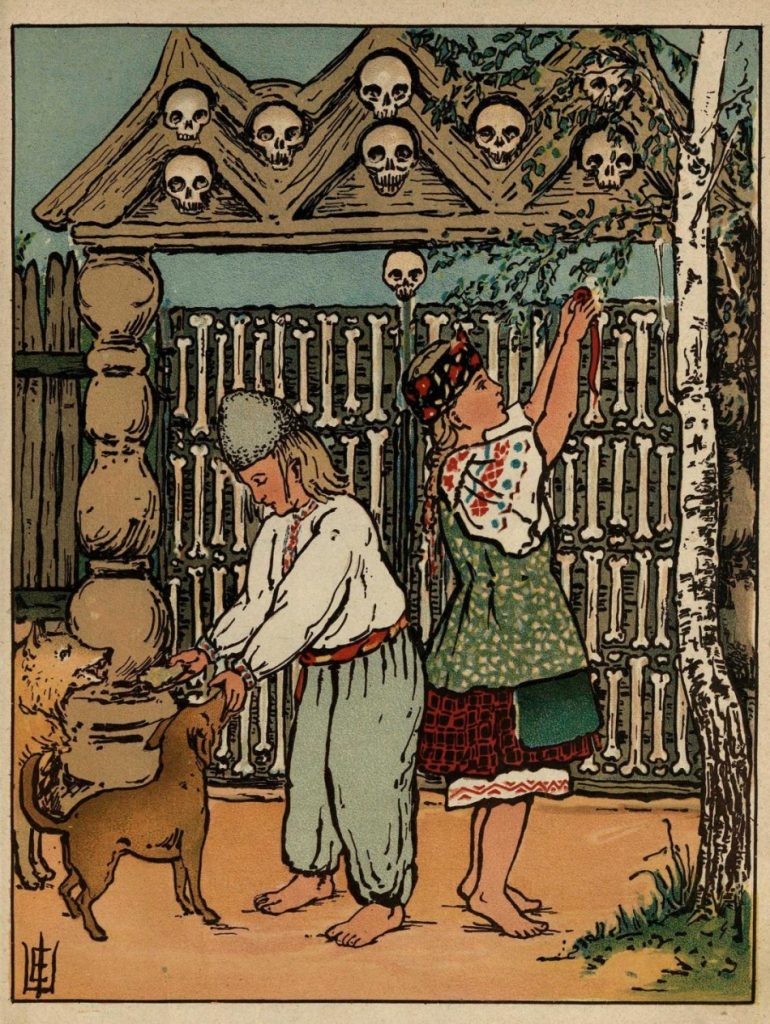
The witch herself is not much described in the text of “Vasilisa,” but in the folklore of the Eastern Slavs, she is generally imagined as an hunchbacked old crone, usually large, and with a large nose, sometimes said to be of iron, as are her teeth sometimes. She’s also occasionally described as an ogress because of her nasty habit of eating visitors, especially children, or those who fail her when she puts them to work (what she often does with visitors).
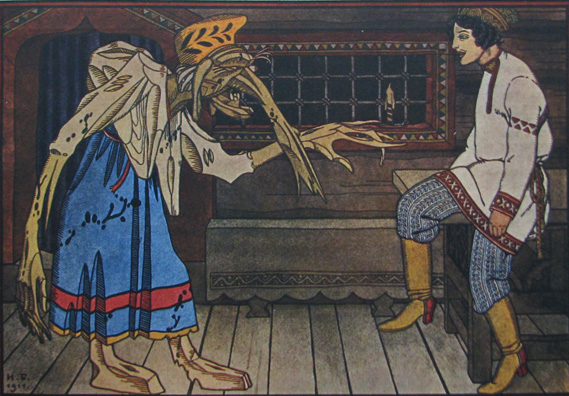
“Vasilisa” like nearly every other tale featuring the character, describes the witch flying through the skies in mortar, which she steers with the pestle, an instrument sometimes also used as a club or magic wand. Like western witches, she is often depicted with a cat, but the Baba Yaga may also command a pack of dogs, flock of geese or swans, or even be served by pairs of disembodied hands.
“Baba Yaga” is not quite a proper noun, i.e., her “name,” at least not quite. It’s a class or type of character, and certain stories feature multiple Baba Yagas. For this reason too, she may be killed off in a particular story — and often is — only to reappear as presumably different witch in another.
Though she’s most often portrayed as malevolent and dangerous, some tales make her more ambivalent, or occasionally even helpful. We have a look at the best known examples of this, “The Frog Tzarina” (a story offering a sort of reversal on the “Frog Prince” theme) .
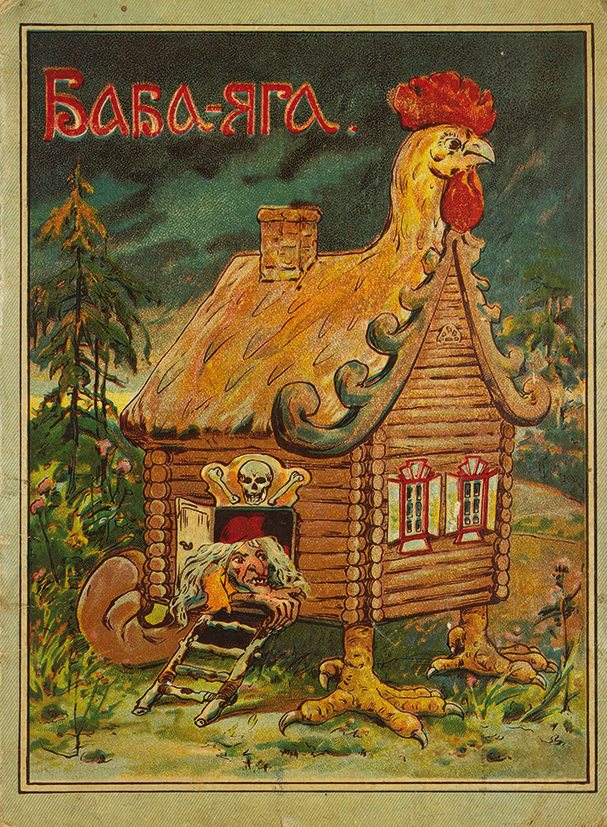
Of the tales that feature the Baba Yaga in a more menacing role, one of the better known is called “Princess Marya” or “The Death of Koschei the Deathless,” and it features the witch as a character somewhat peripheral to another important character of Russian folklore, Koschei. He’s a sorcerer, usually represented as a crowned skeletal figure and known for hiding his soul in the form of a needle within an egg within a duck. We also hear a bit of another tale featuring a malevolent Baba Yaga, “Little Bear’s-Son,” in which the witch lives in an underworld and battles the titlular character and a trio of giants.
Our quick look at a few examples of the Baba Yaga in music and films includes a piece from Modest Mussorgsky’s 1874 suite Pictures at an Exhibition called “The Baba yaga” or “The Hut on Fowl’s Legs” (Here is the Baba Yaga inspired clock design by Victor Hartmann that inspired the piece.) We hear a bit from that and a snippet of “Baba Yaga,” a 1965 garage-rock number by a Minnesota band called The Pagans. Speaking of music, our show, opened with a clip from a 1997 track “Baba Yaga” by the Australian singer, Judy Small. Also used in this episode are two other traditional pieces of music, “Doina Oltului” (instrumental) and “Khorovod,” an example of ancient pagan round dance music of the Slavs.
Probably the greatest modern popularizer of the figure and huge influence upon how the Baba Yaga is imagined in Russia today is work of filmmaker, Alexander Rou featuring the actor Georgy Millyar. Beginning in 1939, with a version of “The Frog Tsarina,” and running up to 1972, the year before he died, Rou made over a dozen film inspired by Russian fairy tales.The Baba Yaga appearing in many of these was always portrayed by the cross-dressed Millyar, whose comic performances are one of many reasons to seek out Rou’s films on YouTube.
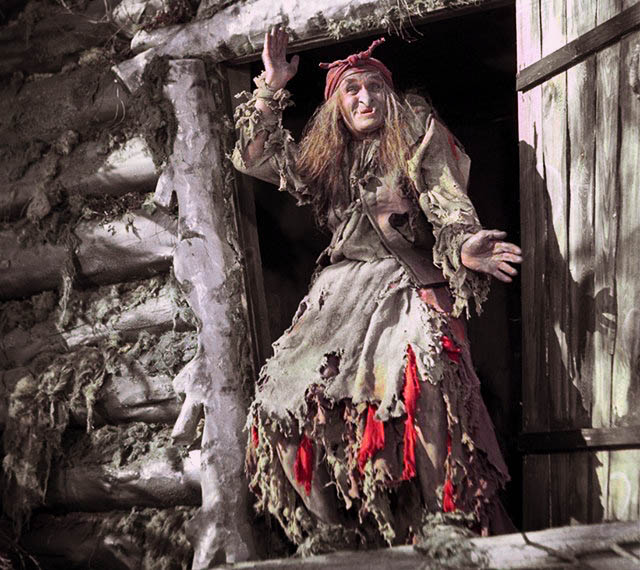
While the first mention of the Baba Yaga in print only appears in a 1755 book called Russian Grammar, it’s presumed the figure comes from much older mythology. In fact, while the reference in question, though vague, includes her in a list of Slavic deities. References to the witch’s control over horsemen representing the sun in “Vasilisa the Beautiful,” for instance, have suggested a possible origin in a solar deity. More likely, given her association with bones and her menacing nature, would be a connection with Marena, the Eastern Slavic goddess of death and winter. The witch’s flights in her mortar, always accompanied by terrible winds, have also suggested connections to the aerial phantoms of what’s called The Wild Hunt in Europe. Similarly her presence in the sky has suggested a connections with the Fiery Serpent, a figure of Eastern Slavic folklore, often represented by aerial phenomena such as lightning or meteors. All ideas to chew on. Nothing definitive, though the strongest association would seem to be with Marena.
We close the show with two tales from our own times, in which the Baba Yaga’s namesake or likeness is responsible for some dreadful deeds.
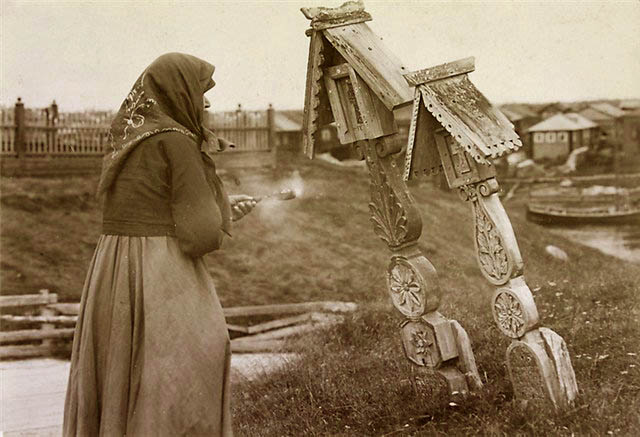
Bone and Sickle is happy to welcome Sarah Chavez as a new voice in the show this week.
#30 Loup-Garou, Werewolves in France
The werewolf (Fr: loup-garou) epidemic of 16th-century France forms the core of our show, but we also include some medieval French werewolf tales as well as the legend of a figure connected to both werewolves and Bluebeard.
In our last episode on Bluebeard, I promised to recount a legend that may have inspired Charles Perrault’s story. This would be the story of Count Conomor, or “Conomor the Accursed,” a 6th-century ruler of Brittany. Here the role of Bluebeard’s new wife is played by Trephine, the daughter of a rival count. Through her forbearance, she came to be regarded in local traditions as a saint (therefore the chapel depiction below). Her adventures include interaction with the helpful ghosts of Conomor’s slain wives, decapitation by Conomor (with miraculous cure) and a magic ring The curse upon this wicked count continues into the afterlife, during which he is condemned to roam the countryside in the form of a werewolf.
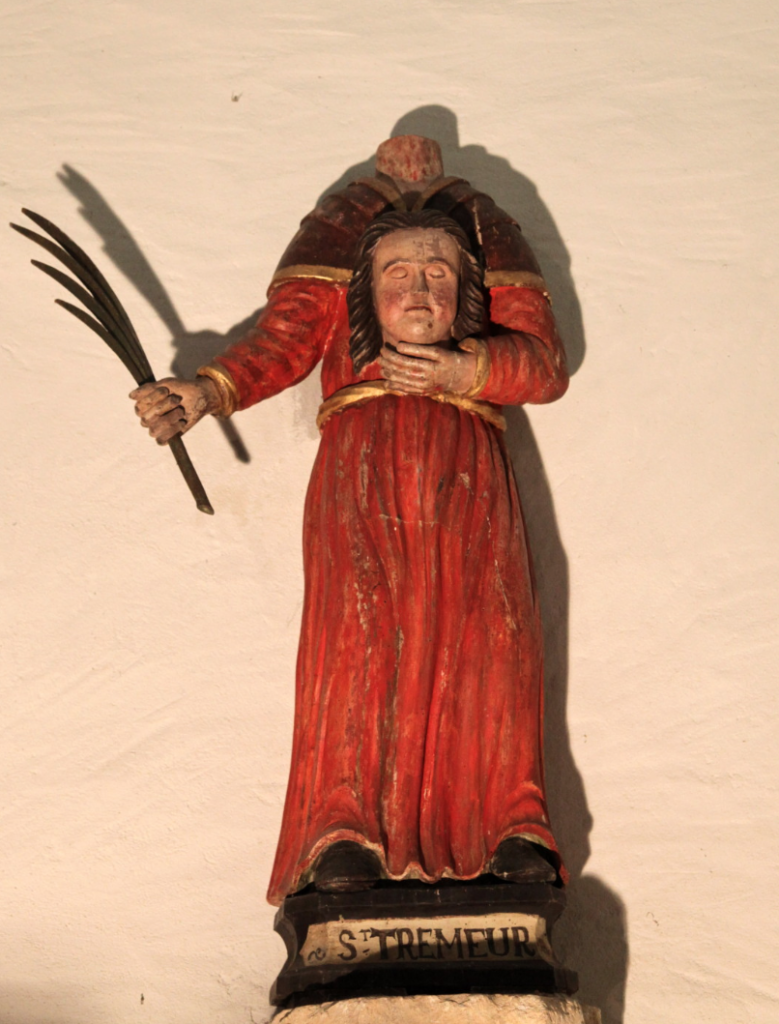
Our next segment looks at some medieval werewolf stories, including the 12-century poem by a Marie de France, “Bisclavret,” in which the werewolf plays a surprisingly sympathetic role, the tale of Sir Hugues de Camp-d’Avesnes, condemned to an afterlife as a werewolf for burning a town in the 1131, and that of the knight Raimbaud de Pulet, who in a fit of despondent madness becomes a werewolf.
The French werewolf epidemic, which between 1520 and 1630, resulted in the execution of more than 30,000 individuals was the result of a link forged between the werewolf and a new, more aggressive attitude toward witchcraft arising in ecclesiastic councils taking place in Basel Switzerland in the 1430s. The first regions in France to begin prosecutions were therefore naturally those adjacent to Switzerland. Many there were overseen by Henry Bouguet, a judge who tried approximately 600 witchcraft cases in the locality. Most of the stories recounted in this episode come from his writings on the subject, while others come from the The Werewolf by highly eccentric English scholar Montague Summers, who was discussed in Episode 1.
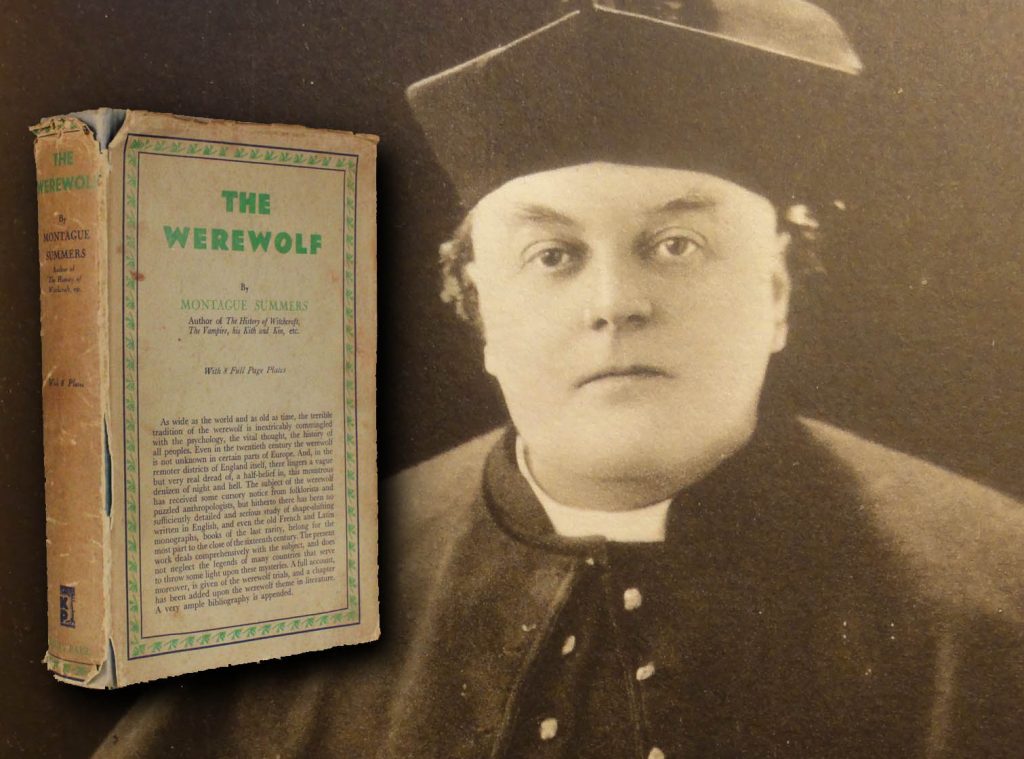
The first of Bouget’s cases examined is that of Michel Verdun, who shortly after a wolf attack in which the beast is wounded is discovered treating a matching wound on his arm. Verdun’s testimony implicated two other men likewise said to transform themselves into wolves, Philibert Montot, and Pierre Bourgot, who provides a lurid testimony including accounts of bloody crimes committed in wolf form, attendance at a witches’ sabbath and being initiated into his wicked ways by a black rider he meets in the forest.
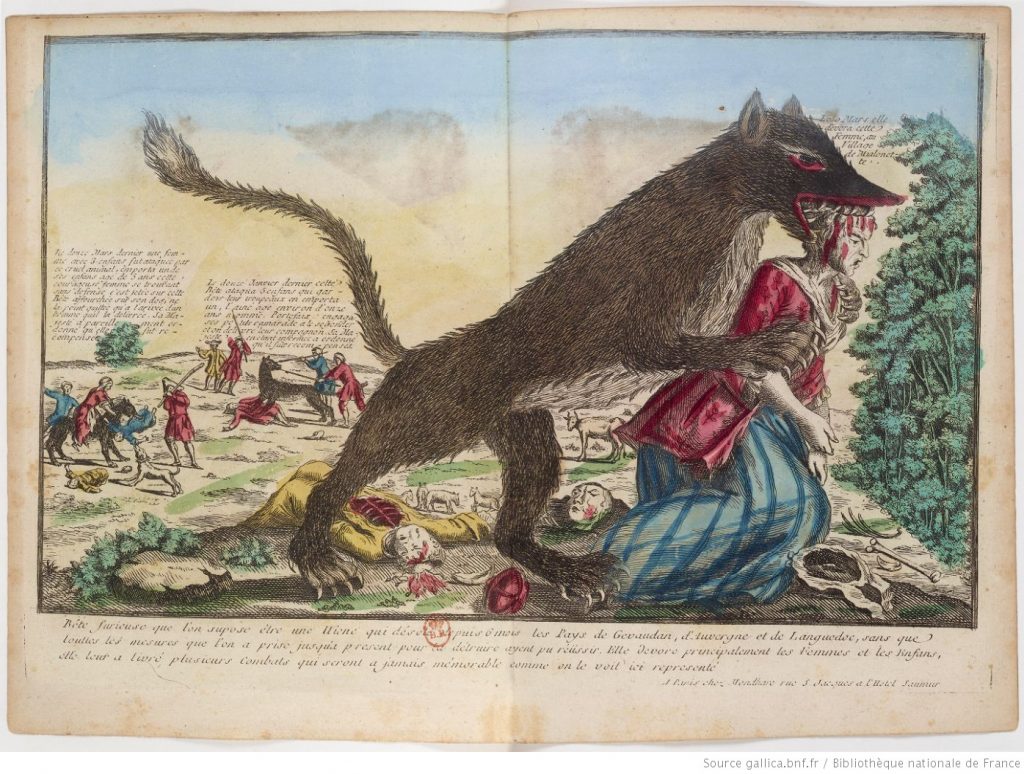
The next case discussed (and judged by Bouget) is that of Gilles Garnier, who also spoke of a forest meeting with a diabolical figure who presented him the magic ointment necessary for transformation. Garnier’s case is interesting in that he brought home human flesh from his werewolf attacks for his wife to enjoy.
Another case in this same area mentioned by Boguet is that of the Gandillons, a whole family of alleged werewolves. It begins with a female werewolf, Perrenette Gandillon, who attacks a brother and sister and is then killed by a mob. Her sister, Antoinette confesses to also being a werewolf and attending a witches sabbath, as do her father and brother. Wilkinson reads for us a colorful description of the wolf-like behavior of the male Gandillons in their prison cells.
Outside of Bouget’s jurisdiction, we find the case of the Werewolf of Chalons, a tailor discovered abducting children and butchering them in his shop. We also hear the story of Jean Grenier from Bordeaux (see the comic below).
The show closes with an account of 20th-century lycanthropy from Grenier’s home town of Bordeaux. When an unnamed assailant confesses to murdering a stranger invited into his home for a meal in 1989, he is examined by prison psychiatrist Michel Bénézech, who makes the diagnosis of “pathological lycanthropy.” The quotes we hear from Bénézech are from the BBC show “The Secret Life of Ghosts & Werewolves.”
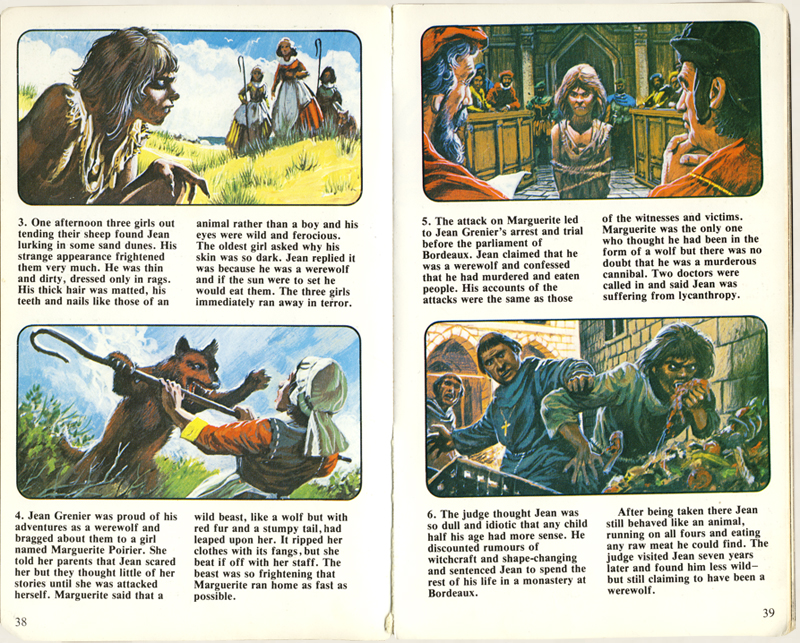
#29 The Bloody Chamber
Bluebeard and his bloody chamber full of murderous secrets is widely known as one of Charles Perrault’s fairy tales, but it’s part of a larger family of folk tales and ballads we examine in this episode.
Our show begins with a brief summary of this tale in which a young woman is courted by the mysterious and strangely whiskered nobleman, Bluebeard. After lavishly entertaining the woman and her family in his castle, it’s agreed they should marry. Soon thereafter, Bluebeard departs on a journey leaving his bride keys to all the rooms of his estate, all of which to which may use — but one. Curiosity, however, getting the better of her, she unlocks the forbidden door and must face Bluebeard’s murderous rage at her disobedience.
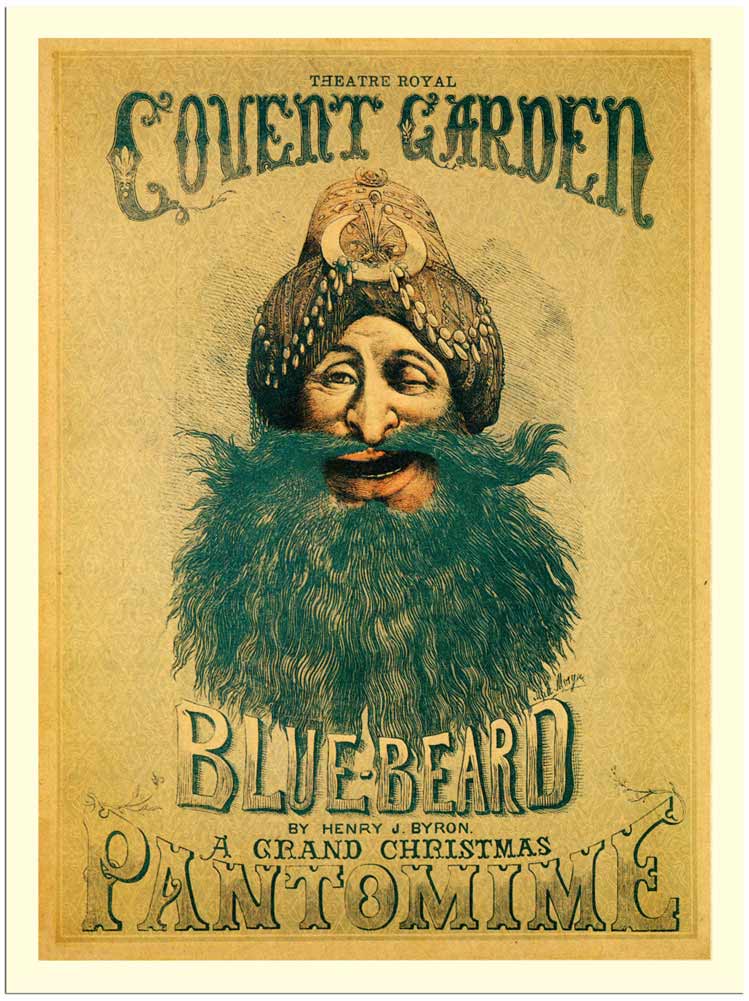
Perrault’s 1697 story, which draws upon older folk tales, is primarily known thanks to its inclusion in collections of fairy tales intended for children. Today, however, you’re unlikely to find the gruesome yarn anthologized for younger readers. If included at all, it may be sanitized, as it was in the 1970 children’s record from which we excerpted a clip at the show’s open.
Along with fairy tale collections and cheaply printed chapbooks, the Bluebeard story was largely preserved through theatrical representation. We look at a number of productions from the late 18th and early 19th century that treated the story in a semi-comic or melodramatic fashion, often combining elements of the Italian Commedia dell’arte, such as Harlequin and his antics. Wilkinson provides of some readings of the comedic dialogue as well as stage directions which often made the “bloody chamber” a lavishly designed and spooky centerpiece of the production.
Particularly important to how were think of Bluebeard today is the 1798 production Blue Beard, or Female Curiosity!, which moved the story to Turkey in order to exploit a growing fascination with the East. This image of Bluebeard and indeed its importance in the English-language repertoire is suggested by the inclusion of the play in the 1993 Jane Campion film, The Piano, a story set during this period. The theatrical tradition of representing Bluebeard’s wives as bloody heads severed from their bodies is demonstrated in this scene as well as many 19th-century photographs of such stagings.
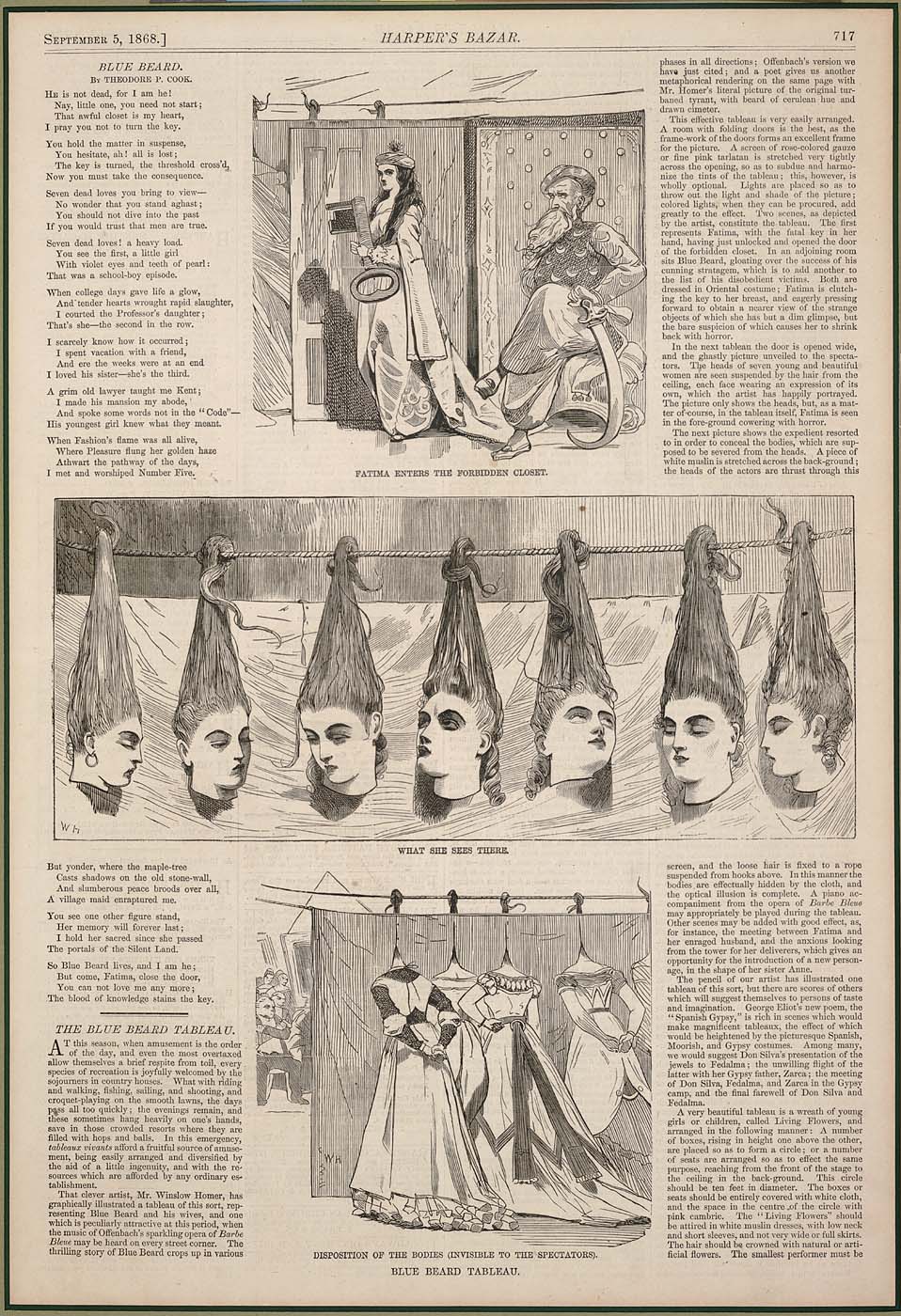
Also discussed is 1 1903 Christmas staging of Mr. Bluebeard in Chicago, famous not so much for its musical numbers (such as the song “Raving,” which we hear excerpted) but more for a landmark fire, which claimed the lives of 602 theater-goers.
While there have been dozens of films that play with the theme of women marrying men with mysteriously deceased wives, only a few have directly addressed the tale. We very briefly discuss the 1944 Bluebeard with John Carradine, the 1972 Bluebeard with Richard Burton, and the 2009 French film, Barbe-Bleue (Bluebeard), which is the most traditional of the lot.
In the next part of our show, we look at related folktales including the Grimm’s story “Fitcher’s Bird,” which features bloody chambers that must not be opened, a skull dressed as a bride, a woman rolling in honey and feathers, and a wedding that’s diverted into an execution party. We also look at the English tale “Mr. Fox,” in which a woman spying on her bridegroom discovers his habit
The Grimms also gave us “The Robber Bridegroom,” in which a bride-to-be visits her intended’s home “out in the dark forest,” where she makes unnerving discovery similar to that in Mr. Fox (but with an added element of grisly horror thrown in).
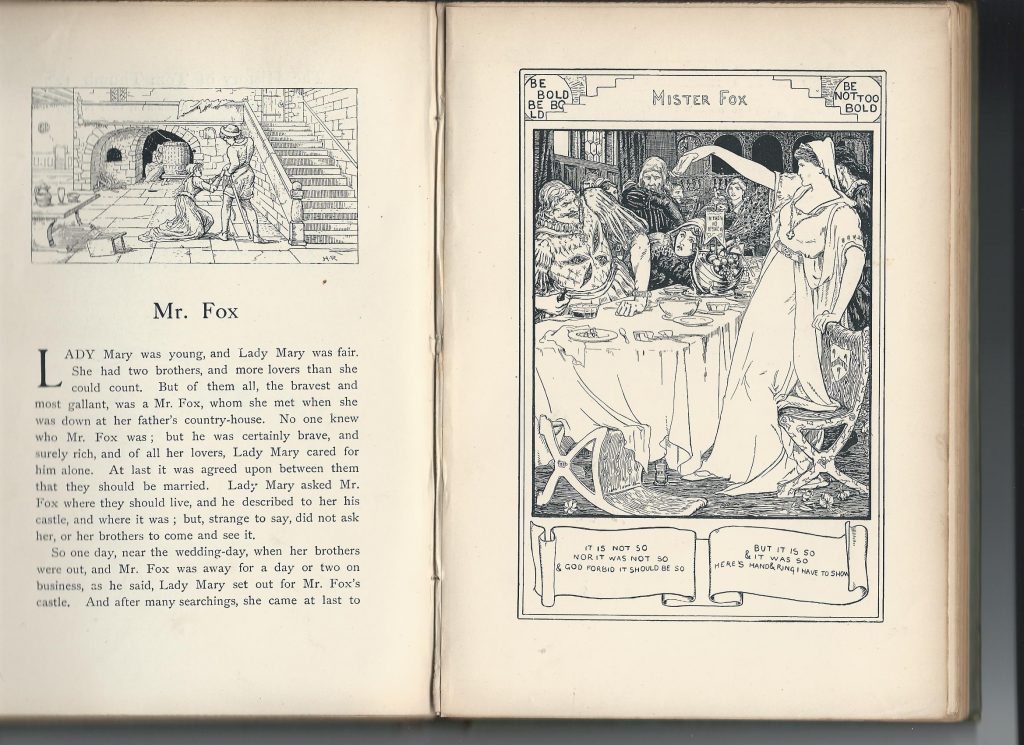
As a sort of musical tonic to all these tales of women and the bloody chambers they might end up in, we close the show with two traditional ballads in which the woman more satisfyingly gains the upper hand, and ends up slaying the serial killer she is to wed. The frist of these, is a Dutch ballad “Lord Halewijn” and the second “Lady Isobel and the Outlandish (or “Elf”) Knight.”
We close with a peculiar tidbit from modern life, a weird parallel between ancient folk ballads and a true-crime oddity.
#28 Gog, Magog, and the Bones of Giants
This time we look at the myths of British giants Gog and Magog, and a belief in biblical giants seemingly confirmed by giant bones dug from the earth.
We begin with a 1953 newsreel welcoming reconstructed figures of Gog and Magog back to the London Guildhall after the Nazi bombing of the city destroyed the originals. While Londoners may know the figures as those paraded in the Lord Mayor’s show each November, we also look at a more American perspective on Gog and Magog as figures representing nations allied with the Antichrist from the biblical book of Revelation.
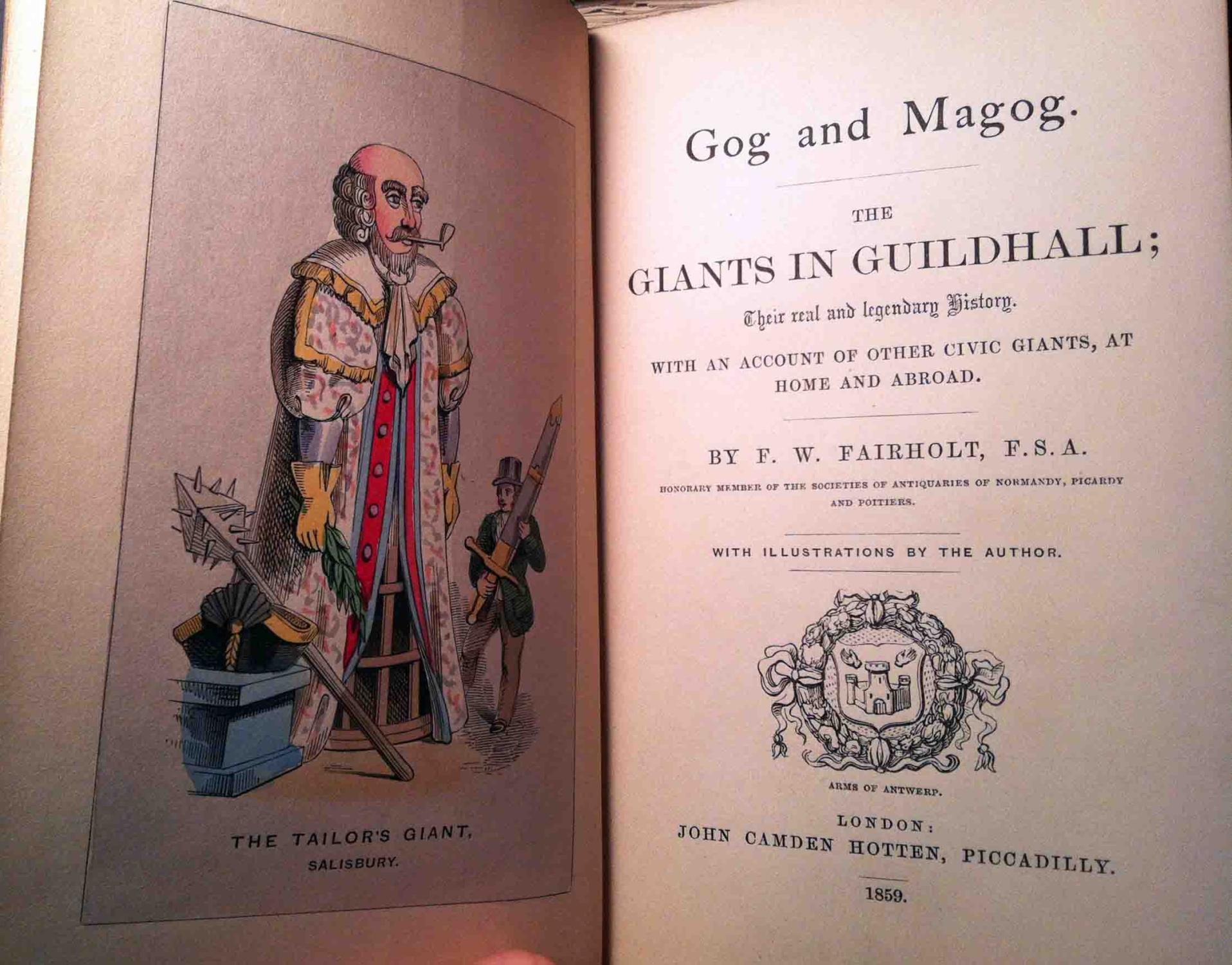
Our next stop in the Bible is a verse from Genesis Chapter 6, speaking of “giants in the earth in those days,” (before the Flood). The word “giant,” we learn, was chosen to translate the Hebrew “Nephilim.” Our Genesis passage suggests the Nephilim are the offspring of angels mating with human women, and this notion is reinforced by apocryphal texts, such as the Book of Enoch, which dubs these fallen angels “Watchers.” We hear a snippet featuring kindly Watchers from Darren Aronofsky’s 2014 film, Noah, which whitewashes the traditional understandings of the Watchers.
The word, “Nephilim,” we learn, literally means “fallen ones,” (“fallen” as in divine beings tainted by human hybridization.) The suggestion that they are physically large comes from another Genesis story in which Moses sends spies to the land of Canaan in preparation for a Hebrew invasion and receives a report on “Nephilim” who in size compare to men as men do to grasshoppers. We also hear some amusing stories of the biblical King Og, whose 13-foot bed is mentioned in the book of Deuteronomy.
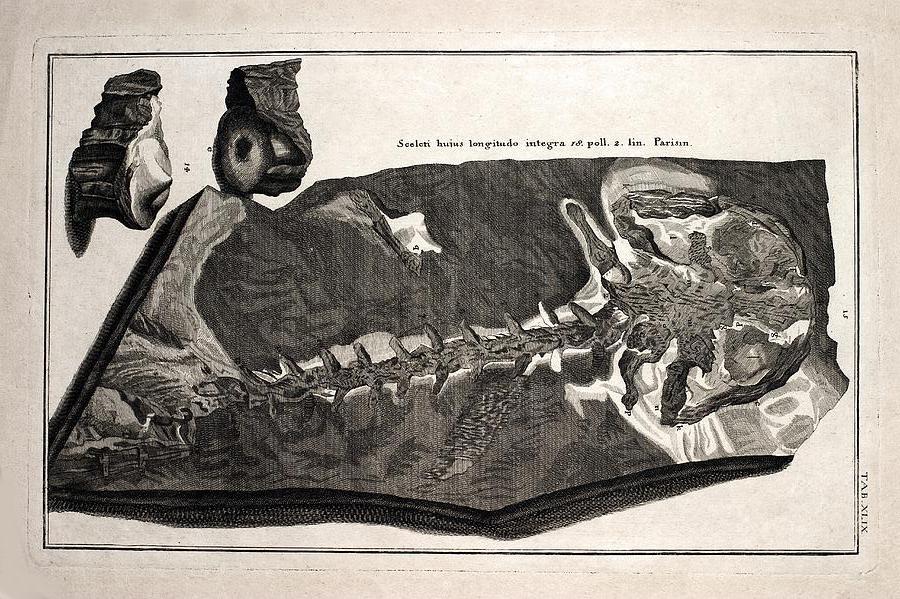
Next follows a quick survey of the bones of prehistoric animals mistaken for the bones of biblical Nephilim (or St. Christopher, who was also believed to be a giant from the land of Canaan). Bones of mastodons figures prominently as do the teeth of St. Christopher, though holy relics produces from beached whales and deceased hippopotami are also mentioned. We also learn of the patron saint of hares, St. Melangell (also somehow gifted with oversized bones) a dinosaur named after the human scrotum, and a prehistoric species of giant salamander mistaken for one of the Nephilim by 18th century naturalist Jakob Scheuchzeri, who figures into the early science fiction novel War of the Newts (represented with a snippet from a 2005 BBC radio drama). The hoaxed 12th-century discovery of a gigantic skeleton of King Arthur at Glastonbury is also discussed.
We learn that Arthur turns out to be connected to the Cornish folktale of that murderous scamp “Jack the Giant Killer.” Referring to an 18th-century text, we run through the grisly episodes of this story (including a long-forgotten one including a female follower of Lucifer). Not only does the original tale see Jack inducted to Arthur’s Round Table, but it seems the Cornish story is a retelling of a similar Arthurian story of the king slaying a giant on Mont Saint Michel in Normandy. A strangely mirrored version of this site, St. Michael’s Mount in Cornwall also was said to be home to a giant named Corineus, a figure that seems to be related to Cormoran, the first giant killed in “Jack the Giant Killer.”
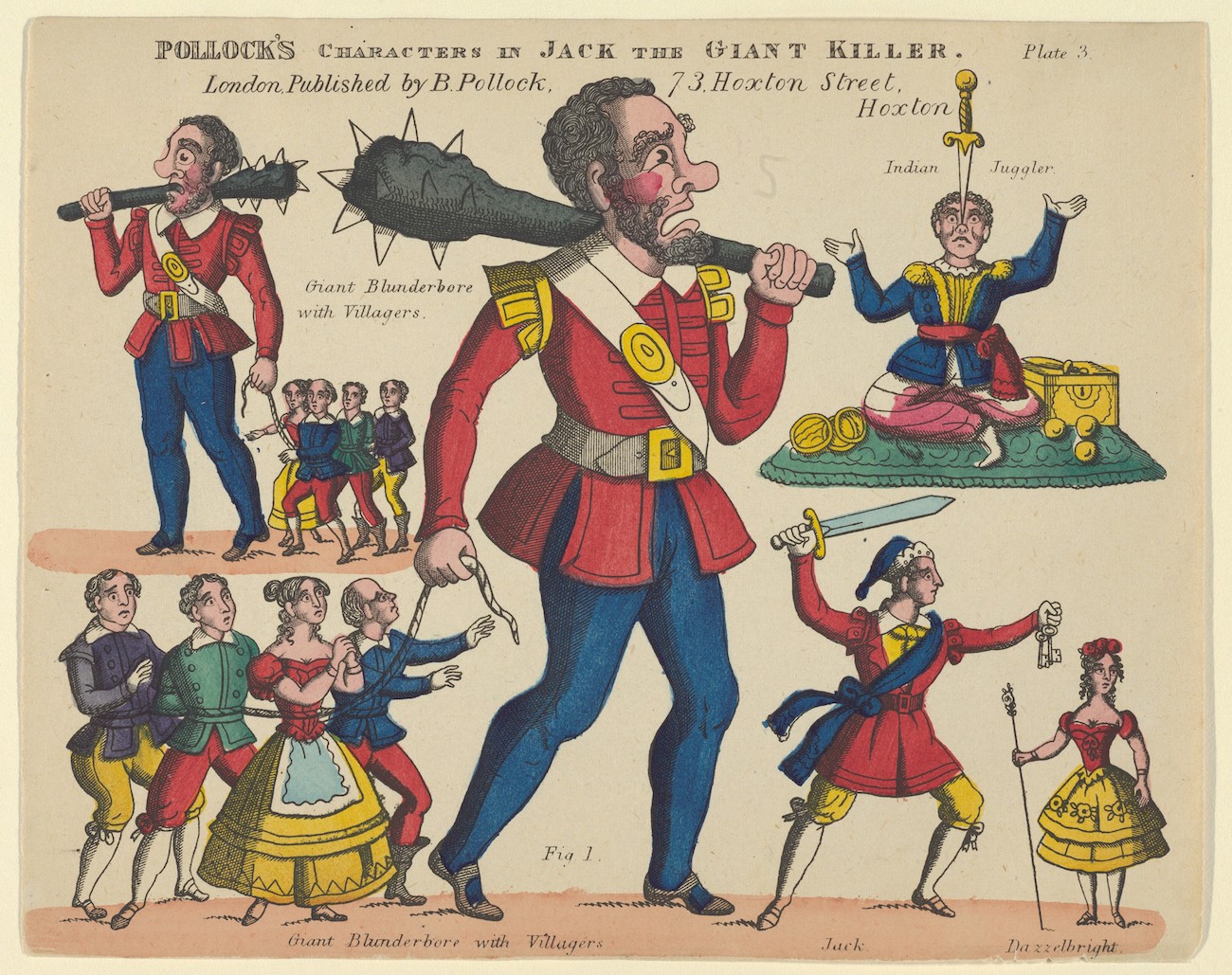
Along the way, Wilkinson provides us some richly detailed passages regarding Arthur’s encounter with the giant of Normandy from the 15th-century telling in The Alliterative Morte Arthure.
On the border between Cornwall and Devon is a site known as “Giant’s Leap,” where another mythic Corineus was said to have killed a giant in the Geoffrey of Monmouth, pseudo-history of Britain, Regum Britanniae. Monmoth’s fable tells of Britain being founded by Brutus of Troy, sent to the island by the goddess Diana, who foretells his victory over the indigenous giants there. The last of these giants to die (as we hear dramatized in a reading from the text by Wilkinson) is hurled from the “Giant’s Leap” by one of Brutus’ soldiers — who happens to be named Corineus. That giant’s name in the text is Gogmagog.
The rest of our story, getting from these two names to the two figures represented at the London Guildhall and Lord Mayor’s Show is a bit complicated. It’s best listened to in the show, where you’ll also hear how the first offspring born on Britain were the product of exiled female criminals from Troy and incubi — another bit of the fable unfolded in Monmoth’s Regum Britanniae.
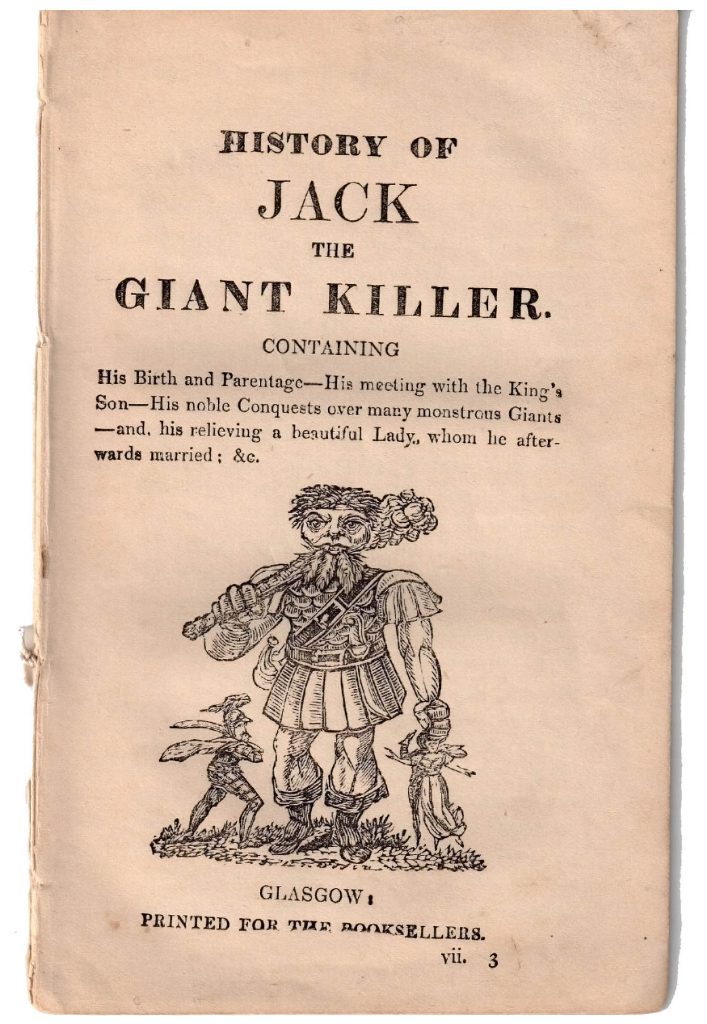
#27 Lilith and the Breeding of Demons
Our episode continues from our last with more terrors of the night, the incubi, sucubi, and the most notorious succubus, Lilith — and the breeding of demons
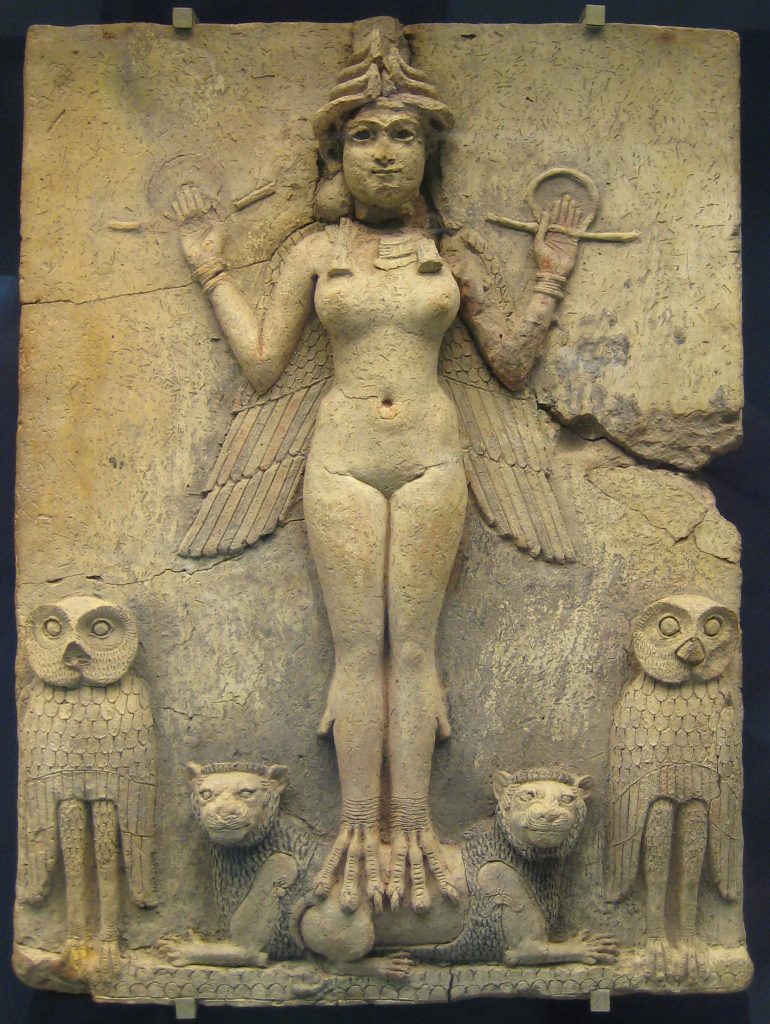
We begin with a quick nod to the shoddy treatment the topic of the incubus has received in films, as represented by the 1981 misfire, Incubus. From there, we jump to the Middle Ages, clarifying with a quick quote from Claxton’s Chronicle, the role of the succubus as seducer of men, and the incubus as threat to females. A few words from St. Augustine make clear a connection with other pagan figures with lecherous reputations, and a quote from King Jame’s Daemonologie offers a more innovative notion that the incubus and succubus are two faces of the same demon. Each fulfills what Augustine sees as the purpose of the paired demons — the succubus to collect the male’s semen and the incubus to convey this to the human female.
The offspring of these demonic/human pairings (with infants nursed by the succubi) are called “cambions” by the demonic-obsessed imagination clerics, but in secular folklore are virtually “changelings.” We hear of some legendary cambions, including Merlin, the hero Hagen of the Völsung saga, and Alexander the Great (the last in a tale related by Wilkinson).
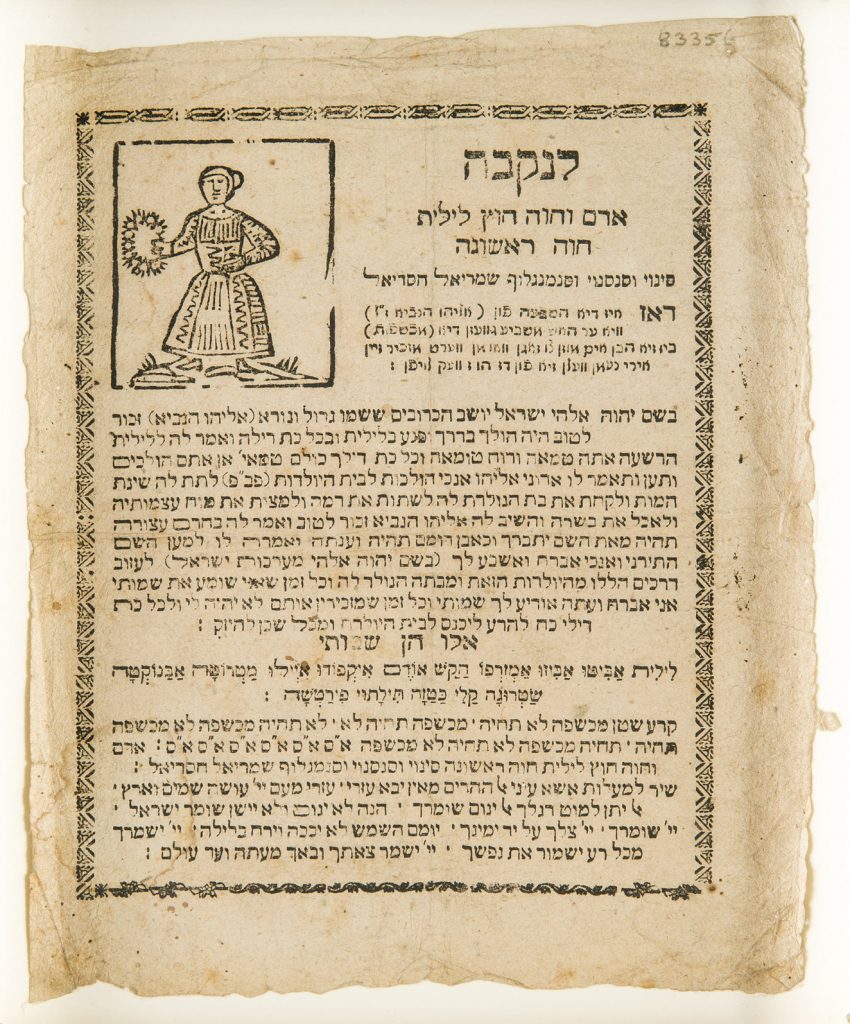
There follows another nod to the cinema’s sleazy representation of the succubi and Lilith (films linked below). From there, we make a brief survey of Lilith in high culture, in Michelangelo’s “Temptation” mural depicting her in the Garden of Eden on the ceiling of the Sistine Chapel, her brief appearance at the Walpurgisnacht scene in Goethe’s Faust, and the outrageous portrayal of Lilith and Satan in the “un-performable” Decadent play of 1891, Lilith, by Remy de Gourmont.
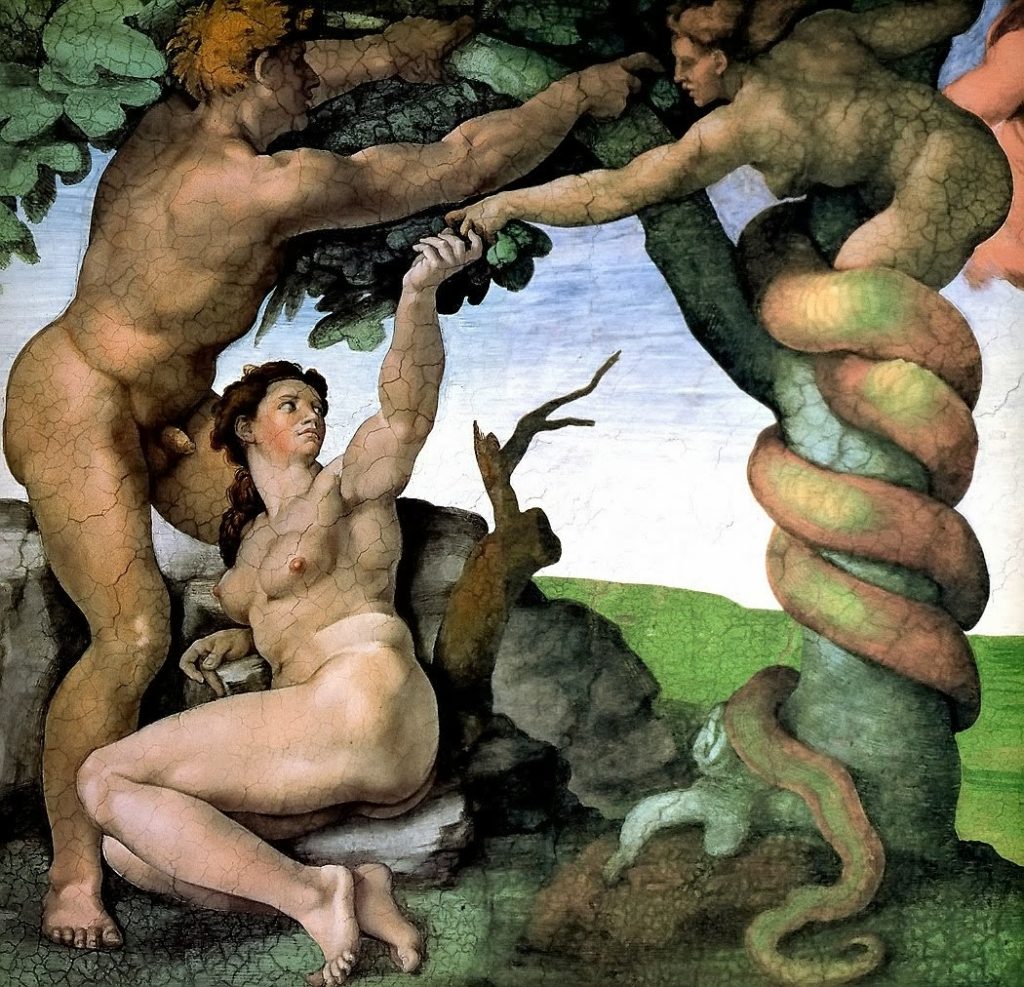
Our look at the more ancient history of the figure begins with an Old Testament reference to Lilith as a denizen of an enemy kingdom reduced to a haunted desert wasteland by Yahweh in the book of Isaiah. The Hebrews, we learn, borrowed the figure of the child-snatching, murderous, Lilith from the Babylonians/Akkadian storm and wind spirits known as the lilitu. An individualized and somewhat elevated specimen of this class seems to be the demi-goddess Lamashtu, whom we hear fearfully described in Wilkinson’s reading of an ancient hymn to this destroyer who shares many traits with the Hebrew Lilith. We also learn of a Lamashtu’s second-hand connection to the 1973 film The Exorcist.
After a quick look at Lilith’s later appearance in the Dead Sea Scrolls, we medieval Jewish legends. including The Alphabet of Ben Sirach, which first cast Lilith as Adam’s first wife, the Midrash Abkir, which described Lilith’s rape of Adam and their breeding of demons, and finally references to Lilith’s marriage to the demonic archangel Samael, in The Zohar and Treatise on the Left Emanation, a powerful pairing sometimes referred to darkly as “the other god.” We also find out about other legends with placed Lilith in a harem of wives belonging to Samael, including the demonesses Agrat bat Mahlat and Isheth Zenunim. Wilkinson provides us with a final, dramatic narrative from The Zohar describing the seduction and damnation of a foolish man at the hands of Lilith.
The show closes with an examination of the 1966 film, Incubus, starring William Shatner (before he was Captain Kirk). We learn about the curious decision to shoot the film in the artificial language of Esperanto and the alleged “curse” that haunted the production.
https://www.youtube.com/watch?v=eNzhx64s7IU
Clips from films used in the episode but not mentioned above include: Serpent’s Lair, Succubus: Hell Bent, But Deliver Us from Evil, Lilith, Lilith’s Awakening, Evil Angel, and The Chosen.
#26 Lullabies and Nightmares
This episode examines the terrors that come by night, not-so-soothing lullabies, prayers and charms against the nightmare.
We open with the grim Icelandic lulluby “Móðir mín í kví kví,” which tells the story of a newborn’s ghost haunting the mother who abandoned it. Another lovely, yet menacing Icelandic lullaby follows. “Bíum, bíum, Bambaló” alludes to an unnamed horror drawing nearer and nearer.
We learn that our word “nightmare,” originally designated a nighttime visit by a supernatural creature that pinned down and menaced the sleeper, ie, the “mare,” a word that arrived in English via the Saxons, and was derived from the Germanic “mara.” Recently, we’ve seen versions of this creature popping up in a number of horror films, snippets of which appear in a montage. These are: the 2018 film Mara and the 2011 Swedish film Marianne, both of which allude to the creature in their titles, and 2016’s Dead Awake and Before I Wake, as well as 2017’s Slumber and Don’t Sleep. And of course we include a nod to Nightmare on Elm Street, the film that started it all.

Stripped of its supernatural interpretation, the sleeper’s sensation of being pinned down and experiencing the sense of a malevolent presence is recognized by medical community as “sleep paralysis.” But researches of the last century are not the first to attempt to describe the phenomenon in physiological terms. We hear such a physiological take on the subject from 1584, drawn from The Discoverie of Witchcraft, a somewhat skeptical book on witchcraft.
The equation of the mare and the witch in English and Germanic culture is longstanding. The other term sometimes used by the scientific community to describe this phenomenon, “Night Hag Syndrome,” points to this, as the word “hag” is traceable to an ancient German term for witches, “Hagazussa,” which also happens to be the title of an excellent new folk-horror film from Germany. A snippet of the dark and droney soundtrack from that film is included.
Digging in a bit more on the topic of the mare, we learn that how the creature assumed a number of nocturnal forms while appearing in the day as either a witch or an unwitting human cursed by a witch, and hear a 13th-century account of an attack by a mare from the old Norse Norse Ynglinga Saga read by Wilkinson.
Next, we listen to a bit of another lullaby, this one from Russia, “Bayu Bayushki Bayu,” which tells of wolves ready to drag the sleeping child into the forest.
Whereas the “mara” (mare) is the preferred term for this creature in Great Britain (and English-speaking countries), Scandinavia, and northern Germany, further south in Germany, we hear of the “Alp,” a largely identical creature, with an etymological tie to our English word “elf.” The Alp exhibits a wider range of mischievous, elfin traits not common to the mare.
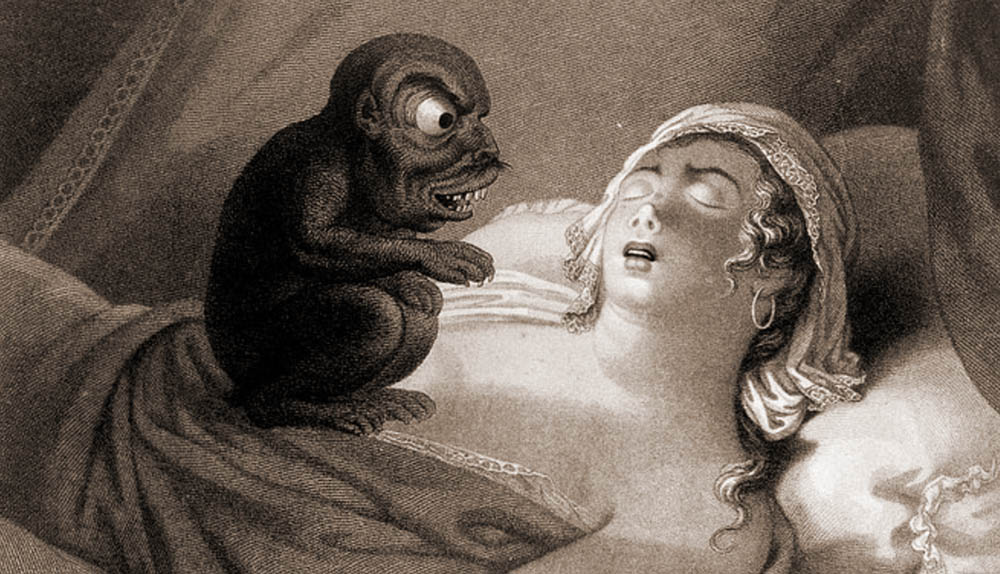
This same region is also haunted by the nocturnal “Drude” or “Trute,” which likewise presses and torments sleepers, but is more strongly connected to witches than elves. The word “Drude” is often combined with other words in German to describe witchy concepts, like the “Drudenfuss,” a word for “pentagram.” In the sometimes confusing world of folk-magic, the five-pointed star can be used as a form of white magic to combat darker magic and for this reason was often used on infants’ cradles to repel the Drude as in the illustration here. We also hear of a connection of the Drude to the recently released folk-horror anthology film A Field Guide to Evil.
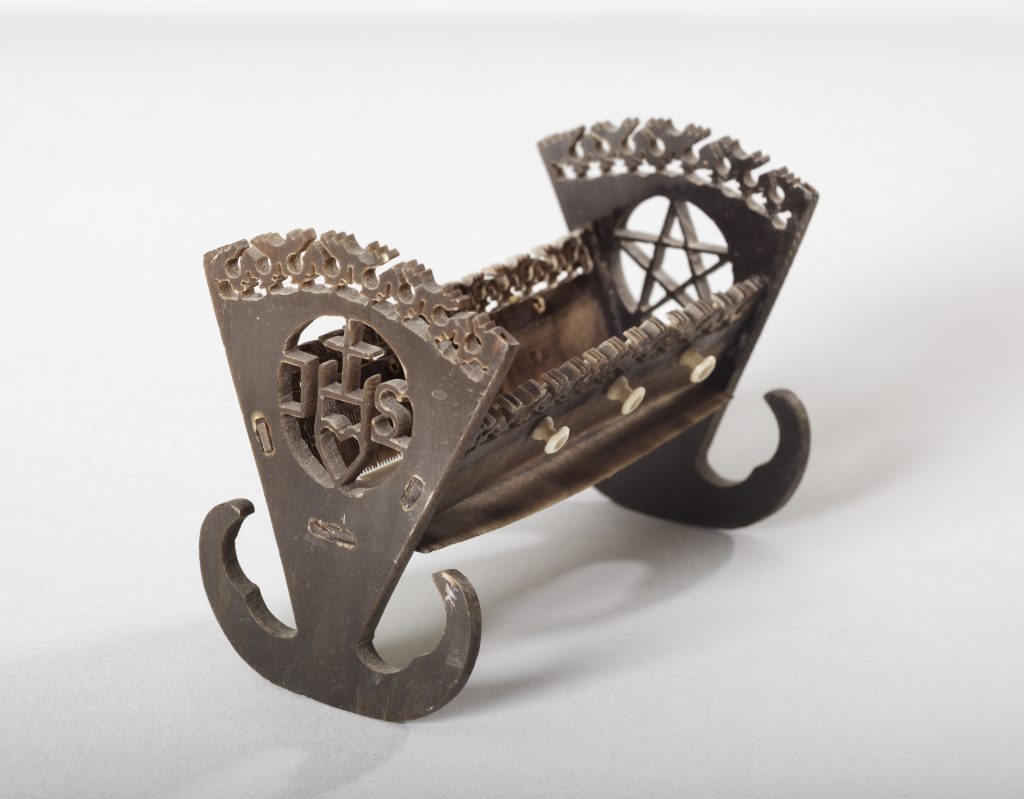
There follows perhaps the most explicitly terrifying lullaby in tonight’s collection, the Russian song “Tili-tili-bom.”
A number of folk practices against the nightmare are described including methods of trapping the creature. Wilkinson reads us a story from Germany’s Black Forest in which the creature is trapped in a particularly peculiar way. Counting charms, such as those used against vampires are also discussed.
Our show ends with a discussion of traditional bedtime prayers, including “Now I Lay Me Down to Sleep,” which we learn can be traced to prayers used in 16th-century witchcraft, ancient Jewish “devil trap bowls,” Babylonian incantations, and a rite created by the 19th-century British occult gropu, The Hermetic Order of the Golden Dawn. Along the way, we also hear a traditional southern-German nighttime prayer (Abendsegen) as featured in the 1893 opera Hansel and Gretel.
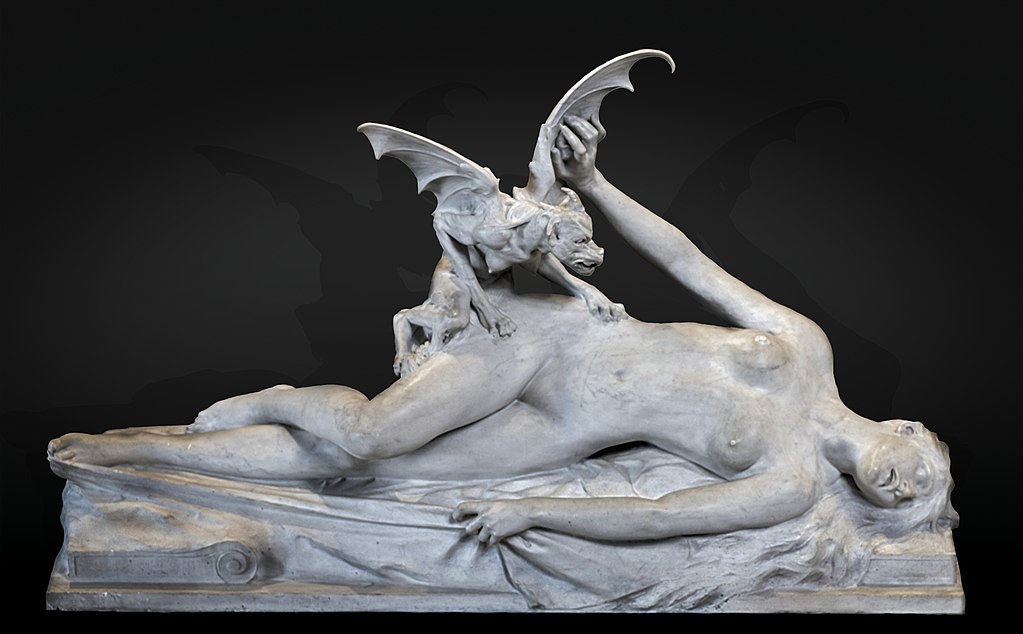
#25 Death by Mother
For Mother’s Day this year we examine murderous mothers and maternal instincts gone very, very wrong in folklore, legends, and ballads.
We begin with a look at the Latin American legend of La Llorona (“the weeping woman”). We begin with a snippet of the trailer from the recently released film The Curse of La Llorona and also hear a clip from a 1961 Mexican film released in the US as The Curse of the Crying Woman. We also here an alleged recording of La Llorona herself captured in one of many such user videos uploaded to YouTube.
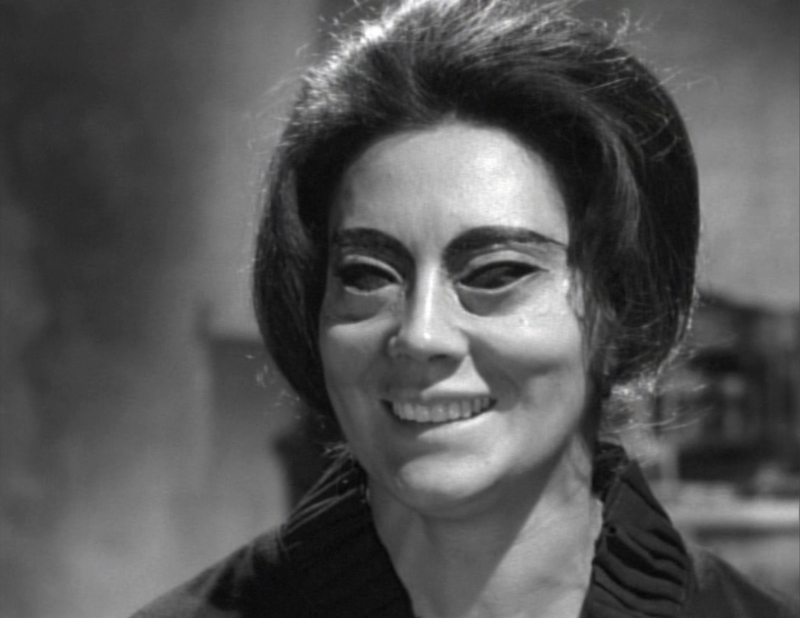
La Llorona’s story is that of a mortal woman who drowns her two children to avenge herself on faithless husband. In the afterlife she becomes a remorseful ghost and fearsome child-snatching bugaboo. We learn that this form of the legend is relatively modern, with the name “La Llorona” earlier attaching itself to a variety of tales that ascribe rather different motives and actions to the figure. Wilkinson reads for us a few of these earlier descriptions.
Next we have a look at some possible antecedents to the figure including the Aztec Cihuateteo (deified women who die during childbirth later becoming child-snatching spirits) as well as a water goddess Chalchiuhtlicue, a figure sometimes associated with drownings. Somewhat less credibly, a connection to tales brought by 19th-century German settlers in Mexico has even been suggested, namely that of the Weisse Frau (“White Lady”) who haunts the Hohenzollern Castle of Baden-Württemberg. She also does away with children in the context of a thwarted love relationship (in a particularly gruesome way).
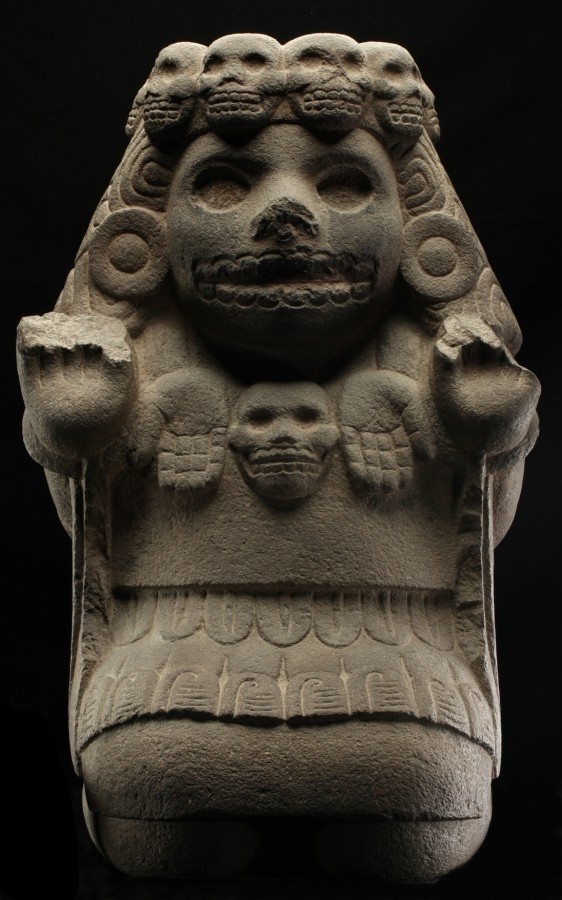
Whatever the source of the Llorana legend, it is not difficult to find parallels. Our next example is the Greek myth of Medea, who kills the children she’s had with Jason to punish him for taking a new lover. Her revenge on her rival, Princess Glauke of Corinth, is also dreadful, and dreadfully interesting in the description Euripides provides in his play. We hear Wilkinson read this passage and also hear a snippet of dialogue and the startlingly original soundtrack from Pier Paolo Pasolini’s 1969 film Medea.
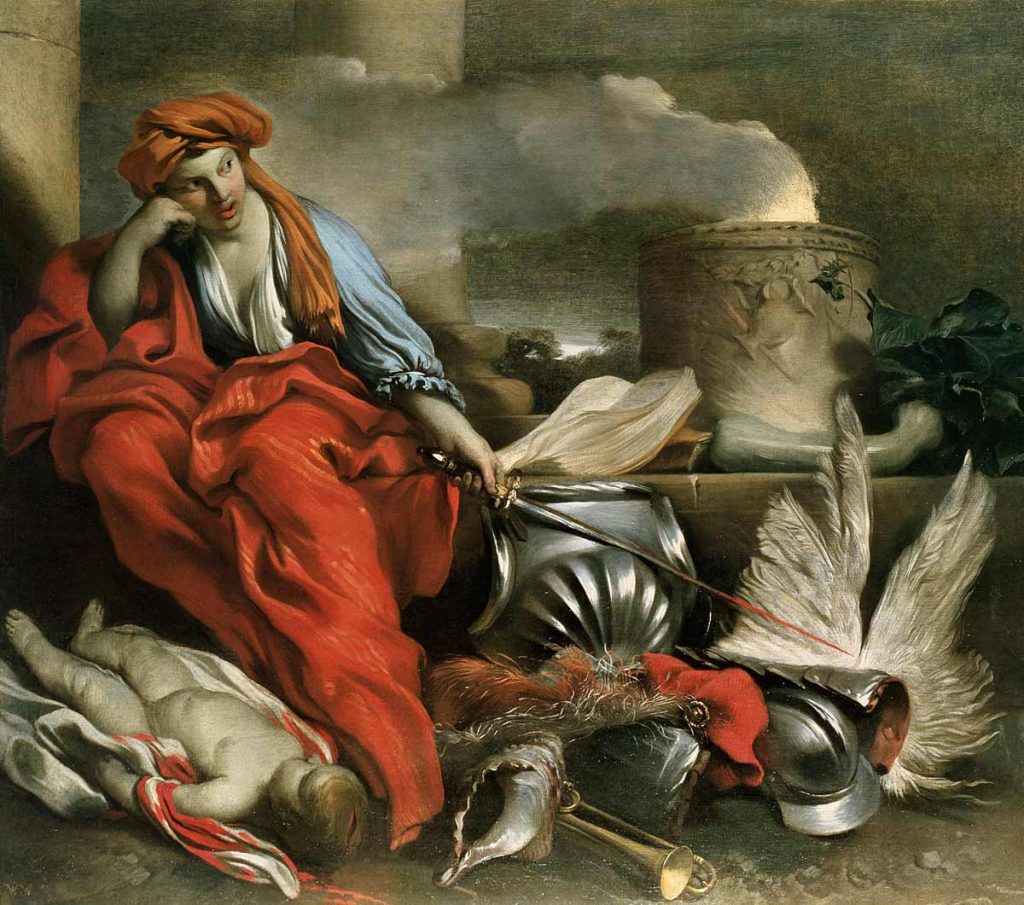
Our next segment looks at some legends and songs about unwed mothers who kill their unwanted newborns. We hear a bit about the numerous “Cry Baby Bridges” of North America. This modern urban legend associates certain bridges, usually in rural areas, with the ghosts of infants drowned in the rivers the bridges span. Often, particularly in older stories, the infants are illegitimate newborns.
In the Scottish or English ballad “The Cruel Mother” (also known as “The Greenwood Side”), we encounter a mother who has murdered her illegitimate children and later meets their spirits, learning from them the fate that awaits her on the other side. We hear a mix of various renderings of this folk song including: The Owl Service, Anna & Elizabeth, Fiona Hunter, Rubus, 10,000 Maniacs,Lothlórien, and Addie Graham. We also hear a bit from the nearly identical song “The Lady Dressed in Green” which serves as the basis of a macabre childrens’ song-game.
In the song, “The Well Below the Valley” (also known as ‘The Maid and the Palmer”) describes a meeting between a mother who has given birth to and killed a number of illegitimate babies and a mysterious holy man who visits her at the well and displays supernatural knowledge of her deeds. The song seems to originate with the biblical story of Jesus meeting a Samaritan woman at a well and likewise displaying supernatural knowledge of her checkered past. This story is also the basis of the gospel song “Jesus Met the Woman at the Well,” from which we hear brief snippets by The Fairfield Four and Nick Cave. The version of “The Well Below the Valley” we hear is by Shanachie.
La Llorona’s child-snatching aspect is anticipated by the Greek myth of Lamia, a woman with whom Zeus was said to have fallen in love, who was then punished by Zeus’ wife Hera. who either kills Lamia’s children or causes her to do so. Thereafter Lamia becomes a monstrous creature devoted to stealing or killing the children of mothers everywhere. We hear how this story later merges with medieval witchcraft beliefs.
The show ends with two stories involving cannibalism and murderous mothers. The first is that of Gudrun (or Kriemhild) from the Germanic Völsung saga upon which Wagner based his Ring Cycle (we hear a bit of Wagner here, music from The Twilight of the Gods. The second story is from Ovid’s Metamorphoses, involving a grisly vengeance exacted by Procne on the Thracian king Terseus, an act of vengeance for the rape of her sister Philomela. Wilkinson here again provides a dramatic reading from Ovid.
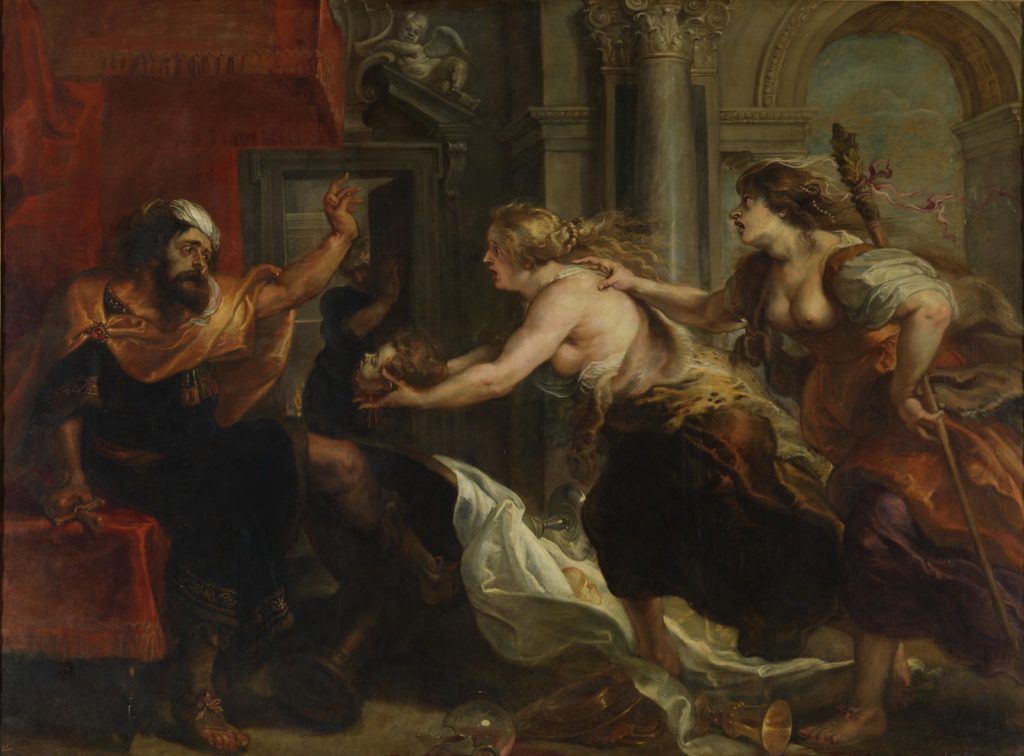
The show also includes a short bit from Henry Burr’s 1916 song “M-O-T-H-E-R (A Word That Means the World to Me)”
#24 Possessed Nuns and Holy Demoniacs
This episode finds the Devil where you’d least expect him: stories of possessed nuns and demonic attacks on the rigorously devout.. It’s a bit of a follow-up to our last episode on Ghastly Saint Stories.
We open with a clip from the 1999 film Stigmata, in which we hear it asserted that those marked by God with the stigmata are also more likely than others to be subject to attacks by Satan. Not a great film, but these types of characters straddling the line between the holy and damned, are our subject of our episode.
Our first case is that of 19th-century South Tyrolean stigmatic Maria Theresia von Mörl. Her reputation for holiness drew tens of thousands of devout visitors, but this holy figure was also beset by by beastly manifestations, which Wilkinson details for us.
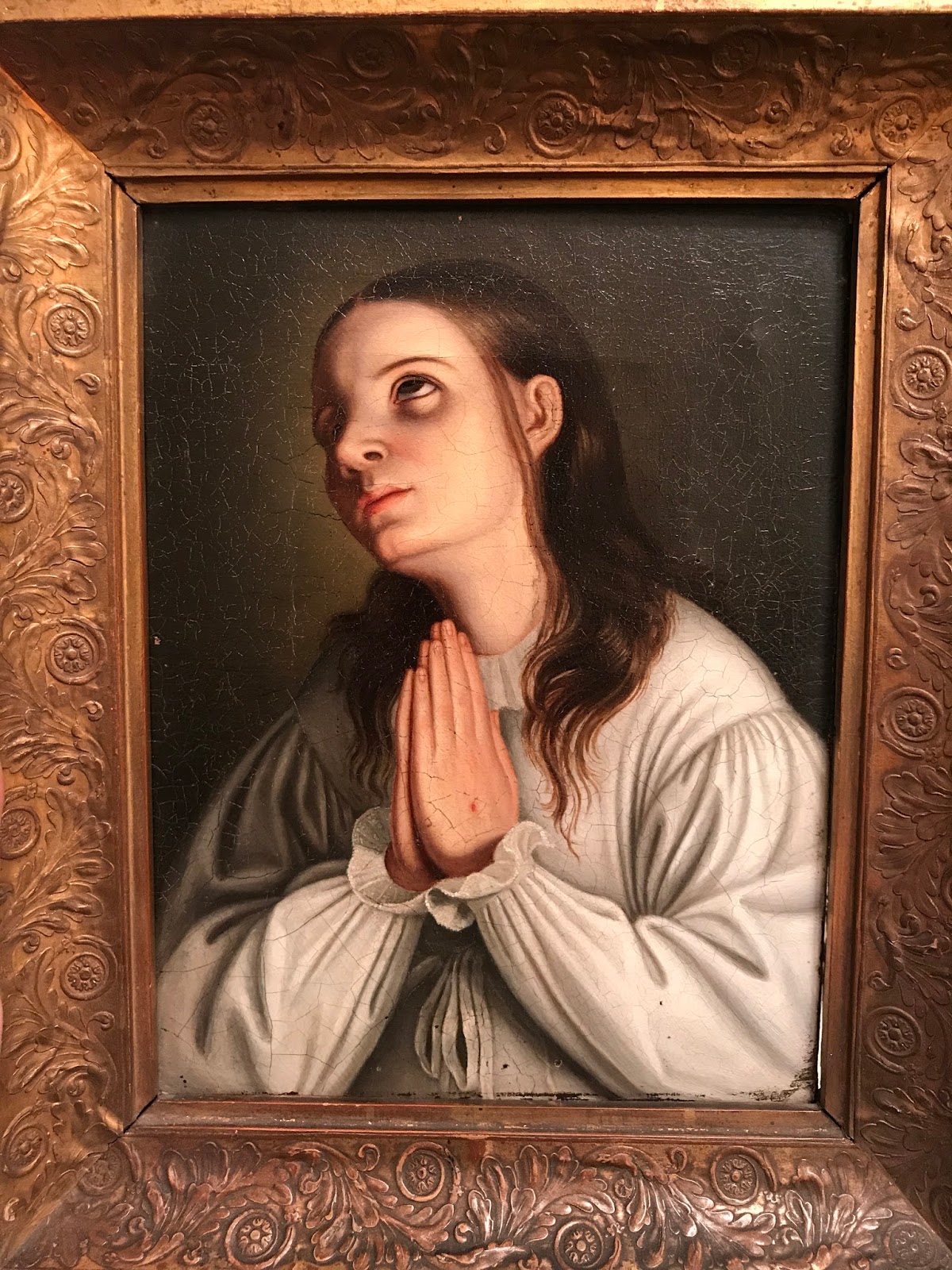
A more famous 16th-century personage bearing diabolical stigmata would be Magdalena de la Cruz, abbess of the Franciscan Convent of Santa Isabel de los Angeles outside Cordoba, Spain. We hear of her childhood, characterized by saintly (and gruesome) emulation of the Savior, her alleged miracles, and her early years as abbess, during which she instituted a particularly harsh program of mortification. She seems to have gone a bit far with a particularly presumptious miracle that lost her followers, eventually admitting to bit of a demonic involvement.
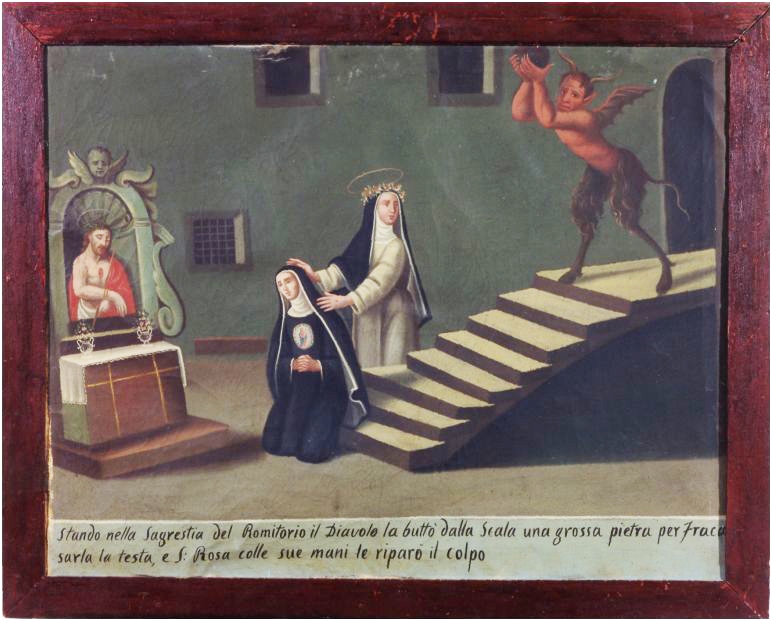
We’re getting to the famous possessed nuns of Loudun, France, but first I provide a little background on earlier demonic outbreaks in convents of 17th-century France, which seem to have set the pattern fr Loudun. Along the way, some documents recording curiously animalistic behavior of possessed nuns are briefly explored.
Our Loudun segment opens with a clip from a trailer for Ken Russel’s controversial 1971 film The Devils, which we learn was based on a 1960 play based on a 1952 nonfiction book on the subject by Aldous Huxley. We also hear a snippet from the lovely 1961 Polish film by Jerzy Kawalerowicz, Mother Joan of the Angels, which loosely adapts the Loudun story, picking up where Russel and Huxley’s narrative ends. Another Pole who interpreted the story was Christoph Penderecki, who in 1961 wrote the opera The Devils of Loudun. We hear a bit of Penderecki’s music under our account of the Loudun phenomena.
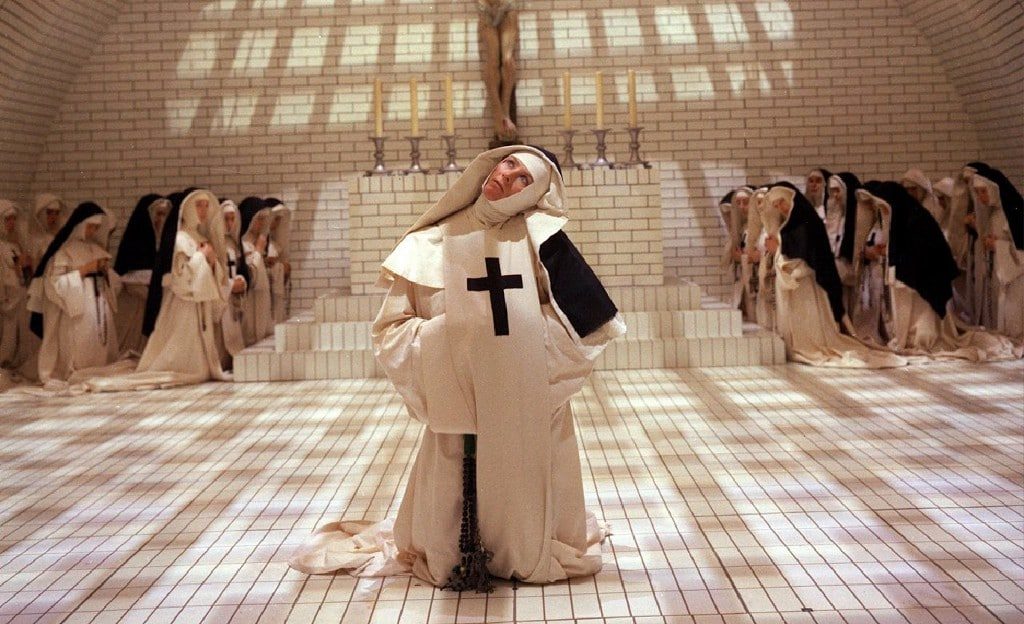
The Loudun story primarily revolves around two characters: Jeanne des Anges, Mother Superior of the convent, who becomes obsessed with Father Grandier, a parish priest with a reputation for sexual indiscretions. Des Anges, interprets erotic dreams about the priest as diabolic visitations, a fear that quickly infests the entire convent. Wilkinson reads for us an account of the extraordinary symptoms exhibited by the nuns who believed they’d been possessed. The story does not end well for Grandier, though des Anges, as we learn, goes on reporting more fantastic details of her struggle against Satan, eventually producing a strange but much coveted holy relic.
After our Loudun segment, you’ll hear a clip from the film The Exorcism of Emily Rose, and a bit later, the German film Requiem. Both are based (the former more freely) on the case of Anneliese Michel, a young Bavarian woman, who died in 1976 shortly after a series of exorcisms. We hear a bit about her psychiatric issues, which proved untreatable by conventional means, and the process of minor and later full rites of exorcism the family turned to. I’ve included Michel’s story alongside possessed nuns as Michel’s followed a similarly rigorous spiritual discipline, one which oddly became more aggressive in tandem with the growth of her “demonic” destructive and self-destructive behavior. We learn of Michel’s belief that her suffering under demonic forces served a redemptive role as penance for others and of a small, but devoted following she has drawn among Catholics who believe she was chosen by God as a “victim soul,” a concept we discussed in the last show. We also hear a snippet of disturbing tape recordings made during the exorcism. The show ends with a news story about the house in which these events took place and the strange rumors it engendered.

#23 Ghastly Saint Stories
Our collection of ghastly stories of saints highlights notions of extreme self-mortification as a spiritual practice along with a preoccupation with the saintly body after death.
While these aspects of Catholicism are anathema to secular outsiders and jarring to many contemporary adherents, they’ve been embraced by the Gothic. We begin with an illustrative clip from John Huston’s 1979 adaptation of Flannery O’Connor’s Southern Gothic classic Wise Blood.
The case of 15th-century Florentine Maria Magdalena de’Pazzi provides an example in terms of extreme mortification from an early age. Wilkinson reads some passages noting her ingenious use of found materials in her program of suffering. Along the way, we note some more traditional tools of self-punishment like the cilice, or hair-shirt and its varieties.
Submission to the natural process can also be a form of mortification when it comes to the carnivorous habits of insects. We hear some stories in this regard from the hagiographies of Ita of Killedy, St. Macarius of Alexandria, as well as Rita of Cascia.
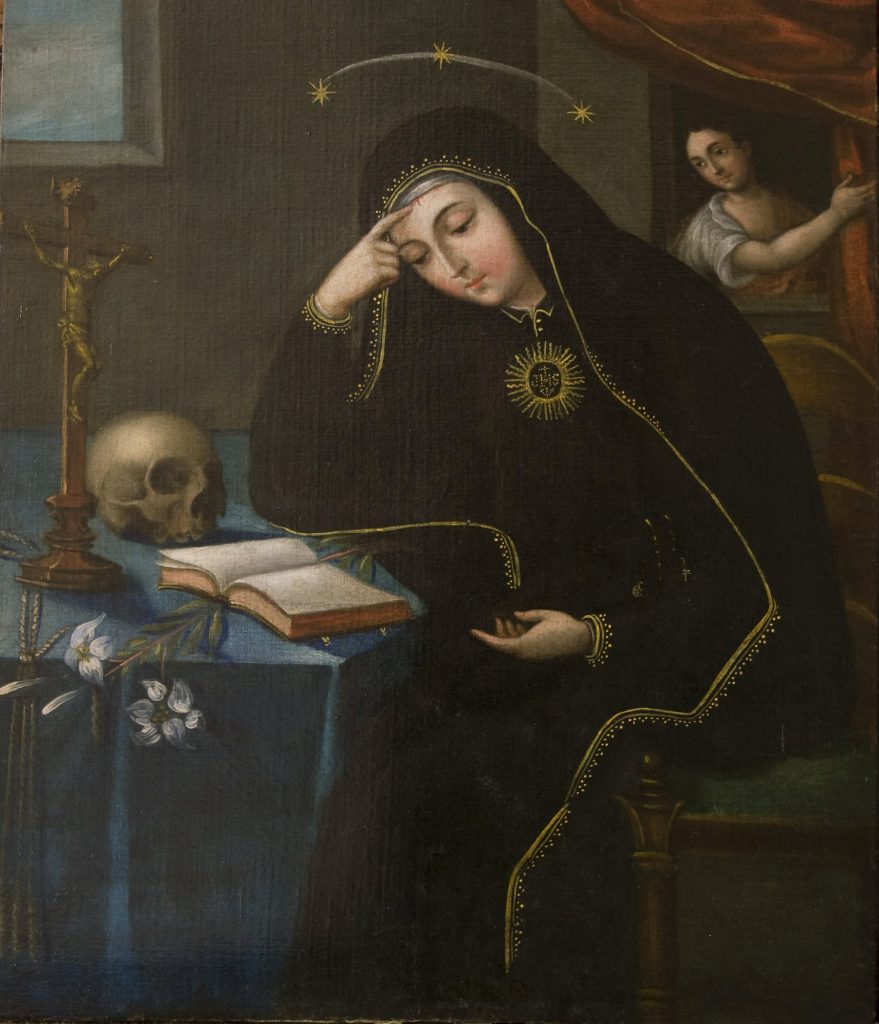
The story of Belgium’s holy woman Christina the Astonishing includes not only fantastical tales of self-destructiveness, but also her resurrection from death at the age of 21. Some listeners will be familiar with Christina from the song of that name by Nick Cave, from which we hear a clip. Christina’s ability to smell “the scent of human corruption,” we also learn, was shared by saints Joseph of Cupertino, Saint John of the Cross, and Gemma Galgani, to name a few.
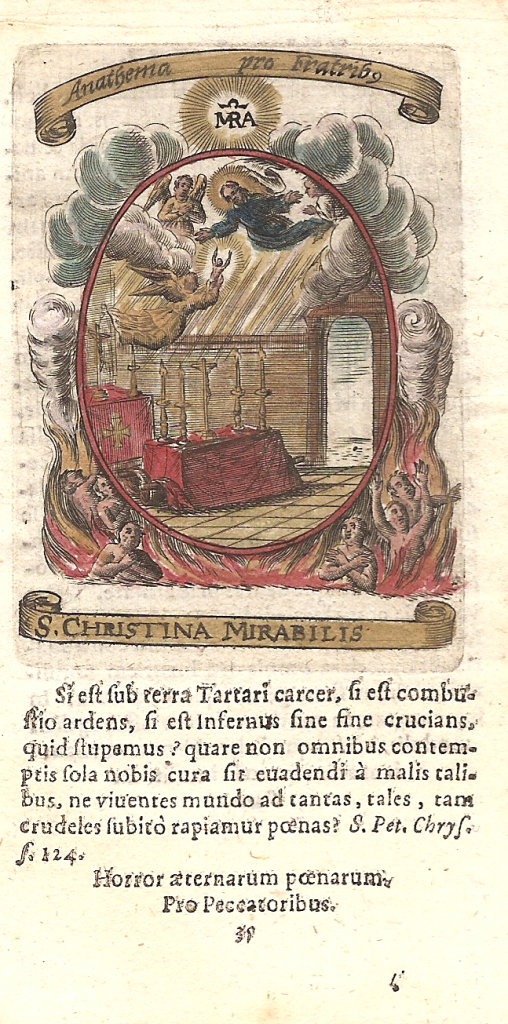
There is a complimentary concept to the smell of sin, namely the ” Odor of Sanctity” often said to waft from the body of a saint. In saint stories, this seems to be most often mentioned in contexts least likely to be associated with pleasant smells, that is, sickness, death, and long after death when the body should be at its most foul. We hear a particularly odd story in this regard from the hagiography of 14th-century Dutch Saint Lidwina.
Next up is the topic of saintly incorruptibility, or the unnatural preservation of a body after death. We learn a bit about what standards are here applied when it comes to cannonization and hear a few outstanding cases.
The capacity to occasionally move after death is also attributed to number of these mummified saints. We hear some rather unsettling stories illustrating this — St. Rita of Cascia and Mary Magdalene de’ Pazzi again, as well as the blessed Pietro of Gubbio, and an earthquake story involving the animated corpse of St. Eustochia of Messina, Italy.
The remainder of the show looks at stigmatics, those said to bear marks similar to the five “Holy Wounds” received by Christ in his Passion. We hear a creepy, old recording telling the tale of “Little Rose” Ferron, a 20th-century stigmatic from Rhode Island as well as some graphic first-hand accounts of visits with stigmatics Therese Neumann (Bavaria) and Maria Domenica Lazzari (South Tyrol). Some remarkable watercolors of Lazzari here.
We end or collection of ghastly saint stories with some particularly ghastly stories of holy people ingesting unholy things for the sake of holiness (St. Catherine of Genoa and St. Veronica Giuliani) as well as St. Catherine of Siena, who also provides a final anecdote as a sort of palette -cleanser.
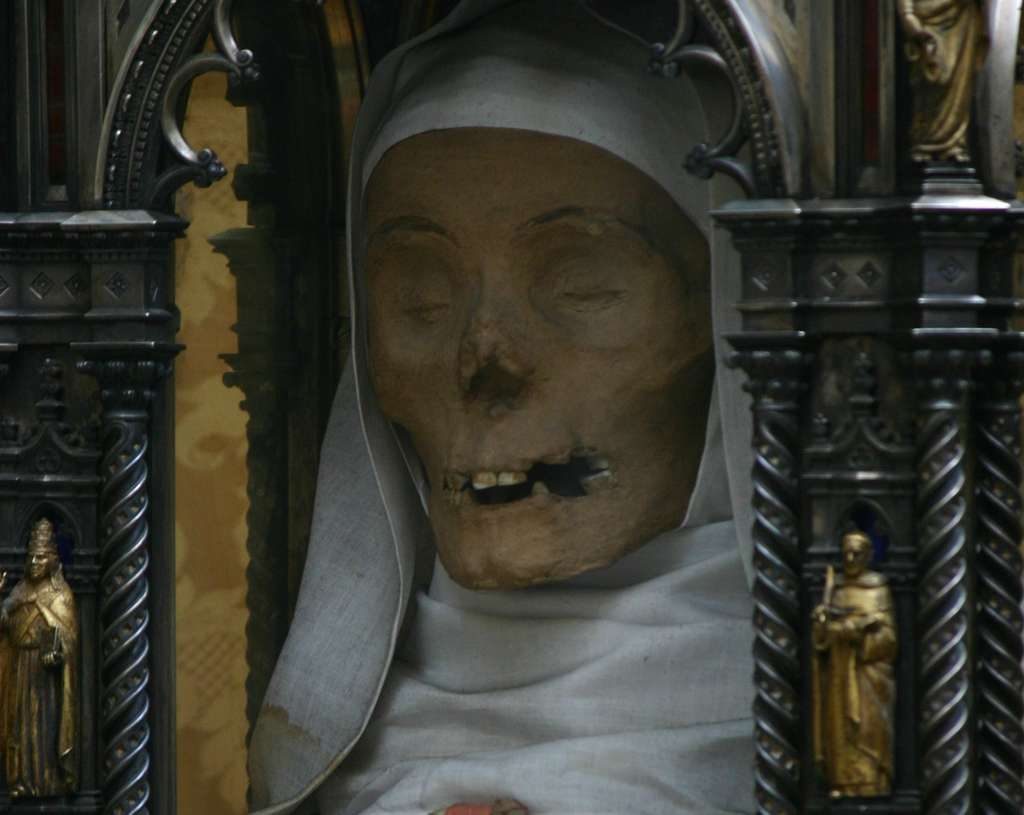
#22 The Devil’s Due: Musicians and Marksmen
In this episode we look at legends of musicians and marksmen said to have made Faustian deals with the Devil.
We begin with The Phantom of the Opera, a story which does not exactly share our theme, but was set against the backdrop of a staging of the opera Faust by Charles Gounod. The story, written in 19111 by French journalist and writer Gaston Leroux, also has a macabre connection to Der Freischütz (“the marksmen,” for our purposes), the German legend of a marksman who enlists the Devil’s help in a test of marksmanship. This particular connection is discussed at the conclusion of our show, but is one of several historical incidents said to have inspired Leroux’s novel. The establishment of a subterranean lake beneath the Paris opera house and an unfortunate accident with a chandelier in 1896 are discussed in this context.
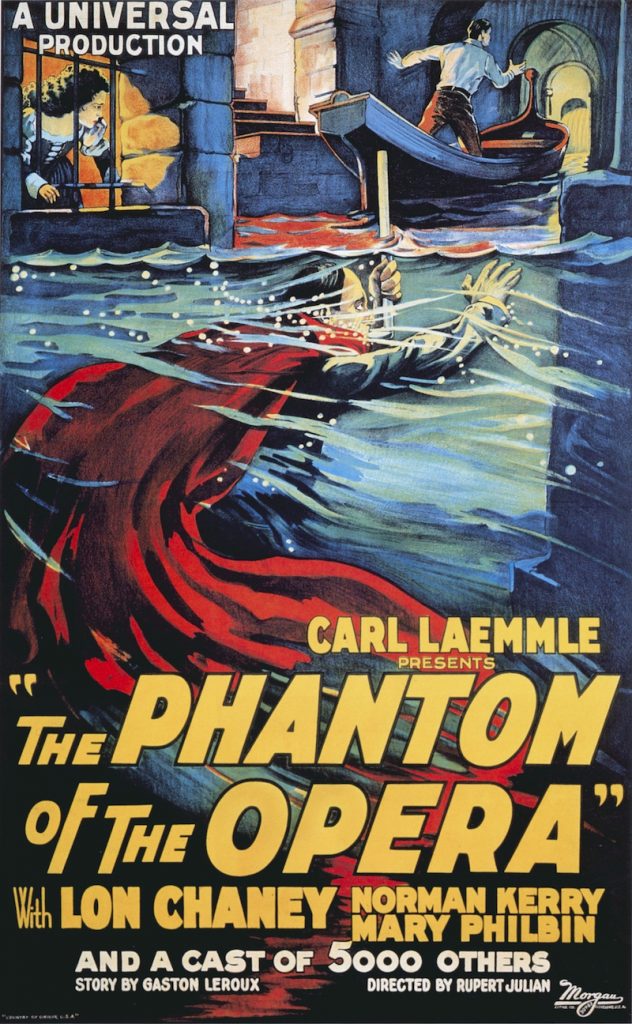
Next, we hear some clips from Brian DePalma’s 1974 rock-opera-horror-comedy Phantom of the Paradise, a retelling of the Phantom story within the setting of the fictional Paradise rock club. Conveniently enough, DePalma’s film inserts not one but two Faustian pacts with the Devil into its storyline and provides an intro to the topic of the trope of rock musicians making deals with the devil.
After a nod to the overt introduction of Satanic themes into rock-and-roll by the band Coven in their 1969 album Witchcraft Destroys Minds and Reaps Souls (discussed in our last episode), we flash through a few other examples of the trend in the 1960s to arrive at the legend of Robert Johnson’s alleged deal with the Devil at “the crossroads.”

This bit of folklore, which seems to have been spun out of traditional Vodoun and European notions of the magical significance of crossroads, did not attach itself to Robert Johnson until long after the musicians death, and was in fact, first attached to another blues musician by the name “Johnson” (Tommy) long after the death of the latter. We hear brief snatches of Robert Johnson’s songs “Cross Road Blues ” and “Me and the Devil Blues,” said to have inspired the connection of this legend to R. Johnson.
Because of lightweight portability making it ideal for providing music at taverns and secular gatherings, the violin was historically a favorite instrument of the Devil. Baroque composer Giuseppe Tartini reinforced the notion in his story of a dream in which the Devil had become his servant and provided him his Violin Sonata in G minor, better known as the “Devil’s Trill Sonata.” Wilkinson relates his account of the dream, and we hear a bit of the piece.
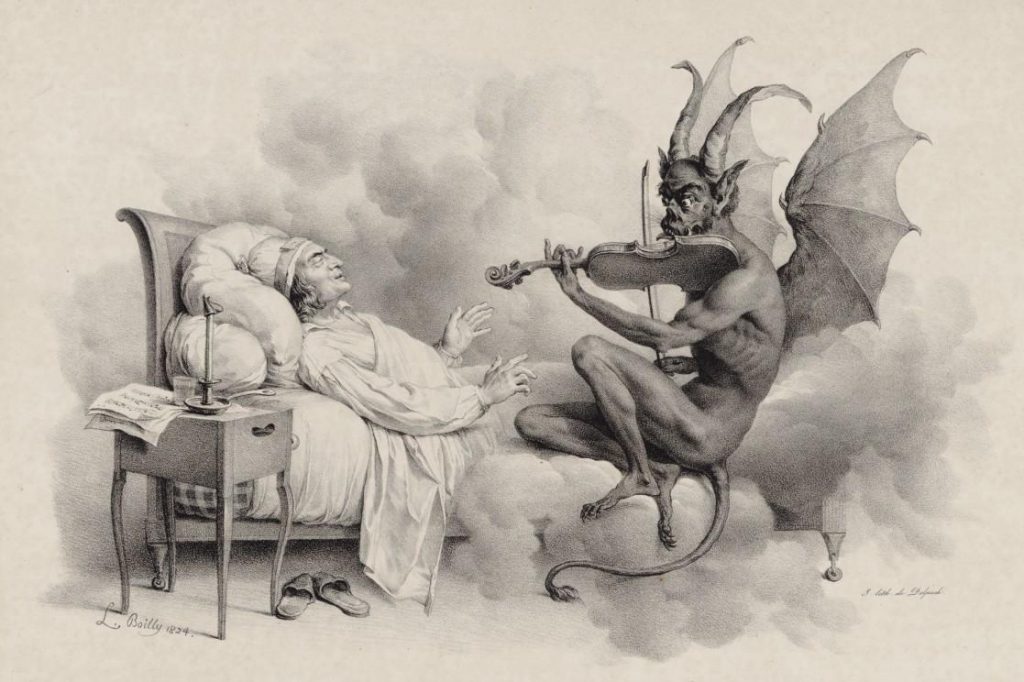
At least until the advent of rock and roll, the diabolical musician par excellence, however, was violinist and composer Niccolò Paganini (1782 – 1840). Rumors that dogged his career included that of a pact with the Devil, the manifestation of the Devil onstage during his performances, lightning bolts flying from his bow, and that the soul of a women he murdered resided within the strings of his instrument.
Paganini’s diabolical mystique owed much to his unprecedented virtuosity and theatricality on stage, libertine lifestyle, and unusual appearance, which German poet Heinrich Heine described “a corpse risen from the grave, a vampire with a violin.” As for his libertine lifestyle, we hear a bit from a film particularly dwelling on this — Klaus Kinski’s Paganini (1990) directed by and starring the notorious German actor, whose identification with the role appears to have been somewhat pathological.
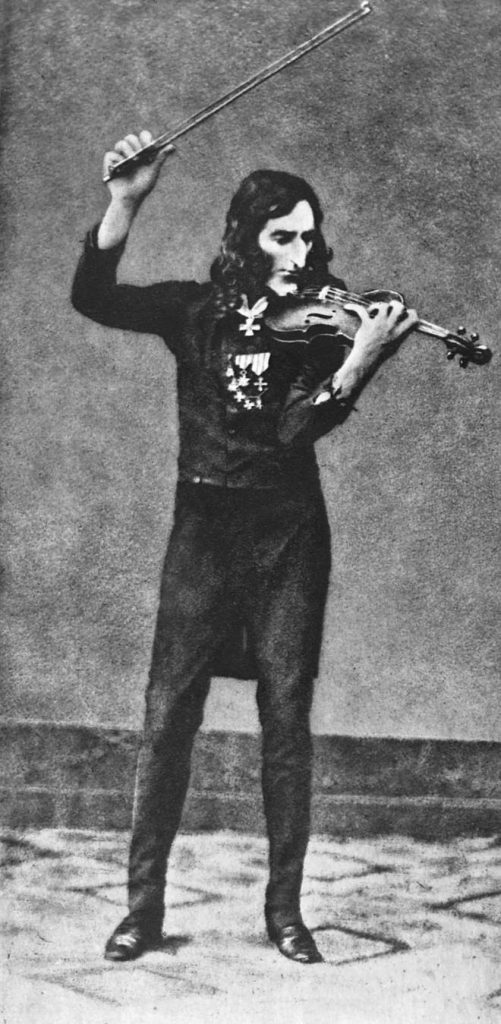
The macabre postmortem odyssey of Paganini’s body after being denied burial in consecrated ground by the bishop of Nice is discussed at some length. In the background of our Paganini segment, we hear a bit of his Caprice No. 5 played by Sumina Studer.
We then turn to the Freischütz, the German legend of of the Devil providing a huntsmen a number of magic bullets, the majority which are charmed to hit whatever the shooter wishes, while a small fraction remain exclusively under the Devil’s control. While it’s mostly known in its literary or operatic form, I provide some evidence of the story as a matter of actual folk belief, namely a confession made in a Bohemian court by an ambitious hunter charged with visiting the crossroads(!) where he attempted the ritual to create these charmed bullets in 1710.
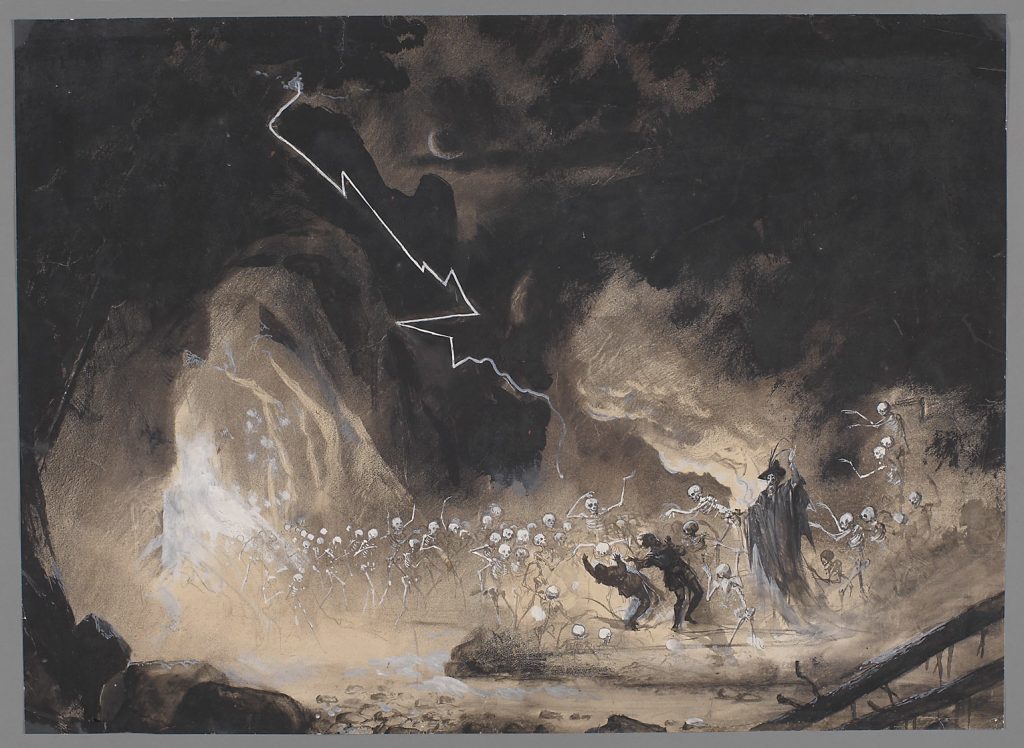
With the aid of Wilkinson’s dramatic reading, we retell the literary version of the tale from Johann Apel’s 1811 collection of (mainly) traditional ghost and horror stories called The Book of Ghosts. An interesting connection between this volume and Mary Shelley’s Frankenstein is also discussed.
Next we discuss Der Freischütz, an 1821 opera by German Romantic Carl Maria von Weber. It’s a bit cheerier take on the story than Apel’s but does include a sublimely gothic scene in which the magic bullets are cast. We hear a bit about the staging of that scene (moved from the crossroads to a haunted gorge, “Wolf’s Glen”). Behind that description, we hear a chorus of “owls” from the that scene in von Weber’s opera. Our Freischütz discussion also opens with a bit of the overture.
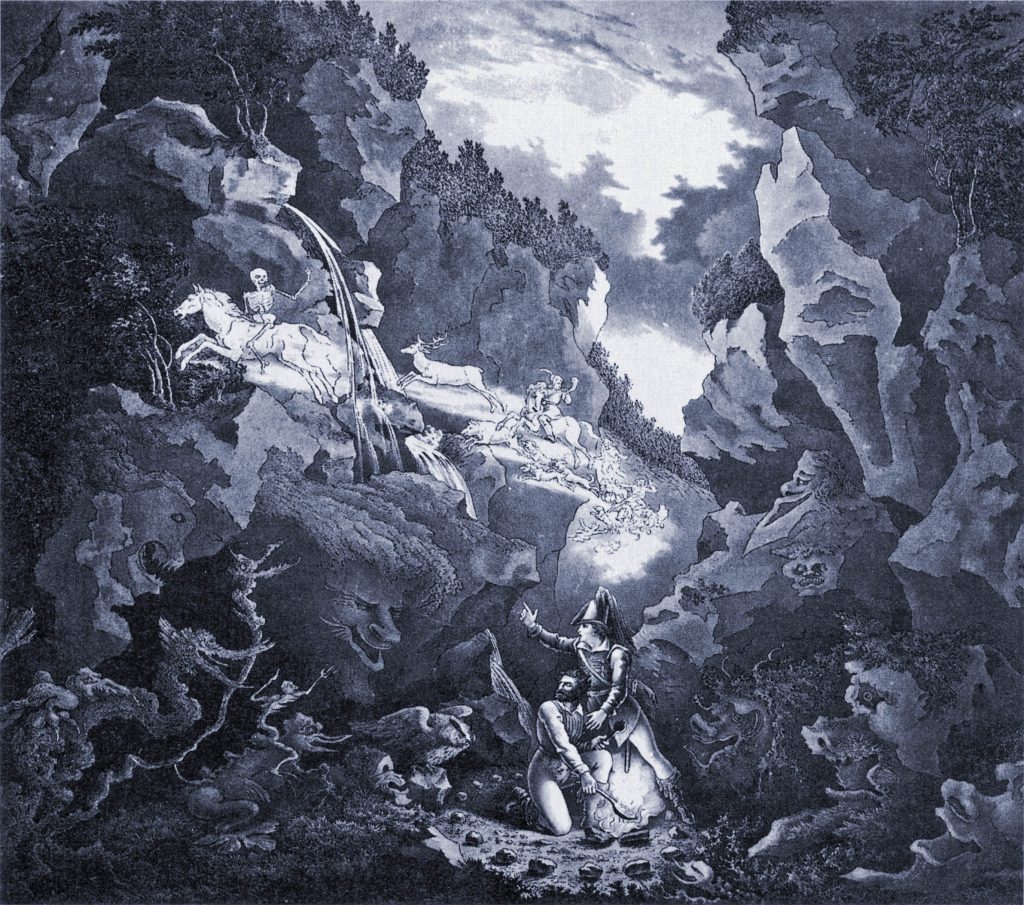
We also hear some bits from the 1990 avant-garde retelling of the Freischütz legend by Tom Waits and William Burroughs — The Black Rider.
The episode ends with the story of how a human skeleton ended up onstage in an 1841 production of Der Freischütz. It’s a tragic tale of an unhappy romance that likely inspired Gaston Leroux to have his Phantom buried beneath the opera house in order to be near to his beloved Christine Daaé after death.
#21 A Deal with the Devil
The legend of Faust is the archetypal deal with the Devil. This episode looks at the figure as represented in folklore, local legends, plays, puppet shows, literature, films, and opera.
A precedent for the tale seems to be the story of St. Theophilus, a cleric in 6th-century Adana (in modern Turkey) who, as legends have it, summoned the Devil to help elevate him to the status of bishop (and, yes, there is some repentence involved in this one, seeing as how he went down in Church history as a saint). He is the subject of a 13th-century French play, The Miracle of Theophilus, which happens to be the source of a chant to summon Lucifer written in an unknown language — one, which made its way into Wiccan traditions via Gerald Gardner, and which even ended up in the lyrics of the 1969 album Witchcraft Destroys Minds & Reaps Souls by the band Coven. The segment starts with a snippet from this cult album.
There does seem to have been an actual magician, astrologer, or alchemist by the name of Faust wandering southern Germany in the late 15th and early 16th century, though very little is known of his life other than passing references in a few letters and some town records noting that individuals by this who were banned for fraudulent or roguish activities. We look at a few of these historic references.
Legends regarding the figure are more plentiful. We hear of a number of supposedly dangerous grimoires attributed to Faust said to be kept at sites in Germany and also discuss a number of legendary feats of magic (including conjuring an entire castle along with a sumptuous, if unsatisfying, banquet for castle guests). We also have a look at a number of towns offering “evidence” that they were the site where the Devil came to claim the doctor, including one town that rents a room in an ancient inn where the grim event was said to have transpired.
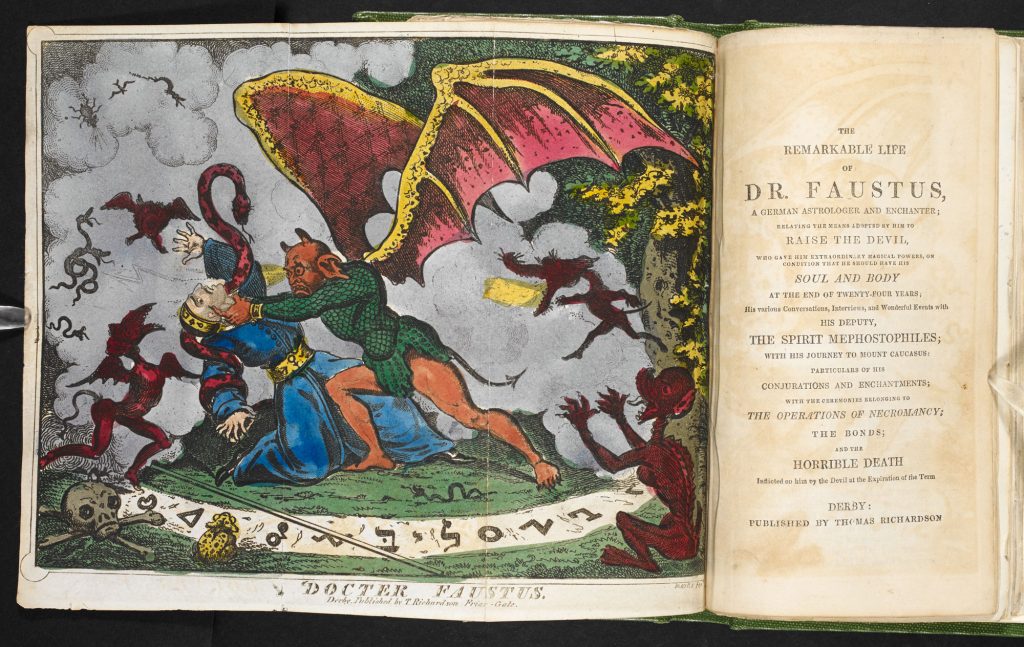
The meat of our show is a look at the earliest written narrative on Faust, a chapbook published anonymously in Frankfurt in 1587, The History of Doctor Johann Faustus. We hear a dramatic, even cinematic, passage describing Faust’s summoning of the Devil in Germany’s Spessart forest (an area rich in folklore and home to the Brother’s Grimm). Also related are Faust’s whirlwind tour of of Hell, a number of comic supernatural pranks he plays, and, of course, the dramatic hour of reckoning and its grisly aftermath.
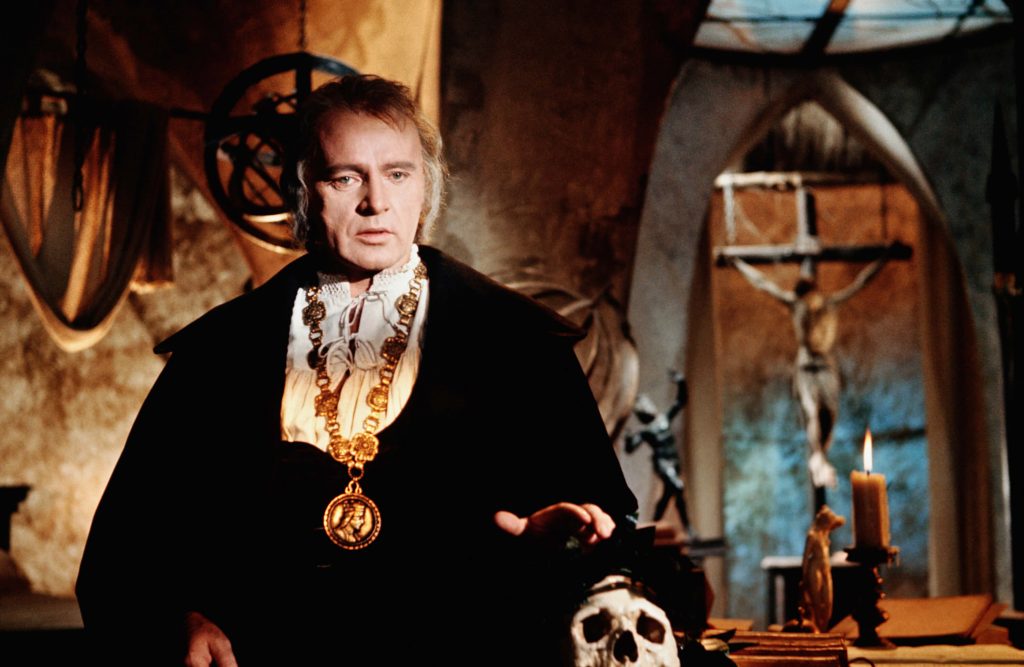
We next hear some snippets from one of the legend’s most prominent film treatments, the 1967 Richard Burton-Elizabeth Taylor vehicle Doctor Faustus. Though the subject of numerous negative reviews, the film may appeal to horror fans thanks to its visual styling similar to a Hammer film of the period. The wonderful 1926 German silent, Faust, by F.W. Murnau (director of Nosferatu) is also mentioned.
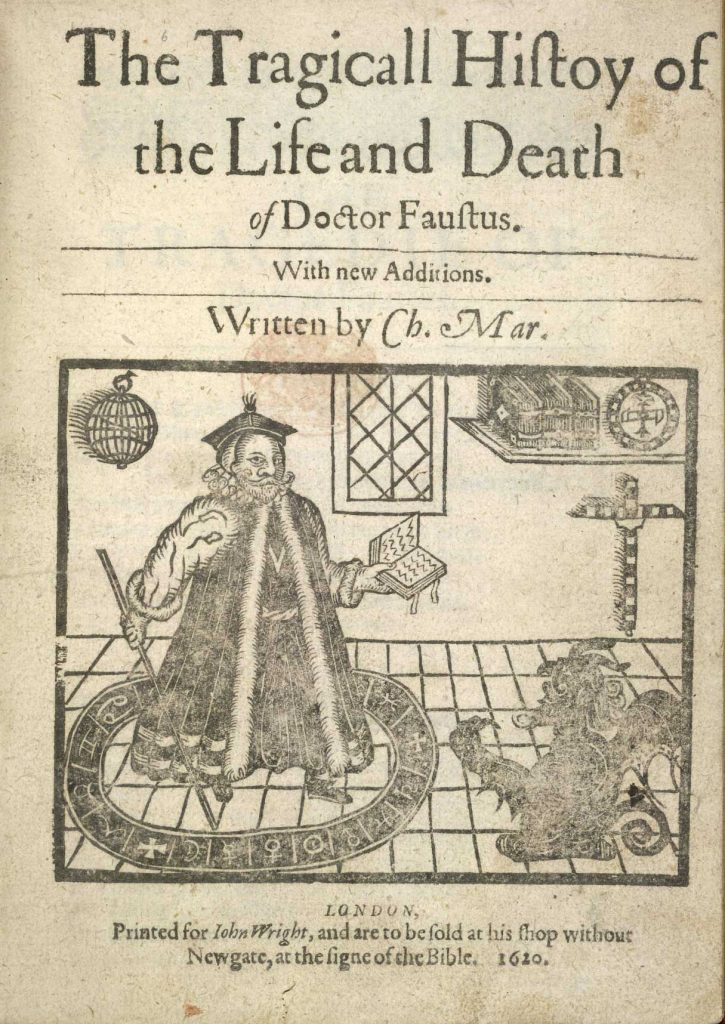
The script for Richard Burton’s film was the classic of Elizabethan stage,The Tragical History of the Life and Death of Doctor Faustus by Christopher Marlowe. Though the story presented by Marlowe is rather similar to the chapbook version previously discussed, we hear of a few comic additions made then jump forward a bit in theater history to William Mountfort’s pointedly comic 1697 work, The Life and Death of Dr Faustus, Made into a Farce, with Harlequin and Scaramouche. Wilkinson shares some monologues from the play spoken by two of the Seven Deadly Sins. We also have a look at the legend’s treatment in Faust puppet shows popular in Germany and Bohemia, a tradition that proved influential on the 1994 Czech film, Faust, Jan Švankmajer’s must-watch stop-motion/live-action treatment of the story. We hear bits of the audio from the Švankmajer film as well as a couple more Faust films, the Peter Cooke-Dudley Moore comedy Bedazzled (1967) and the nicely dreadful 2000 horror-superhero film, Faust: Love of the Damned.
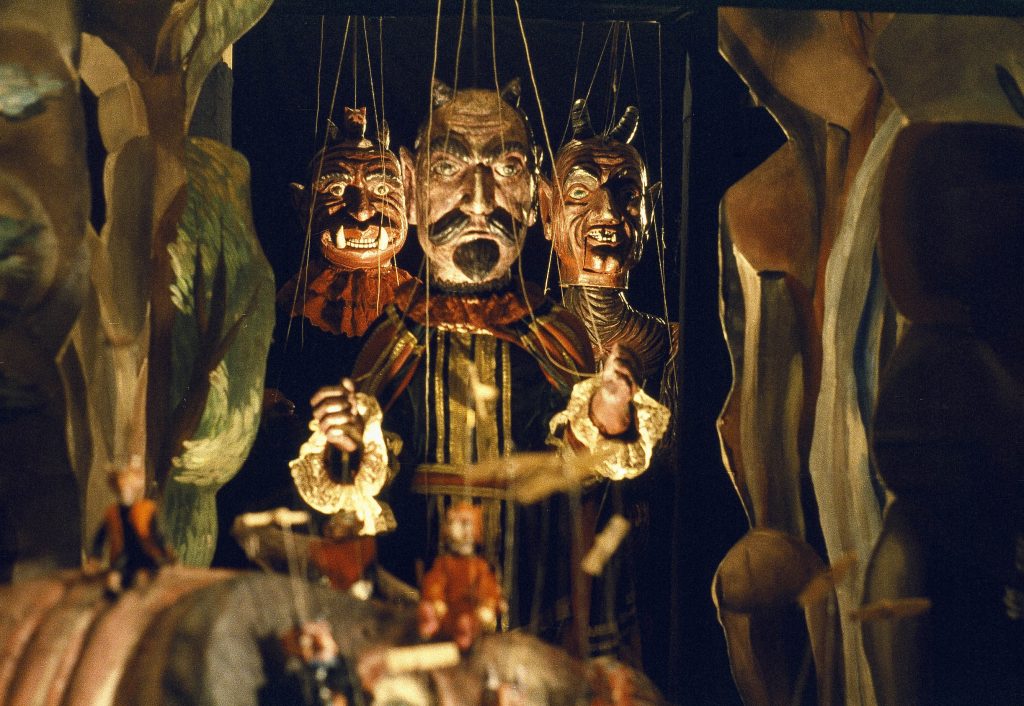
The show closes with a look at Faust at the opera, namely Hector Berlioz’ 1846 work,The Damnation of Faust (with a nod to Charles Gounod’s operatic take on the tale). In particular we look at a famously disastrous staging of the Berlioz work by the Paris National Opera in 2015.
#20 The Undead Come Courting
Vampire mythology first appears in the West in works as early Romantic authors meld themes from folk ballads of resurrected lovers with Balkan folklore of the undead.
Valentine’s Day seemed a fitting occasion for this show’s look at the vampire’s tragically romantic tendency to prey upon those they love.
We begin with a (very seasonal) snippet of one of Ophelia’s “mad songs” from Hamlet, “Tomorrow is St. Valentine’s Day.” The song speaks of a lover’s clandestine nocturnal visit to a partner’s bedchamber. It represents a class of folk song called “night visit ballads.” A more ghoulish subset of these deals with lovers who happen to be dead, or undead actually.
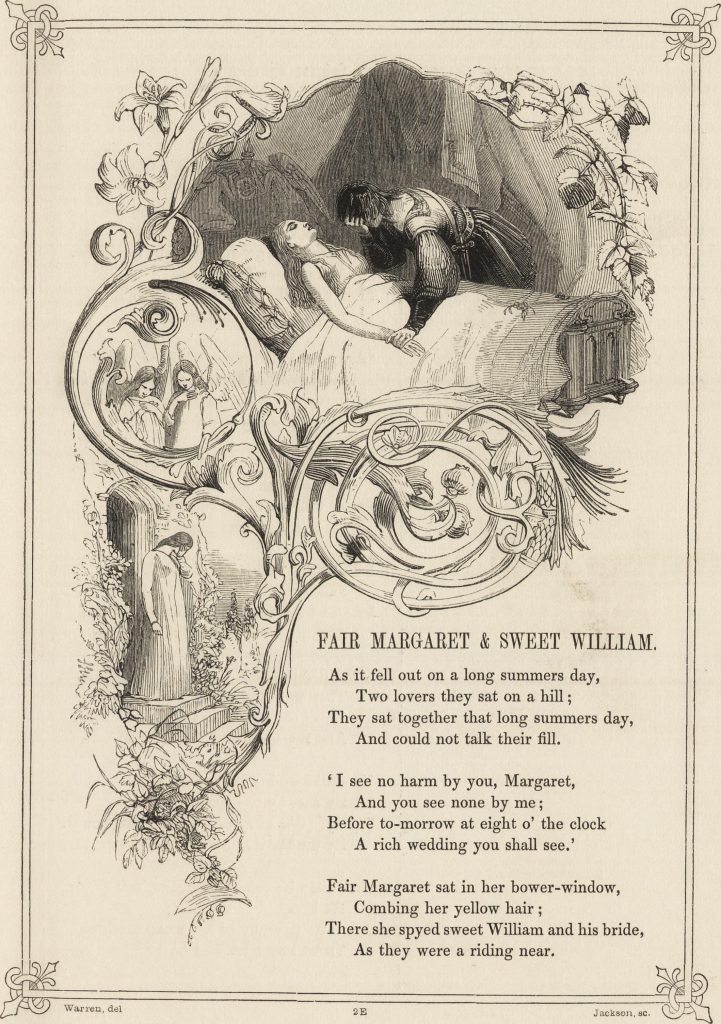
We hear two sample songs of revenant lovers from the 16th-17th century: “Fair Margaret and Sweet William” (referencing “cold corpsey lips”) and “The Suffolk Miracle,” which bears comparison to the German poem “Lenore,” much beloved by the Romantics and Gothics, and mentioned in Dracula as discussed in Episode One.
Next we discuss the “Vampire Panic” that took place in Serbia in the 1720s-30s. We hear of Petar Blagojević, who was said to have been exhumed and found incorrupt with fresh blood at his mouth and flowing from his heart once properly staked. We hear of a similar case involving the foot soldier Arnold Paole, whose staking produced more disturbing results and whose alleged vampiric deeds led to two distinct waves of panic.
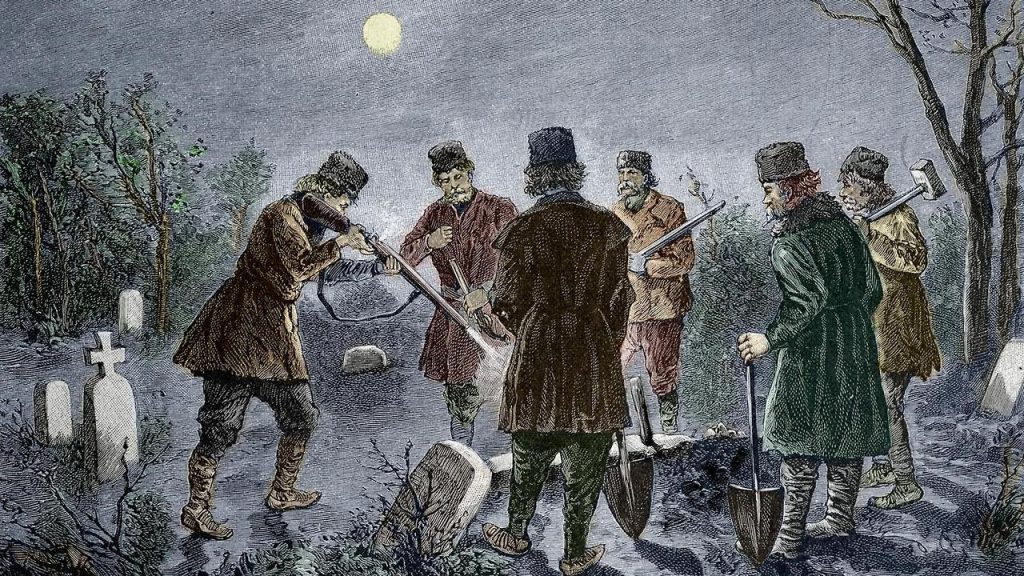
We learn how these reports were assimilated by the literary world, with an early example being German poet Heinrich August Ossenfelder’s 1734 poem “Der Vampir.” Then we look at a more nuanced suggestion of vampirism in Goethe’s “The Bride of Corinth,” a poem based on a classical account of revenant lovemaking, the story of Machates and the undead Philinnion.
Next we have a look at two other important early uses of the vampire motif in literature — two Orientalist poems — Thalaba by Robert Southey and Lord Byron’s The Giaour. Both reference Balkan folklore and superstition, and footnotes to Southey’s work include a lengthy narrative of an absurd and gruesome vampire panic on the Greek island of Mykonos in 1701. Wilkinson reads prettily from this account. Along the way, we have a look at Greek vampires in Val Lewton’s moody 1945 film Isle of the Dead starring Boris Karloff.
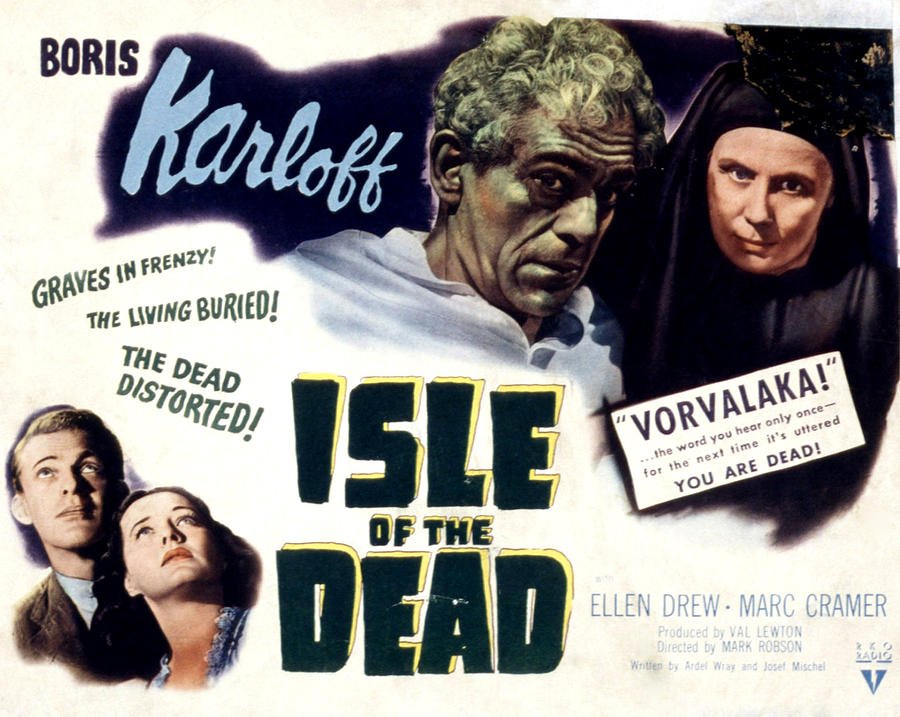 Byron’s contribution to Gothic literature (as host to Mary Shelley during her early writing of Frankenstein) is illustrated with another snippet from Ken Russel’s cinematic work, his 1986 film Gothic. More central to our theme, however, is The Vamyre by John Polidori, Byron’s personal physician who also shared in the evenings of ghost stories that inspired Shelley.
Byron’s contribution to Gothic literature (as host to Mary Shelley during her early writing of Frankenstein) is illustrated with another snippet from Ken Russel’s cinematic work, his 1986 film Gothic. More central to our theme, however, is The Vamyre by John Polidori, Byron’s personal physician who also shared in the evenings of ghost stories that inspired Shelley.
We learn how The Vampyre grew out of Byron’s The Giaour, of the influence its vampiric character exerted on Stoker’s Dracula, and of the unlikely spin-offs the story generated.
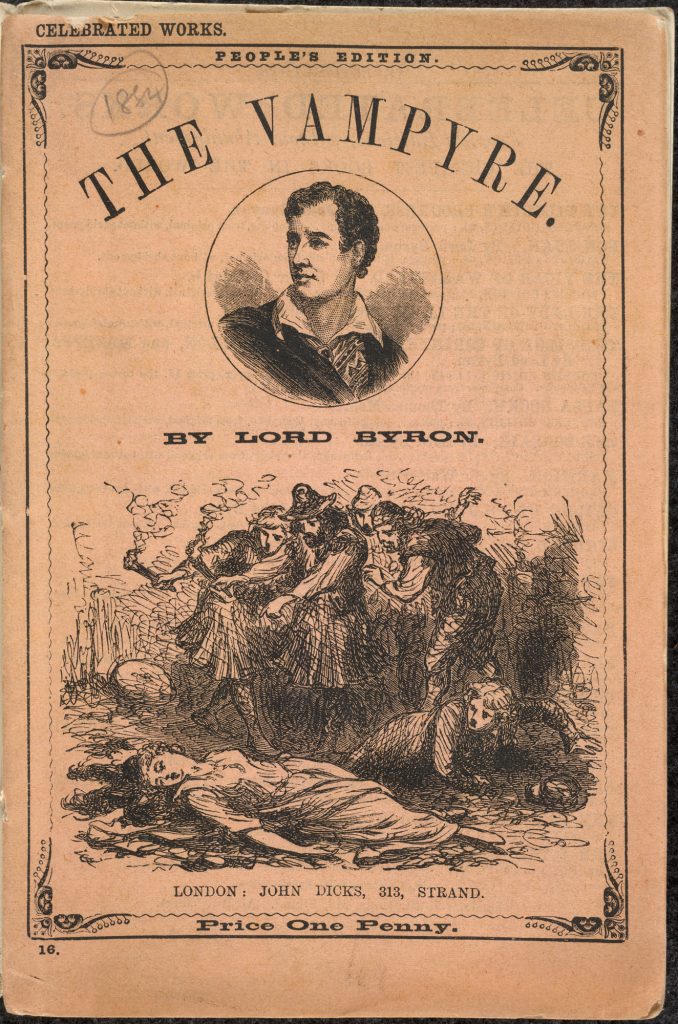
Then we have a look at Tolstoy’s lesset known 1839 vampire novella The Family of the Vourdalak and its treatment in Mario Bava’s 1963 horror anthology Black Sabbath, also featuring Boris Karloff.
Tolstoy’s story also happens to be set in Serbia, bringing us back to the country’s long history of vampirism, the famous Serbian Vampire Sava Savanović, and the bizaare 1973 Yugoslavian film featuring Savanović, Leptirica.
We close with a strange story of the the Serbian undead from the year 2012. A musical setting is provided.
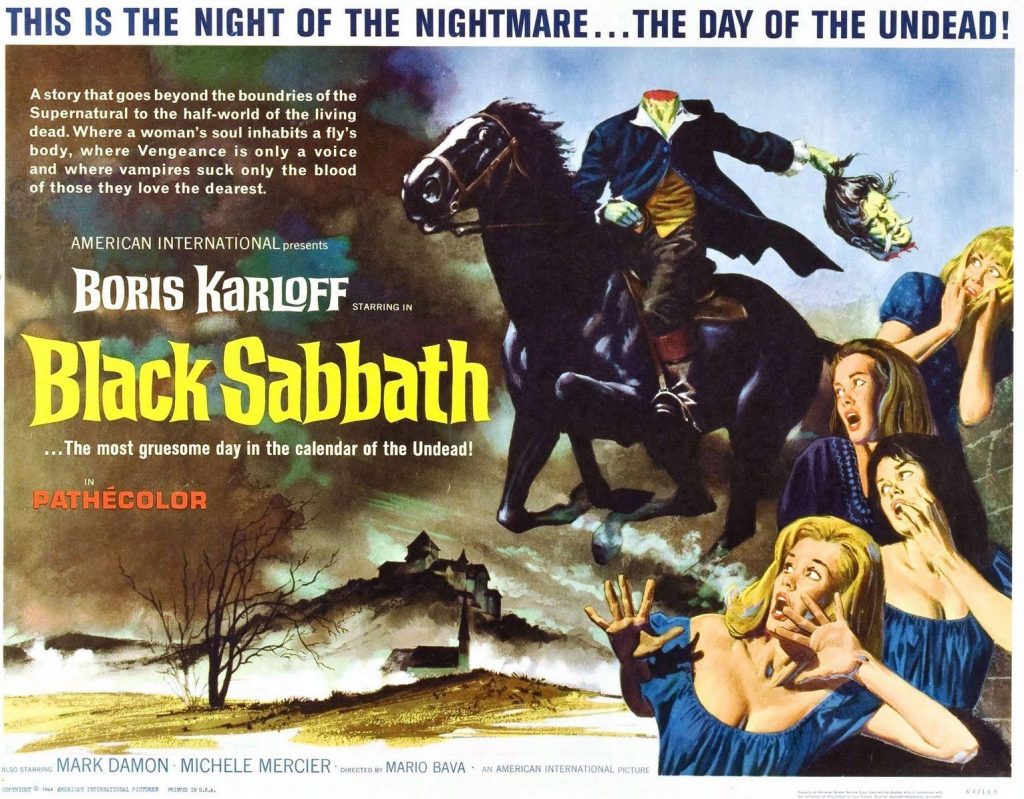
#19 Worm Songs and Beastly Sucklers
This episode examines the Lambton Worm, a dragon legend that inspired works by Bram Stoker and Ken Russel as well as well as the curious role of milk plays that story and in superstitions surrounding witchcraft.
The show begins with Wilkinson and Ridenour reviewing a phone message from Blake Smith of the Monster Talk podcast, then proceed to briefly examine the 1989 Ken Russel Film The Lair of the White Worm, mentioning along the way his other film Gothic, which would be of interest to listeners.
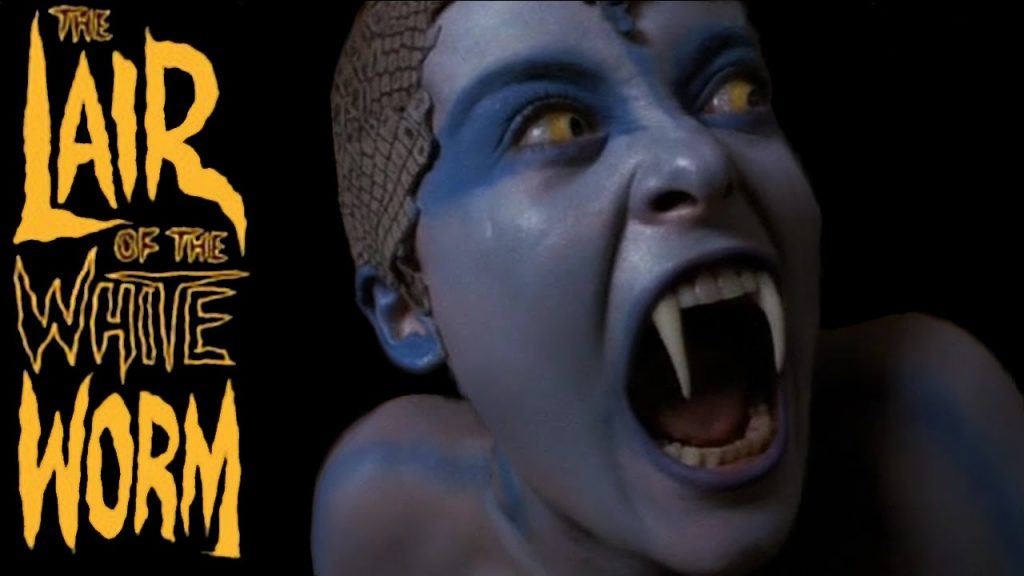
Bram Stoker’s final novel The Lair of the White Worm, upon which the Russel film is loosely based, is sadly far from his best work, written late in his life during a time of ill health. The story revolves around an aristocrat, Lady Arabella March, suspected of harboring an ancient, monstrous creature within a well hidden on her estate. While the novel is a bit of a muddle, it does contain some intriguing descriptive passages that Wilkinson reads for us.
A snippet of a song from Russel’s film, presented as a folk song telling the story of the local worm legend is played and revealed to be a slightly revised version of an actual 1867 ballad about the Lambton Worm of Northeast England. The legend tells how John Lambton of Lambton Hall hooked a weird and highly inedible creature while fishing, discards the beast, and lives to regret it. Without giving too much away, the story also involves a bloody battle with a dragon, a witch, a curse, and a lot of milk.
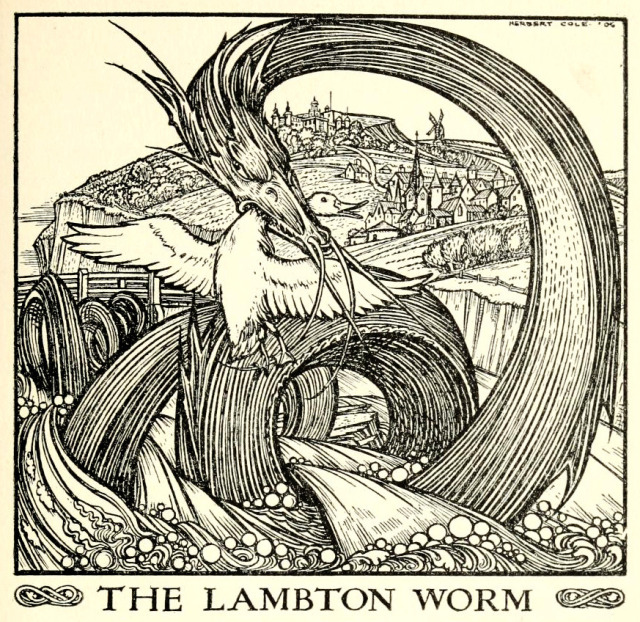
The legend and song (which is written in the local Sunderland dialect) have become part of the identity of residents of County Durham and towns along the river Wear. In 2014, an entertaining symphonic retelling of the legend was presented in Durham Cathedral by The Durham University Brass Band, and we use a clip or two in the show. Most other clips are from one of two folk-play-style pub performances of the story by The Jeffreys and Hexham Morris.
We also look at a connection between the 1973 folk-horror classic The Wicker Man and the Lambton Worm legend.
The peculiar fondness of dragons for milk is next examined, beginning with a number of other dragon legends from England, some medieval tales briefly mentioned, and even an American newspaper from the 1930s.
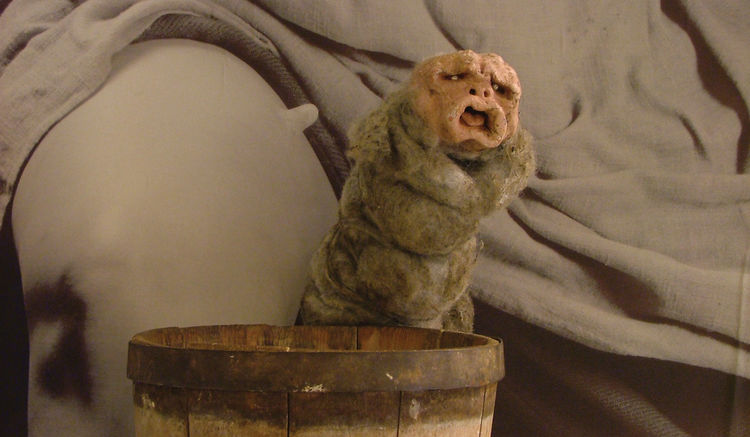
We then turn our attention to the “beastly sucklers” of the title. These include various animals into which witches transformed themselves or created in order to steal milk (sucking it from livestock by night). They are mlk-hares, the troll-cat, the troll-ball, and the Icelandic tilberi.
The show ends with a quick look at a couple other dragon ballads that also include witches, including the particularly strange “The Laily Worm and the Machrel of the Sea” in which a king’s daughter is transformed into a mackerel then obstinately refuses to be transformed back.
#18 Wild Men, Furry Saints, and Burning Dancers
This time round we look at the medieval myth of the Wild Man, its connection to seasonal folk traditions, peculiar influence on Church teachings, and a macabre historical incident featuring dancers costumed as Wild Men.
We begin with a bit of Edgar Allen Poe filtered through Roger Corman, namely a clip from the director’s 1964 production The Masque of the Red Death. In the film, Corman incorporates a grisly scene borrowed from Poe’s short story “Hop Frog,” an accident revolving around highly inflammable ape costumes.
We then turn to Poe’s historical inspiration for this scene, namely a 1393 celebration held in the Parisian court of Charles VI, a masque which has come to be known as Bal des Sauvages (Ball of the Wild Men) or more commonly the Bal des Ardents (Ball of the Burning Men). As you may guess, the Wild Man suits donned for this event also proved quite flammable, leaving four courtiers dead. Graphic details are provided. While Charles also wore one of these less than safe costumes, he was not injured in the event but went on to suffer from troubles of a different sort, as we later explore.
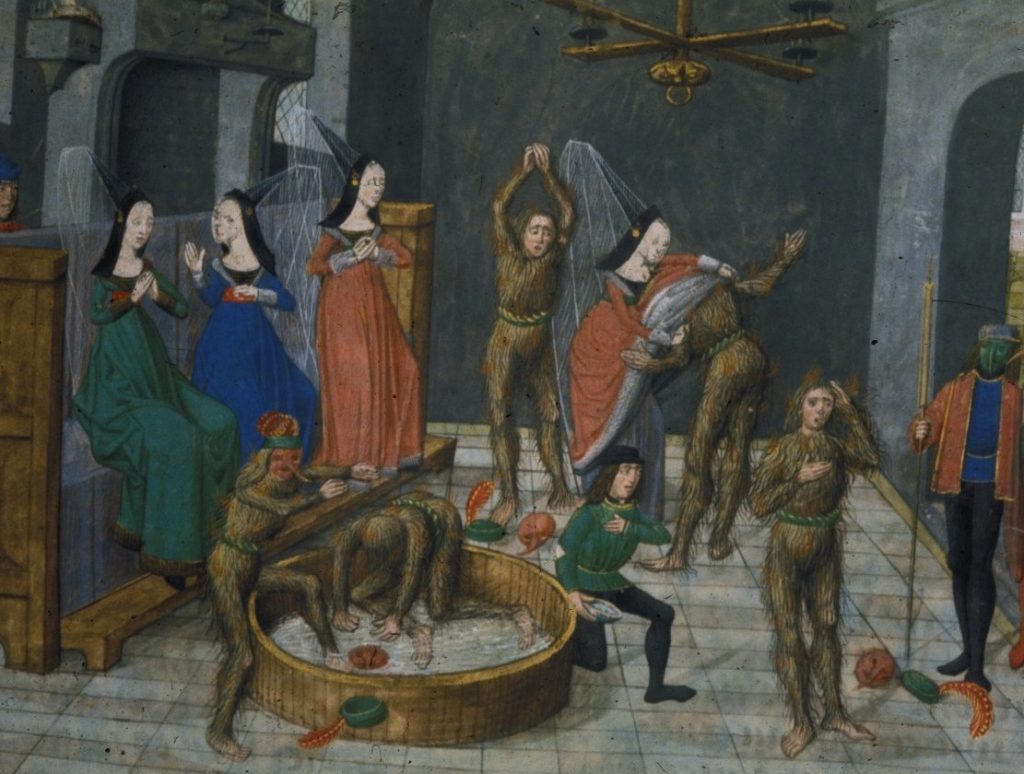
Other costume customs associated with the Wild Man are next examined — a strange case from James Frazer’s The Golden Bough (involving a blood bladder), and mention is made of Wild Man costumes of straw or vegetation often identified as “straw bears,” as in the Straw Bear Festival of Whittlesea, in the UK, or other vegetation clad Wild Men who appear in Carnival processions in Basel, Switzerland, Telfs, Austria, and the Wild Man Dance held every five years in Oberstdorf, Bavaria. Audio clips from the events in Whittlesea, and Telfs are heard in the background.
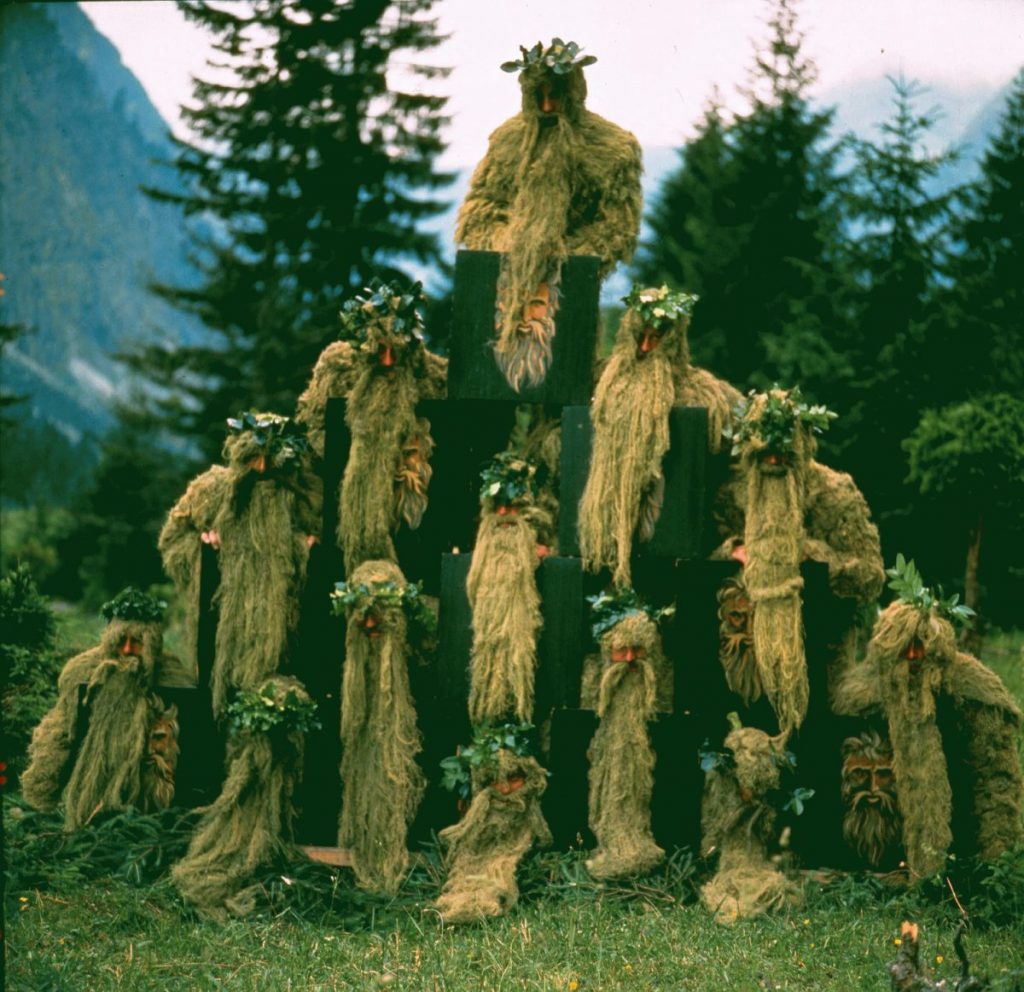
Classical figures that blended into the Wild Man mythos are discussed: the satyrs, fauns, and particularly Silvanus, as are other pagan figures that tended to overlap with the Wild Man — the Dusios of the Celts of Gaul, the schrat of German-speaking lands, and the ogre, a figure seemed particularly influential in French and Italian traditions.
While pagan versions of Wild Men were regarded by the Church as demonic, the image of the Wild Man was in some occasions adopted into saint iconography. We see a number of examples drawn from the era of the Desert Fathers, when solitary hermitage in the wild was commonly understood to be a path to God. Medieval artists, we learn, tended to take the “wild” aspect of these figures, rather literally, and certain church legends seem to support this.
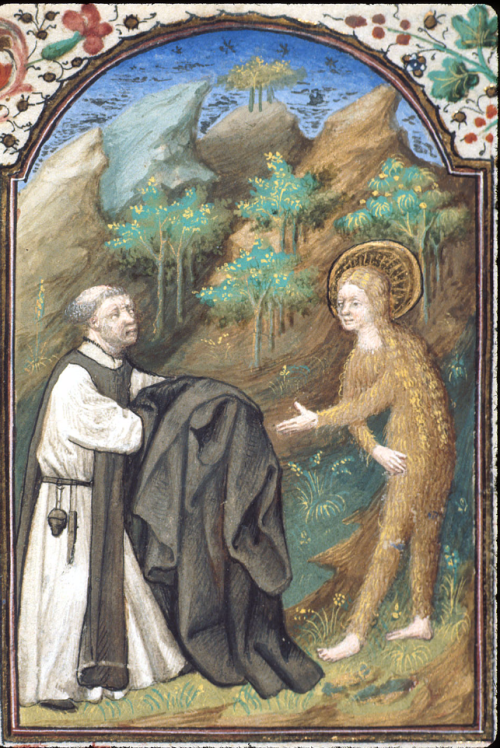
Real world figures equated with the Wild Man are also examined. We meet the first historical example via a painting of the 16th-century figure, Petrus Gonsalvus, an object in the famous Wunderkammer (“cabinet of curiosities”) collection at Ambras Castle in Innsbruck, Austria. Other items in the collection, including a disturbing portraits of a deformed court jester and of a Hungarian nobleman living with lance embedded in his head are mentioned, as is an odd pop song related to one of P.T. Barnum’s sideshow personalities, Jo-Jo the Dog-faced Boy. A clip from Jean Cocteau’s 1946 adaptation of “Beauty and the Beast” is heard.
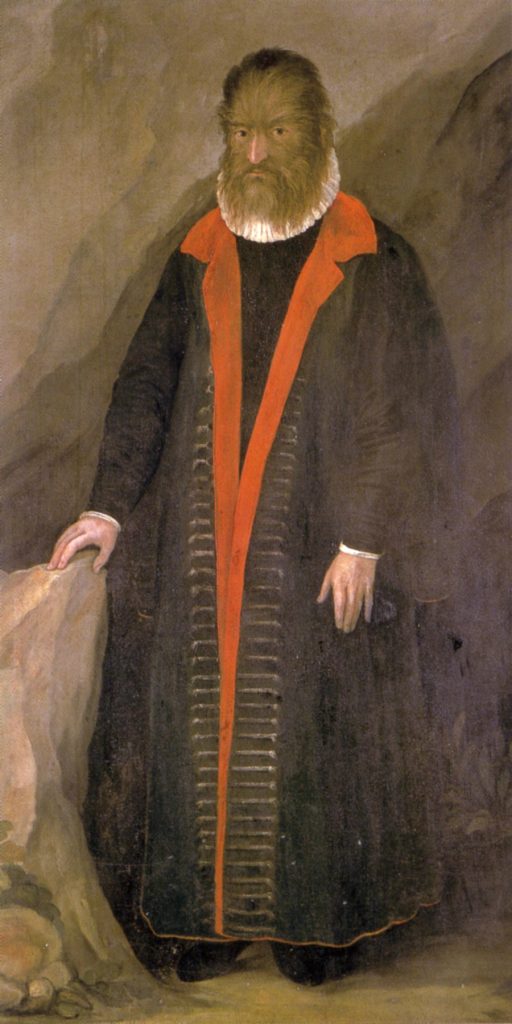
Oh, I also promised to post this picture of Barbara van Beck…
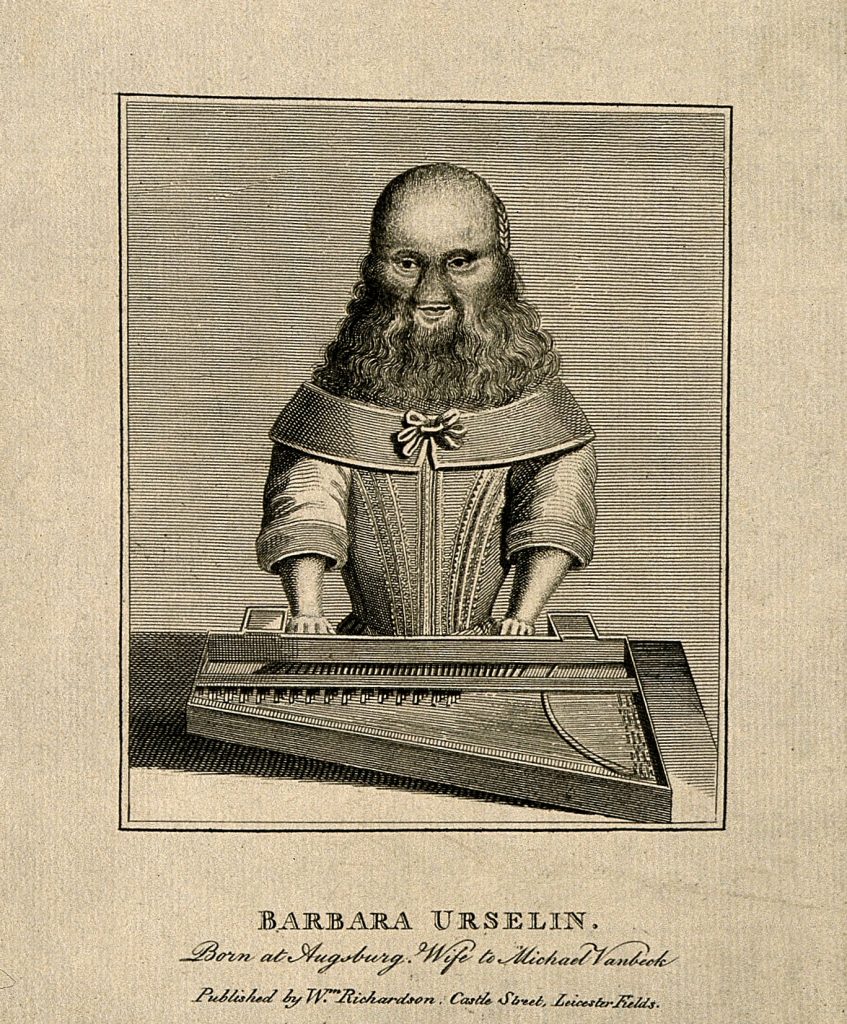
We conclude the show returning our attention to France’s Charles VI, hearing the story of his mental breakdown and behaviors and delusions that earned him the epitaph, “Charles the Mad.”
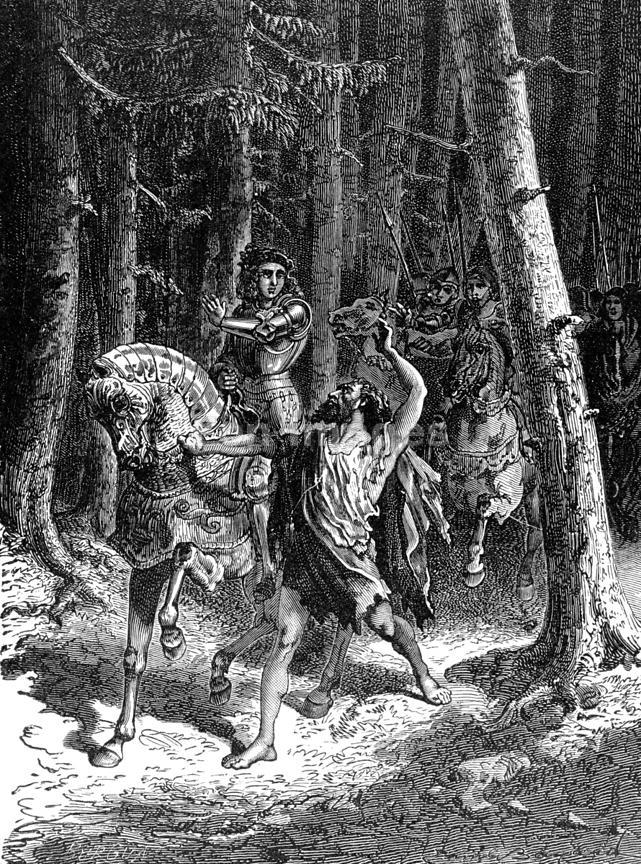
#17 Christmas Ghosts
Traditionally Christmas was a time for ghost stories, and tonight we’re doing our part to bring back the custom. A bit of history on supernatural stories of the season and then something a bit different for the holiday — a bit of storytelling for your fireside enjoyment — a ghost story from the Victorian master of the genre, M.R. James. An unfortunate holiday incident experienced by Wilkinson and your narrator is also discussed. Merry Christmas to you all! (This episode also provides an example of one of our Patreon rewards: audio texts from classic old books of horror and folklore delivered over a brooding soundscape.)
#16 The Haunted Season
Historically, Christmastime in Central Europe was a season haunted by otherworldly spirits, werewolves, ghostly huntsmen, and wandering hordes of lost souls. This is particularly the case in the Krampus’ homeland of German-speaking Central Europe.
We open with a survey of the various frightful spirits said to be afoot this time of year. Bavaria, particularly the Bavarian Forest turn out to be particularly rich in such things, menaced by everything from spirits of the forests (Schratzn) and marshes to entities said to reside in mills, and historic castles. Historical figures with unsavory reputations including the legendary cowherd Woidhaus-Mich, Chatelaine Maria Freiin of Castle Rammelsberg and the Bavarian outsider prophet Mühlhiasl of Apoig are said to return as evil spirits this time of year. We hear a brief clip from Werner Herzog’s 1976 production, Heart of Glass, a lovely and peculiar treatment of Mühlhiasl’s story.
Just as the Krampus appears as an evil counterpart to St. Nicholas on his feast day (and its eve), we encounter other frightful creatures from German culture said to represent similarly sinister incarnations of other saints celebrated in December. From the Upper Allgäu region of the Bavarian Alps, there are the moss-encrusted Bärbele (“Barbaras”), or sometimes “Wild Barbaras,” and throughout Bavaria and Austria, St. Lucy was also inverted on her day (Dec. 13) as the “Luz,” or “ugly Lucy,” an entity particularly hungry for blood and ghastly punishments. We also meet “Bloody Thomas,” a figure appearing on the eve or night of St. Thomas Day, December 21.
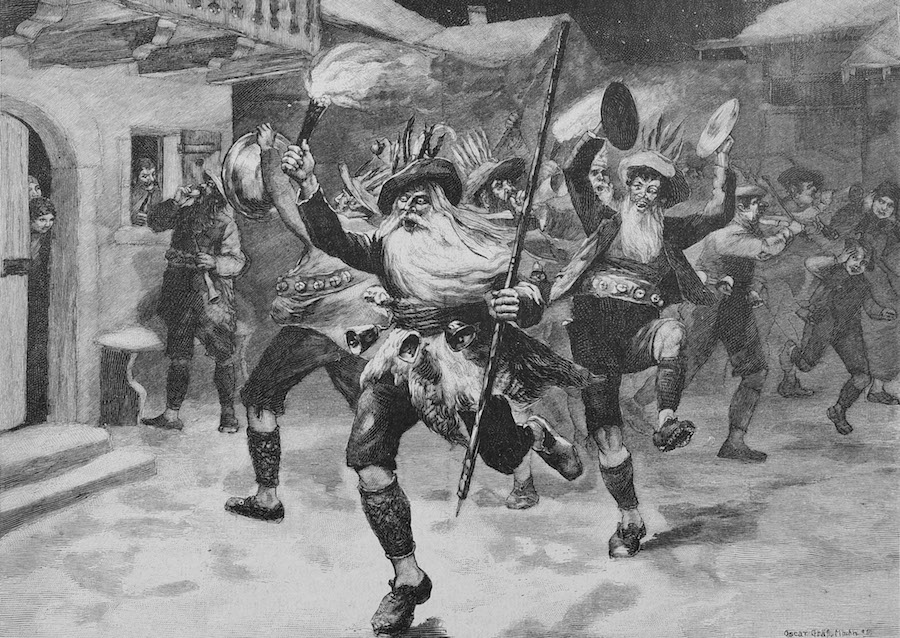
Next we consider a raft of superstitions associated with the Twelve Nights, or Rauhnächte, a name likely derived from the German word for “smoke” (Rauch) thanks to the use of incense during these nights to dispel evil influences.
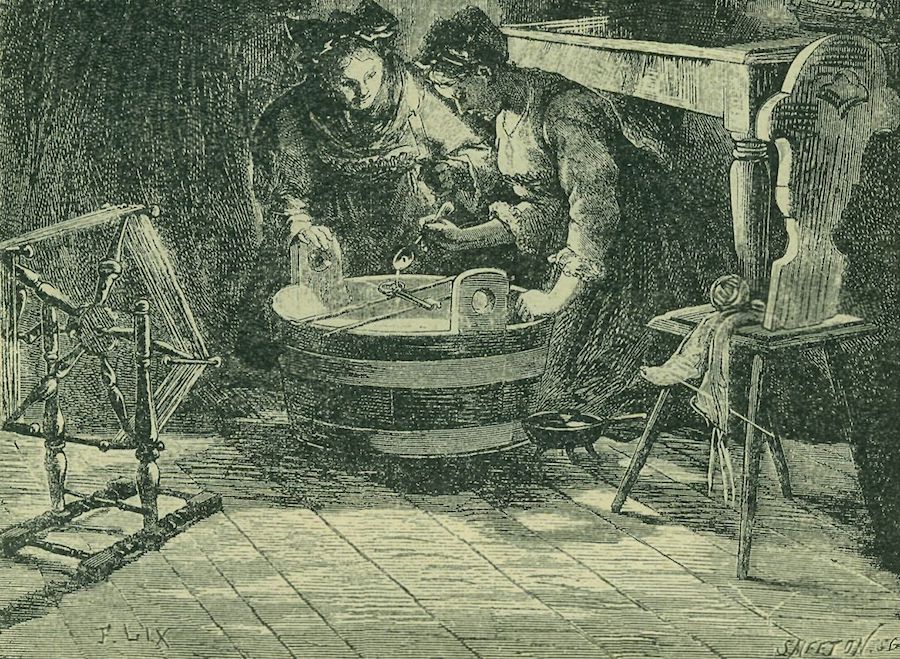
Of all the terrors unleashed during the nights around Christmas, the most widespread in German-speaking lands were those ghostly hordes in nocturnal processions, dead souls, solemnly walking, or wildly riding, the latter usually going under the name of “Wild Hunt” or “Furious Army.” This mythologem is prevalent throughout Central Europe, Scandinavia, the British Isles, and even North America, where the spirits appear in cowboy legends, and made their way into the 1940s country-western ballad “(Ghost) Riders in the Sky.”
Wilkinson reads for us some rather dramatic (and grisly) accounts of this form of apparition from the 16th century, and we hear a variety of accounts emphasizing the weird sounds that were said to accompany the Wild Hunt.
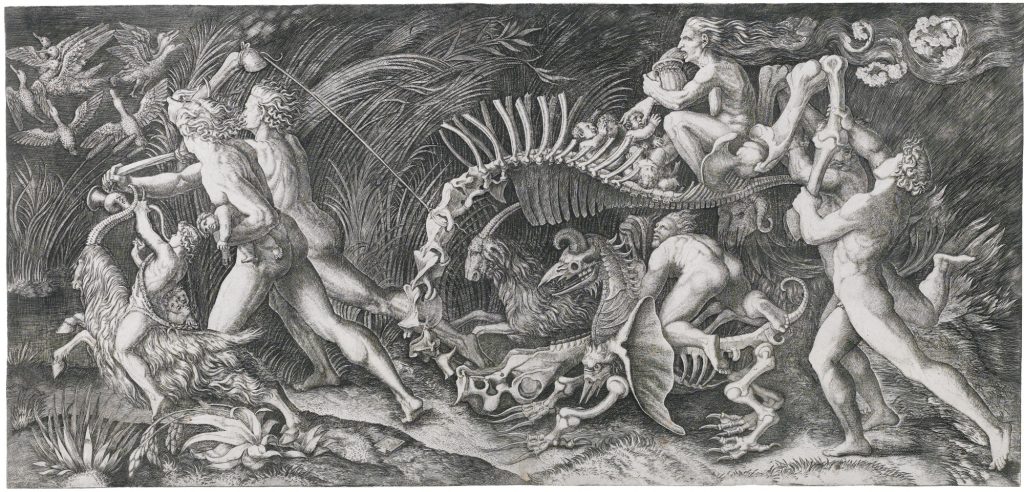
A number of figures were presented as the leader of the Wild Hunt, in particular the Germanic god, Odin, whose presence was associated with the superstition all the way into the 1800s as we hear from a newspaper account of the period.
We close the show with some folk tales recounting a similar phenomena in Austria and Switzerland, namely tales of the “Night Folk,” or “Death Folk,” nocturnal hordes whose appearance often heralded death or misfortunes.
#15 Saint, Devil, Sugar-Bread, & Whip: KRAMPUS AND NICHOLAS
The Krampus and St. Nicholas represent a folkloric duality embodying a mode of childrearing the Germans call “sugar-bread and whip” — in English, “carrot and stick.” In this episode, the first of three exploring the darker folklore of the season, we look at the Krampus’ origins in the old custom of Krampus and Nicholas house-visits and the older Alpine “Nicholas Plays.”
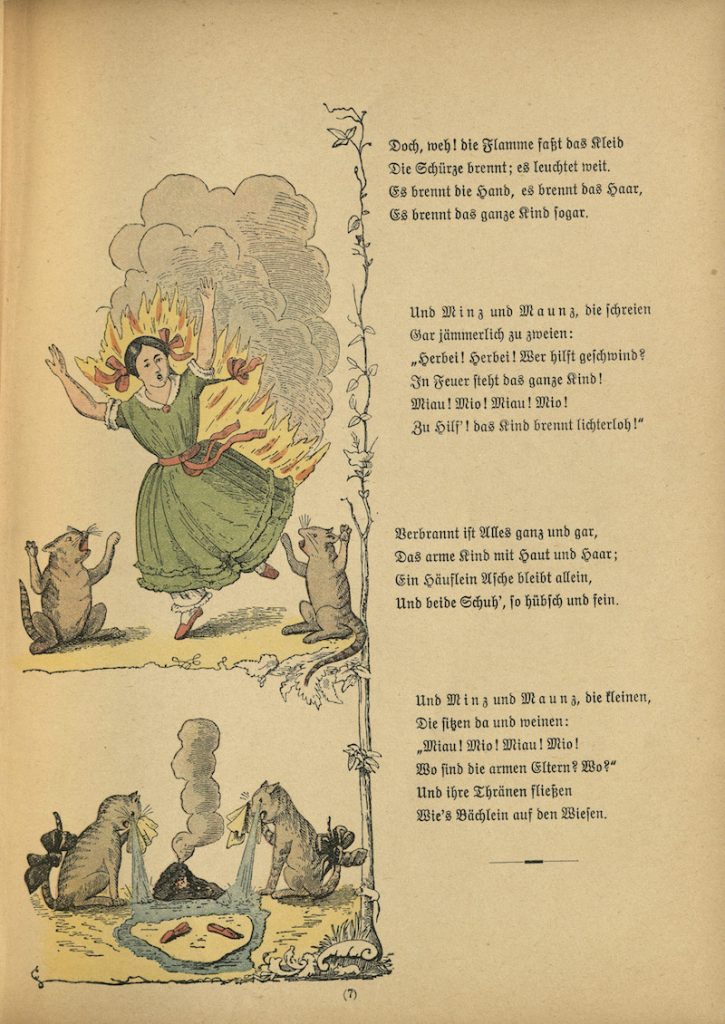
We begin our discussion with a consideration of the “sugar-bread and whip” literary example par excellence, Der Struwwelpeter, the 19th-century German children’s book in which “un-groomed Peter,” and other misbehaving children meet dreadful ends. An clip from a 1955 cinematic version of the story from Germany, and a bit of The Tiger Lillies’ “junk opera,” Shockheaded Peter is included.
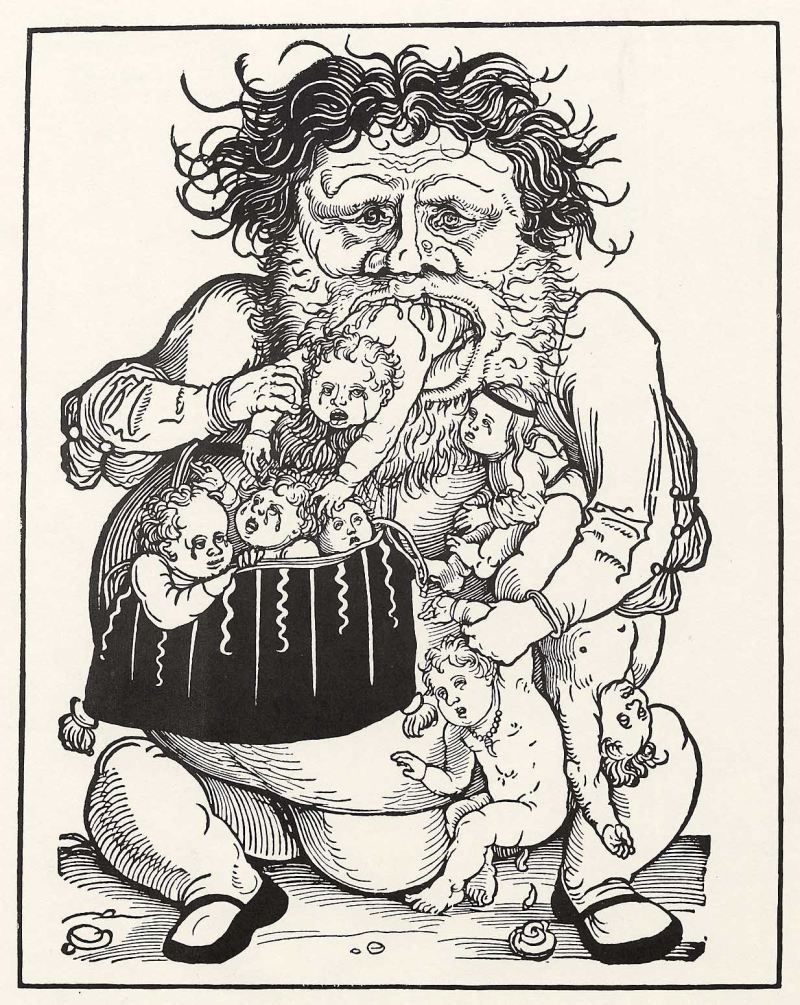
As the Krampus is, at root, simply a bogeyman, we discuss some early (and ghastly) images of German bogeymen from Carnival broadsides, which might be considered forerunners of the Krampus. The “Child-Eater Fountain” in Bern, Switzerland, a sculptural rendering of these same figures, is also mentioned.
A soliloquy delivered by a rhyming Krampus in an old 19th-century Alpine “Nicholas play,” introduces us to the figure. The verse is a translation from your host’s book The Krampus and The Old, Dark Christmas, as is much of the material in this episode.
Next we discuss the source of the Krampuslauf (Krampus run) tradition in the old custom of house-visits made by costumed troupes consisting of a St. Nicholas, Krampuses, angel assistants to the saint, and an odd backwoodsy character called Körbelträger (basket carrier). Part of the visit discussed is small test of the children’s good character consisting of a performance for St. Nicholas of a memorized poem or song. A traditional song for this occasion is “Lasst uns froh und munter sein,” which we hear in a clip. We also hear some background sound effects provided by an excellent video depicting traditional Krampus customs in Austria’s Gastein Valley.
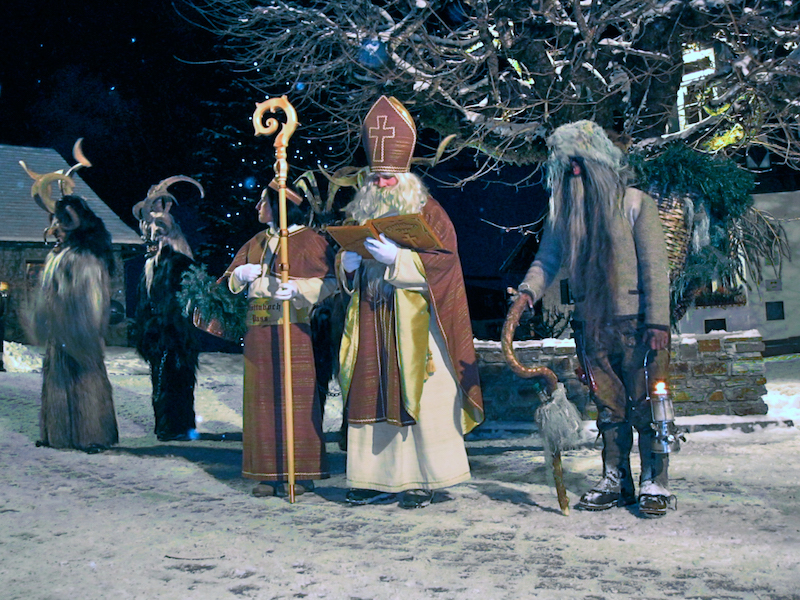
We then have a look at ways in which the tradition of Nicholas plays featuring the saint mingled with local pagan folklore of the Perchten, winter spirits of the German-speaking Alps, and hear a number of historic accounts illustrating how this rowdy element worked its ways into the Nicholas customs of centuries gone by. Various outrageous are documented from drunken Nicholases to actual deaths of performers.
The show concludes with a more in-depth look at these Nicholas plays, including some bawdy slapsticks elements hardly befitting a saint. Wilkinson delivers a stirring rendition of the “Lucifer Sermon,” a devilish rant, traditionally concluding these plays.
LISTENER NOTE: During our intro segment, we also receive a phone message from Mark Norman of The Folklore Podcast responding to the ongoing dilemma of the phantom cat, which seems to be haunting the Bone and Sickle studio-library. (Listeners who have not yet tuned in to the Folklore Podcast, should also watch for Mr. Ridenour upcoming appearance on the show, in which he discusses some pagan aspects of the Krampus myth not covered elsewhere.)
#14 Singing Bones & Scrumptious Children
This episode looks at some particularly gruesome fairy tales and folk ballads telling of murderers convicted of their crime through magical intervention of the bones or blood of their victims.
We begin with a look at the story of Sweeney Todd the Demon Barber of Fleet Street as it shares a common theme of accidental cannibalism with Grimm fairy tale central to our episode, “The Juniper Tree.” Some Victorian urban legends are identified as possible sources of the story, which first appeared in an 1846 penny dreadful entitled The String of Pearls, a Romance. We also hear a snippet of a song about the Demon Barber written by R.P. Weston and sung by English music hall revivalist Stan Holloway, the artists who also gave us the song about Anne Boleyn’s ghost “With Her Head Tucked Underneath Her Arm,” featured in our “Lost Heads” episode.
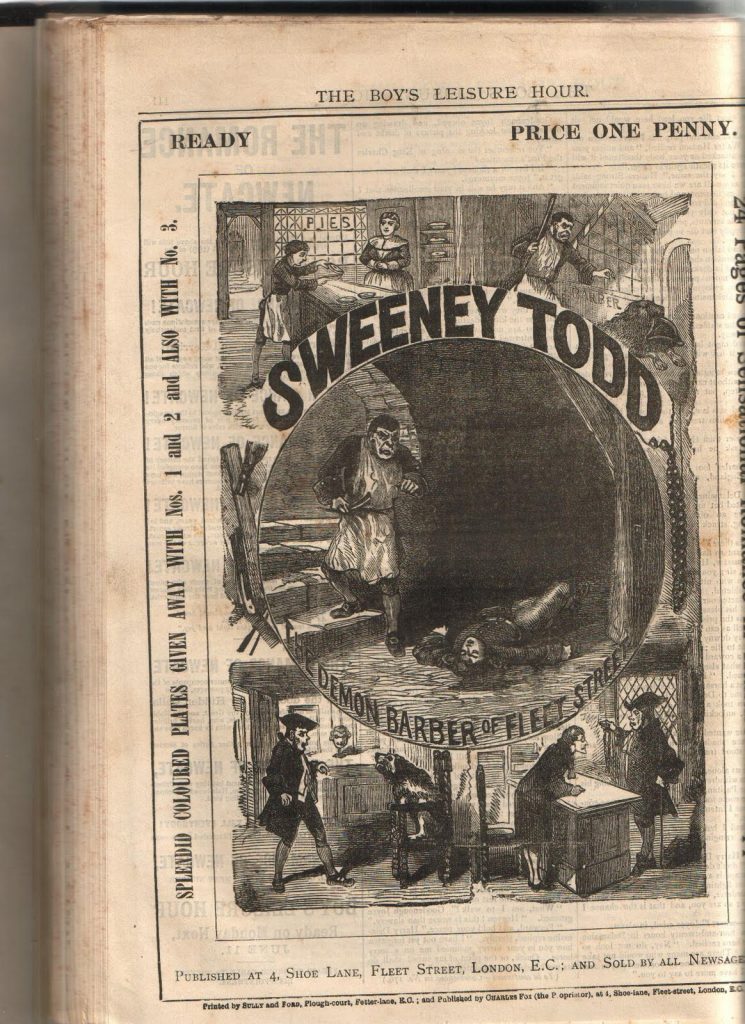 We then have a look at “The Juniper Tree” published in 1812 in the original edition of Grimm’s collection Children’s and Household Tales, that is, what we call Grimm’s Fairy Tales. The grisly tale would never lend itself to the Disney treatment, though it did serve, extremely loosely, as inspiration for an Icelandic film of the same name, starring a young Björk.
We then have a look at “The Juniper Tree” published in 1812 in the original edition of Grimm’s collection Children’s and Household Tales, that is, what we call Grimm’s Fairy Tales. The grisly tale would never lend itself to the Disney treatment, though it did serve, extremely loosely, as inspiration for an Icelandic film of the same name, starring a young Björk.
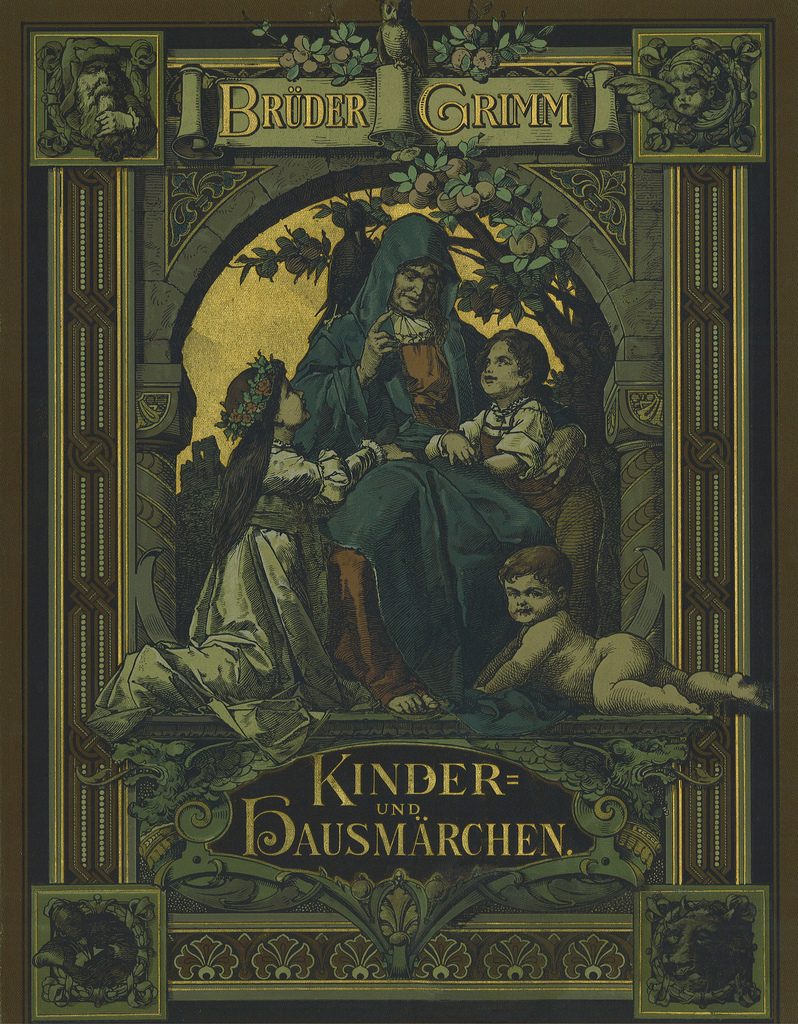
“The Juniper Tree” tells of an evil stepmother who contrives to kill her stepson in a particularly brutal way, covering her crime by cooking the child’s remains into stew served to the family. The tale also includes of blood, a vengeful bird, and a fiery, magic juniper tree. English, Austrian, and Romanian version of the tale, are also noted for noteworthy bits of horror, and we hear a a musical rendition by the Russian ensemble Caprice of the song sung by the bird in this Grimm story.

The next story, introduced via an audio oddity from the 1962 film, The Wonder World of the Brothers Grimm, is “The Singing Bone.” Like “The Juniper Tree,” this one revolves around the outing of a murderer though a song. In this case, the song telling the tale of murder of one brother by another produced by a flute made of a bone of the murdered brother. We also have a look at a number of variations on this tale and a tool used by folklorists,The Aarne–Thompson Tale Type registry, where one can find synopses of tales listed the “Singing Bone” (#780) category, such as:
“780B: The Speaking Hair: A stepmother buries a girl alive. Her hair grows as wheat or bush and sings her misfortunes. Thus she is discovered and dug up alive. The stepmother is buried in the same hole.”
Just as bones communicate the identity of their murderer, the blood of a victim in other tales can bring a killer to justice. We hear a number of tales of this sort, including the Icelandic “Murder Will Out,” featuring a bleeding skull impaled with knitting needles.
The idea that human remains could identify their killer was not just the stuff of folk tales. The idea that a corpse would bleed in the presence of its murderer (called ‘cruentation’ from a Latin word for “staining with blood”)was, in past centuries, an accepted element of criminal law in Germany, Denmark, Bohemia, Poland, and Scotland, and even the United States. We hear a snippet from Shakespeare’s Richard III, featuring the practice as well as an example of cruentation used as late as the early 1800s in the US.
The “Singing Bone” story has parallels in the world of folk music. The murder ballad “Two Sisters” (also “Twa Sisters,” “The Cruel Sister,” “Binnorie,” or in America, “The Dreadful Wind and Rain”) tells of the murder of one sister by another over an issue of romantic jealousy. Like “The Singing Bone,” the victim’s bones are found and made into a musical instrument that produces a song convicting the murderer. Often the hair, or in an older version dating to the 1600s — veins, are turned into the strings of a harp. We hear a version of the song by The Askew Sisters and by the German group Broom Bezzums, and American versions by Kilby Snow and Tom Waits, also a rather different take on the song from Sweden, where more than a hundred versions also exist.
We saved a final tasty morsel for the end of the show, a surprising historical account, which precisely parallels the Sweeney Todd story, not from 19th-century London, but a place and time far, far removed.
#13: Ancient Necromancy
Finishing up with our October theme of “talking to the dead,” we examine necromancy in the ancient world in this episode. While the word has been generalized in its present use to mean cover any form of magic of a sinister bent, in its original meaning, it was simply what the Latinized-Greek etymology suggests: “necro-” for “dead” and “-mancy” for “divination by.” Not that it wasn’t always regarded as a rather sinister activity. It certainly was, and particularly by the Roman era, we’ll see the practice associated with most ghoulish sort of atrocities imaginable. But it’s Halloween, so the more ghoulish, the better.
We begin around 630-540 BC when a necromancer was written into the Biblical book of 1 Samuel (or 1010 BC, if we are to date the figure by the time the events were alleged to have occurred — in any case, this is our oldest tale of a necromancer, known most commonly as the “Witch of Endor.” It’s also our first of several examples of not getting particularly good news when you consult the dead on your future. Much doom and gloom, when King Saul talks to the dead prophet Samuel, who never really liked him anyway.
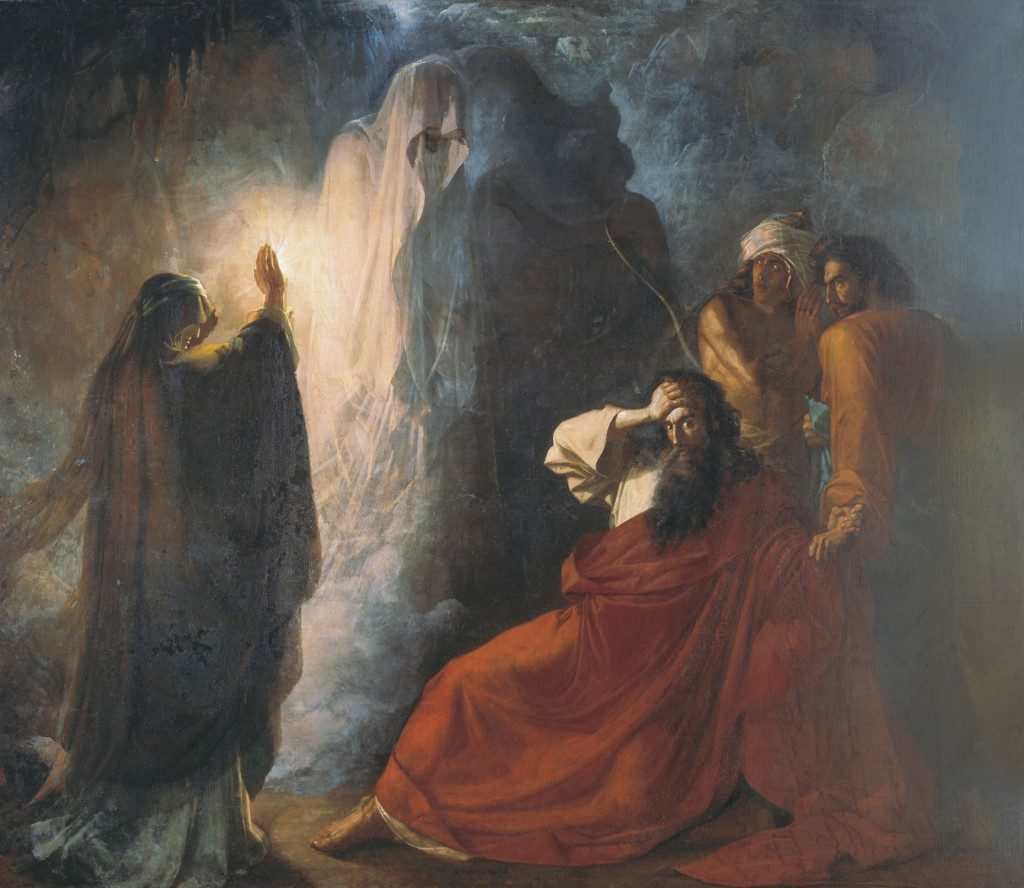
Our next tale of ancient necromancy comes from Homer’s Odyssey, and though there’s no actual necromancer in this story, Odysseus follows instructions for summoning the dead in Hades given him by a pretty legitimate enchantress, namely, Circe. We’ll see an interesting parallel here with the story of the Witch of Endor and learn of the vampiric love of blood attributed to the dead in ancient Greece.
Up next is a lesser known Greek tale of Periander, a tyrannical ruler of Corinth, who sends servants to consult the necromancers to discover the location of some money hidden on his estate, the location of which, only his deceased wife Melissa would know. Some interesting details here as we learn just why the late Melissa finds herself chilly in the afterlife and Periander demonstrates just how tyrannical a tyrant he really is.
A little background is then furnished the rather elaborate pantheon of the underworld and death-related spirits known to the Greeks, much of which was inherited by the Romans and one element even borrowed into a Sam Raimi film. Interesting etymological links to modern curiosities abound! Thanatos, Hypnos, Nyx, The Keres, Manes, Achlys, Lemures, and Lamia are all discussed.
Then there’s the story of Pausanias, King of Sparta, who led the Greeks in victory over the Persians in 479 BC. Troubles begin when he becomes infatuated with a beautiful virgin, Cleonice, in Byzantium. One tragedy and betrayal follows another in this sad tale, and following instructions from a ghost summoned by necromancers only makes things worse.
Then we turn to the Romans for the most gruesome stories.
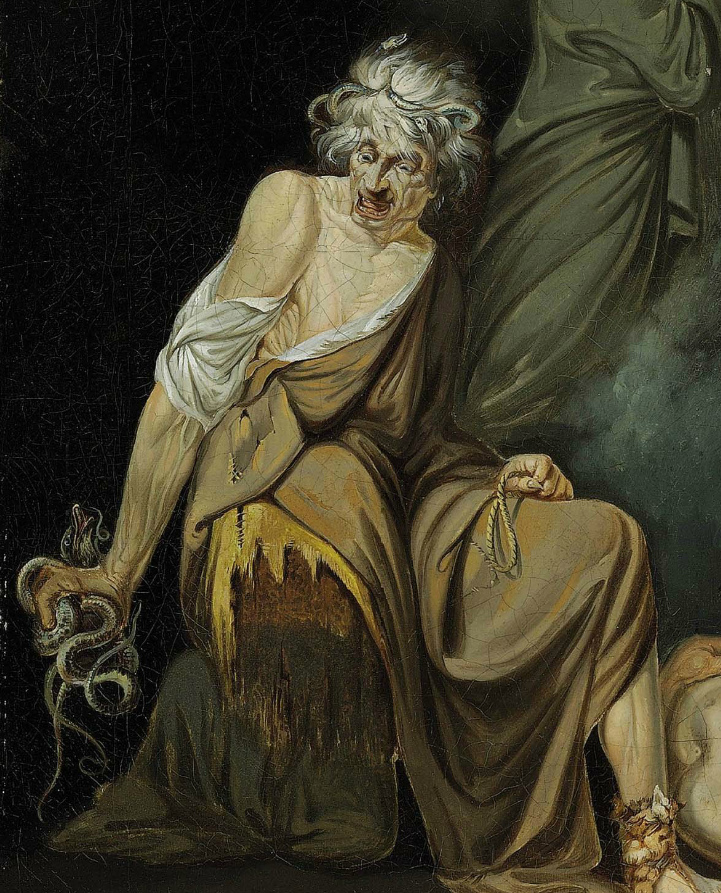
The necromancer or witch Erichtho appears in the poem Pharsalia, Lucan’s epic on Caesar’s Civil War. Her characterization was so she’s later picked up by other authors, such as Dante, who uses her in his Divine Comedy, the Jacobean writer John Marston, who uses her in a play, and Goethe, who in Faust features her in the Walpurgisnacht scene we talked about in Episode Two. Erichtho hangs around graveyards and her spells and rites involve the most abominable elements you can imagine. Her memorably weird resurrection of a dead soldier in Pharsalia was said to have inspired Mary Shelley in her imaginings of dead things brought to life.
Next we have a look at a necromancer or witch appearing in the works of Horace, who uses her to darkly lampooning those who supported or engaged in the practice of magic in his poetry. He embodies witchcraft in the figure of Canidia, who reappears in several of his works. She’s nearly as ghastly as Erichtho, walking around with “tiny snakes twined in her hair,” perhaps to outdo her witch pal Sagana, whose coiffure Horace describes as “rough” and “standing on end, like a sea-urchin or some bristling wild boar.” After some serious spookery, Horace has some weird fun with the his story of Canidia, providing a particularly vulgar touch, while also taking a jab at a lover who rejected him.
We finish up with some actual cases of Roman necromancy, or at least some purported to have been real, though we can assume there’s probably an element of nasty gossip in some of the accounts. Still, they make for good Halloween listening with spilled blood, entrails, and flayed skin.
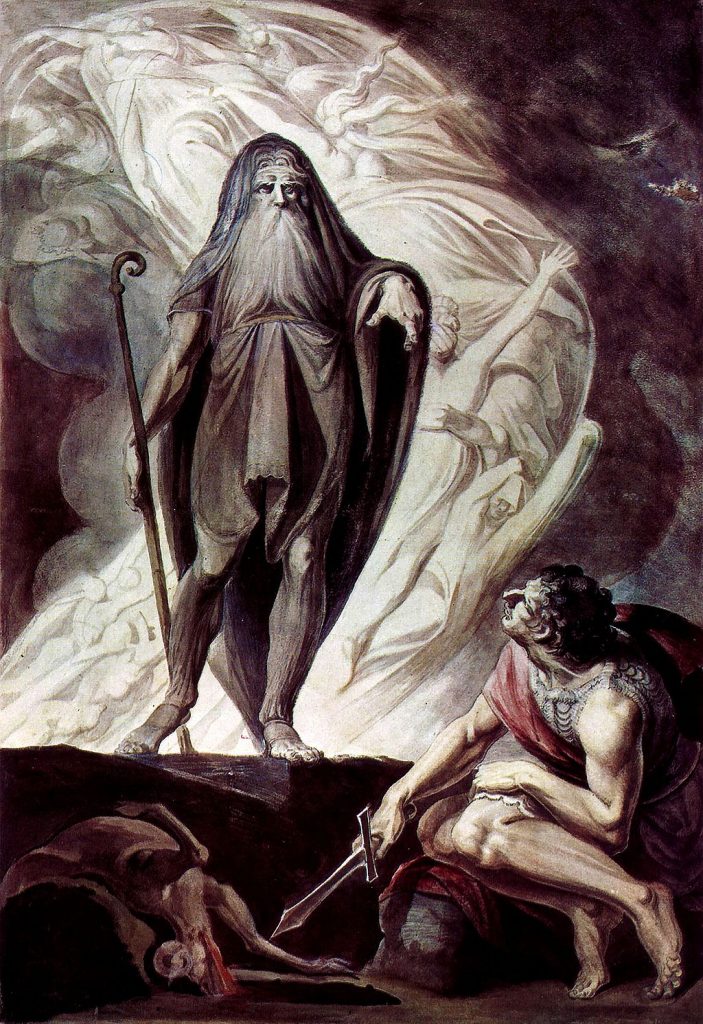
#12: Seances & Scandals
Hope you enjoy part two of our exploration of Spiritualism and seances. This one is particularly full of shocking, sad, and amusing tales you won’t hear anywhere else.
First we wrap up last week’s story of the Fox sisters, who in many ways started the whole ball rolling. Two surprising revelations regarding their ghostly communications are revealed with the help of Vincent Price’s 1979 Hall of Horrors episode about these early mediums.
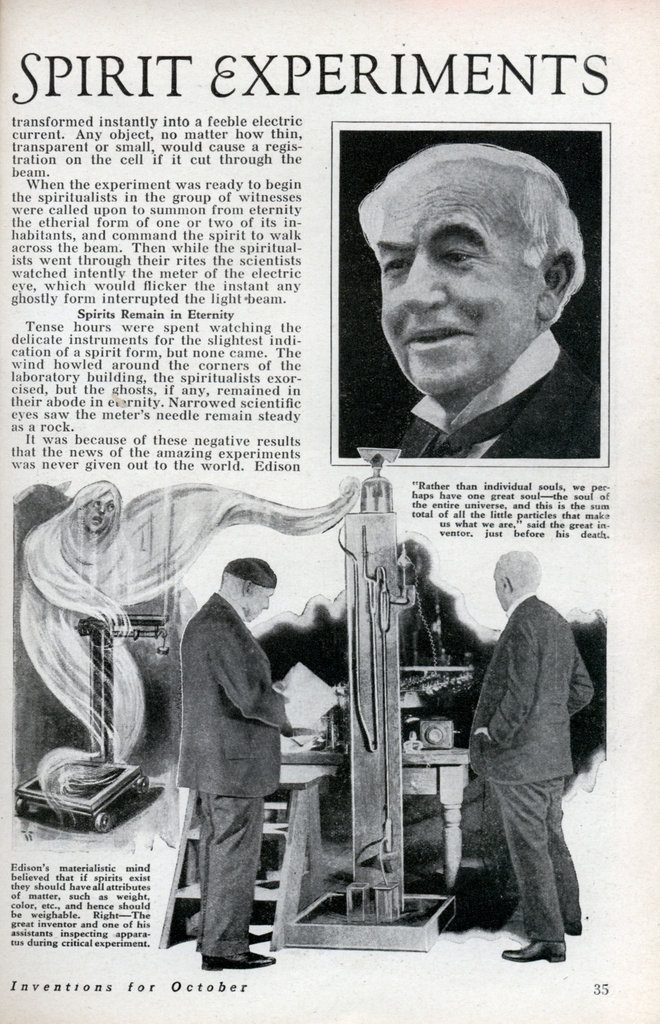
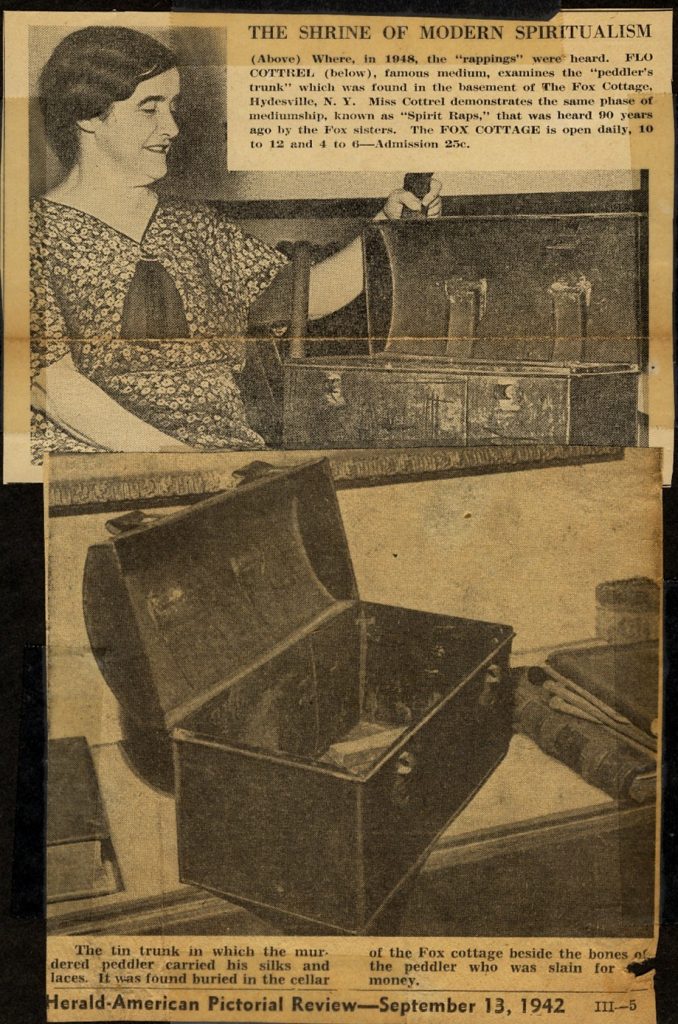
Next we get to the root of rumors about Thomas Edison’s building a machine to talk to the dead and have a look at some interesting ways in which his pioneering technologies were embraced by those eager to connect with those on the other side, including a 1901 Russian recording of spirits channeled in Siberia. Edison’s decidedly creepy (and failed) talking doll is also discussed
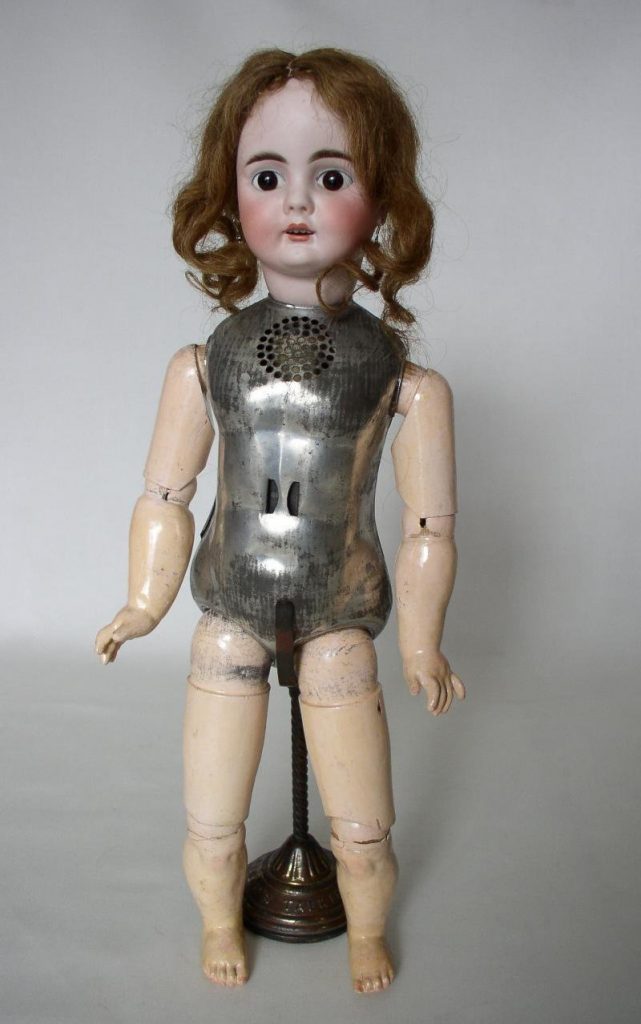
Leaping forward a bit we provide a little background on the modern EVP phenomenon and and some rather eccentric Swedish and Latvian researchers (Friedrich Jürgensen and Konstatin Raudive) who were quite convinced their dead mothers were speaking from their tape recorders back in the 1960s and ’70s.

After some eerie snippets of their work, we’re back to early 20th-century Spiritualists.
Eva Carrière, was a French medium particularly notorious for conducting her seances in varying states of undress. The things she and her lesbian lover Juliette Bisson did with ectoplasm are truly the stuff of historic clickbait. Flash photos taken during her sittings by more skeptical researchers, however, reveal a decidedly less impressive side to her craft.
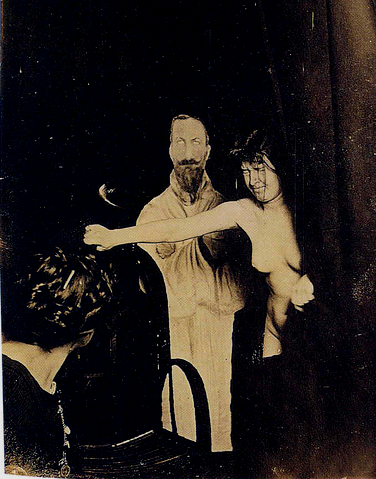
We also have a look at the Boston medium Mina (or “Margery”) Crandon whose notoriety came from a public feud with the debunker Harry Houdini and her own tendency toward scanty dress during sittings. Her dead brother Walter also figures into the story along with a suspicious “teleplasmic” hand revealed to be constructed in a rather ghastly way.
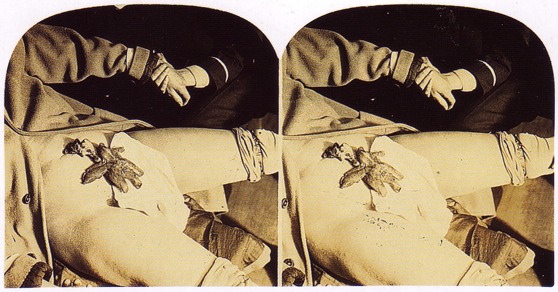
From newspapers of the 1920s we provide two particularly obscure accounts of Spiritualists gone wild. The first, from a 1921 story in the Pittsburgh Press relates the tale of despondent mother who has lost her baby during childbirth. A particularly nefarious seance medium inserts herself into the tragedy, and before long the entire town is celebrating the arrival of a miraculous “Spirit Baby.” A purchase of cheap necklaces, however, proves to be the medium’s undoing.
The second tale, from a 1928 edition of The San Francisco Examiner, begins with a jeweled dagger found in the corpse of an unlucky newlywed. Though the police have already obtained a confession, a Spiritualist circle in France blames a rather brutish spirit that’s been hanging around their seances. A series of 13 inexplicable deaths, including that of dancer Isadora Duncan are also involved.
Our show concludes with an audio clip from a rather sad, but historically important seance held in Hollywood in 1936.
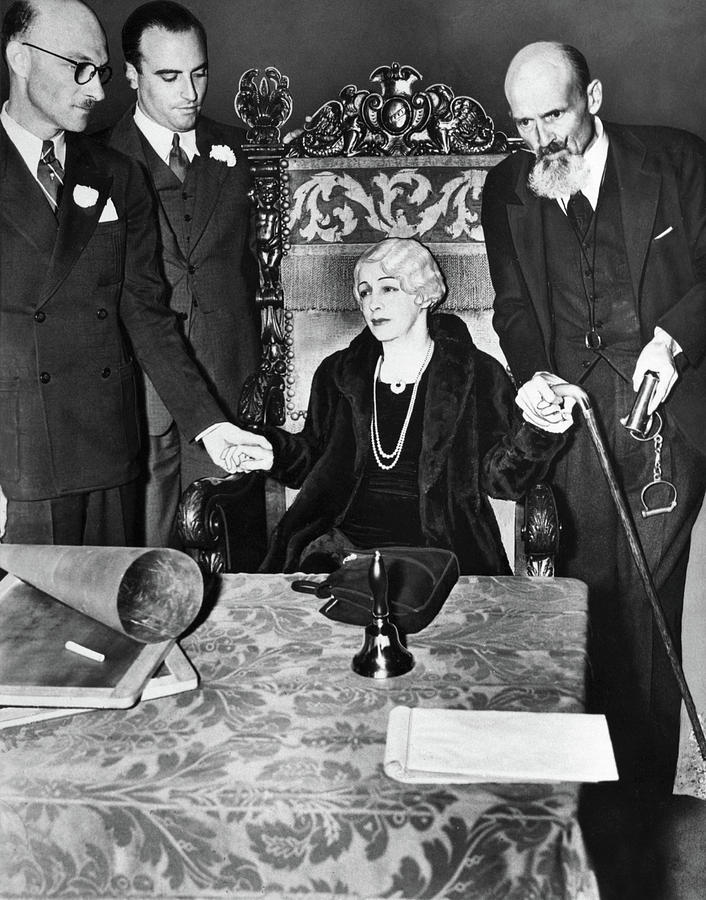
Episode 11: The Dead Speak
The 19th-century Spiritualist movement was rife with fraud and misplaced hopes, but what made people so eager to believe in the possibility of talking to the dead? This episode looks at some early mediumistic pioneers, attractions beyond the metaphysical that drew sitters to take part in seances, and the growing pressure within the movement to produce ever more vivid phenomena passing for proof of supernatural contact. This episode also kicks off our Fall-Winter season and a (3-episode!) October dedicated to the theme of “talking to the dead.”
As communication with the dead is necessarily a two-way process, we begin with a story illustrating, not why we may wish to speak to the departed, but why the departed may wish to speak to us. A typical folkloric reason for a spirit’s return is the desire for resolution regarding the circumstances of death and proper burial. Our first story illustrates this with the story of William Corder’s murder of Maria Marten in 1827 — what came to be known as “The Red Barn Murder” — in which a ghost appears in dreams of Maria’s stepmother in an effort to identify the perpetrator and the body’s whereabouts. I include a 1932 recording of a popular Victorian melodrama enacting the story and a description of the widespread fascination which this case held and some particularly morbid consequences. I also include a snippet from a popular period ballad recounting the tale.
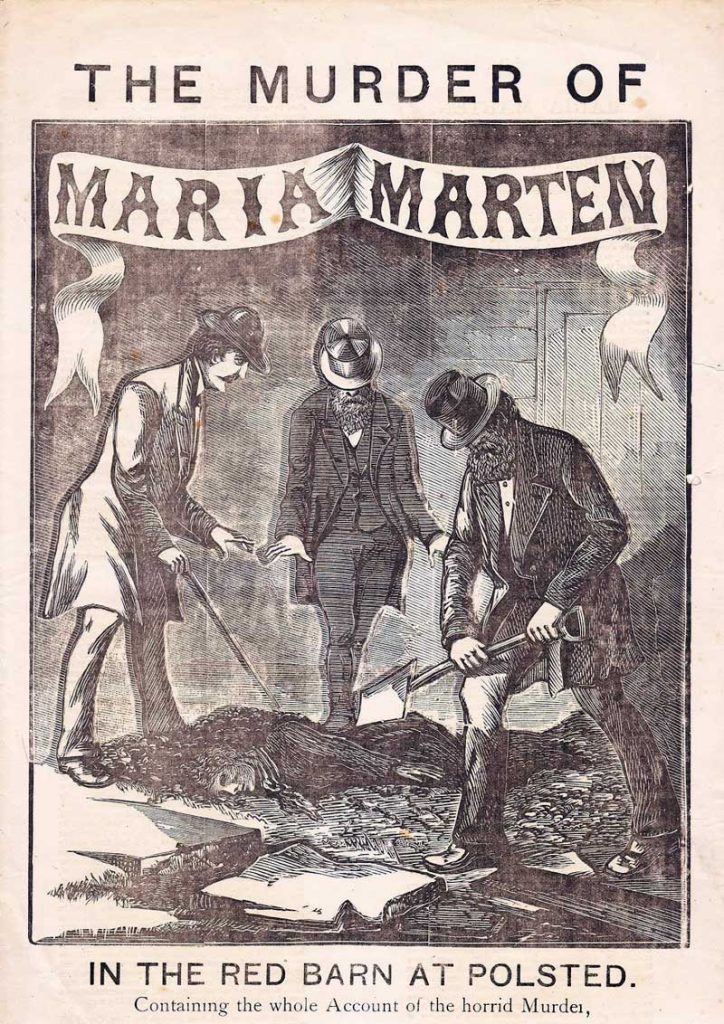
Vincent Price’s 1979 series of radio shorts, “Hall of Horrors,” gives us a audio introduction to the de facto founders of the Spiritualist movement, the Fox Sisters, Margaret, Kate, and Leah, of Hydesville, New York. Like the unfortunate Maria Marten, a murdered peddler and his attempt to communicate in 1848 with the siblings through a knocking code is the purported initiator of this historical movement. Even as the sisters are developing a following in the 1850s, other small groups of friend and relatives are gathering in “home circles” to emulate the Fox’s supernatural communications, and other “public mediums” are gathering their own followers and offering performing on an evolving circuit of Spiritualist hotspots. We return to the Foxes in Episode 12 next week for the unexpected end to their tale.
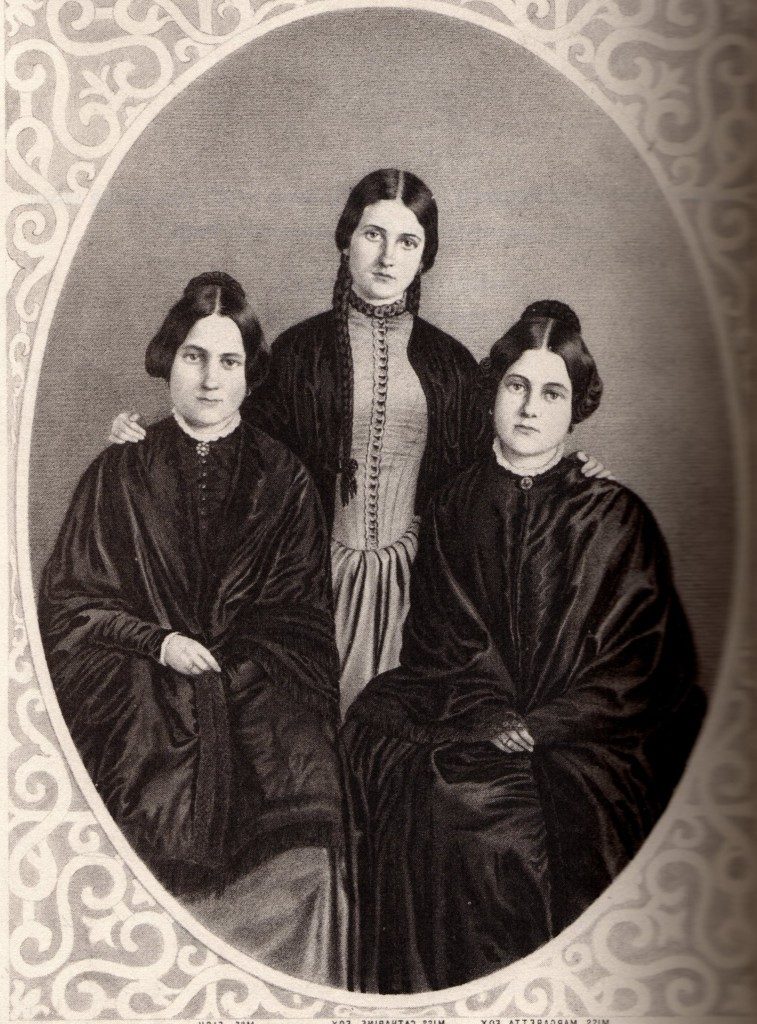
One of these “public mediums” was Jonathan Koons of Mt. Nebo, Ohio, who in the early 1850s, claimed to have been directed by the spirits to build his “Spirit Room,” a log cabin, in which bizarre musical seances were held around a mysterious “spirit machine” handmade by Koons. We hear some strange firsthand accounts of the goings-on from newspaper accounts of the period.
As things progressed, greater proof of the spirits’ presence was demanded, and mediums complied with all sorts of gimmicks including physical tokens supposedly manifested from the spirit world (“apports”), spirit photography, and even impressions of ghostly body parts made in plates of warm paraffin left out during seances. We hear a couple cases of apports and spirit prints going terribly, terribly wrong.
We visit William and Horatio Eddy of Chittenden, Vermont, whose showman-like seances upped the ante with a cast of dozens of costumed spirits including costumed Native Americans, elderly Yankees, Russians, Asians, Africans, and pirates. A bizarre incident with a rat (or is it a flying squirrel?) and a dancing spirit is recounted.
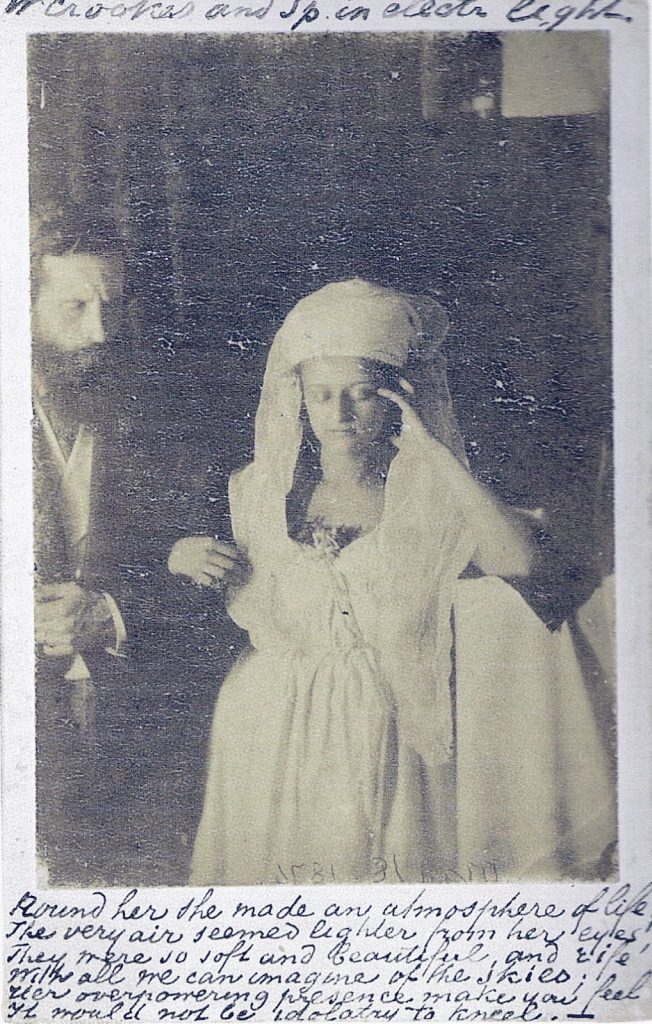
Next, we hear the more well-known case the teenage medium Florence Cook investigated by Sir William Crookes, known for his pioneering work with vacuum tubes and radiography. Crookes’ fanatical investigation of of Cook’s spirit guide “Katie King” did not meet with the same success as his mainstream work. Listen for the rather embarrassing conclusions drawn by his colleagues in the scientific community.
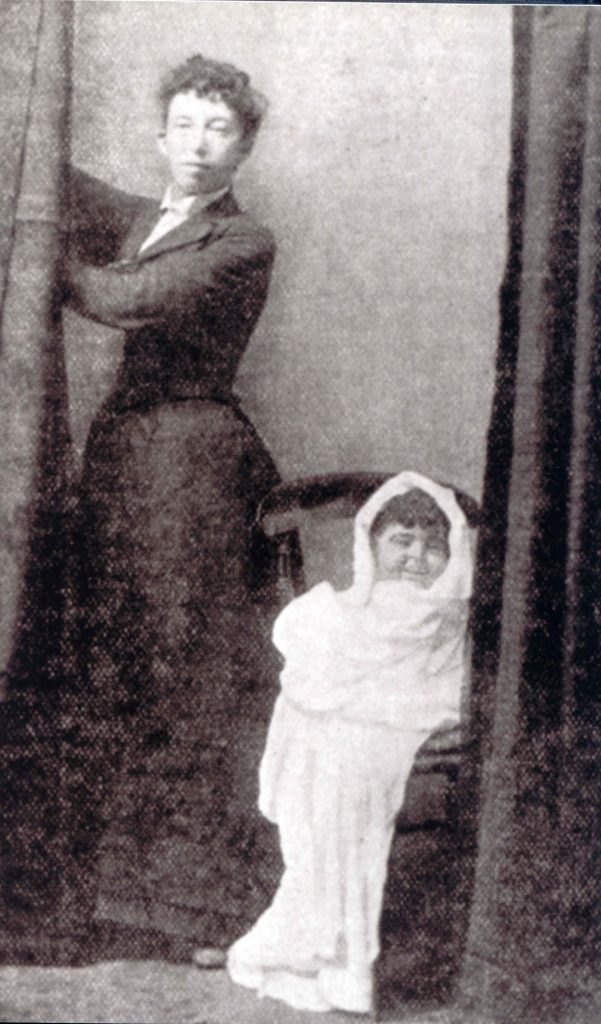
The show concludes with some tricks of the trade, a look at the a super-secret catalog used by fraudulent mediums and an exploration of ectoplasm, how it might be simluted, what exactly it feels and looks like, and what it should be capable of doing.
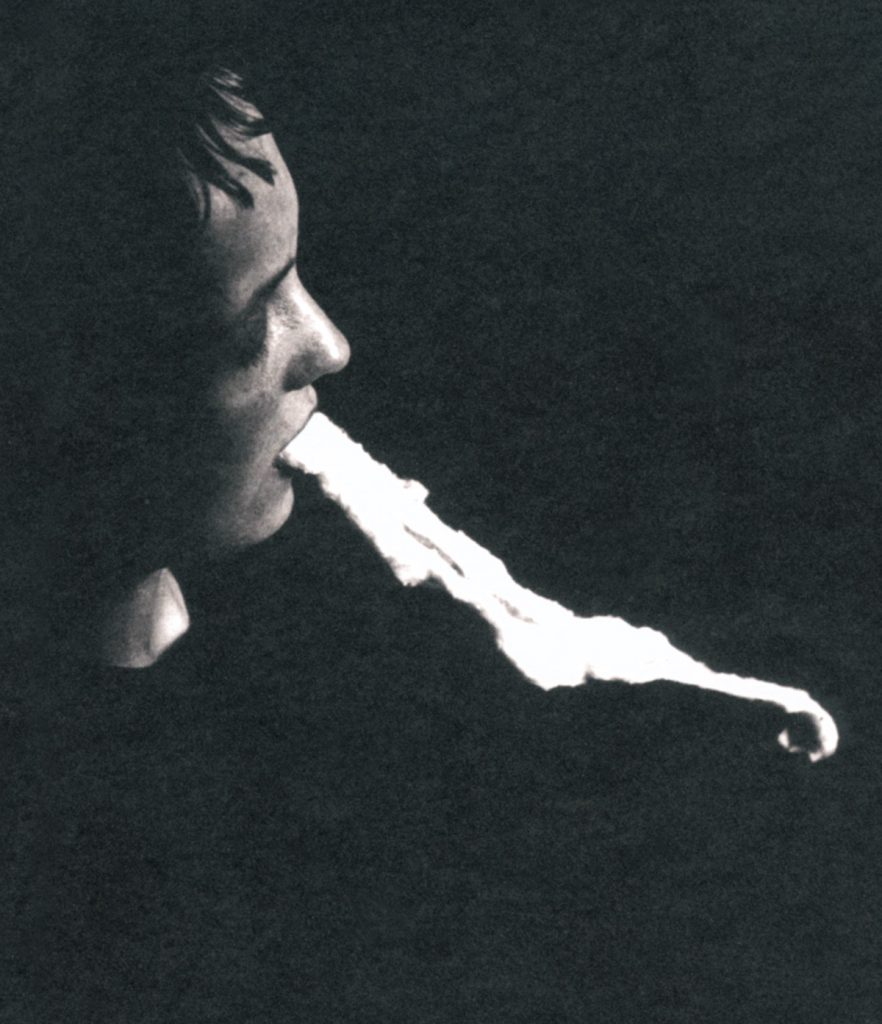
Episode 10: Victorian Mummies
This time round we explore the way in which the death-obsessed Victorians fetishized the equally death-obsessed Egyptians, creating a number of gothic mummy tales, which often veer into storylines that are almost necrophilic.
To begin we have a look at how the Victorians interacted with mummies as artifacts. We hear an 1899 story from Philadelphia’s The Times making clear that the demand for mummies as displays for educational institutions and even as curios for private homes of the well-to-do, was so great that entrepreneurial types in Egypt came up with rather unsavory ways of meeting the needs of the market.
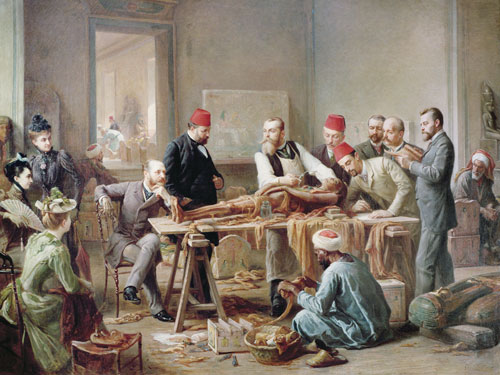
We discuss Thomas Pettigrew and his promotion, not only of “mummy unwrapping” parties in the 1830s and ’40s, but also of the “miracle” of germinating seeds or “mummy wheat” allegedly found in ancient tombs. A peculiar story of a Scottish duke and his morbid preoccupation with Pettigrew’s mummy ballyhoo should also be of interest to listeners.
Wilkinson narrates a first-person experience of a mummy unwrapping during a thunderstorm penned by French RomanticThéophile Gautier, author of a number of mummy stories himself. His short, supernatural story, “The Mummy’s Foot,” is the first of several included in this episode that connect grotesque mummified remains (a foot in this case) with a rather comely, female love interest. One likely explanation for this tendency is offered via a short side-trip to French Orientalist art and Victorian pornography.
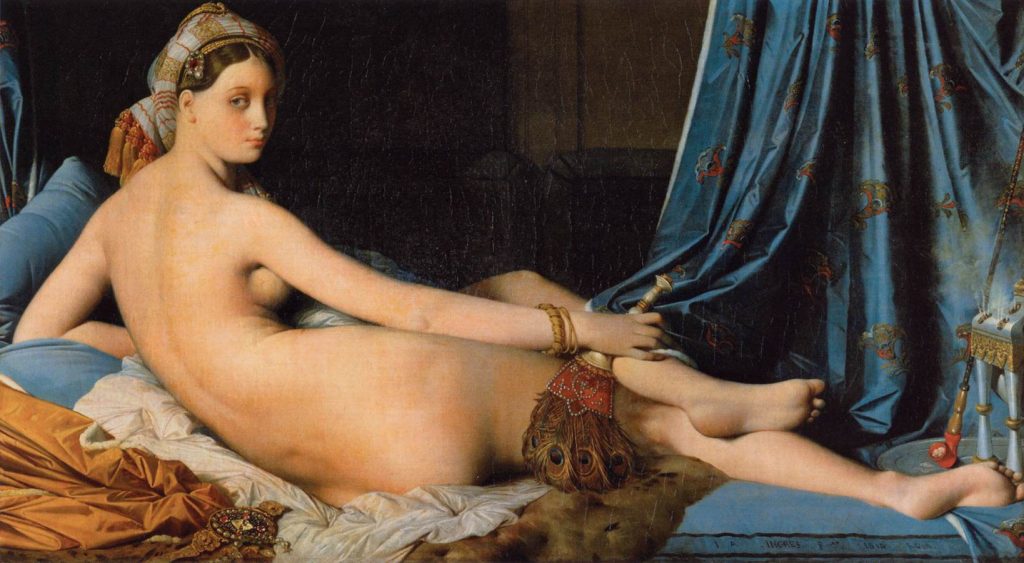
Next we explore The Jewel of Seven Stars, written in 1903 by Bram Stoker. This one also centers upon a regal Egyptian female (a queen and “sorceress”) who is missing an appendage — a hand in this case, which is wearing a ring with the valuable, titular “jewel.” The “seven stars,” we learn, wre lamps from the mummy’s tomb, which are to be used in an occult experiment to raise the spirit of the ancient queen. A mummified cat — much like the one recently gifted to the Bone & Sickle Library by Paul Koudounaris — also plays an interesting role in the story. Wilkinson narrates another strangely eroticized unwrapping scene from the novel, and there are snippets from the surprising number of films adapted from this previously neglected work.
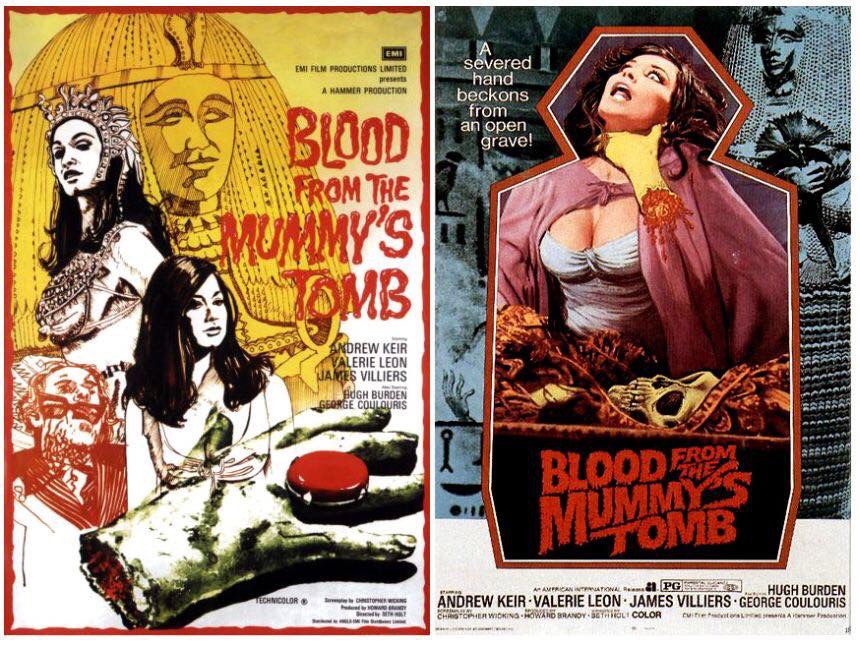
Then we’re off to the manly adventure-world of H. Rider Haggard who once delighted British audiences with tales of stiff-lipped men taming the Empire — and occasionally venturing into lost subterranean worlds, as in the novel She, which we discuss as another case related to the “seductive mummy” trope. Haggard’s stories generally, have more in common, perhaps, with the Indiana Jones model, but She crosses some paths with horror and science fiction, and was adapted for film by both Merian C. Cooper (director of the original King Kong) and British Lion (with Peter Cushing and Christopher Lee).
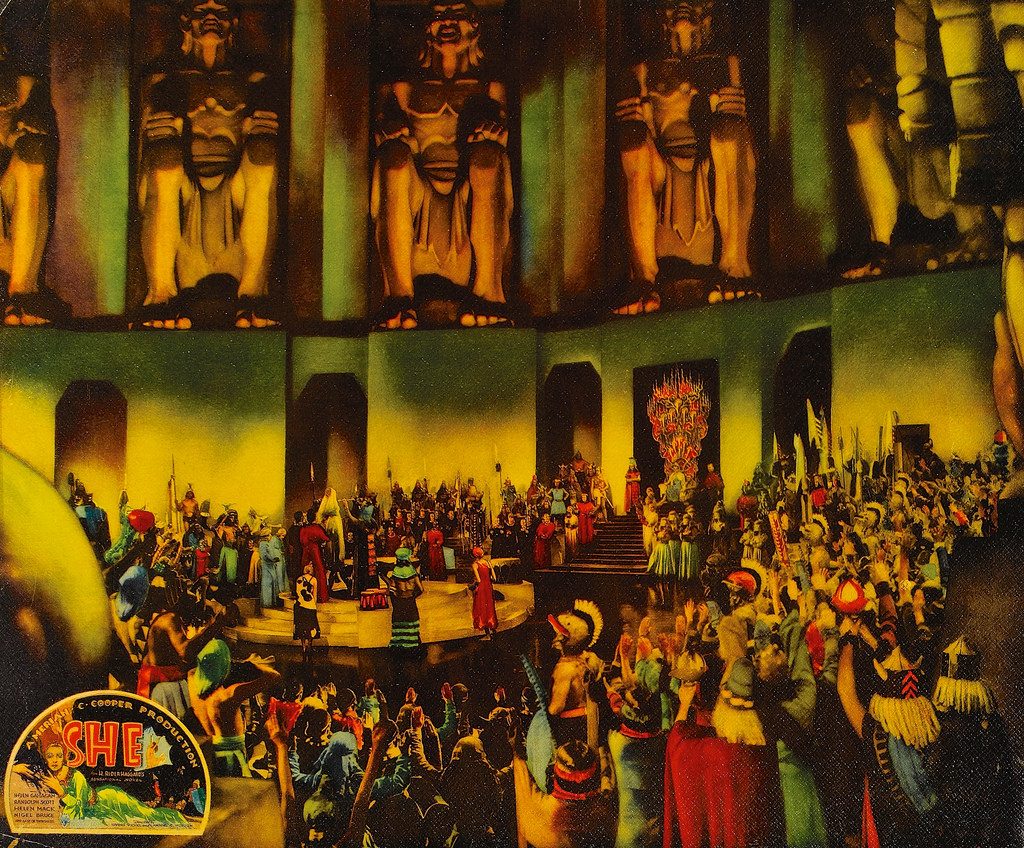
A fair bit of the show is devoted to Arthur Conan Doyle’s interest in mummies, both as fictional devices and in real life. Doyle believed both in the much disputed curse upon Howard Carter’s King Tut outing and another case, the “Ingram mummy,” which happens to also have wound its way into the folklore of The Titanic.
Doyle never signed on as a member, but did attend some meetings of the Hermetic Order of the Golden Dawn, an occult organization popular in Edwardian literary circles and named for Hermes, more or less a Greek version of the Egyptian Thoth. We have a look at how this occult body, and many others, were influenced by Egyptian mythology and how a French novel from 1731 purporting to be the text of a newly translated papyrus shaped their ritual structure. Connections between Egypt, the Tarot, Crowley, and his religion of Thelema are also briefly discussed.
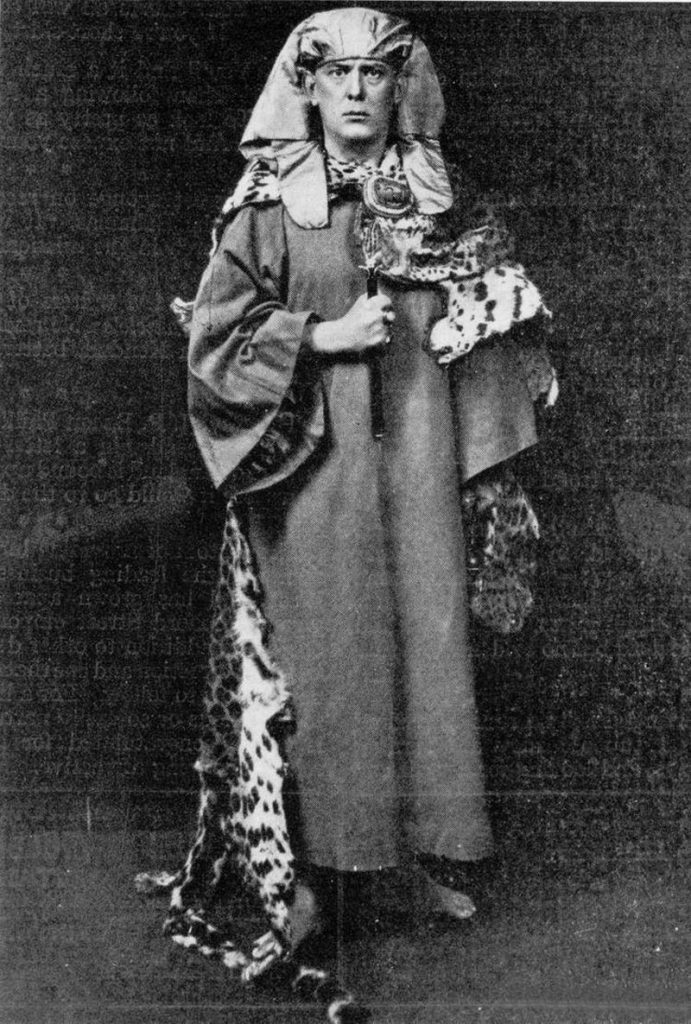
Lots of missing mummy appendages in this episode! The self-described “seer” and palmist going by the name “Cheiro” brings us another tale of a cursed mummy’s hand he supposedly kept in a wall safe for decades. He, like Doyle, also had some things to say about the Tut curse, lessons learned supposedly from a dramatic incident with this mummy’s hand.
Rising to fame in turn-of-the-century Britain, Cheiro migrated to Hollywood, where his later years were spent telling fortunes of the film stars of the 1920s and 30s, and where the idea of the cinematic mummy tale was first developed.
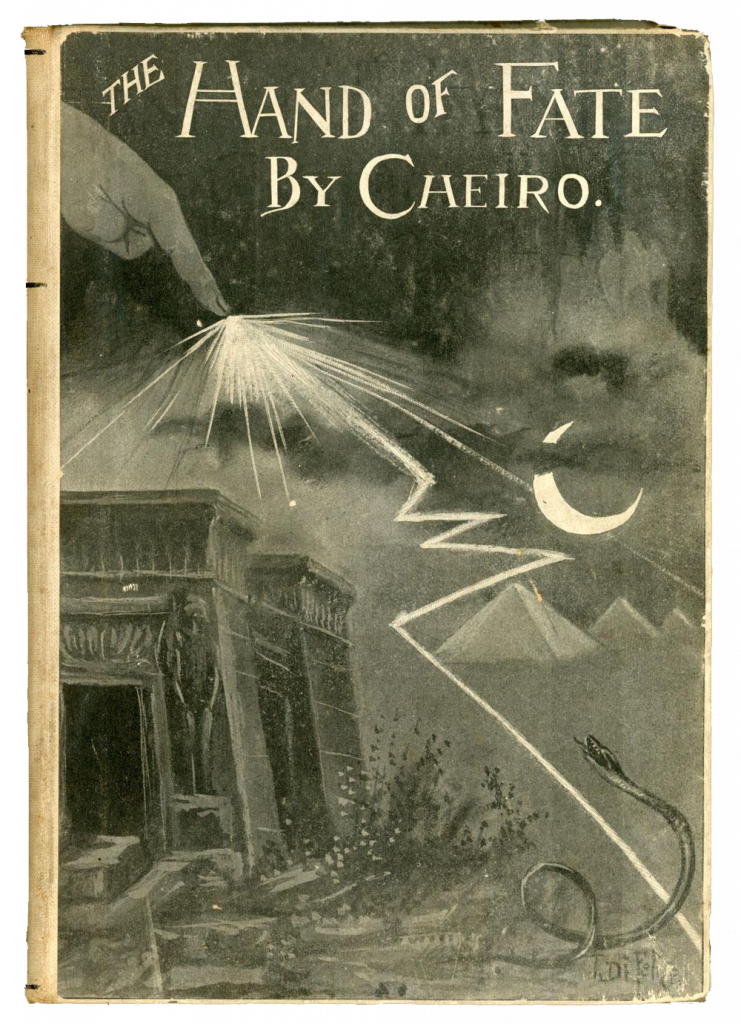
Having provided some background in the curse legends and literary mummy tales of Victorian and Edwardian era, we look at ways in which Doyle’s stories, particularly “Lot 249” might have been an influence on the Boris Karloff film The Mummy from 1932 as well as mummy films of the 1940s through 1960s. A few stray examples from later years are also included.
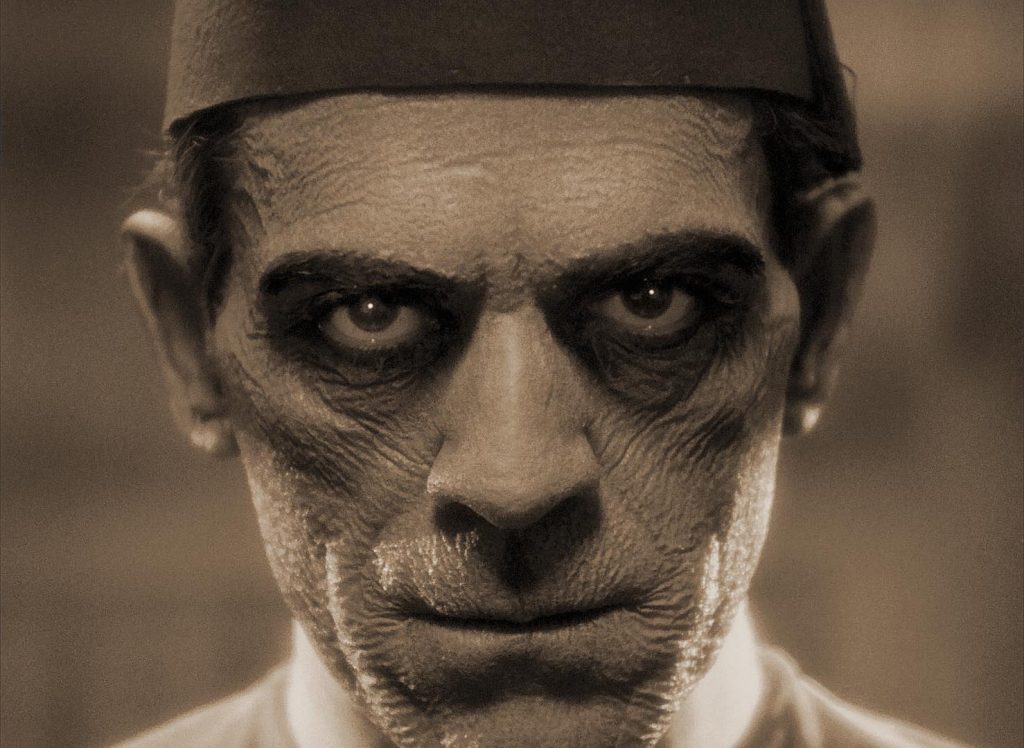
Snippets of two old, Egyptian themed recordings were used in the episode Esther Walker’s “Sahara” from 1919 and “Old King Tut” by Billy Jones and Ernest Hare from 1923.
LISTENER NOTE: Episode Ten is an extra-long deluxe episode wrapping up our Spring-Summer season. Wilkinson and I will be taking off September and returning in October with the folklore of the Fall-Winter season, Halloween, the Krampus, and more. We suggest you check back here, or even better, subscribe, so you know when we’re back.
Episode 9: Cave Witches
In this episode of Bone and Sickle, we’re looking at the folklore and history of witches associated with caves. We begin with the Bell Witch, of Adams Tennessee and a quick audio montage saluting the creature, one based around the eccentric country-western song “The Bell Witch” by Merle Kilgore. Also included are snippets of The Bell Witch, The Movie, The Bell Witch Featurette, The Bell Witch Haunting, Cursed: The Bell Witch “reality” show on A&E, and a bit of Zak Bagans of Ghost Adventures scaring himself in the Bell Witch cave. Just so you know, there is also a Bell Witch ballet. It’s a love story.
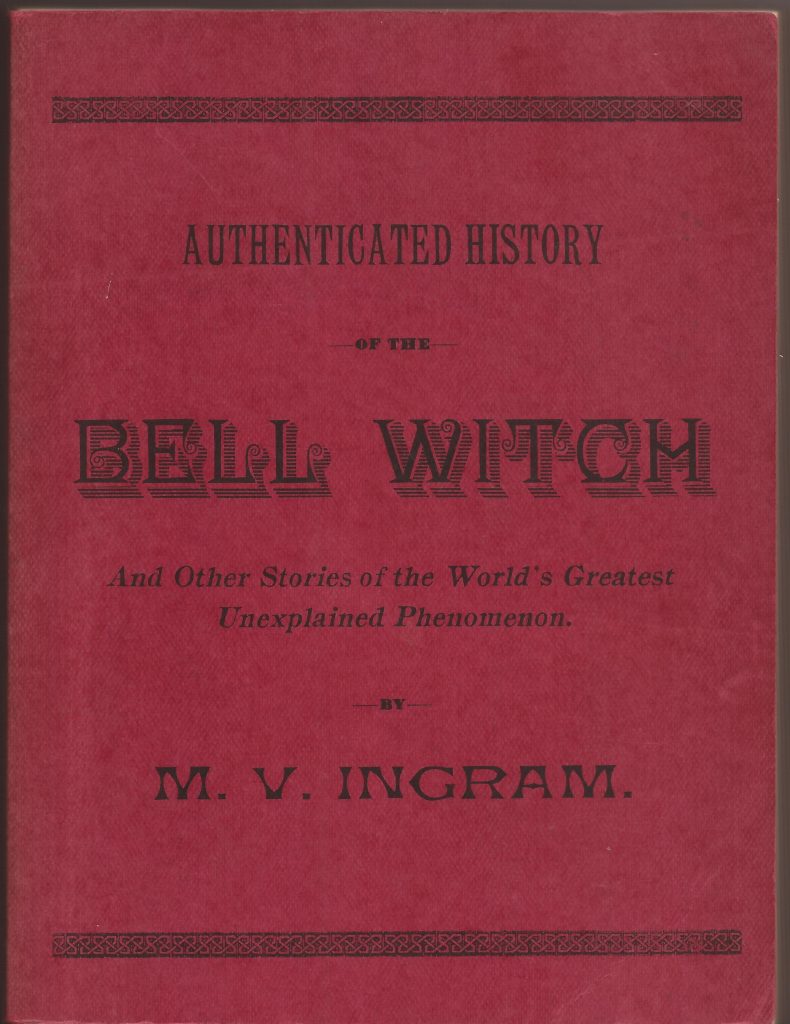
I neglected to mention the source for the original Bell Witch legend. It is An Authenticated History of the Famous Bell Witch, published in 1894 by the newspaper editor Marvin V. Ingram. His source was allegedly a diary kept by John Bell, the primary target of the witch’s animosity, though the existence of this diary has never been independently confirmed.
Next we visit the cave of the 16th-century seer Mother Shipton in Knaresborough, England. Wilkinson provides a dramatic reading of an account of her birth from a 1687 volume, and we learn about the curious wishing well attached to Shipton’s Cave, a geological oddity known for “petrifying” objects hung in its waters, some of which are available through the site’s gift shop. You can read more of the prophecies attributed to Shipton here.
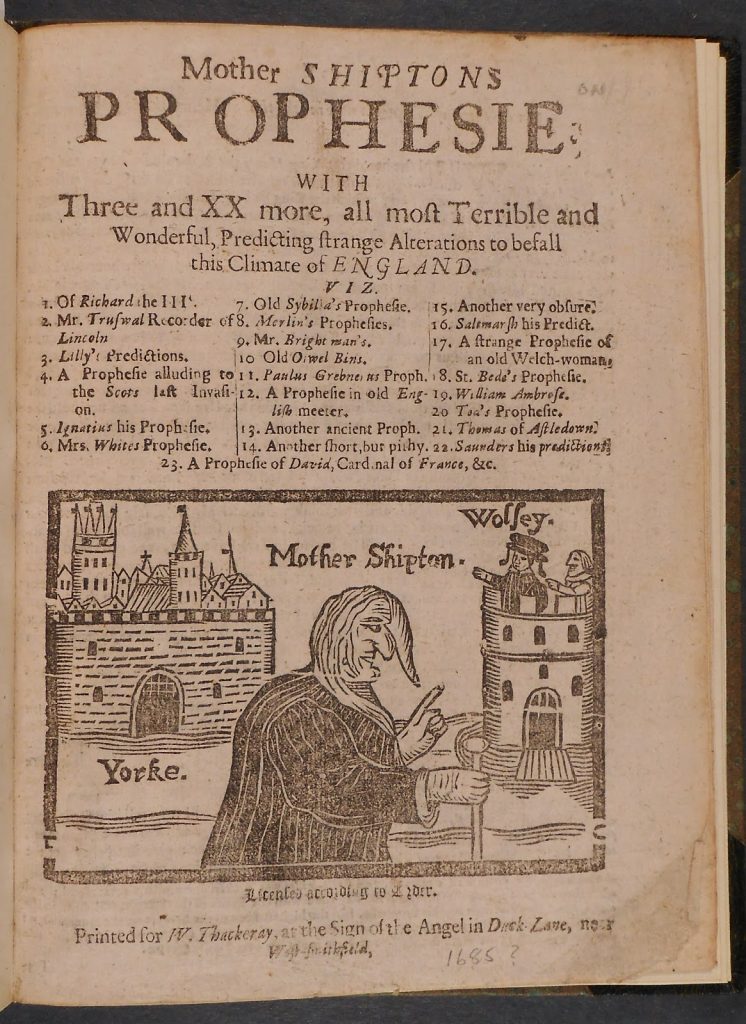 Our next stop in England is the cave known as Wookey Hole about 20 minutes northeast of Glastonbury. Wilkinson reads us a poem from 1748, “The Witch of Wookey” describing how and why a witch formerly haunting the cave was turned into a stalagmite bearing her likeness. We also learn of Leicester’s Black Annis, a monstrous hag said to occupy a cave in the Dane Hills and do terrible things to children.
Our next stop in England is the cave known as Wookey Hole about 20 minutes northeast of Glastonbury. Wilkinson reads us a poem from 1748, “The Witch of Wookey” describing how and why a witch formerly haunting the cave was turned into a stalagmite bearing her likeness. We also learn of Leicester’s Black Annis, a monstrous hag said to occupy a cave in the Dane Hills and do terrible things to children.
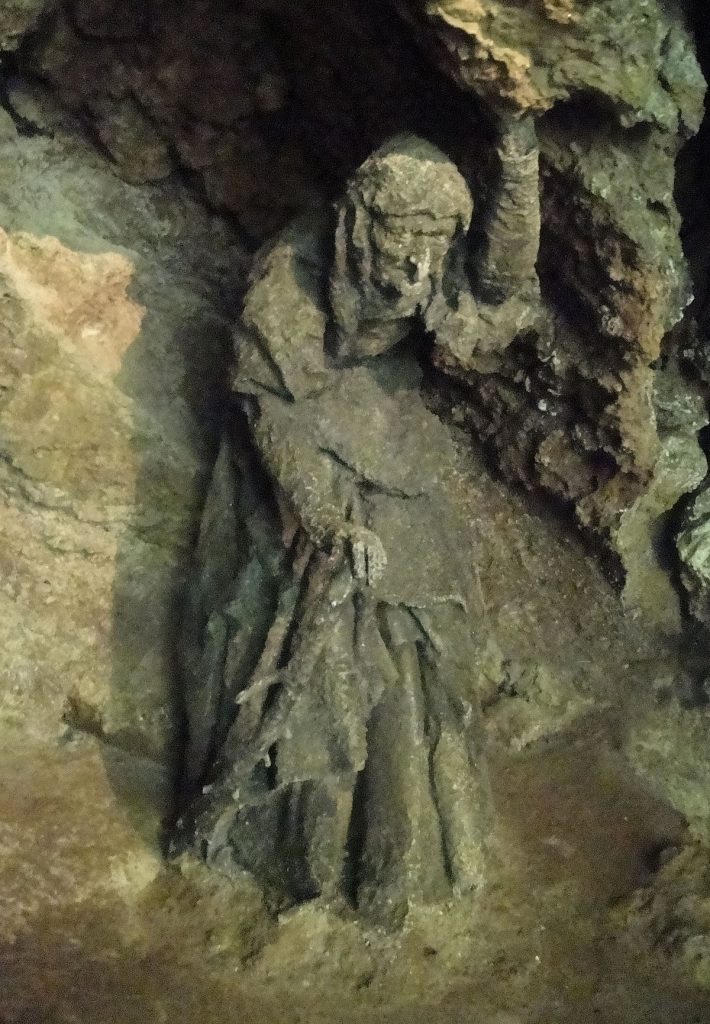
Next we visit the town of Zugarramurdi in northeastern Spain’s Basque region, known for its “Cave of the Witches,” featured in the 2013 horror-comedy The Witches of Zugarramurdi, released to English-speaking audiences as Witching and Bitching. We learn of the world’s largest witchcraft investigation that took place in this town and something of the Basque folklore that may have given the inquisitors their idea of the Devil. The song “Baba Biga Higa,” a Basque witches’ rhyme set to music by Mikel Laboa, is featured as well as music by the Basque folk group Kepa Junkera & Sorginak.
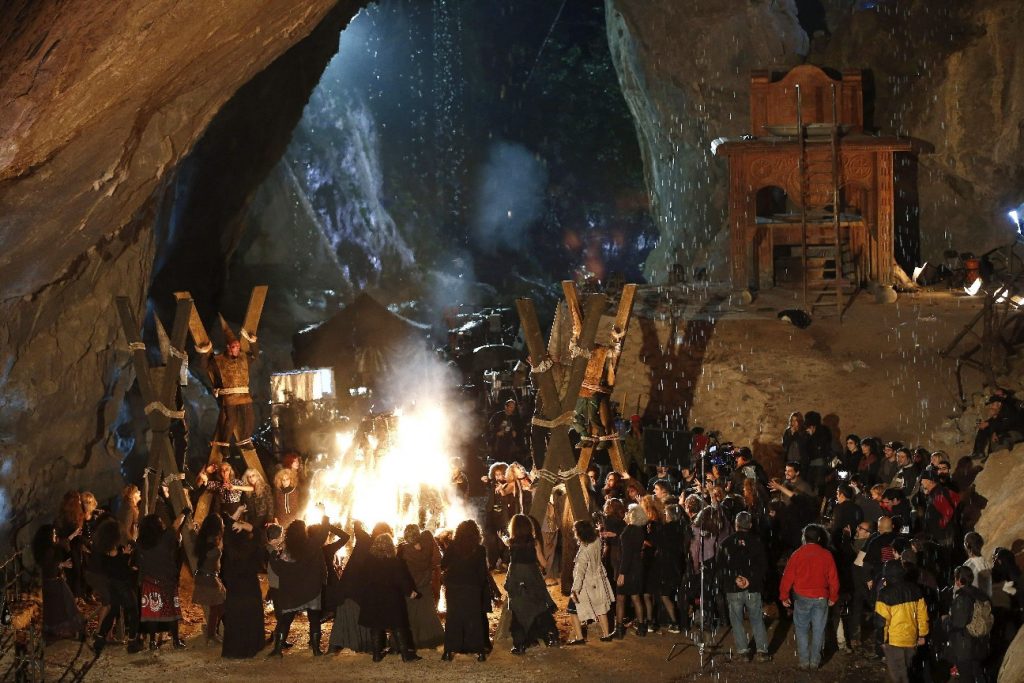
Then it’s off to Italy to learn about the Sibyls, seers rooted in classical mythology and associated with caves. Our first stop is in central Italy’s Appennine mountains where the Sybils of ancient Greece and Rome was transformed into a sort of fairy, occupying an vast underworld entered through a cave on Mount Sibilla. Nearby is the town of Norcia and the Lake of (Pontius) PIlate, sites famous int he Middle Ages for witchcraft. Our story extends a bit to Germany as we learn that the Appenine legend was borrowed into German culture and associated with the minnesinger and knight Tannhauser, whose story was taken up by Richard Wagner in his opera Tannhäuser. in the background of this segment we hear an excerpt from this opera related to the Appenine legend.
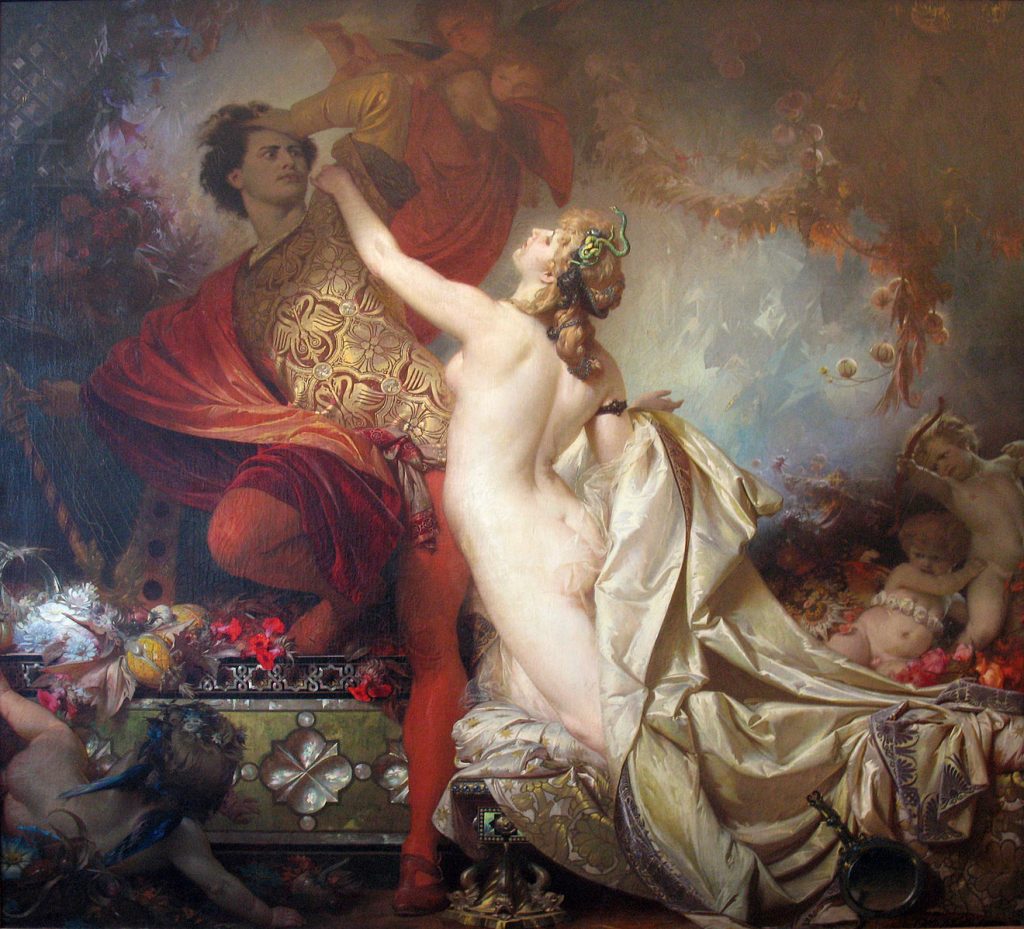
The second Sibyl, associated with a cave near Naples, is the Cumaen Sibyl featured in a story about some hard bargaining over her books of prophecy with the last king of Rome and another about the problem with wishing for eternal life. The Cumaen Sibyl’s cave, described as an entrance to the Underworld by Virgil in his Aeneid, is also near a sinister body of water, Lake Avernus, whose mephitic atmosphere is more than a little harmful to certain mortal creatures who venture too close. There’s also a mention of a rather obscure novel Mary Shelley attempted as a follow-up to her success with Frankenstein. Yes, it also relates to the Cumaen Sibyl and her cave.
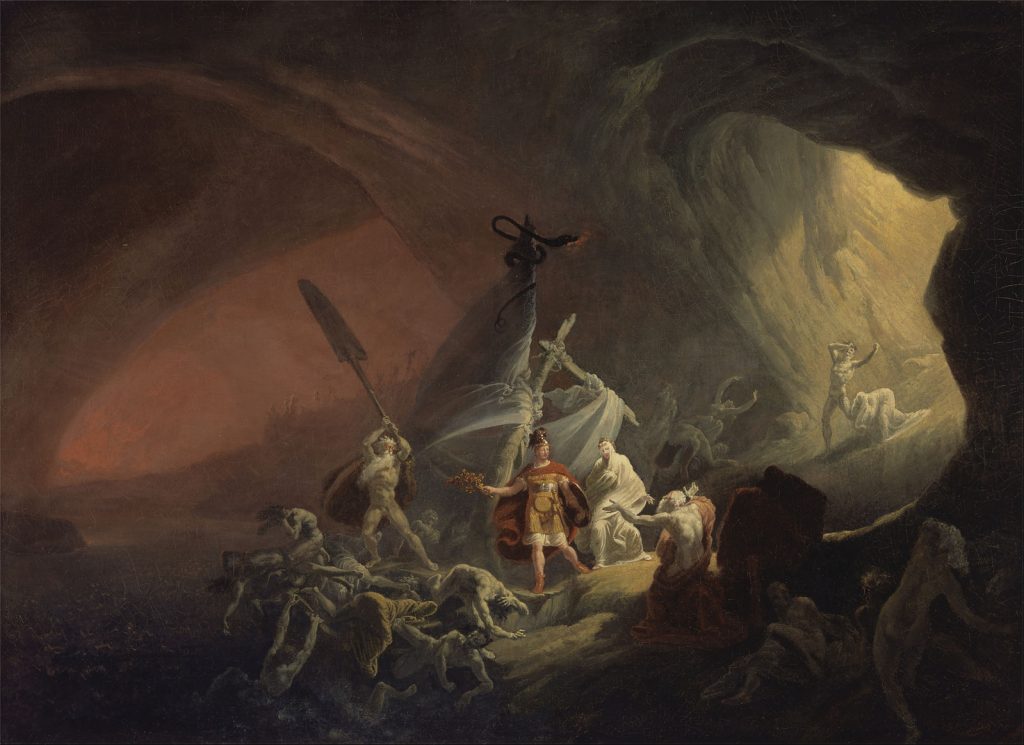
We close the show examining the strange way the prophecies of the pagan Sibyl intertwined with church teachings, and through this weird nexus ended up echoed in the soundtracks to certain horror films.
Episode 8: Dreadful Ships
On this episode of Bone and Sickle, we look at the folklore of ghost ships, undead sailors, some nautical elements in gothic literature, a song about a ship piloted by the Devil, and other horror stories of the sea.
We begin with a little reminiscing about our last show on the Pied Piper and a story by George G. Toudouze that I’d wanted to include but didn’t have space for, “Three Skeleton Key,” It features both a ghost ship and a horde of ravenous rats like those devouring the wicked Bishop Hatto in Episode 7. Clips from a 1956 radio dramatization featuring Vincent Price are included.
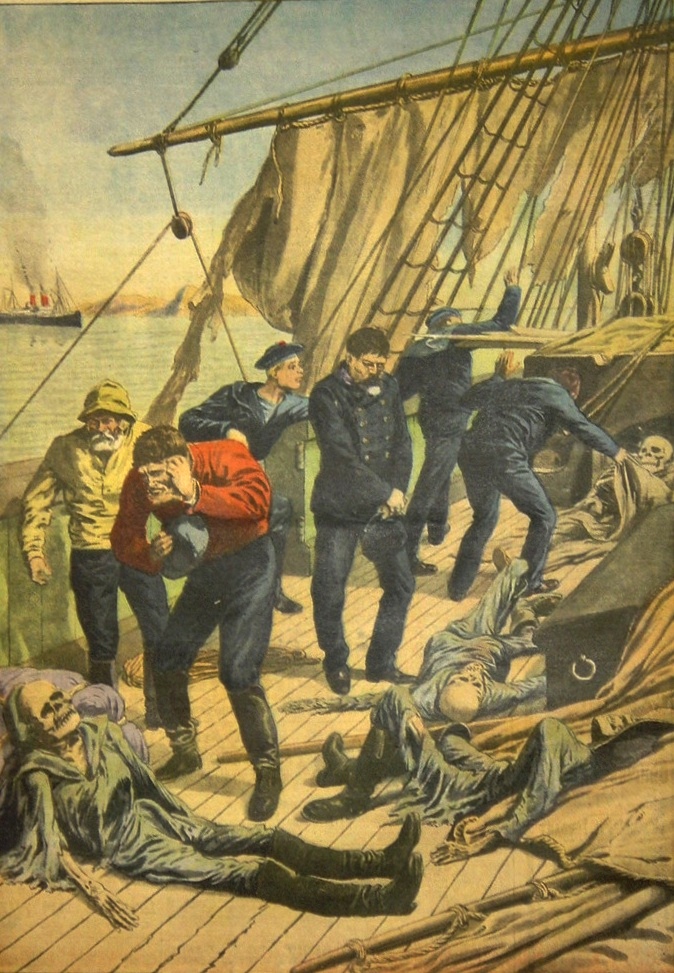
We then take a look at some notorious derelict ships from history, beginning with The Mary Celeste, which entered the popular imagination through a fictionalized account by Arthur Conan Doyle. Ships adrift in the Arctic with frozen crews, a ship cursed by malevolent spirits picked up in Zanzibar, and a ship discovered with its lifeless crew in a particularly grisly state are all discussed.
Edgar Allan Poe, in his only full-length novel, The Narrative of Arthur Gordon Pym of Nantucket, describes a ghost ship in ghastly detail in a passage dramatically interpreted by Wilkinson.
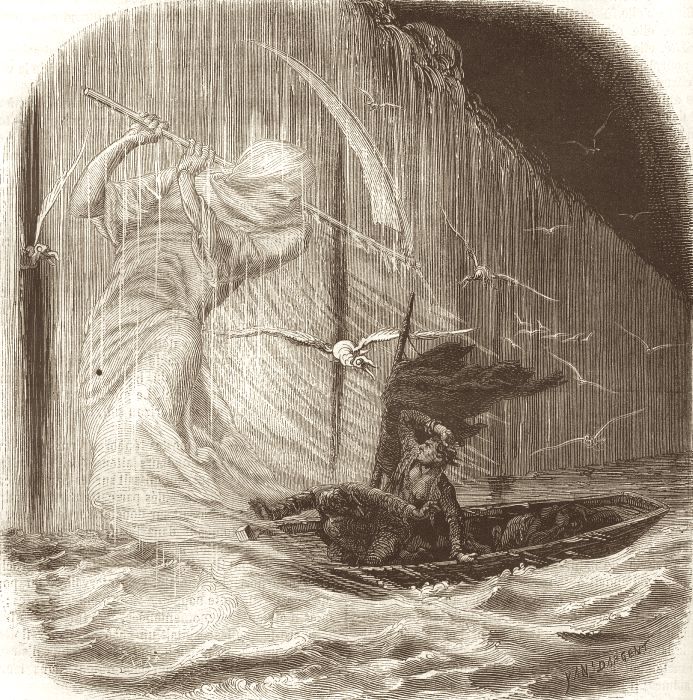
Frederic Dargent, 1862
In between the Edgar Allen Poe passage and my introduction to the Flying Dutchman, you heard a snippet of David Coffin and friends singing the sea shanty “Roll the Old Chariot,” which you can hear in its entirety here.
We then have a look at the lore of The Flying Dutchman, best known as the supernatural ship from the Pirates of the Caribbean films or the opera by Richard Wagner, Wilkinson relates some eerie accounts of Dutchman sightings from surprisingly recent times.
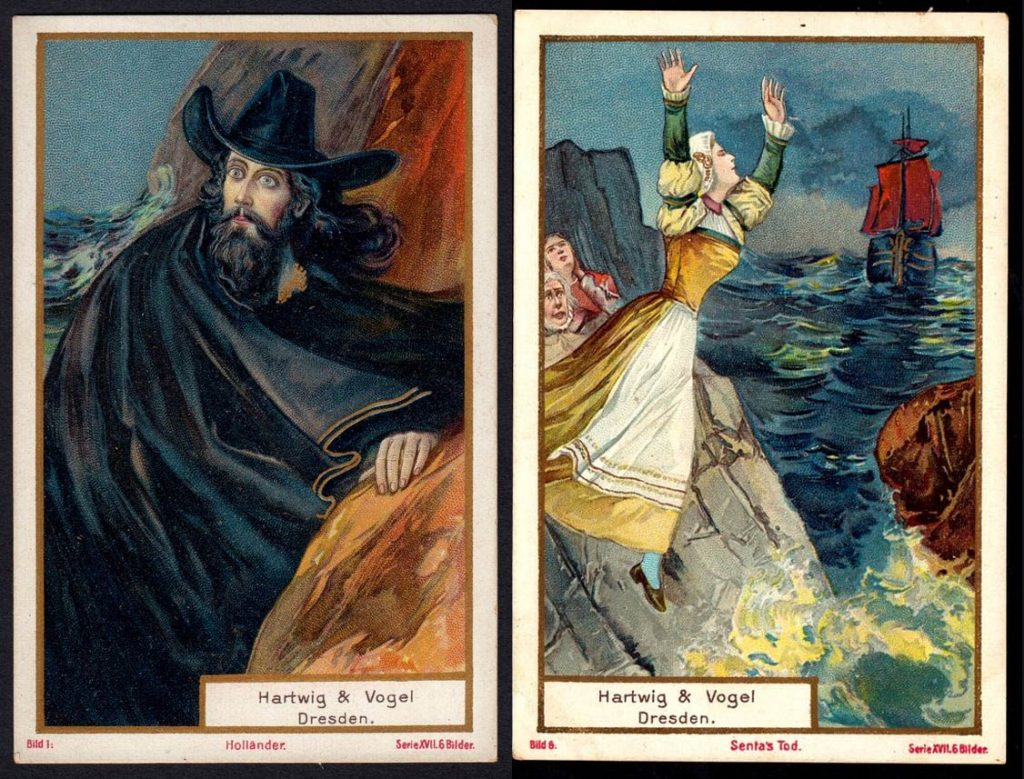
A favorite explanation for stories, in which ghost ship are said to luminesce, is the phenomenon of St. Elmo’s fire, a weird electrical anomaly, which we find showing up everywhere from Melville’s Moby Dick to the laboratory of Nikola Tesla.
Ghost ships are sometimes said to arrive as omens of death, or their appearance may recreate the tragic end of ship and crew. These otherworldly aspects have been noted in mariners’ accounts and served as the basis for a few poems, including a work by Longfellow, which we’ll hear. Along the way, we learn about the Klabautermann, a strange sea-going gnome said to haunt ships on the Baltic and North Seas.
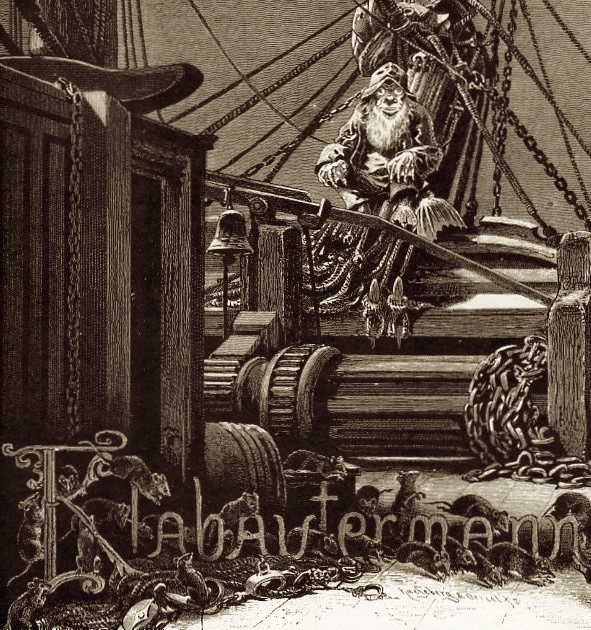
Next, it’s a musical break featuring the 17th-century folk ballad “House Carpenter” also sometimes called “The Daemon Lover.” This tale of demonic jealousy or the Devil’s retribution on the high seas is hauntingly rendered by Appalachian singer Jean Ritchie, Scottish singer A.L Lloyd, and in an instrumental arrangement by Adrian McHenry, and we hear bits of all these versions.
Samuel Coleridge’s epic poem “The Rime of the Ancient Mariner” has often drawn comparison to the Flying Dutchman legend. We have a look at its undead sailors, ominous allegorical figures, and how its arctic setting may have influenced Mary Shelley’s Frankenstein.
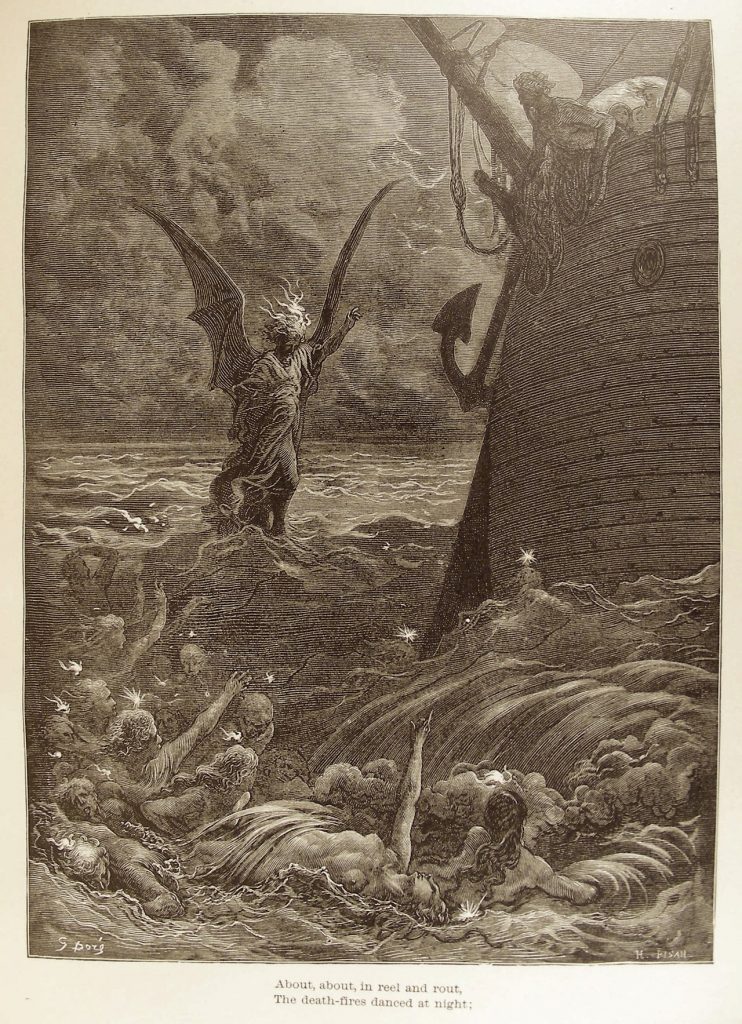
And who would’ve known, but it seems there’s a peculiar link between Bram Stoker’s Dracula and Richard Wagner’s The Flying Dutchman. I work it all out in the conclusion of the episode.

Episode Seven: It is One Hundred Years Since Our Children Left
In this episode, we explore the story of the Pied Piper, a folk tale uniquely anchored in grim historical realities. We begin with evidence of an actual historical mystery, including text inscribed on a gable of one of Hamelin’s medieval buildings as well as the initial 1384 entry in the Hamelin town chronicle, announcing, “It is 100 years since our children left.”
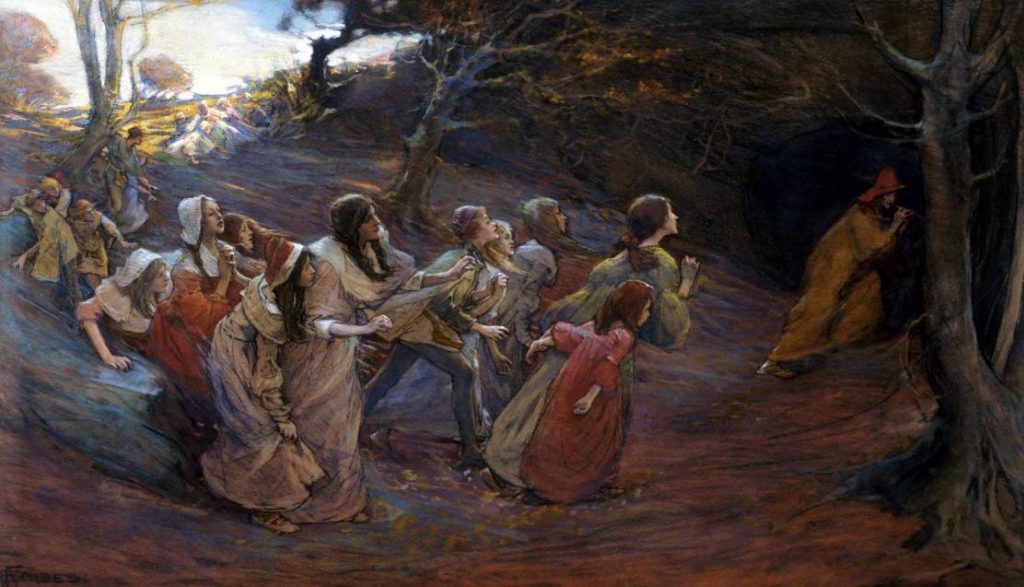
The Piper’s extermination of rats by drowning in them in the nearby river raises a question about rats swimming — which they do quite well — and how swimming rats figure into another German legend, one about the wicked Bishop Hatto and the famous “Mice Tower” located on an island in the Rhine near the city of Bingen. Wilkinson provides a fine reading of an early Romantic poem based on this horrific legend.
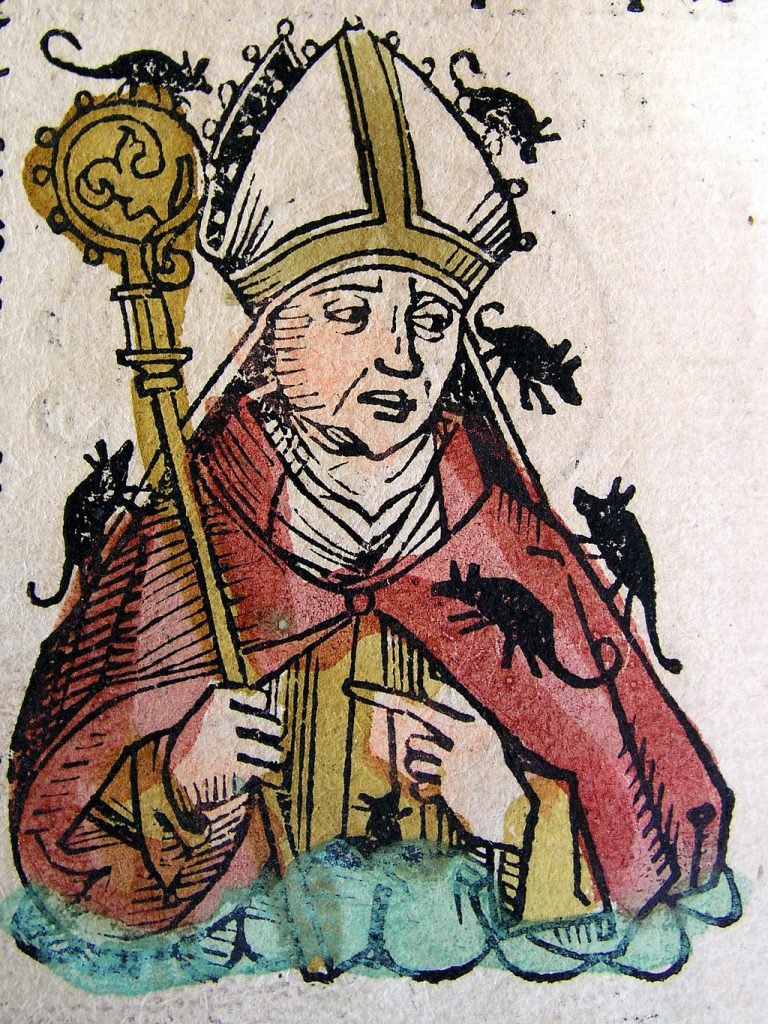
Certain elements of this Hatto story bring to mind the sub-subgenre of rat horror films and its prime exemplars, 1972’s Willard and its 1973 sequel Ben. The 2006 remake of Willard starring Crispin Glover is featured in a special musical confection specially created for this episode.

We then take a side trip to Sweden where we learn of similarly macabre story featuring a mysterious musician leading village youth away to the top of the fabled Hårga mountain. Wilkinson’s reading of the tale is accompanied by the rather well known and rather spooky Swedish folk song by which the tale is known. The Hårgalåten song is popular enough in Sweden to have been covered by everything from metal bands to classical choirs. Our favorite version (heard in this episode) is by Viktoria Tocca.
Next we discuss several of the theories that have been put forward to explain the disappearance of Hamelin’s children in 1284. The Black Death, emigration, and participation in the ill-fated Children’s Crusades of the 13th century are all explored, as well as a recently advance, and more exotic notion about pagan rites and executions around the town of Coppenbrügge, in a swampy area known as the “Devil’s Kitchen, about 30 miles north of Hamelin.
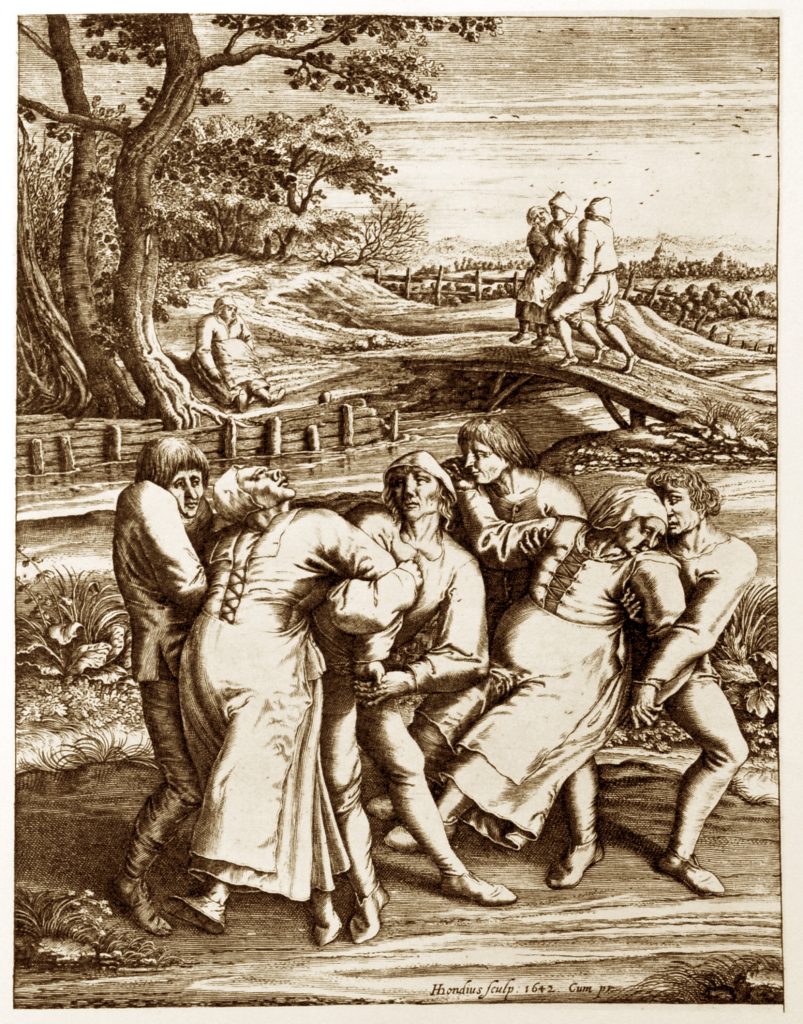
A final theory — if not the best at least one of the more entertaining — explains the disappearance of the Hamelin youth via the medieval phenomenon known as Dancing Plague or Dancing Mania, sometimes also called the St Vitus Dance. We review a bit of its history and symptoms with dramatically rendered passages from Wilkinson, taking particular note of certain ludicrous and destructive extremes as well as incidents like that in the town of Erfurt, Germany, where in 1257 groups of children dancing their out the city gates call to mind the youth in the Piper’s tale.
Similar to the northern European Dancing Plagues is the slightly later phenomenon of tarantism in southern Italy. Named for the “tarantula,” a local spider somewhat different from our own idea of the species, tarantism is a superstitious belief that the bite of this pest can cause bouts of mad dancing and other aberrant behaviors. We recount a few historical examples of these outbursts, including incidents of the tradition all the way up into the early 1960s explored by the Italian scholar of religion Ernesto de Martino in his book and documentary film, La Terra Del Rimorso.
The show concludes with a visit to the delightfully named “Chapel of the Tarantula” in Galatino, Italy.
Episode Six: Lost Heads
As June 24, the feast of St. John the Baptist approaches, the folklore of decapitation suggested itself as an appropriate theme for this episode. We begin by way of an old English children’s rhyme and game, “Oranges and Lemons” based on melody played by the bells of St. Clemens church in London. The rhyme ends with the couplet:
Here comes a candle to light you to bed
And here comes a chopper to chop of your head
Chip chop chip chop the last man is dead
… which should explain our inclusion here. We hear this melody (played by local bagpipers) during a procession in the 1973 folk-horror classic The Wicker Man. In the film,the tune accompanies a mock beheading game that the director borrowed from a traditional sword dance, one particularly well preserved in the south Yorkshire town of Grenoside.
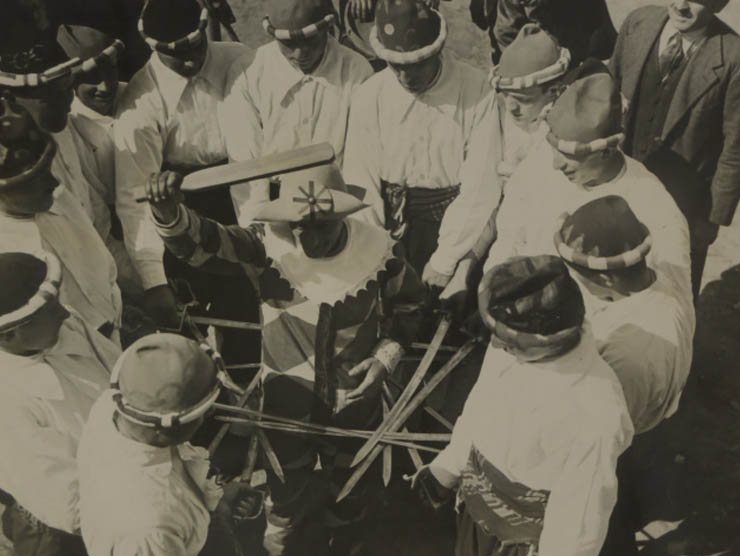
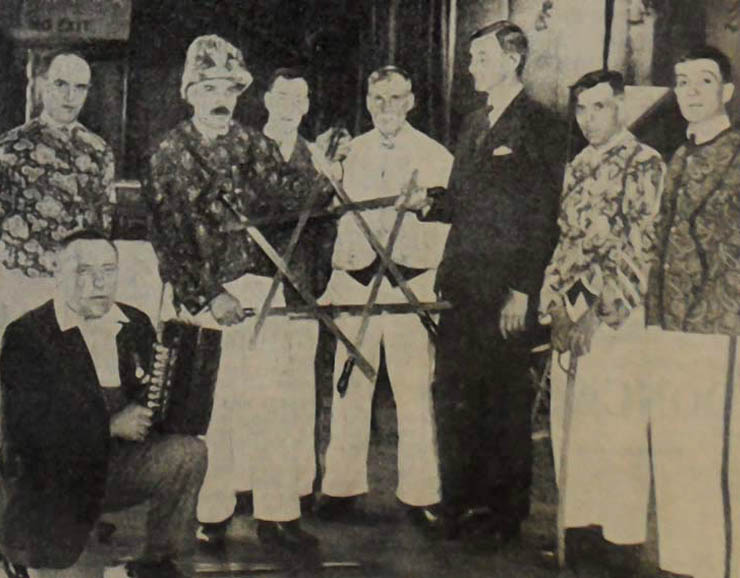
We then review the John the Baptist story, how Salome offers a very pleasing “Dance of the Seven Veils” to King Herod, receiving in gratitude for the performance, a reward of her choosing, Thanks to Salome’s mother, Herodias, the reward chosen is the head of John the Baptist’s. We learn a bit more Herodias, and hear a delightful tale (or tales) of divine punishment she received as well as her late medieval association with the folklore of witchcraft.
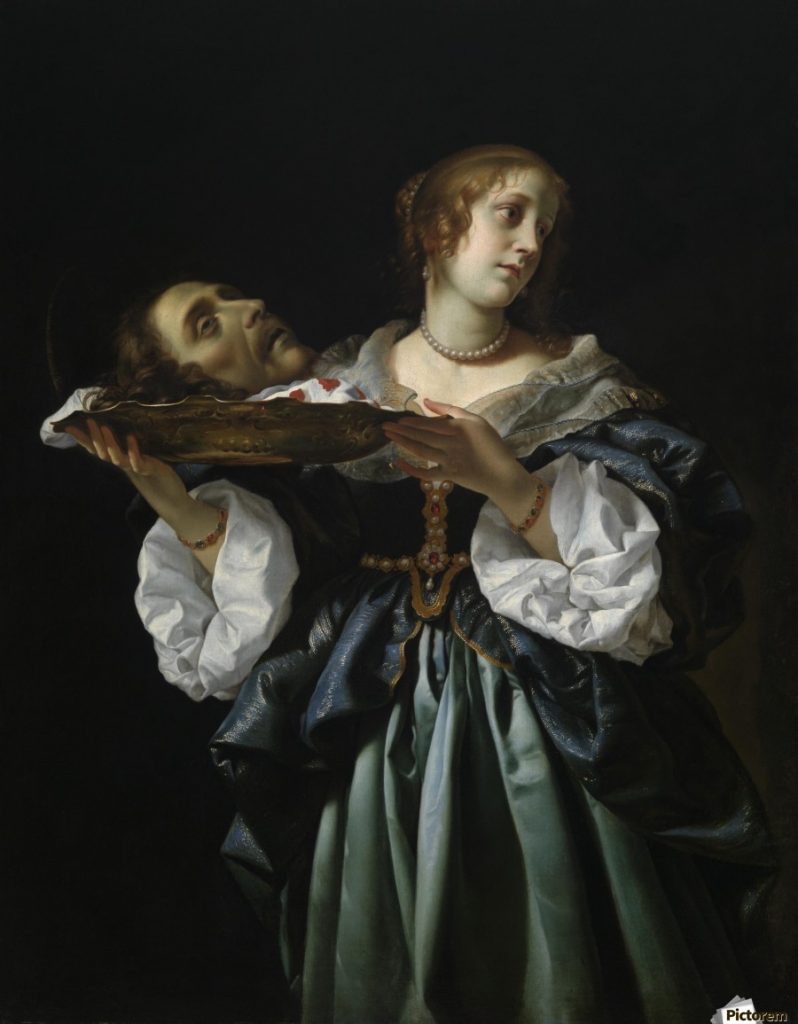
Next we move on the to the discussion of cephalaphores, or saints who suffer decapitation but stubbornly refuse to die, instead traipsing about holding their severed heads. We discuss the cephalaphores St. Denis, St. Edmund (who’s head was guarded by a remarkably tame wolf) and St. Winifred, better known for her holy well.
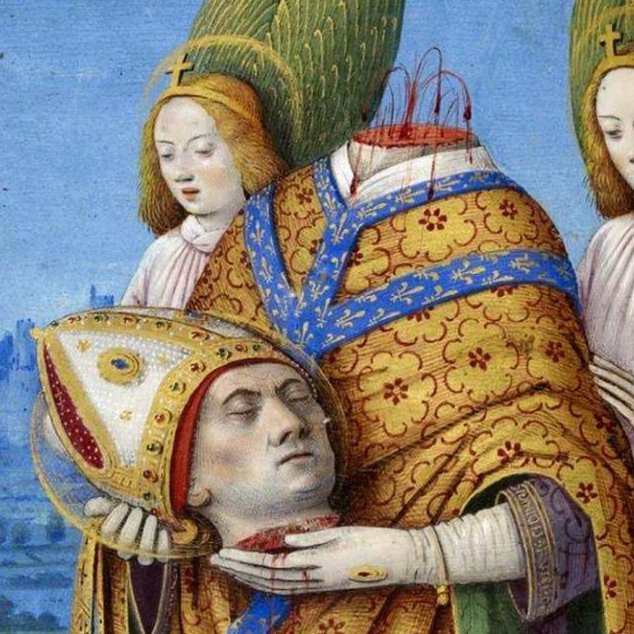
As it turns out, holy wells, which are particularly prominent in Wales, are also associated with severed human heads — more often than one might expect. Some examples and a likely a explanation are offered, and we learn which holy well until recently afforded the visitor the opportunity to employ a saintly skull as a dipper.
Wouldn’t you know it but the topic of magic wells and heads somehow brings us back to The Wicker Man as we learn about a connection between a song in the film and a fairly obscure Elizabethan drama rich in songs, spells, and fairy stories.
We then return to head-chopping games, and one suggested by a mysterious green stranger who appears at King Arthur’s Christmas feast in the tale of Sir Gawain and the Green Knight. Also mentioned is a cinematic treatment of the tale, 1984’s Sword of the Valiant, featuring Sean Connery in an outlandish costume that almost gives his wardrobe in Zardoz a run for its money.
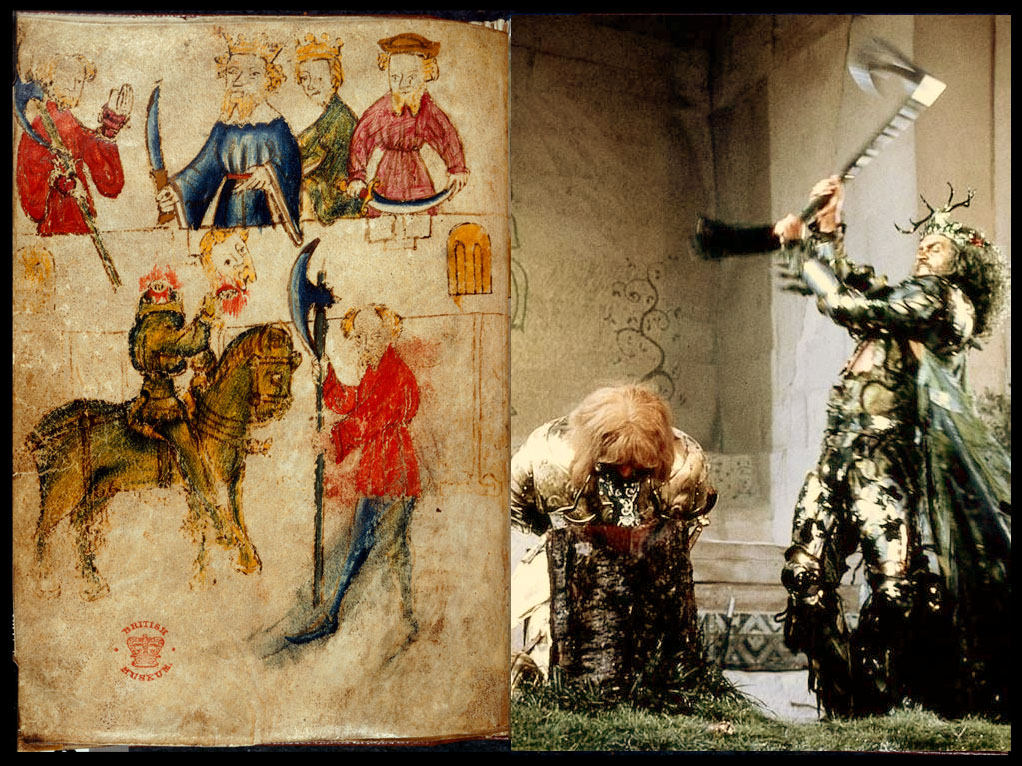
Even though it’s already well known, it seemed wrong to omit Washington Irving’s The Legend of Sleepy Hollow and its headless horseman. Wilkinson seemed particularly eager to discuss it, so we leave that to him (with more than a little help in the sound effects department.)
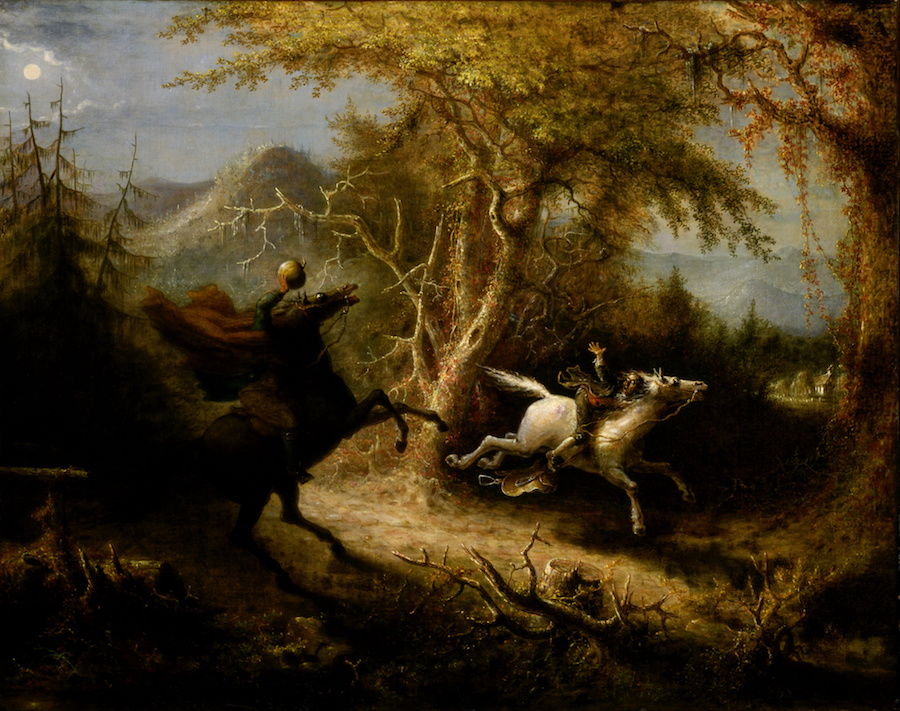
Scotland offers our next two stories, one which tells of a sort of headless horseman of the Highlands (and some fortune-telling butter) and the other of Mary Queen of Scots badly botched beheading.
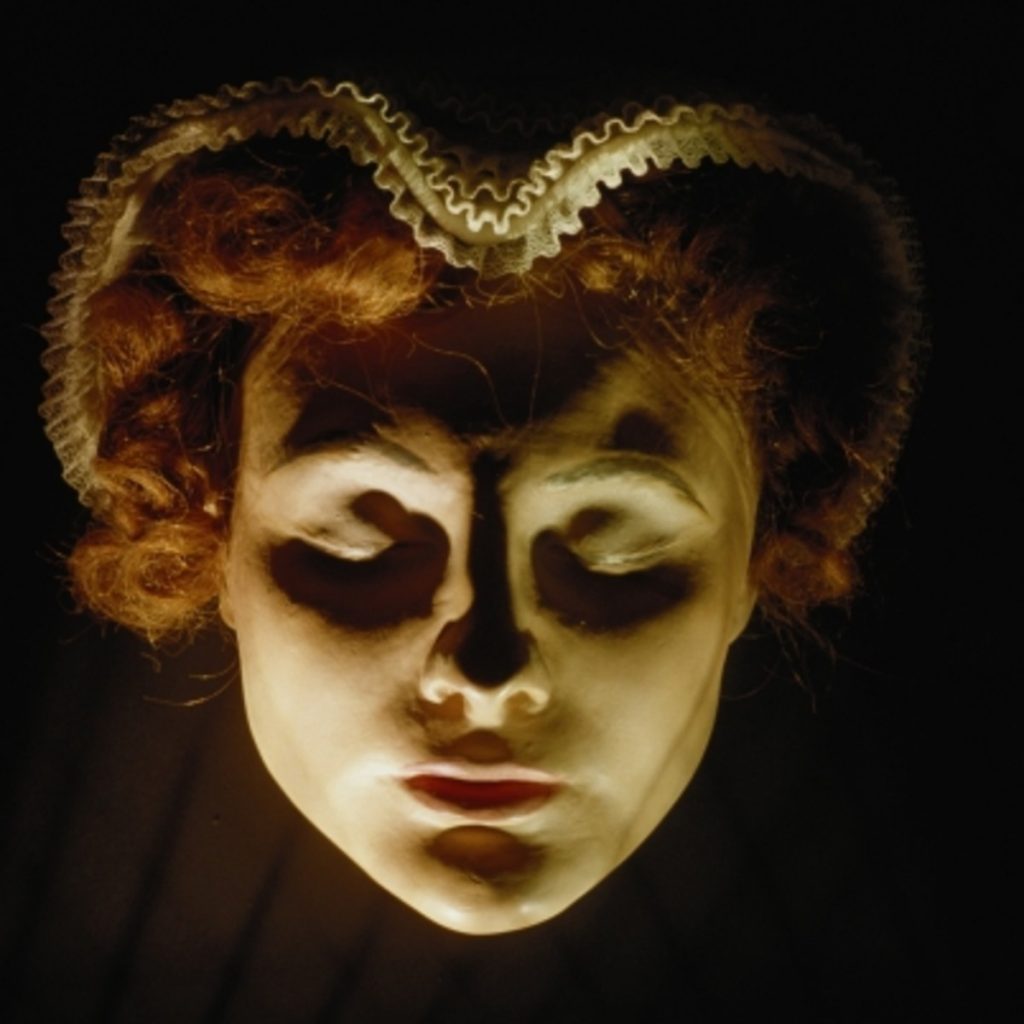
Then it’s back to Wales for the story of Bran the Blessed, a mythological king, whose (not quite dead) head was quite the entertainer and ended up buried under the Tower of London once it shut up. The execution of Anne Boleyn also gets a nod with macabre ditty from 1934 about her headless ghost.
If you find yourself horrified by the obsession with heads and head-chopping in these Celtic nations, you are not alone. Classical writers also were appalled by decapitation fixations of the northern tribes. We hear some choice words on the subject, read by Wilkinson. We also learn about a bizarre super-weapon employed by Celtic warriors — “brain balls” — and how they figure into a story of a newly converted Celtic chieftain.
The Germanic tribes too had a loose head or two in their mythology. Hear the story of Mimir, whose decapitated head Odin preserved and relied upon for counsel.
We close the show with some talk of magicians (an alchemist and a supposedly wicked pope) who created their own “brazen heads” intended to likewise offer advice or prognostication.
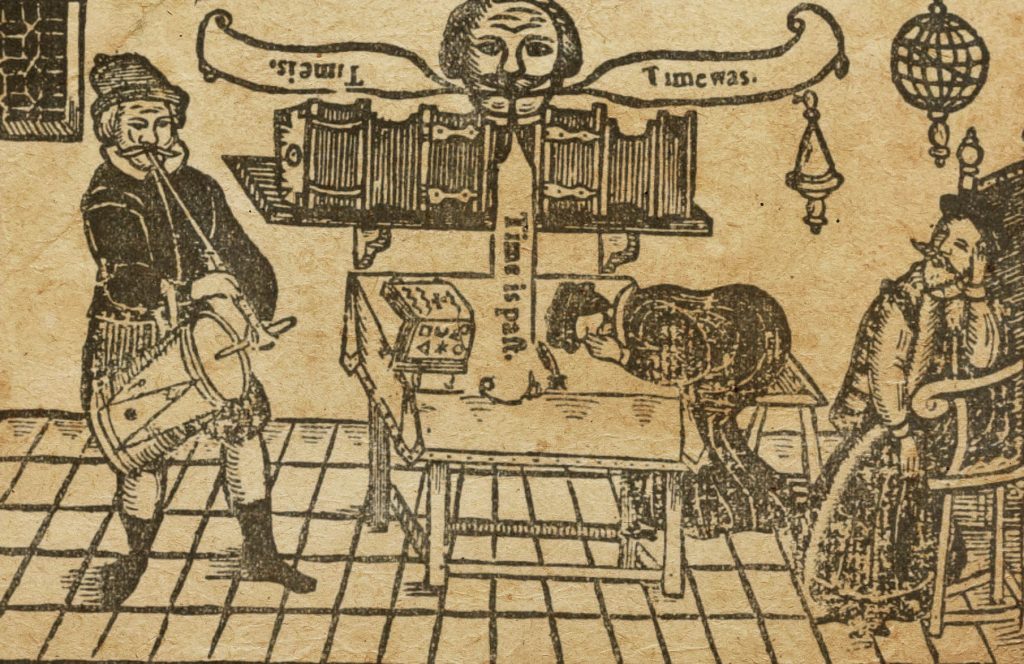
Episode 5: The Great God Pan
We follow our previous episode on the god Pan with a second this week, delving even deeper into the creative and bizarre ways the figure has been embraced after his much publicized “death.”
Our first several minutes are devoted to literary explorations of Pan in the decades around World War I. Naturally we examine only writers providing the more fantastic or horrific examples, including the creator of the high fantasy genre Anglo-Irish writer Edward John Moreton Drax Plunkett, the 18th Baron Dunsany (aka Lord Dunsany). In The Blessings of Pan, he imagines ancient rites to Pan resurrected in the England of his day. If you like what you hear, you might want to have listen to another one of his stories narrated by Vincent Price here.
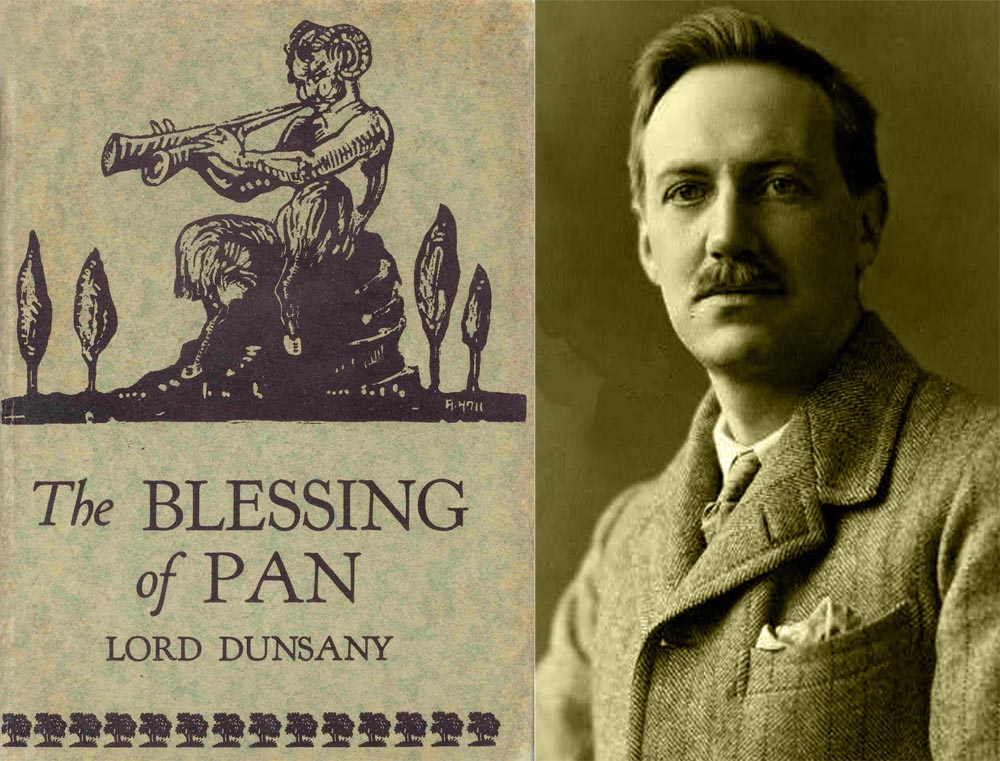
Wilkinson also provides us a reading from “The Music on the Hill,” by writer Hector Munro, who wrote under the name “Saki”. There is a spoiler in the reading, but it’s pleasingly grisly. We make up for the spoilage by providing you this additional unsettling, darkly comic (to us) story by Saki, one in which a defiant young boy decides to provoke his caretaker by creating a religion around his ferret, whom he names “Sredni Vashtar.” As it turns out, the ferret proves to be a dreadfully vindictive god.
But I digress.
As it turns out, the idea of a return to pagan Pan worship in the Christian era written about by Dunsany and others, may be more than simply a matter of fiction. Our next segment deals with such a case. In 18th-century England, in the town of Painswick, England, a member of the gentry, one Benjamin Hyett, was known to have built “an Arcadian retreat” featuring a building known as “Pan’s Lodge.” You can have a look here at a contemporaneous painting of the lodge grounds and Hyett’s statue (one of two — the other met a curious fate).
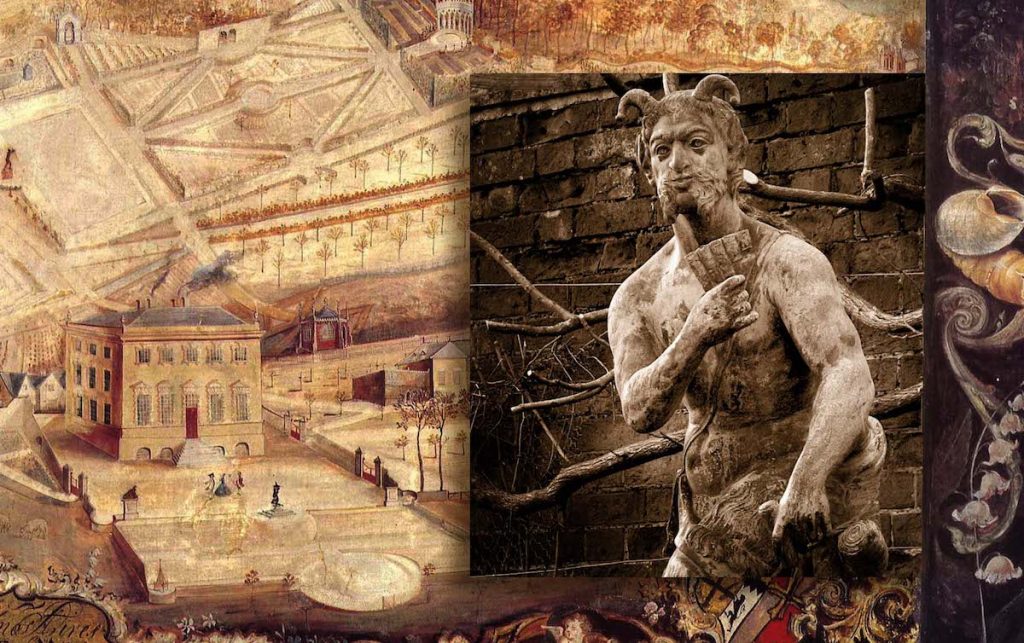
Hyett eventually brought the entire community around to join in these rites to Pan. The story grows more complex and curious as these rites are resurrected roughly a century later by a priest who, as we learn, had some intriguing notions about their meaning and origin. Entangled within this story are other local oddities of Painswick culture, including a dish known as “Puppy Dog Pie,” and a practice known as “clipping the church” or “church clipping,” in which members of the congregation join hands and perambulate their place of worship.

Somehow we then arrive at the topic of Lupercalia, the Roman festival involving priests dressed in nothing chasing the Roman woman through the streets with whips. Oddly enough this topic brings us back to Arcadia, home of Pan.

Lupercalia brings us to some interesting myths and tales related to the Arcadian festival Lykaia and King Lycaon, whom Zeus transformed into a wolf (history’s first werewolf, some would say.) Find out what loathsome act drove Zeus to take this action as Wilkinson provides another excellent reading from Ovid.
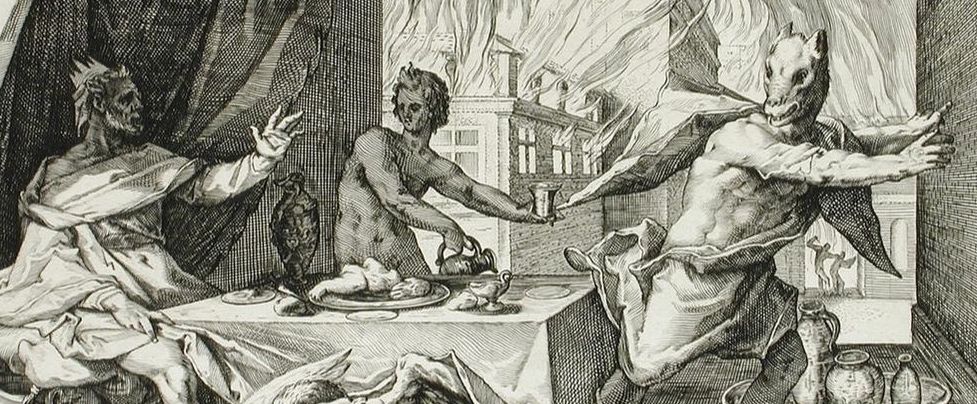
A bit more ancient Greek werewolf lore, a ghastly story about Pan and his ill-fated pursuit of the nymph Echo, and we end up — of all places — on Summerisle, that is, talking again about The Wicker Man, as we are wont to do. Somehow, the Wicker Man leads us back to Pan. You’l have to just trust me on this.
Benjamin Hyett, was not alone in resurrecting the notion of Pan worship. We find religious devotion to Pan and other pagan nature spirits (as well as inexplicably thriving vegetables) at Northern Scotland’s Findhorn Community. Some clips from a 1973 BBC show make clear their roots in the hippy culture of the era, giving us a bit of background before we meet Findhorn’s primary acolyte of Pan, Robert Ogilvie Crombie (aka ROC). His encounters with Pan in 1970s Edinburgh bring up an interesting point about the difficulties of directly encountering Pan. And naturally, this brings us to our next and final topic.
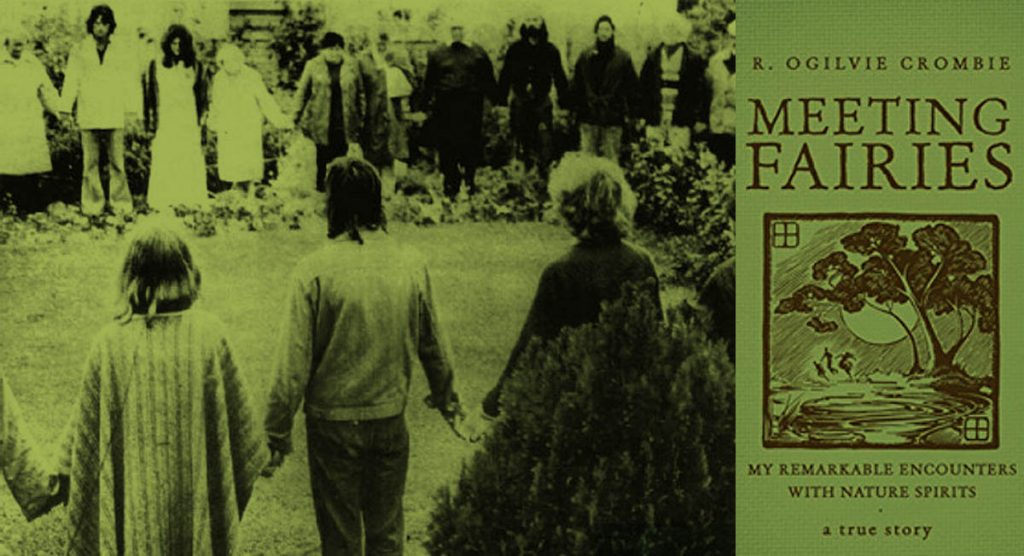
Arthur Machen’s 1890 horror novel, The Great God Pan was highly influential not only to Lovecraft, but other writers in his circle, and in general on the genre variously identified as “weird fiction” or “cosmic horror.” Neil Gaiman, Guillermo Del Toro, and Arthur C. Clarke have all praised the story. Stephen King has called it “one of the best horror stories ever written. Maybe the best in the English language.”
Once again Wilkinson provides a couple readings of wonderfully morbid passages from the book complete with the usual Bone and Sickle audio ambiance.
We go out with the song “The Great God Pan” from the soundtrack to Mondo Hollywood, a 1967 a documentary in the “mondo” style presenting a mix of LA celebrities and countercultural oddballs, heavy on the oddballs.
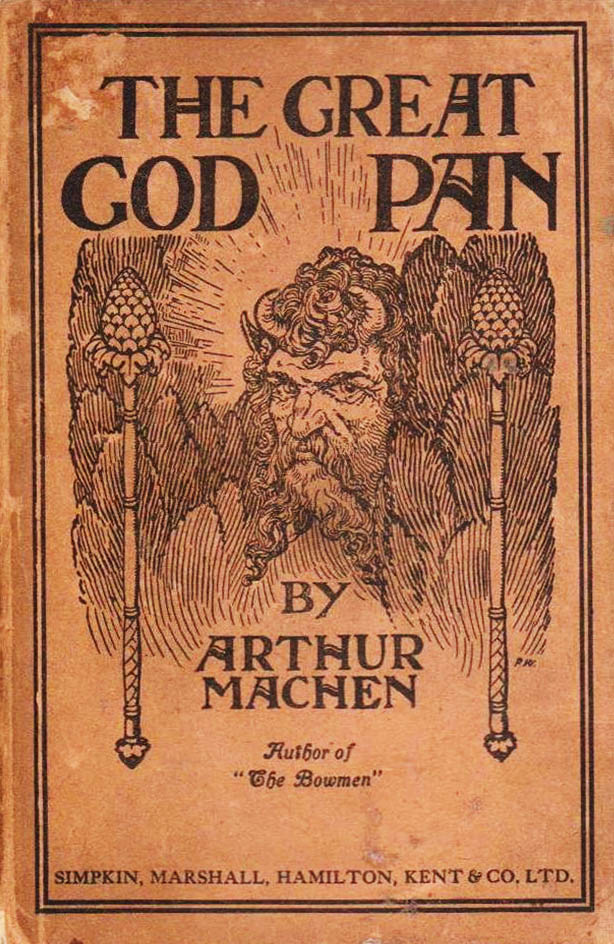
Episode 4: Crowley in Neverland
The devilish appearance of the Greek god Pan has fascinated artists, occultists, and others straying from the path for centuries. This episode begins with some tales of Pan in his natural habitat of Arcadia, how the Greeks, and later Romans, saw him, and some of his central myths — what tragedy resulted in the creation of panpipes and what did that naughty “happy to see me” phallus signify? And his much publicized death during the reign of Tiberius Caesar; what did that mean to the evolving Christian world?
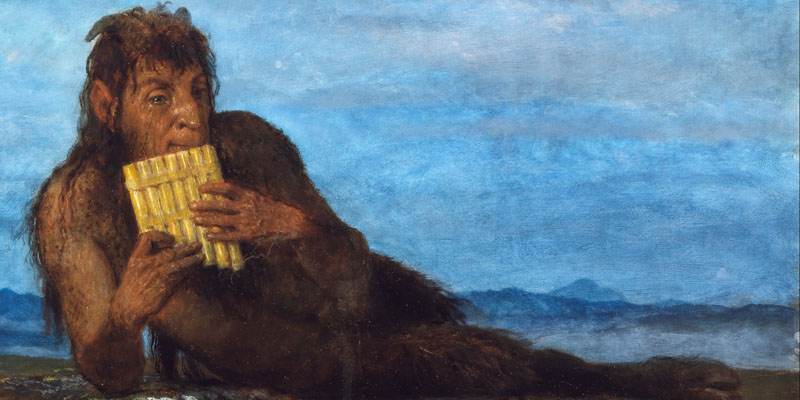
Like Mark Twain, said of his own demise, reports of Pan’s death seem greatly exaggerated.
The Romantics embraced Pan as a symbol of a lost but harmonious pastoral past, while figures in the 19th-century Occult Revival began to celebrate him in a different way, one based, on similarities between Pan and the iconography of the Christian Devil. Tracing the figure of Satan directly back to Pan, however, presents difficulties — including technical difficulties in this episode. We apologize for any disruptions and are working to ensure that our production process in future offers more robust resistance to demonic influence.
The culture of the Victorian and Edwardian era was particularly obsessed with Pan. A particularly sinister example of this would be found in Aleister Crowley, who declared his “Hymn to Pan” the “most powerful enchantment ever written.” We learn its dark origins, a scandal it caused at the Great Beast’s funeral, and even have a listen to a snippet — a rare and dramatic recording made in 1987 during aThelemic ceremony in which Pan is invoked using Crowley’s text.
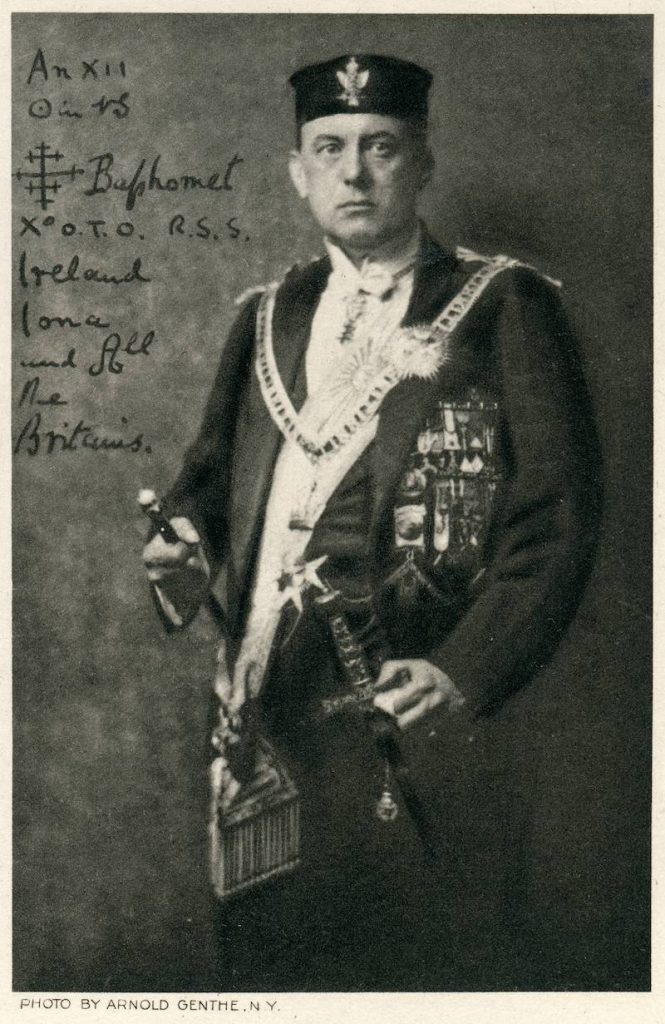
Also discussed is Pan’s role in Wicca and his relationship/rivalry with Cernunnos and Herne the Hunter, as well as the influence individuals like the writer Margaret Murray and Wicca’s grandaddy Gerald Gardner exercised on this.
We lighten up a bit with the story of the eccentric “Priest of Pan” from the town of Millinocket, Maine, and how he made the news in 2016.
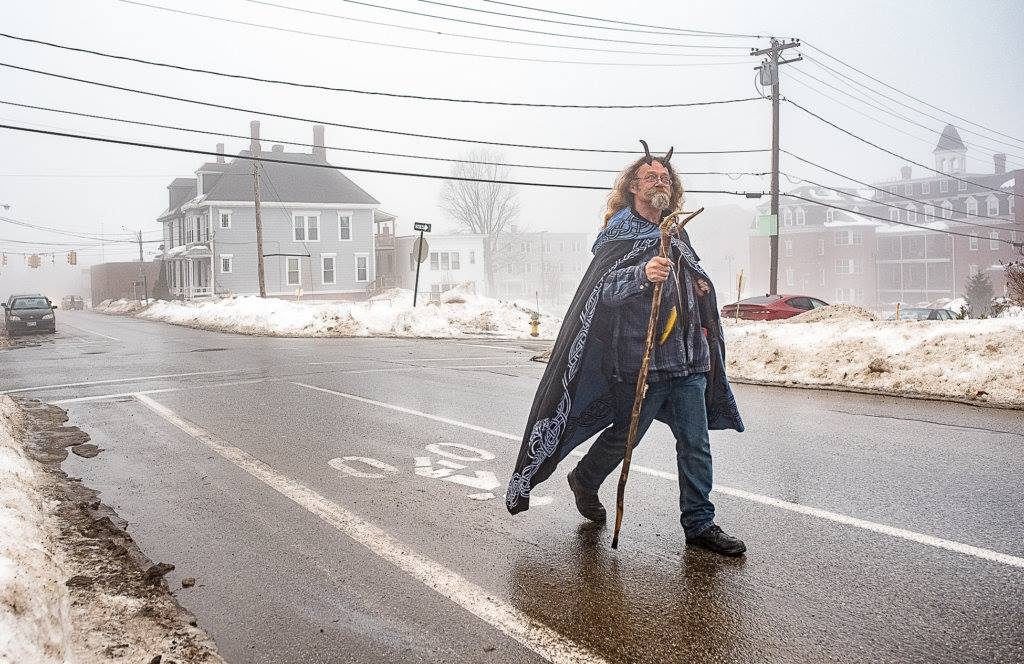
On the other side of Edwardian culture there were writers like J.M. Barrie, creator of Peter Pan and Kenneth Grahame (Wind in the Willows) who exhibited a more benign fascination with the the pagan god. But even here, we trace some dark roots.
We’ll also learn something of H.P. Lovecraft’s childhood devotion to Pan and other Greek gods. Somehow Lovecraft seems to hover around the fringes of this episode, and particularly the next.
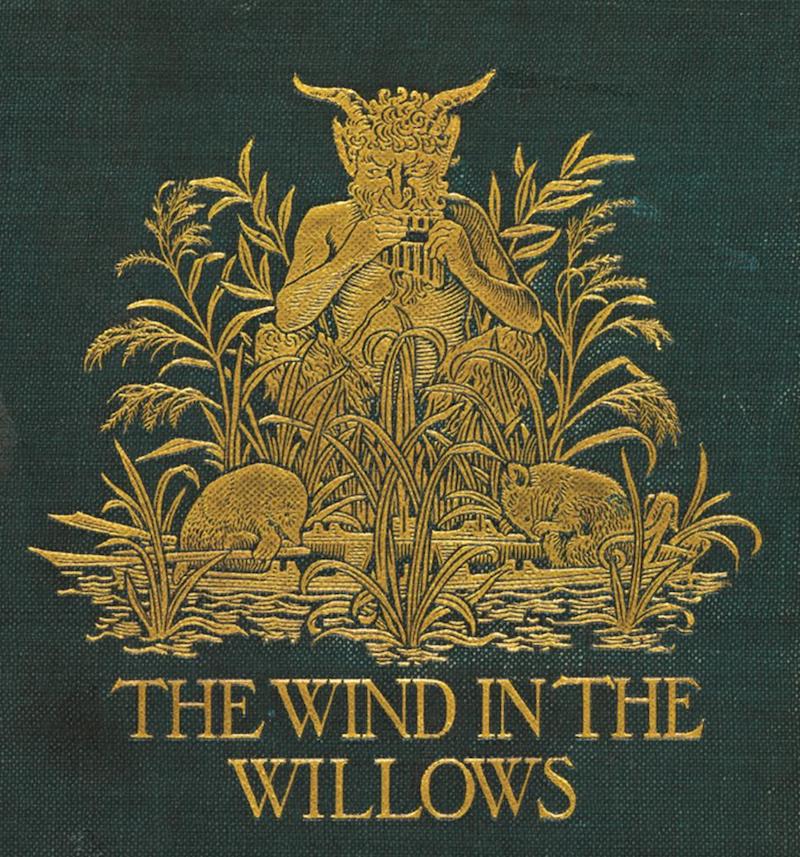
Finally we arrive in Neverland with a brief exploration of J.M. Barrie’s Peter Pan, learning something of the troubled life of the author who gave birth to the character.
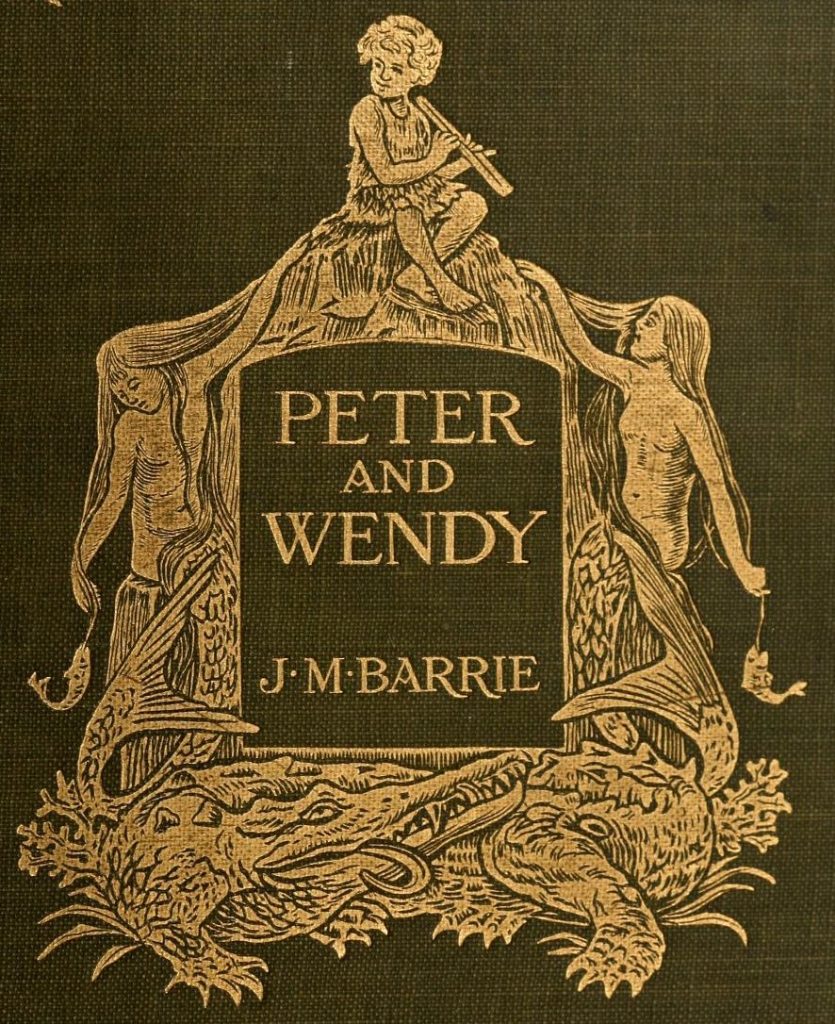
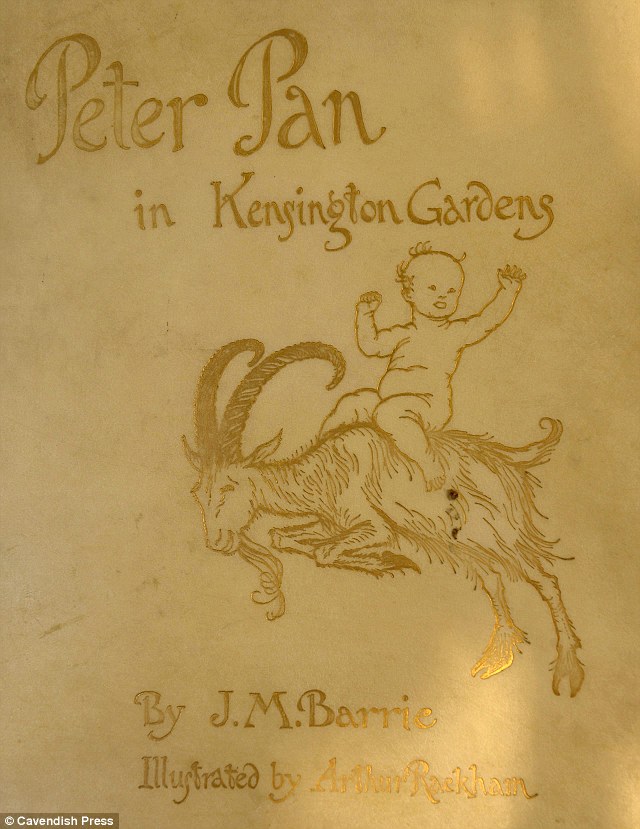
We end the show with something creepy, some news reporters talking about a haunted bridge in Kentucky. Yes, it has something to do with Pan. A bit.

A NOTE ON MUSIC: The music you hear beneath the narration on “Bone and Sickle” consists almost entirely of original compositions. In this and the following episode, however, you may hear a percussion loop sampled from — LVDI SCÆNICI (“Ludi Scaenici” or “stage games”), an interesting Italian group recreating the music of ancient Rome. Listeners may enjoy checking out more of their work, such as this video of one of their performances.
Episode 3: Loudly Sing Cuckoo!
After two episodes meandering about in the nocturnal folklore of Walpurgisnacht witches sabbaths, we’re inviting our Bone and Sickle friends out in the daylight for a celebrate the arrival of Spring. Not to worry, there’s still human sacrifice in the air, as we begin the show looking at that pre-emininent example of the folk-horor genre, and what’s been called “cinema’s greatest pagan horror musical,” Robin Hardy’s 1973 film, The Wicker Man.
In a curious counterpoint to the ghastly deed unfolding in the film’s final scene, the villagers of Summerisle sing a rather cheery song associated with Beltane, or the coming of summer, for which Beltane, in the Celtic calendar, is the first day.
The 13th-century song, “Sumer is a-cumin in” in modern English:
Summer has arrived,
Loudly sing, cuckoo!
The seed is growing
And the meadow is blooming,
And the wood is coming into leaf now,
Sing, cuckoo!
The ewe is bleating after her lamb,
The cow is lowing after her calf;
The bullock is prancing,
The billy-goat farting.
Again with the farting goats! Listeners to our Walpurgisnacht episode will remember, the farting goats and witches from Goethe’s description of the witches’ sabbath on the Brocken in Faust. Perhaps farting goats will become a theme for this show. Please forgive the short, stinky side trip into this digression where we note the real world dangers associated with the issue as well as a popular YouTube video on the theme.
https://youtu.be/K9V5wzWv6gM
Also, speaking of things for which we might apologize, listeners should be warned that there is some unpleasantness regarding Wilkinson the Butler and his new spring suit at the beginning of this episode. You may want to skip past all that if such things offend.
Finally we do come round to our actual topic, the cuckoo in folklore, and Wilkinson is kind enough to read us some quite interesting superstitions associated with the bird’s arrival in spring from an edition of The Gentleman’s Magazine published in London in 1852.
And then a lovely folk song about the cuckoo with some some tragic themes and variations.
A curious line in the song about the cuckoo “sucking eggs,” is explained in epic detail as Wilkinson narrates an an extremely grotesque episode from the bird’s natural life cycle, reading from On Nature’s Trail: A Wonder-book of the Wild written in 1912.
Then the odd association between cuckoos and certain themes in Science Fiction is briefly addressed.
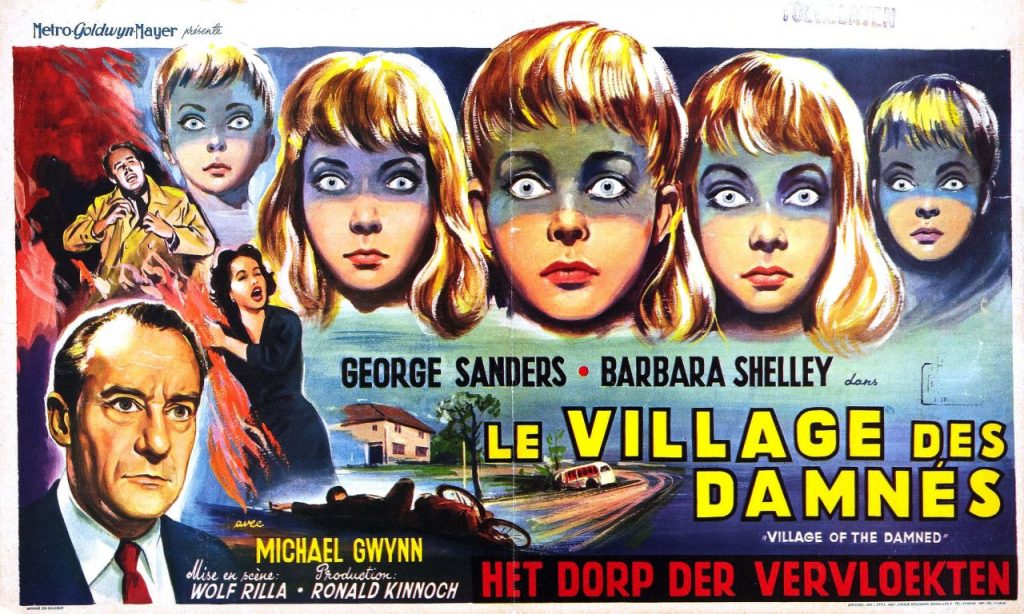
We follow the cuckoo into an even stranger and mostly forgotten associations between cuckoos and cuckoldry, losing ourselves further in the notion of the cuckold as one “wearing the horns,” and at long last arriving at a truly ghastly farmyard rationale behind the “horns” expression.
The painting below illustrates the “horns” symbolism rudely applied within a group of Italian commedia dell’arte performers. Further illustrations below (17th-century England and 19th-century France respectively) rerpresent other satiric commentary.
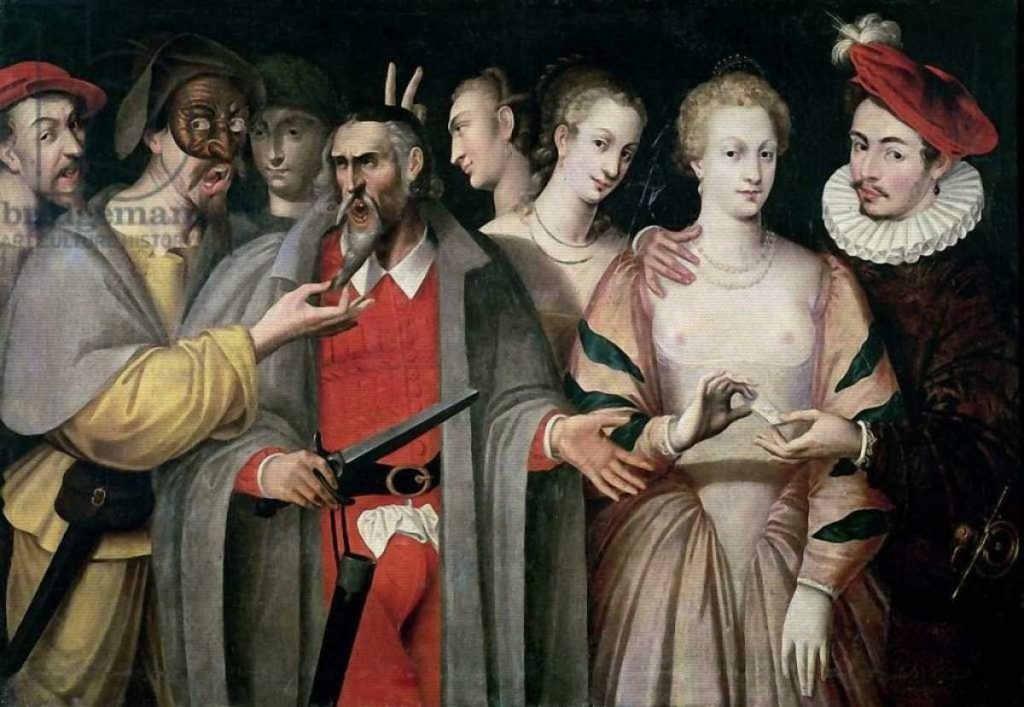
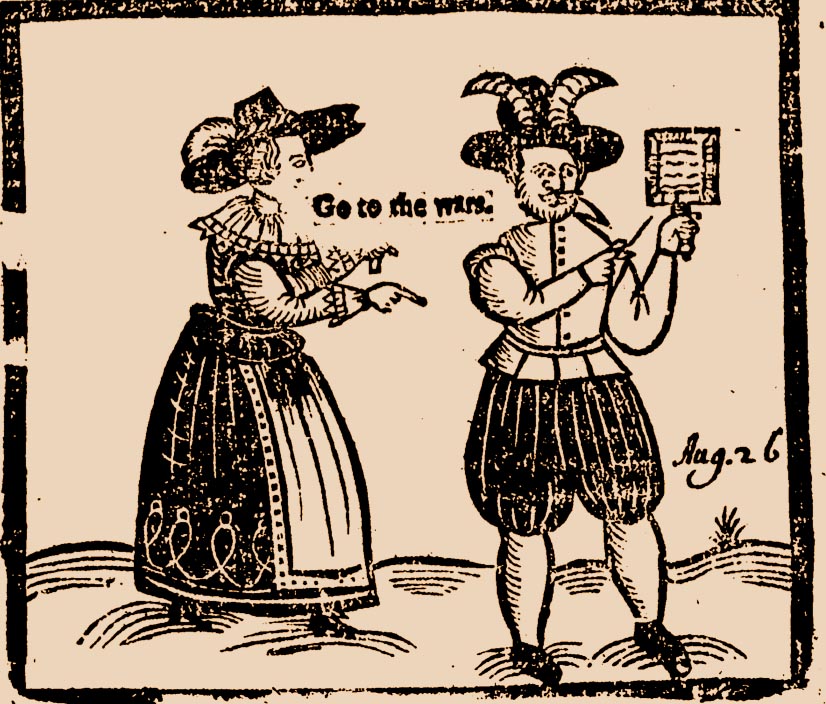
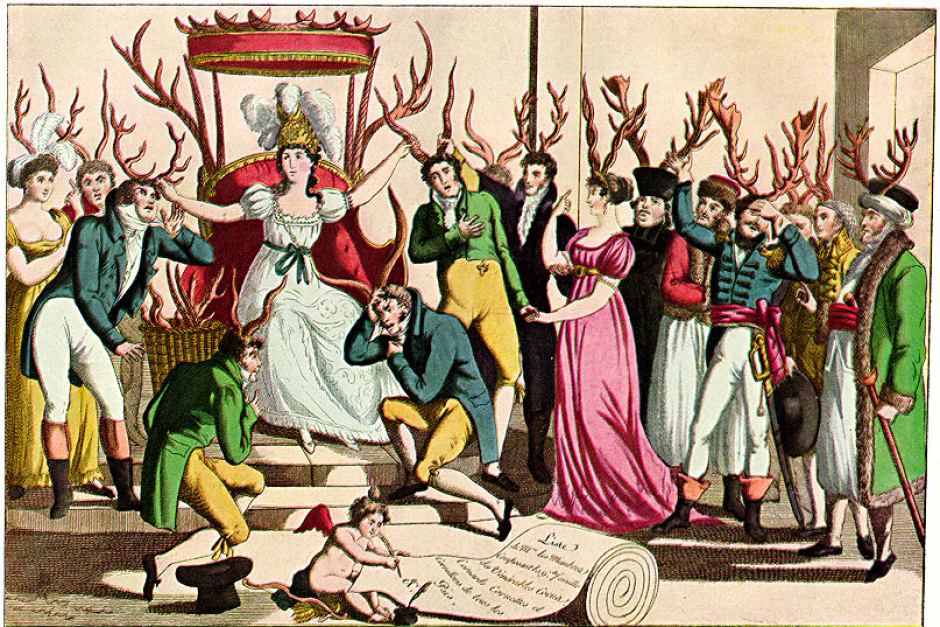
Naturally, the subject of cuckoo clocks must also receive brief mention, but we find our way to our native “horror” habitat back through the notion of the cuckoo clock as a species of “automata clocks,” and thereby other more morbid examples, such as this stellar piece used in Werner Herzog’s 1973 film, Nosferatu.
A few grisly tales associated with public “death clocks” receive dramatic treatment including this fellow from the Czech town of Havličkův Brod and the grim folklore surrounding him.
We close the show out with the warning, “Carpe Diem” as expressed (with a nod to the cuckoo) by the avant-folk band, The Fugs in 1966.Become a Patron!
Episode 2: Walpurgisnacht, Pt 2
Become a Patron!
In our second episode on the grim folklore of Walpurgisnacht — that is May Eve or April 30, St. Walburga’s day — we meet Walburga, the saint whose name was attached to what was likely a pre-existing pagan holiday.
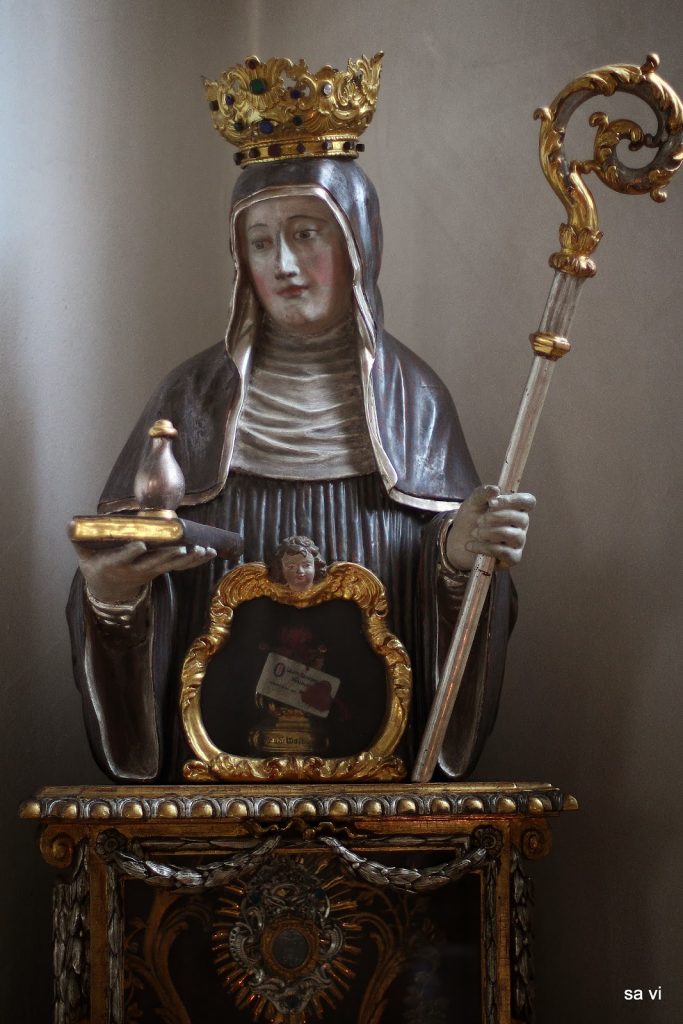
While the saint’s bones for centuries have been said to be the source of a miraculously curative oil, namesake children dedicated to her have a significantly less holy reputation, with Walburga Oesterreich being a particularly notorious example known for her involvement in a bizarre murder we’ll briefly discuss.
More practices associated with Walpurgisnacht are provided by the highly influential, if a bit outdated, armchair anthropologist Sir James Frazer, of Golden Bough. The association between this day dedicated to the obscure German saint and witchcraft becomes clear as we examine the many prophylactics against evil spirits afoot on the occasion. Listen close so you know what to do with the black and red spotted hemlock! Keep that bonfire stoked…
“So far as the light of the bonfire reaches, so far will a blessing rest on the fields.”

Then we jump into real nexus of that association between witchcraft and Walpurgisnacht, that is, the play Faust by Johann Wolfgang von Goethe, which not only established the night as a notorious witches’ sabbath, but also did much to localize to Germany’s Blocksberg (or Brocken) mountain. A Cliff Notes encapsulation of the witches sabbath scene is rather flippantly re-enacted for your audio enjoyment, wherein you will hear this oft quoted passage from Goethe:
Now, to the Brocken, the witches ride;
The stubble is gold, the corn is green;
There is the carnival crew to be seen,
And Master Urian will come to preside.
So over the valleys, our company floats,
With witches a-farting on stinking old goats.
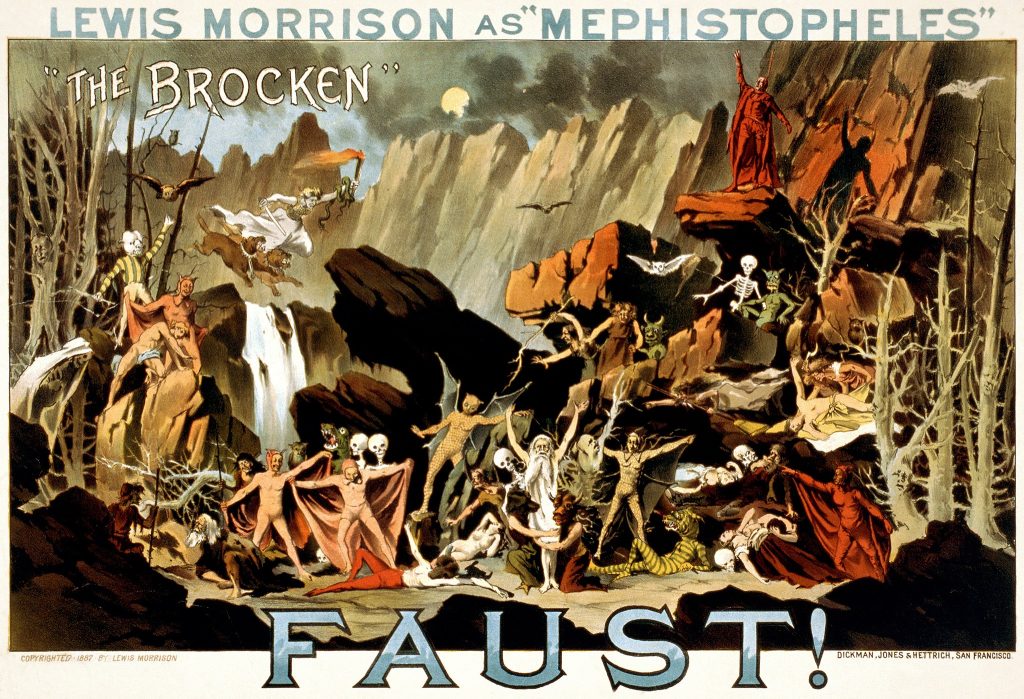
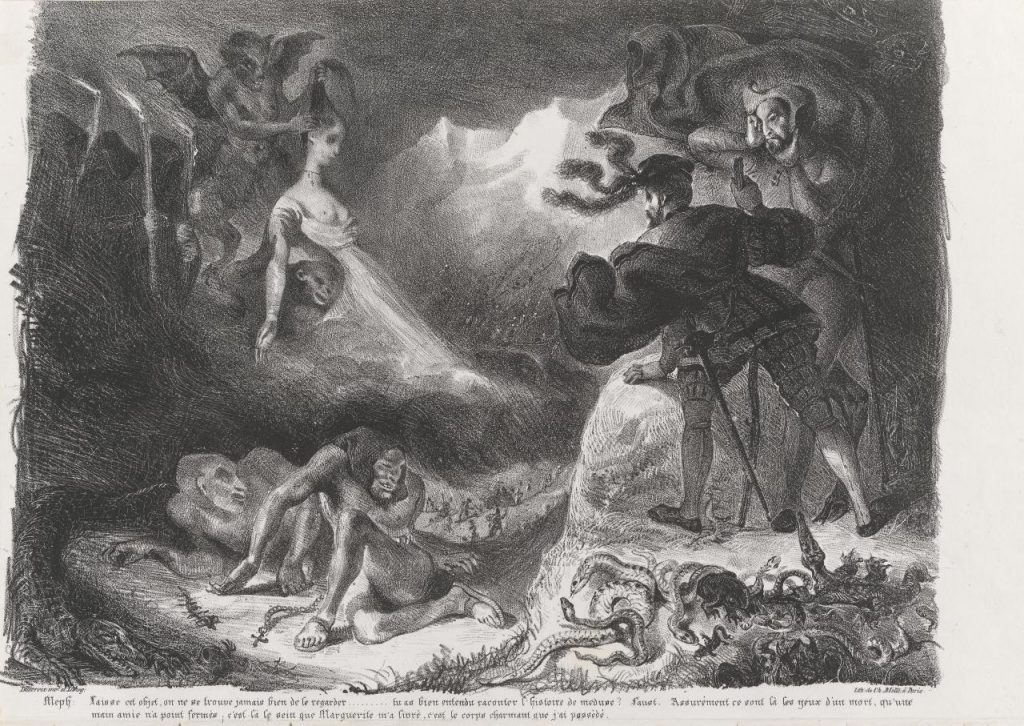
We discuss the mythology of witches and mountains a bit more generally, surveying a few other German mountains upon which or within which lost souls and dabblers in witchcraft are said to play or reside. Then we get into some details on the Blocksberg relationship to witches, and the 1688 book which spread the reputation of the Blocksberg and inspired Goethe. Herein we are provided with many useful specifics such as the manner of transport the witches use to reach the mountain. Among the methods catalogued: flying with the assistance magic salves or on brooms, shovels, or pitchforks. Or on flying animals: goats, calves, wolves, Cats and dogs are listed. I don’t think it says how the animals can fly.
Along the way, we learn how specific features of the landscape on and around the Brocken have developed their own mythologies and associations. Such tales have always drawn the curious, and Walpurgisnacht tourism associated with this mountain, and indeed the whole legend-rich Harz mountain region wherein the Brocken lies, has grown over the centuries, as attested to by artifacts like the postcards collected below.
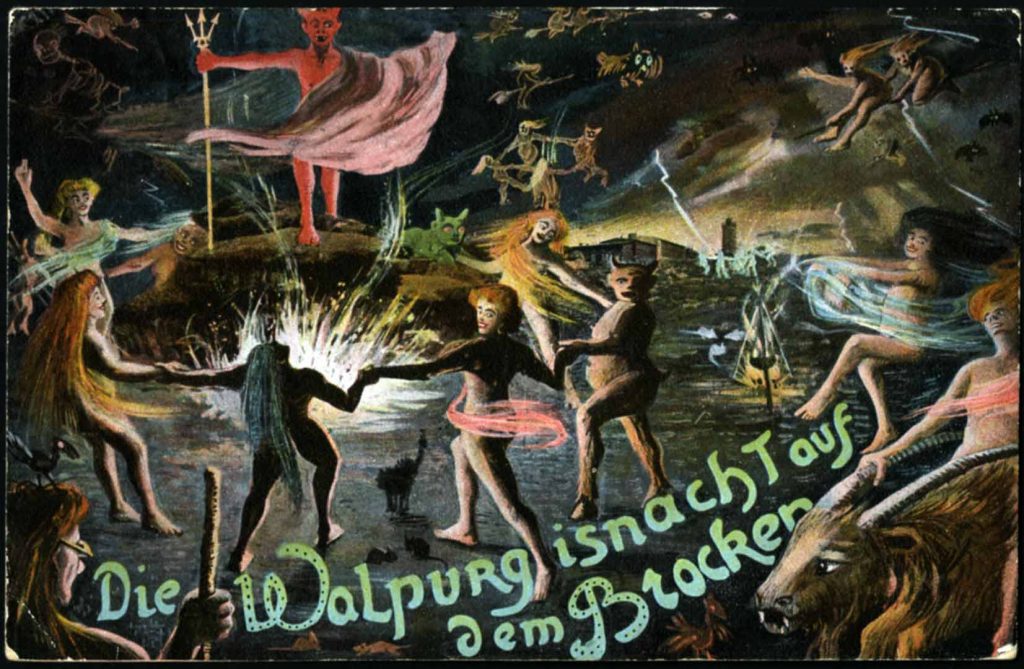
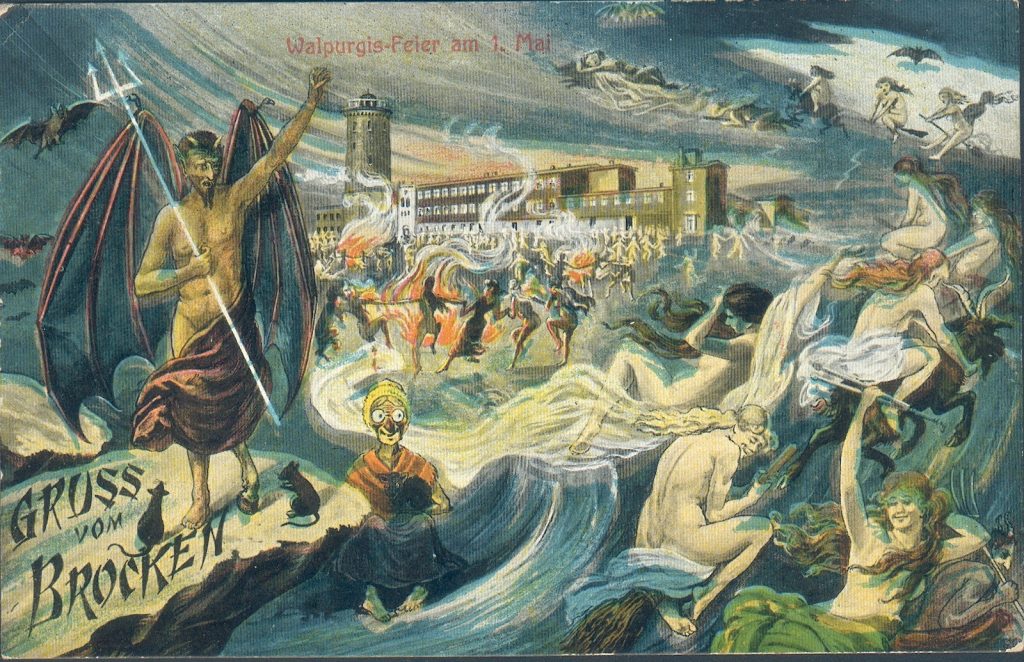
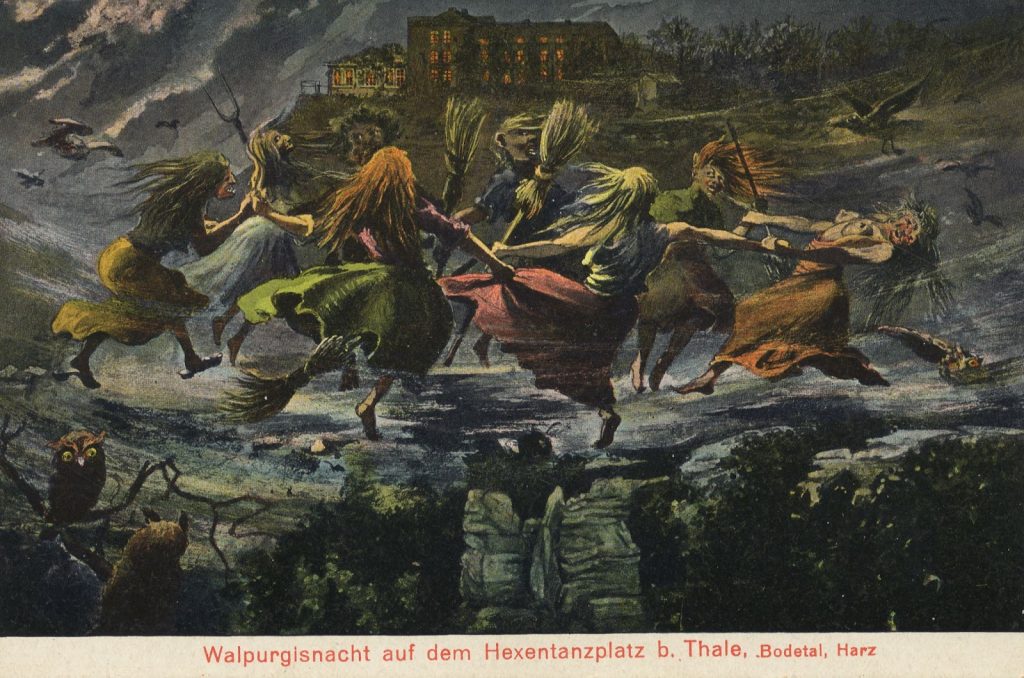
While the ominous reputation of the mountain may have lost something in our present day, modern celebrations of Walpurgisnacht are nothing if not enthusiastic… (Below, the “gone viral” video mentioned in the episode.)
Then there’s the Brocken Specter, a weird optical phenomenon that takes its name from the mountain. It appears in low-hanging clouds or mist as a huge, looming, elongated shadowy encircled by a rainbow halo and is caused by the sun behind human figure projecting a shadow on the clouds when atmospheric conditions. More than all my babbling in the podcast, videos like the one below may convey some of its eerie effect…
Last but not least we have a look at paranormal researcher and prankster/publicity hound Harry Price and his shenanigans atop the Blocksberg in 1932. A photo from his highly theatrical reenactment of “The Blocksberg Tryst,” a 15th-century Walpurgisnacht ritual supposedly once conducted on the mountain with miraculous results below…
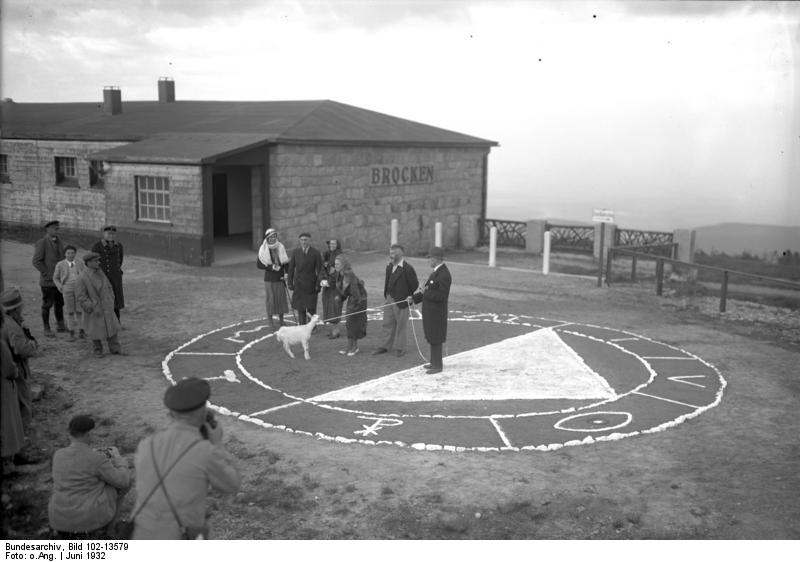
NOTE: My apologies to all listeners for an uncorrected mispronunciation in Episode 2, namely the hard “G” in the name of the talking Mongoose “Gef” investigated by paranormalist Harry Price. Apparently, the animal informed witnesses that his name was “Jeff,” but was not very good at spelling when called upon to spell it out. You can find more on Gef from our friends at The Folklore Podcast.
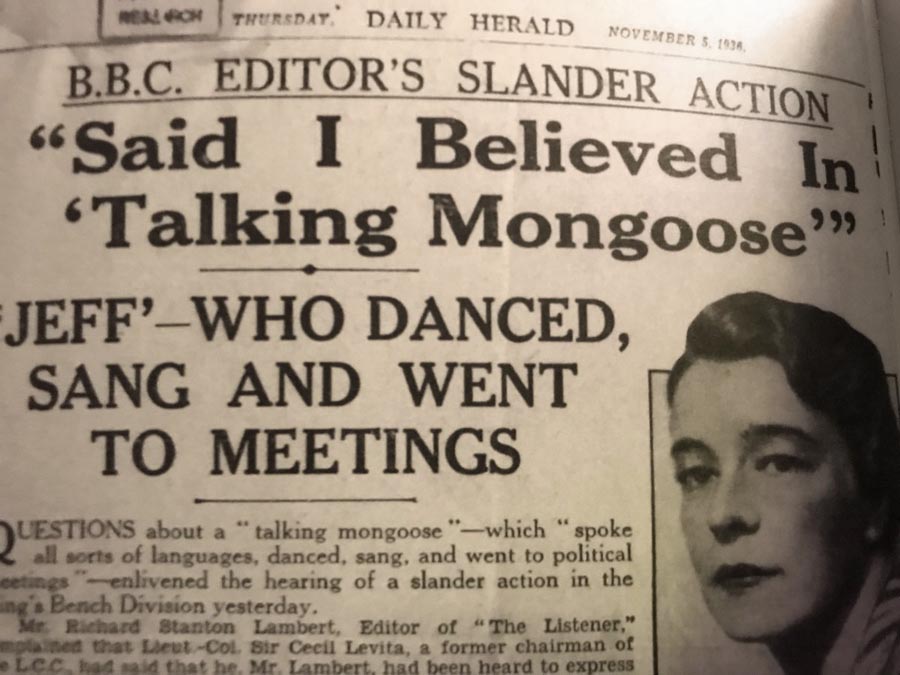
Episode 1: Walpurgisnacht, Pt 1
Become a Patron!
Episode One of BONE & SICKLE is the first half of a two-parter about May Eve, Beltane, or as the Germans call it, Walpurgisnacht (“Walpurgis night“) the night of St. Walburga, that and oh so much more!

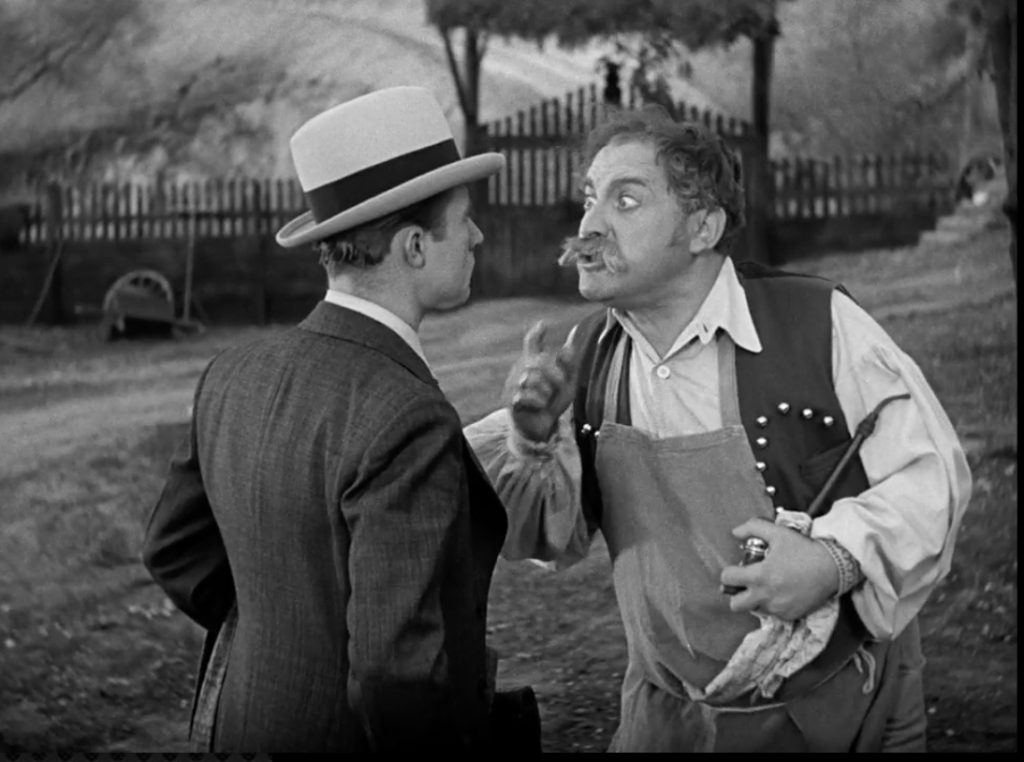
It’s also about St. George’s Eve, and the conflation of the two in Bram Stoker’s Dracula (and another kind of confusion in Lugosi’s 1931 film of the same name.
Along the way, we meet eccentric English churchman and scholar of folklore and occult, Montague Summers, who provides some interesting nuts and bolts on protecting oneself from evil spirits afoot on Saints George’s of Walburga’s nights. (Sprigs of various herbs placed around doors and windows are a start.) We also learn of what appears to be a strange and little remarked upon money-making hobby Bram Stoker devised for Count Dracula, one referencing actual Romanian superstitions of the 1800s, all of which Stoker had studied up on before embarking on his novel. (Do any readers of the novel remember the mysterious “blue flame” incident (something like a will-o’-the-wisp)?
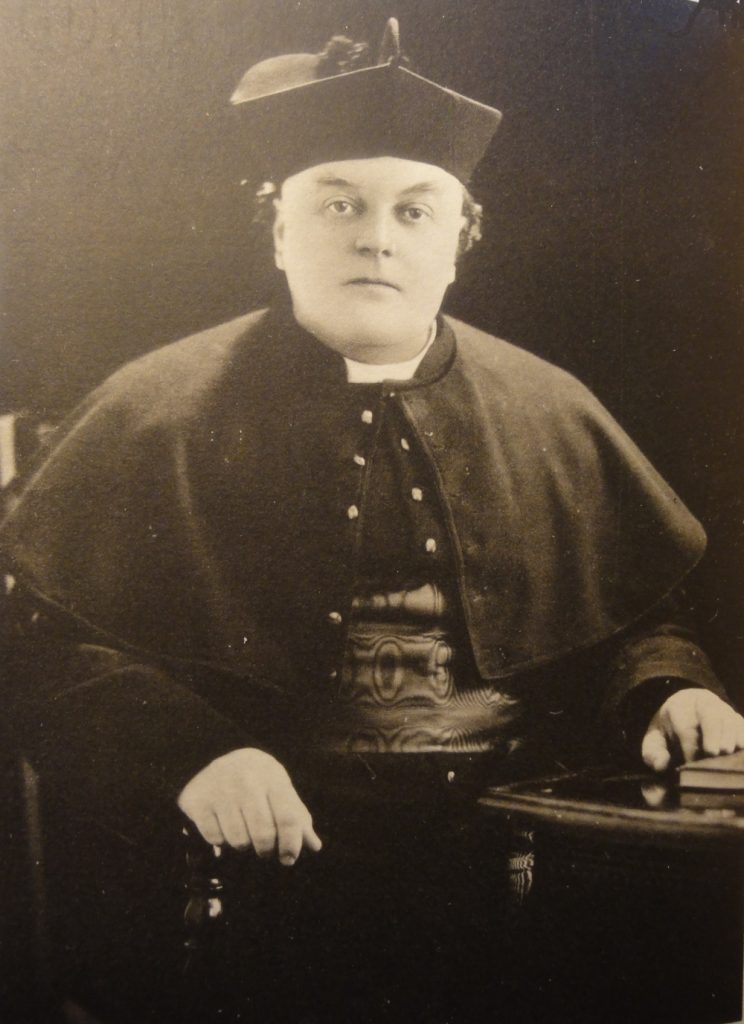
We also discover what was apparently an early, discarded chapter from the novel Dracula, one rich in references to these earlier landmark works of the gothic genre, these being, Joseph Le Fanu’s Carmilla and Gottfried August Bürger’s 1773 poem Lenore, from which Stoker borrowed the epigraph, “The Dead travel fast” — both of which we’ll explore a bit. Am\nd there’s even a little nod to Walpurgis night.
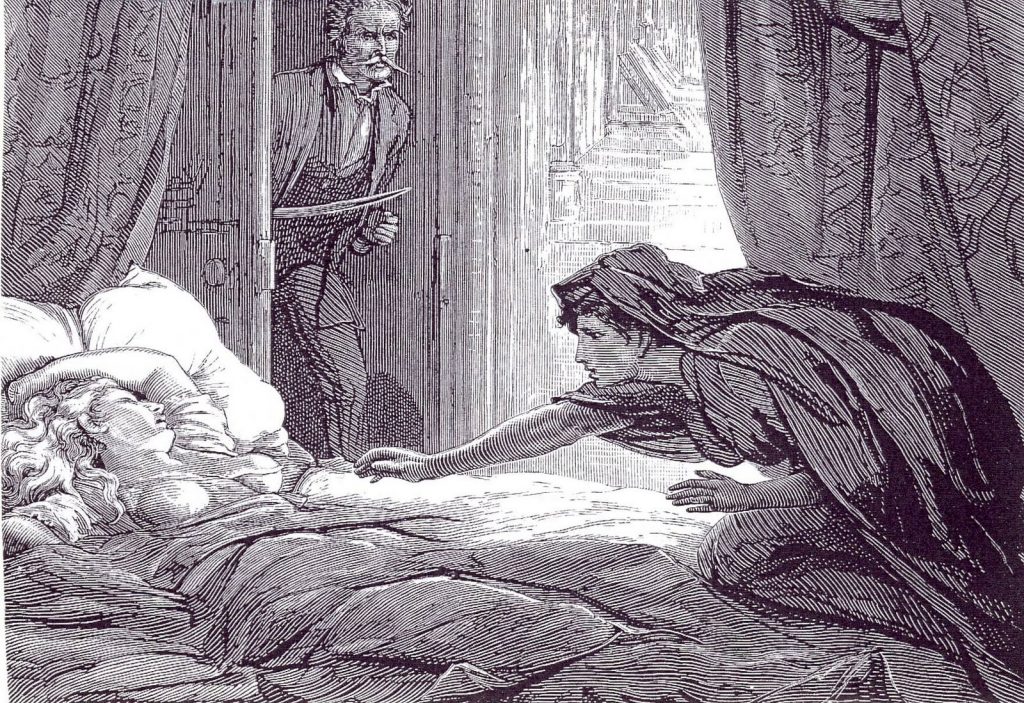
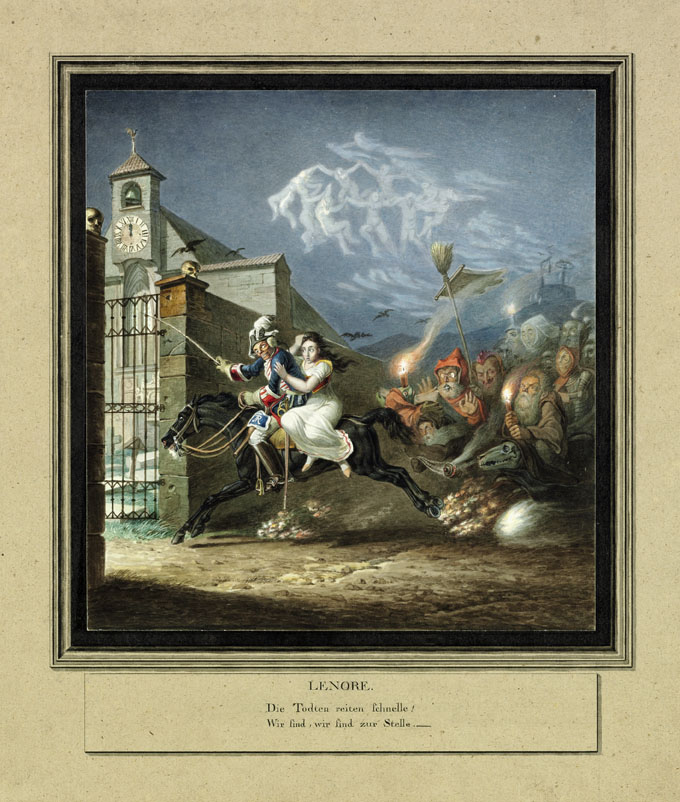
En liten tjänst av I'm With Friends. Finns även på engelska.


